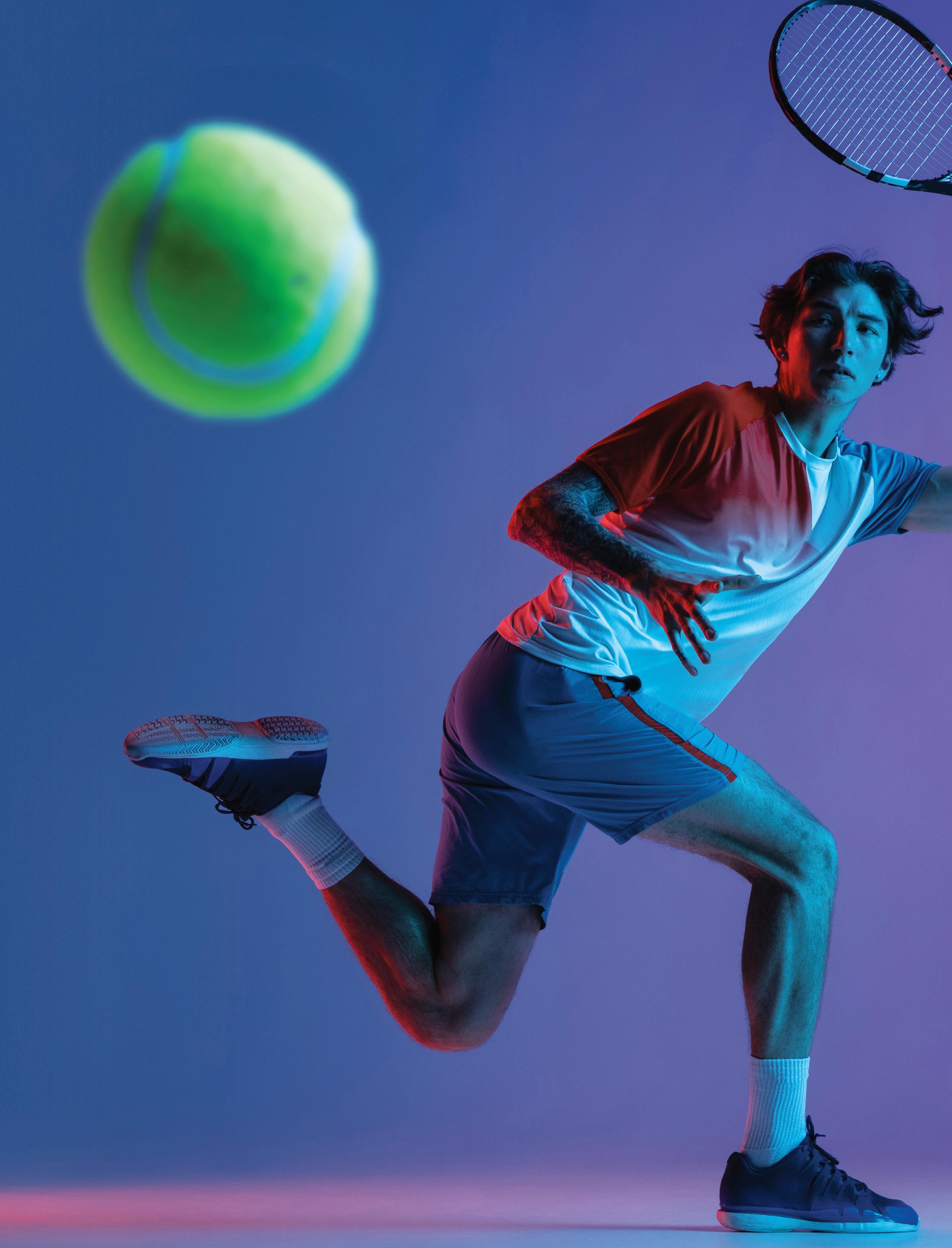

EDUCATION PHYSICAL
FOR QUEENSLAND UNITS
LEAD AUTHORS: CRYSTAL HEDE & KATE RUSSELL & WAYNE GORE
&
WITH RON WEATHERBY, MONIQUE BRENNAN
THIRD EDITION
Oxford University Press is a department of the University of Oxford. It furthers the University’s objective of excellence in research, scholarship and education by publishing worldwide. Oxford is a registered trademark of Oxford University Press in the UK and in certain other countries.
Published in Australia by Oxford University Press
Level 8, 737 Bourke Street, Docklands, Victoria 3008, Australia.
© Crystal Hede, Kate Russell, Ron Weatherby, Monique Brennan and Wayne Gore 2025
The moral rights of the authors have been asserted.
First published 2011 Third Edition
All rights reserved. No part of this publication may be reproduced, stored in a retrieval system, transmitted, used for text and data mining, or used for training artificial intelligence, in any form or by any means, without the prior permission in writing of Oxford University Press, or as expressly permitted by law, by licence or under terms agreed with the appropriate reprographics rights organization. Enquiries concerning reproduction outside the scope of the above should be sent to the Rights Department, Oxford University Press, at the address above. You must not circulate this work in any other form and you must impose this same condition on any acquirer.
ISBN 9780190344665
Reproduction and communication for educational purposes
The Australian Copyright Act 1968 (the Act) allows educational institutions that are covered by remuneration arrangements with Copyright Agency to reproduce and communicate certain material for educational purposes. For more information, see copyright.com.au.
Edited by Nick Tapp
Proofread by Laura Rentsch
Indexed by Puddingburn Publishing Services
Printed in Singapore by Markono Print Media Pte Ltd
Oxford University Press Australia & New Zealand is committed to sourcing paper responsibly.
Disclaimer
Links to third party websites are provided by Oxford in good faith and for information only.
Oxford disclaims any responsibility for the materials contained in any third party website referenced in this work.

Acknowledgement of Country
Oxford University Press acknowledges the Traditional Owners of the many lands on which we create and share our learning resources. We acknowledge the Traditional Owners as the original storytellers, teachers and students of this land we call Australia. We pay our respects to Elders, past and present, for the ways in which they have enabled the teachings of their rich cultures and knowledge systems to be shared for millennia.
Warning to First Nations Australians
Aboriginal and Torres Strait Islander peoples are advised that this publication may include images or names of people now deceased.
Printer please replace with your FSC logo
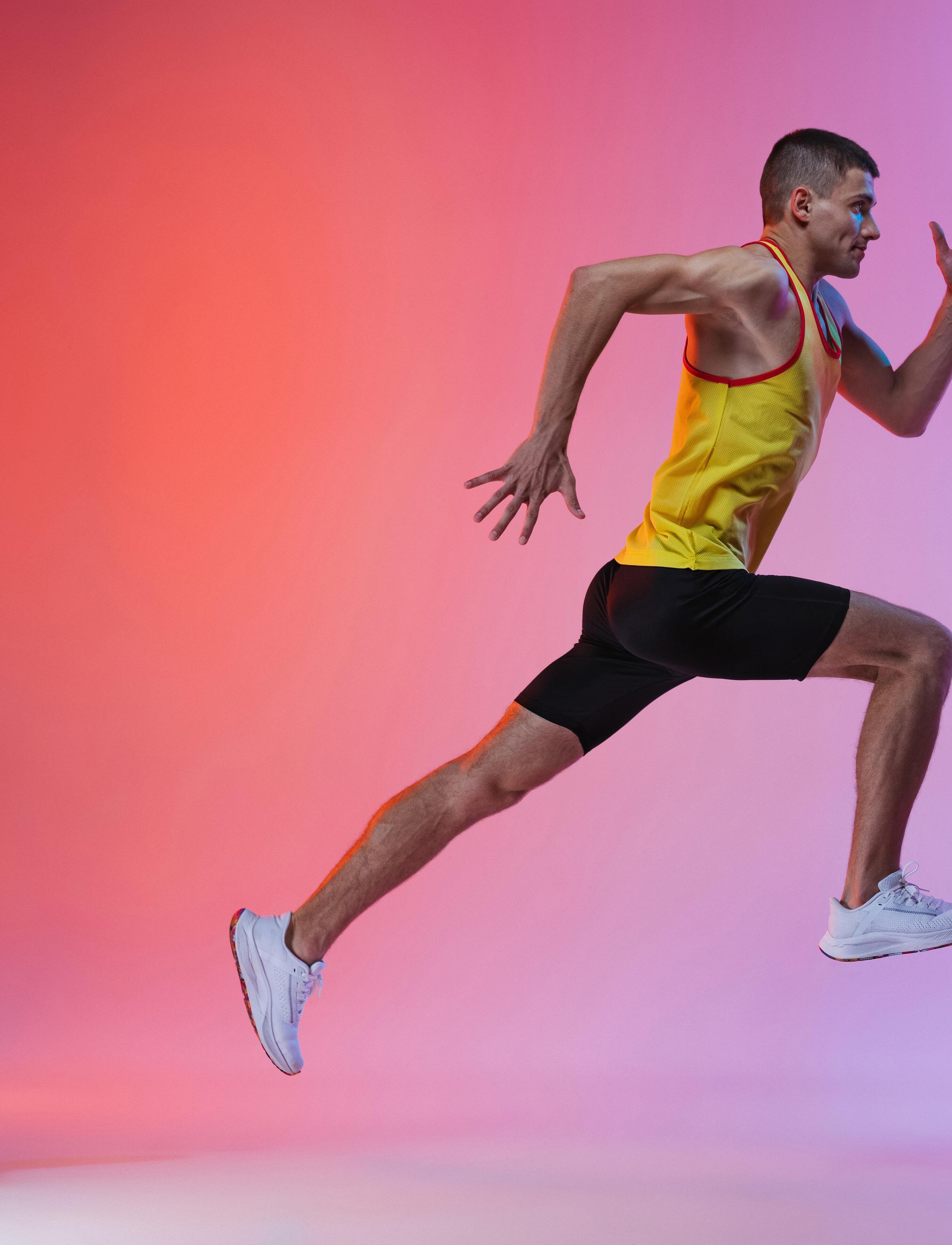

5.4
5.9
5.10

5.12
5.13
5.14
Introducing Physical Education for Queensland Units 3&4 (Third
Congratulations on choosing Physical Education for Queensland Units 3&4 (Third edition) as part of your studies this year!
Physical Education for Queensland Units 3&4 (Third edition) has been purpose-written to meet the requirements of the QCAA Physical Education 2025 General Senior Syllabus. It includes a range of flexible print and digital products to suit your school and incorporates a wide variety of features designed to make learning fun, purposeful and accessible to all students!
Key features of Student Books
The Physical Education toolkit module provides an overview of the syllabus, tips for success on assessment tasks, advice on understanding cognitive verbs and a summary of the importance of data in the QCE Physical Education course.
Each module begins with a module opener that includes:
• key terms from the syllabus
• a content grid that shows the coverage of all subject matter outcomes from the syllabus.

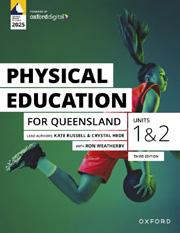
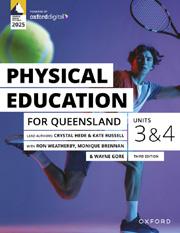
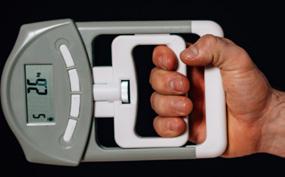


Each lesson includes:
• key ideas signposted at the beginning of each lesson
• clearly structured content written in clear, concise language
• definitions for all key terms on the page
engaging, relevant and informative images and illustrations a range of tips and features designed to bring course content to life including case studies, study tips, news articles, and retrieval prompts to help students consolidate knowledge in their longterm memory.
links to supporting digital resources , including learning intentions and success criteria
Check your learning activities organised according to Marzano and Kendall’s taxonomy and incorporating cognitive verbs
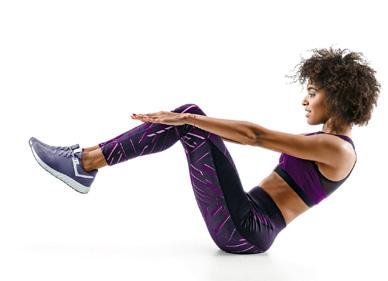
Each module contains a range of skill drills designed to reinforce the theoretical aspects of the syllabus.
For a complete overview of all the features and benefits of this Student Book: > activate your digital access (using the instructions on the inside front cover of this book) and click on About this course in the Course menu.
Key features of
Oxford Digital has been designed in consultation with Australian teachers for Australian classrooms. The new platform delivers fully accessible, reflowable course content with videos, autoand teacher-marked activities, interactives and more embedded right where you need them. There’s also a range of unique features designed to improve learning outcomes.
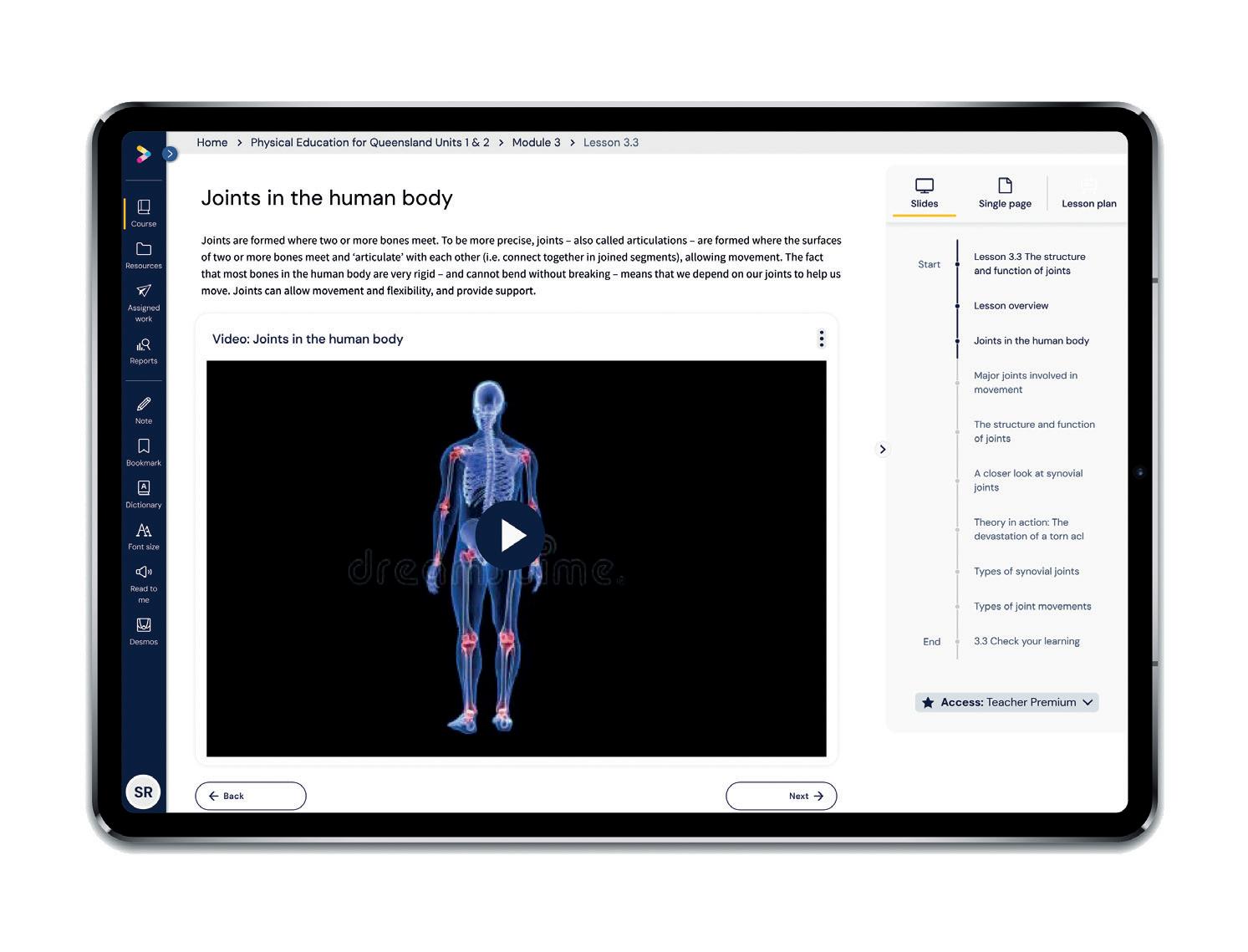
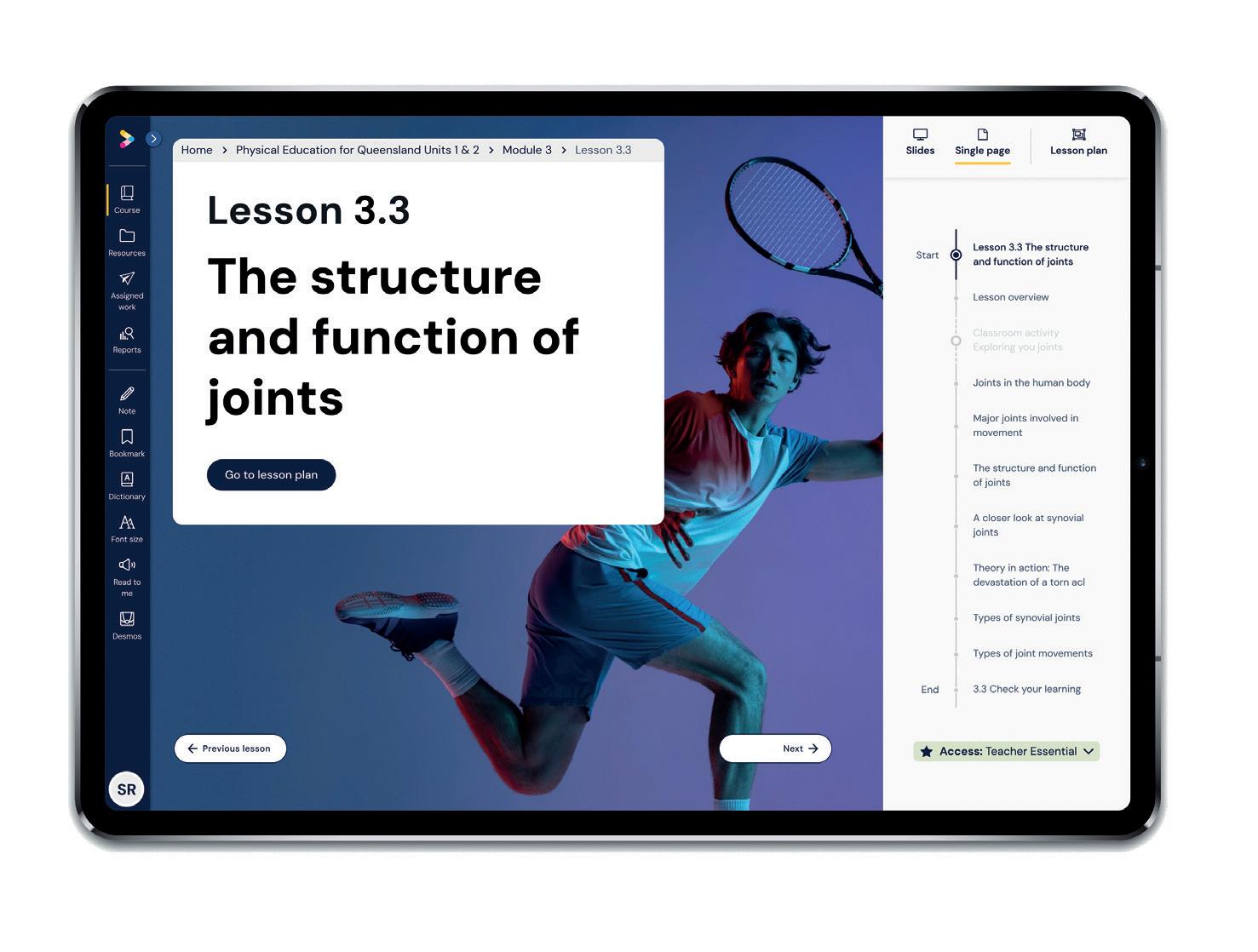
As a student, you can:
> view all course content in a fully accessible, reflowable format that’s delivered in bite-sized chunks so you can work at your own pace
> use the “Read to me” button to have any part of the course read aloud to you
> highlight, take notes, bookmark pages, or define words with the built-in Australian Oxford Dictionary
> watch video tutorials to help you revise anything you don’t understand, catch up on things you’ve missed, or help you with your homework
> complete hundreds of interactive questions and quizzes as you work through the content and get the answers and results sent to you.
As a teacher, you can:
> elevate your teaching and reduce planning and preparation time with Live Lesson mode. This is an Australian first that lets you upgrade from traditional print-based lesson plans to fully interactive, perfectly sequenced and timed interactive lessons complete with classroom activities that are ready to go
> personalise learning for every student and differentiate content based on student strengths and weaknesses. Assign support or extension resources to any student using a range of differentiation resources
> revolutionise your planning, marking and reporting with powerful analytics on student performance and progress.
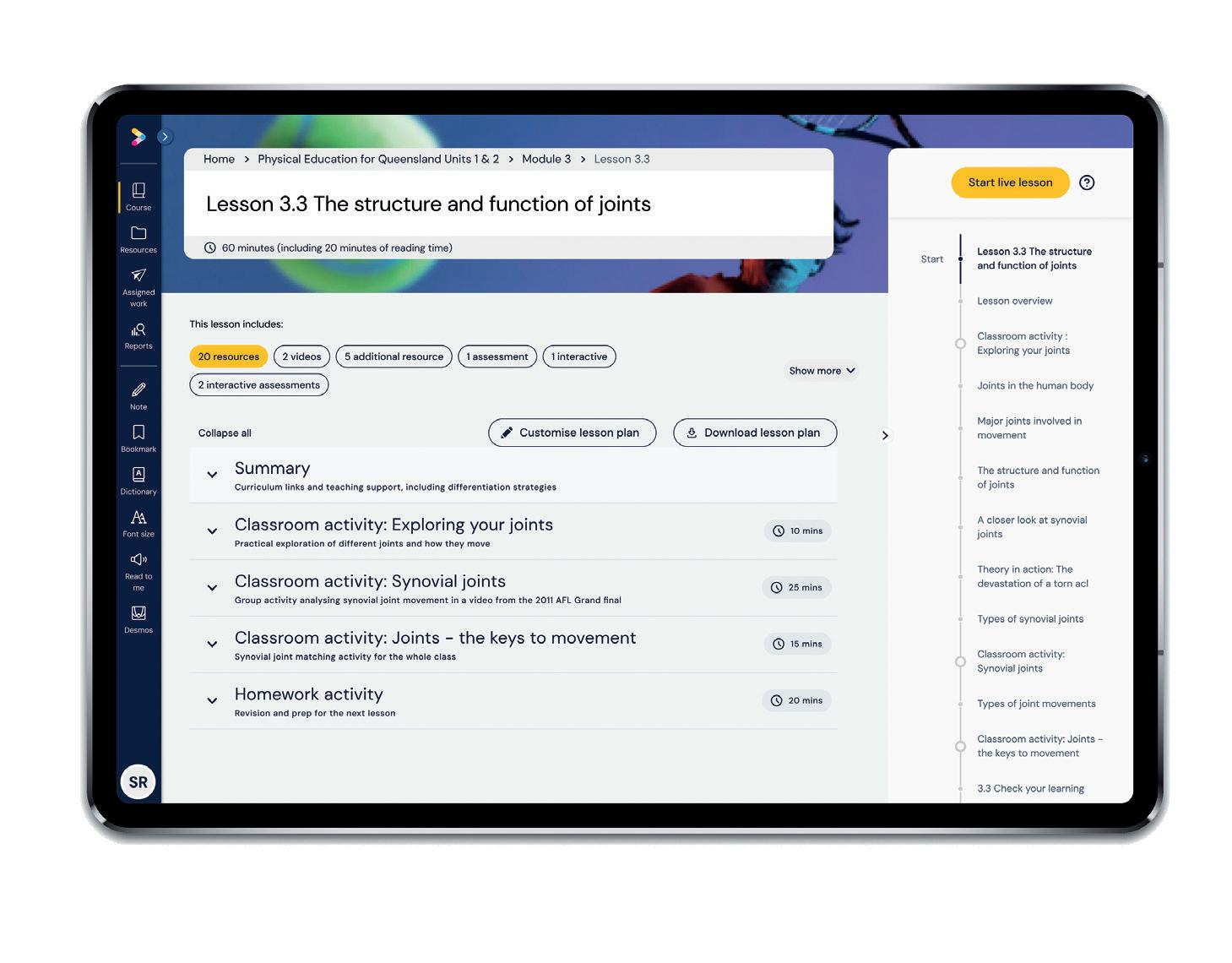
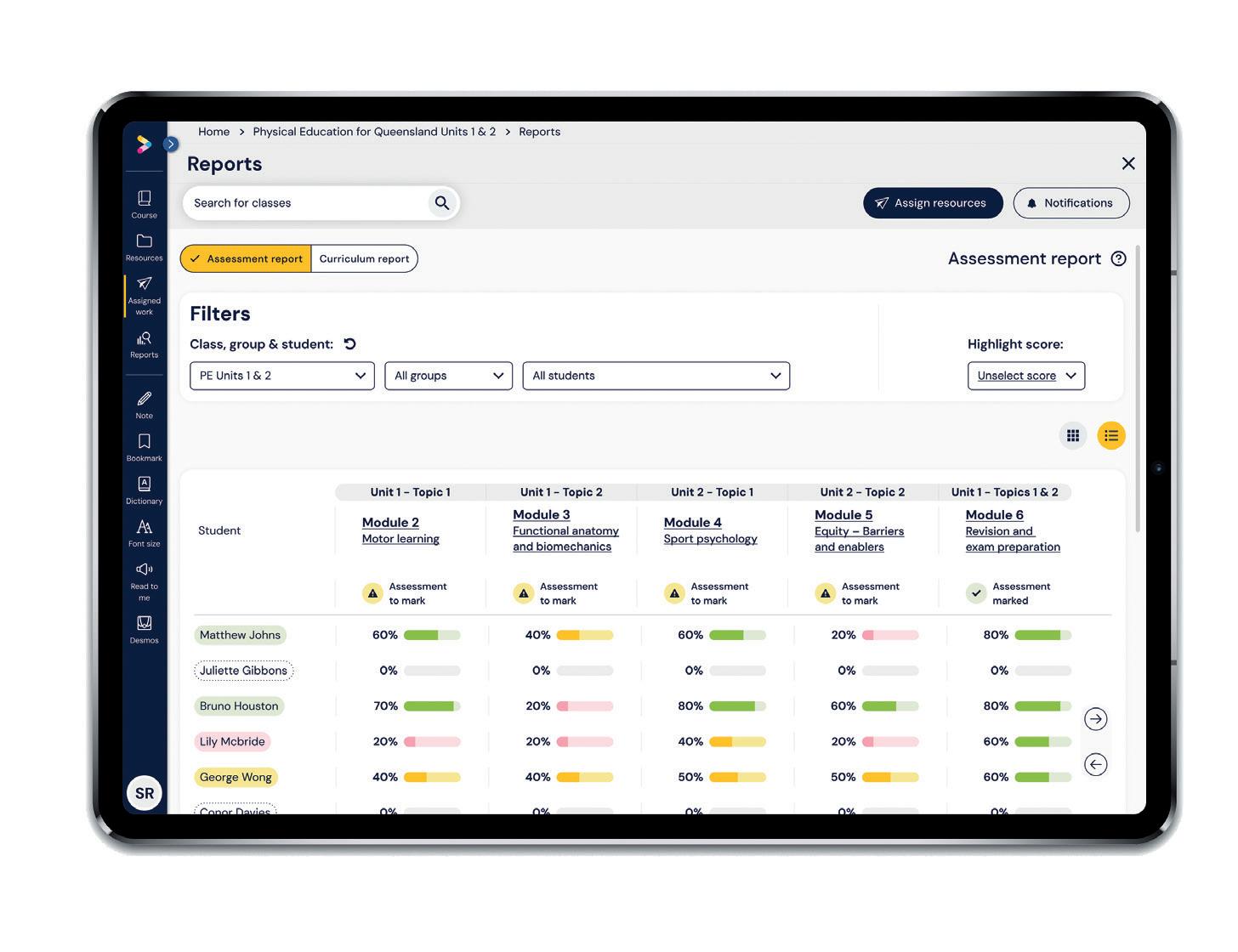
For a complete overview of all the features and benefits of Oxford Digital:
> activate your digital access (using the instructions on the inside front cover of this book) and click on About this course in the Course menu.
Physical Education toolkit MODULE 1

Welcome to Physical Education Units 3 and 4
Congratulations on choosing Physical Education as part of your QCE studies! Physical Education is an exciting, relevant and engaging subject that allows you to gain a deeper understanding of the importance of health and physical activity in the context of a diverse and changing world.
Physical Education for Queensland Units 3 and 4 – and the many resources that support it – has been specifically written to meet the requirements of the QCAA Physical Education 2025 v1.2 General Senior Syllabus. It includes all the content you are required to cover in Units 3 and 4.
QCE Physical Education involves more than just learning about theoretical subject matter in a classroom. You will also learn practical subject matter in physical activity contexts. Furthermore, it involves making connections between the two – that is, how theoretical concepts and ideas can be used to improve your performance.
This Physical Education toolkit contains a range of useful and relevant information to help you achieve these goals and get the most out of QCE Physical Education. It can be used as an introduction and overview to the course, but is also designed as a handy reference that can be revisited throughout the year. It includes the following lessons:
• Course overview
• Assessment overview
• Tips for success on the Project – folio
• Tips for success on the Investigation – report
• Tips for success on the Examination – combination response
• Understanding cognitive verbs
• The importance of data
• Putting data to use.
Best of luck in your studies this year, Crystal Hede, Kate Russell, Ron Weatherby, Monique Brennan and Wayne Gore
Lesson 1.1 Course overview
The QCE Physical Education syllabus
Everything you need to know about the QCE Physical Education syllabus is set out in a document known as the General Senior Syllabus that is released by the Queensland Curriculum and Assessment Authority (QCAA)
The General Senior Syllabus is the most important document supporting the QCE Physical Education course. It includes all the information you are expected to learn, and provides important information on how you will be assessed. The current syllabus was taught for the first time in 2025 for Year 11 and will be taught for the first time in 2026 for Year 12.
Weblink: Physical Education General Senior Syllabus
Structure of the QCE Physical Education course
QCE Physical Education is a two-year course made up of four units. Each unit of the course is separated into topics. To receive the full allocation of QCE points available, a passing grade must be achieved for each unit. Units 1 and 2 were covered in Physical Education for Queensland Units 1 & 2 (Third edition); in this book we will be focusing on Units 3 and 4.
Source 1 shows how Units 3 and 4 of the course are broken down into topics and notional hours. It also shows how the modules in Physical Education for Queensland Units 3 & 4 cover this content.
Unit 3 – Tactical awareness and ethics in physical activity
Unit 4 – Energy, fitness and training in physical activity
Topic 1: Tactical awareness in physical activity
Topic 2: Ethics and integrity in physical activity
Topic 1: Energy, fitness and training integrated in physical activity
• 33 hours
• 22 hours
• 55 hours
SOURCE 1 Course structure of QCE Physical Education Units 3 and 4
Study tip
Make sure you visit the QCAA website and download a copy of the Physical Education General Senior Syllabus. It sets out all the information you are expected to learn and provides important information on how you will be assessed.
Physical Education for Queensland Units 3 & 4
Module 2 Tactical awareness (page 34)
Module 3 Ethics and integrity (page 98)
Module 4 Energy, fitness and training (page 174)
Module 5 Revision and exam preparation (page 332)
Source: Physical Education 2025 v1.2 General Senior Syllabus © Queensland Curriculum & Assessment Authority
body and movement concepts
a group of four concepts used to guide the development and judge the effectiveness of specialised movement sequences and movement strategies in different sports and physical activities specialised movement sequences a combination of fundamental movement skills (and movement elements) that enable the body to move in response to a stimulus
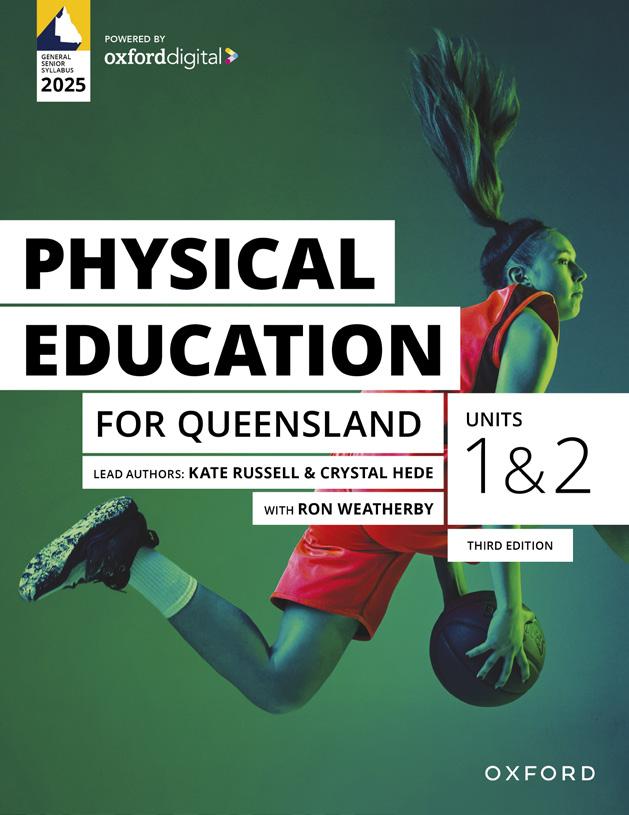
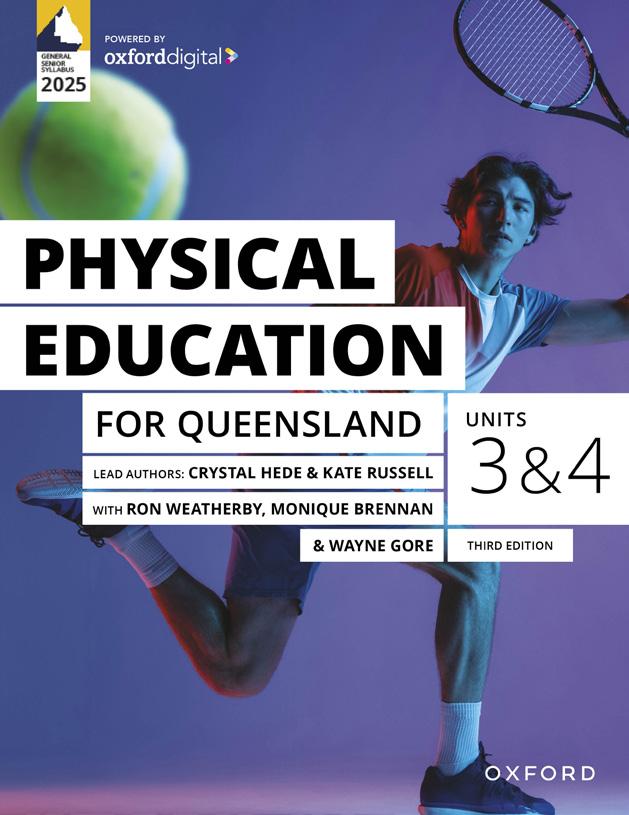
SOURCE 2 QCE
Physical Education is a two-year course made up of four units. Units 1 and 2 are covered in Physical Education for Queensland Units 1 & 2 (Third edition) and Units 3 and 4 are covered in Physical Education for Queensland Units 3 & 4 (Third edition).
Subject matter
Each topic in the course includes a series of subject matter dot points. These dot points tell you what you should know and learn. You will find the subject matter dot points for every topic at the start of each module of this book. It is important that you read and become familiar with these before you begin each module.
Body and movement concepts
Throughout the course, you will be expected to demonstrate and apply body and movement concepts to specialised movement sequences and movement strategies in your selected physical activity.
Body and movement concepts are the qualities demonstrated in a physical activity performance against which judgements about effectiveness can be made. They are split into four categories: quality of movement, body awareness, space awareness and relationships. Specialised movement sequences represent the combination of movement skills and sequences relative to the position or event in a selected physical activity. The term "movement strategies" refers to a variety of approaches that will help an individual or team achieve a determined outcome.
The body and movement concepts included in QCE Physical Education are shown in Source 3.
Quality of movement Body awareness Space awareness Relationships
How the body moves Body awareness
• accuracy
• continuity and outcome of movement
• effect
• efficiency
• effort
• flow
• force development
• sequence
• time and speed
• balance
• flight
• stability
• transfer of weight
• weight bearing
SOURCE 3 Body and movement concepts
Awareness of where the body can move Connections with objects
• direction
• levels and planes of movement
• pathways of movement
• using general space
• using personal space
• interaction with opponents
• interaction with other players
• interaction with implements and objects
Source: Physical Education 2025 v1.2 General Senior Syllabus © Queensland Curriculum & Assessment Authority
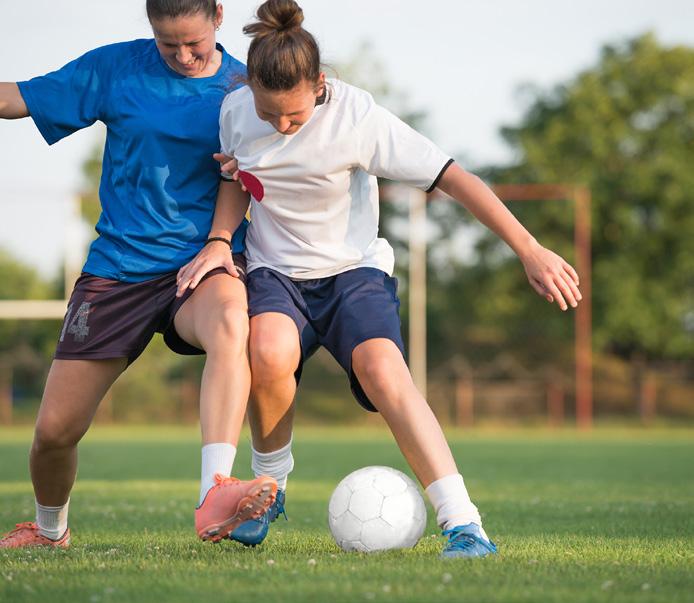
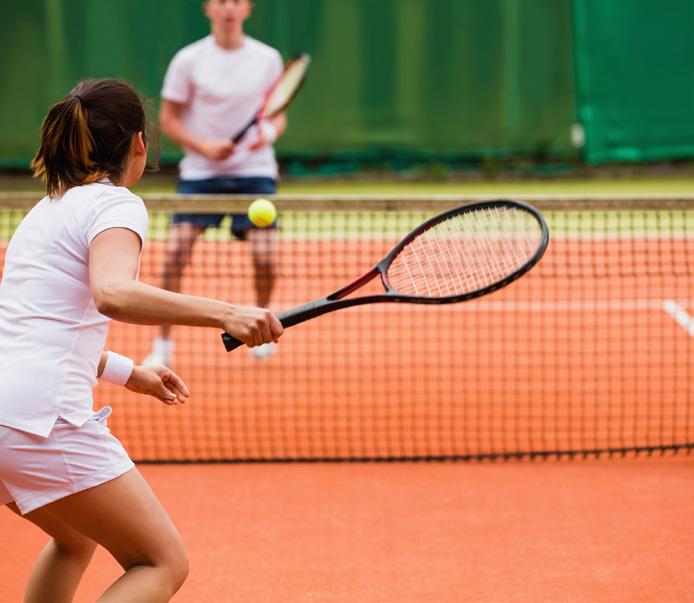

SOURCE 4 In Units 3 and 4 of QCE Physical Education you will be required to select a physical activity for each unit from three categories – "Invasion" (e.g. soccer), "Net and court" (e.g. tennis) and "Performance" (e.g. swimming).
Categories of physical activity
Over the course of your studies in Physical Education, you will be required to participate in different physical activities and integrate this into your theoretical learning. When you and your teacher select physical activities, you must take care to follow these guidelines:
• In Units 3 and 4, physical activities must come from particular categories to be eligible for assessment tasks (see Source 5).
• In Unit 3 – Topic 1, you must select one physical activity from one of the "Invasion", "Net and court" or "Performance" categories only.
• In Unit 4 – Topic 1, you must select one physical activity from one of the "Invasion", "Net and court" or "Performance" categories only.
Attention: The physical activity you select in Unit 4 must be from a different category to the physical activity you select in Unit 3.
Invasion
• Australian football
• Basketball • Futsal
• Netball
• Soccer
• Touch football
• Water polo
Net and court
Performance
• Badminton
• Tennis
• Volleyball
• Duathlon, aquathlon, triathlon
• Swimming
• Track and field – jump
• Track and field – throws
• Track and field – track
SOURCE 5 Specifications for selecting physical activities
Study tip
The assessment advice in this lesson was correct at the time Physical Education for Queensland Units 3 & 4 was published; however, the QCAA may make updates from time to time that affect the structure of your assessment. Speak to your teacher to make sure you are using the most current version of the syllabus. A link to the current syllabus is provided.
Weblink: Physical Education General Senior Syllabus 6 PHYSICAL
Lesson 1.2 Assessment overview
Introduction
During Units 3 and 4 of the QCE Physical Education course, you will be required to complete a total of four assessments (three internal and one external) that will count towards your final QCE mark. These assessments are listed in Source 1.
All the assessments you complete in Units 3 and 4 will be summative. This means that they will be submitted at the end of each topic or unit of the course, and will be designed to assess how well you have mastered the subject matter in that topic or unit.
Assessment
Internal assessment 1
Unit 3
Project – folio (25%)
Completed as part of Topic 1: Tactical awareness in physical activity
Internal assessment 2 Investigation – report (25%)
Completed as part of Topic 2: Ethics and integrity in physical activity
Internal assessment 3 N/A
External assessment N/A
Unit 4
N/A
N/A
Project – folio (25%)
Completed as part of Topic 1: Energy, fitness and training in physical activity
Examination – combination response (25%)
Completed as part of Topic 1: Energy, fitness and training in physical activity
SOURCE 1 Structure of assessment for QCE Physical Education Units 3 & 4
Source: Physical Education 2025 v1.2 General Senior Syllabus © Queensland Curriculum & Assessment Authority
Details of assessments in Units 3 & 4
As shown in Source 1, over the course of Units 3 and 4 you will be expected to complete:
• three internal assessments
• one external assessment.
Internal assessments
• The three internal assessments that you will submit as you complete Units 3 and 4 will be developed by your teacher or school. Each of these will be based on the subject matter described in the syllabus.
• The three internal assessments will be endorsed, and the results confirmed, by the QCAA.
• The three internal assessments will be assessed using a tool known as an instrumentspecific marking guide (ISMG). The syllabus contains an ISMG for each of the three internal assessments.
• Each ISMG describes the characteristics evident in your responses and aligns them with the identified assessment objectives. Each ISMG groups assessment objectives into criteria and outlines how marks will be allocated for each one.
• To perform well in assessment tasks, it is crucial that you read and understand the assessment objectives of the task and ensure that your work meets the characteristics provided in the ISMG (in order to receive the maximum possible marks).
• More specific details about these assessments are provided in Lesson 1.3 Tips for success on the Project – folio (page 8) and Lesson 1.5 Tips for success on the Investigation –report (page 13).
• In total, the three internal assessments will contribute 75 per cent towards your final result in Physical Education.
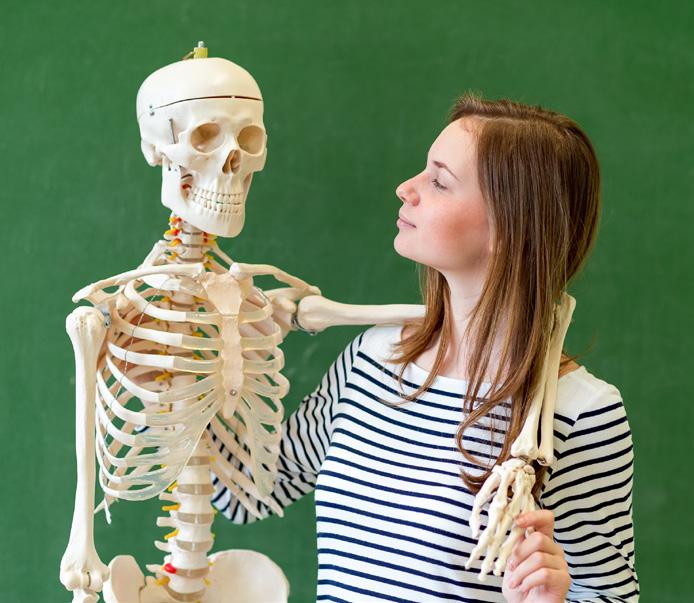

instrumentspecific marking guide (ISMG) a tool for marking that describes the characteristics evident in student responses and aligns with the identified objectives for the assessment
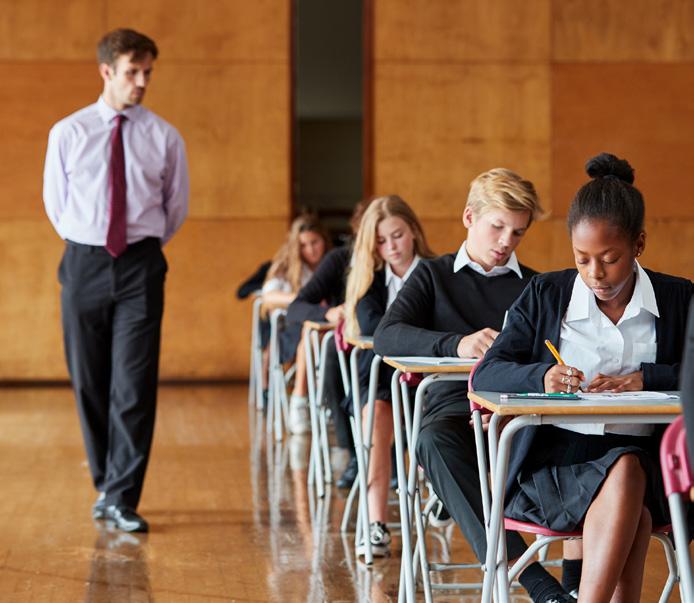
SOURCE 2 Over the course of Units 3 & 4 of the QCE Physical Education, you will be required to complete a total of four assessments – three internal and one external. These will take the form of two Project – folios, an Investigation – report, and an Examination – combination response.
External assessment
• The external assessment that you will sit at the completion of Unit 4 – Topic 1 will be: – common to all schools – administered under the same conditions at the same time and on the same day – developed and marked by the QCAA according to a commonly applied marking scheme.
• More specific details about this assessment are provided in Lesson 1.7 Tips for success on the Examination – combination response (page 17).
• In total, the external assessment will contribute 25 per cent towards your final result in Physical Education.
Lesson 1.3 Tips for success on the Project – folio
Introduction
As part of your assessment for Physical Education Units 3 and 4, you will be required to complete and submit two Project – folios. These are known as:
• Internal assessment 1, which is completed as part of Unit 3 – Topic 1: Tactical awareness in physical activity. This assessment will contribute 25 per cent towards your overall mark.
• Internal assessment 3, which is completed as part of Unit 4 – Topic 1: Energy, fitness and integrated in physical activity. This assessment will contribute 25 per cent towards your overall mark.
QCAA assessment advice on Internal assessment 1: Unit 3 – Topic 1 (25%)
Description
Devise a constraints-led approach to provide opportunity for the emergence of a personal tactical strategy, focusing on the specialised movement sequences for one movement strategy. The project focuses on Unit 3 Topic 1 concepts and principles about tactical awareness and one selected physical activity. You will apply concepts and principles about tactical awareness to body and movement concepts, specialised movement sequences for one movement strategy for a position or event in a selected physical activity context. You will support your individual performance within the selected authentic performance environment with visual evidence.
Assessment objectives
2. Demonstrate specialised movement sequences and movement strategies.
3. Apply concepts to specialised movement sequences and movement strategies.
4. Analyse and synthesise data to devise a constraints-led learning activity/practice to provide opportunity for the emergence of a tactical strategy for optimising performance of one movement strategy.
5. Evaluate a tactical strategy and movement strategies relevant to the selected physical activity.
6. Justify a tactical strategy and movement strategies relevant to the selected physical activity.
7. Make decisions about and use language, conventions and mode-appropriate features to communicate information about strategies to a technical audience.
Note: Objective 1 is not assessed in this instrument.
Specifications
This task requires you to:
• analyse primary data and secondary data to ascertain the most significant relationships between the
– demands of the specialised movement sequences for one movement strategy
– task, learner and environmental constraints that limit or enable personal performance of the specialised movement sequences for one movement strategy
– application of the principles of decision-making based on the presented opportunities for action in the specialised movement sequences for one movement strategy
• synthesise the most significant relationships to devise a constraints-led learning activity/practice to provide opportunity for the emergence of a personal tactical strategy, to optimise performance for one movement strategy
• justify the development of the constraints-led learning activity/practice for one movement strategy to optimise performance, using evidence from primary data and secondary data
QCAA assessment advice on Internal assessment 1: Unit 3 – Topic 1 (25%)
• evaluate the effectiveness of constraints-led learning activity/practice in providing opportunity for the emergence of the personal tactical strategy by appraising the outcome and limitations of the – task, learner and environmental constraints
– applied principles of decision-making
• justify the modification and maintenance of the personal tactical strategy for one movement strategy to optimise performance, using evidence from primary data and secondary data
• make decisions about and use language, conventions and mode-appropriate features to communicate information about the strategies to a technical audience
• record visual personal performance evidence in an authentic performance environment. Visual evidence will illustrate
– demonstration of specialised movement sequences and two movement strategies (from two different principles of play for physical activities from the "Invasion" or "Net and court" categories) in authentic performance environments
– application of quality of movement and one other body and movement concept to the performance of specialised movement sequences and two movement strategies (from two different principles of play for physical activities from the "Invasion" or "Net and court" categories) in authentic performance environments.
It is recommended that this task is designed so that students can develop a response in approximately 5 hours of class time
Conditions
• You can develop your responses in class time and your own time.
• This is an individual task.
Response requirements
Presentation
Multimodal (at least two modes – visual, written, spoken) delivered at the same time and integrated so that each mode contributes significantly to the response: up to 11 minutes
Demonstrating and applying
Visual evidence: up to 3 minutes
Mark allocation
To view the complete ISMG for this assessment, download the Physical Education General Senior Syllabus. A link to the current syllabus is provided.
SOURCE 1
Source: Physical Education 2025 v.1.2 General Senior Syllabus © Queensland Curriculum & Assessment Authority
Weblink: Physical Education General Senior Syllabus
Description
Focus on the specialised movement sequences for one movement strategy to devise a personal training strategy. The project focuses on Unit 4 concepts and principles about energy, fitness and training, and one selected physical activity. You will document the iterative process of demonstrating and applying conceptual understandings through the psychomotor domain to devise a personal training strategy. You will evaluate the effectiveness of the personal training strategy and movement strategies and justify using primary and secondary data. You will support your individual performance within the selected authentic performance environment with visual evidence.
Assessment objectives
2. Demonstrate specialised movement sequences and movement strategies.
3. Apply concepts to specialised movement sequences and movement strategies.
4. Analyse and synthesise data to devise a training strategy for optimising performance of the specialised movement sequences and one movement strategy.
5. Evaluate a training strategy and movement strategies relevant to the selected physical activity.
6. Justify a training strategy and movement strategies relevant to the selected physical activity.
7. Make decisions about and use language, conventions and mode-appropriate features to communicate information about strategies to a technical audience.
Note: Objective 1 is not assessed in this instrument.
Specifications
This task requires you to:
• analyse primary data and secondary data to ascertain the most significant relationships between the – demands of the specialised movement sequences for the selected movement strategy – energy systems and fitness components relevant to the specialised movement sequences for the selected movement strategy – personal performance of the demonstrated specialised movement sequences for the selected movement strategy
• synthesise the most significant relationships to devise a personal training strategy to optimise personal performance of the specialised movement sequences for the selected movement strategy
• justify the development of the personal training strategy for the selected movement strategy to optimise performance, using evidence from primary data and secondary data
• evaluate the effectiveness of the personal training strategy using selected principles of training to appraise the outcome and limitations
• justify the modification and maintenance of the training strategy for one movement strategy to optimise performance, using evidence from primary data and secondary data
• make decisions about and use language, conventions and mode-appropriate features to communicate information about the strategies to a technical audience
• record visual personal performance evidence in an authentic performance environment. Visual evidence will illustrate – demonstration of specialised movement sequences and two movement strategies (from two different principles of play for physical activities from the "Invasion" or "Net and court" categories) in authentic performance environments

– application of quality of movement and one other body and movement concept to the performance of specialised movement sequences and two movement strategies (from two different principles of play for physical activities from the "Invasion" or "Net and court" categories) in authentic performance environments.
It is recommended that this task is designed so that students can develop a response in approximately 5 hours of class time. A link to the current syllabus is provided.
Conditions
• You can develop your responses in class time and your own time.
• This is an individual task.
• The category selected for the physical activity must be different from the category selected for IA1.
Response requirements
Presentation
Multimodal (at least two modes – visual, written, spoken) delivered at the same time and integrated so that each mode contributes significantly to the response: up to 11 minutes
Demonstrating and applying
Visual evidence: up to 3 minutes
Mark allocation
To view the complete ISMG for this assessment, download the Physical Education General Senior Syllabus. A link to the current syllabus is provided below
SOURCE 2
Source: Physical Education 2025 v.1.2 General Senior Syllabus © Queensland Curriculum & Assessment Authority
Tips for planning and structuring your Project – folio
Before beginning work on your Project – folio, it is vital that you refer directly to the Physical Education General Senior Syllabus. This document contains all the specifications and ISMGs for this assessment and will help guide your planning, research and presentation.
Weblink: Physical Education General Senior Syllabus
The assessment advice in this lesson was correct at the time Physical Education for Queensland Units 3 & 4 was published; however, the QCAA may make changes to the syllabus from time to time. These changes may affect the structure of this assessment or the way in which it is marked. Check with your teacher to make sure you are using the most recent specifications for the task.
The Project – folio requires you to create a multimodal presentation. This presentation can take a number of different forms, including:
• a pre-recorded presentation submitted to your teacher electronically
• a presentation you give in front of an audience (e.g. other students in your class)
• a digital portfolio of videos, images, diagrams and annotations you compile and curate
• a movie or slideshow you create and narrate.
Whatever form your Project – folio takes, it must combine at least two modes of communication – visual, written or spoken. For example, verbal narration combined with visual images or written text combined with video footage). According to the guidelines released by the QCAA, you will be required to create a presentation that is up to 11 minutes long (with an additional 3 minutes for you to provide supporting evidence, submitted separately).
multimodal presentation a presentation comprising more than one type of media or component
Study tip
Data is key to your success!
To perform well on your Project – folio, you will be required to gather, record, analyse, evaluate and justify a range of primary and secondary data relating to your performance of specialised movement sequences and movement strategies. For more information about all things data, go to Lesson 1.10 The importance of data (page 23) and Lesson 1.11 Putting data to use (page 25).
Project – folio assignments will always ask you to analyse features impacting your performance of your selected physical activity and use this analysis to justify the development of a strategy aimed to improve your performance. You will then need to evaluate the effectiveness of the strategy you devised and implemented during the unit, and justify your evaluation using the primary and secondary data you gathered as evidence. The idea is that by analysing, evaluating and justifying, you will also demonstrate to your teacher your understanding of all relevant subject matter through your application of it. In other words, it will not be necessary for you to use valuable time during your folio explaining subject matter in isolation.
So, whenever you are asked to complete a Project – folio, it can be useful to plan and structure your presentation using the following questions:
1 What are the demands of your specialised movement sequences and movement strategy?
2 How are these demands influenced by your application of the relevant concepts for the unit being studied?
3 What strategy can you implement to improve your performance based on your answers to questions 1 and 2 above? What evidence do you have to support your decisions about your strategy?
4 What happened when you implemented your strategy? Were there any limitations?
5 What modifications would you make to your strategy if you were to repeat the process? Is there anything you would keep the same?
6 What evidence do you have to support these recommendations?
For more information about primary and secondary data, and to find out how you can best incorporate data into your Project – folio, go to Lesson 1.10 The importance of data (page 23) and Lesson 1.11 Putting data to use (page 25 ).
Tips for creating and presenting your Project – folio
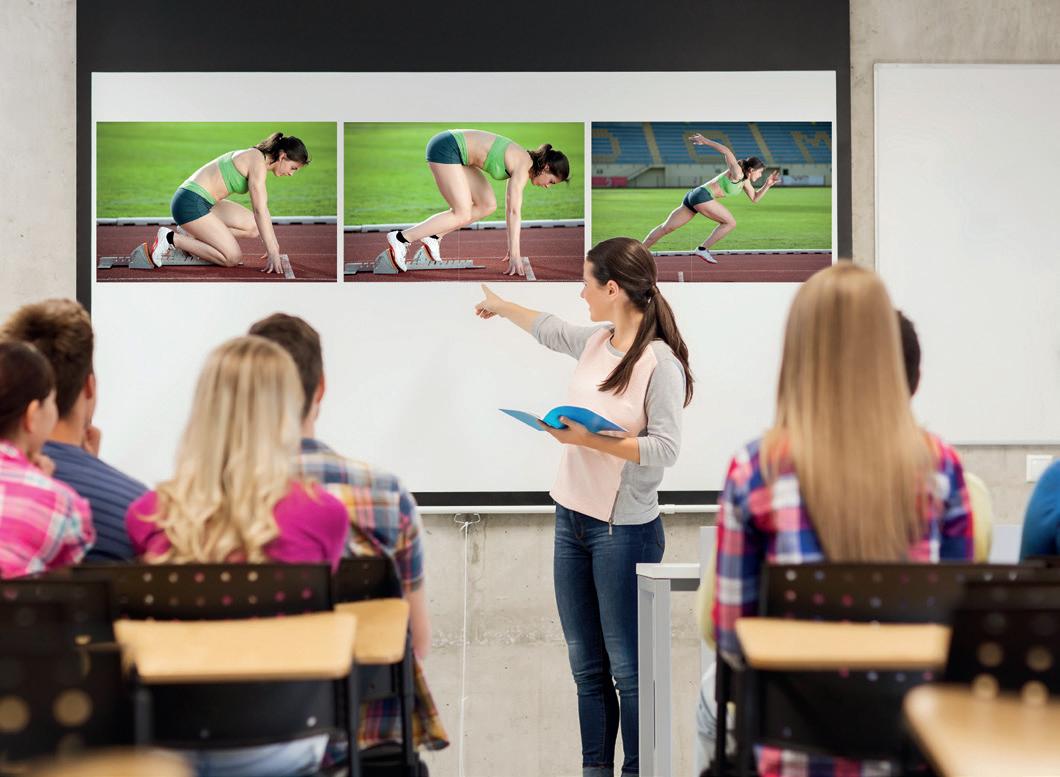
When you are creating your Project – folio, you need to make the best possible use of the time limit set in the task conditions. A common mistake that students make is to spend too much time telling the audience everything there is to know about the topic (e.g. defining all the concepts) and too little time reflecting on and justifying the strengths and weaknesses of the strategies they developed and put into practice.
For more advice and practical tips on how to capture video data and use it to create and present your Project – folio, complete Lesson 1.4 Skill drill: Planning, creating and presenting a Project – folio and Lesson 1.12 Skill drill: Capturing and analysing video footage of physical performances on Oxford Digit al.
SOURCE 3 The Project – folio requires you to create a multimodal presentation (i.e. it must combine at least two modes of communication) that is up to 11 minutes in length.
Lesson 1.4
Planning, creating and presenting a Project – folio
This lesson is available on Oxford Digital.
Lesson 1.5
Tips for success on the Investigation –
report
Introduction
As part of your assessment for Physical Education Units 3 and 4, you will be required to complete and submit one Investigation – report. This is known as:
• Internal assessment 2 , which is completed as part of Unit 3 – Topic 2: Ethics and integrity in physical activity. This assessment will contribute 25 per cent towards your overall mark.
Description
Research an ethical dilemma through collection, analysis and synthesis of primary data and secondary data. This investigation will focus on Unit 3 – Topic 2. The investigation uses research or investigative practices to assess a range of cognitions in a class, school or community physical activity context.
Assessment objectives
1. Recognise and explain concepts and principles about ethics and integrity relevant to a class, school or community physical activity context.
4. Analyse and synthesise data to devise an ethics strategy about an ethical dilemma relevant to a class, school or community physical activity context.
5. Evaluate an ethics strategy relevant to a class, school or community physical activity context.
6. Justify an ethics strategy relevant to a class, school or community physical activity context.
7. Make decisions about and use language, conventions and mode-appropriate features to communicate information about a strategy to inform a technical audience.
Note: Objectives 2 and 3 are not assessed in this instrument.
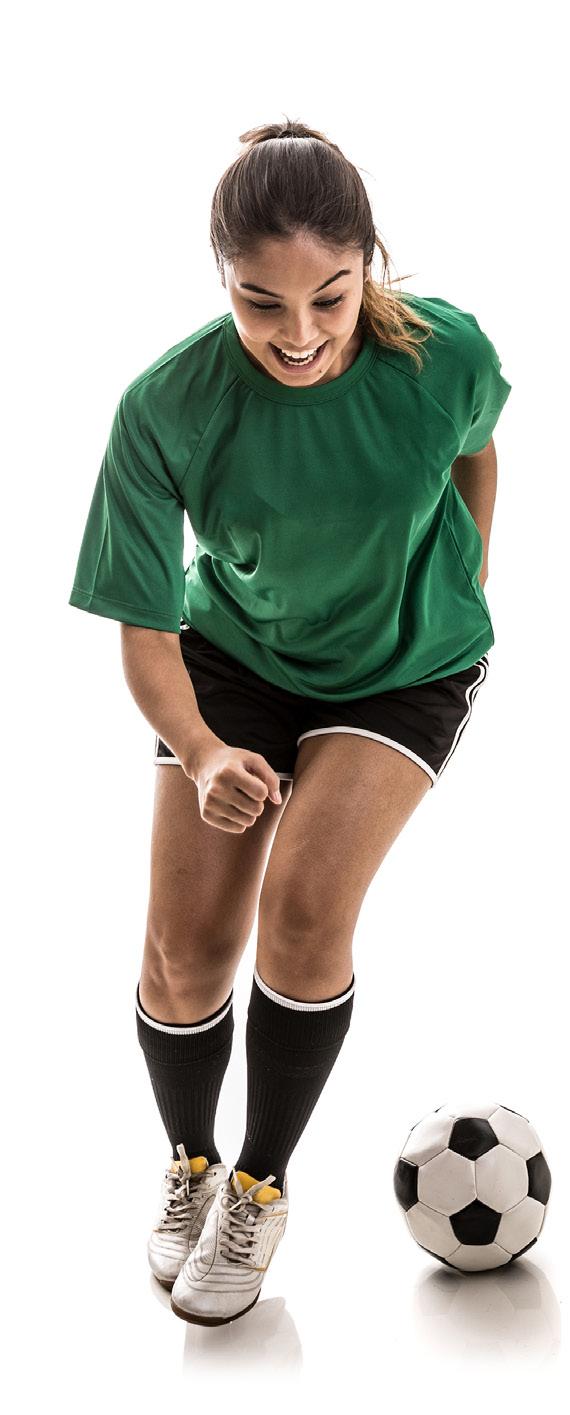
Specifications
This task requires you to:
• select an ethical dilemma in a class, school or community physical activity context to devise an ethics strategy
• identify the class, school or community physical activity context to frame the investigation
• use the ethical decision-making framework to conduct a context analysis
• define the ethical dilemma
• analyse and synthesise primary data and secondary data to ascertain the most significant relationships between the
– ethical dilemma
– influence of stakeholders on the ethics and values demonstrated in the class, school or
– community physical activity context
– tensions that exist in relation to integrity and fair play
– strategies that have been used in response to similar ethical dilemmas
• analyse and synthesise primary data and secondary data to devise an ethics strategy that provides a course of action in response to the ethical dilemma
• justify the development of the ethics strategy using evidence from primary data and secondary data
• evaluate the effectiveness of the ethics strategy to optimise integrity and positive engagement in the class, school or community physical activity context by appraising the potential outcome and limitations
• make decisions about and use language, conventions and mode-appropriate features to communicate information about the strategies to a technical audience in a written report.
It is recommended that this task is designed so that students can develop a response in approximately 5 hours of class time.
A link to the current syllabus is provided on the next page
Conditions
• You can develop your responses in class time and your own time.
• This is an individual task.
Response requirement
Written: up to 2000 words
Mark allocation
To view the complete ISMG for this assessment, download the Physical Education General Senior Syllabus. A link to the current syllabus is provided.
SOURCE 1
Source: Physical Education 2025 v.1.2 General Senior Syllabus © Queensland Curriculum & Assessment Authority
Tips for planning and researching your Investigation – report
Before beginning work on your Investigation – report, it is vital that you refer directly to the Physical Education General Senior Syllabus. This document contains all the specifications and ISMGs for this assessment and will help guide your planning, research and presentation.
Weblink: Physical Education General Senior Syllabus
The assessment advice in this lesson was correct at the time Physical Education for Queensland Units 3 & 4 was published; however, the QCAA may make changes to the syllabus from time to time. These changes may affect the structure of this assessment or the way in which it is marked. Check with your teacher to make sure you are using the most recent specifications for the task.
The Investigation – report requires you to research and investigate an ethical dilemma by collecting, analysing and synthesising primary and secondary data. In Unit 3 – Topic 2, you will be required to investigate one ethical dilemma in a class, school or community physical activity context to devise an ethics strategy. Your research and findings will be presented in a report format. To help you plan and complete the Investigation – report, it can be helpful to break it into two stages:
• Stage 1 – Research an ethical dilemma by collecting, analysing and synthesising primary and secondary data.
• Stage 2 – Present your findings in report format.
Both stages of the task will be assessed and marked against the assessment objectives contained in the instrument-specific marking guide (ISMG). This means that all parts of the task must be completed in order to maximise your chances of success.
Tips for creating and presenting your Investigation – report
The Investigation – report should be written in a structured format with headings. Common headings used in Senior Physical Education reports are outlined in Source 2.
Section
Title page In this section you should:
Description
• include the full title of your Investigation – report
• include your name, class and school.
Table of contents In this section you should:
• reference the headings of each section of your report and list the corresponding page numbers.
Introduction In this section you should:
• introduce the topic and frame the investigation by defining its focus (e.g. equity strategies for optimising engagement)
• identify the context (e.g. the physical activity you are studying in the unit or topic and the setting in which the unit is taking place).
Study tip
Data is key to your success!
In order to perform well on your Investigation –report, you will be required to gather, record, analyse, evaluate and justify a range of primary and secondary data relating to your performance of specialised movement sequences and movement strategies. For more information about all things data, go to Lesson 1.10 The importance of data (page 23) and Lesson 1.11 Putting data to use (page 25).
Section
Discussion In this section you should:
Description
• explain the strategy you devised and implemented and justify why you chose it
• evaluate the effectiveness of this strategy and justify your appraisal of its strengths, weaknesses and means for improvement
• base your justifications on the relevant primary and secondary data you collected, analysed and synthesised throughout the topic. This should be the largest section of your report.
Conclusion In this section you should:
• summarise (or briefly re-state) the main points you presented in the introduction and discussion sections.
Reference list In this section you should:
• acknowledge all the sources you cited in your report.
SOURCE 2 Sections to include in the Investigation – report
Note that the title page, table of contents and references are not included in the word count of your report.
Tips for referencing and crediting sources in your Investigation – report
Since a lot of the information you present in your Investigation – report will come from sources other than your own knowledge and research, it is crucial that you use conventions such as in-text citations and reference lists to acknowledge all of the sources you have used. Step-by-step information on how to cite secondary sources is provided in Lesson 1.11 Putting data to use (page 25).
Crediting and acknowledging secondary data sources is part of "ethical scholarship". Every time you make a claim in your report, you should support it with an in-text citation. That way, if the examiner asks themselves, "Says who? Why should I believe you?" your in-text citation will reference all the other secondary data from authoritative people who have made the same claim. In other words, it will help persuade the reader to accept your evaluation of the strategy you are discussing. Using primary data to support your research serves a similar function. It helps to convince the reader that your arguments are based on evidence, rather than opinion.
For more information about primary and secondary data, and to find out how you can best incorporate data into your Investigation – report, go to Lesson 1.11 Putting data to use (page 25).
For more advice and practical tips on how to create and present your Investigation – report, complete Lesson 1.6 Skill drill: Creating and presenting an Investigation – report on Oxford Digital

SOURCE 3 There are many different types of primary and secondary data all around you, so every time you make a claim in your report, you should support it with an in-text citation.
16 PHYSICAL
Skill drill
Lesson 1.6
Creating and presenting an Investigation – report
This lesson is available on Oxford Digital.
Lesson 1.7
Tips for success on the Examination – combination response
Introduction
As your final assessment for Physical Education Units 3 and 4, you will be required to complete an Examination – combination response. This is known as:
• External assessment , which is completed as part of Unit 4 – Topic 1: Energy, fitness and training integrated in physical activity. This assessment will contribute 25 per cent towards your overall mark.

SOURCE 1 The Examination – combination response is an external examination completed by all Physical Education students across Queensland. It will be taken under supervised conditions.
QCAA assessment advice on External assessment: Unit 4 – Topic 1 (25%)
General information
External assessment is developed and marked by the QCAA. The external assessment in Physical Education is common to all schools and administered under the same conditions, at the same time, on the same day.
Assessment objectives
1. Recognise and explain energy, fitness and training concepts and principles about movement.
4. Analyse and synthesise data to devise strategies about energy, fitness and training.
5. Evaluate energy, fitness and training strategies about movement.
6. Justify energy, fitness and training strategies about movement
7. Make decisions about and use mode-appropriate features, language and conventions to communicate meaning to inform a technical audience.
Note: Objectives 2 and 3 are not assessed in this instrument.
Specifications
This examination:
• consists of a number of different types of questions relating to Unit 4
Study tip
Cognitive verbs are important!
• To perform well in your examination, you will need to understand the meaning of a number of congnitve verbs.
• For more information about cognitive verbs, go to Lesson 1.9 Understanding cognitive verbs (page 22).
• may ask you to respond using – multiple choice – short responses (single words, sentences, paragraphs, images, labels or diagrams)
– extended responses.
A link to the current syllabus is provided.
Conditions
• Mode: written
• Time allowed
– Perusal time: 5 minutes
– Working time: 120 minutes
Instrument-specific marking guide (ISMG) No ISMG is provided for the external assessment.
SOURCE 2 QCAA assessment advice on External assessment: Unit 4 – Topic 1 (25%)
Source: Physical Education 2025v. 1.s General Senior Syllabus © Queensland Curriculum & Assessment Authority
Tips on the structure of the Examination – combination response
Before you begin revising and preparing for the Examination – combination response, it is important that you refer directly to the most recent version of the Physical Education General Senior Syllabus. This document contains all the specifications and instructions for this assessment.
Weblink: Physical Education General Senior Syllabus.
The assessment advice in this lesson was correct at the time Physical Education for Queensland Units 3 & 4 was published; however, the QCAA may make changes to the syllabus from time to time. These changes may affect the structure of the exam, the number or type of questions on it, or the way in which it is marked. Check with your teacher to make sure you are using the most recent specifications for the task.
The examination will ask you to demonstrate your knowledge and understanding of the subject matter in a particular unit by providing answers to a range of questions. During an examination, you will be asked to respond to unseen questions (i.e. questions you have never seen before) about subject matter from the unit or topic you have studied.
There are three parts you may encounter in Physical Education examinations:
• Part 1: Multiple-choice questions – In this part of the exam, you will be presented with a series of multiple-choice questions. Your task will be to select the most correct answer to each question.
• Part 2: Short-response questions – In this part of the exam, you will be presented with a number of short-response questions, which require answers such as single words, sentences, paragraphs, images, labels or diagrams.
• Part 3: Extended response – In this part of the exam, you will be presented with an extended-response question that includes a stimulus (e.g. a quote, data table, graph, image or illustration). Your task will be to compose a written response in response to the stimulus.
Tips on the conditions of the Examination – combination response
You will be required to respond to the questions on the examination on your own, under supervised conditions, and in a set time frame. You will have 2 hours (plus 5 minutes of perusal time) to complete the examination. During the perusal time, you are permitted to read the whole examination paper from start to finish and start planning your responses. You are not permitted to start writing until instructed.
In Units 3 and 4, examinations will be developed by the QCAA and will be completed by all students under the same conditions, at the same time and on the same day. They will be marked externally.
Tips on the importance of cognitive verbs in the Examination – combination response
Understanding the cognitive verbs used in Physical Education can help you do well in examinations. Short-response and extended-response questions, in particular, will often be structured so that the cognition (i.e. thinking skill) appears at the very beginning of the question. For example, you might be presented with a table of a player’s performance data before and after implementing a given feedback strategy. The question may then ask you to:
Analyse the data provided to explore the relationship between the task, the player’s results, and the feedback strategy they implemented.
Source: Physical Education 2019 v.1.1 General Senior Syllabus © Queensland Curriculum & Assessment Authority
Being able to correctly respond to a question like this requires you to know that the cognitive verb "analyse" means to: examine or consider something in order to explain and interpret it, for the purpose of finding meaning or relationships and identifying patterns, similarities and differences.
So, if you encountered this question in the examination, your answer should explain the links between the player’s data, the task through which they generated this data and the strategy they implemented that aimed to improve their performance in the task.
cognitive verbs task words that will provide information on what students are expected to provide in an answer to a question

SOURCE 3 The Physical Education examination will ask you to demonstrate your knowledge and understanding of the subject matter in a particular unit by providing answers to a range of multiple-choice, short-response and extended-response questions.
Tips on following instructions in the Examination –combination response
It is important that you read and follow the instructions provided on the examination carefully, so that you give yourself the best chance of doing well.
Tips for answering multiple-choice questions
Understanding the structure and requirements of multiple-choice questions can help you improve your chances of success in the examination. Each multiple-choice question on the examination will require you to select one option only. Your task will be to select the most correct answer to each question.
• Pay careful attention to the wording of each question. Reading the question carefully will ensure you have the best chance of answering it correctly, so don’t rush. Some questions also include particular wording, so be careful of questions that include:
– negative phrases (e.g. Choose the answer that does not describe …)
– subjective phrases (e.g. Choose the option that best describes …)
– judgement phrases (e.g. Choose the most correct answer …).
• Beware of distractors. It’s common for multiple-choice questions to contain a number of distractors, or incorrect options. In Physical Education examinations, it’s unlikely that you will see any distractors that are obviously wrong. Instead, it’s more likely that the question writer will be looking to test your knowledge by including distractors that include common student errors and misconceptions, or that are almost correct.
• Don’t leave any questions unanswered . Unless the examination paper specifically states that there will be a penalty for incorrect answers, you should always answer every multiple-choice question. If you’re not completely sure of the answer, make an educated guess.
Tips for answering short-response questions and extended-response questions
• Pay attention to the amount of space that has been allowed for your response If you have only written enough to fill about half the available space, there is a good chance that you are not on the right track. On the other hand, if you find yourself writing too much, you should look at what has been asked of you and focus on providing a clear, concise response. Avoid writing everything you know about a topic.
• Refer directly to the stimulus. If the question asks you to respond to a stimulus (e.g. a quote, data table, graph, image or illustration), it is essential that you do so in your answer. Most extended response to stimulus questions are designed to allow you to demonstrate your knowledge and understanding of a topic by applying it to the example provided. Whether you agree or disagree with the stimulus is not important. What is important is your ability to back up your point of view using what you have learnt.
• Structure your responses clearly. Whether you are writing a short answer or an extended response, begin with a very clear statement that directly responds to the question. If you are writing a number of paragraphs, begin each one with a clear topic sentence that explains the main point that you will develop. Use cue phrases such as "for example", "another example" or "in contrast" to highlight the fact that you are using specific evidence to support your ideas.
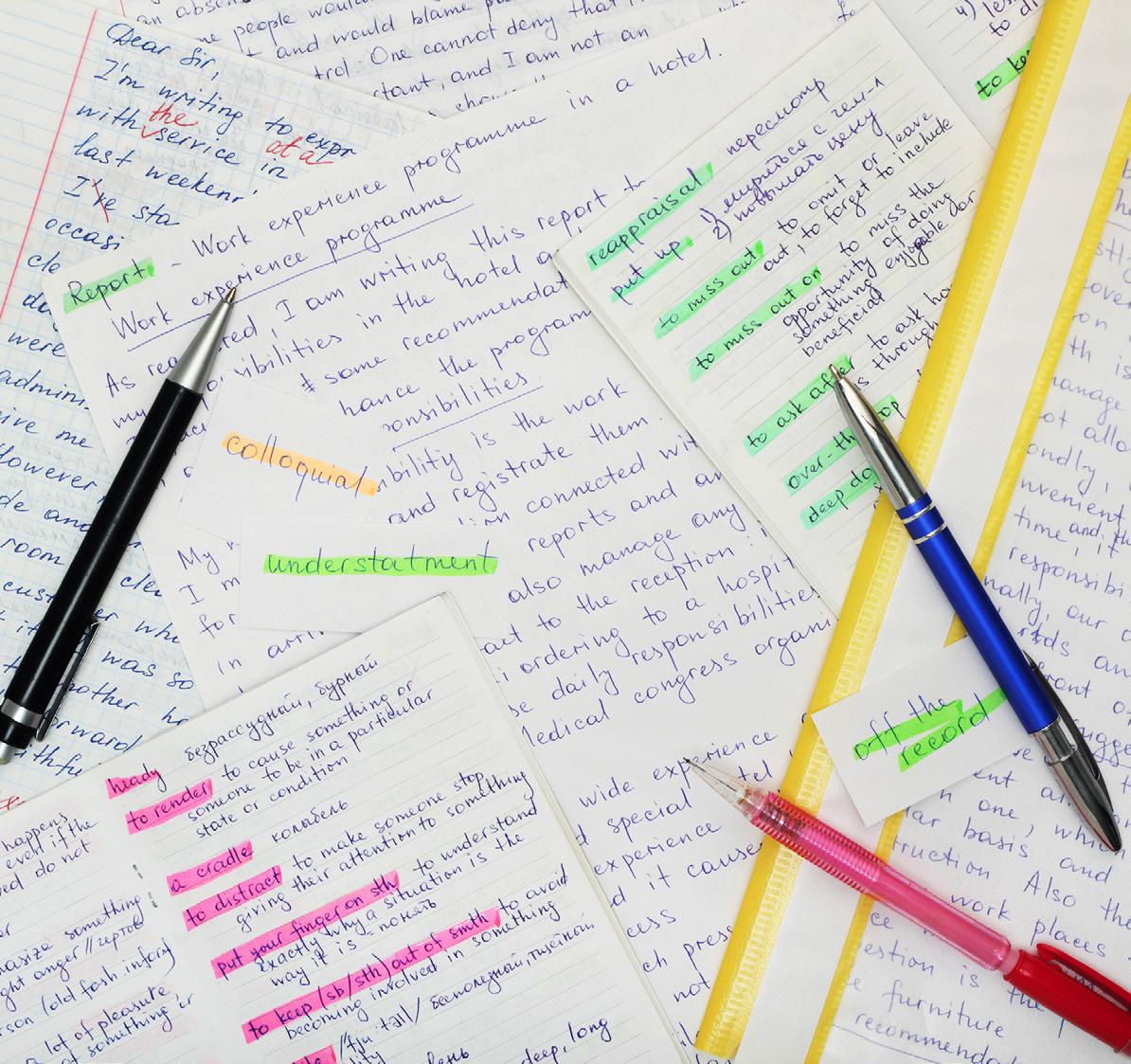
• Don’t just list facts. Responses that include a long string of facts will not necessarily receive high marks. To impress the marker, you need to interpret, synthesise and apply these facts to a range of relevant examples to show how they support your opinion. For more advice and practical tips on how to maximise your chances of success in the Examination – combination response, complete Lesson 1.8 Skill drill: Strategies for improving your results on the Examination – combination response on Oxford Digital
SOURCE 4 One of the best ways to prepare for the short response and extended response to stimulus questions on the examination is to practise!
Lesson 1.8
This lesson is available on Oxford Digital.
Skill drill
Lesson 1.9 Understanding cognitive verbs
What are cognitive verbs?
In all the assessments you are asked to complete throughout Units 3 and 4, it’s likely that questions and tasks will include an action word (e.g. define, discuss, analyse). In most cases, this action word is a "cognitive verb" (i.e. a doing word that describes a particular mental process or procedure). In simple terms, cognitive verbs are words that tell you what to do in order to demonstrate your understanding of the subject matter in the syllabus.
Some cognitive verbs are simple to understand and master (e.g. define), while others are more challenging to understand and will take time and practice to master (e.g. synthesise). The table in Source 1 lists some common cognitive verbs and their definitions. It also provides examples of questions and tasks so that you can see how each cognitive verb is used in context. In addition, you can refer to the complete list of all cognitive verbs provided on the QCAA website.
Weblink: QCAA glossary of cognitive verbs
Additional resource: Selected cognitive verbs
Term Explanation
analyse examine or consider something in order to explain and interpret it, for the purpose of finding meaning or relationships and identifying patterns, similarities and differences
define give the meaning of a word, phrase, concept or physical quantity; state the meaning and identify or describe the qualities
describe give an account (written or spoken) of a situation, event, pattern or process, or of the characteristics or features of something
discuss examine by argument; sift the considerations for and against; debate; talk or write about a topic, including a range of arguments, factors or hypotheses; consider, taking into account different issues and ideas, points for and/or against, and supporting opinions or conclusions with evidence
evaluate make an appraisal by weighing up or assessing strengths, implications and limitations; make judgments about ideas, works, solutions or methods in relation to selected criteria; examine and determine the merit, value or significance of something, based on criteria
explain make an idea or situation plain or clear by describing it in more detail or revealing relevant facts; give an account; provide additional information
Example of question/task using cognitive verb
Analyse the influence of motor learning concepts and principles on your demonstration of the forehand in lawn bowls.
Define the term "sport psychology".
Describe the main purpose of performance segmenting.
Discuss possible reasons for the lower participation rates in sporting clubs among girls aged 10–14.
Evaluate the effectiveness of a sport psychology strategy in optimising your attention while batting in cricket.
Explain how equity is concerned with giving value to, and celebrating, personal, social and cultural differences in society.
Term
Explanation
identify distinguish; locate, recognise and name; establish or indicate who or what someone or something is; provide an answer from a number of possibilities; recognise and state a distinguishing factor or feature
investigate carry out an examination or formal inquiry in order to establish or obtain facts and reach new conclusions; search, inquire into, interpret and draw conclusions about data and information
justify give reasons or evidence to support an answer, response or conclusion; show or prove how an argument, statement or conclusion is right or reasonable
reflect on think about deeply and carefully
synthesise combine different parts or elements (e.g. information, ideas, components) into a whole, in order to create new understanding
SOURCE 1 Cognitive verbs and some examples of them in use
Lesson
1.10
Example of question/task using cognitive verb
Identify personal factors acting as barriers and enablers to your participation in sport aerobics.
Investigate the use of different types of practice and feedback on archery performance.
Justify modifying or maintaining the motor learning strategy you implemented to optimise your badminton performance.
Reflect on the primary data you gathered about your implemented equity strategy.
Synthesise primary and secondary data about access, equity and engagement in the sport of basketball in your local community.
Source: Glossary of cognitive verbs, January 2018, Queensland Curriculum & Assessment Authority
The importance of data
Defining data
Data is a key element of the QCE Physical Education syllabus. In fact, the ability to analyse and synthesise data is one of the objectives of the course, and references to data are present in many of the subject matter dot points at every stage of inquiry across Units 3 and 4. This means that throughout your studies this year, you will be required to gather, record, analyse, evaluate, synthesise and reflect on a number of different types of data. Your ability to do this well will have a huge impact on your overall performance in the subject. So, what is data and why is it so important?
The word "data" is the plural form of the word "datum", which means "a piece of information". In general, data is any set of information that has been gathered for some purpose – usually analysis. It can include text and numbers, pictures, sound or video.
Data is an important component of the Physical Education syllabus because gathering and analysing data on your performances in your selected physical activities can help you develop an accurate picture of your strengths and identify areas for improvement. Knowing how to collect, analyse and draw appropriate conclusions from your data will also help you to evaluate whether the training programs and strategies for improvement you have put in place have been successful.
data information collected for reference, analysis and evaluation
Types of data
There are many different types of data that you will be expected to work with in Physical Education. These include the following:
Primary and secondary data
• Primary data is any data that you collect and record yourself. Primary data can relate directly to your performance or the performance of another person that you have observed. Examples of primary data in Physical Education include video footage or photographs of your performance, sketches you make of another person’s performance, the results of an interview you have conducted, personal performance statistics or reflections you record in your journal.
• Secondary data is any data that you did not collect or record yourself. Secondary data may still relate directly to your performance, but it was gathered and recorded by someone else. Examples of secondary data in Physical Education include video footage or photographs of elite athletes recorded by other people, sketches or visual analysis performed by other people, performance data for other athletes published in newspapers, books, magazines or journals.
When completing your assessments this year, you will be expected to draw on a combination of primary and secondary data. Secondary data should never replace primary data in your assessments. Instead, it should be included to provide supporting evidence to help you justify the conclusions you have made based on your primary data.
Qualitative and quantitative data
• Qualitative data is any type of data that can be recorded in words. Examples of qualitative data in Physical Education include describing aspects of performance – such as personal feelings, "quality" of movement, smells, colours, textures, tastes and thoughts –and recording them in a journal or diary.
• Quantitative data is any type of data that can be recorded in numbers. Examples of quantitative data in Physical Education include measuring aspects of performance – such as heart rate, weight, height, speed, stride length, distance covered and time spent in the air – and recording them in a Game Performance Assessment Instrument (GPAI).
When completing your assessments this year, you will be expected to draw on a combination of qualitative and quantitative data.
Assessing the quality of your data
Data can be found all around us, but not all of it is good quality. In order to ensure that you are working with the best data possible, make sure that it has the following characteristics. Your data should be:
• reliable – reliable data is consistent and can be replicated under stable conditions (e.g. data collected by a student every day over five days under the same conditions that yields similar results each time is considered reliable. Data collected by a student each day over five days under different conditions – and when the student is sick – that yields different results each time is considered unreliable)
• valid – valid data has a sound basis in logic and fact, and is actually testing what it is supposed to be testing (e.g. data collected in an authentic game environment will be more valid than data collected in a controlled environment such as a classroom or lab)
• accurate – accurate data has been checked for errors and is precise and exact (e.g. start and finish times collected during a race using a state-of-the-art computer timing system
will generally be more accurate than start and finish times collected by a person using an old stopwatch)
• relevant – relevant data is closely connected or appropriate to what is being investigated (e.g. data linking heart rate to levels of arousal during a soccer game would be considered relevant, while data linking heart rate to levels of intelligence would not)
• credible – credible data comes from reliable and trustworthy sources (e.g. data published by a renowned and experienced sports psychologist in a medical journal would be considered more credible than data published by an unidentified person on a commercial blog).
Lesson 1.11
Putting data to use
Key stages of data analysis
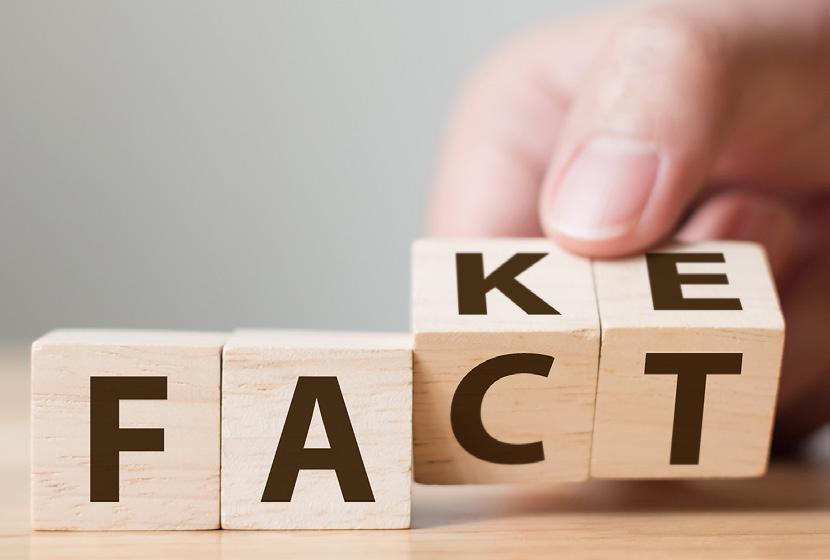
SOURCE 1 Data can be found all around us, but not all of it is good quality.
There are three key steps you need to follow to ensure that you have the data you need to help you devise strategies about body and movement concepts, to help you optimise your performance and engagement. These are outlined in Source 1. If you follow these steps, you will have good quality data to incorporate into your assessments in Physical Education this year and maximise your chance of performing well in the subject.
Step
Step 1: Gather, record and organise data
Step 2: Analyse and synthesise data
Step 3: Communicate your findings
Description
• Before you begin gathering your data, you need to understand what you want it for. Ask yourself what you want to do with the data, and exactly what you want to find out. Once you have established this, you can decide on the best method of gathering and recording the data you need (e.g. video recordings, journal entries, observation). Some methods of data collection and tools used for recording this data are discussed in more detail below.
• Once you have collected and recorded all your data, it can be helpful to organise it. To do this, you can group your data into different categories, making sure it is all complete and in the correct format. Having your data well organised will help make Step 2 of the process run more smoothly.
• Once you have collected and recorded your data, you need to analyse and synthesise it.
• To analyse data, you need to examine and inspect what you have gathered to make sure it is valid, reliable and credible. To do this, you will often need to break information down into smaller parts, and look for relationships, patterns, trends, similarities and differences in what the data is saying. The goal of analysis is to be able to clearly explain and interpret the data you have collected.
• To synthesise data, you need to combine information and data from different sources (that you have already analysed) to produce new information or ideas. Synthesis is often the stage at which you put all the smaller pieces of data together and draw conclusions about the bigger picture.
• Communicating your findings is the final step of the process. It involves converting the data into formats that can be easily understood by the people you are communicating with.
• There are many ways to effectively communicate your findings. Think about converting data tables into graphs, editing raw video footage into a shorter highlights reel, presenting your journal entries in an interactive presentation, or creating infographics, flowcharts or short films.
• The main goal of communication is to get your message across clearly and effectively in a way that engages your audience.
SOURCE 1 The key stages of data analysis
Gathering primary data
There are a number of different ways of gathering and recording primary data. These are described in the following sections.
Observation
Observation is one of the most common and useful methods for gathering data in Physical Education. Observation is a way of gathering data by watching behaviours or events in authentic environments and making notes about what you see and hear. Recording sheets and checklists (see below) are the most common and useful ways of collecting observation data. They should be prepared ahead of your observation session to help focus your attention on the key characteristics you are interested in. It is important to stay focused during observations. Any distractions will decrease the reliability and validity of your data.
Useful tools for gathering data during observations
• Game Performance Assessment Instrument (GPAI) – This is an observation tool that includes a range of criteria and is used to record information relevant to the performance of an athlete during a game or physical activity (e.g. data relating to skill execution, game involvement, game performance and performance analysis). A sample GPAI is available to download.
• Data Collection Instrument (DCI) – This is an observation tool that includes a range of criteria and is used to record information relevant to an athlete but not directly related to their performance (e.g. data related to demographics, motivation, participation, environmental factors and fairness). A sample DCI is available to download.
Additional resource: Sample GPAI
Video recordings
Additional resource: Sample DCI
Video recordings are an important and powerful method for collecting primary data related to performance. Video can be used to capture data about your performances (and the performances of others) so that it can be incorporated into your assessments. In fact, there is a requirement for you to create a folio of video recordings as part of your assessment in Physical Education in Units 3 and 4. You will use these recordings to demonstrate your ability to devise and apply strategies designed to optimise your performance.
Useful tools for gathering data during video recordings
• Digital video equipment – This can include smartphones, digital cameras and GoPro.
• Continuous high-speed photography – This can include smartphone "burst" mode or digital cameras.
• Video analysis apps – This can include apps such as Coach’s Eye, Spark Motion, Coach My Video or Dartfish.
• Camera drone – This can include a mobile drone fitted with video camera to capture gameplay from above.
For more advice and practical tips on how to capture and analyse video footage of physical performances, complete Lesson 1.12 Skill drill: Capturing and analysing video footage of physical performances on Oxford Digital
Personal reflection
Personal reflection is one of the most important ways of collecting primary data related to your performance. It is a record of your feelings, thoughts and opinions on how you are performing throughout the year. Although this data is mostly qualitative, it can give clear indications about your strengths and areas for development. A personal reflection should also include information about the context, a review of your performance and information about the playing conditions, team dynamics, your mood and physical condition.
Useful tools for gathering personal reflections
• Personal journal – A journal is the best way to record your reflections (see Source 2). A template will help you to record important aspects of your performance and keep your notes consistent. You should get into the habit of making an entry in your journal every time you perform. By combining quantitative data gathered about a performance (using a GPAI or DCI) with qualitative data gathered about the same performance (using a journal entry), you will have a complete picture and lots of great data to include in your assessments. A template that you can use to create a personal journal is available to download.
Additional resource: Personal journal template
Name: Crystal Hede
Date: 28/09/2020
Physical activity: Badminton
Topic: Motor learning
Independent variables
Lesson experiences
Playing conditions (weather, equipment, etc.)
Dependent variable: Performance summary (Link to data collected if available)
Excellent Good Okay Poor
My performance today was mostly good. I played 4 games of singles and 2 doubles. I won 3 out of 4 effectively but my net kills were particularly good. My GPAI shows that of the 23 net kill opportunities I had in my matches, 18 were winners. My poorest shot was my backhand clear. I was only successful in those 20 out of 47 attempts.
Summary (include a brief description that provides context and relevant of the information)
We played a round robin in both singles and doubles. I was paired with Kate Russell for doubles. She is about the same ability as me. My opponents in 3 of the singles games were cognitive learners and in the other match I played the best kid in the class.
It was really hot and stuffy in the gym as usual. I played at the ‘good’ end in 3 of the 6 matches (the ‘bad’ end has windows right behind the back of the opponent’s court making it hard to see the shuttle).
Position played NA
Mood (arousal, motivation, confident, concentration, etc.)
Physical condition (health, fitness, injury status etc.)
Team dynamics
I was in a good mood today. I felt pumped for the tournament and love playing badminton so was easily able to concentrate. I won my first 2 games easily, which meant my confidence was high and stayed high all the way through even after the losses I had.
My physical condition was pretty good because I am a swimmer and have a lot of stamina and strength. I didn’t have any injuries and I felt healthy.
I get on really well with Kate. We are able to read each other’s minds and communicate well on court. Because we play a similar way and at the same level, we have respect for each other and can trust each other to make shots when needed.
SOURCE 2 An example of an entry from a personal journal
Interviews and surveys
Interviews and surveys are another great way to collect data from an individual or group of people.
• Interviews are generally conducted as a face-to-face discussion and are designed to help you gather detailed qualitative data about a particular topic. They can also be recorded (e.g. audio or video) and used in your assessments. You should prepare some questions ahead of time and have a good idea of the information you are looking for in the interview, but you should also be responsive to issues that arise during the discussion and be prepared to ask questions on the spot if required (in order to get the best information possible).
• Surveys (also known as questionnaires) include a set of questions that participants are required to complete in writing. Depending on the questions you ask, surveys generally produce a good range of qualitative and quantitative information. As you may not be present when your survey is completed, it’s important that your questions are clear and cannot be misinterpreted. A weblink to help you write good survey questions is provided.
Weblink: Writing good survey questions
Useful tools for interviews and surveys

SOURCE 3 The internet is a useful tool that you can use to find relevant, credible and reliable sources.
• Online surveys – Websites such as SurveyMonkey and Typeform offer a free and easy way of gathering larger numbers of responses in a shorter period of time. They can also help you increase the reliability and validity of the data you collect and make it easier for you to analyse and graph the results.
For more advice and practical tips on how to conduct a survey and present the results, complete Lesson 1.13 Skill drill: Conducting a survey and presenting the results on Oxford Digital.
Gathering secondary data
Secondary data can be gathered and recorded in various ways, which are described in the following sections.
Published sources
Published secondary sources include things like textbooks, newspapers, magazines, government reports, TV news reports and journals.
Useful tools for gathering data from published sources
• School, local and state libraries – Even in the digital age, libraries can be a great source of secondary data. Many libraries – including the State Library of Queensland –also offer services that you may not be aware of (such as shipping books to you for free), so give them a try. This can be a great way to get valid and reliable data if you are short on time or live in a regional area.
Online sources
Although printed sources such as books and newspapers are valuable sources of secondary data, most research today is conducted online. Online sources include websites, social media groups, online journals, news sites and blogs.
To ensure that sources gathered online are accurate, reliable and relevant, you should always:
• verify that the information is supported by evidence that is referenced
• check and verify the information against other sources to make sure it aligns with the findings of other similar research
• check that the author is qualified, credible and not associated with any commercial company (i.e. is not biased)
• check to see if the material has been checked and edited by a professional publisher. You should never cut and paste information from the internet straight into your own work. Taking someone else’s work, ideas or words and using them as if they were your own is called plagiarism and can result in very serious consequences.
In the past few years, there has been an explosion in the availability of artificial intelligence (AI) tools. Any AI tool that can follow prompts to produce various types of content – such as text, images and audio – is known as generative AI (GenAI). While GenAI presents opportunities for students to deepen their learning and extend their thinking, the use of GenAI in summative assessments can compromise the authenticity of a student’s work and can be considered academic misconduct, particularly when GenAI tools are not attributed. Therefore, you should consult your school’s academic and assessment policies to ensure that you know the rules and limitations relating to GenAI.
Useful tools for gathering data from online sources
• Search engines – Search engines such as Google and Google Scholar are useful research tools, but much of the material found using these tools may be unreliable and may contain inaccuracies, false and misleading information, or material that is out of date. When using search engines like Google or Yahoo, be sure to define your search using keywords.
• Online educational databases – A reliable way of searching for sources is to use sites linked to government departments, reputable companies, museums, universities and other educational institutions. A quick way of telling if a site is reputable is to look at the domain name in the URL (internet address). Some of the most common domain names are listed in Source 4, along with some information about their reliability.
Domain
Description
.edu The site is linked to an educational institution such as a university or school. These sites are generally reliable.
.gov The site is linked to a government institution. These sites are generally reliable.
.net This site is linked to a commercial organisation or network provider. Anyone is able to purchase this domain name and generally there is no one to regulate the information posted on the site. As a result, these sites may be unreliable.
.org This site is linked to an organisation. Generally, these organisations are not for profit (e.g. Greenpeace, World Vision International, ACHPER). If the organisation is reputable and can be contacted, it generally means that the information provided has been checked and verified by that organisation. You need to be aware of any special interests that the organisation may represent (e.g. particular religious, commercial or political interests) as this may influence what they have to say on a particular issue. If you are unsure about the reliability of information found on a website with this domain name, check with your teacher or librarian.
.com This site is linked to a commercially-based operation and is likely to be promoting certain products or services. These domain names can be purchased by anyone, so the content should be carefully checked and verified using another, more reliable source.
SOURCE 4 Domain name descriptions
Citing secondary sources
As you identify and locate relevant sources, it is essential that you record details to include in your reference list or bibliography.
Citing published sources
When citing (i.e. mentioning) a published source in a bibliography, include the following, in this order, if available:
1 author surname(s) and initial(s)
2 year of publication
3 title of book (in italics)
4 edition (if relevant)
5 publisher
6 place of publication
7 page number(s).
Example
Hede, C., Russell, K., Weatherby, R., Brennan, M. & Gore, W., 2025, Physical Education for Queensland Units 3 & 4, Third edition, Oxford University Press, Melbourne, pp. 18–19.
Citing online sources
When citing an online source in a bibliography, include the following information, if available:
1 author surname(s) and initial(s) or organisation name
2 year of publication or date of web page (last update)
3 title of document (article) enclosed in quotation marks
4 date of posting
5 organisation name (if different from above)
6 date you accessed the site
7 URL or web address enclosed in angle brackets <…>.
Example
Australian Psychological Society, "Sport and exercise psychologists", accessed 20 August 2018, <www.psychology.org.au/for-the-public/about-psychology/types-of-psychologists/ Psychologists-with-an-Area-of-Practice-Endorsement/Sport-and-exercise-psychology>.
Finding credible sources online
For more advice and practical tips on how to use the internet to find relevant, credible and reliable sources, complete Lesson 1.14 Skill drill: Using the internet to find relevant, credible and reliable sources on Oxford Digital
Skill drill
Lesson 1.12
Capturing and analysing video footage of physical performances
This lesson is available on Oxford Digital.
Lesson 1.13
Conducting a survey and presenting the results
This lesson is available on Oxford Digital.
Skill drill
Lesson 1.14
Using the internet to find relevant, credible and reliable sources
This lesson is available on Oxford Digital.
Skill drill
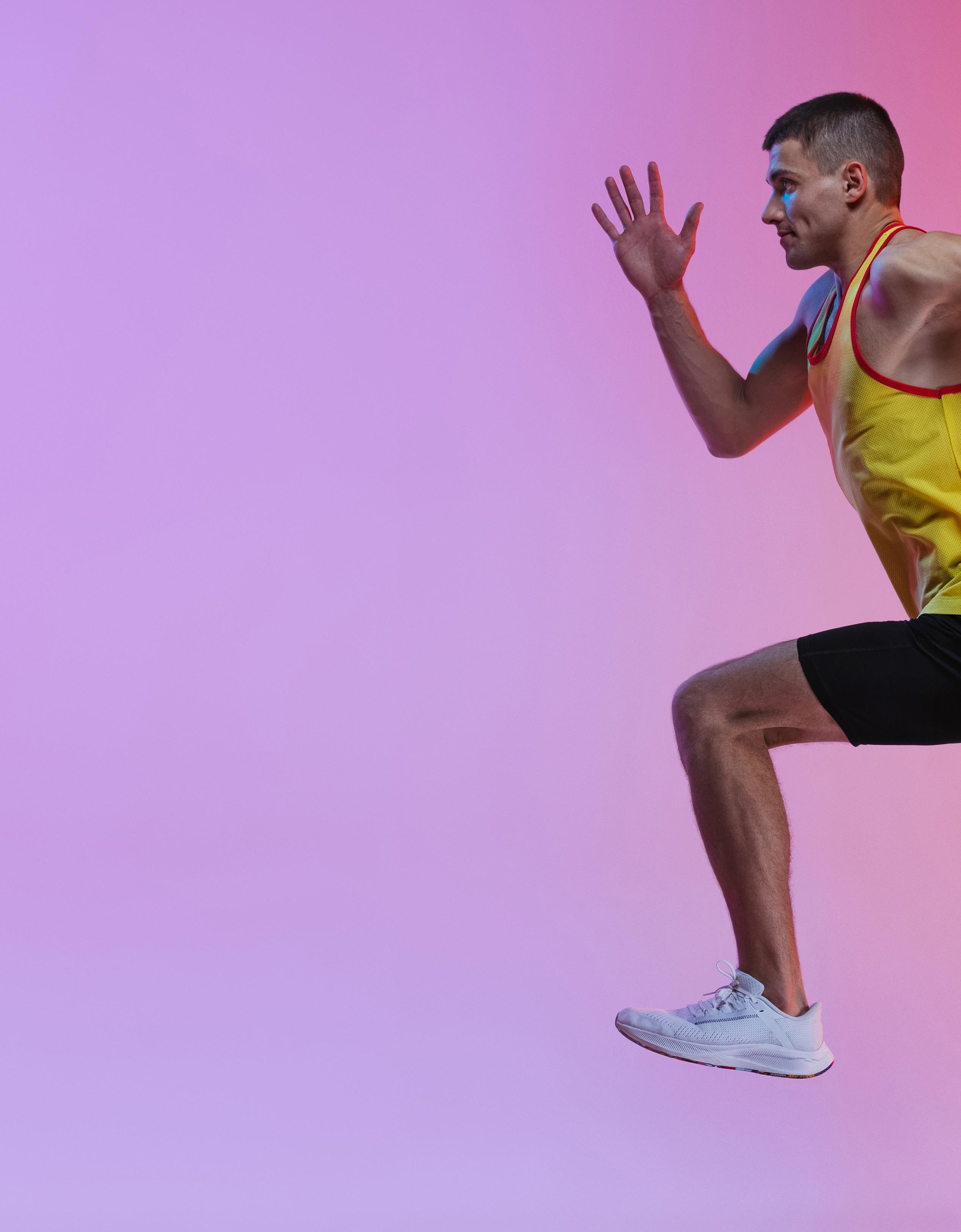
X UNIT 3
Tactical awareness and ethics in physical activity
Unit 3 objectives
In this unit you will:
1 Recognise and explain tactical awareness and ethics and integrity concepts and principles about selected physical activities
2 Demonstrate specialised movement sequences and movement strategies in selected physical activities
3 Apply concepts to specialised movement sequences and movement strategies in selected physical activities
4 Analyse and synthesise data to devise strategies about tactical awareness and ethics and integrity
5 Evaluate tactical, ethics and movement strategies
6 Justify tactical, ethics and movement strategies
7 Make decisions about and use language, conventions and mode-appropriate features for particular purposes and contexts.
Source: Physical Education 2025 v1.2 General Senior Syllabus © Queensland Curriculum & Assessment Authority
Unit 3 topics
The learning for this unit has been divided into two topics. The table below shows how each topic aligns with the modules in this book and lists the notional hours of teaching time for each.
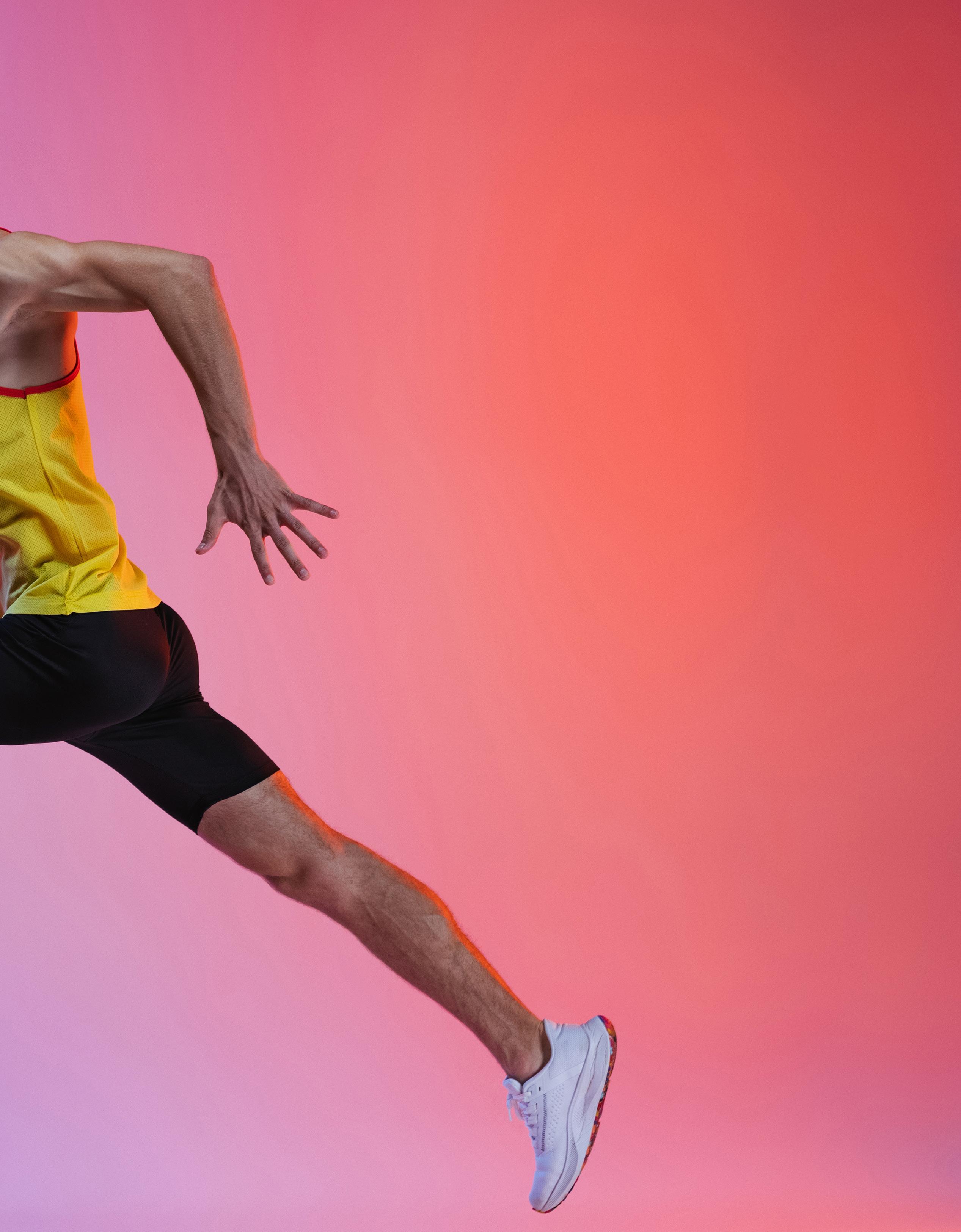
Note to teachers and students
In Topic 1 – Tactical awareness in physical activity, the physical activity must be selected from one of the "Invasion", "Net and court" and "Performance" categories.
In Topic 2 – Ethics and integrity in physical activity, schools should provide opportunities for students to participate in a wide range of learning experiences across a variety of categories of physical activity. The integration of the subject matter with a range of physical activities will provide opportunities to explore diverse issues about ethics and integrity.
Tactical awareness MODULE 2

Key terms
Subject matter outcomes covered in Module 2
The following table lists all the subject matter outcomes you are required to cover in Unit 3 – Topic 1 of the Physical Education General Senior Syllabus. It also shows you exactly where that subject matter is covered in this course. The full syllabus is available on the QCAA website.
Weblink: Physical Education General Senior Syllabus.
Unit 3 – Topic 1: Tactical awareness in physical activity
In Unit 3 – Topic 1, students engage in learning that involves the integration of tactical awareness subject matter and the subject matter for a physical activity from the “Invasion”, “Net and court” or “Performance” category.
Subject matter
• Recognise and explain that two major approaches to investigate motor learning have developed over time: cognitive systems and dynamic systems:
– the cognitive systems approach also referred to as the cognitive model, which is considered the more traditional approach, involves a hierarchical model of control where higher control centres pass commands to lower control centres, resulting in linear changes in movement; it requires an understanding of the process that occurs in making decisions, planning and executing movement.
– the dynamic systems approach also referred to as the ecological model, where movements emerge or self-organise through the dynamic interaction of the environment, the task being performed and the individual; movements are not organised hierarchically, involve non-linear and unpredictable changes, and emerge as part of a complex dynamic system.
• Recognise and explain that tactical awareness is a personal response to the interaction of constraints of the learner, task and environment during goal-directed behaviour in physical activity.
• Recognise and explain the alignment of dynamic systems to the complex nature of authentic game play.
• Identify and explore ecological models of learning, including dynamic systems.
• Recognise and explain that dynamic systems theory views the learner as a complex movement system of many independent and interacting parts, and that this system selforganises in response to the constraints placed upon it.
• Recognise and explain that dynamic systems theory views the learner as a complex movement system of many independent and interacting parts, and that this system self-organises in response to the constraints placed upon it. This includes the understanding that: – self-organisation involves the dynamic interaction of constraints on movement and, when specific constraints are present, the system organises into a specific yet stable state or preferred method of movement.
Lesson/s
Lesson 2.2 Approaches to motor learning and the development of tactical awareness (page 43)
Lesson 2.1 Introduction to tactical awareness (page 39)
Lesson 2.5 Decisionmaking in the dynamic systems approach to motor learning (page 63)
Lesson 2.3 The dynamic systems approach and ecological models of learning (page 50)
Lesson 2.2 Approaches to motor learning and the development of tactical awareness (page 43)
Lesson 2.3 The dynamic systems approach and ecological models of learning (page 50)
Subject matter
• Recognise and explain that dynamic systems theory views the learner as a complex movement system of many independent and interacting parts, and that this system self-organises in response to the constraints placed upon it. This includes the understanding that:
– constraints are the boundaries within which learners can explore and search for movement solutions within a physical activity, including:
» task constraints – the characteristics of the task that can influence movement, e.g. number of players, rules and equipment
» learner or individual constraints (or individual learner constraints) – any personal characteristics of the learner that can influence movement, e.g. height, weight, body composition, motor skills and motivation
» environmental constraints – any characteristics of the physical and social environment that can influence movement, e.g. playing surface, playing area, movement, noise, weather conditions, teacher, coach, peers and family.
• Recognise and explain that dynamic systems theory views the learner as a complex movement system of many independent and interacting parts, and that this system self-organises in response to the constraints placed upon it. This includes the understanding that:
– movement changes and progressions are non-linear as they involve abrupt changes from one stable state to another, e.g. changing from walking to running when increasing the speed on a treadmill.
• Analyse and synthesise primary data and secondary data about the influence of the constraints-led approach to learning and tactical awareness concepts and principles on movement sequences and movement strategies in physical activity.
Lesson/s
Lesson 2.3 The dynamic systems approach and ecological models of learning (page 50)
• Recognise and explain that the ecological model focuses more on how an individual interacts with the environment and proposes that information to control action is consistently and directly available from our senses through a perception–action coupling. This includes the understanding that:
– perception–action coupling provides a direct link between the process of interpreting or giving meaning to information from the environment and a specific action, e.g. perceiving the space between the defenders and responding with the action of running through the space
– perception can drive the action, but action can also drive the perception
– affordances are opportunities for action provided by the environment or task in relation to the learner’s ability, e.g. a space between touch football defenders affords the opportunity for a performer to exploit, by running through the gap, but only if they have the appropriate speed
– as a skill is learned, individuals become more attuned to the environment and the affordances that are available for movement. This enables the learner to identify opportunities for action from the environment, e.g. attune to the size of the space between the defenders that affords the opportunity for a performer to run through.
• Recognise and explain that a constraints-led approach to learning is a physical education teaching methodology that combines an understanding of the dynamic systems theory, which considers the constraints on the individual, and the ecological model, which considers how the system interacts with the environment.
Lesson 2.2 Approaches to motor learning and the development of tactical awareness (page 43)
Lesson 2.4 Skill drill: Devise a personal tactical strategy ( page 60)
Lesson 2.7 A constraintsled approach to teaching and learning (page 72)
Lesson 2.9 Skill drill: Evaluate the effectiveness of a personal tactical strategy (page 89)
Lesson 2.3 The dynamic systems approach and ecological models of learning (page 50)
Lesson 2.7 A constraintsled approach to teaching and learning (page 72)
Subject matter
• Identify and explore a constraints-led approach to learning in physical activity to allow opportunity for the emergence of movement sequences and development of movement strategies through:
– manipulation of task constraints, e.g. manipulating the scoring system, adapting specialised movement sequences
– consideration of variations among learners’ individual constraints, e.g. considering strengths and limitations of teammates and opponents.
• Identify and explore a constraints-led approach to learning in physical activity to allow opportunity for the emergence of movement sequences and development of movement strategies through:
– interaction with environmental constraints, e.g. varying dimensions within the area of play.
• Recognise and explain the principles of decision-making in physical activity, including:
– reading play
– recognising information and responding
– reacting to implement movement
– recovering with appropriate movements, e.g. recover with “on the ball” and “off the ball” movements.
• Identify and explore the principles of play, which are fundamental movement strategies used by individuals or teams to effectively adapt to any tactical situation in authentic performance environments, including:
– setting up attack
– defending against attack
– creating, defending and exploiting space
– attacking opposition space and scoring.
• Investigate “on-the-ball” and “off-the-ball” movements and decision-making in authentic performance environments, using body and movement concepts as criteria.
Examples include:
– body awareness, e.g. movement execution, pass or shot selection
– space awareness, e.g. movement pathways, use of space, when to run into space or when to pass
– quality of movement, e.g. force development, efficiency and outcome
– relationships, e.g. interaction with opponent and team members.
• Gather primary data about the relationships between a constraints-led approach to learning, tactical awareness concepts and principles, and personal performance of specialised movement sequences and movement strategies in authentic performance environments.
Lesson/s
Lesson 2.7 A constraintsled approach to teaching and learning (page 72)
Lesson 2.2 Approaches to motor learning and the development of tactical awareness (page 43)
Lesson 2.5 Decisionmaking in the dynamic systems approach to motor learning (page 63)
Lesson 2.5 Decisionmaking in the dynamic systems approach to motor learning (page 63)
Lesson 2.5 Decisionmaking in the dynamic systems approach to motor learning (page 63)
• Use secondary data to analyse how tactical awareness concepts and principles and a constraints-led approach to learning can influence performance in physical activity.
Lesson 2.4 Skill drill: Devise a personal tactical strategy ( page 60)
Lesson 2.6 Skill drill: Evaluate the effectiveness of decision-making in authentic game settings (page 70)
Lesson 2.9 Skill drill: Evaluate the effectiveness of a personal tactical strategy (page 89)
Module 2 Tactical awareness
Subject matter
• Analyse primary data and secondary data to ascertain the relationships between tactical strategies, concepts and principles, and personal and team performance.
• Optimise performance in physical activity by devising personal and team tactical strategies that consider the:
– manipulation of task, learner and environmental constraints as part of a constraints-led approach
– relevant body and movement concepts, and specialised movement sequences
– two different principles of play
– determined outcomes of performance in physical activity.
• Justify the development of tactical and movement strategies using evidence from primary data and secondary data.
• Implement tactical and movement strategies to gather primary data about the outcomes, and limitations of decisions.
• Reflect on primary data and secondary data to evaluate the effectiveness of tactical strategies to achieve a determined outcome:
meeting the performance requirements of the physical activity
manipulating task, learner and environmental constraints as part of the constraints-led approach
optimising the performance of specialised movement sequences and movement strategies.
• Make decisions to maintain or modify the tactical and movement strategies to optimise performance in physical activity.
• Justify maintenance or modification of the tactical and movement strategies using evidence from primary data and secondary data.
Lesson/s
Lesson 2.4 Skill drill: Devise a personal tactical strategy (page 60)
Lesson 2.6 Skill drill: Evaluate the effectiveness of decision-making in authentic game settings (page 70)
Lesson 2.9 Skill drill: Evaluate the effectiveness of a personal tactical strategy (page 89)
Lesson 2.10 Review: Tactical awareness (page 92)
Source: Physical Education 2025 v1.2 General Senior Syllabus © Queensland Curriculum & Assessment Authority
Lesson 2.1
Introduction to tactical awareness
Key ideas
→ Tactical awareness is the ability to identify what is happening in a game situation and use this information to select and implement the correct physical responses to increase the chances of a successful outcome.
Defining tactical awareness
Tactical awareness is an athlete’s ability to best respond to the task and environmental demands in physical activity. Athletes who demonstrate tactical awareness will respond appropriately to these demands to increase their own potential, or that of their team, to score or win. Examples of tactical awareness are:
• passing a ball to a teammate who is free and in a good position to score
• running into an open space to draw a defender out of an area and open a lane for a teammate to use
• hitting a ball into space away from an opponent’s position
• finding the best moment to make a break during a track event.
Being tactically aware involves tuning in to everything that is going on within and around you during a performance so you can take advantage of your situation. This includes being attuned to:
• the people around you – being constantly aware of your position on the field or court in relation to other players; understanding the particular playing styles of your teammates and/or opponents; having the ability to identify the strengths and weaknesses of each player you are interacting with
• the environment you are in – understanding the playing conditions (e.g. quality of pitch/court), weather conditions (e.g. wind, rain, fog), equipment conditions (e.g. size, shape, age, weight, quality)
• your own physical and mental cues – tuning in to what is happening in your body, including feelings of fatigue, pain or strength as well as mental feelings such as confidence or excitement.
Athletes who can take all of this information into account during a game – and process it quickly to make informed and accurate predictions and decisions about how to act – can significantly increase their chances of success, regardless of the sport they are playing.
The importance of tactical awareness in sport and physical activity
When we think of great athletes, names such as Caitlin Clark, Tom Brady, Nathan Cleary and Ash Barty come to mind. They each possess outstanding skill and technique, but it is more than this that makes them exceptional at what they do. What sets them apart from other athletes in their sport is their ability to read play and make informed predictions and decisions in the moment to set themselves or their team up for success. In other words, they
Learning intentions and success criteria
tactical awareness an athlete’s ability to identify and interpret what is happening within a game situation to help them select, adapt and apply the best physical responses and increase their chances of success
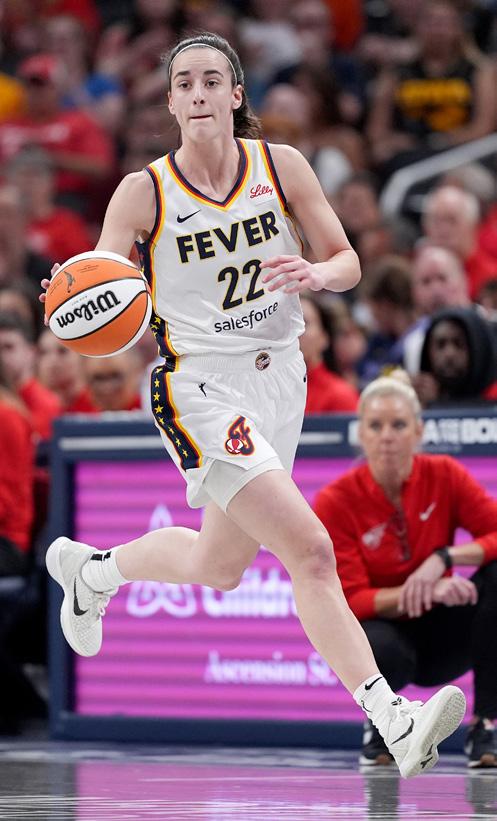


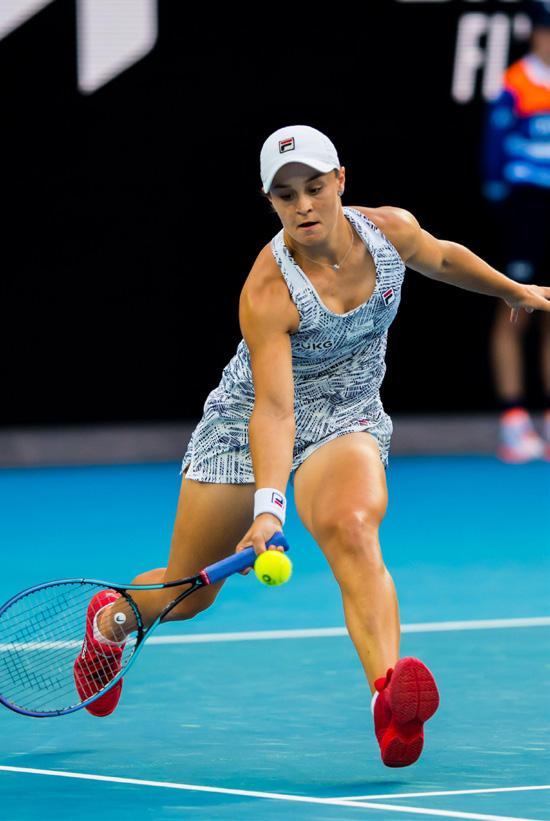
are able to consistently make the right decisions and execute the appropriate skills at the best possible time. Their tactical awareness puts them at the top of their game and makes them very difficult to beat.
When athletes are tactically aware, they can scan the environment and take in all the relevant information, looking for the opportunities that give them the best chance to achieve success.
Athletes such as NRL legend Nathan Cleary are often credited with having great tactical awareness because they can respond to the way a game unfolds much faster and more accurately than other players on the field.
At the age of 27, Cleary is regarded as one of the greatest rugby league playmakers of all time. Another NRL legend, former Australian representative Cooper Cronk, has said Cleary “knows what he is about to do before he does it, because he knows the cues from the opposition. [He] studies the opposition. He knows what they do and their tendencies, but he has also got this combination of 10 000 hours of multiple repetitions with all those players around him.”
Great tactical players not only spend time practising skills; they immerse themselves in the game. They learn the game’s structures and strategies through watching and playing in authentic environments. Through immersion in the game itself, they can tune in to the subtle and not-so-subtle cues that prompt them to implement their skills in ways that optimise their own or their team’s performance.
Tactical awareness in different categories of physical activity
In Unit 3 – Topic 1, you will be required to focus on the concepts and principles of tactical awareness in relation to one physical activity from either the “Invasion” physical activities listed in Source 2, the “Net and court” physical activities listed in Source 3 or the “Performance” physical activities listed in Source 4.
SOURCE 1 Great athletes such as (A) Caitlin Clark, (B) Tom Brady, (C) Nathan Cleary and (D) Ash Barty have outstanding talent, skill and technique, but what sets them apart is their ability to read play in order to make informed predictions and split-second decisions. This ability is known as tactical awareness.
“Invasion” physical activities
In Unit 3 – Topic 1 of Senior Physical Education, “Invasion” physical activities are:
• Australian football
• basketball
• futsal
• netball
• soccer
• touch football
• water polo.
Additional resource: “Invasion” physical activities
SOURCE 2 “Invasion” physical activities
“Net and court” physical activities
In Senior Physical Education, “Net and court” physical activities are:
• badminton
• tennis
• volleyball.
Additional resource: “Net and court” physical activities
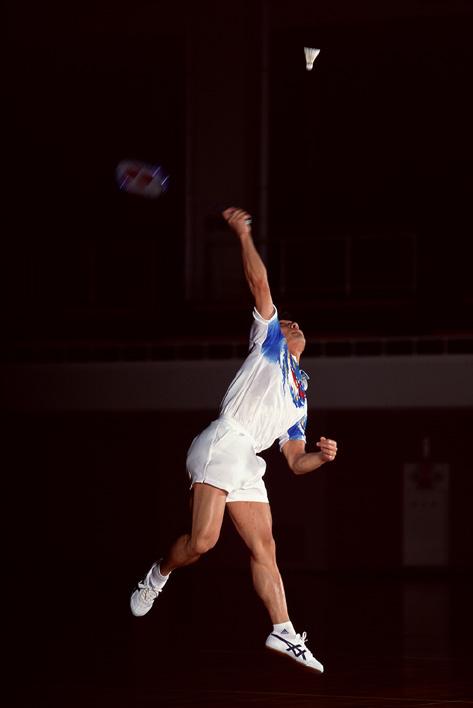
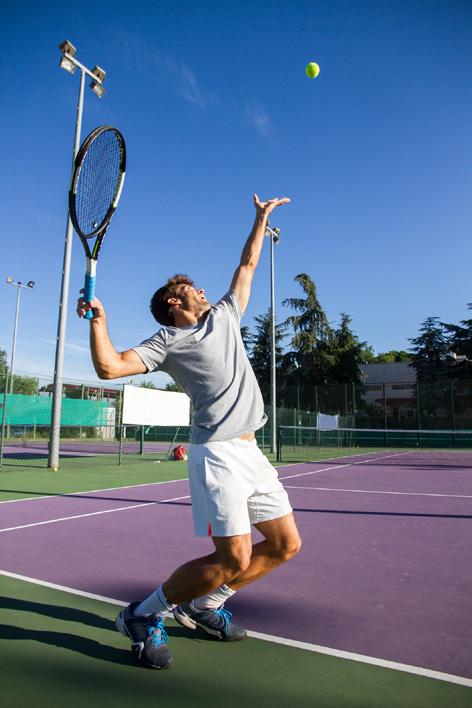
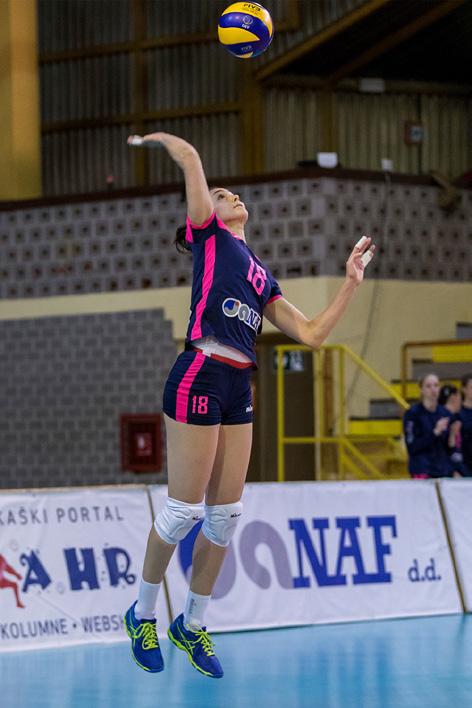
SOURCE 3 Although “Net and court” physical activities have very varied rules, the techniques used are similar (e.g. serving in tennis is similar to serving in volleyball and badminton)
“Performance” physical activities
In Senior Physical Education, “Performance” physical activities are:
• duathlon, aquathlon, triathlon
• swimming
• track and field – jump
• track and field – throws
• track and field – track.
Additional resource: “Performance” physical activities
SOURCE 4 “Performance” physical activities
Retrieve it!
Recall and make a list of as many key terms as you can from Unit 1 Motor learning.
SOURCE 5 Olympic runners in the 800-metre event begin with a race plan but must be responsive to the task and the environment on the day. This tactical awareness ensures they can get into a good position when it counts and optimises their performance.
Why study tactical awareness?
Developing tactical awareness is an essential skill for every athlete, regardless of their chosen physical activity. In sports requiring complex interactions between the team members and their environment – such as “Invasion” and “Net and court” physical activities – the development of skills alone is not enough to achieve success. To optimise performance and maximise the chances of a successful outcome, players need to be able to read the situation (i.e. identify what is happening around them) and use this information to select and implement the correct physical responses.
Even in “Performance” physical activities such as aquathlon, swimming and track and field events, athletes must be tactical in their approach. In the lead-up to competition, athletes’ training will include tactical awareness, but they must also adapt to changing conditions during their performance. Such conditions include the weather, opposition positioning and even internal messages such as muscular fatigue. Knowing when and how to make a move is something that great athletes determine on the day in response to the cues they perceive as they compete.
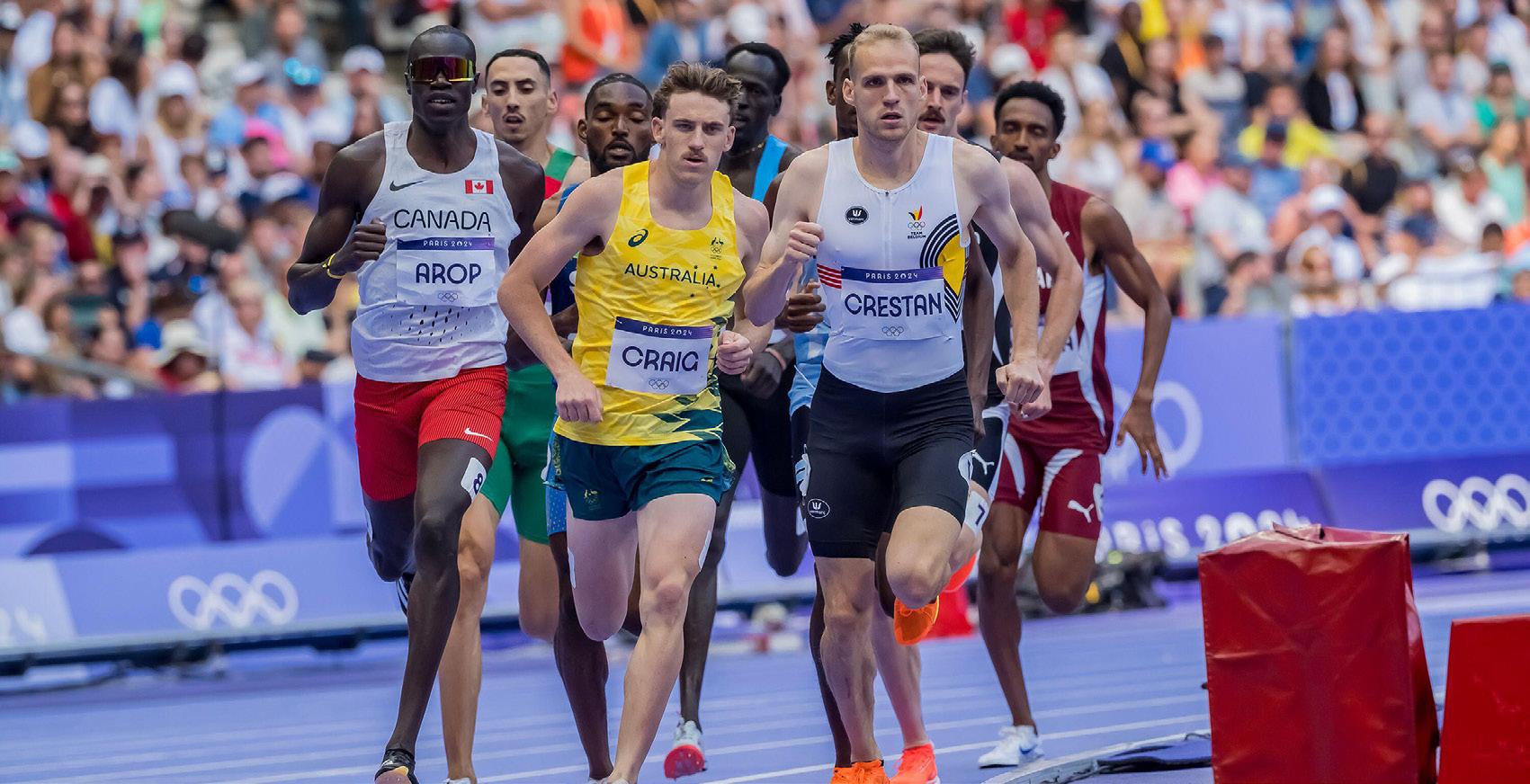
Developing tactical awareness is a complex process that can take time to master, but it can be targeted through considered training. Developing skills and movement sequences through authentic game-like environments can provide athletes with opportunities to attune to the cues experienced in gameplay and help them to acquire greater tactical awareness sooner.
What the research says
Within invasion sports, game intelligence is an important component to proficient athlete performance. Game intelligence can be investigated as two separate but related attributes, tactical and decision-making skills. Tactical skills are defined as knowledge of in-game adaptations and decision making (Elferink-Gemser, Kannekens, Lyons, Tromp, & Visscher, 2010), involving the player performing the correct action at the right moment (Kannekens, Elferink-Gemser, & Visscher, 2011). Therefore, unlike physiological skills, tactical skills depend on cognitive information, including knowledge of the goals and actions of the game, awareness of skills and understanding of actions within the context of the game (Thomas, French, & Humphries, 1986).
O’Connor, D. & Larkin. P., 2017, in International Research in Science and Soccer II. Routledge.
Throughout this module, we will be exploring theories and models to help us understand the ways in which athletes develop tactical awareness. To do this, we will begin by developing a basic general understanding of how people learn, and then look at how they learn (acquire) and remember (retain) the skills to perform the specialised movement sequences required for sport and physical activity. This field of science is known as motor learning specialised movement sequences a combination of fundamental movement skills (and movement elements) that enable the body to move in response to a stimulus motor learning a field of science that investigates human movement with the goal of understanding how humans acquire and retain the motor skills required to perform specialised movements (through practice, experience and/or feedback)
Check your learning 2.1
Retrieval and comprehension
1 Choose the correct answer. Which of the following is not an example of tactical awareness?
A Passing to a teammate who is open further down the court during a fast break in basketball
B Shooting 50 netball shots a day
C Diving to score a try in touch football
D Running in the lead group for the first lap of the 800-metre event
4 Select one of the athletes shown in Source 1 and find video footage of them performing. Analyse this secondary data and describe a part of the footage in which they demonstrate a high degree of tactical awareness and thereby achieve a successful outcome. Check your learning 2.1
2 Explain why tactical awareness is an essential skill for every athlete to develop, regardless of their chosen sport or physical activity.
Analytical processes
3 Identify a movement strategy in your selected physical activity and consider the cues you might look for in order to optimise the implementation of this movement strategy during competition.
Lesson 2.2 Approaches to motor learning and the development of tactical awareness
Key ideas
→ The cognitive systems approach is a broad theoretical framework used to help explain the processes involved in motor learning. It suggests that learning is hierarchical (i.e. top down) and linear (i.e. one command after the other) and controlled by a central command centre in the brain.
→ The dynamic systems approach is a broad theoretical framework used to help explain the processes involved in motor learning. It suggests that our movements are coordinated and controlled through complex, non-linear interactions between all parts of the body, and that no single body system or part is more important than another in the learning process.
Introduction
Humans are born to move and have the capacity to do so with great skill! We might marvel at the feats of skilled athletes such as Simone Biles performing intricate moves during a gymnastics floor routine or Nathan Lyon contorting his arm to cause maximum movement of the ball as he spin bowls it down the cricket pitch to the awaiting batter. But how did they become so skilled?
Learning intentions and success criteria
motor skill a voluntary movement that involves the use of specific muscles with the aim of achieving a defined purpose or goal; motor skills can be learnt and improved with practice
Skill can be broadly considered as the capacity to control our bodies to achieve certain goals. In sport, motor skills are specific to the requirements of the physical activity and develop in response to the demands being placed on the performer within their environment. Every motor skill in our toolkit is a result of a long and often arduous journey of learning and practice.
The learning process – including the development of tactical awareness – is extremely complex and involves many different organs and systems in the body. For centuries, scientists have investigated the process of learning in an attempt to understand exactly how humans learn, remember and perform new motor skills. Over time, they have developed many different approaches (i.e. broad theoretical frameworks) that attempt to explain how humans learn and how we are able to remember the thousands of motor skills and specialised movement sequences we perform every day. This field of science is known as motor learning.

SOURCE 1 The field of motor learning studies how we learn and remember motor skills and specialised movement sequences, such as returning a serve in tennis.
Defining motor learning
Motor learning in physical activity contexts refers to the acquisition and modification of learnt movement patterns over time. We know motor learning has occurred in an individual when their execution of motor skills has improved. In Physical Education, motor learning is a field of study that seeks to explain this acquisition of motor skills in authentic performance environments. Specifically, motor learning investigates:
• factors that influence the performance of motor skills
• how quickly motor skills are learnt
• how well motor skills are learnt
• how well motor skills are retained over time.
It is important to understand that motor learning is not just interested in the acquisition and replication of a skill outside of a performance environment. A successfully acquired motor skill must be able to be consistently performed to meet the demands of the physical activity. Motor learning therefore considers the development of:
• specialised movement sequences and movement strategy execution within performance environments
• the speed and accuracy of decision-making within performance environments
• the adaptation of skill and strategic execution in the face of changing conditions such as weather, internal factors such as fatigue or other unexpected environmental changes.
Major approaches to motor learning
In Unit 1 – Topic 1 of the QCAA Physical Education General Senior Syllabus (which studies motor learning in selected physical activity), you learnt about two of the major approaches that were developed to help explain the process of motor learning. These are known as:
• the cognitive systems approach – an older, more traditional approach to understanding motor learning
• the dynamic systems approach – a newer, evolving approach to understanding motor learning.
Although they are different in many ways, both of these approaches attempt to explain exactly how motor learning takes place. We will now briefly revisit both of these major approaches to:
• get a better understanding of how each one explains the process of learning
• learn more about the types of learning environments, training programs and coaching techniques that are most effective when it comes to helping learners develop particular skills and tactical awareness in sport and physical activity.
Cognitive systems approach
Older, more traditional approach
Hierarchical and ‘top down’ (i.e. brain as command centre)
Linear and predictable
Dynamic systems approach
Newer, evolving approach
Dynamic and ‘complex’ (i.e. whole body self-organising)
Non-linear and unpredictable
SOURCE 2 Over time, two major approaches have been developed to help explain how the process of motor learning takes place: the cognitive systems approach and the dynamic systems approach.
The cognitive systems approach to motor learning
The basic idea behind the cognitive systems approach to motor learning is that the brain works like a computer that controls the body independently of the environment. According to this approach, a part of the brain (the prefrontal cortex) acts as the central command centre and creates an action plan for movement based on its interpretation of the cues it receives from the body’s various senses. It suggests that although our sensory system absorbs cues from the environment, these cues are weak and static and require our brain to piece together their meaning and create an appropriate action plan in response. Once the action plan is in place, the brain informs the relevant muscles to carry out the plan one step at a time. For these reasons, the cognitive systems approach is often described as:
• hierarchical or “top down” because it assumes that higher control centres (i.e. the brain) pass commands down to lower control centres (i.e. the muscles and nerves)
• linear because it assumes that the commands are sent from the brain in a predetermined order (i.e. step by step, one command after the other).
cognitive systems approach a theoretical framework used to help explain the processes involved in motor learning; according to this approach, the brain acts as the central command centre for the body. It creates action plans for movements based on information it receives from the body’s senses and instructs the muscles to perform these actions in a linear order (i.e. step by step)
dynamic systems approach a theoretical framework used to help explain the processes involved in motor learning; according to this approach, the intelligence that coordinates and controls body movements is the result of complex interactions between the individual, the environment and the task
Approaches to explain motor learning
Study tip
It might help you to revisit and revise the key features of the cognitive systems approach and dynamic systems approach to motor learning that were covered in Unit 1 of the QCAA Physical Education General Senior Syllabus. If you still have access to Physical Education for Queensland Units 1 and 2, you can find this information in Lesson 2.3 The dynamic systems approach and ecological models of learning and Lesson 2.4 Skill drill: Devise a personal tactical strategy.
According to the cognitive systems approach, when learning a dig in volleyball, for example, the brain creates an action plan (i.e. a motor program) based on the demands that must be met to successfully complete the task. That action plan considers all the necessary movements (i.e. sub-routines) required to complete the dig. It then sends each of these commands (in a predetermined order) to the relevant muscles that are needed to perform the skill and complete the task.
This science has informed coaching practices for many years. Coaches using a cognitivebased approach demonstrate and explain to their athletes what they need to do, and when and how they need to do it. Often, specialised movement sequences are first taught repetitively in isolation from a performance environment (i.e. in closed environments) to make them more predictable and enable the athlete to perfect the finer details of the movement. The assumption is that athletes need to become technically proficient before they start honing their tactical awareness by increasing the complexity of the task and practising skills in authentic performance environments such as gameplay.
The benefits of a cognitive-based approach include:
• control over variables
• ease of planning
• convenient implementation.
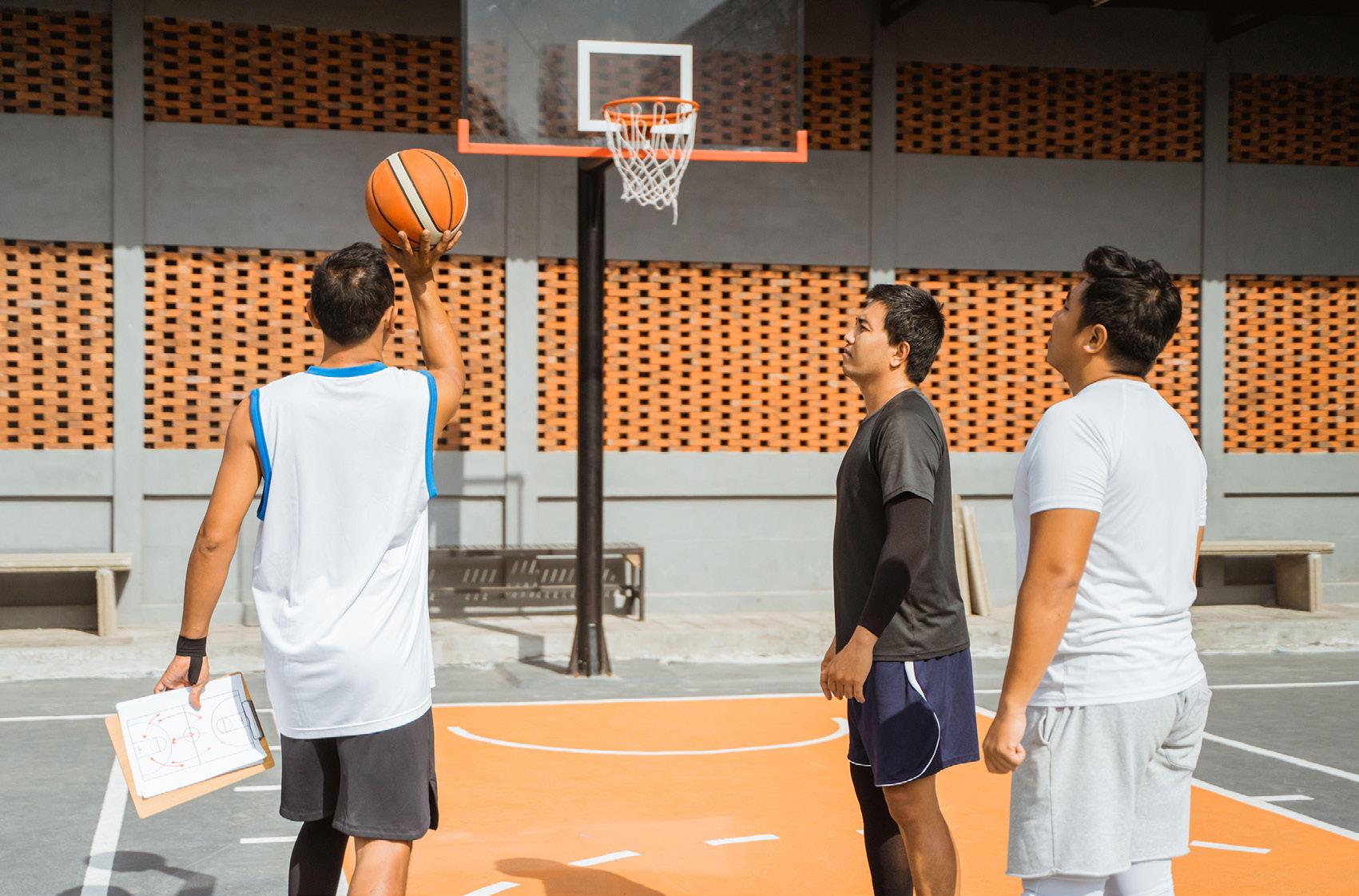
SOURCE 3 Coaches using a cognitive systems approach will demonstrate the correct way of completing a skill outside of a performance environment to help the athlete to perfect their technique.
The dynamic systems approach to motor learning
Driven by a desire to explore new ideas and understand more deeply, sports scientists continually research and challenge established ways of doing things. This process has led to the development of new approaches and theories about motor learning, including the dynamic systems approach.
The dynamic systems approach proposes that the body is a complex organism made up of many different systems (e.g. nervous system, respiratory system, cardiovascular system,
muscular system and skeletal system) and parts (e.g. bone, muscle fibres, blood cells, oxygen molecules and enzymes) all working together simultaneously to produce movement in response to the demands of the environment and its constituents.
Unlike the cognitive systems approach, which views motor learning as an organised process, the dynamic systems approach views motor learning as a much more complex, unpredictable and constantly changing process (hence the name dynamic).
The dynamic systems approach rejects the idea that our movements are coordinated exclusively by a single, centralised command centre (i.e. our brain). Instead, it suggests that our movements are coordinated and controlled through complex, non-linear interactions between all parts of the body – and that no single body system or part is more important than the others in the learning process.
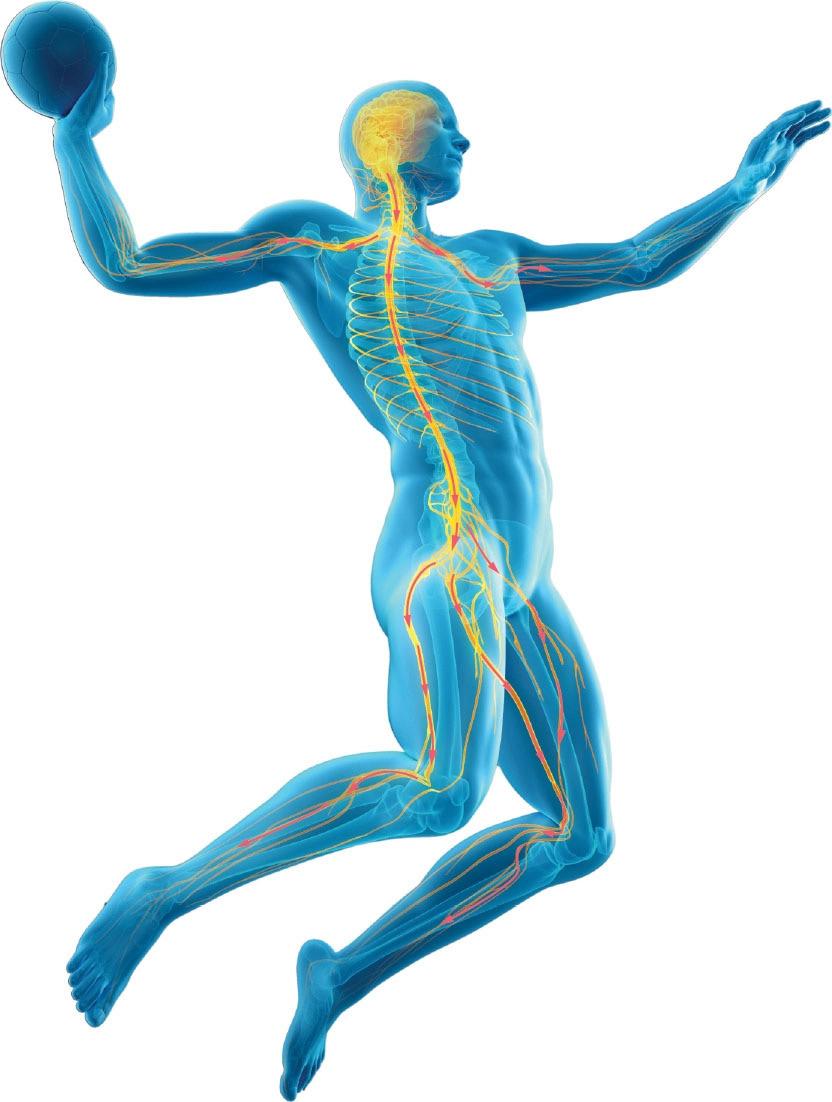
dynamic a term used to describe a process or system that is constantly changing
SOURCE 4 According to the cognitive systems approach, the brain works like a computer to control the body. To learn and perform the throw shown here, the brain creates an action plan that lists all of the movements required. It then sends each of these commands (in order) to the relevant body systems and muscles required to perform the skill.
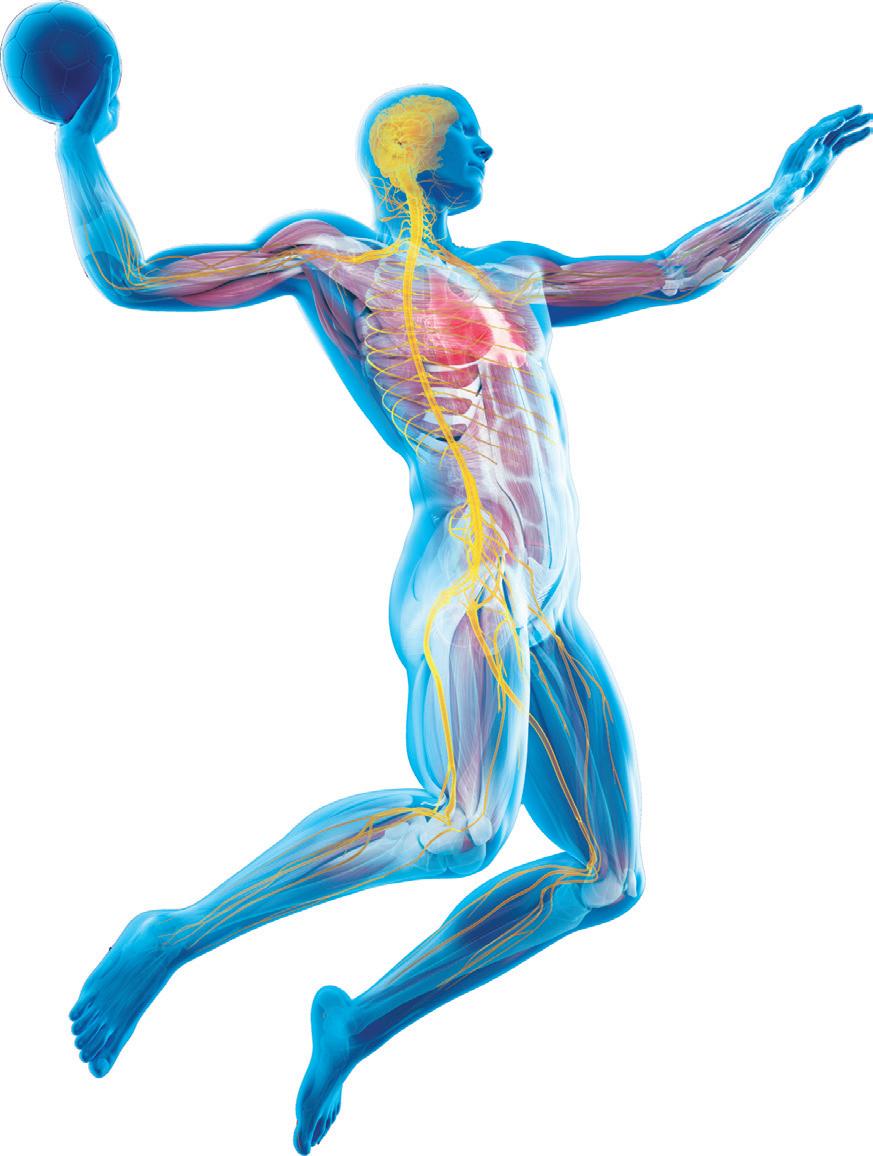
5 According to the dynamic systems approach, the body is a complex organism made up of many different systems and component parts, each of which is constantly interacting with the others as well as with the outside world. To learn and perform the throw shown here, all body systems are involved in a complex and dynamic interaction between the task, the learner and the environment.
SOURCE
Retrieve it!
Recall the two cognitive systems models of motor learning from Unit 1 Motor learning and explain the theory behind them.
constraints-led approach an approach to teaching and learning that involves manipulating constraints in authentic game situations so that learners are challenged to find their own movement solutions to the problems they face (or the goals they want to achieve); as opposed to more traditional coaching techniques that favour coachdirected technical drills performed in isolation outside authentic game situations
The dynamic systems approach proposes that, with a favourable environment and a suitable task to perform, an individual will spontaneously and dynamically produce effective and efficient movement sequences over time. That is, movements emerge or self-organise through the dynamic interaction between the task being performed, the individual learner and the environment they are in. This happens because of our body’s natural inclination to acheive a stable state. The complexity of this newer approach is useful when it comes to explaining how learning takes place in authentic game environments (i.e. open environments) that are similarly complex. It also highlights that a successful solution to a problem or challenge may not be limited to one specific technique or movement. Instead, a successful outcome might be achieved by implementing one of many different strategies, skills or techniques, all with a similar effect.
Coaches using a dynamic systems approach will cleverly manipulate the performance environment to compel the athlete to find the movement solution that works best for them in the environment. In other words, the coach refrains from telling the athletes exactly how they should move their body to complete the task. Instead, they set a task for their athletes with a range of parameters in place and the athletes are then given some freedom to find a solution to the task that achieves the goal.
For the remainder of this module, we will investigate the dynamic systems approach to motor learning in greater detail. We will begin by exploring the central concepts of the approach and then investigate how an understanding of these concepts can inform teaching and learning strategies, looking specifically at the constraints-led approach to teaching and learning.
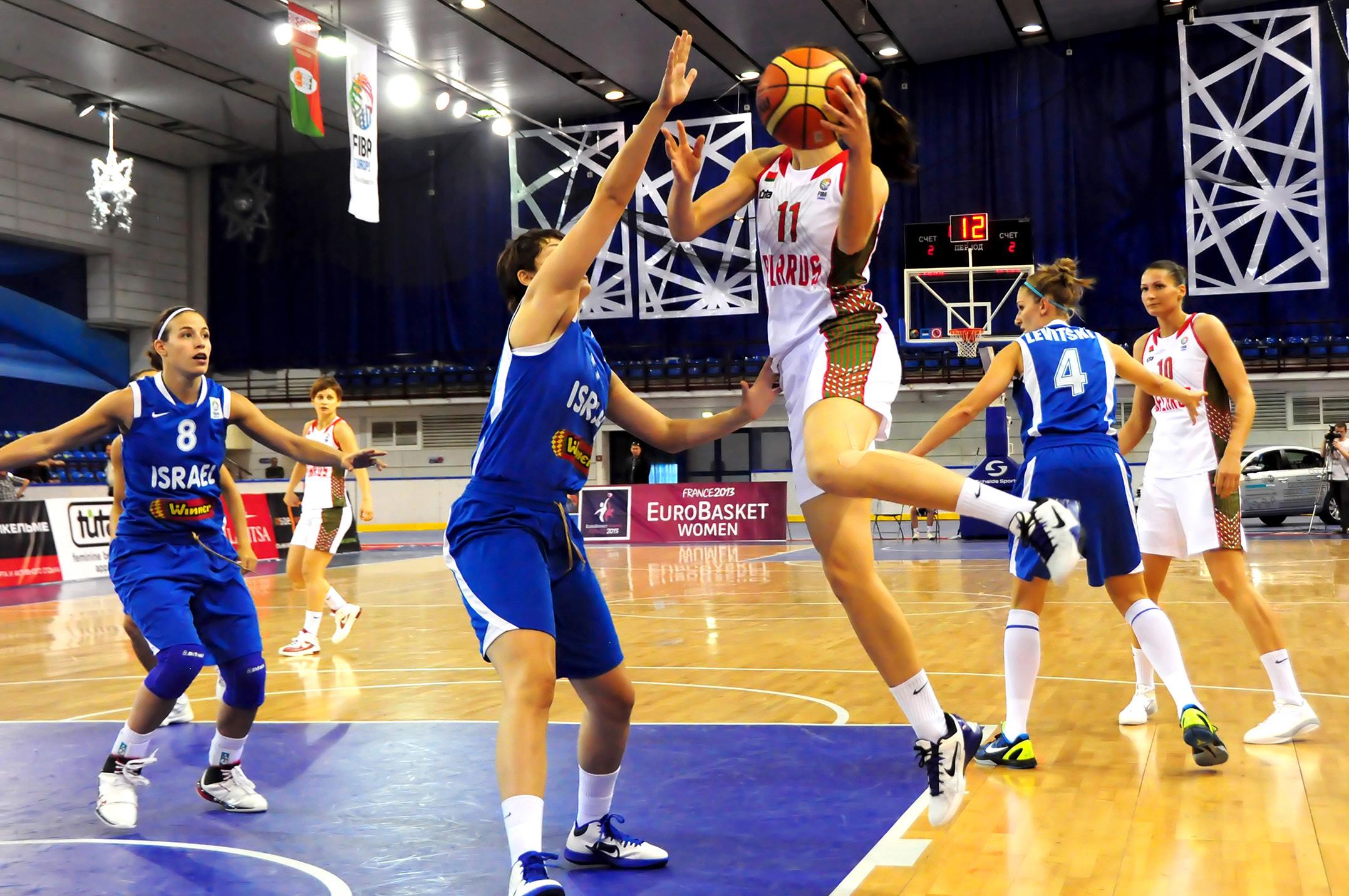
SOURCE 6 In the dynamic systems approach, learning to shoot a basketball involves a key part of the task requirements, which is beating the defender.
Check your learning 2.2
Check your learning 2.2
Retrieval and comprehension
1 Choose the correct answer.
Motor learning can be best described as:
A an approach that suggests skills and strategies are acquired by detecting cues from the environment and applying a motor program.
B an approach that suggests skills and strategies are acquired through the complex interaction between the individual and the environment.
C the acquisition of motor skills in a physical activity context.
D the development of tactical awareness over time.
2 Choose the correct answer.
Developing motor skills for netball in authentic performance environments would be indicative of:
A a dynamic systems approach to motor learning.
B a cognitive systems approach to motor learning.
C an athlete who is focusing specifically on developing netball specialised movement sequences.
D a skilled performer.
3 Explain the core differences between the cognitive systems and dynamic systems approaches to motor learning.
Analytical processes
4 The dynamic systems approach proposes that movements emerge or self-organise through the dynamic interaction between the task being performed, the individual learner and the
environment they are in. Analyse Source 7 and identify which label relates to:
a the task being performed b the individual learner c the environment they are in.
5 Compare and contrast the information in Source 4 and Source 5. Present your findings as two comparative lists.
Knowledge utilisation
6 Think about the physical activity in which you consider yourself to be most tactically aware. Reflect on your journey as a learner in that physical activity and discuss whether your coaches used a predominantly cognitive systems approach or dynamic systems approach when coaching you. Give examples where possible. Present your response in no more than 150–200 words.
7 The dynamic systems approach is described in Source 2 as “evolving”. Evaluate the effect this may have on the implementation of this approach in Physical Education.
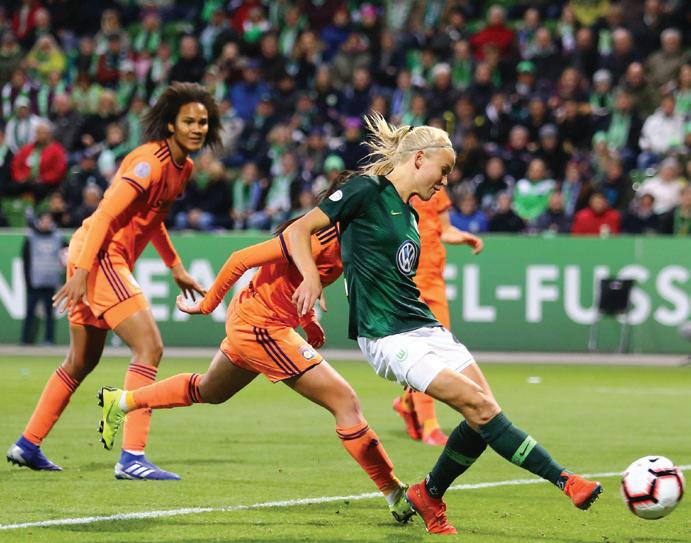
Spectators
Level of fitness
Shape and weight of ball
SOURCE 7 Soccer player Pernille Harder in action
Lesson 2.3 The dynamic systems approach and ecological models of learning
Key ideas
Learning intentions and success criteria
ecological models of learning one of two main dynamic models of learning used to explain and predict how certain aspects of motor learning and movement take place; the ecological model focuses on how a learner’s motor control system interacts with the environment to simultaneously ‘perceive and act’ and ‘act and perceive’ in order to identify opportunities and produce movements that will maximise the chances of success
perception–action coupling a process that involves interpreting or giving meaning to information from the environment (i.e. perception) and linking this with a specific movement (i.e. action). This concept suggests that perceiving information and producing an action is a simultaneous two-way relationship (i.e. action influences perception at the same time as perception influences action)
→ Dynamic systems theory is an ecological model that views the learner as a complex movement system that self-organises (finds movement solutions without instruction or cognitive thought) in response to constraints placed upon it.
→ Constraints are variables present at any given time that impact implementation of movement strategies and specialised movements sequences. Constraints can pertain to the learner, the task or the environment.
→ Perception–action coupling is an ecological model that attempts to explain how the learner’s motor control system interacts with the environment to simultaneously “perceive and act” and “act and perceive” to identify opportunities (affordances) and produce movements that will maximise the chances of success.
→ The ability to successfully identify affordances is called attunement.
Introduction
In this lesson, we will explore the dynamic systems approach to motor learning in more detail and begin to investigate how it can be used to understand the development of tactical awareness. Before we begin, it is useful to note that an “approach” is a broad theoretical framework that has developed over time. Think of the dynamic systems approach as a “big idea” that attempts to explain the entire process of motor learning differently to the cognitive systems approach. Within this approach or “big idea” there are a number of smaller models (i.e. theories) that attempt to explain specific parts of the broader process of learning. These are referred to as ecological models of learning and for that reason, sometimes the dynamic systems approach is referred to as the ecological model.
Ecological models of learning
Ecological models of learning are theories (i.e. ways of thinking) that support the dynamic systems approach to motor learning. That is, they attempt to explain in more detail how humans learn through a dynamic lens.Ecological models recognise the significant role of the environment in the ways individuals respond to the demands of physical activity. Sometimes referred to as ecological psychology or ecological dynamics, ecological models propose that the dynamic relationship between the learner and the environment is the main driver of the movements we make during physical performance. In other words, ecological models focus specifically on how our complex motor control system interacts with the environment and propose that every organism (including humans) adapts to the environment in which it finds itself, through an intricate sensory network.
As shown in Source 1, ecological models of learning include:
• perception–action coupling – a model which explains that perception and action are closely linked in an ongoing loop whereby perception drives action and, similarly, action drives perception
• dynamic systems theory – a model that views the learner as a complex movement system that self-organises in response to constraints placed upon it
• constraints-led approach – a model of instruction that manipulates task constraints to compel learners to find movement solutions for task success. The constraints-led approach will be discussed in more detail in Lesson 2.7 A constraints-led approach to teaching and learning (page 72).
Together, these models provide us with information that supports the broad ideas proposed by the dynamic systems approach to motor learning. They help us to understand how our minds and bodies work in a dynamic and complex way to develop technical skills – as well as tactical awareness. They also tell us why we should predominantly learn in authentic and dynamic environments. In short, these models guide us to explore the way we develop learning experiences.
Although the ideas presented in these models are closely related and sometimes overlap, we will explore each idea separately and in more detail.
Dynamic systems approach
Ecological models of learning
Perception–action coupling Dynamic systems theory
Constraints-led approach
SOURCE 1 Think of the dynamic systems approach as a “big idea” that attempts to explain the entire process of learning. Within this broad approach there are three ecological models of learning that attempt to explain smaller, more specific aspects of the larger process.
What the research says
The performer and environment are relational, synergistic, rather than independent. Performers act intentionally, immersed in a wide range of circumstantial factors that are typically changing. Since people are participants in a complex dynamic system, each person’s action must be continually re-adjusted with respect to changing circumstances. Also, what defines the performer–environment system at any moment is not fixed, but continually shifts as the focus of a performer’s action changes. This indicates that action is not limited to processes occurring only in the person.
Araújo, D., Brito, H. & Carrilho, D., 2023, “Team decision-making behavior: An ecological dynamics approach”, in Asian Journal of Sport and Exercise Psychology
Perception–action coupling
An American psychologist named James Gibson (1904–1979) was one of the most important contributors to the field of visual perception, which refers to the brain’s ability to interpret what we see. According to Gibson, we must perceive in order to act but we must act in order to perceive. This idea is called perception–action coupling. It describes the intertwined nature of perceiving and acting, suggesting that perception can drive action and action can drive perception (see Source 2). Gibson explained that the information we perceive (become
dynamic systems theory a dynamic model of learning that focuses on how a learner’s motor control system interacts with the environment and produces movements that will maximise the chances of success constraints-led approach an approach to teaching and learning that involves manipulating constraints in authentic game situations so that learners are challenged to find their own movement solutions to the problems they face (or the goals they want to achieve); as opposed to more traditional coaching techniques that favour coachdirected technical drills performed in isolation outside authentic game situations
perception–action coupling a process that involves interpreting or giving meaning to information from the environment (i.e. perception) and linking this with a specific movement (i.e. action). This concept suggests that perceiving information and producing an action is a simultaneous two-way relationship (i.e. action influences perception at the same time as perception influences action)
SOURCE 2 According to the concept of perception–action coupling, perception drives action but action also drives perception.
affordances opportunities for action that present themselves to athletes in a performance environment. Affordances are provided by the environment or the task – but the ability to take advantage of them depends on the ability of the athlete or learner
Perception (information) Action (movement)
aware or conscious of) from the environment compels us to respond in a certain way, but our perception is strongly linked to the goal or demands of the task we are trying to achieve in any given moment.
It is important to note that the theory behind an individual’s response to a “perception” in ecological dynamics differs from the theory of response selection based on the perception of stimuli in the information processing system proposed by the cognitive systems approach.
The information processing system suggests that the response to a stimulus is an indirect process, as the brain must go through a series of steps before an appropriate action can occur. The individual must use the stimulus to first access a memory or motor program before making a decision to execute a successful response.
In ecological dynamics, the action or response is a direct process of perception. In other words, the body takes in complete information and not just cues from the environment, and therefore the response to a perception can bypass the central command system and occur without first accessing a motor program. This suggests that, as athletes, we act upon the performance environment in the manner afforded to us by the task and the environment or object.
Affordances
When we couple perception and action, we are actively seeking relevant information from the environment, which we can then use to react and respond. By acting in a performance setting that has specific task demands and goals, our perceptions are skewed towards seeking information that is relevant to achieving the task or goal. This relevant information is called an affordance
An affordance is anything that “affords” (i.e. provides or supplies) a player or team with an opportunity to act. Experienced athletes are able to detect more affordances than their inexperienced counterparts and thus their responses are more informed and often more successful. Furthermore, their responses to affordances are quicker, making them better able to exploit (take advantage of) the opportunity presented in a timely manner. The more opportunities an athlete has to detect and respond to affordances through authentic performance environments, the more tactically aware they can become.
Let’s look at perception–action coupling in a badminton performance environment. When you take the court as a badminton player, holding a racquet and with a net between you and your opponent, you are instinctively compelled to perceive the affordances within that environment that will help you to achieve your goal, which is to win the rally. For example:
• you will notice the boundary lines, the height of the net and when you swing your racquet
• you will attempt to ensure the shuttle travels over the net with an appropriate amount of force to land in the court
• you might also attune to the position of your opponent so as to hit the shuttle away from them as you are trying to win the point.
In other words, your perceptions of the net height, boundary lines and opposition drive your actions, but your action of playing badminton to win a point also drives your perception as you continuously seek information that will help you to acheive that goal.
Perception–action coupling occurs continuously in authentic performance environments as the athlete takes in, and acts upon, information presented to them. As actions are made, new information and therefore new immediate goals and objectives are created moment by moment. The information that drives an athlete’s actions may include:
• the actions and position of their teammates
• the position of the ball
• their proximity to the goal
• the actions and position of the opposition
• what they know about their teammates’ capabilities
• what they know about the opposition players’ capabilities.
constraints

SOURCE 3 The action of dribbling a basketball to advance the ball towards the goal compels the athlete to continuously perceive relevant information from the environment (e.g. the speed, force, height and direction of the bounce and positioning of defence) and act (e.g. apply more or less force, change direction, move to space) in order to successfully complete a movement strategy.
In most physical activities, multiple affordances are present at any given time. Part of the challenge for athletes is to determine the most effective response based on all the affordances detected, and the task demands and goals. Examples of responses to multiple affordances include the following:
• A tennis player approaching the net after hitting a short ball provides an opportunity for their opponent to use their speed and skill to perform a lob shot over the approaching player’s head to beat them and win the point.
• A basketball ball carrier’s teammate breaking free from their opponent when the ball carrier is being defended tightly by their opposition provides an opportunity to pass to them so they can continue moving the ball up the court.
• A high cross in soccer with no one in the goal box provides an opportunity for the goalkeeper to run forward and catch the ball to prevent the opposition from running in to score the goal. It is important to note that affordances are always there, regardless of the sport or the skill level of the athlete or team. Whether or not an athlete notices (i.e. perceives) an affordance and has the ability to
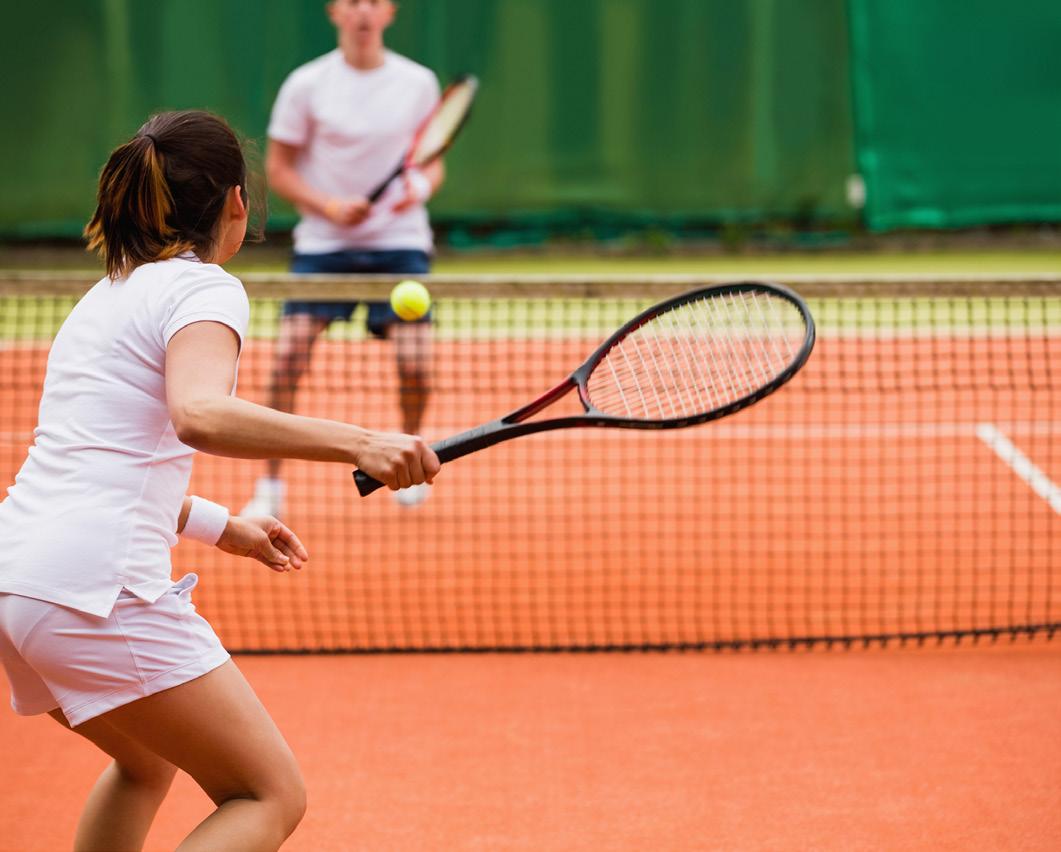
4 An affordance provides a player or team with an opportunity to act. An empty space on the opposing side of the net is an affordance that provides this tennis player with an opportunity to attack that area.
SOURCE
attunement the ability to perceive information in a performance environment and use it to identify available affordances
act effectively on the affordances present is another matter. When an athlete is able to notice and act on an affordance, they are said to be “attuned” to the affordance. The better able an athlete is to perceive and act on multiple affordances, the more attunement they are said to have.
Attunement
As with any skill, attunement is something that is generally acquired, developed and refined over time. To encourage the development of attunement, coaching and practice sessions need to be authentic or closely represent what is expected of learners during competition. This means that training activities should be designed to mimic the complexity of the sport and expose learners to the full range of information (i.e. affordances) they will be exposed to during authentic gameplay.
By comparison, practising skills or strategies in isolation does not expose athletes to the types of situations they will encounter during performance. For example, if a water polo goalkeeper practises making saves by repeatedly defending shots thrown by a centre forward positioned directly in front of goal, the opportunities they will have to practise attuning to affordances will be very limited. Compare this learning experience to one in which the same goalkeeper is able to practise attuning to the affordances provided when multiple players pass the ball around in front of the goal looking to break through the defence. In this case, the opportunities for developing attunement are significantly improved.
Retrieve it!
Explain why the dynamic systems approach to motor learning is considered non-linear. Check back to Lesson 2.2 Approaches to motor learning and the development of tactical awareness (page 43) to see if you retrieved the information correctly.
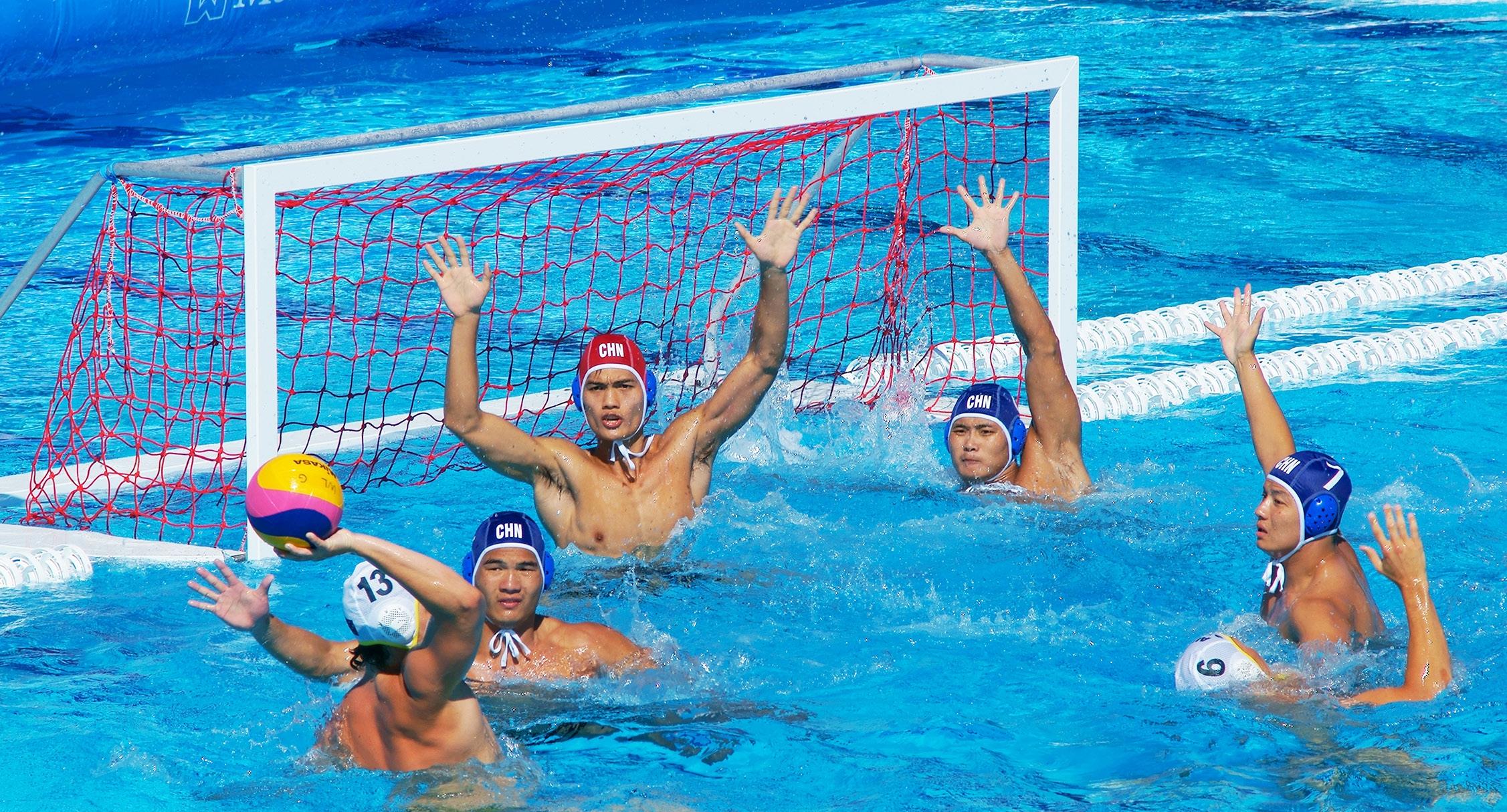
5
Dynamic systems theory
Similar to perception–action coupling, dynamic systems theory is an ecological model which proposes that a learner will adapt dynamically and create movement solutions in response to the situation they find themselves in. It further explains that the learner is a complex movement system that self-organises in response to constraints placed upon it in order to find the most stable and effective movement patterns. Two concepts that are central to dynamic systems theory are:
SOURCE
When players are exposed to the types of situations they will encounter in gameplay, they are given the opportunity to become better attuned to the available affordances.
• self-organisation – a process in which stable movement patterns emerge in response to a range of internal or external variables known as constraints
• constraints – any internal or external variables (e.g. an athlete’s strength, the weather, the rules of a game) that have an impact on an athlete’s implementation of movement strategies and specialised movement sequences.
Self-organisation
Self-organisation is a key concept of dynamic systems theory. It is a term used to describe the many large and small movement adjustments that a learner is constantly making to their body in response to the dynamic interaction with constraints. Through self-organisation, the body can find a movement solution to achieve a goal without the need for explicit direction or instruction. In other words, it is not necessary to have a pre-existing blueprint for such movement solutions; instead, they emerge through the dynamic interaction of the task being performed, the individual and the environment in which they are performing. At first, a learner’s movements may lack coordination and seem reactive and ineffective, but with enough opportunity to refine movements in authentic performance environments, a learner’s movements will become more ordered and coordinated due to the self-organising properties of the learner’s body systems.
Self-organisation occurs because the human body always strives to maintain equilibrium (i.e. balance), right down to the cellular level. When the body self-organises, it is trying to establish a movement pattern that is stable and balanced. Dynamic systems theory suggests that all parts of the body work together to achieve this stability, as opposed to just the brain and the central nervous system controlling the body (as suggested by the cognitive systems approach). Once a person achieves stability in their performance of a specialised movement sequence for a movement strategy within an authentic performance environment, they become comfortable and can produce variations of the movement strategy easily and reliably in response to the demands of the game in the moment.
How does self-organisation work?
To help you visualise how self-organisation works, let’s consider this example: imagine stepping onto a tennis court for the first time as a beginner. Your coach hands you a racquet and presents you with the task objective of hitting a ball she has thrown to you back over the net, using only your racquet. Despite the limited instruction, your arms, legs and torso would naturally move in response to the task objective of hitting the ball with the racquet, and you would most likely produce a movement sequence somewhat resembling an actual tennis stroke. You may not actually make contact with the ball on the first attempt, but each time the ball is thrown towards you, your body will self-organise towards stability and effectiveness until you hit the ball and meet the objective with success.
self-organisation a process in which many different systems and organs in the body interact dynamically with each other (in response to constraints) to achieve a goal or establish a movement pattern that is stable constraint any internal or external variable that impacts on an athlete’s performance

SOURCE 6 According to dynamic systems theory, when a beginner tennis player is handed a tennis racquet and given a task to hit a ball over the net, their body will self-organise to produce a movement solution that meets the task objectives. Over time, the movement will become more stable and more effective through further self-organisation.
tactical strategy an approach that assists a player or team to successfully optimise performance through the application of specialised movement sequences and movement strategies
task constraint any characteristic of a task that an athlete needs to overcome or adapt to (e.g. the rules of a game, the size or shape of the equipment, the size and shape of the playing surface)
learner constraint any characteristic of the individual (i.e. personal attribute) that an athlete needs to overcome or adapt to; these can include structural learning constraints (e.g. height, weight, physical strength, fitness level) and functional learner constraints (e.g. confidence, motivation, concentration, anxiety) environmental constraint any characteristic of the environment that an athlete needs to overcome or adapt to; these can include physical environmental constraints (e.g. weather, light, noise) and social environmental constraints (e.g. parents, peers, coaches, cultural norms)
In this example, hitting the ball over the net with a racquet is a task constraint that results in a level of instability that needs to be overcome. To do this, learners must make adjustments to their feet, arms and other body stabilisers. The body is capable of dynamically refining these movements over time to produce the most efficient technique for hitting a tennis ball over the net.
Self-organisation is something that athletes experience constantly, regardless of their skill or experience level. The ability to respond effectively to instability is an important skill –especially when it comes to the unpredictable nature of “Invasion” and “Net and court” physical activities – as learners are constantly required to adapt to changing situations around them. The change from instability to stability is usually more obvious in beginner performers as they refine their movement patterns and develop their tactical strategies over time. However, even elite performers are required to make minute adjustments to their movement patterns in response to the task and environment every time they produce a movement response.
To optimise training experiences and achieve success through the dynamic systems approach, it’s important that learners are exposed to a wide range of learning situations that create instability and force them to find personal movement solutions dynamically (i.e. a personal tactical strategy that works for them in that moment).
Constraints
In 1986, a motor learning researcher named Karl Newell developed the Theory of Constraints. Newell proposed that a number of variables, which he termed “constraints”, can affect an athlete’s motor development. In a sporting context, a constraint is any internal or external variable that has an impact on an athlete’s performance. There are three categories of constraints and all are central to dynamic systems theory:
• task constraints – the characteristics of the task that need to be overcome or adapted to (e.g. the rules of a game, the time permitted, the number of players, the shape and weight of equipment, the size and shape of the playing surface)
• learner constraints (also known as “individual constraints” or “player constraints”) –the characteristics of the individual that need to be overcome or adapted to. According to Newell’s theory, learner constraints can be organised into two sub-groups:
– structural learner constraints – constraints relating to physical aspects of the learner (e.g. height, weight, physical strength, fitness, speed, stamina)
– functional learner constraints – constraints relating to psychological or behavioural aspects of the learner (e.g. confidence, motivation, fear, arousal, attention, concentration)
• environmental constraints – the characteristics of the environment that need to be overcome or adapted to. Environmental constraints can be organised into two sub-groups:
– physical environmental constraints – constraints relating to the physical aspects of the environment (e.g. weather, light, noise)
– social environmental constraints – constraints relating to the social aspects of the environment (e.g. parents, peers, coaches, cultural norms).
Working with constraints
It is important to note that that, while the word “constraints” naturally has a negative or limiting connotation, in Newell’s theory, constraints are not necessarily either negative or positive. They are simply the features present within the task, the learner and the environment at any given moment, which compel a specific action to be taken. In the absence of specific
instructions from an external source such as a coach for how to complete these actions, the dynamic systems theory suggests that successful movement solutions will self-organise over time.For example, task constraints such as rules, field size and an individual’s height are consistently present on a sporting field and a learner must work within these constraints to produce an action that will meet the game objectives most effectively. Having to pass a ball backwards and not let the ball touch the ground in touch football, for example, are rules that constrain a player’s movement. These rules serve to exclude some actions, such as passing the ball forwards, so that the performer must come up with an alternative movement solution such as turning their body to the side to ensure the ball moves backwards. Having to turn over the ball if it is dropped also restricts them from making hasty passes and compels them to be more careful to look where they are passing the ball. The constraints are compelling the player to seek different ways to move and respond, thus optimising their ability to meet the objective of keeping possession of the ball and scoring a try.
Another example of this can be seen when we compare the task constraints in badminton and tennis. The smaller, lighter racquet and shuttle combined with a small court dimension in badminton compels us to take shorter swings and flick our wrists more when hitting the shuttle. In comparison, the heavier ball and racquet in combination with the larger court dimension in tennis restricts these shorter, sharper movements and compels us to take long, sweeping backswings and apply topspin to the ball when returning it to our opposition’s court.
Other constraints such as the weather, opponents and an individual’s fitness can vary from game to game and an individual must adapt dynamically to the ever-changing conditions that constrain their performance and compel them to act in different ways. For this reason, no two sporting performances or competitions are ever the same, and thus training must provide opportunity for the athlete to be exposed to varying constraints to ensure they are adequately prepared.
Source 7 illustrates Newell’s Theory of Constraints and provides examples for each type of constraint.
Task constraints (Characteristics of the task)
• Rules of the game
• Game/task/position objectives
• Number of players
• Time restrictions
• Size, shape and weight of equipment
• Size and shape of playing surface
• Teammates
• Opposition players
Learner constraints (Characteristics of the individual)
Structural learner constraints:
• Height
• Weight
• Body composition
• Endurance
• Flexibility
• Strength
• Speed
• Technique
Functional learner constraints:
• Motivation
• Confidence
• Learning style
• Attunement to affordances
Environmental constraints (Characteristics of the physical and social environment)
Physical environmental constraints:
• Weather conditions
• Temperature
• Noise level
• Light level
• Gravity
• Number of spectators
• Mood of spectators (e.g. hostile/supportive)
Social environmental constraints:
• Parents
• Peers
• Coaches
• Cultural norms
SOURCE 7 Newell’s Theory of Constraints proposes that a number of internal and external characteristics (i.e. constraints) can affect an athlete’s motor development.
Source: Adapted from Spittle, M., 2013, Motor Learning and Skill Acquisition: Applications for physical education and sport, Palgrave Macmillan Australia.
rate limiters types of constraints that have a negative effect on the development of motor skills in an individual and may restrict performance; rate limiters can be related to the task, the learner or the environment
Retrieve it!
In your own words, explain the concept of perception–action coupling. Check back to earlier in this lesson to see if you retrieved the information correctly.
Learner constraints
Task constraints
Movements emerge dynamically
Environmental constraints
SOURCE 8 According to dynamic systems theory, movements emerge or self-organise dynamically through the interaction of task constraints, learner constraints and environmental constraints.
According to Newell’s theory, constraints do not exist in isolation (i.e. separately). He conveyed the interdependent relationship between the three types of constraints by representing them as equal corners of a triangle (see Source 8). This shows that the interaction between all three constraints is essential for learning to take place. If we were to remove one type of constraint (e.g. task constraints) from the learning process, so that an individual is learning and practising skills in the absence of any of the game rules and/or objectives, the resulting skills would not be useful or transferable when the learner re-entered an authentic game environment.
Some constraints do have a negative effect on the learning process and restrict performance. In this case, they are referred to as rate limiters. Rate limiters help to explain why, despite a concerted effort, an individual may have difficulty completing a skill. The development of a new motor skill can also be compromised or restricted by one or more of these constraints. For example, a young child will find it difficult to develop basketball shooting and passing skills with a ball that is too large or heavy for them because their physical strength and the size of their hands negatively impact their ability to execute the skills. In this case, the child’s lack of strength is a rate limiter, as is the size of their hands.
The dynamic systems approach to motor learning suggests that, because of the unpredictable and ever-changing nature of constraints, learning environments should be similarly unpredictable to facilitate the development of tactical awareness in learners. Constraints can be manipulated to provide the boundaries within which learners can explore and search for movement solutions. Working with constraints in this way prepares players for the dynamic conditions they face during competition. We will be discussing the use of constraints during motor skill development in more detail in Lesson 2.7 A constraints - led approach to teaching and learning (page 72).
SOURCE 9 Some constraints – known as rate limiters –have a negative effect on the learning process and restrict performance. For example, a young child will struggle to develop basketball skills with a ball that is too large or heavy for them because their physical strength and the size of their hands negatively impact their ability to execute the skill.
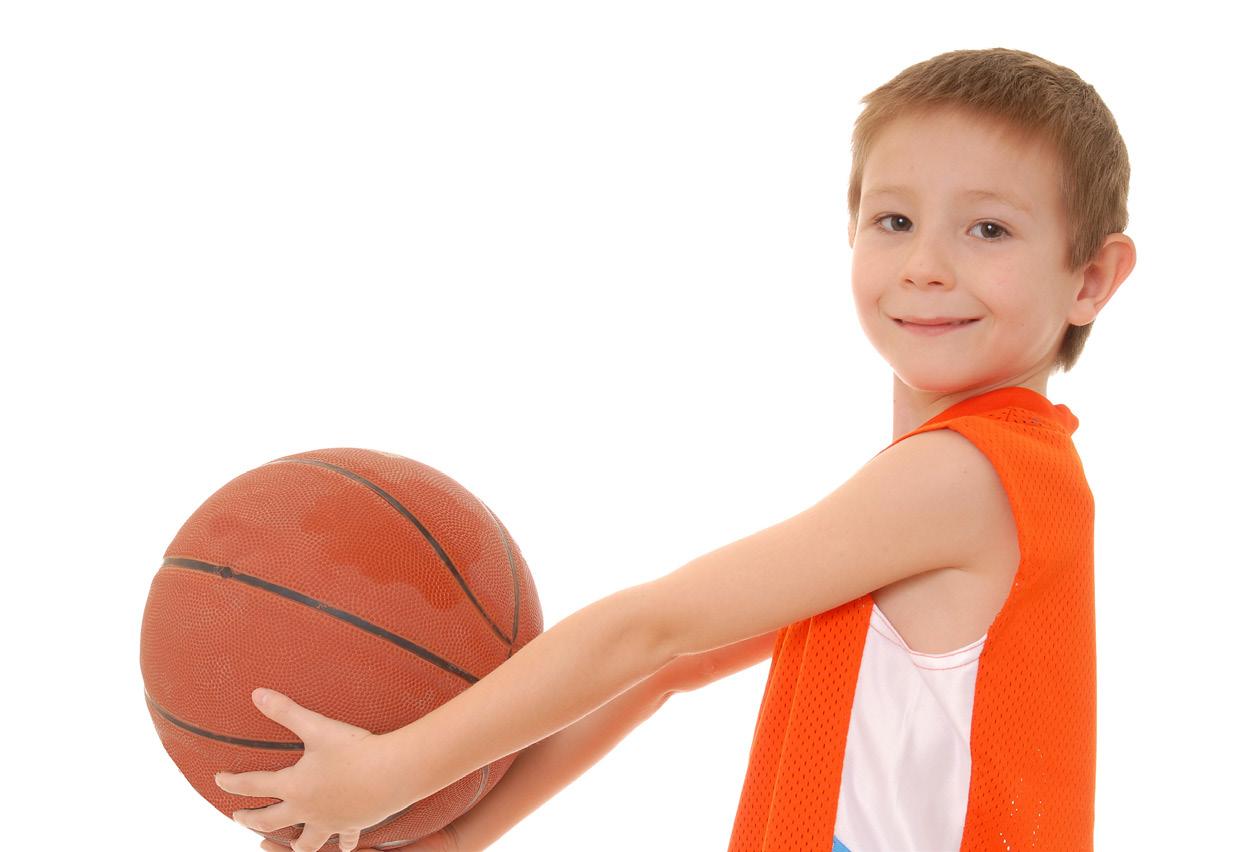
Theory in action Sir Donald Bradman: From poor eyesight to cricket legend
Australian cricketer Sir Donald Bradman, who played from 1928 to 1948, is considered one of the greatest athletes of all time. No one has been able to match his Test batting average of 99.94 per innings, nor come remotely close to it. So what made Bradman so exceptional?
As a youngster, Bradman’s eyesight was so poor that it caused his dismissal from the Australian Army. When he participated in a study at the University of Adelaide, it was found that his reaction time was similarly poor. Bradman’s defective vision and subsequent lagging reaction time were learner constraints that meant that, for him, conventional forms of batting were ineffective against top bowlers. In theory, he should never have even made the Australian cricket team.
Bradman was determined and worked hard in his own time to develop his batting skills. Through creative practice involving the use of a hot water tank and a golf ball in his basement, Bradman explored movement solutions and subsequently developed his unorthodox batting style. This style enabled him to have quicker bat speed through the striking zone
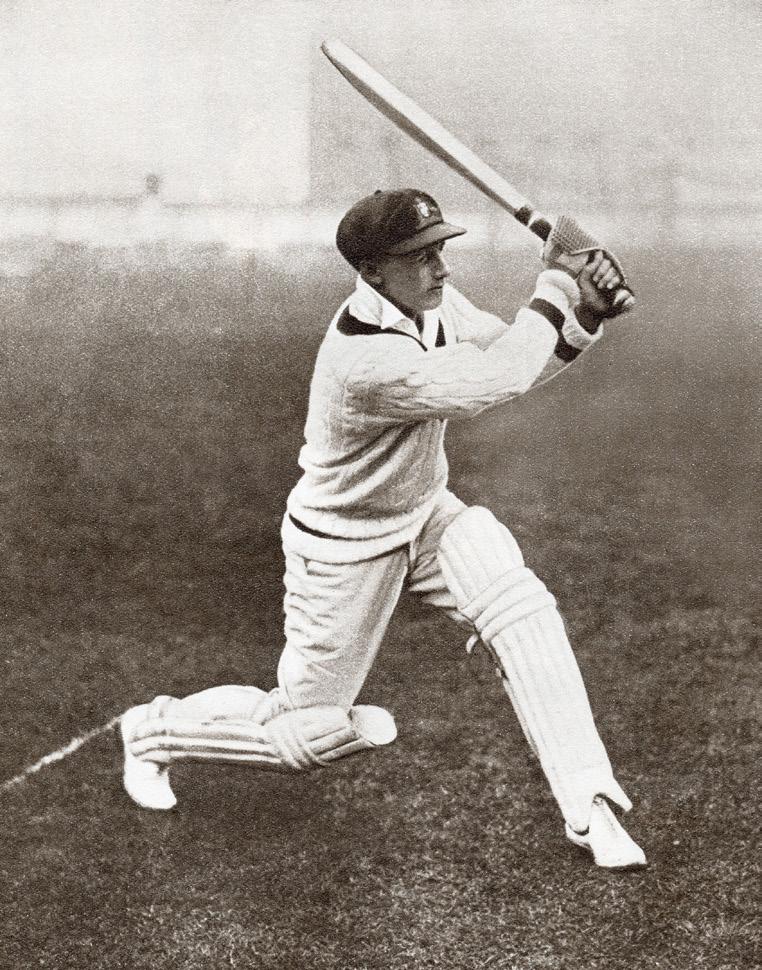
compared with conventional techniques. It was this tactical strategy that saw him become Australia’s greatest batsman of all time.
and comprehension
1 Choose the correct answer.
According to dynamic systems theory, how does a learner acquire new motor skills?
A Through explicit instruction and cognitive thought
B By self-organising in response to constraints
C By imitating the movement of others
D By practising the skill repeatedly
2 Choose the correct answer.
In the context of perception–action coupling, what is attunement?
A The ability to perform a motor skill without conscious thought
B The process of adapting a movement to a changing environment
C The ability to identify and exploit affordances in the environment
D The coordination of sensory and motor systems
3 Identify the three types of constraints that are central to the dynamic systems approach. Provide one example for each type.
4 Explain why constraints should not be considered “negative” or “restrictive”.
Analytical processes
5 Reflect on your selected physical activity and complete the table on the next page by identifying three possible affordances and three corresponding specialised movement sequences that could be applied for each affordance. An example (from volleyball) has been done for you.
SOURCE 10 Donald Bradman in action
6 Apply the concept of perception–action coupling to the physical activity you are currently studying by describing a situation in which you have perceived and acted, and acted and perceived.
7 Reflect on the performance of an athlete you consider to be tactically aware and comment on their level of attunement. Give specific examples where possible. Hint: This could be a fellow classmate, a team member, or a professional athlete.
Knowledge utilisation
8 Read Theory in Action – Sir Donald Bradman: From poor eyesight to cricket legend. Explain why it was important that learner constraints were considered in the development of Bradman’s batting technique.
9 “Performing closed drills in isolation provides learners with the opportunity to develop key technical skills without the stress of game day.” Discuss this statement in a written response
of 250 words. In your answer, make specific reference to the following concepts to support your position:
– the cognitive systems approachthe dynamic systems approach
– ecological models including perception–action coupling and dynamic systems theory
– tactical awareness.
10 Alim is a beginner at the sport of futsal. During games, her teacher stands on the sideline and yells instructions at her, telling her where to go and what to do. Evaluate the outcomes and limitations of this approach, in terms of Alim’s ability to develop tactical awareness.
11 Justify why advocates of the dynamic systems approach do not encourage developing the “perfect technique” outside the context of gameplay. Use examples from your selected physical activity to support your answer.
Lesson 2.4
Devise a personal tactical strategy
Aim
To observe, record and analyse the emergence of a personal tactical strategy.
Time
1 lesson (i.e. 60 minutes) with additional time (if required) to complete analysis and discussion tasks.
Equipment
• Indoor or outdoor playing surfaceBibs
• Markers
• Whistle
• Timer
• Goals
• Soft foam ball
• Game Performance Assessment Instrument 1 (GPAI 1)
• Clipboard
• Pen
Game Performance Assessment Instrument 1 (GPAI 1)
Method
Step 1
Form two teams of equal sizes and participate in a teacher-led warm-up.
Step 2
Take part in a 10-minute game of futsal with the following task constraints:
1 The ball must be made of soft foam.
2 Each player’s bottom must remain lower than their knees at all times.
Step 3
During the 10 minutes of play, your teacher will blow the whistle to pause the game every 2 minutes. Each time the game is paused, take 2–3 minutes to complete the relevant section of GPAI 1.
For each of the three specialised movement sequences listed (i.e. passing, shooting, marking an opponent), make brief notes about the quality of:
• timing
• technique
• movement patterns (e.g. direction, frequency, intensity of movement)
• decision-making.
2 minutes Timing
Technique
Movement patterns
Decision-making
4 minutes Timing
Technique
Movement patterns
Decision-making
6 minutes Timing
Technique
Movement patterns
Decision-making
8 minutes Timing
Technique
Movement patterns
Decision-making
10 minutes
Timing
Technique
Movement patterns
Decision-making
SOURCE 1 GPAI 1
Analysis and discussion tasks
1 Use the data you have gathered in GPAI 1 to complete the following tasks:
a Describe the changes that took place to your specialised movement sequences of passing, shooting and marking over the 10-minute period of play. Try to identify trends for each of these.
b Identify the specialised movement sequence that was first affected by the task constraints.
c Describe the specialised movement sequence that saw the greatest change over the 10 minutes.
d Identify any movement solutions that emerged throughout the 10 minutes of play.
e Identify and describe the movement solution that had the greatest impact on your performance. Note that this movement solution is a personal tactical strategy for this activity.
2 The data you have gathered using GPAI 1 will allow you to identify and describe any personal tactical strategies that emerged for you. Analyse the data and complete the following tasks:
a Explain how the task constraints (i.e. playing with a foam ball; keeping your bottom lower than your knees during play) may have influenced the personal tactical strategy that emerged for you.
b Explain how the environmental constraints (e.g. the playing surface; the weather) may have influenced the personal tactical strategy that emerged for you.
c Explain how learner constraints (e.g. your physical capacity; level of fitness; any preexisting injuries) may have influenced the personal tactical strategy that emerged for you.
3 Use the primary data you have gathered in GPAI 1 to evaluate the effectiveness of your personal tactical strategy. Gather some secondary data online to support your position.

Lesson 2.5
Decision-making in the dynamic systems approach to motor learning
Key ideas
→ In the dynamic systems approach, decision-making is emergent in nature and depends on the interaction between the learner, task and environmental constraints at play moment by moment.
→ The principles of play are a set of movement strategies that can be used to help individual athletes or teams adapt to any tactical situation in performance environments. They can also be used to help coaches and teams focus their objectives and evaluate their performance.
→ The principles of decision-making are a set of guidelines that can be used to help individual athletes or teams make the best and most appropriate decisions.
Introduction
Decision-making is a fundamental aspect of all sports and physical activities. The ability to make informed decisions in short periods of time – and act on them appropriately – can mean the difference between success and failure. It is also the essence of what makes athletes more or less tactically aware.
In cognitive models of motor learning such as the information processing model, decisionmaking is explained as the process a learner uses to consider a range of information in their environment, weigh their options, decide on a course of action and carry it out. In this approach, the brain of the performer is central to the decision-making process.
On the other hand, as discussed in Lesson 2.3 The dynamic systems approach and ecological models of learning (page 50), the dynamic systems approach explains that movement outcomes are a direct result of the whole body’s response to the perceived affordances.
Learning intentions and success criteria
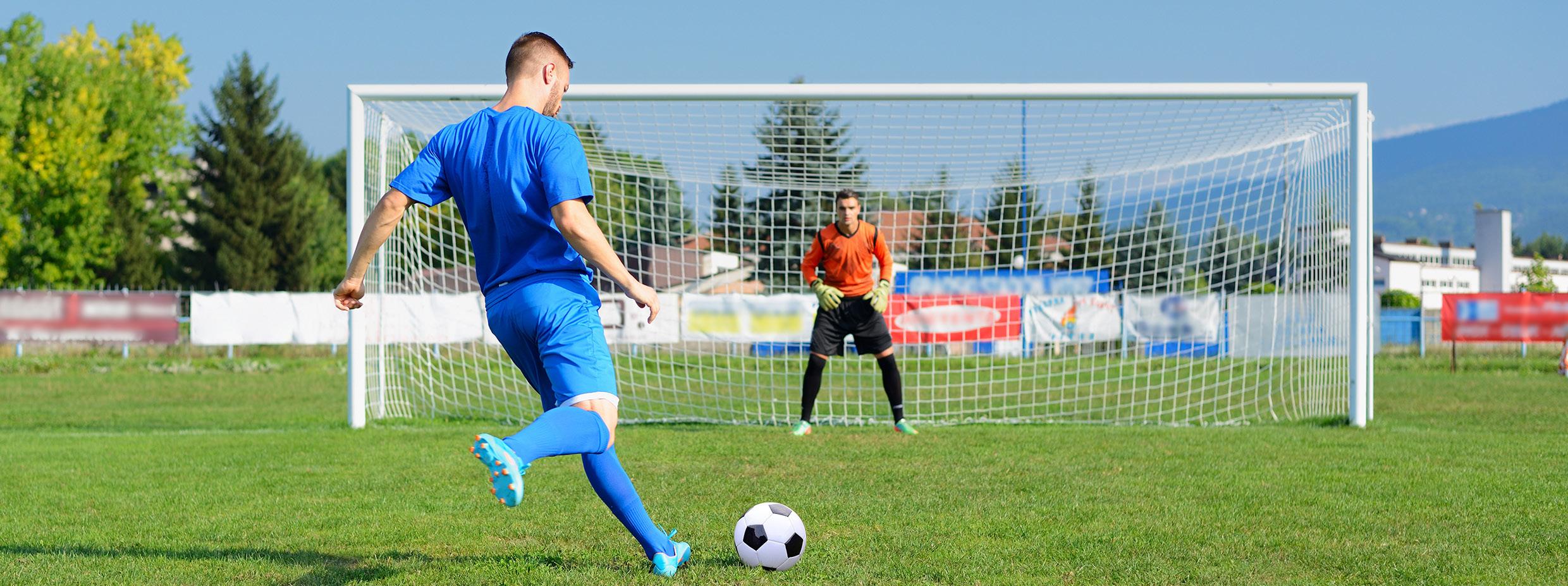
Retrieve it!
List two examples each of task, learner and environmental constraints. Check back to Lesson 2.3 The dynamic systems approach and ecological models of learning (page 50) to see if you retrieved the information correctly.
Decision-making in the dynamic systems approach
In the dynamic systems approach, decision-making is emergent in nature and depends on the interaction between the learner, task and environmental constraints at play moment by moment. For this reason, this approach suggests that athletes cannot completely plan their specific actions in advance as they must be responsive to the ever-evolving and unique constraints and affordances presented in a given moment.Successful athletes, however, are not just reactive to the environment in the moment. Athletes with good tactical awareness and successful decision-making combine an element of anticipation based on previous experiences with responsiveness to the constraints and affordances in the moment. A clear understanding of the performance goals is pivotal to successful decision-making. As perception–action coupling explains, having a goal helps athletes to attune to the affordances for action to achieve the goal.
In this lesson, we will explore the following two key areas to understand decision-making in physical activity:
• principles of play
• principles of decision-making.
Principles of play
Principles of play are categories of fundamental movement strategies. They differentiate between the different passages of tactical play required during many physical activities such as “Net and court” and “Invasion” physical activities. Understanding strategies and concepts within the principles of play can help athletes or teams better attune to affordances and make successful decisions. The broad categories of principles of play include:
• setting up an attack – movement strategies that build attack to optimise a team’s opportunity to score (e.g. to gain possession of the ball, to break through defence, to control the ball)
SOURCE 2
A badminton player performs on-the-ball movements when they are executing shots such as clears, drop shots and smashes.
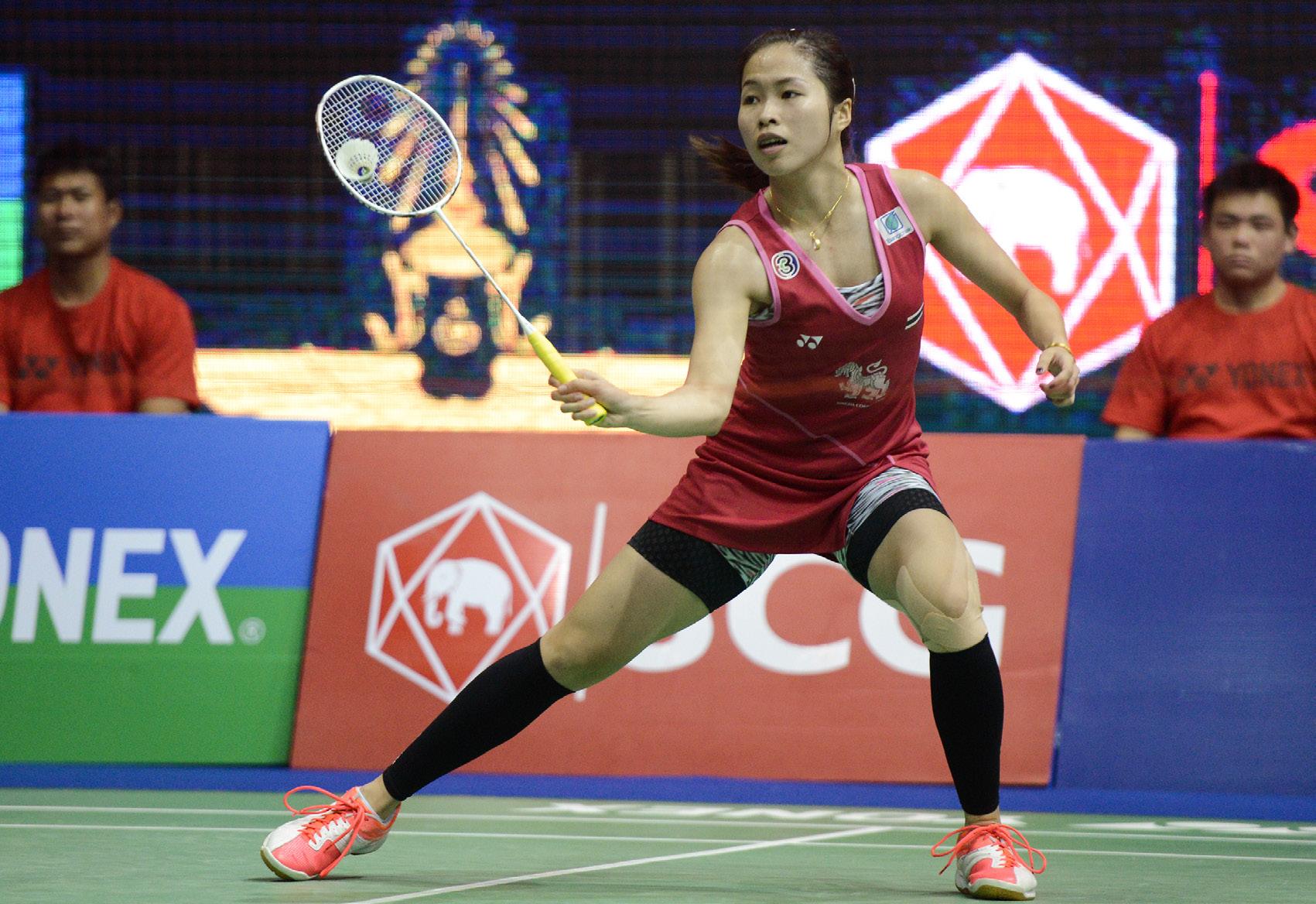
• defending against an attack – movement strategies designed to limit an opposing team’s opportunity to score (e.g. to deny space or apply pressure to regain possession, to delay their attack, to limit options for passing, to push an opponent out of position)
• creating, defending and exploiting space – movement strategies designed to open or deny space in response to a specific goal (e.g. to move an opponent to the court extremities, to use the full width of a field)
• attacking opposition space or goal and scoring – movement strategies designed to take advantage of scoring opportunities (e.g. using a “kill” or “smash” shot, drawing defenders away from scoring areas to attack).
When engaged in decision-making in “Net and court” and “Invasion” movement strategies, actions can be further categorised as:
• on-the-ball movements – movements made when in direct contact with the ball
• off-the-ball movements – movements made when not in possession of or in contact with the ball.
Note: In on-the-ball and off-the-ball movements, a “ball” can be any implement related to “Net and court” or “Invasion” physical activities, e.g. a shuttle in badminton or a frisbee in ultimate.
On-the-ball and off-the-ball movements
On-the-ball movements involve the execution of specialised movement sequences during attacking and defending principles of play. Attacking examples include passing, shooting and dribbling in soccer, and forehand and backhand clears and drop shots in badminton. In defence, on-the-ball movements can be seen in specialised movement sequences such as oneon-one defence of the ball carrier in basketball or netball, and blocking or passing an attacked ball in volleyball.
The execution of on-the-ball movements is in response to the affordances presented and perceived by the athlete. They are most closely linked to the “react” phase of the principles of decision-making cycle, which we will be discussing later in this lesson.
Off-the-ball movements are much more varied in nature than on-the-ball movements. Off-the-ball movements are related to both attacking and defensive principles of play. In “Invasion” physical activities, moving into space is necessary to draw defensive players to create a path forward for teammates or to provide opportunities to receive a pass uncontested. In defence, off-the-ball movements are required to guard or block opposition players to prevent them from advancing their attack by receiving a ball.
In “Net and court” physical activities, off-the-ball movements are usually made when the ball is on the other side of the court. In such cases, off-the-ball movements usually involve an initial movement to a defensive position to ensure best opportunity to retrieve the opposition’s returned shot. However, in sports such as volleyball, off-the-ball movements can occur when a teammate is in possession of the ball on their own side of the court and might include moving to a position ready to spike or to cover the spike in case a block is made. Following initial positioning, movements are in response to the affordances perceived and help the athlete move to the best position in preparation for the execution of on-the-ball movements or specialised movement sequences.
Off-the-ball movements are most closely linked to the “recognise and respond” phase of the principles of decision-making cycle, which we will discuss next.
principles of decision-making a set of guidelines (cognitive processes) that can be used to help individual athletes or teams make the best and most appropriate decisions in performance environments
Body and movement concepts
When evaluating the performance of decision-making during on-the-ball and off-the-ball movements, it is useful to consider body and movement concepts as criteria. When looking at movement execution during on-the-ball movements, for example, we can use quality of movement (e.g. force development and accuracy) and body awareness (e.g. balance and weight transfer) to determine whether optimal and well-timed decisions were executed. Space awareness (e.g. the use of varied movement pathways to find and create space) is useful when evaluating decisions made during off-the-ball movements. Similarly, examining the relationship between teammates and opposition players by looking at their positioning in relation to each other is important for decision-making in both on-the-ball and off-the-ball movements.
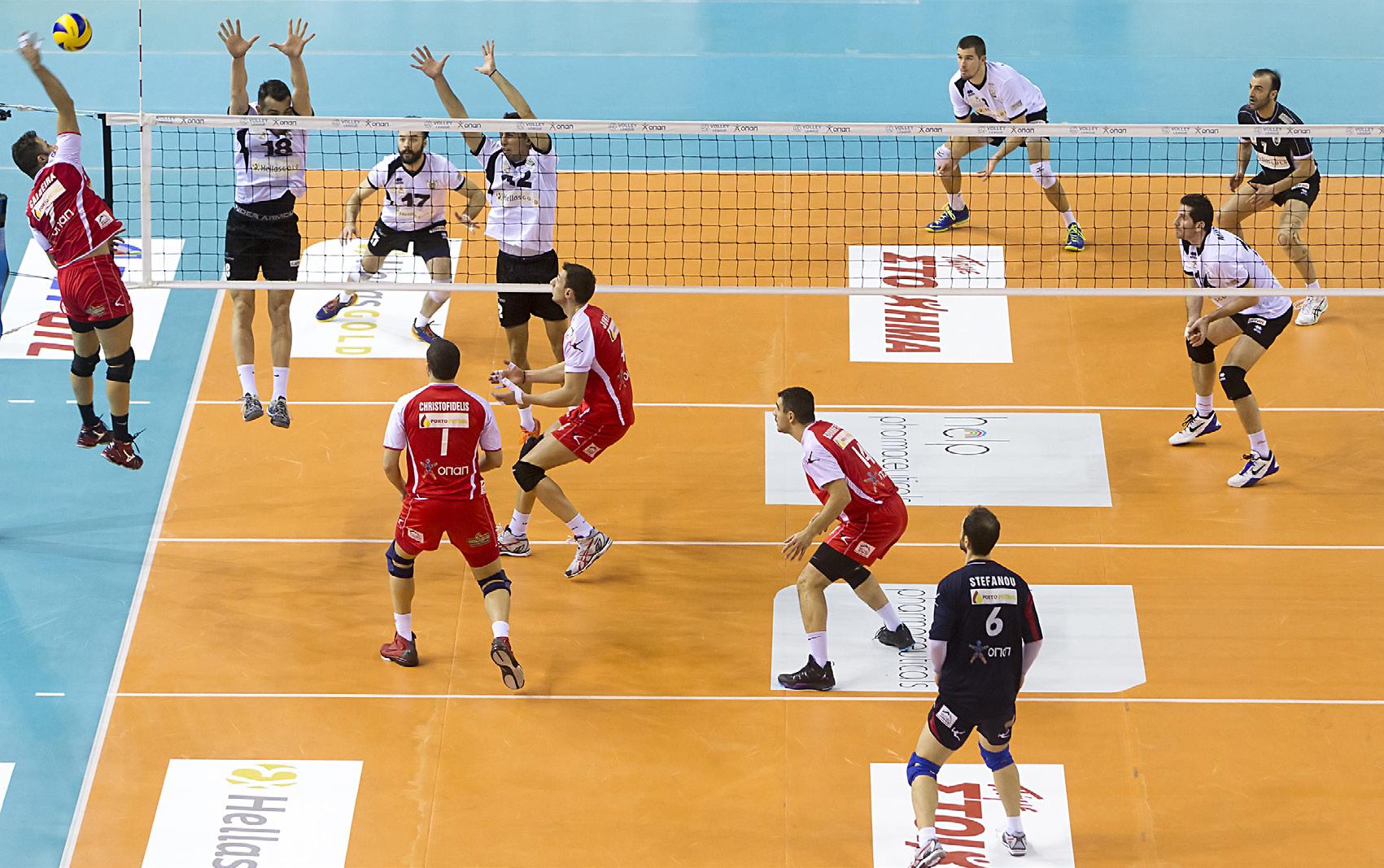
SOURCE 3 Off-the-ball positioning in volleyball refers to the strategic positioning and actions of players without possession of the ball, such as those moving in to cover behind the hitter in anticipation of a block on the spike.
Principles of decision-making
In 2003, an associate professor of physical education named Dr Tim Hopper developed the 4 R model (see Source 4). The model helps athletes to understand the cyclical nature of decision-making in dynamic performance environments and explains how examining onthe - ball and off-the-ball movements can help athletes and coaches to analyse and evaluate their decision-making. As the name suggests, the 4 R model of decision making includes four steps known as the principles of decision-making
According to the principles of decision-making, when play begins, an athlete:
• Reads the play to perceive affordances based on their goals for action
• Recognises opportunities for action provided by affordances and responds with appropriate off-the-ball movements to the best position to select their on-the-ball skill
• Reacts by adjusting to the finer details detected as the ball enters the player’s area (e.g. force, spin, direction, speed) to execute the on-the-ball skill or specialised movement sequence
• Recovers with appropriate off-the-ball movements to move to a “base” and set up for the read phase again.
Tactical awareness
Player decision-making
Source 5 provides examples of decision-making in “Net and court” and “Invasion” physical activities. It is important to note that setting out the steps in this way appears to be cognitive in nature, with distinct phases in time. However, the fast-paced and dynamic nature of these types of sports means that the decision-making cycle happens very quickly and often in short periods of time. The dynamic systems approach suggests that during all phases, movements emerge dynamically in response to the information perceived in relation to the task, the environment and the learner. The better attuned an athlete is to themselves and their surroundings, the better they will be at making decisions and being tactically aware.
On-the-ball skill selection then execution Respond
O -the-ball movement skill
O -the-ball movement skill
SOURCE 4
The principles of decision-making are cyclical in nature and explain how on-theball and off-the-ball movements can be used to examine the effectiveness of an athlete’s decision - making.
Decision Badminton Basketball
Read Athlete perceives the affordance of their opposition player lunging forward with an outstretched racquet to retrieve a drop shot
Recognise and respond
Athlete recognises the affordance as an opportunity for action. They anticipate a net lift and respond by taking some steps towards the net
React Athlete reacts to the speed, force and height of the return shot and executes a net kill back over the net
Recover Athlete immediately recovers back to the centre of the court, reading the play in preparation for the next decision-making cycle
Athlete perceives the affordances of proximity to the basket, one smaller opposing player defending between them and the basket, and a feeling of confidence to drive past them
Athlete recognises the affordance as an opportunity for action. They anticipate being able to use a layup to drive past their defender and respond by making one bounce of the ball while taking a small forward step
Athlete reacts to the sideways blocking movement by holding their core muscles tightly and taking two big steps, brushing past the opponent’s side before executing the shot into the basket
Athlete immediately recovers down the court, reading the position of their opposition in preparation for the next decision-making cycle
SOURCE 5 Examples of decision-making in “Net and court” (badminton) and “Invasion” (basketball) activities
Using the principles of decision-making to analyse and evaluate tactical awareness
In Senior Physical Education, having a clear understanding of the principles of decisionmaking can help you to analyse and evaluate your tactical awareness and look for ways to optimise your performance. Through video analysis, you can use slow motion to identify the four phases of decision-making in your performance of a movement strategy. For example:
• Phase 1: Read – Identify the moments where you read the play to determine what affordances were available.
• Phase 2: Recognise and respond – Analyse your ability to recognise the opportunities for action and the appropriateness of your response.
• Phase 3: React – Evaluate your reactions to the finer details in your execution of specialised movement sequences for a movement strategy.
• Phase 4: Recover – Analyse your recovery and how ready you are for the next phase of play. Read Recover
Retrieve it!
Define tactical awareness. Check back to Lesson 2.1
Introduction to tactical awareness (page 39) to see if you retrieved the information correctly.
You can use your analysis to draw conclusions about your tactical awareness. Some examples of such conclusions in a badminton performance might include:
• When I read play, I perceive major affordances such as my opponent hitting a high, short overhead clear for me to have to return. I miss affordances such as their positioning at the back of the court, which limits my recognition of opportunities for action.
• I recognise that the affordances I perceive are opportunities for different actions. For example, a high, short shot is an opportunity for me to smash the return. I respond to these affordances by lifting my racquet over my head and moving towards the shuttle at the front of the court.
• I am getting better at reacting to the finer details once the shuttle enters my side of the court. For example, I am able to detect changes such as the shuttle only being strong enough to just make it over the net, and I can adjust my racquet and body positioning to perform a net kill instead, for example.
• I need to focus on recovering, as video analysis shows that I do not always move back to an appropriate base position to get ready to read the next phase of play.
Theory in action Less is more: The key to Brazil’s soccer success!
Despite incredible success in producing top-level players in soccer, Brazil does not have the same top - level training facilities that can be found in many other countries.
Countries such as England, Germany, Spain, Portugal and the Netherlands use world-class training facilities to run youth soccer academies, targeting young talent early and putting them through rigorous training regimes. However, in Brazil, a large proportion of practice occurs via a customary “street” game called pelada. The word “pelada” can be translated as “nude” in Portuguese and is symbolic of the “naked” environment used in this Brazilian childhood game.
Pelada is usually played outdoors on irregular surfaces such as grass paddocks, dirt streets or sandy beaches. The game is structured around the number of players who turn up to play on any given day (usually fewer than in a traditional soccer game) and includes a mix of sexes and age groups. The unpredictable and unstructured nature of pelada encourages its young athletes to attune to their environment and continually seek input from their
environment to make decisions. The lack of coaches instructing them on how to play means most of their skills self-organise and develop organically as they play the game.
As Brazilian soccer players are renowned for their tactical awareness through decision-making and adaptability throughout their games, the question must be asked: Is it possible that the unstructured and, in some ways, “disadvantaged” nature of Brazil’s soccer development program contributes to their country’s success?
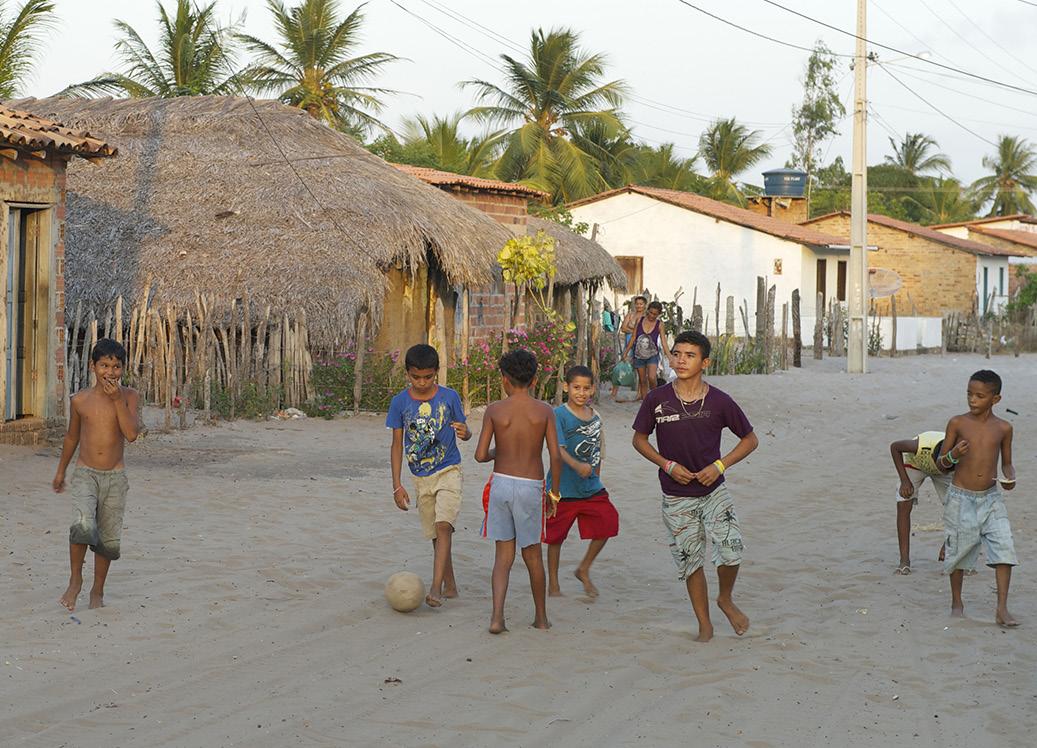
SOURCE 6 A group of Brazilian children playing pelada on a sand road in a village
Check your learning 2.5
Check your learning 2.5
Retrieval and comprehension
1 Choose the correct answer. Which of the following is not a principle of decision-making?
A Reading play
B Recognising information and responding
C Implementing movement
D Recovering with appropriate movements
2 Choose the correct answer.
What is the primary goal of “setting up attack” in an “Invasion” physical activity?
A To prevent the opposition from scoring
B To create scoring opportunities for the team
C To recover the ball from the opposition
D To attack the opposition goal
3 Use a movement strategy within the physical activity you are currently studying to explain the principles of decision-making.
Analytical processes
4 Analyse the concept of affordances in the context of decision-making in physical activity. How do athletes perceive and use affordances in their environment to make effective decisions?
5 Analyse the 4 R model in Source 4 and explain why it is depicted as a cycle rather than a linear progression with a beginning and an end.
6 Consider a “Net and court” or “Invasion” physical activity and describe two examples of:
a on-the-ball movements
b off-the-ball movements.
Knowledge utilisation
7 Examine the positions of the basketball players in Source 7 and answer the following questions. Identify the affordances that the ball carrier might recognise and respond to in this situation.
a Select a response for the ball carrier and commentate the 4 R cycle of decision-making that player might go through in their next phase of attacking play.
b Select one other player and explain how they might repond to the decision of the ball carrier.
8 Read Theory in action Less is more: The key to Brazil’s soccer success! Explain what is meant by a “naked environment”. Discuss how this informal approach to motor learning development might contribute to greater decision-making and tactical awareness. Present your response in 150–200 words.
Lesson 2.6
Evaluate the effectiveness of decisionmaking
in authentic game settings
Aim
To evaluate the effectiveness of decision-making in authentic game settings.
Time
1 lesson (i.e. 60 minutes) with additional time (if required) to complete analysis and discussion tasks.
Equipment
• Equipment relevant to your selected physical activity
• Game Performance Assessment Instrument 2 (GPAI 2)
• Clipboards
• Pens Game Performance Assessment Instrument 2 (GPAI 2)
Method
Step 1
Form four teams of equal size (Team A, Team B, Team C, Team D) and prepare to take part in a 10-minute game of your selected physical activity.
Step 2
Take a few minutes to read over GPAI 2 and familiarise yourself with the types of movements you will be required to assess.
Step 3
Participate in a teacher-led warm-up.
Step 4
Each player on Team A selects a partner from Team C and each player on Team B selects a partner from Team D. Players on Team A and Team B take part in a 10-minute game while players on Team C and Team D observe their partner’s on-the-ball and off-the-ball movements and use GPAI 2 to record all instances of appropriate and inappropriate decisionmaking and effective and ineffective skill execution (in relation to these movements).
Step 5
Players on Teams C and D now take part in a 10-minute game while their partner on Team A or Team B observes and records their movements using GPAI 2.
Movements
On-the-ball movements (e.g. passing, shooting, dribbling, hitting)
Off-the-ball movements to support attack (e.g. leading and driving into space)
Off-the-ball movements to support defence (e.g. positioning, marking, zone defence, one-on-one defence)
SOURCE 1 GPAI 2
Decision-making
Analysis and discussion tasks
1 The data collected in your GPAI can help you to objectively identify trends, patterns and relationships in your performance. Use the data your partner collected on your performance to complete the following tasks.
a Analyse your decision-making over the course of the game. Compare the quality of your decision-making for on-the-ball and offthe-ball movements.
b Consider the relationship between your decision-making and your skill execution. For example, was there a direct correlation between appropriate decision-making and effective skill execution or inappropriate decision-making and ineffective skill execution?
c Evaluate the quality of the data collected by your partner and decide if it is an accurate and reliable reflection of what actually happened during the game. Provide examples to support your point of view and make suggestions as to how the accuracy and reliability of the data could be improved next time. For example, “My data suggests that I made lots of inappropriate decisions and had poor skill execution, but I often felt that my decisionmaking was good even though I wasn’t able to pull off the skill”.
2 Secondary data can be used to help you further understand the primary data you have collected.
a Conduct additional research on the features of ecological models of learning and summarise your findings in a 50–100 word paragraph.
b Describe one instance in your gameplay where you used perception–action coupling.
c Identify one moment during the game when you were required to make a decision. List the affordances that were present. It might be useful to reflect on this with your partner as they may be able to offer additional perspectives on what they could see happening at the time.
d Apply the principles of decision-making (i.e. the 4 R model) to the example you identified in Question 2c. Use this model to break down the process you went through when deciding which affordance to act on.
3 Synthesising your primary data with secondary data will help you to make justified evaluations of your performance.
a Evaluate the overall effectiveness of your decision-making during the 10 minutes of gameplay.
b Justify your response using the secondary data you collected for Question 2a.
Learning intentions and success criteria
Lesson 2.7 A constraints-led approach to teaching and learning
Key ideas
→ Considerable planning needs to go into the implementation of a constraints-led approach. A performance appraisal using body and movement concepts and the principles of decision-making as a guide can help to identify problem areas on which to base constraint manipulation.
→ There are four steps to designing and implementing effective constraints-led activities: understand the demands of the physical activity; determine the learner, task and environmental constraints influencing movement; consider the principles of decision-making; devise and implement the constraints-led learning activity.
Introduction
As we saw in Lesson 2.3 The dynamic systems approach and ecological models of learning (page 50), the constraints-led approach to teaching and learning was developed by Karl Newell in 1986. It is an approach to learning physical activity based on dynamic systems theory, and it is used by Physical Education teachers and coaches.
The dynamic systems approach:
• acknowledges that learning is not a predictable process and that providing learners with the “correct technique” and expecting them to apply it successfully to their physical activity is not always the best way to teach
• suggests that this traditional instructional teaching method is not the best way to develop skilled and tactically aware performers
• advocates for a shift away from looking to the teacher for the prescribed answers to movement problems
• suggests that we need to change the role of the teacher from instructor to designer and guide.
The constraints-led approach
As the name suggests, the constraints-led approach encourages learners to work within a range of constraints. It enables athletes to develop their own movement solutions (known as personal tactical strategies) rather than being explicitly told what to do by a coach. Through exploration and guidance in cleverly designed practice environments, athletes have the opportunity to self-organise their movements rather than attempting to replicate predetermined and prescribed movement sequences.
As we saw in Lesson 2.3 The dynamic systems approach and ecological models of learning (page 50), movement solutions can self-organise in response to learner, task and environmental constraints in a performance environment. This does not mean that learning should only take place in a full game situation, but rather that the demands of a performance environment should be considered during training. In the constraints-led approach, training
activities are designed so that one or more task, learner or environmental constraints are manipulated to:
• destabilise the existing movement solution by disrupting current patterns of movement that are not effectively meeting the demands of the performance, e.g. applying a rule that a volleyball player must touch the floor before they make a pass during serve–receive to disrupt the movement pattern of staying upright when making a pass
Task
Teacher input
Learner Environment
Co-ordination, control and skill
• encourage exploration and self-organisation by recognising that we do not know the best movement solution that will work for a particular athlete and therefore refraining from telling them how to move their body, e.g. don’t tell the volleyball player to bend their knees at a 100-degree angle to make the pass
• shine a spotlight on affordances by deliberately applying constraints that magnify the affordance the athlete needs to attune to, e.g. we want the volleyball player to recognise that starting low when passing the ball enables them to use their legs to bump the pass so we get them into a low position without being prescriptive about how low, the position of the legs and so on
• provide feedback on the effectiveness of the movement solution by linking the modification of movement to progress made towards reaching an optimal movement solution, e.g. ask questions about sensory feedback from their legs in varying positions and link it to optimal use of the legs in bumping the pass.
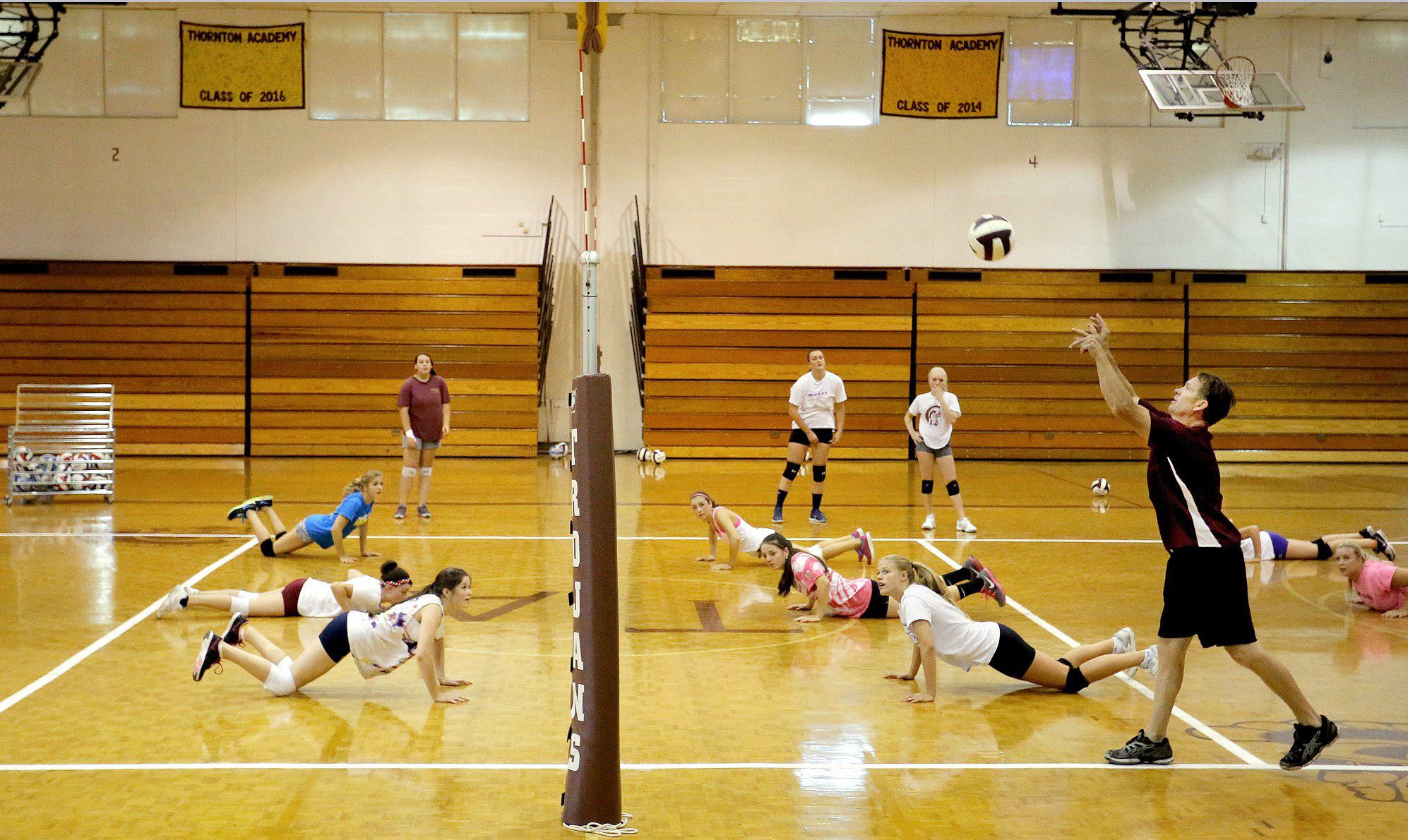
SOURCE 1 This diagram shows how the interacting learner, task and environmental constraints act to shape behaviours. The role of the teacher is to manipulate constraints based on assessment of the needs of individuals and groups (adapted from Newell, 1986).
Retrieve it!
Identify the four principles of decisionmaking and explain how they connect with perception–action coupling. Check back to Lesson 2.5 Decision-making in the dynamic systems approach to motor learning (page 63) to see if you retrieved the information correctly.
SOURCE 2 A constraints-led approach requires the full commitment of learners, coaches and teachers to embrace more autonomous, learner-centred activities.
SOURCE 3 The concept of “repetition without repetition” acknowledges that there is benefit to repeatedly practising a skill such as netball shooting over time, but that each repetition should be varied from the one before in line with the demands of the task.
Repetition without repetition
In a constraints-led approach to teaching and learning, it is ideal for learners to participate in authentic performance environments in order to learn new skills. This dynamic systems approach to motor learning recognises the varying and unpredictable nature of authentic performance environments and suggests that learning and practice activities should be designed to closely resemble these environments. This process, of allowing the learner to practise in the unpredictability of an environment that closely represents true gameplay, is sometimes referred to as “repetition without repetition”.
Traditional models of learning recommend that athletes perfect their skills through repetition of practice, but this is often done in isolation and away from authentic game environments. An example of this is to practise shooting 50 netball or basketball shots without a defensive player disrupting the shooting pattern. “Repetition without repetition” acknowledges that while there is benefit to repeatedly practising skills over time, an athlete’s performance of each repetition should be varied from the one before. The skills should be repeated in purposefully designed activities that closely resemble the dynamic and everchanging nature of the performance environment. Adding in some of the constraints that a basketball or netball shooter would have to work with in a game, such as a defender, will ensure that their shooting movement solution is attuned to affordances, such as defender proximity, and compel them to make adjustments to ensure their shot gets past the defender.
To modify this repetitive shooting example, we could have a player feed the ball into the defended netball or basketball shooter, who would first need to get free for the ball and then beat their defender to make the shot. In this activity, task constraints such as the number of players on the team could be manipulated to home in on an identified problem area and compel the athlete to find a movement solution to successfully achieve the goal of shooting into the basket through repetition of the activity over time.
The use of constraints-led learning activities promotes and enhances the acquisition of a whole range of skills, including decision-making and tactical awareness.
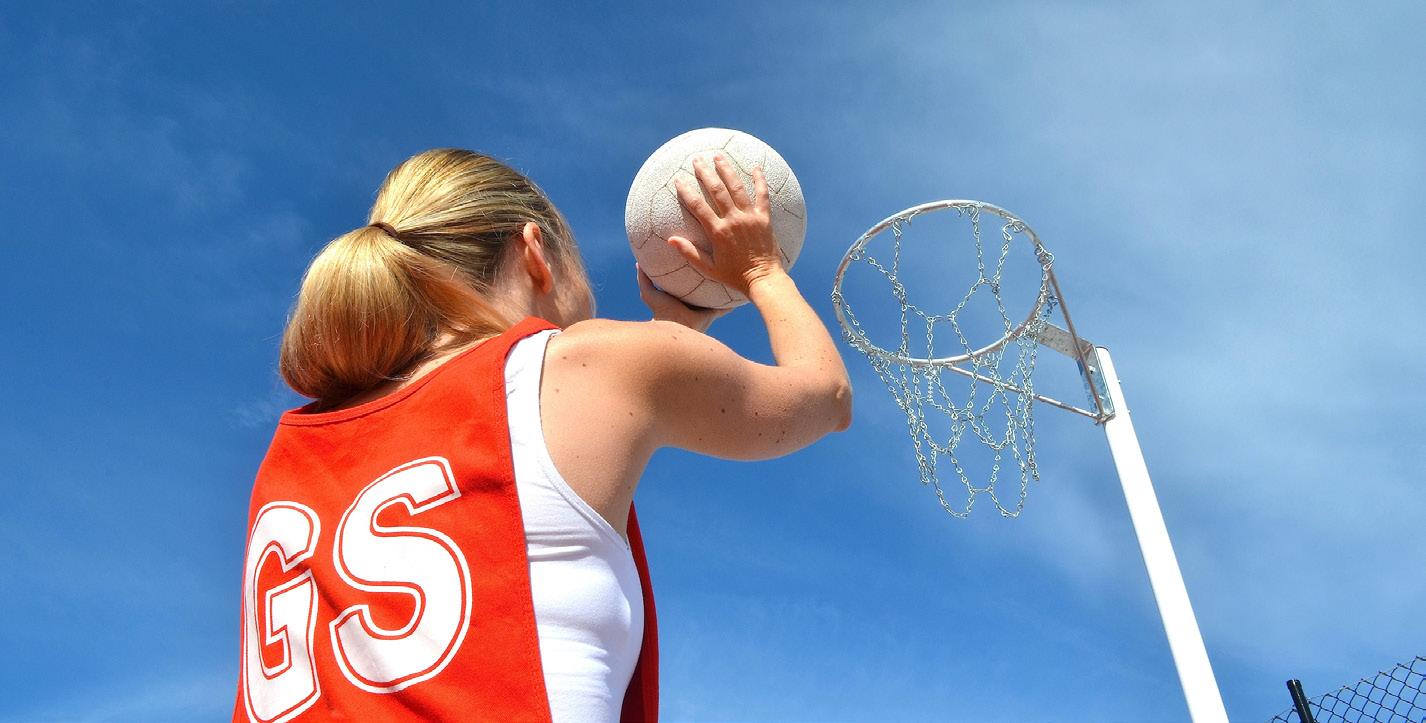
Study
tip
In Unit 3, Internal assessment 1: Project – folio, you will be required to devise a constraints-led learning activity to allow for the emergence of a personal tactical strategy to optimise your performance of a movement strategy. Personal tactical strategies are movement solutions that emerge due to self-organisation. You will be required to evaluate your tactical strategy to justify any recommendations for further improvement to occur. Detailed support for this assessment is provided in Lesson 2.8 Assessment support – Internal assessment 1: Project – folio (page 82).
When conducting an analysis of your performance to determine the constraints-led learning activity you will devise, you will be required to refer to the specific area of your game it relates to. You will need to consider the ultimate goal of the movement based on the movement strategy the movement is working towards. The personal tactical strategy will be the movement solution which emerges for your performance of a specialised movement sequence during or after the implementation of your constraints-led learning activity.
What the research says
When it comes to enhancing skill in learners, coaches over the past decades continue to focus on stabilising internalised models of “sport techniques” so that they are: (a) repeatable and “automatic”, and (b), hold up “under the stress and pressure” of competition (Moy, Renshaw, & Davids, 2014; Whiting, 1975; Kiely, 2017; McWorter, 2017; Toner & Moran, 2021). To achieve this goal, coaches devise drills that are often isolated and reductionist (far removed from the performance environment) with the belief that the rate of “skill learning” is suppressed under competitive pressures which may distract attention and narrow memorising (Rose & Christina, 2006; Schmidt, 1982; Whiting, 1975). Hence, traditional methods of skill learning have overemphasised repetitive rehearsal and “rote learning” of movement techniques, based on the key belief that, only once a movement skill is relatively stable and programmed in the mind, will it become resilient to the stress of dynamic performance environments. Whilst this approach has been an established view in traditional motor learning theory and has become an essential feature of traditional coaching practice, its efficacy is questionable in terms of supporting the overarching goal of improving performance in dynamic environments where functional solutions are predicated on adapting to interacting individual, environmental and task constraints (Headrick et al., 2012; Maloney, Renshaw, Greenwood, & Farrow, 2022; Orth, Davids, Araújo, Renshaw, & Passos, 2014; Oudejans & Pijpers, 2009).
Renshaw, I., Davids, K., O’Sullivan, M., Maloney, M. A., Crowther, R. & McCosker, C. (2022) “An ecological dynamics approach to motor learning in practice: Reframing the learning and performing relationship in high performance sport”, in Asian Journal of Sport and Exercise Psychology Vol 2, Issue 1
How to plan a constraints-led learning activity
Implementing a constraints-led learning activity to optimise performance of movement sequences and strategies in any sport or physical activity can be a new and challenging experience and one that will take time to master. The process requires coaches and learners to experiment with new techniques that sometimes may not immediately have the desired outcome, and will involve some trial and error over an extended period of time.
To successfully plan and implement a constraints-led activity, coaches and teachers must:
• understand the demands of the physical activity
• determine the learner, task and environmental constraints influencing movement
• consider the principles of decision-making
• devise and implement the constraints-led learning activity.
We will now look at these steps in more detail.
Understand the demands of the physical activity
To plan a constraints-led learning activity or practice session, it is important to understand the requirements of the physical activity being practised. As discussed in Lesson 2.5 Decision-making in the dynamic systems approach to motor learning (page 63), movement sequences within physical activities are specific to movement strategies within the activities themselves. Understanding the goal of the movement strategy can help a coach, teacher or player to determine how best to structure a constraints-led learning activity to allow successful movement solutions to emerge.
For example, in touch football, setting up an attack by providing attacking options to the ball carrier requires speed, accuracy and flow of movement. The demands of this movement strategy means that the supporting player needs to implement specialised movement sequences such as catching, rucking, switches and wraps. It also requires the player to consider timing and positioning in relation to the ball carrier and in relation to the opposition. Practising the movement sequences without considering the goal and the demands of them within the context of setting up an attack means that the movement solutions that emerge may not be effective in an authentic performance environment.
SOURCE 4 Weather is an environmental constraint – some players will be able to take advantage of particular weather conditions.
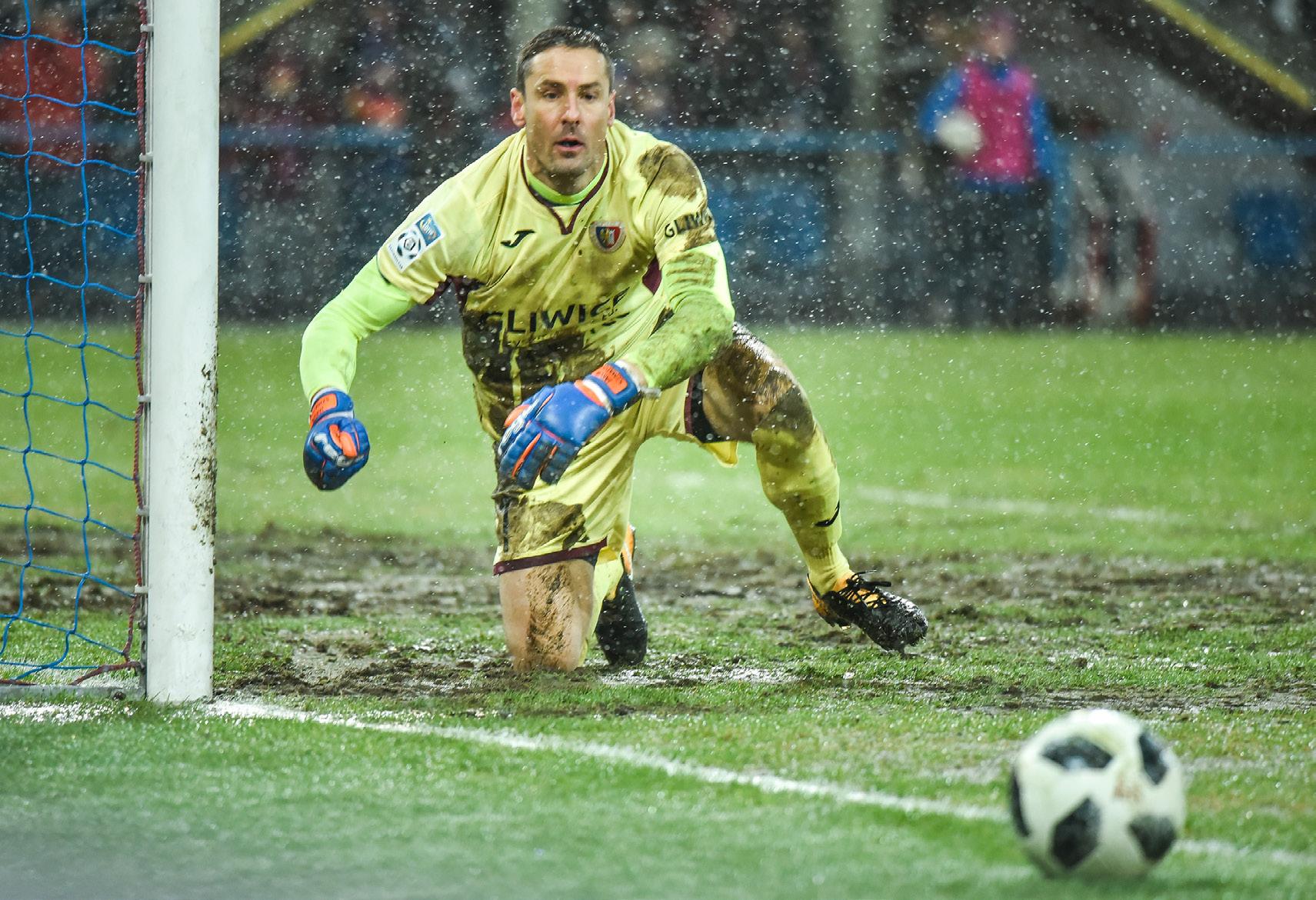
Determine the learner, task and environmental constraints influencing movement
When devising a constraints-led learning activity, it is important to understand the constraints influencing a learner’s movements in a performance environment.
A performance analysis should gather information about how movement is impacted by the:
• learner constraints, e.g. height, coordination, handedness, attunement, strength, speed, confidence
• task constraints, e.g. rules, teammates, opposition, court/field dimensions, game objectives
• environmental constraints, e.g. weather, spectators, coach/teacher.
In this way, decisions can be made about which constraints have the most impact on the performance of the movement strategy and how constraints can be manipulated to constrain performance and compel particular movement solutions.
Consider the principles of decision-making
principles of decisionmaking a set of guidelines (cognitive processes) that can be used to help individual athletes or teams make the best and most appropriate decisions in performance environments
When determining a constraints-led learning activity, using the principles of decision-making will help determine the phase/s of decision-making in most need of improvement. The principles of decision-making (discussed in Lesson 2.5 Decision-making in the dynamic systems approach to motor learning page 63) break down the process of perceiving and acting (i.e. perception–action coupling, discussed in Lesson 2.3 The dynamic systems approach and ecological models of learning page 50) into four stages. Carefully analysing these stages helps us to make more informed judgments about problems in the learner’s decision-making processes (e.g. attunement).
The priniciples of decision-making (4 R model) can be used to help gather data by identifying the learner’s ability to:
• recognise affordances (i.e. attunement)
• respond to affordances with appropriate off-the-ball movements
• react with on-the-ball movements by executing specialised movement sequences for movement strategies with accuracy, speed, force and balance etc.
• recover to optimise positioning for the next phase of play.
Understanding where problems are arising permits the most relevant task constraints to be manipulated to allow for the emergence of a successful movement solution or personal tactical strategy.
Manipulate constraints to allow for the emergence of better movement solutions
After gathering information about the demands of the movement strategy and movement sequences, the constraints influencing movement and the principles of decision-making, conclusions can be drawn about task constraints that could be manipulated to disrupt movement patterns and compel a new movement solution to emerge. Such constraints could include:
• limiting areas of the playing field that can be used
• restricting body positioning, shape or movement
• removing options for passing or hitting balls.
Let’s break this down using a water polo example. Lou is a goalkeeper on her team. She has identified a problem in her execution of the movement strategy of delivering the ball to field players in fast breaks and attacking play from her goalkeeper position following a turnover. She opts for short passes to the closest player out of the goal box and this results in the ball taking too long to move into the attacking zone and more opportunity for the defence to disrupt the fast break. She uses expert performance and advice to determine that the purpose of this movement strategy is to get the ball down the pool as quickly as possible so as to beat the defence.
Lou examines some of the significant constraints influencing her performance, including the position of her teammates, the position of the opposition, her arm strength and her attunement to the opportunities for action.
Lou identifies that, while skilled performers in her researched video footage get the ball down the pool quickly with a small number of passes, her short pass to the closest teammate from the goal box means it takes longer to transition down the pool and the fast break is less effective. She decides to manipulate a task constraint to compel a better movement solution. She introduces a rule that the ball must reach the halfway point in 6 seconds or a turnover occurs.
Source 6 and Source 7 provide examples of task constraints that can be manipulated in different “Invasion” and “Net and court” physical activities to promote the emergence of a particular movement solution.
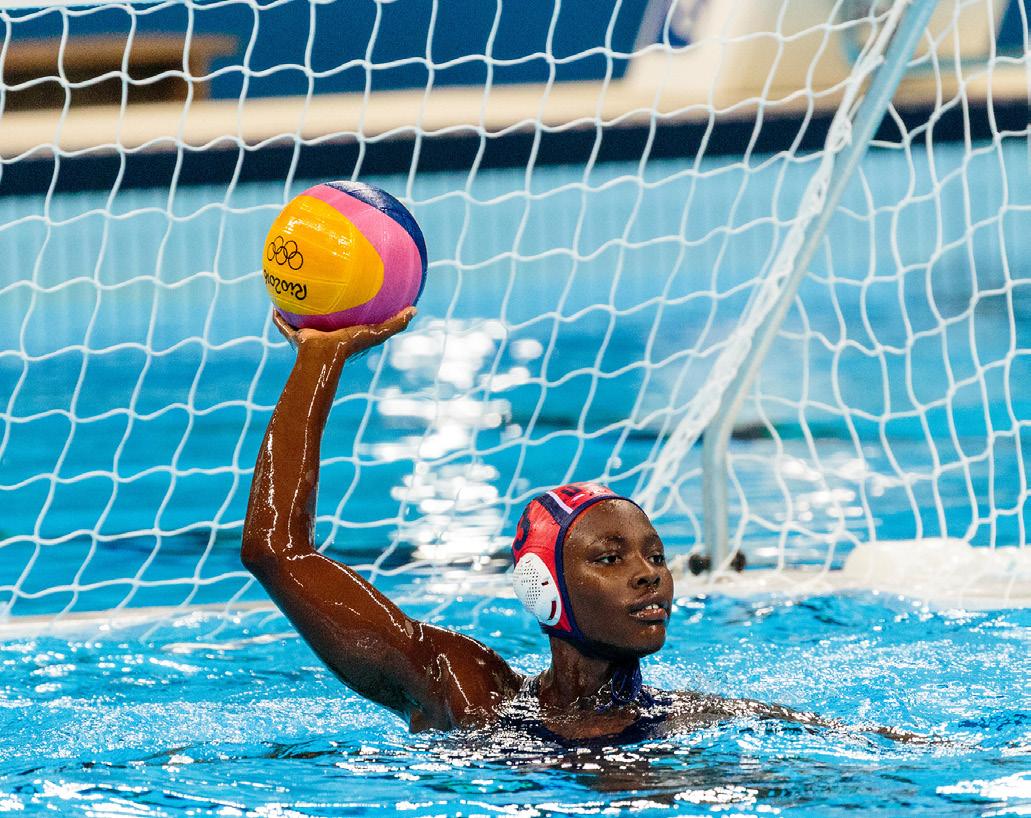
SOURCE 5 A water polo goalie plays a key role in moving the ball quickly down the pool during a fast break. They must attune to appropriate affordances that compel them to throw the ball to players further down the pool. Manipulating task constraints to shine a spotlight on this movement solution can help the athlete develop this area of their performance.
Physical activity
Identified problem Stage of decisionmaking
Australian football Can only handball or kick from one side (left or right)
Basketball Beginner player is unable to see open teammates when dribbling
Netball
Low conversion of scoring shots
Soccer Players take shots too early and too far away from goal
React
Recognise
React
Example of task constraint manipulation
• Players must not use their dominant side to pass the ball.
• Impose a vision occlusion (e.g. the athlete may not look at the ball when they are dribbling).
• To score a goal, the GA or GS must press the ball against the goal post.
React Players receive:
• 5 points for a header
• 3 points for a goal within the 6 yard box
• 2 points for a goal scored from within the 18 yard box
• 1 point for any other goals.
Touch football Players can’t break through defence because they are not drawing the defence before making the pass
Water polo Shots at goal are easily saved by the goalkeeper
Recognise and respond
React
• Play 2v1: 2 attackers, 1 defender in a 10 m square grid. Attackers must get the ball over the line without getting touched. Note: Reducing the width of the field size will further amplify the need to draw out the defender before making the pass.
• When successfully scoring from an outside water shot, players score a bonus point if they can immobilise or misdirect the goalkeeper before releasing the ball.
SOURCE 6 Examples of task constraints that can be manipulated in “Invasion” physical activities to promote the emergence of a particular movement solution
Physical activity Identified problem
Badminton Player’s return clears to the centre of the opponent’s court
Volleyball Passes swing their arms too much during a dig to the setter
Tennis Player “air swings” (i.e. they are unable to make contact with the ball)
Stage of decisionmaking
Read
React
React
Example of task constraint manipulation
• Create a 1.5 m x 1.5 m zone in the centre of the court using flat markers. If the opponent returns a shot from that zone, they automatically win the point.
• Pick a height relative to a spot on a wall or even the net antenna. The pass must not go over that height or the point is awarded to the other team.
• Change the ball from an official match ball to a larger, less bouncy training ball and reduce the racquet handle length.
SOURCE 7 Examples of task constraints that can be manipulated in “Net and court” physical activities to promote the emergence of a particular movement solution
Devise and implement the constraints-led activity
Once it has been decided how constraints will be manipulated, the constraints-led learning activity can be devised to optimise “repetition without repetition”. Often, this involves reducing numbers on the field to maximise opportunities for the practice of the specific
movement strategy. Other changes might include adjustments to field or court positioning, e.g. close to the goal to practise opportunities for attacking opposition goals, or limiting the size and shape of the playing area.
Before implementation, the following information needs to be communicated to the learner:
• the problem in their performance related to the constraints-led learning activity, e.g. the water polo ball not getting down the pool quickly enough in the fast break
• the goal of the activity without explicitly telling the learner what to do, e.g. to increase the speed of the water polo ball in the fast break from the goalkeeper to the halfway line.
• the task constraint/s being manipulated, e.g. placing a 6-second time limit on the water polo ball making it to the halfway line to avoid a turnover.
• how the activity will run, e.g. as a half court game with a shot on goal for the goalkeeper to try to save to start the game. If the ball is saved, the clock will start to immediately provide 6 seconds in which to get the ball to the halfway line. If successful, that team will then bring the ball back to the same goal to set up for a shot. If not, the other team gets another shot. The same goalkeeper will defend for both teams.
A common misconception about the constraints-led approach is that the coach is silent and lets players work it out on their own. However, the coach plays an important role beyond the designing of the activity. The coach is usually responsible for:
• communicating all the above information to their player/s
• providing feedback during and after performance about the learner’s progress towards a successful movement solution
• making judgements about any further task constraint manipulations needed to home in on more specific movement solutions.
If, after a few minutes of trial and error and self-organisation, the learner is not making progress towards an effective movement solution, an analogy can be offered to the learner. The analogy should lead the learner to the common features of the movement solution used by experts, e.g. “In a fast break the ball needs to move up the pool with the pattern of a skipping stone, from big jumps to smaller jumps”.
Using analogies
An analogy that could be used to help a tennis player add topspin to their forehand shot could be, “Make the shape of a rainbow when you swing your racquet to hit the ball”. This will guide their movement solution without giving them technical instructions, such as “Move the racquet from low to high by turning your shoulders to the side and contacting the ball in front of your foot”, and expecting the learner to reproduce them. The rainbow analogy allows the learner to explore the movement in a way that honours the unique constraints they are working with in their performance but does not force them into specific positions and movements.
Other examples of analogies include:
• basketball jump shot – “Reach up as you shoot as though you are trying to put a biscuit in a jar on a high shelf”
• golf putting – “Grip the club as if you are holding a tube of toothpaste in two hands and you don’t want to squeeze any out”
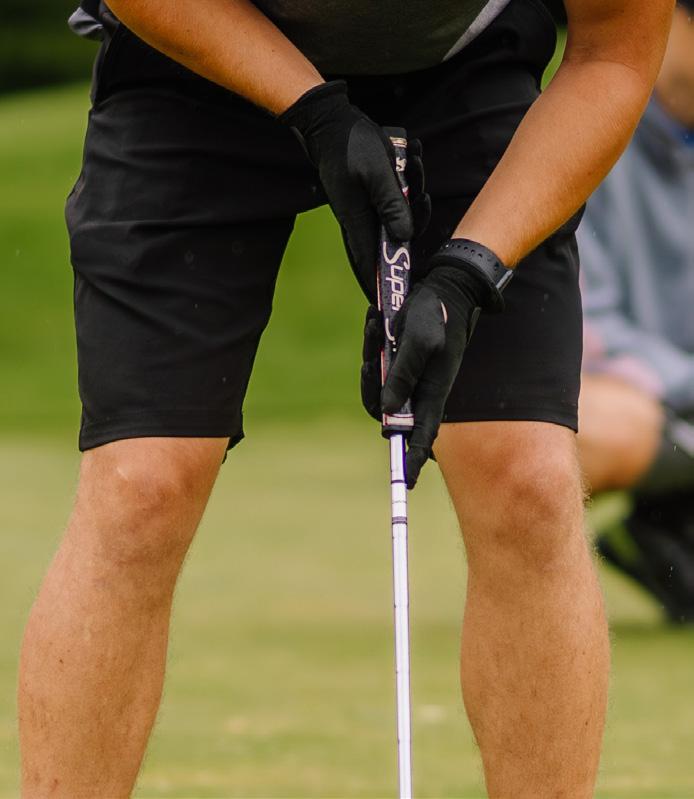
SOURCE 8 The grip on a golf putter can be compared to holding a tube of toothpaste with two hands and trying not to squeeze it.
• badminton overhead smash – “Imagine you are trying to swat a fly on top of the fridge with a fly swatter”.
Research has found that not only does the use of analogies give the learner room for variability, but avoiding references to the learner’s body and explicit movement instructions can improve the likelihood of the performer retaining their best performance under pressure.
Feedback
Finally, throughout implementation, learners should be offered feedback about the changes in their movement patterns and the outcome of their performance. It may be necessary to make additional manipulations of the task constraint to further amplify areas for improvement.
In the water polo example, an example of an ideal movement solution might be to see the goalie looking further down the pool for teammates to whom she can make a longer initial pass. She might be struggling to effectively complete such a long pass and the coach might help by further constraining her with a rule that she must not have her shoulders under the water when she passes. This would hopefully compel her to speed up her eggbeater kick to propel her further out of the water to make a stronger pass.
Study
tip
Remember to journal every activity you do in this unit. Make careful notes about the ways in which the task constraints were manipulated. You will need to couple this information with a performance evaluation using the body and movement concepts to determine what movement solutions emerged and whether the performance technically improved. Use the provided GPAIs and DCIs to support you in gathering this data.
Check your learning 2.7
Check your learning 2.7
Retrieval and comprehension
1 Choose the correct answer.
Which of the following is a key characteristic of constraints-led activities?
A Focus on isolated skill practice
B Emphasis on predetermined movement solutions
C Manipulation of task constraints to facilitate learning
D Strict adherence to a fixed progression of exercises
2 Choose the correct answer.
In a basketball game, a player is attempting to shoot a free throw. Which of the following represents a task constraint that could influence their success?
A The height of the player
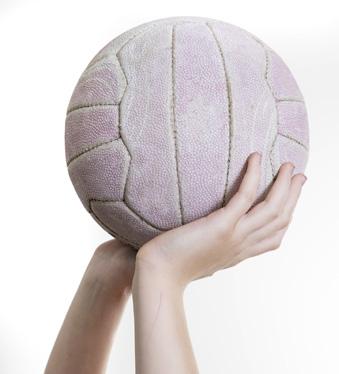
B The distance between the player and the basket
C The player’s level of focus
D The coach’s expectations
3 Summarise the process for designing and implementing a constraints-led activity.
4 Explain what a coach implementing a constraints-led activity should do if the activity is not resulting in an athlete’s improvement or progress.
Analytical processes
5 Identify the issue with the following communication of problem and purpose for touch football: “Your goal for completing this activity is to take a side-step to evade the oncoming defender when they are 1 metre away from you.”
6 Match each of the constraints-led activity examples on the left (a–d) with the correct element on the right (i–iv).
Constraints-led activity example
a Use witches hats to make a 2 x 2 m exclusion zone in position 5 of the volleyball court. The ball may not be hit into the exclusion zone.
b This activity aims to put variation into the shot repertoire.
c Complete a hitting drill where the ball is fed into a setter who sets an outside ball. The hitter has five consecutive turns to hit away from exclusion zone before joining the end of the line. Set up two blockers to defend against the hitter.
d Outside hitters always spike to position 5 on the volleyball court (which is the back right corner as the hitter sees it). Spikes are being easily retrieved by the opposition as they are too predictable.
Knowledge utilisation
7 One of the most common issues with the design of a constraints-led activity is that the manipulated task constraints do not amplify the identified problem. For example, a winger in touch football might never get a chance to address their problem of poor passing because the ball never gets to them. Reflect on this issue and propose a solution to minimise this problem.
8 After identifying that her basketball shooting is a problem area, Gisele participates in several constraints-led activities that focus on the principle of play “attacking opposition basket and
Element
i identification of problem
ii goal of constraints-led activity
iii task constraint manipulation
iv constraints-led activity set-up
scoring”. An analysis of GPAI data reveals that she only scores when performing a lay-up. All other shot attempts are disrupted by a defending player intercepting or knocking down the shot.
a Identify possible task, learner and environmental constraints that could be impacting Gisele’s performance.
b Use the table below to design a constraints-led activity for Gisele. In 150 words, justify how this activity will lead her to find a movement solution to overcome her inability to shoot when not performing a lay-up.
Physical activity: Basketball
Problem and goal Task constraint manipulation
Analogy aligned to movement solution Constraints-led activity set-up
Lesson 2.8 Assessment support – Internal assessment 1: Project – folio
Overview of Internal assessment 1: Project – folio
As part of your assessment for Unit 3 of the QCE Physical Education syllabus, you will be required to complete a Project – folio. The Project – folio is a complex task with many different components.
This lesson is designed to support you as you complete your own Project – folio (see ). It includes practical tips and advice to ensure that what you produce meets the criteria set in the instrument-specific marking guide (ISMG). Detailed information on how to structure, create and present your Project – folio is provided in Lesson 1.3 Tips for success on the Project –folio (page 8). In addition to this, Lesson 1.4 Skill drill: Planning, creating and presenting a Project – folio on Oxford Digital provides a number of useful tips and instructions.
The Project – folio is made up of two sections:
• Section 1 – Presentation. Create a multimodal presentation through which you will need to:
– analyse factors impacting personal performance in your selected physical activity
– devise, justify and evaluate a constraints-led activity which will allow for the emergence of a personal tactical strategy.
• Section 2 – Demonstrating and applying. Produce a video that includes:
– your best performance of two movement strategies from two different principles of play within authentic performance environments of your selected physical activity
– demonstration of body and movement concepts within your movement strategy including quality of movement and one other.
Each of these sections will be assessed and marked against the assessment objectives contained in the instrument-specific marking guide (ISMG). This means that all parts must be completed to maximise your chances of success.
In this lesson, we will model one approach to completing the task.
Section 1 – Presentation
Section 1 of this task requires you to prepare and present a multimodal presentation of up to 11 minutes. Multimodal means using at least two modes of communication (written, visual or spoken) delivered at the same time and integrated so that each mode contributes significantly to the overall response. Examples of multimodal presentations include:
• a pre-recorded slideshow presentation with voiceover submitted as an MP4

• a presentation conducted in front of an audience (class or teacher) with text and images etc. projected
• a digital portfolio of video, images and diagrams with annotations or commentary
• a multimedia movie or slideshow that may include a combination of images, video, sound, text, narrative voice etc.
Analyse constraints and applied principles of decisionmaking in performance of a movement strategy
Devise and justify the development of a
Evaluate the e ectiveness of the constraints-led activity in allowing for the emergence of a personal tactical strategy by appraising constraints and decision-making
Justify recommendations for maintenance and modification
SOURCE
There
Task 1 – Analysing primary and secondary data
The first part of your presentation requires you to analyse primary and secondary data, looking for relationships between:
• the demands of the specialised movement sequences for one movement strategy
• task, learner and environmental constraints that limit or enable personal performance of the specialised movement sequences for one movement strategy
• application of the principles of decision-making based on the presented opportunities for action in the specialised movement sequences for one movement strategy. To do this, you will need to do the following:
• Research the demands of your selected specialised movement sequences and movement strategy. (Note: you will use this secondary data to inform your analysis of constraints and decision-making.)
• Collect video footage showing your performance of your selected specialised movement sequences for one movement strategy.
• Collect match statistics on relevant features of your performance of specialised movement sequences for your movement strategy, e.g. errors, points won versus lost, accuracy, decision-making.
• Analyse footage to identify learner, task and environmental constraints limiting and/or enabling your performance.
• Make connections to your application of the principles of decision-making within your performance.
Study tip
An excellent way to add voiceover to your slides is to use a program called Screencastify. You can use Screencastify’s drawing tools to interact with your slides and draw the assessor’s attention to the features of the embedded videos and images you are referring to. Using the pause tool is also helpful if you stumble or lose your place for a moment as it allows you to stop and then resume without having to start again from the beginning.
The key here is to remember that your discussion should show a connection between each of these points to satisfy the ISMG criteria. The primary and secondary data you collect in this analysis can help to justify the development of your constraints-led activity.
To assist you with this process, three GPAIs have been provided to download. You can customise these GPAIs to suit your individual needs. You might also like to make your own, specific to the information you would like to gather.
Additional resource: Performance analysis GPAI
Describe:
• Timing
• Technique
• Movement patterns (direction, frequency, and the intensity of movement)
• Decision-making
Describe:
• Timing
• Technique
• Movement patterns (direction, frequency, and the intensity of movement)
• Decision-making
Describe:
• Timing
• Technique
• Movement patterns (direction, frequency, and the intensity of movement)
• Decision-making
Describe:
• Timing
• Technique
• Movement patterns (direction, frequency, and the intensity of movement)
• Decision-making
Describe:
• Timing
• Technique
• Movement patterns (direction, frequency, and the intensity of movement)
• Decision-making
SOURCE 2 Performance analysis GPAI (designed to analyse changes in your specialised movement sequence)
NOTE: The time period can be over a 10-minute period (in 2-minute blocks) or over several days or weeks.
Additional resource: Reflective journal DCI
Query
1. What problem was identified from your performance?
– For what movement strategy within which principle of play did this relate to?
– Which specialised movement sequences were involved?
2. Describe the constraints-led activities that you participated in, in order to address this problem. For each, state the goal that was communicated to you.
– List each acitivity (giving it a logical name).
– In one sentence, provide a general overview of the activity.
– Explain what constraints were manipulated.
– State which goal was communicated to you for this constraints-led activity (e.g. “The goal is for you to find the fastest way to get the ball into the opposition half.”)
3. What feedback did you receive during/after participating in these constraints-led activities (from yourself and from external sources)?
– What did your teacher say?
– What were your own observations?
– What did your teammates say?
– What did video analysis reveal?
Response
4. Over the course of the week, what changes did you notice in your:
– timing?
– direction, frequency and intensity of movement?
– technique?
– decision-making?
5. From your analysis, can you conclude that specific movement solutions have emerged?
SOURCE 3 Reflective journal DCI (designed to help identify the emergence of a tactical strategy)
NOTE: Complete this DCI at the end of each week by reflecting on the constraints-led activities you have participated in. Regular completed of this DCI might allow you to determine which tactical strategy has emerged over time.
Example
Jasper is playing tennis as part of his tactical awareness unit. He has been watching videos of expert tennis players to get a better sense of the demands of the sport. He begins his primary data collection early in the unit by obtaining video footage and statistics of his tennis performances. After recognising there is room for improvement in his decision-making, movement, and execution of shots at the net, Jasper decides to focus on the specialised movement sequence of the overhead smash in the context of the movement strategy, “Win a rally following an opponent’s high shot to the net”.
From secondary data, Jasper can see that this movement strategy requires anticipation and speed of movement to get into a good position. He needs to recognise affordances such as a short high ball and respond quickly to get to the net while the ball is still
high enough to allow him to hit the ball overhead. He also needs accuracy to direct the ball into the opponent’s court.
From video footage taken and GPAI data gathered, Jasper can see that task constraints such as the height of the ball and the position of his opposition impact his performance, compelling him to hit the ball above his head and away from the opposition. He also notices that his learner constraint of low upper body strength has an impact on the force he applies to the ball, but his quick speed enables him to get into position quickly. The environmental constraint of the sun reduces his vision when the ball is high. Further, he notices that he applies principles of decision-making by reading the play and recognising and responding accurately. However, his on-the-ball execution of the overhead smash is often ineffective and the ball regularly goes out over the baseline or sideline as he struggles to overcome the constraints presented. Furthermore, he frequently forgets to recover.
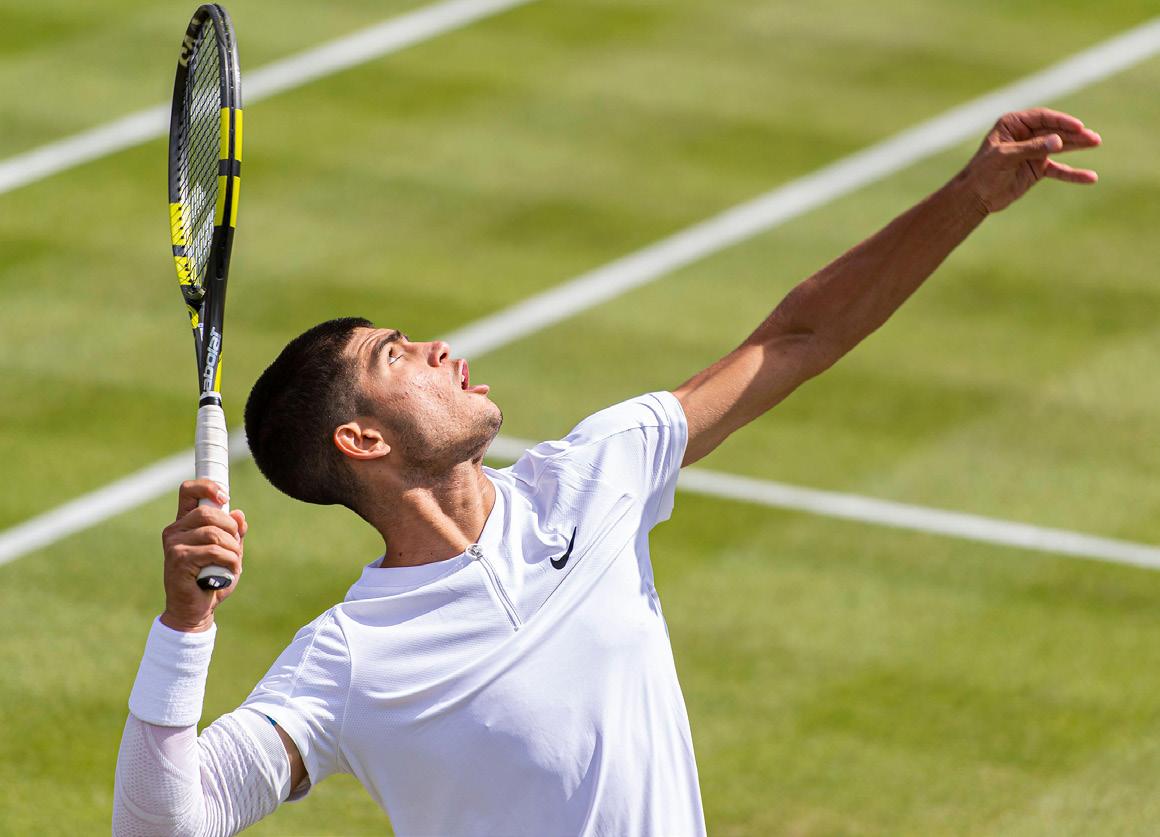
Jasper notes down the relevant primary and secondary data that supports the claims made in his analysis and starts using the data to consider how he might use a constraints-led activity to improve his performance.
SOURCE 4 Jasper analyses expert players and their overhead smash technique. He notes that his own overhead smashes frequency go out over the baseline.
Task 2 – Devising, justifying and implementing a constraints-led activity
Once you have determined the most significant relationships between the movement strategy, constraints and applied principles of decision-making, you should have enough data to devise a constraints-led learning activity/practice. The idea of this activity is to provide the opportunity for the emergence of a personal tactical strategy (unique movement solution) to optimise performance for one movement strategy. Lesson 2.7 A constraints-led approach to teaching and learning (page 72) will take you through the steps for devising a constraints-led activity. The activity should be specifically designed to address the areas of your performance you have identified in your analysis as needing refinement. As mentioned in Task 1, the synthesis of primary and secondary data collected in your analysis can be used to justify the development of your strategy. To make justifying statements, using sentence starters such as “Therefore ...” or “Due to the findings from this data ...” is recommended.
Once you have devised your strategy, it is important that you implement the strategy during class time over the course of one to two weeks and collect primary data on the impact on your performance to look for the emergence of your personal tactical strategy or movement solution. The more data you can gather, the more valid and reliable your conclusions will be!
It is recommended that you complete a personal journal entry (see Source 5) and GPAIs similar to the ones you used to collect your initial data every time you participate in your constraints-led activity. This will help you to see whether there has been development of your movement strategy and the emergence of a personal tactical strategy over time.
You should also try to record as much video footage of your performances as possible. This can increase the accuracy of your data capture because you can pause and slow down footage to complete GPAIs. Another benefit of gathering video footage is that it can form a visual mode of communication for your multimodal presentation (along with still images, data tables and supporting graphics, if you wish).
The combination of these different forms of data provides strong evidence on which to base your conclusions.
Additional resource: Reflective journal template
Reflective
journal – Personal tactical strategy
Selected movement strategy:
Relevant specialised movement sequences:
Date:
Time:
Weather:
Performance context (e.g. opposition, teammates, position):
Constraints manipulated (if any):
Describe the effectiveness of your performance in the first 5 minutes of activity.
Describe your performance of your specialised movement sequence/s for your selected movement strategy, i.e. what exactly did you do to complete the movement strategy?
Reflective journal – Personal tactical strategy
Describe the effectiveness of your performance in the last 5 minutes of activity.
What changes did you notice (if any) in your performance of your specialised movement sequence/s for your selected movement strategy?
Were there any other observations you noted that might be relevant to your development of a personal tactical strategy?
SOURCE 5 Reflective journal template
Example
Finding evidence in his primary and secondary data to indicate that his execution of overhead smashes in the react phase of the decision-making cycle is not optimal, Jasper focuses on this aspect of his performance for his constraints-led activity.
He decides to mark out two “smash zones” approximately 2 metres by 2 metres each, on the other side of the net, just inside the baseline.
To increase his “repetition without repetition”, he asks his opponent to rally against him with a focus on regularly sending him short, high balls to compel him to complete an overhead smash. To finish the practice, he must reach 20 points. He receives one point for each successful overhead smash and two points if it lands in the smash zone. He loses one point each time he hits it out or into the net.
He completes this constraints-led practice over three training sessions, timing how long it takes him to reach 20 points during each session. He also
engages in match play to gauge the impact of the training on his performance.
Jasper sets up a video camera to record his practice using the constraints-led activity. He also makes sure to complete GPAIs similar to his initial data collection GPAIs during his practice sessions to compare his performance before and after the implementation of his constraints-led activity.

Task 3 – Evaluating the effectiveness of the strategy
Once you have implemented your practice for one to two weeks and collected data on your performance, you are required to evaluate the effectiveness of your constraints-led learning activity/practice in providing opportunity for the emergence of your personal tactical strategy (movement solution).
To do this, you must appraise the outcomes and limitations of the task, learner and environmental constraints present in your constraints-led activity; as well as your applied principles of decision-making, and consider how these have compelled you to move and act in certain ways. Some of the constraints or applied principles of decision-making may have had a negative affect on your personal tactical strategy. These are the limitations.
The primary and secondary data you use to show your outcomes and limitations in this section will enable you to justify the parts of your strategy that you recommend keeping and those you should modify. This part will be outlined in more detail in Task 4.
SOURCE 6 In his contraints-led activity, Jasper must hit his overhead smashes into the marked smash zones for two points.
Example
Jasper reviews all the data gathered while he implemented his strategy. He completes GPAIs by watching video footage of his constraints-led activity and his match performances. To appraise the outcomes and limitations of the task, learner and environmental constraints that gave the opportunity for a personal tactical strategy or movement solution to occur, he first looks at the outcomes of his performance of the overhead smash in the constraints-led activity.
He notices that the time it took him to get to 20 became shorter across the three practice sessions. He compares his footage with initial footage and can see that, when he is successful in hitting the ball into the smash zone, both during the activity and in match performances, his positioning is just behind the ball. By comparison, when he hits the ball out, his positioning is further underneath the ball. He can also see that, as the implementation period progresses, he hits the smash zone more consistently. He concludes that the outcome of the task constraint of gaining points by hitting into the smash zone was that he was compelled to get over the top of the ball better by changing his positioning, and this resulted in more consistent accuracy in the execution of his overhead smashes.
He noted that his learner constraint of weak upper body strength meant that while his execution of the overhead smash increased in accuracy, the force applied to his shots was limited and his opposition was frequently able to return his smashes. Further, the sun continued to impede his vision as
he looked up, causing him to drop his head before contact was made, which often caused him to hit the ball at a lower height than he otherwise might have.
When analysing the outcomes of his applied principles of decision-making, he found that his attunement to the high, short ball was very strong as he was looking for it (especially during his constraints-led activity practice). This sometimes led to errors in his decision-making in the read and recognise and respond phases as he ran in on balls that were either too low or too long. He noted that his recovery between shots was improving and he was recovering 60 per cent of the time, compared with 30 per cent before implementing the strategy.

SOURCE 7 Jasper identifies that his personal tactical strategy, which has emerged following the implementation of his constraints-led activity, is to position himself back from the ball and hit the ball at a low height, as shown by this expert tennis player.
Task 4 – Justifying the maintenance and modification of the strategy
The final task of Section 1 of your Project – folio requires you to make recommendations for the elements of your personal tactical strategy that you should maintain and the parts you should modify or change. It is not enough to make a brief statement here as you are directed to justify your position (i.e. give reasons or evidence to support your conclusion).
The best way to do this is to provide evidence from the data you have gathered (primary and secondary data). In other words, you should reflect on the primary data that identified successes in your performance and combine this with secondary data to justify those features of your personal tactical strategy that should be maintained. You will then need to look for primary and secondary data identifying potential errors in your personal tactical strategy to suggest modifications that should be made.
Example
Jasper concludes that the constraints-led activity was effective in allowing for the emergence of a successful personal tactical strategy. Looking at his performance of the overhead smash, he uses primary data to justify maintaining his positioning further behind the ball. He sources valid secondary data that supports this recommendation. He can see in his primary
data that dropping his head and not reaching high to execute the smash limit his performance, and he therefore recommends modifying this area of his personal tactical strategy to keep watching the ball and hitting the ball at full reach, or even jumping, to maximise the height at which the racquet contacts the ball. He further supports this recommendation with secondary data he sources about the ideal overhead smash technique.
Section 2 – Demonstrating and applying
The second section of your Project – folio requires you to collect video footage of your practical performance in your selected physical activity as evidence of your demonstrating and applying ability. Specifically, your video will be up to 3 minutes in length and will need to show evidence of your demonstration of two movement strategies from two principles of play. Do not exceed the 3-minute time limit as any content included after 3 minutes will not be counted in the awarding of your grade.
Demonstration footage must show you applying these strategies in authentic performance environments – that is, showing performance within game play or competition. Preferably, this footage will show complete plays, rallies and so on, rather than parts of plays. While it is a highlights reel of your best performances, to be considered effective your footage must show the full picture of your performance rather than repeated snippets within rallies or gameplay. Finally, your video must include demonstration of quality of movement concepts (speed, accuracy, force, flow and so on) and one other body and movement concept – either body awareness, space awareness or relationships. Lesson 2.9
Skill drill: Evaluate the effectiveness of
tactical strategy Aim
To evaluate the effectiveness of a personal tactical strategy.
Time
1 lesson (i.e. 60 minutes) with additional time (if required) to complete analysis and discussion.
Equipment
• Equipment relevant to your selected physical activity
• Video camera or personal recording device (including tripod)
• Game Performance Assessment Instrument 3 (GPAI 3)
• Clipboard
• Pen
Game Performance Assessment Instrument 3 (GPAI 3)
Method
Step 1
Form two teams of equal size and prepare to take part in a 20-minute game of your selected physical activity.
Step 2
Before you begin playing, spend a few minutes completing Part A of GPAI 3. At this stage, you should:
• select a particular principle of play you wish to collect data for
• identify a specific movement strategy
• identify a personal tactical strategy.

Step 3
Once this is complete, participate in a teacher-led warm-up.
Step 4
Now set up your video camera to capture footage of the field or court where you will be playing. Take care to ensure the entire playing surface is in view. Begin recording and participate in a 20-minute game of your selected physical activity.
Step 5
At the completion of play, stop recording and begin to review your video footage. As you watch the footage, complete Part B of GPAI 3, identifying:
• 10 instances during the game when you performed your personal tactical strategy (including the time each instance occurred). For each instance when you performed your personal tactical strategy, you should note:
• the affordance you identified (i.e. opportunities for action)
• any constraint/s present (i.e. aspects that influenced the use of the personal tactical strategy)
• the effectiveness of the execution (Were you accurate or inaccurate?)
• the outcome (What happened?)
• the limitations (Did something limit your performance?)
• the quality of your decision-making skills (Were the decisions you made appropriate or inappropriate in each situation?)
A
Principle of play
Movement strategy (i.e. specialised movement sequence):
Personal tactical strategy:
Part B
when personal tactical strategy was performed
Moment 1 Time:
SOURCE 1 GPAI 3 (Note: This is an extract only of GPAI 3 Part B. You can download and print the complete GPAI.)
Analysis and discussion tasks
1 Use the data you have gathered in GPAI 3 to complete the following tasks:
a Identify the affordance you most commonly responded to during play.
b Identify the affordance that most often resulted in a successful outcome.
c Identify the constraint/s that results in the use of your personal tactical strategy the most.
d Evaluate the success of your personal tactical strategy over the course of the game. Did the execution and outcome improve over time? If so, explain why. If not, explain why not.
e Discuss the quality of your decision-making over the course of the game. Summarise this in a short paragraph, drawing on examples from your video evidence to support your position.
2 Analyse your data to try to identify relationships between:
– the affordances you identified and certain constraints
– the accuracy of your execution and certain constraints
– the affordances you identified and the limitations of your personal tactical strategy
– the affordances you identified and the outcomes
– the accuracy of your execution of your personal tactical strategy
– certain constraints and the effectiveness of your decision-making.
3 The process of analysing data and identifying trends and relationships between concepts will help you to draw conclusions about your level of tactical awareness.
a Reflect on the affordances that resulted in less successful outcomes. Identify what changes need to be made to improve your: i execution of the specialised movement sequences ii timing.
b Reflect on the 4 R model of decision-making (see 2.5 Decision-making in the dynamic systems approach to motor learning, page 63) and identify a specific area in which you need to develop your decision-making skills (i.e. READ, RECOGNISE and RESPOND, REACT or RECOVER). Justify your selection and devise strategies to improve in this area.
4 Based on the data you have collected, decide whether you are a tactically aware performer. Justify your response.
x
2 Lesson 2.10 Review: Tactical awareness
• Tactical awareness is the ability to identify what is happening in a game situation and use this information to select and implement the correct physical responses to increase the chances of a successful outcome.
• The cognitive systems approach is a broad theoretical framework used to help explain the processes involved in motor learning. It suggests that learning is hierarchical (i.e. top down) and linear (i.e. one command after the other) and controlled by a central command centre in the brain.
• The dynamic systems approach is a broad theoretical framework used to help explain the processes involved in motor learning. It suggests that our movements are coordinated and controlled through complex, non-linear interactions between all parts of the body, and that no single body system or part is more important than another in the learning process.
• Dynamic systems theory is an ecological model that views the learner as a complex movement system that self-organises (finds movement solutions without instruction or cognitive thought) in response to constraints placed upon it.
• Constraints are variables present at any given time that impact implementation of movement strategies and specialised movements sequences. Constraints can pertain to the learner, the task or the environment.
• Perception–action coupling is an ecological model that attempts to explain how the learner’s motor control system interacts with the environment to simultaneously “perceive and act” and “act and perceive” to identify opportunities (affordances) and produce movements that will maximise the chances of success.
• The ability to successfully identify affordances is called attunement.
• In the dynamic systems approach, decision-making is emergent in nature and depends on the interaction between the learner, task and environmental constraints at play moment by moment.
• The principles of play are a set of movement strategies that can be used to help individual athletes or teams adapt to any tactical situation in performance environments. They can also be used to help coaches and teams focus their objectives and evaluate their performance.
• The principles of decision-making are a set of guidelines that can be used to help individual athletes or teams make the best and most appropriate decisions.
• Considerable planning needs to go into the implementation of a constraints-led approach. A performance appraisal using body and movement concepts and the principles of decision-making as a guide can help to identify problem areas on which to base constraint manipulation.
• There are four steps to designing and implementing effective constraints-led activities: understand the demands of the physical activity; determine the learner, task and environmental constraints influencing movement; consider the principles of decision-making; devise and implement the constraints-led learning activity.
Module summary: Module 2
Review questions 2.10 Exam-style revision questions and tasks
Section 1
• Ten multiple-choice questions
Question 1
Tactical awareness is developed in all of the following examples, except:
A when using perception–action coupling to attune to affordances.
B during constraints-led activities where tactical strategies can emerge spontaneously.
C when solely using the dynamic systems approach.
D when principles of decision-making are applied through authentic game play.
Question 2
The cognitive approach is a traditional approach that uses:
A the ecological model.
B the information processing model.
C the application of task, learner and environmental constraints.
D the non-linear pedagogy model.
Question 3
Which of the following types of practice reflects “repetition without repetition”?
A Massed practice in closed environments
B Distributed practice in closed environments
C Blocked practice
D Variability practice
Question 4
A coach who uses principles from the dynamic systems approach would agree with which statement?
A Control the uncontrollable using predetermined set plays.
B Any constraint modification will allow movement solutions to emerge.
C Exaggerate affordances through tasks constraints.
D Reinforce one perception–action coupling response through massed practice.
Question 5
An individual’s ability to use their vision to detect bowling affordances in cricket is a:
A learner constraint.
B task constraint.
C environmental constraint.
D physiological constraint.
Question 6
Which of the following is an example of interacting with environmental constraints?
A Playing on changing surfaces
B Allowing one bounce in volleyball
C Playing water polo in a swimming pool
D Playing using a lighter ball (e.g. using a volleyball in netball)
Question 7
Participating in an activity that represents an authentic game environment but manipulates one or more task constraints is referred to as:
A the ecological system.
B the constraints-led approach.
C the cognitive approach.
D the 3 A Model: Affordance–Attunement Approach.
Question 8
The four principles of decision-making in correct order are:
A read, recognise and respond, react, recover.
B read, react, recognise and respond, recover.
C read, recover, react, recognise and respond.
D read, respond, recognise, recover.
Question 9
Gibson (1979) said: “We must perceive in order to move, but we must also move in order to perceive.”
Which dynamic systems concept was he referring to?
A Bernstein’s degrees of freedom problem
B Perception–action coupling
C Constraints-led approach
D Information processing system

SOURCE 1
Question 10
Refer to Source 1. What is the coach doing?
A Manipulating ecological constraints
B Manipulating the learner constraints
C Interacting with environmental constraints
D Manipulating task constraints
Section 2
• Two short-response questions
Stimulus 1
During a soccer coaching session, players complete the following drill. Both players move from the blue markers to the red markers. One player (e.g. Player A) passes the ball to their opponent (e.g. Player B). Both players then return to the blue markers. Players repeat this drill, taking turns passing and receiving.
Question 11 (8 marks)
Examine Stimulus 1 and identify the approach to motor learning this drill is based on (i.e. cognitive systems approach or dynamic systems approach). Provide evidence to support your response.
Question 12 (14 marks)
Examine Stimulus 1 and propose two modifications that could make this activity more representative of an authentic game environment. Discuss whether you think these modifications would result in optimised performance.
Section 3
• One extended-response question
Stimulus 2
A volleyball player has collected the following data during a period of game play.
Specialised movement sequence options
Cross-court hit
Line hit
Tip
Deep roll
Question 13 (24 marks)
Analyse the data provided in Stimulus 2 to evaluate the effectiveness of each specialised movement sequence option. Design a constraints-led activity designed to achieve ONE of the following goals:
a Support the learner to further adapt and develop in an area of strength OR
b Highlight a performance problem and support the learner to adapt and develop in an area of weakness. Justify the design of your activity by making reference to relevant aspects of motor learning theory.

Practice assessment task
This practice assessment task was prepared according to the specifications in the Physical Education 2025 v1.2 General Senior Syllabus. It has not been endorsed by the QCAA.
Subject Physical Education
Instrument number IA1
Technique
(i.e. Internal assessment 1)
Project – folio
Unit 3 Tactical awareness and ethics in physical activity
Topic 1 Tactical awareness in physical activity
Conditions
Duration 5 hours
Mode
Length
Multimodal – at least two modes (visual, written, spoken) delivered at the same time and integrated so that each mode contributes significantly to the response
Section 1 – Folio: up to 11 minutes
Section 2 – Visual evidence: up to 3 minutes
Individual / group Individual
Other
Examples of multimodal presentations include:
• a pre-recorded presentation submitted digitally
• a presentation conducted in front of an audience
• a digital portfolio of video, images and diagrams
• a multimedia movie or slideshow.
Schools implement authentication strategies that reflect QCAA guidelines for ensuring student authorship.
Context
Throughout this unit, you have been engaged in a range of constraints-led activities for the selected physical activity, allowing you to find movement solutions and make decisions in the presence of a range of task, learner and environmental constraints. You have also participated in authentic game play to determine the effectiveness of your performance.
Task
Devise a constraints-led activity to allow for the emergence of a personal tactical strategy for specialised movement sequence/s to optimise your performance of one movement strategy in your selected physical activity. Evaluate and justify the development of your constraints-led activitiy and the effectiveness of your personal tactical strategy and applied principles of decision-making. Supply visual evidence of specialised movement sequences and two movement strategies from two different principles of play in an authentic environment.
To complete this task, you must:
• analyse primary data and secondary data to ascertain the most significant relationships between the:
– demands of the specialised movement sequences for one movement strategy
– task, learner and environmental constraints that limit or enable personal performance of the specialised movement sequences for one movement strategy
– application of the principles of decision-making based on the presented opportunities for action in the specialised movement sequences for one movement strategy
• synthesise the most significant relationships to devise a constraints-led learning activity/practice to provide opportunity for the emergence of a personal tactical strategy, to optimise performance for one movement strategy
• justify the development of the constraints-led learning activity/practice for one movement strategy to optimise performance, using evidence from primary data and secondary data
• evaluate the effectiveness of constraints-led learning activity/practice in providing opportunity for the emergence of the personal tactical strategy by appraising the outcome and limitations of the:
– task, learner and environmental constraints
– applied principles of decision-making
• justify the modification and maintenance of the personal tactical strategy for one movement strategy to optimise performance, using evidence from primary data and secondary data
• make decisions about and use language, conventions and mode-appropriate features to communicate information about the strategies to a technical audience
• record visual personal performance evidence in an authentic performance environment.
• Visual evidence will illustrate:
– demonstration of specialised movement sequences and two movement strategies (from two different principles of play for physical activities from the “Invasion” or “Net and court” categories) in authentic performance environments
– application of quality of movement and one other body and movement concept to the performance of specialised movement sequences and two movement strategies (from two different principles of play for physical activities from the “Invasion” or “Net and court” categories) in authentic performance environments.
It is recommended that this task is designed so that students can develop a response in approximately 5 hours of class time.
Detailed instructions for this task (including a copy of the ISMG) are available for teachers to download.
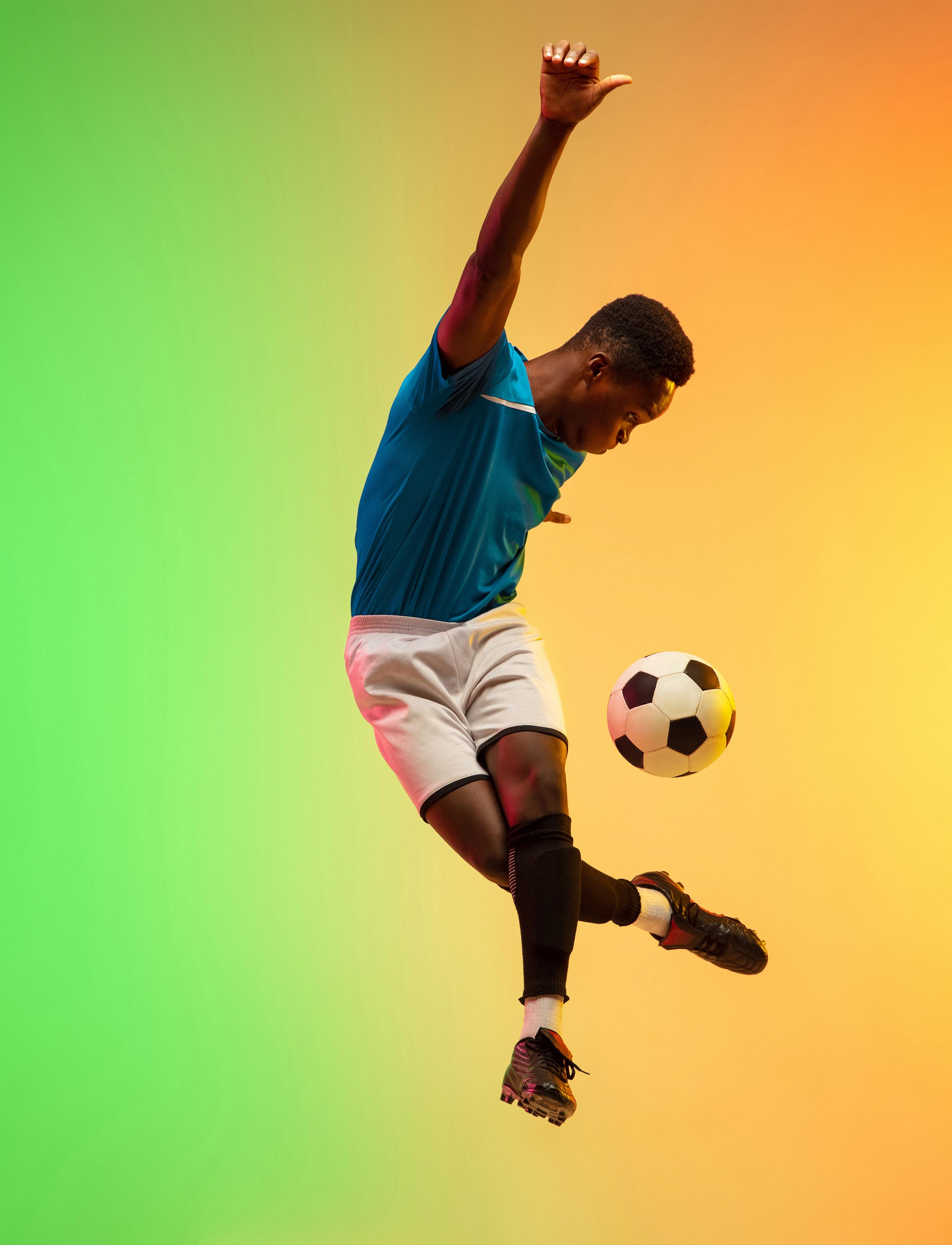
Ethics and integrity 3
Subject matter outcomes covered in Module 3
The following table lists all the subject matter outcomes you are required to cover in Unit 3 – Topic 2 of the Physical Education General Senior Syllabus. It also shows you exactly where that subject matter is covered in this course. The full syllabus is available on the QCAA website.
Weblink: Physical Education General Senior Syllabus.
Unit 3 – Topic 2: Ethics and integrity in physical activity
In Unit 3 – Topic 2, students engage in learning that involves the integration of ethics and integrity subject matter in physical activity.
Subject matter
• Recognise and explain that ethics is the set of norms and ways of life through which we realise acceptable behaviour and values of right and wrong.
• Recognise and explain that ethics in physical activity is developed as a system of values that form the character or integrity of each player and translate, through action, into a player’s engagement in physical activities.
• Comprehend and explain the concept of integrity in physical activity, which includes
the demonstration of the ethics and values that promote community confidence in physical activity
– fair and honest performances and outcomes, unaffected by illegitimate enhancements or external interests
– positive engagement by athletes, administrators, officials, supporters and other stakeholders in and around physical activities, which enhances the reputation and standing of the contest and perception of physical activity.
• Understand and describe the concept of fair play, which includes
observing rules
demonstrating attitudes and behaviours in physical activity consistent with the belief that it is an ethical pursuit – eliminating forms of exploitation in an effort to win, e.g. acts of violence, cheating, drug abuse
– fair competition and equality
respect
team spirit
respect for written and unwritten rules such as integrity, solidarity, tolerance, care, excellence and joy.
• Identify the role of peers, family, coaches, school and community in the development of personal values and ethical behaviours in physical activity.
• Explain how a system of ethical values and ethics strategies influence fair play and integrity of individuals or teams in physical activity.
• Comprehend and describe how ethics strategies can positively or negatively influence integrity.
Lesson/s
Lesson 3.1 Introduction to ethics and integrity (page 102)
Lesson 3.2 Ethics and integrity in sport and physical activity (page 106)
Lesson 3.2 Ethics and integrity in sport and physical activity (page 106)
Lesson 3.3 Fair play (page 112)
Lesson 3.4 Developing personal values and ethical behaviours (page 118)
Lesson 3.6 The influence of ethical values and ethics strategies on fair play and integrity (page 125)
Lesson 3.6 The influence of ethical values and ethics strategies on fair play and integrity (page 125)
Subject matter
• Access codes of behaviour and conduct, and rules and policies (including risk assessment) in class, school and community contexts to identify how they support ethical behaviour and fair play in physical activity.
• Identify and explain how globalisation and media coverage have influenced ethical values and behaviours.
• Identify ethical dilemmas (gender inclusion or exclusion, ability, enhancements in technology and equipment, corruption) through involvement in physical activity contexts.
• Recognise and explain the ethical decision-making framework for exploring ethical dilemmas
– identify the ethical dilemma, i.e. the problem or situation, and the tension that exists between the organisation’s or player’s values
– find information about
» the relevant facts of the problem or situation
» individuals and groups who have an important stake in the outcome
» strategies that have been used in response to similar problems or situations – evaluate alternatives by determining which strategies will
» produce the most good and do the least harm
» best respect the rights of all who have a stake
» treat people equally or proportionately
» best serve the community as a whole
» lead players to act with integrity
– devise strategies that provide a course of action to improve the integrity of the player or organisation
– reflect on the outcome by determining the effectiveness of the ethics strategy on all stakeholders.
• Apply the ethical decision-making framework to investigate the factors that influence integrity in class, school and community physical activity contexts.
• Gather primary data about the relationship between ethical dilemmas, the influence of concepts and principles about ethics and integrity, and engagement in physical activity.
Lesson/s
Lesson 3.6 The influence of ethical values and ethics strategies on fair play and integrity (page 125)
Lesson 3.7 The influence of globalisation and mass media coverage on ethical values and behaviours (page 132)
Lesson 3.8 Ethical dilemmas (page 139)
Lesson 3.10 The ethical decision-making framework (page 154)
• Use secondary data to analyse how the development of ethics strategies can influence engagement in physical activity
Lesson 3.5 Skill drill: Determine your personal values and ethical behaviours in physical activities (page 123)
Lesson 3.9 Skill drill: Investigate personal responses to an ethical dilemma (page 153)
Lesson 3.11 Skill drill: Use the ethical decisionmaking framework to devise an ethics strategy and evaluate its effectiveness (page 161)
Module 3 Ethics and integrity
Subject matter
• Analyse primary data and secondary data to ascertain relationships between the ethical dilemma, ethics strategy, concepts and principles and engagement in the class, school and community physical activity contexts.
• Analyse and synthesise primary data and secondary data about ethical dilemmas in class, school and community contexts to identify individuals and groups who have an important stake in the outcome and strategies that have been used in response to similar problems or situations.
• Devise ethics strategies that provide a course of action in response to the ethical dilemmas that identify the audience, context and outcome to be achieved.
• Justify the development of the ethics strategies using evidence from primary data and secondary data.
• Propose or implement the ethics strategies to gather primary data about the potential outcome and limitations about decisions.
• Reflect on primary data and secondary data to evaluate the effectiveness of the ethics strategies to enhance integrity and optimise engagement for all stakeholders in the class, school and community physical activity contexts.
• Make decisions to maintain or modify the ethics strategies to optimise integrity and engagement in the class, school and community physical activity contexts.
• Justify maintenance or modification of the ethics strategies using evidence from primary data and secondary data.
Lesson/s
Lesson 3.5 Skill drill: Determine your personal values and ethical behaviours in physical activities (page 123)
Lesson 3.9 Skill drill: Investigate personal responses to an ethical dilemma (page 153)
Lesson 3.11 Skill drill: Use the ethical decisionmaking framework to devise an ethics strategy and evaluate its effectiveness (page 161)
Lesson 3.13 Review: Ethics and integrity (page 168)
Source: Physical Education 2025 v1.2 General Senior Syllabus © Queensland Curriculum & Assessment Authority
Learning intentions and success criteria
Lesson 3.1 Introduction to ethics and integrity
Key ideas
→ Ethics is a set of principles and values that help us to judge what is morally "good" or "bad"; "right" or "wrong". A system of ethics usually develops between members of particular social groups (e.g. friends, families, social or sporting clubs, communities, societies and nations) over a period of time until they become a set of accepted norms (i.e. normal, typical, expected or accepted behaviours).
→ Integrity is the quality of being honest and having strong morals and personal values.
Introduction
ethics a system of principles and values (i.e. standards of behaviour) that develop within a social group and by which actions are judged to be ‘good’ or ‘bad’; ‘right’ or ‘wrong’ integrity the quality of having strong morals and personal values (e.g. honesty, loyalty, respect for others, trustworthiness, fairness)
norm a standard or pattern of behaviour that is acceptable or expected within a particular social group such as a family, club or society
Making decisions is an essential part of everyday life; in fact, you may already have made hundreds (if not thousands) of decisions today. These decisions – both big and small – affect all aspects of your life. They influence everything from the clothes you wear and the foods you eat to the things you do and the people you are friends with. Ultimately, all the decisions combine to influence the type of person you are.
Even though you may not consciously realise it, almost all the decisions you make every day can be connected to the concepts of ethics and integrity
What is ethics?
In simple terms, ethics is a set of principles and values that help us to judge what is morally "good" or "bad"; "right" or "wrong". A system of ethics usually develops between members of particular social groups (e.g. friends, families, social or sporting clubs, communities, societies and nations) over a period of time until they become a set of accepted norms (i.e. normal, typical, expected or accepted behaviours).

SOURCE 1 Norms are standards or patterns of behaviour that are accepted and expected within a particular group – like encouraging and supporting members of your team during a game.
Examples of some ethical behaviours within different social groups are provided in Source 2. You will see that some ethical behaviours are common across these groups. For example, cleaning up after yourself is a norm within families, at sporting clubs and across broader society.
Family Sporting club Society
• Cleaning up after yourself
• Knocking on closed doors before entering a room
• Being polite and respectful towards all family members – immediate and distant
• Taking care of vulnerable and elderly family members
• Following the family’s rules and unwritten code of conduct
• Taking pride in personal appearance
• Speaking with respect
• Not littering
• Wearing your seatbelt when travelling in a car
• Not deliberately causing damage to other people’s property
• Following the rules and code of conduct
• Wearing the correct uniform and attending practice as required
• Being respectful towards your coach, members of your team and opponents
• Leaving the club facilities clean and tidy
• Wearing your seatbelt when travelling in the bus
• Offering a seat to an elderly person on public transport
• Not deliberately causing damage to other people’s property
• Not littering
• Not using language that causes offence to others
• Wearing your seatbelt when travelling on public transport
• Offering a seat to an elderly person on public transport
• Not deliberately causing damage to other people’s property
SOURCE 2 Some examples of common ethical behaviours in different social groups
What is integrity?
In simple terms, integrity is the quality of being honest and having strong morals and personal values. These morals and personal values are the principles and ideals that each person believes are central to the way they live their life. These may include honesty, strength, loyalty, respect, trust and fairness.
In many ways, integrity is a measure of how thoroughly and consistently a person chooses to behave ethically. One of the defining characteristics of a person with integrity is that they will choose to do what is "right" or "good" even when no one is watching.
Understanding the difference between ethics and integrity
Ethics and integrity are both challenging and complex concepts to define – mainly because they are both influenced by an individual’s personal, social, cultural, religious, political and environmental beliefs. They can also be challenging to define because they share many common characteristics and are terms which are often used interchangeably in everyday conversation. Although they do share some common characteristics, there are also some key differences between ethics and integrity.
Retrieve it!
What is ethics? Check back to earlier in this lesson to see if you retrieved the information correctly.
morals ideals or standards of behaviour that a person may try to follow or live up to in order to be considered ‘good’ and ‘right’ by other members of a society (e.g. being honest, showing respect for others, being faithful, showing kindness) personal values the principles or standards of behaviour that guide how an individual lives their life; a person’s judgment on what is important in life (e.g. honesty, fairness, trustworthiness)

SOURCE 3 One of the defining characteristics of a person with integrity is that they will choose to do what is "right" or "good" even if nobody is watching.
ethical dilemmas situations in which a difficult choice must be made between two options, when neither option will result in an outcome that is ethically or morally acceptable; in Physical Education, ethical dilemmas are determined by the interactions between your values and principles, and your purpose for engaging in physical activity
Retrieve it!
When being tactically aware you can be attuned to three things. Two of these things are the people around you and the environment you are in. What’s the third?
Check back to Lesson 2.1 Introduction to tactical awareness (page 39) to see if you retrieved the information correctly.
Although it is a simplistic approach, it may help you to think about both concepts in these terms:
• Ethics is about knowing and following a system of rules or principles.
• Integrity is about being honest and doing the "right thing" (in terms of your moral and personal values), regardless of what the system of rules or principles says.
Why study ethics and integrity?
The study of ethics and integrity is central to almost all aspects of life in a society, including sport and physical activity. Remember, almost all decisions you make are linked to the concepts of ethics and integrity. By studying ethics, you will develop an appreciation of the many ways in which even the smallest decisions – such as the clothes you buy or the foods you eat – can have an impact on other people and the planet.
For example:
• Is the brand of jeans you wear manufactured in Australia or overseas? Is the manufacturer a fair and reasonable employer that pays their workers fairly and provides safe working conditions? If not, will these factors influence the brand of jeans you choose to buy in the future?
• Are the foods you eat grown locally or imported from overseas? Are they sourced responsibly? Do they contain any animal products? If so, were those animals killed and processed humanely? Is the packaging recyclable? If not, will these factors affect what you choose to eat in the future?
As you can see, issues relating to ethics and integrity can be connected to even the simplest everyday decisions. This is also the case when we look at ethics and integrity issues in the context of sport and physical activity.
In this module, you will learn about the important role that ethics and integrity play in all forms of sport and physical activity. You will also develop a range of skills required to identify challenging ethical problems (known as ethical dilemmas) and respond appropriately to them. Finally, you will learn how integrity and ethical behaviour can be developed in order to promote sport and physical activity in the community and build trust and confidence in sporting codes and clubs.
In the news
Sport Integrity Australia launches children’s activity book
Sport Integrity Australia has launched its first children’s activity book as part of National Children’s Week. The activity book, designed for children aged 5–8 years old, features activities aimed at teaching children and young people about positive and ethical behaviours in sport.
Sport Integrity Australia’s Acting CEO Dr Sarah Benson says that the book promotes the agency’s highest ideals for sport in a fun and engaging way and ensures those most vulnerable are getting the education they need to help build safe sporting environments.
"Today’s children and young athletes are the ones who will shape and define the sporting landscape for the future," said Dr Benson.
"Engraining these crucial lessons in ethics, positive behaviour and safeguarding practices at the grassroots level will ensure we are building a safer and more inclusive sporting environment for all."
Eight-year-old aspiring swimmer and netballer Milly said the book’s messages reinforce all the things she loves about sport and provided her with the confidence to know how and when to speak up.
"The colouring activities were a lot of fun and I liked learning about what is and isn’t okay, and how I
can ask for help if I need it," said Milly.
Senior Educator and former schoolteacher Nathan Williamson said that the activity book not only serves to teach kids about acceptable behaviours in sport, but it also ensures that young athletes know where to turn in a moment of need.
"Education is integral to protecting sport for all of its participants and members, but that doesn’t just start at the elite level," said Mr Williamson.
"By engaging in these activities from a young
Check your learning 3.1
Check your learning 3.1
Retrieval and comprehension
1 Choose the correct answer.
Integrity is the quality of being ____________ and having strong morals and personal values.
A helpful
B honest
C virtuous
D zealous
2 Choose the correct answer.
A system of ethics usually develops between members of particular social groups (e.g. friends, families, social or sporting clubs, communities, societies and nations) over a period of time until it becomes a set of accepted ____________.
A understandings
B morals
C rules
D norms
3 Explain the difference between ethics and integrity.
Analytical processes
4 Identify three or four personal decisions you have made over the past week.
age, children are developing crucial problem-solving skills and enhancing their self-confidence.
"In addition to this, children are learning that Sport Integrity Australia is there to support them too and will always be a safe space for them to raise their concerns."
The book will be available to children and young athletes at ... SIA education outreach events around the country and a downloadable version is available on [Sport Integrity Australia’s] website.
The National Tribune, 25 October 2024
a Classify each decision based on whether it relates to daily life (e.g. food, clothing, shopping, entertainment, hobbies), family and friends, school, work, sport or other.
b Analyse each decision to determine whether you believe you acted: i ethically and with integrity ii unethically and without integrity.
c Provide reasons to support your answers in Question 4b.
d In each case, determine the reasons/factors that motivated you to act the way you did. Did you consciously consider the consequences of each decision at the time you made it? Reflect on the reasons why/why not.
Knowledge utilisation
5 Read the In the news about Sport Integrity Australia's children's activity book. In full-sentence answers, provide three reasons why this book highlights Australia’s commitment to promoting ethics and integrity in Australian sport.
Learning intentions and success criteria
Lesson 3.2 Ethics and integrity in sport and physical activity
Key ideas
→ Ethics and integrity help to promote positive engagement in sport and physical education (i.e. participation that sets a good example, both for those who play and watch the sport, and for the wider community).
→ Sporting clubs and codes set expectations around ethical behaviours and provide ongoing training and support to stakeholders. Many clubs and teams use the following tools to support and encourage ethical behaviour:
Introduction
sportsmanship fair, generous and polite behaviour, especially when playing a sport or game
written rules the formally documented regulations governing a sport
unwritten rules a set of expectations, qualities or values that are known and understood by a group but have not been formally documented
stakeholder a person (or group of people) who has an interest, connection, concern or investment in something (e.g. stakeholders in a sporting team may include the players, coaching staff, administrative staff, members, spectators, sponsors and investors)
enabler a factor that encourages a person to participate in a sport or physical activity
The concepts of ethics and integrity are an important part of almost all sports and physical activities. In fact, it is difficult to attend a sporting event, watch a sports broadcast, read a commentary or have a conversation about sport without some reference being made to:
• sportsmanship and competing fairly or unfairly (i.e. following the written rules of the sport)
• competing in the "spirit" of the game (i.e. following the unwritten rules of the sport)
• setting a good or bad example (i.e. behaving with honour, loyalty or respect).
Sport and physical activity play an important role in the lives of most people, not only in Australia, but around the world. While not all Australians participate actively in sport, many spend significant amounts of time watching and talking about sport, helping out at local sporting clubs and organisations, or supporting family and friends who play sport. In many ways, sport and physical activity is like a mirror; it reflects what is going on in society. It can show us:
• the best and most positive qualities of ourselves, our community and our society (e.g. team spirit, optimism, respect, honesty, inclusiveness, cooperation, trust, determination)
• the worst and most negative qualities of ourselves, our community and our society (e.g. jealousy, racism, cheating and dishonesty, corruption, bullying, exclusion, discrimination).
However, unlike a mirror, sport is active, meaning that the things that take place in the sporting world influence broader society just as much as broader society influences them. In short, sport is a product of society as much as society is a product of sport.
For this reason, it is important that sporting clubs, associations and codes at all levels take steps to set clear expectations of the types of ethical behaviours they want to promote and ensure that all stakeholders act in accordance with these expectations. If a particular player, sporting club or governing body acts ethically and with integrity, it can be a significant enabler to engagement and participation in that sport. A number of other positive benefits can also result. In particular, ethics and integrity can help to:promote positive engagement in sport and physical activity, which includes – enjoyment – kindness – teamwork and respectful interactions
– character development
– social connection
– mental and physical health
– lifelong learning
• ensure physical performances are fair and honest
• improve community confidence and enhance the reputation of sport and physical activity.
We will now look at each of these benefits in more detail.
How ethics and integrity can help to promote positive engagement in sport and physical activity
One of the main ways in which ethics and integrity can help promote positive engagement and participation in sport and physical activity is by setting a good example, both for those who play and watch the sport, and for the wider community.
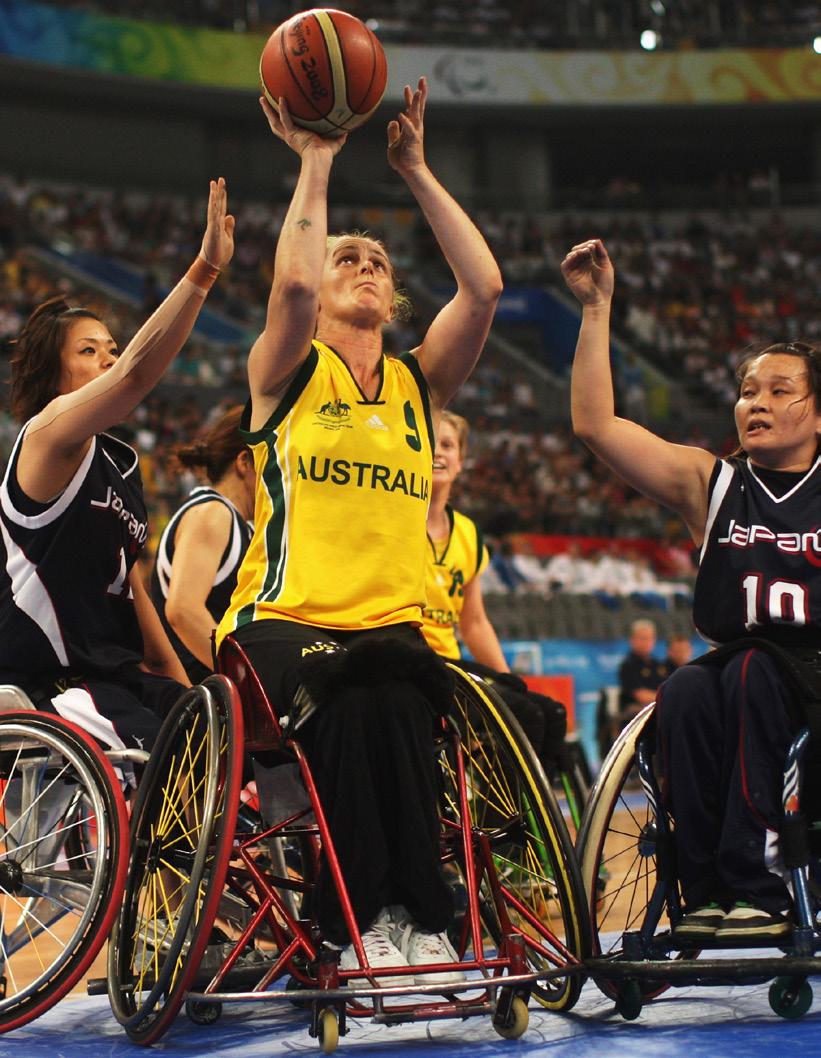
Australia Hall
Fame
Tesch competed in seven Paralympics and won five medals across two sports (basketball and para-sailing). Her humility, positivity and powerful advocacy for people with a disability earned her deep respect among Australia’s para-sport fraternity. Now a member of the New South Wales parliament, Tesch continues to advocate for the needs of others and be a positive role model.
Sporting clubs and associations at all levels (i.e. from small local clubs, to large national or international governing bodies) that set clear ethical guidelines around how athletes, administrators, officials, supporters and other stakeholders conduct themselves gain a reputation for fairness, honesty and integrity on and off the field.
Individual athletes and sporting clubs, including those affiliated with the club, that model appropriate ethical values and behaviours often become ambassadors for their sport. This helps to promote their sport and attract a range of different people in the community to get involved – from young, aspiring athletes and fans and spectators, through to corporate sponsors. This is referred to as positive engagement.
There are a number of ways in which sporting clubs and codes set expectations around ethical behaviours and provide ongoing training and support to stakeholders. Many clubs and teams use one or more of the following tools to support and encourage ethical behaviour:
• a code of conduct – a document that formally outlines the principles, standards and rules of a particular group, team or organisation (and describes the possible penalties and sanctions for breaches)
• a code of behaviour – a document that formally sets out the expected standards of behaviour for members of a particular group, team or organisation (and describes the possible penalties and sanctions for breaches). It generally focuses on the expected behaviours for members who publicly represent the team during training, competitions or club-sanctioned activities (e.g. players, coaches, administrative staff), as shown in Source 2.
• contracts – agreements between employees or business partners of a particular group, team or organisation that outline employment conditions (e.g. wages, working conditions) and roles, responsibilities and expectations of the club
Retrieve it!
What is the definition of integrity? Check back to Lesson 3.1 Introduction to ethics and integrity (page 102) to see if you retrieved the information correctly.
positive engagement participation in sport and physical activity that sets a good example, both for those who play and watch the sport, and for the wider community code of conduct a document that outlines the principles, standards and rules of a particular group, team or organisation code of behaviour a document that sets out the expected standards of behaviour for members of a particular group, team or organisation (with a focus on stakeholders who publicly represent the team during training, competitions or clubsanctioned activities)
SOURCE 1 Paralympian Liesl Tesch AM – seen here shooting during a basketball match in the 2008 Paralympic Games – was inducted into the Sport
of
in 2024.
match fixing the action or practice of dishonestly determining the outcome of a match before it is played (usually for financial or personal gain)
• membership agreements – agreements entered into by people who wish to become official members of a particular group, team or organisation. They often include rules and expectations for members who are participating in club activities (e.g. showing respect to players and umpires, dressing appropriately, consuming alcohol responsibly)
• training, development and community partnership programs – many clubs and organisations conduct regular training sessions to educate players on a range of ethical issues (e.g. respecting the rules of the game; embracing diversity – including respecting people of all ages, races, religions, genders, sexual orientations, physical and mental abilities, and socioeconomic backgrounds; the dangers of performance-enhancing drugs; avoiding cheating and match fixing; avoiding bribery and corruption).
• communication devices – posters and other signage to clearly articulate the expectations of spectator behaviour.
Note: internationally, codes of conduct and codes of behaviour are collectively referred to as "ethical codes".
Many clubs also form partnerships with schools, community groups and charities to promote positive engagement and build trust with members of the community.
General code of behaviour
As a person required to comply with this Policy, you must meet the following requirements with regard to your conduct during any activity held or sanctioned by Netball Australia, Member Organisations or Affiliates:
1 Respect the rights, dignity and worth of all people involved in netball regardless of their gender, ability, cultural background or religion.
2 Be ethical, fair, considerate and honest in all dealings with others.
3 Make a commitment to providing quality service.
4 Operate within the rules and spirit of netball including national and state guidelines, constitution and policies, which govern Netball Australia, Member Organisations or Affiliates.
5 Do not use your involvement with netball to promote your own beliefs, behaviours or practices where these are inconsistent with those of Netball Australia, Member Organisations or Affiliates.
6 Demonstrate a high degree of individual responsibility especially when dealing with persons under 18 years of age, as your words and actions are an example.
7 Always place the safety and welfare of children above other considerations.
8 Avoid unaccompanied and unobserved activities with persons under 18 years of age, wherever possible.
9 Comply with all relevant Australian laws (Federal and State), particularly anti-discrimination, occupational health and safety and child protection laws
10 Refrain from any behaviour that may bring Netball Australia, Member Organisations or Affiliates into disrepute.
11 Provide a safe environment for the conduct of the activity.
12 Show concern and caution towards others who may be sick or injured.
13 Be a positive role model.
14 Be responsible and accountable for your conduct.
15 Abide by the relevant Netball Australia role-specific codes of behaviour and understand the consequences if you breach, or are aware of any breaches of this Code of Behaviour.
SOURCE 2 Netball Australia has a number of codes of behaviour for players, clubs and spectators. The excerpt above comes from its National Codes of Behaviours, May 2015.
In the news
Bulldogs player Josh Addo-Carr sacked
In 2024, National Rugby League player Josh AddoCarr was sacked from his club, the Canterbury Bulldogs, due to conduct which was against the law and deemed to bring the game and his club into disrepute.
In an article published by The Guardian on 31 October 2024, the club’s chair Adam Driussi was quoted as saying:
Josh has been a significant part of our club over the past three seasons.
During this time, he has provided many memorable moments for our members and fans.
We understand Josh’s popularity with our passionate supporter base, and we share their
disappointment that his time with the club has ended this way. However, this season has demonstrated the importance of building a culture based on clear standards and values.
While the NRL Integrity Unit has completed its investigation and imposed a four-match suspension, the club views the combination of the failed drug test and subsequent lack of transparency as serious breaches of Josh’s contractual obligations and our club’s standards.
In the act of making this decision and communicating it to the public, the Canterbury Bulldogs set expectations around ethical behaviours, acting as ambassadors for ethics and integrity in sport.
How ethics and integrity can help to ensure physical performances are fair and honest
There are many serious issues that threaten ethical conduct and integrity in sport and physical activity. Some of the most serious threats to fair and honest performances include:
• the use of illegal and/or unauthorised performance-enhancing substances, including substances taken by unethical athletes with the intention of enhancing or improving their physical performance (e.g. anabolic steroids, peptides, hormones)
• the use of unauthorised technological enhancements or equipment , including sporting equipment that has been enhanced in order to illegally or unfairly improve the performance of an athlete (e.g. the use of full-body swimsuits, self-correcting golf balls, concealed motors inside road bikes)
• dishonest conduct and external influence, including any fraudulent or deceitful conduct by athletes, coaches and officials that gives a player an unfair advantage or affects the outcome of a competition (e.g. bribery, corruption, cheating, match fixing).
If sporting clubs and organisations fail to take these issues seriously, they risk damaging the reputation and credibility of their organisation and their sport. Failing to demonstrate integrity in sport and physical activity can have serious negative consequences and lead to the ethics and values of a sporting organisation being called into question by the players, members, fans
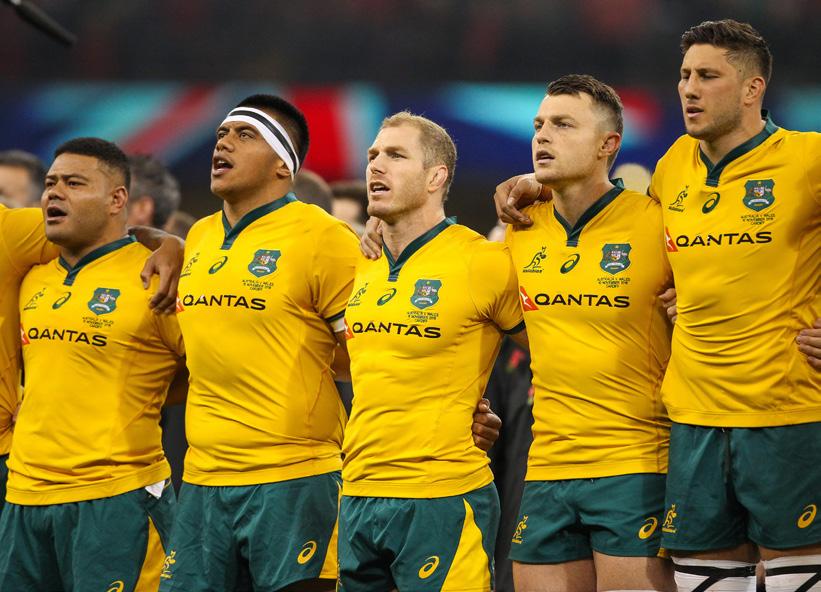
SOURCE 3 In March 2015, former Wallabies captain David Pocock (centre) slammed the use of homophobic slurs by a member of the NSW Waratahs. After the game, Pocock said, "There’s no room for homophobic language in our sport. We want to make it inclusive." He was supported by both Rugby Australia and the Wallabies’ major sponsor, Qantas.
was banned for five years by the Athletics Integrity Unit for attempting to force one of his athletes, Krystsina Tsimanouskaya, to return to Belarus during the Tokyo Olympics after she had criticised Belarusian officials on social media. Fearing for her safety, Tsimanouskaya sought refuge in the Polish embassy in Tokyo. Moisevich's actions were ruled a clear abuse of power and an affront to Tsimanouskaya's dignity.
For the record!
Former Belarusian Olympic coach Yury Moisevich
and wider community. For this reason, these types of ethical issues (and many more) are clearly prohibited or outlawed in sporting codes of conduct, codes of behaviour and contracts. Many sporting associations have dedicated departments, tribunals or teams of people within their organisations to investigate and penalise individuals who are caught in breach of the rules. Examples are the World Anti-Doping Agency (WADA), the International Partnership Against Corruption in Sport (IPACS) and the International Cricket Council’s AntiCorruption Unit (ACU).
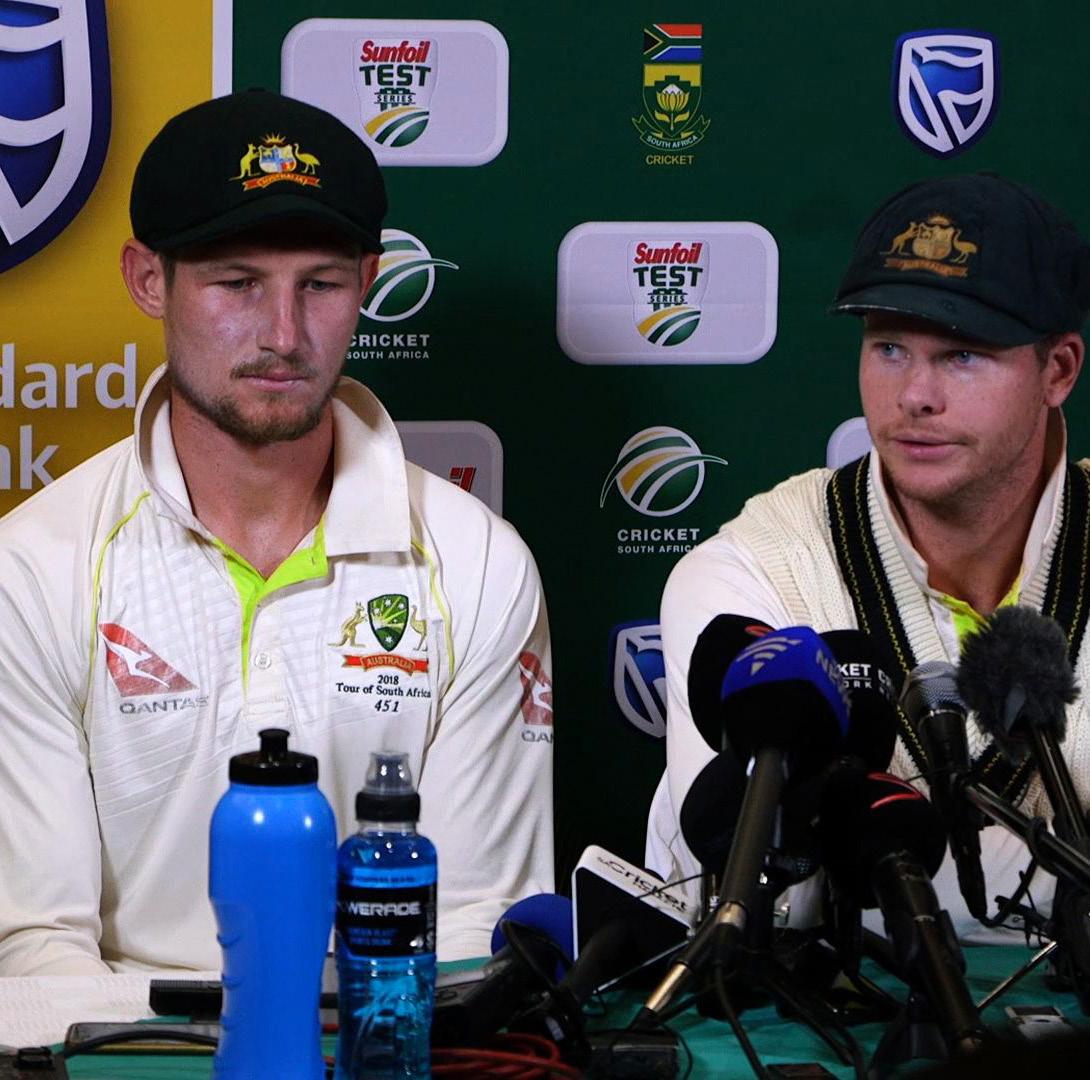
SOURCE 4 In 2018, at a press conference immediately after the ball-tampering plot was revealed, Captain Steve Smith (shown here with teammate Cameron Bancroft) admitted, "My integrity, the team’s integrity, the leadership group’s integrity has come into question and rightly so."
An example of how an ethical issue related to dishonest conduct can result in serious negative consequences at a local, national and international level is the 2018 balltampering scandal that involved members of the Australian cricket team (see 4). In this case, Cameron Bancroft was caught by television cameras trying to rough up one side of the ball with sandpaper to make it swing in flight. As details emerged, captain Steve Smith and vice-captain David Warner were found to be involved and all three players received unprecedented sanctions from Cricket Australia.
How ethics and integrity can affect community confidence and the reputation of sport and physical activity
If the 2018 ball-tampering scandal is evidence of one thing, it’s that the unethical actions of a few can have far-reaching effects on the reputation of a sport – locally, nationally and internationally.
The event was described by countless media outlets as a "national disgrace" and a "day of shame for Australian sport", and it went on to seriously damage community confidence in the sport of cricket. Major sponsors cancelled lucrative deals with Cricket Australia to distance themselves from the fallout of negative publicity. Steve Smith was also dropped as a brand ambassador for Sanitarium Weet-Bix.
All of this was the result of ethical standards not being met and players not acting with integrity. To restore community confidence in the sport, Cricket Australia handed down some of the most severe penalties in its history. It also commissioned an investigation into how it could improve the culture of the organisation and work to prevent unethical behaviour at all levels of cricket.
The International Cricket Council (ICC) also raised its penalty for ball tampering and announced new offences in its Code of Conduct. Along with harsher penalties and new offences, the ICC investigated how Member Boards, such as Cricket Australia and the Board of Control for Cricket in India, can be held liable for the behaviour of their players. All of these moves were designed to rebuild community confidence in the sport and repair damage to its reputation around the world. We will examine this scandal in more detail in Lesson 3.10 The ethical decision-making framework (page 154).

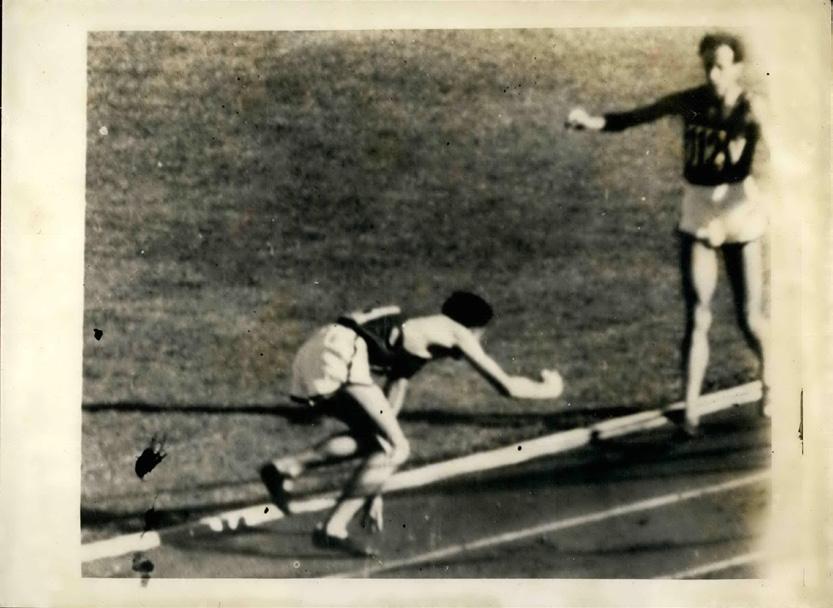
In the news
Australian athletics great John Landy remembered as an “inspiration” Tributes have poured in for legendary Australian athlete and former Victorian governor John Landy, who has died at the age of 91.
...
Landy is most famously remembered for his performance in the mile final at the 1956 Australian championships at Melbourne's Olympic Park.
Both his talent and sportsmanship came into play when during the race a number of athletes fell in the third lap, with future Olympic medallist Ron Clarke among them.
Landy stopped to check if Clarke was uninjured, before deciding to chase down the leaders to win the event.
The performance is often considered one of the greatest moments in Australian sporting folklore and was voted the finest sporting moment of the century at the Sport Australia Hall of Fame Gala in 1999.
ABC News Online, 26 February 2022
Check your learning 3.2
Retrieval and comprehension
1 Read the In the news about Bulldogs player
Josh-Addo-Carr being sacked and choose the best answer from the following options.
Addo-Carr’s club or the NRL can argue that he has acted without integrity because his actions have not:
A promoted community confidence in Rugby League.
B made himself look good.
C been kind.
D acted the same as all of the other players.
2 Choose the most correct answer.
The most serious threats to fair and honest performance include:
A the use of illegal and/or unauthorised performance-enhancing substances.
B the use of unauthorised technological enhancements or equipment.
C dishonest conduct and external influence.
D all of the above.
SOURCE 5 This statue near Olympic Park in Melbourne (A) immortalises one of Australia’s most famous acts of good sportsmanship – when John Landy stopped to help fellow runner Ron Clarke at the 1956 Australian National Mile Championship (B).
3 Identify five tools that sporting clubs and governing bodies use to help ensure players, coaches and other stakeholders behave ethically and in accordance with the rules.
Analytical processes
4 Write a 200-word paragraph to compare the events of the 2018 ball-tampering scandal (Source 4) with John Landy’s actions in the 1956 Australian National Mile Championship (Source 5). In your response, analyse the reaction to each event, making reference to the role of ethics and integrity.
5 Visit the website of your favourite professional sporting team or association and access any
Lesson 3.3
Fair play
Key ideas
Learning intentions and success criteria
fair play following the written and unwritten rules of competition and showing respect, fairness, friendship and tolerance to others (both on and off the field)
Play by the Rules a national organisation that provides support and resources to help all Australians embrace the concept of fair play
available ethical policies, codes of conduct and codes of behaviour.
a Reflect on whether you think the information provided is clear, appropriate and accessible, both as a supporter and as a potential player. (e.g. Are the rules and expectations of players expressed clearly and simply? Are the rules reasonable?)
b Consider whether any improvements could be made to these policies. (e.g. Is anything important missing? Are there clearer/better policies on other teams’ websites? If so, how are they better?)
→ Fair play means following the rules of competition and showing respect, fairness, friendship and tolerance to others (both on and off the field).
→ The elements of fair play include: observing rules; demonstrating appropriate attitudes and behaviours; eliminating forms of exploitation; fair competition and equality; respect; team spirit; and respect for written and unwritten rules.
Defining fair play
Fair play is central to ethics and integrity in sport. In simple terms, fair play can be defined as following the rules of competition and showing respect, fairness, friendship and tolerance to others (both on and off the field).
Fair play is such an important part of ethics and integrity in sport that many of the world’s largest and most influential sporting organisations work hard to help their members develop an understanding of the concept and apply it in all aspects of their lives.
An international organisation dedicated to promoting fair play is the International Fair Play Committee (known as CIFP). Established in 1963, this organisation works with the IOC, UNESCO and other national and international governing bodies of sport.
In Australia, a collaboration between a number of federal, state and territory government organisations (including the Australian Sports Commission and the Australian Human Rights Commission) has resulted in the creation of a national organisation known as Play by the Rules. It provides support and resources to help athletes, family members, coaches, administrators, officials and spectators embrace the concept of fair play (including assisting
them to prevent and deal with discrimination and harassment, protect child safety and promote inclusion and integrity in sport).
The elements of fair play
There are seven main elements of fair play. These are:
• observing rules
• demonstrating appropriate attitudes and behaviours
• eliminating forms of exploitation (e.g. acts of violence, cheating, drug abuse, sledging)
• fair competition and equality
• respect
• team spirit
• respect for written and unwritten rules (e.g. integrity, solidarity, tolerance, care, excellence, joy).
We will now examine each of these elements in more detail.
Observing rules
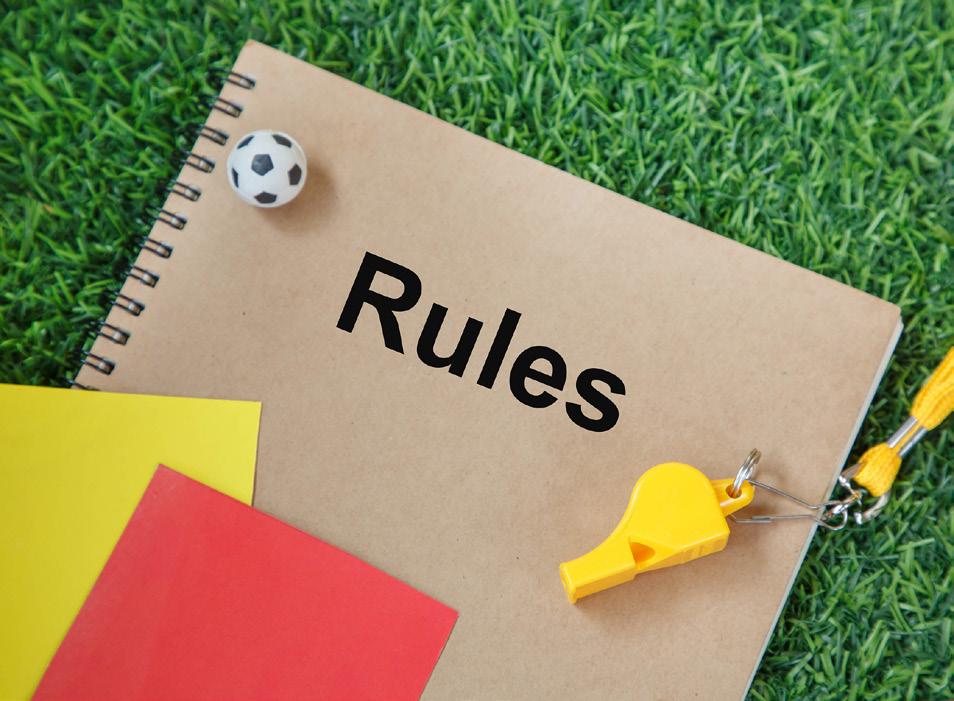
SOURCE 1 Play by the Rules is an Australian organisation that provides information, resources, tools and free online training to increase the ability of administrators, coaches, officials, players, parents and spectators to promote fair play. These posters are available for organisations to download and use for free.
Observing the established rules of any sport or physical activity is one of the most important elements of fair play. If all athletes, family members, coaches, administrators, officials and spectators play by the same rules, everyone involved in sport and physical activity can participate with confidence and a clear understanding of the types of actions and behaviours that are acceptable and those that are not.
Choosing to play outside the established rules of a game changes the nature of that game and usually gives certain individuals an unfair advantage over others. In many sports – such as Australian football, soccer and water polo – rules exist to protect the safety of the players. Imagine, for example, if the rule preventing players from pushing or holding an opponent under water in water polo was not observed and enforced. Not only would the nature of the game change completely, it would probably result in cases of serious injury or even death. When rules are observed and respected, other components of fair play can also be applied.
sledging the practice of making taunting or teasing remarks to an opposing player, especially a batsman, in order to disturb their concentration
Talk about breaking the rules! The 1980 Boston Marathon became a talking point when Rosie Ruiz became the first woman to cross the finish line, in 2 hours, 31 minutes and 56 seconds, in what would have been the third-fastest marathon by a female at the time.
Rosie’s seemingly fresh appearance started to raise suspicions. These were heightened when spotters at certain checkpoints claimed they hadn’t actually seen Rosie run past.
Upon further investigation it was found that Rosie had indeed not run the entire race but, rather, had taken the subway!
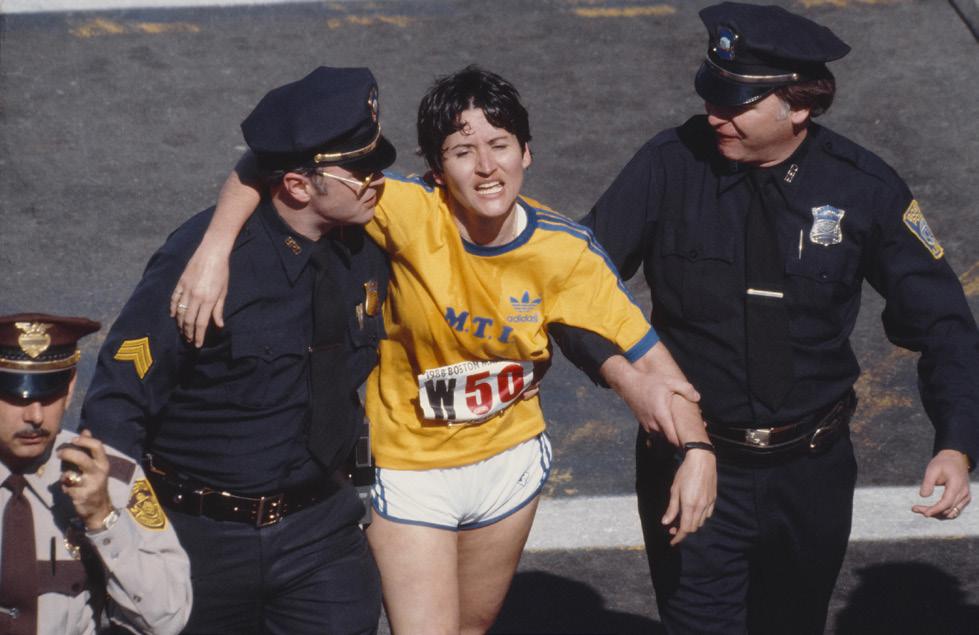
Theory in action The Boston Marathon
SOURCE 2 Rosie Ruiz moments after crossing the finish line, the apparent women’s race winner of the 1980 Boston Marathon. She was later found to have broken the rules and was stripped of her title.
Retrieve it!
Which approach to motor learning is often described as being hierarchical and linear? Check back to Lesson 2.2 Approaches to motor learning and the development of tactical awareness (page 43) to see if you retrieved the information correctly.
Demonstrating appropriate attitudes and behaviours
Demonstrating appropriate and consistent attitudes and behaviours in sport and physical activity is another key element of fair play.
Modelling the appropriate attitudes and behaviours can have a positive impact on the levels of enjoyment of players and ultimately improve the reputation and success of a sport or physical activity. In contrast, modelling inappropriate attitudes and behaviours can have a negative impact on the levels of enjoyment of players and ultimately damage the reputation and success of a sport or physical activity. A range of appropriate and inappropriate attitudes and behaviours are provided in Source 3.
• Following the rules (written and unwritten)
• Showing discipline and commitment
• Behaving honestly
• Promoting team spirit
• Valuing friendship
• Striving for excellence
• Respecting yourself and others
• Accepting and promoting diversity
• Taking safety seriously
• Breaking the rules (written and unwritten)
• Behaving dishonestly (e.g. cheating, match fixing)
• Abusing opponents or acting violently
• Bullying
• Sledging or taunting opponents
• Harassing others
• Doping or using banned substances
• Winning at any cost
• Ignoring safety issues
SOURCE 3 Examples of appropriate and inappropriate attitudes and behaviours that may be displayed in the context of sport and physical activity
Theory in action Cheating or fair play? A sporting moment that divided the world
The 2023 Ashes contest between the Australian and English cricket teams became an international talking point on the topic of fair play and sportsmanship due to differing opinions on the application of a rule.
In short, English batter Jonny Bairstow faced a ball, which went through to the Australian wicketkeeper, Alex Carey. Within a very short time
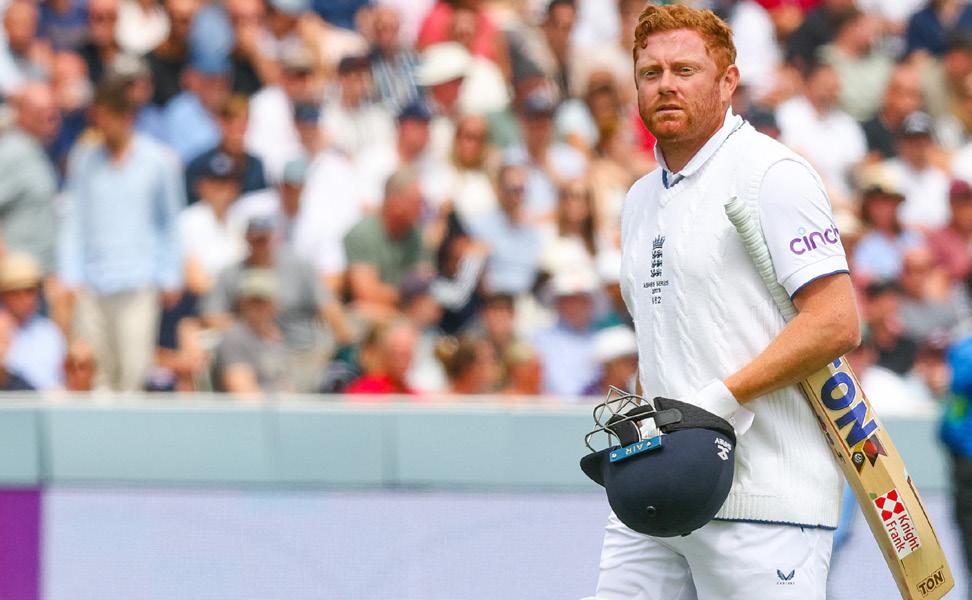
of the ball entering Carey’s gloves, Bairstow walked from his batting crease and Carey threw the ball in, hitting the stumps to successfully take the wicket. Looking flabbergasted, Bairstow left the pitch with the English crowd supporting him via a chorus of boos.
From the Australians' perspective, the wicket was a fair and straightforward dismissal within the laws of the game. From Bairstow’s perspective, the ball had been gloved and therefore was no longer in play. He felt robbed of the wicket. At the end of play, the Australian players left the field to chants of "Aussie, Aussie, Aussie, Cheat, Cheat, Cheat". Media commentary continued for weeks following the event, with opinions divided on what constitutes fair play.
Looking back, the situation perhaps highlights a broader issue of the changing nature of a historical sport in a modern world with an emphasis on winning. While the traditional spirit of cricket emphasises fair play, respect for
SOURCE 4 English cricket player Jonny Bairstow leaves the field after being dismissed by an Alex Carey stumping that had the world in debate over the concept of fair play.
opponents and an honourable approach to the game, the commercialisation of sport has increased expectations of teams and led to competing tensions between stakeholders. The Bairstow stumping ultimately highlights the subjective nature of the "spirit of cricket" and how it can be interpreted
Eliminating forms of exploitation
differently by people. As the sport continues to evolve, it will be important for it to find a way to balance these competing demands and articulate what fair play looks like.
In simple terms, exploitation is the act of treating someone or something unfairly to gain an advantage or benefit. There are many forms of exploitation that have the potential to undermine ethics and integrity in sport and restrict fair play. The most serious threats to achieving fair play in sport include:
• acts of violence, including verbal abuse (i.e. using aggressive language to intentionally cause harm or insult) and physical violence (i.e. intentionally inflicting a physical injury on another person)
• cheating, including dishonest or unfair actions that breach written or unwritten rules or codes of conduct (e.g. accepting bribes, match fixing, breaking the rules of the game, acting dishonestly, taking banned substances, using banned equipment to gain an unfair advantage)
• the use of performance-enhancing drugs, including the use of any illegal or prohibited substance designed to give an athlete an unfair mental or physical advantage. Performance-enhancing drugs (e.g. peptides, anabolic steroids, growth hormones, diuretics) are expressly prohibited in the rules or codes of conduct of all major sports and physical activities.
To uphold the ideals of fair play and protect their ethical reputations, athletes, sporting clubs and governing bodies must work hard to identify instances of these threats and work towards eliminating them.
Fair competition and equality
Fair competition and equality are core elements of fair play.
• Fair competition relies on all athletes and coaches to observe the written and unwritten rules of their sport and comply with codes of conduct and behaviour. If there are disagreements or disputes on the field or breaches of the rules, referees and officials must also apply the rules consistently and without bias
• Equality relies on all athletes being treated fairly (regardless of their personal differences). No athlete should be discriminated against or excluded from any involvement in a physical activity or sport because of their age, race, gender, religion, ability level or sexual orientation.
Overall, competing on equal terms is essential, otherwise performance cannot be measured properly or fairly. Any unfair competition violates the integrity of sport.
exploitation the act of treating someone or something unfairly in order to gain an advantage or benefit fair competition observing the rules of a sport and complying with codes of conduct and behaviour; it relies on referees and officials acting fairly and without bias
equality a concept that relates to having the same status, rights or opportunities; it means striving for fairness and justice by treating people the same (regardless of their personal differences)
bias prejudice for or against a particular person or group (especially in a way that could be considered unfair)

SOURCE 5 Referees play a critical role in maintaining fair competition and equality. They must always endeavour to apply rules consistently and without bias.
respect a feeling of admiration towards a person (or thing) based on their abilities, qualities or achievements
Respect
Respect is another key element of fair play. In simple terms, respect is a feeling of admiration towards a person or thing based on their abilities, qualities or achievements. In a sporting context, showing respect for yourself and others involves:
• following the rules
• accepting and valuing the decisions of others (e.g. coaches or referees) even if you do not agree with them
• valuing the efforts and contributions of all participants.
Another important part of showing respect relates to the actions and behaviour of spectators and supporters. Unfortunately, some spectators verbally abuse and insult players or umpires during performances. This lack of respect for the athletes is in complete opposition to the goals of fair play.
Team spirit
team spirit a term used to describe feelings of pride, loyalty and solidarity shared among the members of a group, enabling them to cooperate and work together as a single unit
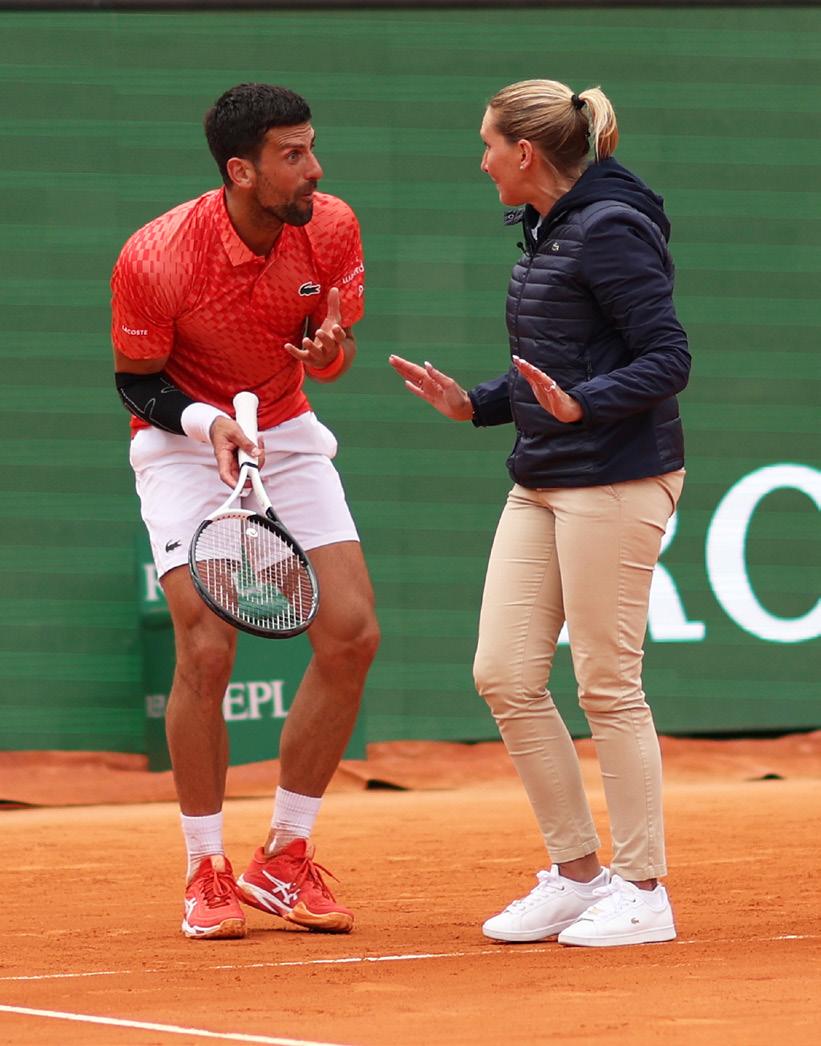
The development of team spirit contributes to fair play when teammates encourage each other to demonstrate respect, push each other to be better and appreciate the joy of sporting contests.
Team spirit can be developed by:
• setting personal and team goals
• discussing and agreeing on shared team values
• setting clear expectations and keeping lines of communication open (including players knowing and accepting their roles)
• participating in team-building activities.
The development of team spirit helps players to understand that, although individuals can be strong on their own, a team is more than the sum of its parts. In addition, sharing a moment of victory with your team is arguably the ultimate pleasure in sport. A team that celebrates the success of younger players, shows support for those who are injured and celebrates individual members for the different roles they play can develop a strong culture that leads to success on and off the field.
Respect for written and unwritten rules
In this lesson, we have discussed the importance of observing the written rules (i.e. the formally documented regulations governing a sport) in some depth. However, if the goals of fair play are to be fully realised, athletes, coaches and officials also need to be mindful of a number of unwritten rules (e.g. a set of expectations, qualities or values that are known and understood by a group but have not been formally documented).
Some of the most common unwritten rules in sport and physical activity are listed here:
• Act with integrity – As we have already learnt, integrity is the quality of being honest
SOURCE 6 Champion tennis player Novak Djokovic argues with an umpire over a line call. Arguing with match officials is considered a sign of disrespect.
and having strong moral principles. Although no rule book will include this as a requirement, it is essential to fair play. Participation in sport within a sound ethical framework is key if you strive to be a true champion.
• Show solidarity – Solidarity is a sense of unity and understanding between people with a shared goal. It includes a willingness to support others to reach a common objective. Solidarity means that healthy rivalry between opponents during competition need not exclude friendship and respect.

• Practise tolerance – Tolerance is a willingness to accept behaviour, decisions, people or things that you may not agree with. Practising tolerance can be challenging, especially during competition as decisions you may not agree with (e.g. referee calls) can be the deciding factor when it comes to winning or losing.
SOURCE 7 Every time influential sporting figures show solidarity, they send a powerful message to young athletes about the spirit of sport.
• Show care – Care involves showing consideration for doing something correctly to avoid damage and risk. It can also mean showing mutual respect for all players as this can bring mutual success on and off the field. True champions care about each other because they know that healthy competition breeds success and drives each competitor to be their best.
• Strive for excellence – The quest for excellence is one of the things that drives every sporting champion. When the motivation and desire to be an outstanding athlete comes from a range of sources, both intrinsic and extrinsic, athletes often embody the spirit of excellence.
• Experience joy – Experiencing the joy and fun that sport and physical activity can bring requires athletes to tap into the feelings of happiness that made them want to play the sport in the first place, even during the toughest training session or fiercest competition. In many cases, displays of "true sportsmanship" are the result of athletes and teams embodying these unwritten rules (i.e. displaying these characteristics, values and qualities) even when they are not officially required to.
Check your learning 3.3
Check your learning 3.3
Retrieval and comprehension
1 Choose the correct answer.
How many main elements of fair play are there?
A one
B three
C five
D seven
2 Choose the correct answer.
Play by the Rules is a collaboration between a number of government organisations, including the:
A Australian Bureau of Statistics and the Australian Sports Commission.
B Australian Human Rights Commission and the Australian Sports Commission.
C Australian Bureau of Statistics and the Australian Institute of Sport.
D Australian Human Rights Commission and the Australian Institute of Sport.
3 In your own words, explain the difference between fair play and fair competition.
Analytical processes
4 Read Theory in action Cheating or fair play?
A sporting moment that divided the world. In a written response of 150 words, apply the elements of fair play to determine whether you believe Jonny Bairstow’s wicket was a lawful or an unlawful dismissal.
Knowledge utilisation
5 Discuss the following statements with a partner and decide whether you agree or disagree with
each one. Provide reasons to justify your position in each case.
a It’s only cheating if you get caught.
b It’s the referee’s job to catch wrongdoing. The athletes and coaches have no responsibility to follow rules.
c If an umpire makes an incorrect decision, athletes should correct them to ensure the contest is fair and honest.
Developing personal values and ethical behaviours
Key ideas
Learning intentions and success criteria
→ Personal values are the principles, standards of behaviour and qualities that every person relies on to help them guide how they live their life. When it comes to sport and physical activity, a number of different factors can influence the development of someone’s personal values.
Retrieve it!
When analysing your performance, particularly your ability to recognise the opportunities for action and the appropriateness of your response, which of the principles of decision-making are you using? Check back to Lesson 2.5 Decision-making in the dynamic systems approach to motor learning (page 63) to see if you retrieved the information correctly.
Defining personal values
Personal values are the principles, standards of behaviour and qualities that guide every person in how they live their life. Every decision you make – in your personal life, at school or during sport – is influenced to some extent by your personal values. In short, personal values reflect the things we care about most in life.
Some of your personal values may change over the course of your life – as you get older or as your personal situation changes – while others will remain constant.
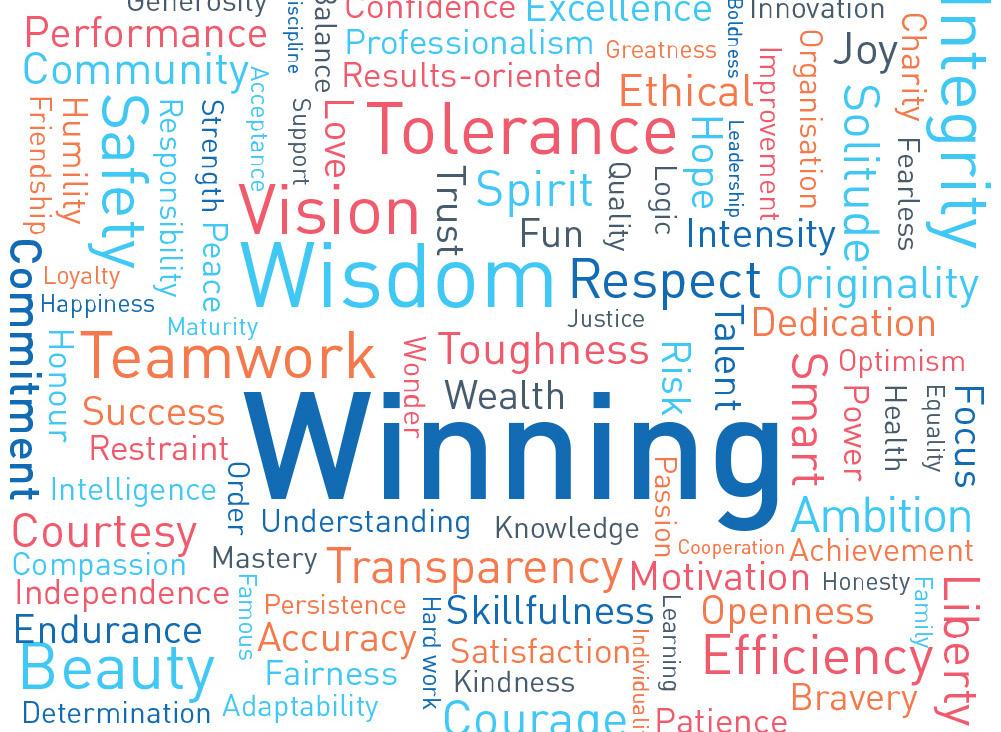
SOURCE 1 A selection of personal values
It is important that you are aware of your own personal values, as they will provide you with primary data for this unit. Source 1 lists around 50 personal values. Look carefully at these values and try to identify those you feel best describe you personally, or that you aspire to. This should help you to determine and articulate your personal values.
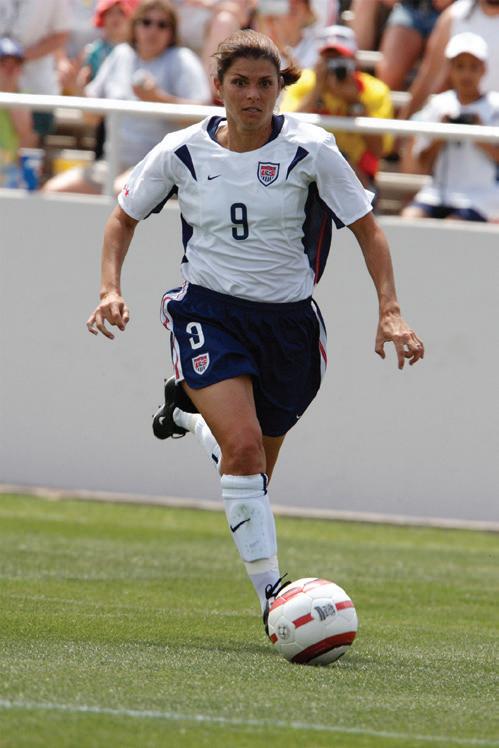
‘Somewhere behind the athlete you’ve become – and the hours of practice and the coaches who have pushed you – is a little girl who fell in love with the game and never looked back ... play for her.’
Mia Hamm
SOURCE 2 American soccer legend Mia Hamm made her debut for the USA national team when she was 15 and quickly became the face of women’s soccer. In 2012, ESPN named Hamm the best female athlete of the last 40 years. Despite all this, Hamm never lost sight of her personal values and reasons for playing the game.
Factors influencing the development of personal values
When it comes to sport and physical activity, a number of different factors can influence the development of someone’s personal values. The most common factors are:
• family – members of your immediate and extended family (e.g. parents or guardians, siblings, aunties and uncles, cousins, grandparents)
• peers – friends and others of a similar age
• coaches – instructors, mentors and training staff at your sporting club
• school and community – teachers, administrators, sponsors and community groups.
As a whole, these groups of people are referred to as agents of socialisation. They are the people in our lives who teach us how to act and behave in society. Along the way, these people also play a significant role in the development of our personal values.
We will now look at each of these factors in more detail.
Family
Family has a significant impact on the development of personal values relating to sport and physical activity. Parents can pass on attitudes and values relating to sport and physical activity in general, or to particular sports and physical activities. Either way, these influences can have a lifelong impact on the development of a child’s personal attitudes and values regarding sport.

In many cases, the personal values of a parent will have a direct influence on the development of the personal values of their children – this is also true for siblings and members of the extended family. This influence affects not only the types of sports and physical activities that children are interested in watching and participating in, but also the way in which they behave while they are participating (e.g. how they act during training and competition).
SOURCE 3 Family members (such as parents, guardians and siblings) have the most significant impact on the development of personal values relating to sport and physical activity. The values of fun, togetherness, respect and responsibility can all develop as a result of participating in physical activities with family.
agents of socialisation the people in our lives from whom we learn the types of behaviours and values that are expected of us in society (e.g. parents and guardians, siblings, friends, teachers and coaches)
Retrieve it!
List three common unwritten rules in sport and physical activity around the concept of fair play. Check back to Lesson 3.3 Fair play (page 112) to see if you retrieved the information correctly.
Different families will place different levels of emphasis on what they see as the most important personal values of sport and physical activity. For example, one family may value winning competitions as the most important aspect of sport and physical activity, while another may value the social aspect of sport (e.g. teamwork, friendship, fun) and yet another may value the hard work and dedication of training as the most important aspect. As a result, children growing up in each of these three families will likely develop very different personal values relating to sport.
Peers
After family, a person’s peers (i.e. friends and people their own age) are generally the most influential when it comes to the development of personal values in sport. In fact, research shows that, as children get older, the influence of family members decreases and the influence of close friends becomes more important.
When we interact with our peers, we learn explicitly and implicitly about values and behaviours that are seen as acceptable or unacceptable. Many children and adolescents are also influenced by the desire to "fit in" and “belong” to a peer group. As a result, peers can not only influence the way a person behaves during sport but also their personal values around sport. For example, if members of a person’s friendship or peer group display negative values and behaviours (e.g. bullying or teasing), this may cause the person to tolerate or even take part in similar behaviour. On the other hand, peers who demonstrate strong leadership qualities and ethics can have a positive influence on teammates’ behaviours and values on and off the field.
Coaches
Coaches can play a significant role in the development of a person’s personal values around sport and physical activity. Coaches can model positive or negative values and behaviours. For example, you may have been exposed to a junior coach who valued winning over having fun, which might have influenced your thinking and personal values about the goal of sport and encouraged you to think about your values more deeply. Coaches who model positive values such as respect – for players, opponents, spectators and officials – or who value and reward effort over results can create an environment where players develop positive personal values.
School
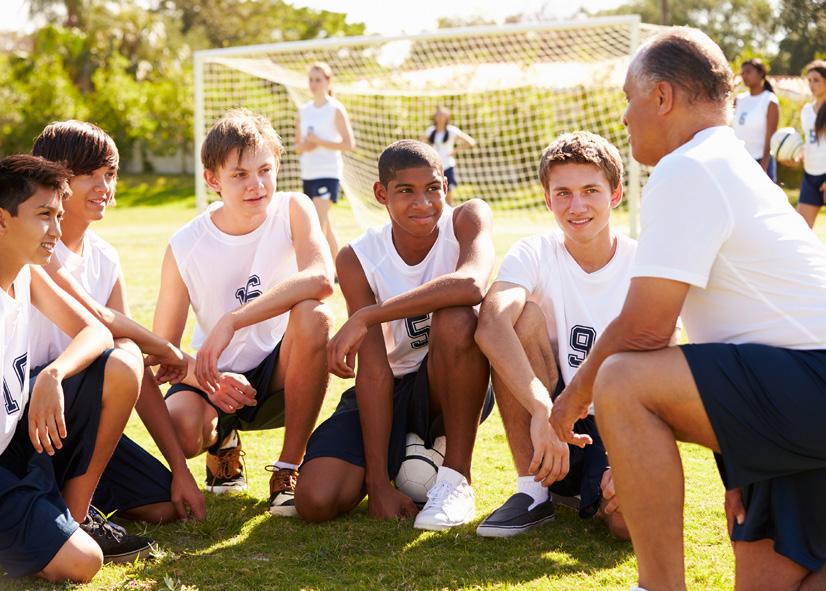
For many young people, school provides their first or only exposure to recreational or competitive physical activity. While a school’s curriculum plays a role in shaping attitudes to physical activity, it is teachers who will ultimately influence the personal values that students develop. Teachers have the opportunity to motivate students, teach physical and social skills, and provide new experiences that can lead to a lifelong relationship with sport and physical activity.
SOURCE 4 Coaches can model positive or negative values and behaviours.
In the same way that families influence personal values and attitudes to sport, so too do different teachers. Some may value winning and talent over anything else, while others may value the lifelong health benefits that sport can bring. Either way, when teachers have a passion for sport, they use their expertise, enthusiasm and commitment to give students positive experiences and support them to develop positive values.
Community
A person’s personal values are also influenced by the community in which they live. Generally speaking, a community includes the people that live in your local area. It may include family friends, local business owners, members of different sporting teams and clubs, and so on. Although you may not realise it directly, the values of all of these people have an influence on the development of your personal values about sport and physical activity. For example, your sporting club may be sponsored by one or more local businesses. Over time, it’s likely that the values of the people who own and operate these businesses will have some influence on the values of your club and therefore your personal values too.
In addition to the people in your local area, the term "community" can also be used to refer to people who live in your region, state or country. For example, at a national level, organisations such as the Australian Sports Commission and Sport Integrity Australia provide guidance, education and training for all members of the sporting community to keep sport fair and safe and encourage the development of core values (e.g. fairness, respect, responsibility, safety). The following are two of their initiatives:
1 The Australian Sports Commission introduced the Sport Governance Principles in 2020 to help sporting organisations deliver more positive sport experiences for all, more regularly. Principle 8 is titled "The best and fairest" and encourages all organisations to have measures and protocols to ensure integrity of their sport and safeguard its participants.
2 Sport Integrity Australia has launched the Safeguarding in Sport Continuous Improvement Plan (SISCIP) as it believes that all Australians should feel safe and welcome to participate in sport at any level. The program aims to embed a culture of child safety and member protection by:
– building the capability of National Sporting Organisations (NSOs) and National Sporting Organisations for People with a Disability (NSODs) to keep children, young people, and members safe
– leading a cultural shift that prioritises the safety of children, young people and members
– enhancing knowledge and understanding to respond to child abuse threats
– bolstering community confidence that sports are safe for children, young people and members
– enabling sports to demonstrate their commitment and leadership in safeguarding to all members at all levels of sport.
Such initiatives can be powerful shapers of broader community values.
Finally, as a result of globalisation, it’s arguable that we’re all members of a global community. This means that, on some level, our personal values are shaped and influenced by people, events and media external to Australia.
globalisation a term used to describe the increasing interconnection and interdependence of countries around the world (on a range of economic, cultural, political and environmental issues)
Check your learning 3.4
Check your learning 3.4
Retrieval and comprehension
1 Choose the correct answer to complete this sentence.
"When we interact with our peers, we learn explicitly and implicitly about ___________________ that are seen as acceptable or unacceptable."
A morals and ethics
B approaches to sport
C performance-enhancing activities
D values and behaviours
2 Choose the correct answer.
Building the capability of National Sporting Organisations (NSOs) and National Sporting Organisations for People with a Disability (NSODs) to keep children, young people and members safe is an initiative of which organisation?
A Australian Integrity Commission
B Australian Sports Commission
C Sport Integrity Australia
D Sport Australia
3 In your own words, define the term "personal values".
Analytical processes
4 Look carefully at Source 1 and use the table below to complete the following tasks.
a In column A, select and record five personal values that you feel best describe you (or are most important to you) in relation to sport and physical activity.
b In column B, explain your reasons for selecting each one.
c In column C, identify the factor (i.e. family, peers, coaches, school or community) that has had the biggest influence on the development of this personal value.
Knowledge utilisation
5 Look at Mia Hamm’s statement in Source 2.
a Discuss Hamm’s statement in relation to her personal values and justify whether you believe this view is relevant for all elite sportspeople.
b Devise a strategy that your own sporting club or team could use to help players remember the joy of their first games.
Lesson 3.5 Determine your personal values and ethical behaviours in physical activities
Aim
To determine your personal values and analyse how consistently you can implement them in a physical activity setting.
Time
1 lesson (i.e. 60 minutes) with additional time (if required) to complete analysis and discussion tasks.
Equipment
• Four hula hoops
• 32 balls
• Game Performance Assessment Instrument 4 (GPAI 4)
• Bibs or sashes in four colours
• Clipboard
• Pen
Game Performance Assessment Instrument 4 (GPAI 4)
Note to teachers
Detailed rules and instructions for playing a game known as "Rob the nest" are provided for teachers to download. Please read these carefully before completing this Skill drill.
Method
Step 1
As a group, discuss the importance of fair play in sport (i.e. observing rules; demonstrating appropriate attitudes and behaviours; eliminating forms of
exploitation; fair competition and equality; respect; team spirit; respect for written and unwritten rules).
Now, using Source 1, identify five personal values you wish to demonstrate through your involvement in physical activity. Record these values in the first column of GPAI 4 under "Personal values".
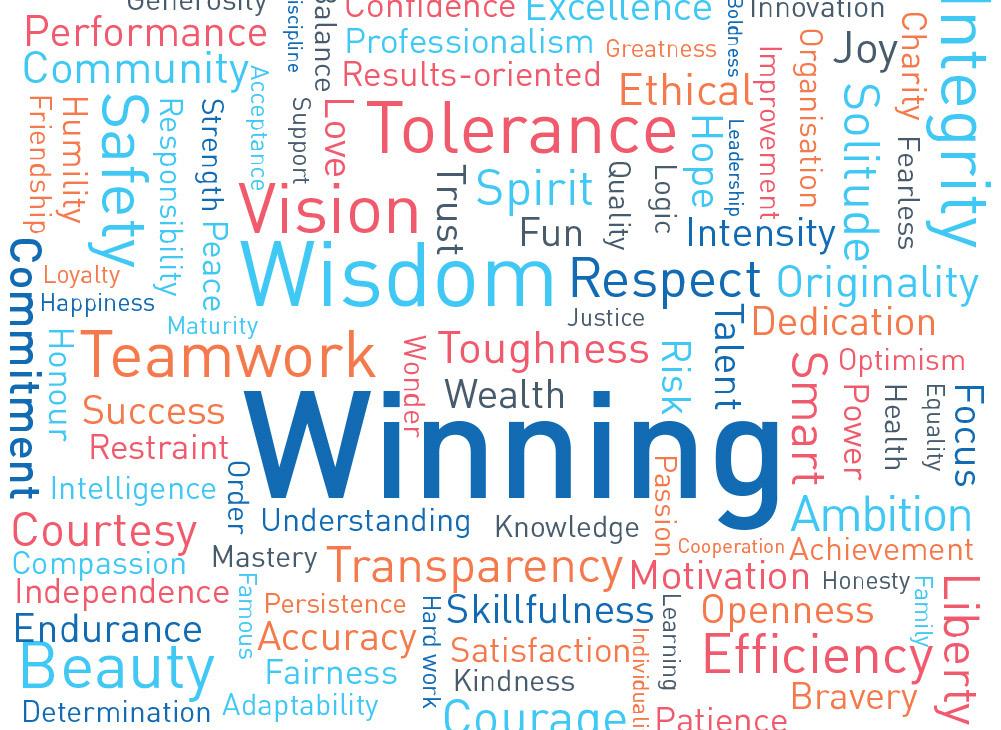
SOURCE 1 A selection of personal values
Step 2
Now form four teams of equal size and participate in a teacher-led warm-up.
Step 3
Your teacher will now explain the rules of the game "Rob the nest". Participate in a game of "Rob the nest" for 5 minutes (Game 1).
Step 4
At the end of play, use the four-point scale in the column titled "Game 1" to score how often you think you displayed each of your values.
Note to teachers
A range of possible rule modifications for "Rob the nest" are provided for download. Please refer to these prior to completing Games 2 and 3.
Step 5
Your teacher will now make a modification to the rules of the game. Record the rule modification in the column titled "Game 2". Participate in a game of "Rob the nest" for 5 minutes (Game 2) following the new rule.
Step 6
At the end of play, use the four-point scale in the column titled "Game 2" to score how often you think you displayed each of your values.
Step 7
Your teacher will now make another modification to the rules of the game. Record the rule modification
in the column titled "Game 3". Participate in a game of "Rob the nest" for 5 minutes (Game 3) following the new rule.
Step 8
At the end of play, use the four-point scale in the column titled "Game 3" to score how often you think you displayed each of your values.
Step 9
Discuss your personal values and scores as a class. For example:
• What were you willing to do (or not do) to win/be competitive/have fun?
• To what extent did your personal values influence your decisions in each game?
SOURCE 2 GPAI 4
Analysis and discussion tasks
1 Collecting and analysing primary data about your performance will provide insights into how often you displayed your personal values under different playing conditions. Analyse the data in GPAI 4 to complete the following tasks.
a Identify the personal value that you most often displayed across all three games. Provide reasons why this was the case.
b Identify the personal value that was most affected (either positively or negatively) by the rule modifications in Games 2 and 3. Discuss possible reasons for this.
c Reflect on how well you were able to display your values in a competitive game setting. Consider whether you would select the same five personal values if you were to repeat this activity – provide reasons and examples to support your response.
d Based on your experiences, design a code of conduct for your class that you think would have a positive influence on fair play and integrity for future games of "Rob the nest".
2 Discuss how your personal values influence your general understanding of fair play and integrity.
3 Explain who has shaped or influenced your personal values. Consider agents of socialisation (i.e. peers, family, coaches, school or community) in your response.
Lesson 3.6
The influence of ethical values and ethics strategies on fair play and integrity
Key ideas
→ Ethical values is a term used to describe a specific group of principles, characteristics or standards of behaviour that most people in a community or society would associate with ethical behaviour.
→ Ethic strategies are any plans of action created with the goal of promoting ethical values, ethical behaviours and fair play. More often than not, ethical strategies include a number of tools designed to help the strategy succeed. These tools include things such as:
– codes of behaviour and codes of conduct
– rules and policies (including risk management).
Defining ethical values
Ethical values is a term used to describe a specific group of principles, characteristics or standards of behaviours that most people in a community or society would associate with ethical behaviour.
Unlike personal values, which can differ based on what different people consider to be important to them, ethical values are a more clearly identified group of values that are prized (i.e. highly regarded and valued) by the members of a society. Although they are not always written down, and can change over time, the ethical values of a society are generally communicated and agreed on by its members through:
• laws
• political and public debates
• the policies and actions of public institutions (e.g. schools, police)
• official reports and campaigns produced by government agencies
• information presented in the media.
In Australian society, examples of ethical values include:
• equality of opportunity for individuals (i.e. regardless of their age, sex, race, religion, ethnic background or sexual orientation)
• respect for the freedom and dignity of the individual and a "fair go" for all
• respect for the rule of law
• tolerance, fair play and compassion for those in need.
Learning intentions and success criteria
ethical values a term used to describe a specific group of principles, characteristics or standards of behaviour that most people in a community or society would associate with ethical behaviour

SOURCE 1 Shared Australian values include equality of opportunity for individuals, regardless of their age, sex, race, religion, ethnic background or sexual orientation.
ethics strategies any plans of action created with the goal of promoting ethical values, ethical behaviours and fair play risk management the identification, assessment and implementation of control measures designed to reduce or remove potential hazards to safety and wellbeing
Defining ethics strategies
By comparison, ethics strategies are any plans of action created with the goal of promoting ethical values, ethical behaviours and fair play. More often than not, ethics strategies include a number of tools designed to help the strategy succeed. These tools include things such as:
• codes of behaviour and codes of conduct
• rules and policies (including risk management).
We will now examine each of these tools in more detail.
Codes of conduct and codes of behaviour
Codes of conduct and codes of behaviour are two of the most common and reliable ways in which sporting clubs and organisations implement ethics strategies.
You have probably heard both terms used interchangeably in general conversation. Although they are very similar, there are a few technical differences between them. As discussed earlier in this module:
• Codes of conduct are formal documents that outline the principles, standards and rules of a particular sport, team or organisation (and describe the possible penalties and sanctions for breaches of these rules).
• Codes of behaviour are documents that set out the expected standards of behaviour for members of a particular group, team or organisation (and describe the possible penalties and sanctions for breaches). They generally have a focus on the expected behaviours for members who publicly represent the team during training, competitions or clubsanctioned activities (e.g. players, coaches, administrative staff).
Source 2 examines some key differences between the two codes and provides examples to illustrate them.
Retrieve it!
The theory of perception–action coupling falls under which broad model of learning? Check back to Lesson 2.3 The dynamic systems approach and ecological models of learning (page 50) to see if you retrieved the information correctly.
Defines the particular principles, standards and rules.
Contributes to the overall character or culture of a person, team or organisation. Sets and communicates values.
Defines expected standards of behaviour in specific situations or points in time.
Example: Show respect for yourself, your teammates, o cials and your opponents and their skills. Outlines acceptable and unacceptable behaviours and attitudes.
Example: Shake hands with your opponent at the beginning and end of each game; thank the umpires and o cials at the end of the game.
SOURCE 2 Despite their differences, codes of conduct and codes of behaviour are both tools designed to achieve ethics strategies.
Codes of conduct and codes of behaviour can both support and encourage people involved in a range of different sports and physical activities to:
• understand the official rules and become familiar with the penalties or sanctions for breaches of these rules
• understand the minimum standards of conduct and behaviours expected of them
Code of behaviour
Code of conduct
• recognise and promote ethical behaviour
• resolve conflicts with transparency and fairness (i.e. through application of the codes)
• communicate and promote the ethical values of the sport to all stakeholders (i.e. participants, coaches, officials, members and the wider community).
Rules and policies (including risk management)
Another tool that sporting clubs, facilities and other organisations use to help implement ethics strategies and encourage fair play is a clearly structured set of rules and policies. These rules and policies are generally agreed upon by the officials and administrators of a club in consultation with its members, sponsors and investors. Rules and policies can govern a whole range of different matters, both general and specific, including:
• membership conditions, registration requirements, fees and payments
• the expected behaviour of members and guests (e.g. sideline behaviour, on- and off-field)
• technical aspects of the game
• the safe use of equipment and facilities
• safety and security issues relating to club facilities (e.g. emergency evacuation procedures, incident and first aid management)
• team selection guidelines
• uniform policies
• inclusion
• governance and management
• doping
• corruption
• child protection
• social media
• data protection and privacy.
Each of these policies can be used to help clubs implement ethics strategies to support fair play and integrity. Many of the rules and policies that are common across clubs are a requirement of state or federal law or are a requirement that clubs need to enforce in order to receive government funding through the Australian Sports Commission. Consistent ethical governance of resources, facilities and sport infrastructure is important as it can support equal opportunities for all Australians to engage in physical activity and sport. In 2021, Sports Integrity Australia launched the National Integrity Framework to protect the integrity of sport, safeguard participants and enhance the reputation of Australian sport. As part of this framework, policy templates have been developed in consultation with sport sector partners to protect sports against integrity threats. For the first time, there is consistency in the policies being developed across all sports.
Theory in action Protecting players from abuse in Queensland school sport
An ethics strategy can comprise multiple components working together to promote ethical values, ethical behaviours and fair play. For the ethical dilemma of verbal and physical abuse, various legislative frameworks and policies contribute to keeping athletes safe in Queensland School Sport.
These include:
• childcare protection legislation:
– Child Protection Act 1999 (Qld) – this legislation outlines the responsibilities of adults to protect children from harm, including abuse, neglect and exploitation
– Education (General Provisions) Act 2006 (Qld) – this act outlines the responsibilities of schools to provide a safe and supportive learning environment for all students, including those involved in sport
• sporting organisations' policies and procedures:
– Queensland Representative School Sport –this organisation has codes of conduct, child protection policies and reporting procedures in place to protect student athletes
Risk management
– individual sports associations – each institution has its own policies and procedures which, in addition to codes of conduct and child protection policies, can include background checks for coaches and officials, mandatory reporting requirements, and compulsory training in child protection and safeguarding athletes
– Sport Integrity Australia’s National Integrity Framework – a set of rules that all members of a sport must follow to guide behaviour and conduct in sport, keeping athletes safe.
Risk management is an important sub-section of many sporting clubs’ rules and policies. It involves the identification, assessment and implementation of control measures designed to reduce or remove potential hazards to safety and wellbeing. Risk assessments are important as they enable potential hazards to be identified so that control measures and safety requirements can be implemented.

SOURCE 3 Sport can be inherently dangerous, which is why sporting organisations must constantly identify and mitigate known risks to reduce harm to players.
For example, state and federal laws require sport and physical activity providers to promote and protect the safety and wellbeing of children and young people. Risk management strategies related to child protection in schools and clubs includes developing codes of conduct for teachers, coaches and volunteers, and ensuring that all employees are properly qualified for their roles and hold relevant Working with Children Checks.
Theory in action Giving Australians the right to be safe while participating in sport
In 2024, the Australian Government announced it would increase the safety of sport in Australia by investing more than $36.3 million dollars from 2023–24 to 2027–28 to tackle abuse, bullying, discrimination and sexual misconduct. The funding, to be provided to Sport Integrity Australia (SIA), will enhance the organisation’s capacity to put several initiatives in place, including:
• empowering women and girls – a new program to prioritise the safety and integrity of female athletes
• empowerment of First Nations peoples – a new skills program to address disparities in First Nations peoples' participation and administration in sport
• combating racism – a new advisory committee to support efforts to address racism in sport
• strengthening safety and wellbeing – enhancing the Safe Sport Hotline and support services to provide better support for athletes and staffculturally sensitive education – expanding Sport Integrity Australia’s education programs to be more inclusive and sensitive to diverse cultural needs.

SOURCE 4 Sport Integrity Australia, along with the Australian Sports Commission, is a government agency responsible for supporting and investing in sport at all levels and promoting ethical governance, integrity and fair play.
What the research says
As has been discussed in this lesson, codes of conduct are one strategy that sporting organisations use to address and prevent the numerous ethical dilemmas that can arise at all levels of sport. A 2016 study by Els De Waegeneer, Jeroen Van De Sompele and Annick Willem analysed ethical codes in six sports to understand the impact they had on ethical climate. The study found that codes emphasising integrity, solidarity and consequentialist reasoning (i.e. judging whether or not something is right by what its consequences are) were more effective in promoting ethical behaviour. As well, the inclusion of explicit guidelines for governing members of these sports were found to promote ethical behaviour. The study found that simply providing rules and regulations may not be sufficient to deter unethical behaviour.
In summary, ethical codes or ethics strategies should be concise, with a combination of regulatory and inspirational statements if they are to motivate individuals to act ethically.
Source: De Waegeneer, E., Van De Sompele, J., & Willem, A., 2016, "Ethical codes in sports organizations: Classification framework, content analysis, and the influence of content on code effectiveness" in Journal of Business Ethics, 136(3), pp. 587–98. doi:https://doi.org/10.1007/s10551-014-2531-y
Ethics strategies in class, school and community sport
Strategies to promote and support ethical behaviour and fair play can be implemented at all levels of sport. Ethics strategies can range in their scale and significance. For example, when a teacher ensures that all students have had a turn to bat during a Health and Physical Education (HPE) lesson, they are implementing an ethics strategy, as is the government when it introduces a national policy to improve individuals' rights in sport.
Retrieve it!
What two types of ethical codes can promote ethical values, behaviours and fair play? Read back through this lesson to see if you retrieved the information correctly.
There are many examples of ethics strategies; four of these are listed below:
• An education and awareness ethics strategy aims to:
– develop and enforce a clear code of conduct for all participants in school and community sports programs, including students, teachers, coaches, and parents
– implement educational programs within Health and Physical Education lessons to teach students about fair play, sportsmanship and the importance of ethical behaviour in sports
– encourage teachers and coaches to model positive behaviour and ethical decisionmaking during Physical Education classes and community sports events, and ensure they encourage the same of their students.
• Fair play initiatives aim to:
– promote a culture of respect for opponents, referees and teammates in school sports teams and community leagues
– encourage students to make ethical decisions during games and physical education activities, even when faced with the pressure to win
– educate students about the dangers of performance-enhancing substances and the importance of clean sport through Health and Physical Education curriculum
– investigate and provide funding or support to make engagement more equitable.
• Effective leadership aims to:
– ensure strong leadership and governance within school sports departments and community sports organisations
– implement transparent decision-making processes and accountability measures in school sports programs and community leagues
– establish independent bodies to monitor and enforce ethical standards in school and community sports activities.
SOURCE 5 When devising an ethics strategy, it is essential that all relevant stakeholders are identified and that their needs are carefully considered. This diagram is an example of a stakeholder wheel for a generic business.
• Strategies to ensure a safe and inclusive environment aim to:
– implement robust child protection policies to safeguard young athletes in school sports and community sports programs
– promote inclusivity and diversity in class, school and community sportsprovide resources and support for students' mental health and wellbeing through health education and school counseling services.
When devising an ethics strategy, it is essential that all stakeholders are considered. A stakeholder is a person, group or company that is involved and has an interest in the actions and outcomes related to the situation. For example, the stakeholders of an athletics club could be the athletes, coaches, parents/guardians, club officials, volunteers, sponsors, local community, governing athletics body and the media. Considering the stakeholders' needs helps to inform the development of an ethics strategy and increase its likelihood of achieving the desired outcomes. Source 5 suggests those stakeholders that might be considered when formulating an ethics strategy.
Check your learning 3.6
stakeholder a person (or group of people) who has an interest, connection, concern or investment in something (e.g. stakeholders in a sporting team may include the players, coaching staff, administrative staff, members, spectators, sponsors and investors) Check your learning 3.6
Retrieval and comphrehension
1 Choose the most correct answer.
Rules and policies in sport can govern:
A team selection guidelines.
B uniform policies.
C inclusion.
D all of the above.
2 Choose the correct answer.
An ethics strategy is:
A any plan of action created with the goal of promoting ethical values, ethical behaviours and fair play.
B a code of behaviour and a code of conduct.
C a set of stakeholder guidelines.
D a set of rules that explain how sport should be governed and resourced.
3 Explain the difference between a code of conduct and a code of behaviour.
Apply and analyse
4 This lesson has provided four examples of ethics strategies that apply to class, school and
community sport (education and awareness; fair play initiatives; effective leaderhip; safe and inclusive environment).
List three more of your own examples and for each one, state who the stakeholders might be.
a The Queensland Department of Education is responsible for producing the Queensland Representative School Sport Code of Conduct. A link to the code is provided. Read the code online and complete the following tasks.
b Categorise each of the requirements of the code based on whether they relate to:
Rules of the game
Individual and/or team behaviour
Other (e.g. safety)
c Identify the elements of the code that are directly linked to the concepts of fair play and integrity. Provide reasons to support your decisions.
Weblink: Queensland Representative School Sport Code of Conduct
Learning intentions and success criteria
Lesson 3.7
The influence of globalisation and mass media coverage on ethical values and behaviours
Key ideas
→ Globalisation in sport is the process by which sporting organisations (e.g. clubs, teams, sporting codes) begin to operate on an international scale and/or develop international influence (i.e. financial, social, cultural).
→ Mass media is a term used to describe a collection of technologies that are used to communicate messages to very large numbers of people.
Defining globalisation
In simple terms, globalisation is a process that results in the economies, societies and cultures of different regions and nations becoming more integrated and interconnected (i.e. connected and reliant on each other). Although different countries traded with each other and people travelled between these countries in the past, the world’s economies, societies and cultures mostly remained separate and independent. However, we are increasingly part of a global economy and the different aspects and traditions of the world’s societies and cultures are blending and integrating to create a global society.
Globalisation is largely the result of a number of important factors. These include:
• improvements in transportation – people and goods can now move around the world more quickly and in larger numbers than ever before
• advances in technology – the internet, mobile technology and artificial intelligence (AI) have allowed greater communication between people in different countries, bringing them closer together
• reductions in trade regulations and tariffs –agreements between a large number of nations and global organisations (e.g. the World Trade Organization) have resulted in free trade agreements that remove taxes and create a global marketplace

Retrieve it!
A membership agreement is one example of an ethics strategy. What is another? Check back to Lesson 3.2 Ethics and integrity in sport and physical activity (page 106) to see if you retrieved the information correctly.
• increased access to labour and skills – agreements between nations have resulted in huge numbers of people moving around the world for work. Organisations can also now access labour more cheaply and competitively from a range of countries.
Globalisation in sport
When it comes to sport and physical activity, globalisation can be defined as the process by which sporting organisations (e.g. clubs, teams, codes) begin to operate on an international scale and/or develop international influence (i.e. financial, social, cultural). We will now explore some of the ways in which the globalisation of sport and physical activity has influenced ethical values and behaviours.
SOURCE 1 Sport connects and unites people all over the world.
The influence of globalisation on ethical values and behaviours
Sport has a unique ability to unite people all over the world. In this way, it is a kind of universal language that connects people. As more and more sporting events begin to take place on a global scale – in a similar way to the Olympic Games and the FIFA World Cup – sport becomes a global commodity that is traded on financial markets. This can have a number of influences on the ethical values and behaviours of particular sports.
The financial issues resulting from globalisation of sport
One of the most observable results of the globalisation of sport is the increased financial value of many sporting clubs and codes. The impact that the Netflix documentary Drive to Survive has had on Formula 1 car racing is a good example. Since the show was launched in March 2019, it has increased the sport's global reach in the following ways:
• Its market has expanded. Viewership in the United States of America grew from approximately 250,000 viewers in 2019 to 1.2 million in 2023.
• The sport's fanbase increased from the mid-400 millions to 500 million by 2022.
• Female viewership increased by nearly 10 per cent between 2019 and 2022.
• Formula 1’s revenue grew from $2.1 billion in 2019 to approximately $2.7 billion in 2023.
• The sport’s social media following grew by over 40 per cent in 2021 alone. This is just one astounding example of the impact of globalisation on sports.

Globalisation can increase earnings from a variety of sources:
• gate receipts (i.e. ticket sales and attendance at games)
• sponsorship (i.e. deals with businesses who provide financial support in return for opportunities to promote their brands or products)
• media rights (i.e. deals with various media companies to broadcast games)
• merchandising (i.e. the sale of official club products and services such as branded items of clothing, bags and memorabilia).
Although these financial benefits can be seen as a positive effect of globalisation, they also have the potential to bring many negative effects. When the potential financial benefits for players, clubs and governing bodies are so great, the motivation to ignore ethical values and behave in unethical ways increases dramatically. Examples of this include:
• individual athletes acting unethically or breaching codes of conduct to gain unfair advantage
SOURCE 2 The Netflix documentary Drive to Survive had a significant impact on the popularity of Formula 1. It is shown all over the world, including in Sweden, as this picture shows.
multinational a term used to describe a club, company or organisation that operates in many different countries
In the news
Why
Bahrain
Amos Robi
• sporting clubs or organisations compromising their ethical values to comply with the wishes or demands of major sponsors, or accepting sponsors that do not align with their values (e.g. sponsorship deals with alcohol and tobacco companies)
• officials breaching codes of conduct or engaging in corrupt practices in return for personal financial gain (e.g. money laundering, accepting bribes from government officials or organised crime in return for lucrative club contracts).
Other key issues resulting from the globalisation of sport
In addition to the financial effects of globalisation on sport, there are other broad themes to consider. Each of these presents a number of benefits and threats to ethical values and behaviours in sport. They include:
• the increased involvement of global media companies in sport – international media corporations (e.g. ESPN, Sky TV, Fox Sports, Eurosport) have an increasing stake in sport and a vested interest in the decisions made by sporting clubs and organisations. Increased media coverage helps teams to promote their sport and creates revenue, which can be used to increase participation, promote ethical values and engage in partnerships with community groups and charities. However, in return for broadcast rights, media companies make demands on officials to change certain aspects of their sport for the benefit of their advertisers and shareholders, such as dictating season dates and playing times
• the free movement of people and labour – globalisation has enabled talented athletes from all over the world to travel and access better coaching and training facilities, equipment and support services in their chosen sport. Athletes from some of the world’s poorest countries have been given the opportunity to play with some of the world’s best clubs or compete for their nation in the Olympic Games. This movement has clear benefits, but also presents many ethical challenges. For example, when developing countries such as Kenya invest heavily in programs and infrastructure to train local athletes and promote the sport of athletics, and then those athletes leave to take positions in teams overseas, the local economy and reputation of the sport in Kenya is negatively affected
• the production and manufacture of sporting equipment, apparel and accessories
– multinational sporting companies such as Nike, Adidas and Under Armour now have greater access to skilled workers in different countries and can move their production and manufacturing operations to new locations in order to minimise cost and maximise profits. While this presents huge opportunities for these companies – and for employment in these countries – it does create incentives for people to act in unethical ways.
has been banned from poaching athletes from Kenya and other countries
The World Athletics Council has imposed a decisive ban on Bahrain from recruiting athletes until 2027.
The ban, announced on Thursday, August 22, stems from a comprehensive investigation conducted by the Athletics Integrity Unit (AIU) Board.
The investigation uncovered historical violations of World Athletics Anti-Doping Rules by the
Bahrain Athletics Association (BAA).
As a result, Bahrain has been prohibited from applying for any transfers of allegiance or recruiting foreign athletes for the next four years.
This move is seen as a direct response to Bahrain's controversial practice of 'buying' athletic talent from poorer nations.
The ruling effectively halts Bahrain’s strategy of naturalising athletes – a practice that has seen numerous Kenyan athletes competing under the Bahraini flag.
A shift towards developing local talent
In addition to the ban, Bahrain has committed to establishing and funding a talent academy aimed at nurturing local talent.
This initiative is part of the country’s effort to reform its athletics programme and reduce its previous reliance on foreign athletes.
The World Athletics Council's decision also imposes restrictions on Bahrain’s participation in major international events.
The nation will be limited to sending only 10 athletes to the Paris 2024 Olympics and the Tokyo 2025 World Championships.
Kenya has long been a powerhouse in longdistance running, attracting athletes from around the world to its high-altitude training camps.
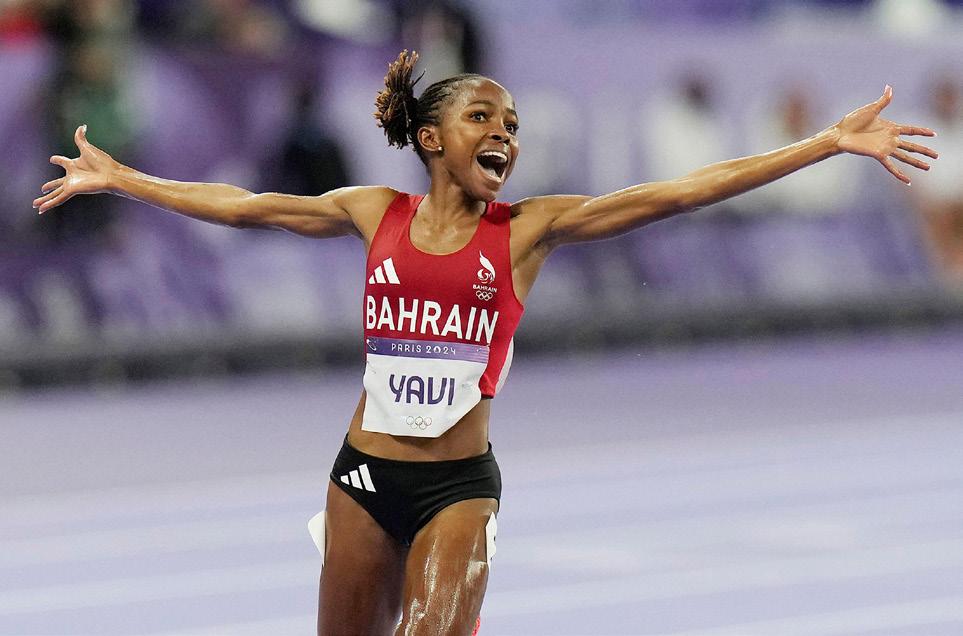
SOURCE 3 At the 2024 Paris Olympics, Winfred Yavi became the first athlete representing Bahrain to win an Olympic gold medal in the women’s 3,000 metre steeplechase.
However, Bahrain’s approach has been notably different, using financial incentives and educational opportunities to entice Kenyan athletes to switch their allegiance.
The Council's ruling marks a turning point in the ongoing debate over the ethics of nationality transfers in sports.
Pulse Live, 23 August 2024
The environmental effects of global sport
One final issue that must be considered in relation to the globalisation of sport is the lasting impact it can have on the natural environment. The environmental issues to consider as a result of globalisation include:
• the impact that the construction of large sporting facilities has on the natural environment and ecology (i.e. native flora and fauna) of regions and countries around the world (e.g. the number of new venues constructed for global events such as the Olympic Games can have serious environmental effects)
• the environmental damage to the natural environment as a result of increasing numbers of spectators, including the energy they use, the food and resources they consume, and the waste they generate (e.g. around 3.1 million tourist arrivals were recorded during the Olympic fortnight of the 2024 Paris Olympics)
• the ecological footprint that athletes, support staff, organisers and spectators generate by travelling large distances to attend sporting events.
Numerous studies have shown that while international sporting events – such as the Summer and Winter Olympic Games, the FIFA World Cup and the PGA tour – generate economic benefits for host cities and nations, these locations also pay a significant environmental price. The pressure from organisers on host nations to build new facilities and venues can be immense, and may lead to unethical behaviours. For example, in preparation for the 1998 Nagano Winter Olympic Games, Fédération Internationale de Ski (FIS) requested that the length of the men’s downhill course be increased by 120 metres. Nagano officials originally refused to extend the course because doing so would damage an ecologically sensitive area of the mountain and harm a number of native species.
For the record!
The issue of athlete poaching doesn’t just happen on the world stage. In recent years, sporting associations have been known to ban their counterparts from attending their sports matches due to increasing tension over alleged poaching of top athletes. These bans arose after claims that athletes were being wrongfully seduced with lucrative scholarships.
Retrieve it!
What are three matters that rules and policies can govern so that ethical risks can be managed? Check back to Lesson 3.6 The influence of ethical values and ethics strategies on fair play and integrity (page 125) on fair play and integrity to see if you retrieved the information correctly.
After an extended battle, the Japanese organising committee agreed to extend the start line by approximately 85 metres – ignoring concerns for vegetation and wildlife – to ensure a longer downhill ski course for athletes.
There are many similar examples where sporting venues are constructed for international events or tournaments that last just a few weeks and after which the venues are abandoned and fall into disrepair (as shown in Source 4).
Golf courses are another example of sporting facilities that can have a negative impact on the environment. The development and ongoing maintenance of golf courses can have negative effects on native wildlife and vegetation. Also, in countries like Australia, the water resources required for their upkeep can be unsustainable.
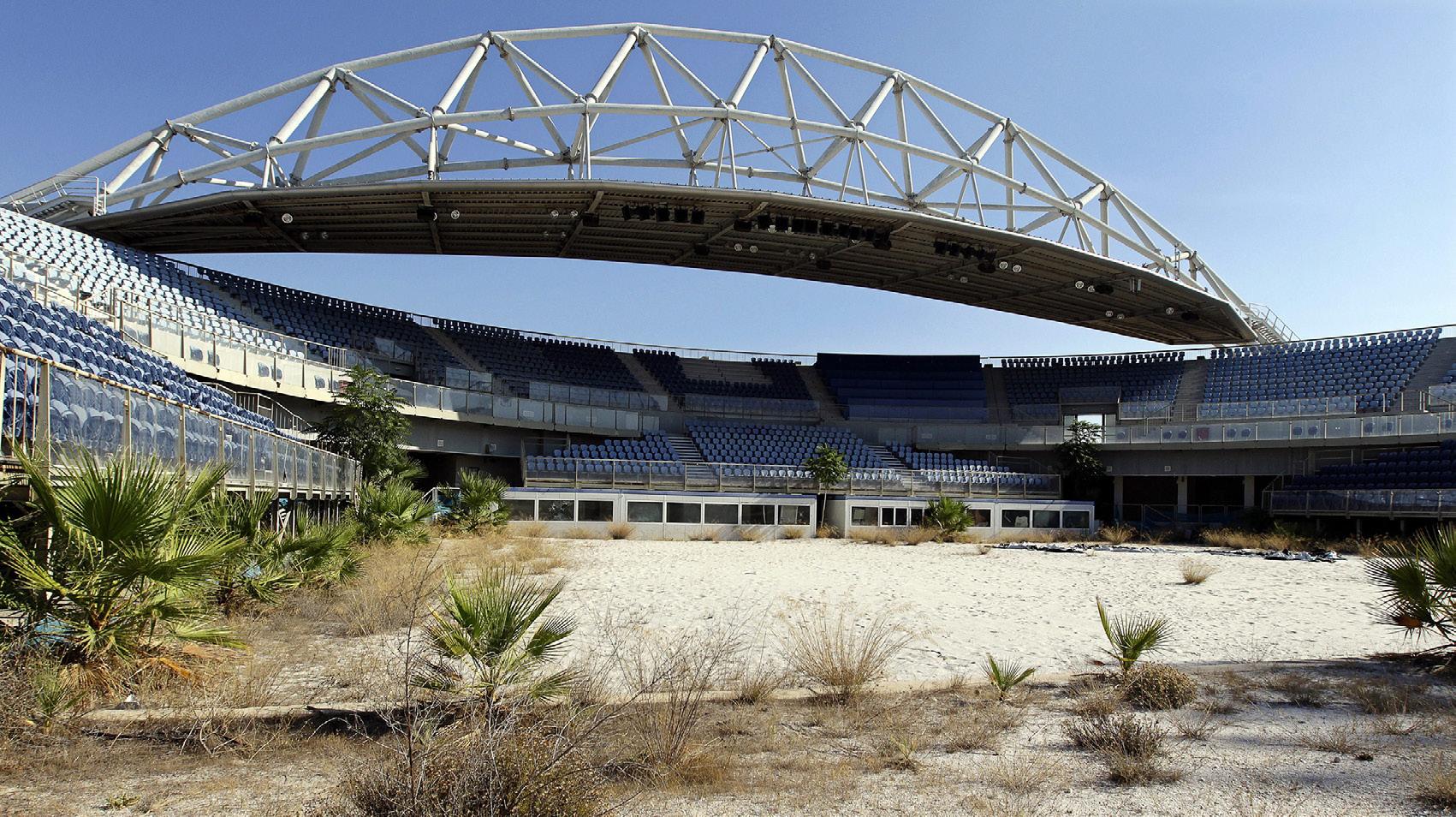
Defining mass media
mass media a collection of technologies (print, broadcast and digital) that are used to communicate messages to very large numbers of people
Mass media is a term used to describe a collection of technologies that are used to communicate messages to very large numbers of people. Today, mass media is made up of:
• broadcast media (e.g. TV, film, radio)
• print media (e.g. newspapers, magazines, billboards, brochures, pamphlets)
• digital media (the internet, social media apps).
Information and messages that are communicated via mass media, including advertisements and marketing materials, have enormous potential to influence the attitudes, opinions, values, thoughts and beliefs of the people who are exposed to them. For this reason, mass media is one of the most significant factors influencing ethical values and behaviours in sport and physical activity.
The media has immense power to promote particular sports, reinforce certain attitudes to physical activity and influence ethical values and behaviours in sport. In addition, mass media can influence our engagement with sport and physical activity by constructing stereotypes about gender, ethnicity, religion and social class, and reinforcing perceptions around issues relating to health and wellbeing (e.g. ideal body types).
SOURCE 4 The cost to host the 2004 Athens Olympics Games, including new buildings and sporting facilities, came at a huge financial cost (around A$13 billion) and significant environmental impact. Today, nearly all of the facilities – such as this beach volleyball venue in Neo Faliro – lie empty, unused and decaying.
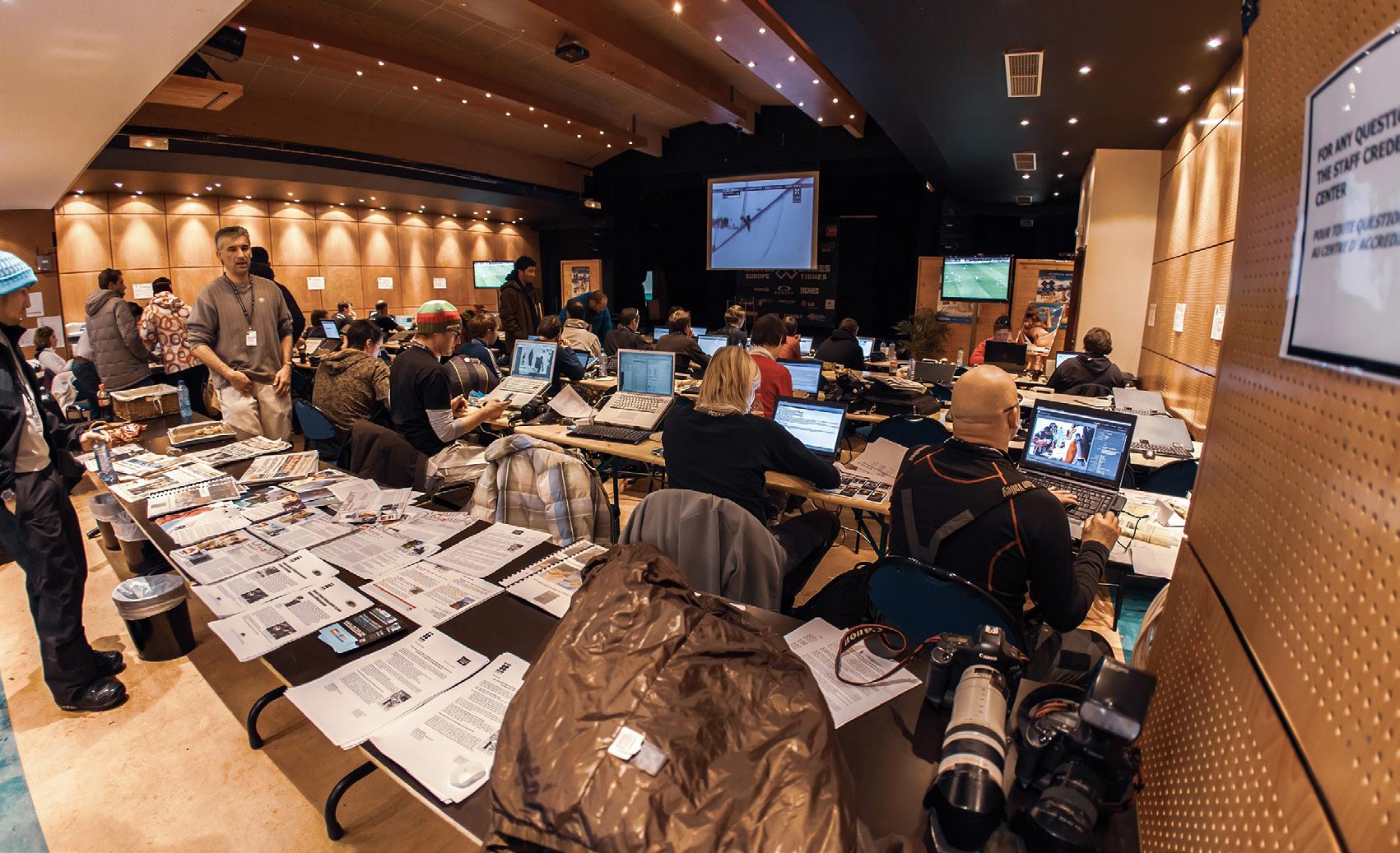
The influence of media coverage on ethical values and behaviours
A number of studies have shown that on any given day the average person will spend more time engaging with mass media than they will engaging with members of their own family. For this reason, mass media can be considered an agent of socialisation, meaning that it has significant influence on the ethical values and behaviours of people in society – both positive and negative. It not only reflects the values of society, but it also helps to actively shape them. Source 6 lists some of the ways in which mass media can have a positive and negative influence on ethical values and behaviours in sport.
Positive influences of mass media on ethical values and behaviours
• Promoting the positive values and behaviours of athletes and clubs
• Raising awareness and building the reputation of a variety of sports and activities
• Promoting healthy and active lifestyles
• Presenting positive and inspiring role models
• Promoting fairness, respect and honesty in sport
• Exposing all forms of cheating and corruption
• Promoting equality by addressing gender imbalances in sport and promoting equal participation rates for males and females
• Challenging accepted stereotypes
• Celebrating examples of good sportsmanship
Negative influences of mass media on ethical values and behaviours
• Promoting the negative values and behaviours of athletes and clubs
• Undermining athletes’ confidence and careers
• Reinforcing inequalities and imbalances by restricting coverage to traditional and/or male-dominated sports
• Under-representing people from a diverse range of backgrounds (e.g. different ethnic groups, sexual orientations, levels of physical and mental ability)
• Undermining the decisions of referees and officials
• Providing coverage that is biased, inaccurate or incomplete
• Restricting coverage of live events to pay TV or subscription channels
SOURCE 6 Positive and negative influences the mass media can have on ethical values and behaviours in sport and physical activity
SOURCE 5 Media has a vital role in bringing live sport to the masses.
The commercialisation of sport
"The Future of Australian Sport" report, prepared by the Australian Sports Commission and the national science agency CSIRO, highlights the changes expected to shape Australian sport over the next decade and more. Key trends that are predicted to further commercialise Australian sport include:
• digital transformation, such as rapid growth in streaming platforms
• the emergence of new revenue streams through digital entertainment and digital rights
• the growing importance of social media in athlete or team value
• changing consumer behaviour.
Australians are shifting towards viewing sport as entertainment and are increasingly showing a demand for digital-first content consumption, meaning that they want to view sport through digital platforms and technologies such as social media, live streaming and other digital formats. Investment patterns are also predicted to change, with gaming and e-sport creating new revenue models and private equity firms increasing their investment in sport. There has been growth in the commercial value of women’s sport and a rise in the importance of purpose-driven partnerships (see In the news.
Overall, future projections are that digital and direct-to-consumer models of engaging with sport will flourish and there will be an evolution of sports formats and sponsorships models.
As the commercial nature of sport changes, more people with differing ethical values have increased access to consume sport and engage with it, having a stake in the outcome of each match, game, etc. Commercialisation can impact the ethics and integrity of sport by creating conflicts of interest and overreliance on commercial revenue, resulting in moral tensions, changing the nature of sporting role models, and potentially compromising the decisions made at the governance level. All these things can filter down to have an impact at a national, state, local, school and, eventually, class level.
In the news
Australian netball sponsorship fallout
In 2022, Gina Rinehart, a prominent Australian mining magnate and owner of Hancock Prospecting, withdrew her sponsorship of Netball Australia. This followed a request from Australian Diamonds squad member Donnell Wallam, a Noongar woman from Korijekup, Western Australia, not to wear the team’s uniform. The uniform featured the Hancock Prospecting logo. Wallam revealed that she was uncomfortable wearing the uniform as a result of racist comments made some decades earlier by Gina Rinehart’s father, Lang Hancock, the founder of Hancock Prospecting.
Rinehart’s decision to withdraw sponsorship had significant financial implications for Netball Australia and led to job losses and budget cuts. Public debate ensued around the role of corporate sponsors in sports and the potential impact of athlete activism on sponsorship deals.

SOURCE 7 Australian Diamonds goal shooter Donnell Wallam was at the centre of controversy in 2022 when she stated she did not want to wear the uniform featuring a specific sponsor’s logo, due to racist comments made by a previous company owner.
Check your learning 3.7
Check your learning 3.7
Retrieval and comprehension
1 Choose the most correct answer.
The aspects of different regions and nations that undergo integration and interconnection in the process of globalisation include:
A economies.
B societies.
C cultures.
D all of the above.
2 Choose the correct answer.
Sport viewed (or consumed) through digital platforms and technologies such as social media, live streaming and other digital formats is referred to as:
A AI sport consumption.
B digital-first consumption.
C sport revenue consumption.
D digi-tech sport consumption.
Lesson 3.8
Ethical dilemmas
Key ideas
3 Define the term "mass media" and describe its three components.
Knowledge utilisation
4 In a 150-word response, discuss the role that globalisation and the media have played in the commodification and commercialisation of sport in Australia. Include three examples to justify your position.
5 Read the In the news about Gina Rinehart withdrawing her sponsorship of Netball Australia. Find two other examples of athletes, teams or organisations forming a purposedriven partnership or, conversely, breaking a partnership because their values and vision no longer aligned. Reflect on the impact this has on stakeholders of the sport. Discuss this in 150 words.
→ An ethical dilemma is a situation in which a difficult choice must be made between two options, even though neither option will result in an outcome that is ethically or morally acceptable.
→ In sport, most ethical dilemmas relate to one of the following areas: gender inclusion or exclusion; ability; enhancements in technology and equipment; corruption.
Defining ethical dilemmas
In the context of sport and physical activity an ethical dilemma can be defined as a problem or situation that causes tensions between stakeholders' values and compromises the ethical principles of integrity and fair play.
ethical dilemmas situations in which a difficult choice must be made between two options, when neither option will result in an outcome that is ethically or morally acceptable; in Physical Education, ethical dilemmas are determined by the interactions between your values and principles, and your purpose for engaging in physical activity stakeholder a person (or group of people) who has an interest, connection, concern or investment in something (e.g. stakeholders in a sporting team may include the players, coaching staff, administrative staff, members, spectators, sponsors and investors)
The tram problem
One of the most common tools used to illustrate ethical dilemmas is called the trolley (or tram) problem. It was created by a British philosopher named Philippa Foot in 1967. Consider this scenario:
A runaway tram is travelling out of control down a track (Track A). Five people are lying in its path, tied to the track. You are standing at the intersection of two different tracks and have the power to pull a lever to divert the tram onto a side track (Track B) where only one person is tied to the track. You have two options:
1 Do nothing and allow the tram to kill five people.
2 Intervene and pull the lever to divert the tram and kill one person.
Which do you think is the more ethical option?
The tram problem exemplifies an ethical dilemma because it divides opinion on what choice is ethically or morally acceptable. Real world applications for the tram problem include medical ethics (e.g. the allocation of scarce medical resources); military ethics (e.g. decisions about the use of force); and public policy (e.g. making choices that balance the needs of different groups).
Ethical dilemmas in sport and physical activity
In the context of sport and physical activity, particularly in schools and local sporting organisations, ethical dilemmas as defined above do not tend to occur daily. Therefore, it is helpful to view an ethical dilemma as an issue that causes tensions between stakeholders' values, compromising the ethical principles of integrity and fair play. A stakeholder is defined as a group or an individual that has an interest in the actions of an organisation or the outcomes of a situation. In the example of a local tennis club, the players are stakeholders because they directly participate in the sport and are affected by the club’s decisions. The parents are stakeholders because they invest time and money and want a positive outcome for their child. Any local businesses that sponsor the tennis club are stakeholders as they provide financial support and expect to get something back in return, such as exposure. The community is a stakeholder because the club provides a recreational and social opportunity for its members. For the remainder of this lesson, we will investigate ethical dilemmas relating to sport and physical activity, categorised into four broad areas:
Track A
Track B
Track B
Track A
SOURCE 1 The trolley (or tram) problem is a helpful tool for examining our personal values. It can also be applied to other scenarios we encounter in life.
• gender inclusion or gender exclusion
• ability
• enhancements in technology and equipment
• corruption
Gender inclusion or exclusion
In the context of sport and physical activity, gender inclusion and gender exclusion are both terms used to describe the degree to which a person is given the opportunity to participate, based purely on their sex or gender.
Teams, clubs, competitions and sports that are gender inclusive have policies and strategies in place that:
• welcome people of all sexes and genders
• ensure that people of all sexes and genders are treated equally and equitably
• protect people of all sexes and genders from discrimination
• provide equal rewards and conditions for players, regardless of their sex or gender
• remove barriers to participation that may be the result of a person’s sex or gender.
By contrast, teams, clubs and sports that are gender exclusive have policies in place that:
• actively or passively restrict people of some sexes and genders from participating or becoming members
• provide unequal rewards and conditions for players based on their sex and gender
• treat members or participants unequally and inequitably based on their sex or gender
• fail to protect people of all sexes and genders from discrimination.
Understanding the difference between sex and gender
There are three biological sexes recognised under Australian law – male (M), female (F) and indeterminate/intersex/unspecified (X) – but gender is a more complex and difficult concept to define because it is socially constructed. Gender is part of an individual’s personal and social identity. It refers to the way a person feels, presents and is recognised within the community. A person’s gender may be reflected in outward social markers, including their name, outward appearance, mannerisms and clothing.
A person’s sex and gender may not necessarily be the same. Some people may identify as a different gender to their birth sex and some people may identify as neither exclusively male nor female. Put simply, we are born a particular sex, but we learn what it means to be a particular gender.
Examining ethical dilemmas relating to gender inclusion and exclusion
Because gender and sex are such a large part of who we are, there is a high chance of situations arising in sport and physical activity that will result in ethical dilemmas.
Consider how specific sports or physical activities are often associated with particular attitudes, behaviours and genders. For example, sports such as wrestling are typically associated with displays of physical strength and aggression. These traits – traditionally associated with men rather than women – often result in wrestling being thought of as a "masculine" sport. This can exclude many women from engaging with, or participating in, the sport. When sporting organisations, including schools, intentionally or unintentionally exclude an individual from participating in sport on the basis of their gender, this is considered an ethical dilemma.
gender inclusion the action or state of welcoming or including people in a sporting club, association or code regardless of their gender or sex gender exclusion the action or state of restricting or excluding people from a sporting club, association or code based on their gender or sex
ability the degree to which a person possesses the means to do something (i.e. their physical or mental ability) and/ or the degree of proficiency or skill a person possesses (i.e. their talent)
corruption a term used to describe dishonest or fraudulent conduct carried out by those in power (typically for personal financial gain); in sport, it also includes any unethical or illegal activity that aims to deliberately change or alter the result of a sporting contest
Ethical dilemmas also exist when sporting organisations do not make a concerted effort to remove known gender-based barriers. These include but are not limited to:
• funding gaps – inequities still exist in the funding of men and women’s sport from the grassroots to the elite level
• pay gaps – there are still stark differences in wages, prize money and conditions between professional male and female athletes. This includes the difficulties many women face in securing sponsorship deals and media coverage. For example:
– According to the Australian Bureau of Statistics (2023), women in Australian sport earn 87 cents per $1 paid to a man.
– The 2024 Forbes magazine’s list of the world’s highest paid athletes did not include a woman.
– In the 2024 American WNBA, the number 1 draft pick, Caitlin Clark, earned US$76,000 in her first year while the number 1 NBA men’s draft pick earned an estimated US$10 million.
• representation gaps in governance, coaching and administration – in 2022, approximately 40 per cent of Australians who participated as a coach, instructor, trainer or teacher in the sport and recreation sector were women. In 2023, 25 per cent of board chairs across 65 Australian Sports Commission-funded National Sporting Organisations were women and 2 per cent of Chief Executive Officers were women
• gender-based differences in sport drop-out rates – data from UN Women Australia indicates that, by the age of 14, girls drop out of sport at twice the rate boys do, with one of the main reasons being a lack of investment in quality programs
• unbalanced models of support – research conducted by Play Like a Girl Australia revealed that a commonly cited reason why people drop out of sport is the inclination among sporting organisations to apply the same sporting structures and models for
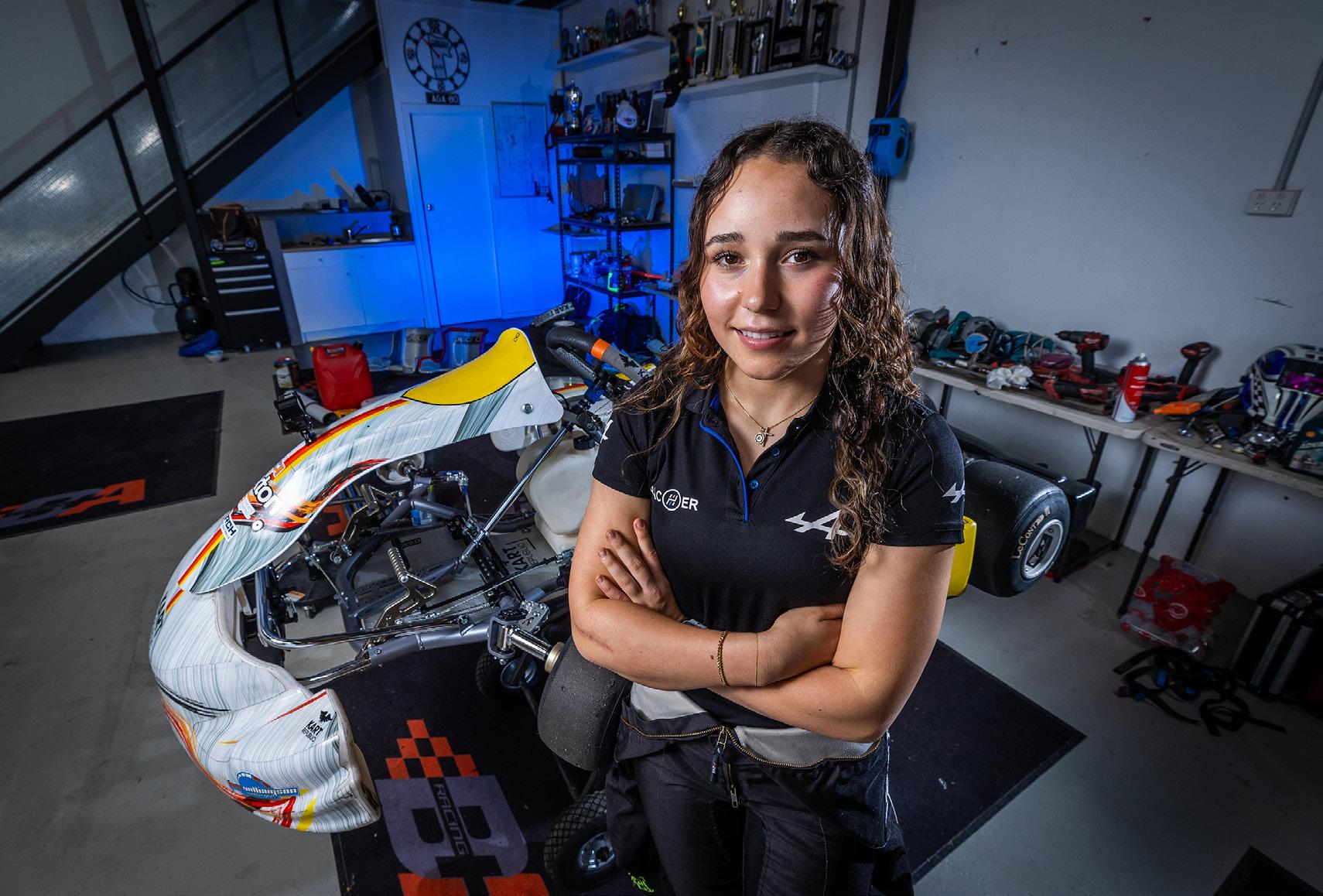
SOURCE 2 Australian teenager Aiva Anagnostiadis is chasing the dream of racing in Formula 1. She is currently a member of Alpine’s Race(H)er program. Initiatives like this are increasing the opportunities for female drivers to move up the rankings of motorsport.
men and women without acknowledging the unique needs and challenges women face –menstruation being one of them. A 2024 survey by charity Share the Dignity revealed that 68 per cent of Australian women miss sport on a regular basis because of their period.
Controversy about inclusion of transgender people
Currently, the inclusion of trans women athletes is one of the most controversial issues in world sports. In recent years, there have been numerous debates and policy changes surrounding the inclusion of transgender athletes in sports at all levels, including school sport. In 2021, the International Olympic Committee produced a framework on fairness, inclusion and non-discrimination on the basis of gender identity and sex variations comprising 10 principles to guide sporting bodies to create or adapt their transgender inclusion policies. Many countries and states have introduced legislation restricting the participation of transgender athletes. International sports organisations for sports including rugby, cycling, athletics, cricket, netball and swimming have also tightened their rules about trans women's eligibility to compete. The argument in favour of such restrictions centres on the impact of testosterone on providing an unfair advantage in regard to size, speed, power and force. Algerian boxer Imane Khelif was at the centre of such a controversy at the 2024 Paris Olympics after she had been ineligible to compete at the previous year’s boxing world championships.

3 Algerian
A question of gender inclusion and exclusion
Source 4 includes a range of ethical dilemmas for you to consider in light of the information we have discussed so far.
Should trans women athletes be eligible to compete in women’s sporting competitions?
Should testosterone levels be used to determine an athlete’s eligibility to compete in men’s and women’s competitions?
Should the rules of all sports be the same for men and women (e.g. tennis rules regarding the number of sets)?
Should female athletes be paid as much as their male counterparts if game attendance or viewership is higher for male sports?
SOURCE 4 Examples of ethical dilemmas relating to gender inclusion and exclusion in sport and physical activity
For the record!
In 2024, the Australian Sports Commission welcomed a new policy to ensure sporting boardrooms across the country meet gender equity targets or risk funding being withheld. The policy requires organisations to reach the following Gender Equity Targets in the coming years:
• 50 per cent of all board directors are women and/or gender diverse
• 50 per cent of board chairs are women and/or gender diverse
• 50 per cent of specified board sub-committee members are women and/or gender diverse. At the time of publication, only 25 per cent of national sporting organisations and national sporting organisations for people with disability were chaired by a woman.
Should the uniforms of male and female athletes be the same (e.g. consider beach volleyball)?
SOURCE
boxer Imane Khelif found herself at the centre of a gender-based controversy at the 2024 Paris Olympics.
Study tip
Gender inclusion and exclusion is closely related to a topic you learnt about in Unit 2 – Topic 2: Equity – barriers and enablers called "The social construction of gender".
It may help you to revisit and revise that information as background to this topic. See Lesson 5.13 in Physical Education for Queensland Units 1 & 2.
Ability
In the context of sport and physical activity, ability can be used to describe:
• the degree to which a person possesses the means to do something (i.e. their physical or mental ability)
• the degree of proficiency or skill a person possesses (i.e. their talent).
Examining ethical dilemmas relating to ability
Because our ability to move – and the degree of skill and proficiency we demonstrate while moving – is such a large part of who we are as human beings, there is a high chance of situations arising in sport and physical activity that will result in ethical dilemmas.
In this section, we will address three aspects of ability in sport and physical activity that can result in ethical dilemmas. These are:
• disability – any physical and/or mental conditions that limit a person’s movements, senses or activities
• talent identification and early specialisation – the practice of identifying young children with sporting ability and conducting intense training in one sport while excluding other sports
• player selection
Disability
According to the Australian Bureau of Statistics (ABS), 5.5 million Australians, or 21.4 per cent of the population, have a disability, limitation, restriction or impairment that affects their everyday activities. Some of these disabilities may be hereditary (i.e. passed down in the genes from parent to child), while others are due to accidents or illnesses.
According to the Australian Human Rights Commission (AHRC), "everyone has the right to be an active member of their community and to have a say in the decisions that affect their lives". This includes equitable access to physical activity.
para-sport any sport played by people with a disability or impairment (including physical, vision, hearing, intellectual)
Most sporting associations and codes today have a para-sport equivalent. Para-sport exists so that athletes with a disability have equal opportunities to compete and be successful in sport. The term "para-sport" is now used widely to describe events and sports for disabled athletes because they run parallel to able-bodied sports (i.e. they are similar or take place at a similar time). For example, the Summer and Winter Paralympic Games run parallel to the Olympic Games.
Para-sports operate using a classification system that groups athletes with similar impairments into categories for competition (e.g. physical impairment, vision impairment, intellectual impairment, hearing impairment, transplant athletes). Classification systems vary across para-sports, but disability groups are separated into varying classifications to ensure fair competition.
Athletes are required to provide medical documentation that details their impairment type and level of impairment. There are specific minimum impairment criteria that athletes must meet in order to be eligible for each sport. This is determined through a classification assessment.
Examples of ethical dilemmas relating to disability
There are many types of ethical dilemmas related to disability that can arise in sport and physical activity. They can include issues such as:
• intentional misrepresentation – when athletes or coaches deliberately mislead medical
experts, team officials or event organisers by misrepresenting the type or severity of a disability to gain an unfair advantage over other athletes
• policies and practices at sporting clubs or associations that intentionally or unintentionally discriminate against people with a disability – when policies or lack of facilities (or modifications) at a club limit a disabled person’s access
• the types of technologies and equipment that can be used by para-athletes – the possible advantages offered by particular types of equipment (e.g. prosthetics, implants), who has access to the best technology, who can afford it, etc.
• the amount of media coverage and sponsorship that is dedicated to para-sports compared to their able-bodied equivalents – the ability for all people to access and view para-sports.
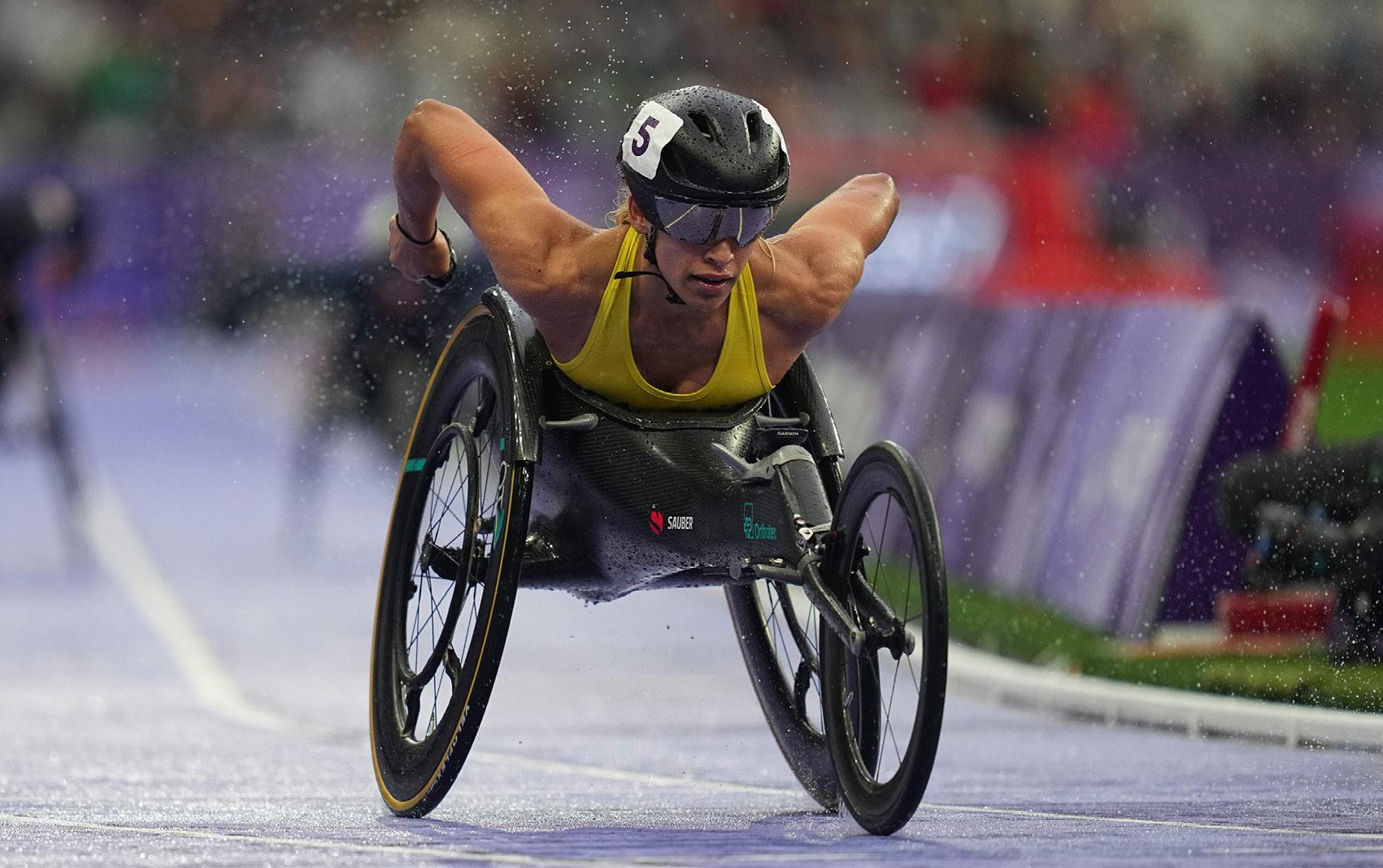
Talent identification and early specialisation
Athletes who demonstrate high ability in their chosen sport, or who possess attributes that indicate they will make a champion athlete in time, are often identified in their formative years and encouraged to take up a highly specific training regime. This is known as early specialisation. While this process can produce champion athletes, it can also raise ethical concerns because it is not always in the best interests of the athlete.
Negative implications of early specialisation include that it can:
• put pressure and stress on young athletes, leading to burnout, injury or mental health issues
• place an emphasis on winning and diminish the intrinsic joy for the athlete
• limit the athlete’s opportunity to develop general skills and game awareness
• provide an unfair environment whereby the identified athlete gains greater access to coaching and playing resources.
The negative outcomes of early specialisation are commonly cited as reasons individuals quit sport.
Retrieve it!
What are the four steps known as the principles of decisionmaking? Check back to Lesson 2.5 Decisionmaking in the dynamic systems approach to motor learning (page 63) to see if you retrieved the information correctly.
SOURCE 5 Australian para-athlete Madison de Rozario won silver and bronze medals at the 2024 Olympics.
To help sporting stakeholders keep sight of the various reasons individuals participate in sport, and to guide the ethical development of athletes, the Australian Institute of Sport developed the Foundations, Talent, Elite and Mastery Framework (FTEM Framework). Sporting organisations in Australia, including schools, are encouraged to adopt this framework because of its emphasis on athlete welfare and their holistic development over time.
Examples of ethical dilemmas relating to early specialisation
There are many types of ethical dilemmas related to early specialisation that can arise in sport and physical activity. They can include:
• an overemphasis on competition and winning at the expense of broader sporting experiences
• high rates of overuse injuries and burnout
• a failure to recognise that many young athletes are interested in sport for engagement, enjoyment and health, as well as the chance to make friends
• overly long and strenuous training sessions, games and seasons that conflict with school, recreational, religious or family activities
• the high cost for families of training, coaching, equipment and travel when competing
• early starts and long travel times
• not recognising, appreciating and accommodating cultural, racial and ethnic differences
• creating environments that are not welcoming in terms of language, expectations and inclusion
• practices that make participants self-conscious or uncomfortable about their developing bodies.
Player selection
When selecting players for squads and teams, coaches and selectors often face the challenge of finding a balance between fairness and merit. It is critical that fairness and transparency are prioritised to ensure that player selection promotes a positive environment. When player selection is considered unfair, it can discourage athletes and reduce their motivation to continue. As well, perceived corruption or bias in the selection process can damage the reputation of the sport or organisation and erode stakeholders' trust.
Examples of ethical dilemmas relating to player selection
Some examples of ethical dilemmas relating to player selection are:
• selecting new athletes over those who have given dedicated, loyal service to their school, club or organisation over time
• conversely, not giving a new player an opportunity to fairly trial among an established group of athletes
• not communicating a transparent selection criterion to all stakeholders
• conflict of interest in the selection process, as in the case of a selector who

SOURCE 6 The defection of Joseph-Aukuso Suaalii from Rugby League to Rugby Union has been a hotly debated topic. One question raised has been the fairness of Suaalii taking the place of another athlete who has dedicated their life to Rugby Union.
has a child or family member eligible for selection
• a lack of fair and equal opportunity for athletes from all backgrounds and circumstances to be considered.
A question of ability
Source 7 shows a range of ethical dilemmas for you to consider in light of the information we have discussed so far.
Should athletes who are new to the school, club or organisation be able to take the spot of an established athlete?
To be eligible to compete in an interschool competition, should you have to play for your school’s club team (if applicable)?
To avoid the complicated athlete classification system, should para-athletes be able to enter events based on the recommendation of their local doctor?
SOURCE 7 Examples of ethical dilemmas relating to ability in sport and physical activity
Enhancements in technology and equipment
Should transgender athletes have to compete in a new category that is neither female or male?
When it comes to sport and physical activity, enhancements in technology and equipment have the ability to shape almost every aspect of the way we participate in, engage with and consume sport. These enhancements can influence everything from simple improvements in the design or function of sporting equipment (e.g. the use of new materials that are lighter or faster) right through to the introduction of new types of scientific or medical techniques (e.g. that improve recovery times for athletes).
Examples of ethical dilemmas relating to enhancements in technology and equipment
There are many types of ethical dilemmas related to enhancements in technology and equipment that can arise in sport and physical activity. They can include issues such as:
• coaching and competition analysis (e.g. on-field cameras and tracking devices embedded into players shoes, helmets and other gear)
• spying on opponents
• clothing, equipment and wearables (e.g. wearable tech providing athletes with more data about their bodies and performances than ever before)
• science and human performance (e.g. movement analysis and muscle activity technologies such as electromyography revolutionising performance)
• media broadcasting (e.g. digital media and social media making it easier than ever before for fans to contact and interact with their favourite players)
• entertainment (e.g. virtual reality technologies with the potential to revolutionise watching sport, making it possible for spectators to be on the "virtual field" during play)
• esports (multiplayer video game competitions), which have increased in popularity and now compete with traditional sports – with a predicted 250 million viewers annually by 2020
• the planning, construction and use of sporting facilities (e.g. new design software and building materials enabling the construction of larger and more advanced sporting stadiums and training facilities).
Some sports have a high dependence on equipment, and access to these resources can present ethical dilemmas for organisers and sports administrators. In a school context, access to equipment and technology can be barriers or enablers to participation and development.
Should it be compulsory for representative club or school sport trials to include a selector who is completely removed from the sport?
Should school/junior sporting fixtures be videoed in order to analyse opposing teams?
A question of technology and equipment
Source 8 includes a range of ethical dilemmas for you to consider in light of the information we have discussed so far.
Is it the school’s/club’s responsibility to give teams the best chance of winning by investing in technology and enhancements?
Should schools/clubs have a policy about the data you can capture on wearable devices?
Is it the competition organiser’s responsibility to ensure a level playing field in terms of technology and enhancements?
Should enhancements (e.g. hypoxic chambers) be encouraged at all schools because they produce better athletes?
SOURCE 8 Examples of ethical dilemmas relating to enhancements in technology and equipment in sport and physical activity

doping the use of banned performanceenhancing drugs by athletes and competitors during training or competition
For the record!
The 1919 "Black Sox Scandal" is possibly one of the earliest widely known cases of corruption in sport history. Members of the baseball team accepted money from professional gamblers to effectively throw the World Series. As a result, they were permanently banned from playing organised baseball.
Corruption
Corruption is a term used to describe dishonest or fraudulent conduct carried out by those in power (typically for personal financial gain). In the context of sport and physical activity, corruption includes any unethical or illegal activity that aims to deliberately change or alter the result of a sporting contest. Corruption in sport also includes the use of performanceenhancing drugs – a practice commonly known as doping
Examples of ethical dilemmas relating to corruption
Corruption can involve a wide range of offenders – from individuals who operate in isolation (e.g. players, coaches, referees, judges), through to large, well-organised groups who work in collaboration with one another (e.g. club and federation officials, crime gangs, criminal syndicates).
SOURCE 9 During the 2024 Paris Olympics, FIFA took significant disciplinary action against Canada's women's football team, fining the association and banning coaches – including head coach Bev Priestman, pictured here – following the team's use of drones to spy on their opponents. This incident highlights how enhancements in technology and equipment can create ethical dilemmas.
Corruption can affect every aspect of how sport is played, managed and promoted, including:
• how matches or races are contested (e.g. match fixing, also called competition manipulation)
• what players do during games or events (e.g. spot fixing)
• the measures taken to enhance individual or team performance (e.g. the use of performance-enhancing drugs or banned substances)
• the selection and transfer of athletes
• the management of clubs and sporting federations
• the election of officials to governing bodies
• the acquisition of sponsorship, media and marketing rights
• bids to host large sporting events.

SOURCE 10 In 2024, three players from Macarthur FC A-League Soccer Club were involved in the "yellow card scandal". It was alleged by NSW police that they intentionally received yellow cards so that gamblers could make money from their actions. In exchange for the yellow cards, each player received a $10,000 payment.
Australian sport has had several high-profile instances of corruption over the years. In 2011, the Cronulla Sharks NRL supplements scandal involved the use of performance-enhancing substances, including peptides. The Australian Sports Anti-Doping Authority (ASADA) conducted an investigation that led to heavy sanctions on the team and its players. In 2015, the Essendon Football Club also found itself at the centre of a scandal involving the use of banned substances. This resulted in significant penalties for the club, including the loss of draft picks, fines and the suspension of players. In 2018, the world was consumed by the Australian men’s cricket team ball-tampering scandal, which involved players illegally using sandpaper to scuff up the official match ball, consequently leading to long-term bans and reputational damage for Australian cricket. In 2024, three players from the Macarthur FC A-League soccer team were charged by NSW police for allegedly deliberately receiving yellow cards at set times within the match in exchange for $10,000 each. The illegal spot-fixing scheme captured the nation’s attention and brought Australian soccer into disrepute.
One of the more contentious ethical debates taking place now is that of the Enhanced Games, a planned international sports event that will involve athletes who will not be subject to drug testing. The event, a first of its kind, will not follow the rules of the World AntiDoping Agency (WADA). Its proponents claim that adult athletes have the right to do with their body what they wish. However, its adversaries argue that the games are unethical on many levels:
• they undermine the core principles of fair play
• they pose significant short-term and long-term health risks for athletes
• they raise moral questions about the nature of sport and the pursuit of excellence
• they erode the spirit of sportsmanship.
A question of corruption
Source 11 includes a range of ethical dilemmas for you to consider in light of the information we have discussed so far.
Should performanceenhancing drugs be permissible, given it is so di cult to police?
Should athletes be drug tested all year round, or just before competitions?
Should sporting clubs be free to sign on with any sponsorship partner?
Should there be performance-enhancing drug tests in prominent interschool competitions, such as the Australian All Schools Athletics Championships?
SOURCE 11 Examples of ethical dilemmas relating to corruption in sport and physical activity
For the record!
In 1994, USA figure skater Nancy Kerrigan was attacked and injured by a hired assailant. It was later revealed that the husband of Kerrigan’s rival, Tonya Harding, had orchestrated the attack. Implicated in the conspiracy, Harding faced severe consequences, including a ban from the sport. The incident of corruption was so famous that it was made into a movie called I, Tonya, starring Australian actor, Margot Robbie.
Have sports-betting agencies had a negative or positive e ect on the development of the various codes they are involved with?
In the news
Enhanced Games will be a "freak show" that James Magnussen should not dive into
Caitlin Bassett
Do you want to be the most famous athlete in the world? That’s the line organisers of the Enhanced Games are using to lure participants to take part in their freak show – that and the millions in prize money they promise to shower them in.
Proposed by Australian entrepreneur Aron D’Souza, the Enhanced Games is pitching itself as "a better version of the Olympics", encouraging athletes to take performance enhancing drugs in order to break world records.
According to the organisers behind the games (already rich men with the backing of even richer investors) athletes have been oppressed by not being allowed to embrace the full potential of science in sport.
The premise that clean athletes have had their athletic ability stifled by not taking performance enhancing drugs is laughable – and is spoken like someone who doesn’t understand the mentality of elite sport.
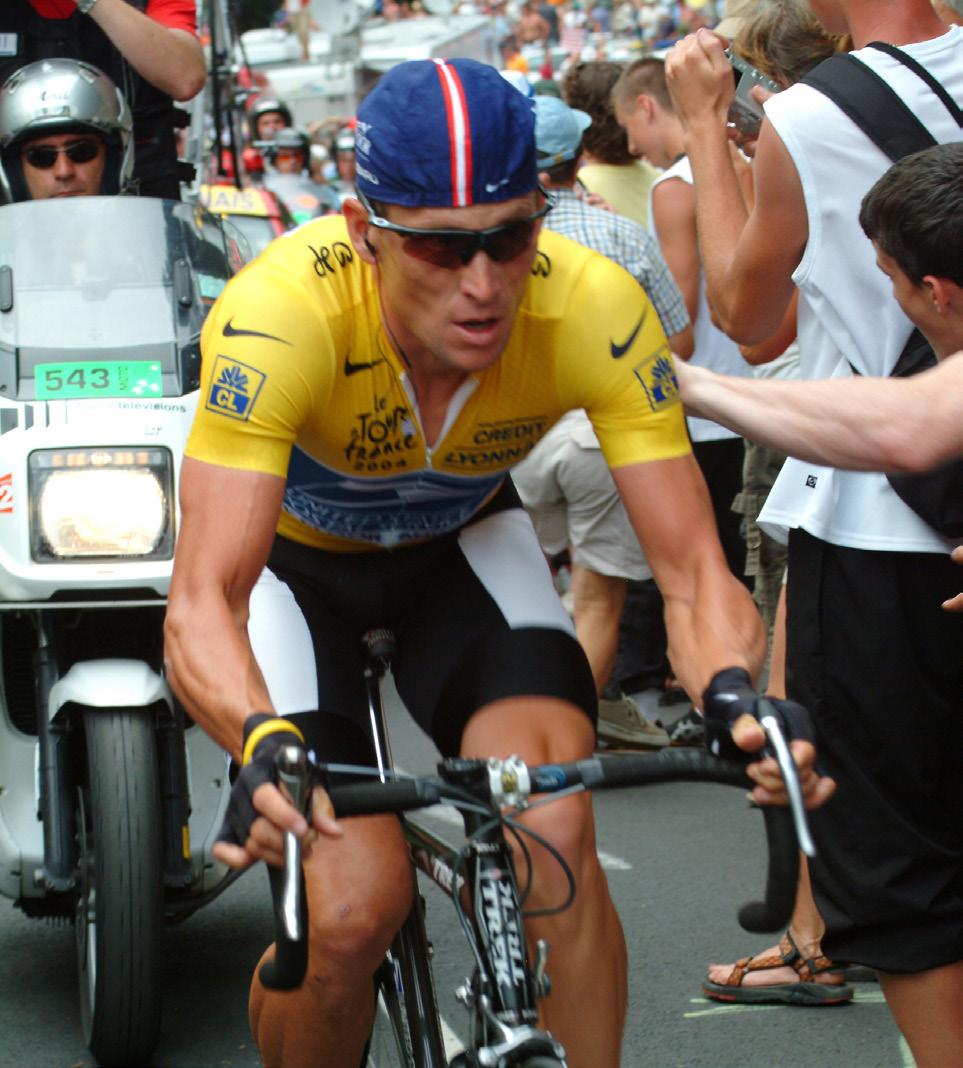
Using performance enhancing drugs is taking the easy way out and nothing good ever comes easy.
The Enhanced Games is clearly a competition for former athletes to cash in and stay relevant or B grade athletes who were never good enough in the first place.
As a staunch advocate of clean sport I found the statements on their website wild. There is a page celebrating athletes who have had world records revoked stating that they have suffered "unfair reputational damage" and commending them for "enduring bravery in the face of oppression".
I worry about the impact this will have on young kids who are bombarded with messages that being rich and famous trumps hard work and a fair play – that life is about winning at all costs.
The argument that James Magnussen isn’t harming anyone by doing this to his body is untrue. If he wasn’t a former world champion I would have no problem, but the fact is that when he represented Australia he became a role model for all young people. Now he is telling us he wants to "juice to the gills".
Former Olympic legend and current Australian Sports Commission boss Kieren Perkins has been vocal in his opposition of the games.
"The impact isn’t just on the individual, the impact is on potential generations, so there’s a high level of ignorance and selfishness that comes with it," he said.
I couldn’t agree more and believe the organisers are underestimating the affect the games will have on young children aspiring to be future Olympians.
The win-at-all-costs mentality is something that doesn’t sit well with me and in modern sport we have begun to celebrate the athletes who show vulnerability and imperfection.
Movies like Rocky, Cool Runnings and Coach Carter are popular because while winning is awesome, success does not ultimately define the worth of a person or team.
SOURCE 12 Champion cyclist Lance Armstrong’s reputation was shattered when it was found that he had used performanceenhancing drugs. He was stripped of all his titles and banned for life from official cycling events.
That’s what I ultimately believe breaking a record at the Enhanced Games will be – a shallow victory.
Lance Armstrong was once the most celebrated athlete in the world, his seven consecutive Tour de France wins made him one of the most iconic and revered athletes in the world.
The respect he held instantly evaporated once it was revealed he admitted to doping, his sponsors dropped him, his reputation was ruined.
Beating Usain Bolt's 100m sprint record by taking performance enhancing drugs shouldn’t be seen as an achievement, it’s actually meaningless. You took drugs, and the easy way out to achieve something another person did though pure talent, dedication and years hard work.
What the research says
The only thing I believe the Enhanced Games are promoting is that fame and fortune trump hard work and dedication.
Money talks and while these games will probably go ahead, I will not be interested in watching. As a sports journalist who one day dreams of covering an Olympic Games – an opportunity never afforded to me as an athlete – I don’t want to play a part in glorifying athletes who are happy to take the easy way out for the right sum.
What’s more important – fame or integrity?
There is no shame in not making it if you try your guts out, failure is character building.
The Nightly, 9 April 2024
Dr Dennis Hemphill is an Honorary Professor in Sport Ethics at Victoria University, specialising in the areas of integrity and fair play. He is also a sought-after educator, delivering webinars and workshops to promote ethical practices within the fields of exercise and sport science.
Dr Hemphill has written many publications on corruption in sport, especially on the topic of performanceenhancing drugs. These include his 2008 article titled "War on drugs in sport", his 2009 paper, "Performance enhancement and drug control in sport: ethical considerations", and his 2015 book section, "Doping and anti-doping in sport", in the Encyclopedia of Education Philosophy and Theory
Dr Hemphill’s work addresses doping as an ethical dilemma based on the notions of naturalness, fairness, health and the spirit of sport. It also explores the complex relationship between individual rights and the broader community values.
References
• Hemphill, Dennis (external link) (2008), "War on drugs in sport", in Bulletin of Sport and Culture, 29 (1). pp. 3–4. ISSN 1328-8997
• Hemphill, Dennis (external link) (2009), "Performance enhancement and drug control in sport: ethical considerations", in Sport in Society, 12 (3). pp. 313–326. ISSN 1743-0437
• Hemphill, Dennis (external link) (2015), "Doping and anti-doping in sport", in Peters, M.A. (ed.) Encyclopedia of Education Philosophy and Theory, Springer, Singapore.
Ethical dilemmas in a class, school and community setting
In this lesson, we have discussed ethical dilemmas in sport relating to four broad areas, with most examples coming from national and global sport. The reality is, however, that ethical dilemmas are everywhere, and occur around us in everyday life. Examples of these dilemmas in the context of Health and Physical Education (HPE) or school/community sport include but are not limited to the following:
Ethical dilemma
Gender inclusion or exclusion
Retrieve it!
What are the four broad categories of ethical dilemmas? Read back through this lesson to see if you retrieved the information correctly.
Example in a class, school or community context
• males and females:
– not receiving the same level of recognition via the mechanisms that exist, such as school assemblies, newsletters and social media posts
– not having equal access to appropriate sports programs and facilities, especially those that acknowledge the unique needs of females as discussed in this lesson
• athletes facing issues relating to gender-based body stereotypes and body image
• students not feeling safe when participating or being involved in HPE lessons
• female students participating in mixed-sex HPE practical classes having reduced opportunities with the ball during team sports
Ability
Ethical dilemma
Example in a class, school or community context
• athletes not receiving the same opportunities to coach, administer or HPE and sport programs that make participants self-conscious or uncomfortable about their developing bodies
• HPE lessons and school/community sport programs that exclude athletes with a disability and/or fail to provide appropriate equipment or assistive technology
• a lack of pathways and recognition for athletes with a disability
• students with lower abilities in HPE classes having reduced opportunities with the ball during team sports
• small schools or communities relying on the same athletes to represent them in multiple sports, resulting in burnout or excessive costs
• important matches being refereed by inexperienced referees
Technology and equipment enhancement
• school sport programs not funding appropriate resources, resulting in access only for those who can afford it
• wearable technology collecting and storing personal health data
• not adapting sustainable practices such as recycling old equipment and promoting responsible use of technology
Corruption
• teacher or coach favouritism or selection bias
• player game time is based only on ability and desire to win at the grassroots level
• students, teachers or coaches cheating, manipulating results or intimidating inexperienced referees to improve chances of winning
• students taking illegal performance-enhancing substances
• administrators, teachers or coaches misusing funds or falsifying records
• competition manipulation, match-fixing and sports wagering by players, teachers, parents or coaches
• conflict of interests such as a student who is also a referee of a match involving their school/club
Retrieval and comprehension
1 Choose the correct answer.
High rates of overuse injuries and burnout is an ethical dilemma from which category?
A gender inclusion or exclusion
B ability
C enhancements in technology and equipment
D corruption
2 Choose the correct answer.
What percentage of women are board chairs in National Sporting Organisations?
A 25%
B 30%
C 35%
D 40%
3 Define the term "ethical dilemma" in your own words.
4 Identify some of the ways in which sporting clubs, teams and organisations can be more gender inclusive.
Analytical processes
5 Consider the examples of ethical dilemmas related to talent identification and early specialisation or player selection. Reflect on your personal experiences in sport as a young child and determine whether any of your identified dilemmas influenced your sporting participation, enjoyment and/or success.
Knowledge utilisation
6 Read the In the news about performanceenhancing drugs. Imagine you are about to enter a debate, and you are arguing against the introduction of these games. Devise a list of points that support your argument.
Lesson 3.9
Investigate personal responses to an ethical dilemma
Aim
To investigate different ways in which individuals respond to an ethical dilemma.
Time
1 lesson (i.e. 60 minutes) with additional time (if required) to complete analysis and discussion tasks.
Equipment
• Good-quality badminton or tennis racquets (regulation racquets that are in good working condition)
• Poor-quality badminton or tennis racquets (regulation racquets that are damaged or broken, or non-regulation racquets such as plastic toy racquets and table tennis bats)
• Badminton shuttles or tennis balls
• A round-robin score sheet
• Data Collection Instrument 1 (DCI 1)
• Clipboard
• Pen
Additional resource: Round-robin score sheet
Data Collection Instrument 1 (DCI 1)
Method
Step 1
Form pairs and participate in a teacher-led warm-up.
Step 2
Prepare to take part in a doubles badminton or tennis round-robin tournament with the following scoring modification: "first to 7 wins".
As a class, you have one minute to inspect the equipment available for the tournament and select your racquet. Half the racquets will be good quality and the other half will be poor quality.
Step 3
Take part in the tournament. The winning team may be awarded a prize at the discretion of the teacher.
Step 4
Complete the survey in DCI 1. You can download this from Oxford Digital or you may like to use Google Forms or SurveyMonkey to create a digital version of the survey.
Analysis and discussion tasks
1 Synthesise the primary data that you and all of your classmates have collected using DCI 1. Google Forms or SurveyMonkey will help you automatically gather each student’s responses and collate the results.
2 Use the data you collected on DCI 1 to complete the following tasks.
a Present the class results of Questions 4 and 5 on DCI 1 as two separate bar graphs.
b Analyse the two graphs you have prepared. Do you notice any trends or relationships between people’s initial feelings about the equipment and the extent to which it affected their performance?
3 Use the data you collected on DCI 1 to complete the following tasks.
a Present the class results of Questions 10 and 11 on DCI 1 as two separate bar graphs.
b Analyse the two graphs you have prepared. Can you identify any discrepancies between people’s general perceptions of their integrity and the level of integrity they demonstrated in the tournament?
Suggest reasons for any discrepancies which exist.
4 Describe the tensions that exist between the ethical dilemma and your and your classmates' personal values. Discuss the extent to which these tensions impacted on fair play during the tournament.
5 Devise an ethics strategy that could be implemented for future tournaments that would increase the chances of achieving fair play and integrity (without changing the equipment available).
6 Evaluate the potential outcomes and limitations of the ethics strategy you devised in the previous question (using at least one piece of primary data and one piece of secondary data to justify your reasoning).
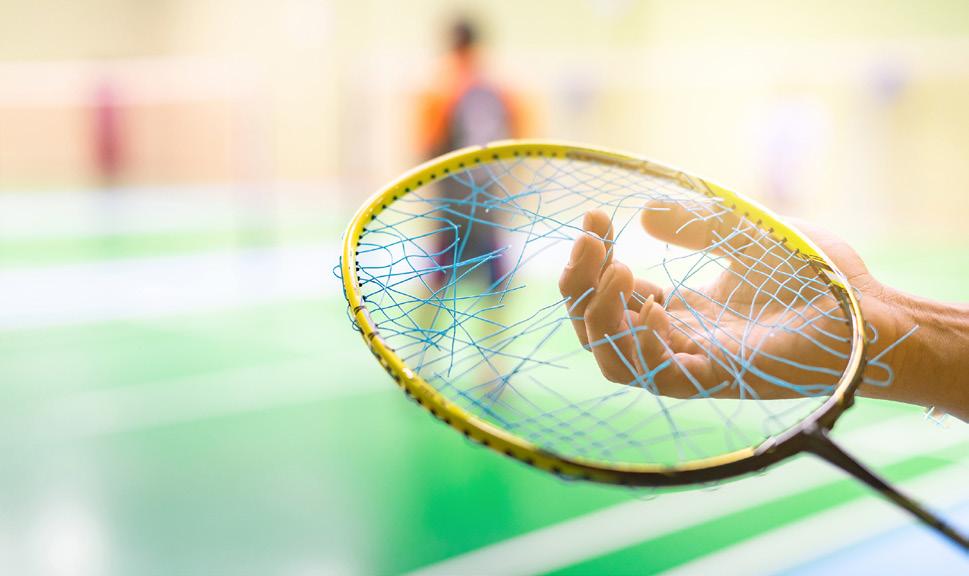
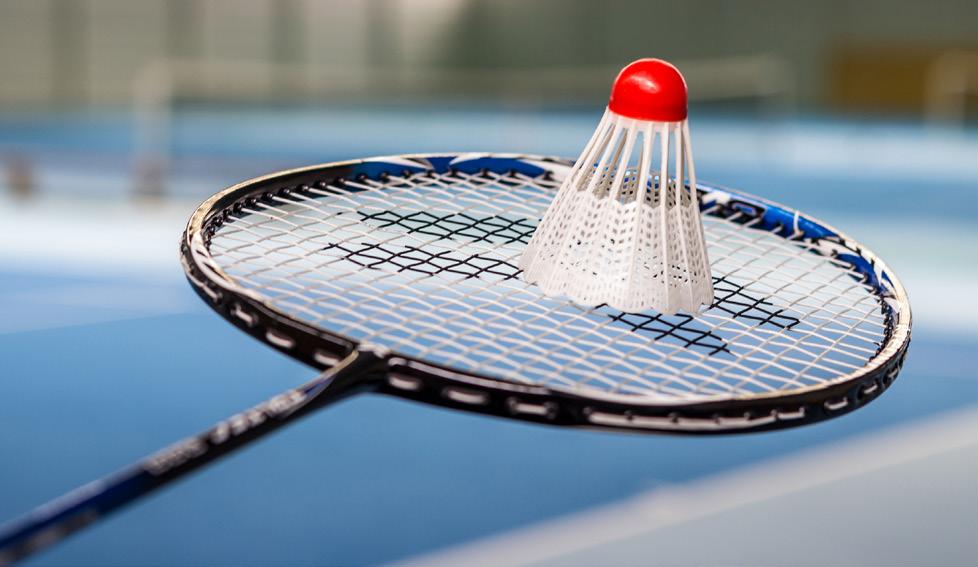
Learning intentions and success criteria
Lesson 3.10
The ethical decision-making framework
Key ideas
→ The ethical decision-making framework is a tool used to help people analyse and respond to ethical dilemmas.
Introduction
Now that you have completed Lesson 3.8, you should be familiar with the concept of ethical dilemmas in sport and physical education. You should also have a good understanding of the four aspects of sport in which ethical dilemmas can arise. However, would you feel comfortable dealing with an ethical dilemma in your own life?
SOURCE 1 A badminton tournament in which some players have access to good-quality racquets and some players don’t presents a serious ethical dilemma.
In this lesson, you will be given some practical tools and strategies to help you carefully consider the issues involved in ethical dilemmas and respond to them appropriately, so you can be confident that you are acting ethically and with integrity.
Introducing the ethical decision-making framework
Thinking about your values, morals, principles and beliefs – and deciding exactly how you will act when faced with ethical dilemmas – is a complex and difficult task, which can take years to become skilled at. One of the most useful tools to help you analyse and respond to any ethical dilemma is known as the ethical decision-making framework
As shown in Source 1 and Source 2, the ethical decision-making framework has five stages. In Source 2, you will see that each stage provides a set of simple, practical tips and recommendations that you can use as a guide when responding to any ethical dilemma. This framework was originally developed by Dr Paul Oliver, Sports Project Advisor with the Australian Human Rights Commission (AHRC). Since its creation, the framework has been used and adapted by a number of sporting agencies, including Sport Integrity Australia and Play by the Rules’ Safeguarding the Integrity of Sport forums. This framework has been adapted for use by the QCAA Physical Education General Senior Syllabus.
Identify the ethical dilemma
Evaluate alternatives
Devise strategies
activity. Source 2 provides more details of the framework.
The ethical decision-making framework
Stage 1 – Identify the ethical dilemma
Stage 2 – Find information
ethical decisionmaking framework a five-stage tool that provides a set of simple, practical tips and recommendations that can be used as a guide when responding to any ethical dilemma
Retrieve it!
What is globalisation?
Check back to Lesson 3.7 The influence of globalisation and mass media coverage on ethical values and behaviours (page 132) to see if you retrieved the information correctly.
Clearly identify an ethical dilemma from class, school or community physical activity contexts
Ask yourself:
• Does an ethical dilemma exist? What is the ethical dilemma? For example, would you feel comfortable if everybody found out about this (or if it was published in the media)? If not, there is likely to be an ethical dilemma.
• Does any tension exist between the values of the player/s and the organisation/s or other stakeholders?
Investigate the ethical dilemma by determining the facts
Ask yourself:
• What are the facts of the situation (and what facts are not known)?
• Who are the stakeholders involved in this ethical dilemma (i.e. individuals, groups, club officials)?
• Are there any rules, policies, codes or laws that apply to the ethical dilemma?
• What are the consequences (or potential consequences) of the choices of the people involved?
• Have any similar situations or ethical dilemmas arisen in the past? If so, what strategies were used to improve integrity?
SOURCE 1 This diagram summarises the ethical decision-making framework, which is designed to help you make good ethical decisions in sport and physical
Stage 3 – Evaluate alternatives
Consider different courses of action and brainstorm possible ethics strategies that will promote integrity and positive engagement and/or solve the ethical dilemma. Assess each of these options.
Ask yourself:
• How will this strategy produce more good than harm? (i.e. How will you know? Do you need to collect primary data?)
• How will this strategy best serve the community as a whole?
• How will this strategy comply with existing rules, codes and laws?
• How will this strategy encourage stakeholders to act with integrity in future? (i.e. How will you know? Do you need to collect primary data?)
Note: If you have chosen a practical ethical dilemma that has arisen within a class, school or community setting, Stage 3 provides you with an opportunity to gather primary data by evaluating alternatives through modification of games. Modifications should aim to improve integrity and positive engagement.
Stage 4 – Devise strategies and implement a course of action
Stage 5 – Reflect on the outcome
Decide on the most appropriate ethics strategy and implement it
Ask yourself:
• What would be an ideal or acceptable outcome from implementation of this ethics strategy?
• What is the best course of action when implementing this ethics strategy?
• How do this decision and this ethics strategy measure up with your values, sense of purpose and belief about physical activity and sport?
• Are you prepared to stand by this decision and this ethics strategy if they are opposed by others? (Do you have research that supports your ethics strategy?)
• Do you need to use a sounding board or trusted ally (e.g. a friend, family member or mentor) to test your decision?
• When will you implement your ethics strategy?
Evaluate the effectiveness of the ethics strategy
Ask yourself:
• What were the (actual or potential) outcomes of the ethics strategy?
• Has the ethical dilemma been resolved (or will it arise again in the future)?
• Did the ethics strategy lead to enhanced integrity and positive engagement?
• What were the (actual or potential) implications of the ethics strategy?
• Were there any unintended effects for any stakeholders?
• Were there knock-on effects due to outcomes of the ethics strategy?
• Were all stakeholders affected in the way you had intended? If not, why not?
• What were the (actual or potential) limitations of the ethics strategy?
• Were there any negative side effects?
• Would you devise and implement the same ethics strategy again? If not, what would you do differently?
SOURCE 2 The ethical decision-making framework. A printable version of this is available to download.
The ethical decision-making framework in context
Now that you have been introduced to the ethical decision-making framework and have an idea of the types of questions you should ask and actions you need to take at each of the five stages, we will explore the framework in greater detail and model how it can be applied to a real-life ethical dilemma – Steve Smith and the ball-tampering scandal that affected the Australian cricket team in 2018.
As you will see, ethical dilemmas sometimes present themselves quickly and people may have very little time to consider their options and make ethical decisions. At other times, events unfold more slowly, allowing people plenty of time to weigh the options. Either way, it’s important that you are familiar with the framework so that you can apply it appropriately in a range of situations and the time you have available.
Applying the decision-making framework to the 2018 Australian ball-tampering scandal
On 24 March 2018, the Australian men’s cricket team was involved in a ball-tampering scandal as a result of the actions of some players during the third Test match against South Africa in Cape Town. During the game, Cameron Bancroft was caught by television cameras tampering with the ball (using sandpaper to make it swing in flight).
After the game, Captain Steve Smith and Vice-captain David Warner were both found to be aware of and/or involved in the incident. All three players received a variety of penalties and sanctions from Cricket Australia and the International Cricket Council (ICC). Although Australia’s coach, Darren Lehmann, was not found to have been directly involved, he announced he would step down from his role as a result of the scandal.

SOURCE 3 Media attention in the wake of the ball-tampering scandal was intense and included a lot of anger directed at team captain Steve Smith.
Stage 1 – Identify the ethical dilemma
Stage 1 of the ethical decision-making framework requires you to identify the nature of the ethical dilemma by asking yourself a number of questions (see Source 2).
In the Australian ball-tampering scandal, Steve Smith chose not to act when he became aware of David Warner and Cameron Bancroft’s plan to tamper with the ball to give Australia an advantage over South Africa.
This situation highlights the speed at which ethical dilemmas can take place and the complex issues that are involved. Steve Smith had only a matter of seconds to act when he observed David Warner and Cameron Bancroft in the dressing room hatching a plan to apply sandpaper to the ball. When he heard their discussion, Smith reportedly said: "I don’t want to know anything about it."
If Smith had asked himself any of the questions in Stage 1 of the framework – especially "Would you feel comfortable if everybody found out how you acted in this situation (or if it was published in the media)?" – he may have acted differently. In fact, after the event, Smith was quoted as saying: "If things go pear-shaped, what’s it going to look like? If things go well, how does that look? Now it’s about learning and almost slowing your thinking down and ensuring that you make the right decisions more often than not."
slippery slope trap a series of small unethical actions (‘bending the rules’) that can develop into more serious unethical behaviour over time
Stage 2 – Find information
Stage 2 of the ethical decision-making framework requires you to obtain as much information about the ethical dilemma as you can in the time you have. It supports you in this by providing another set of questions for you to consider (see Source 2).
Working through these questions will help you to obtain the facts; identify who is involved and how they are connected; consider if there are any rules, policies, codes or laws that apply to the situation; and encourage you to think about the consequences of your choices.
Ensuring that you are fully aware of the rules, policies, codes or laws that apply to the situation – and complying with them – is probably the best and simplest way to make a good ethical decision. If anything goes wrong, rules and codes of conduct are the first thing investigators fall back on to establish wrongdoing.
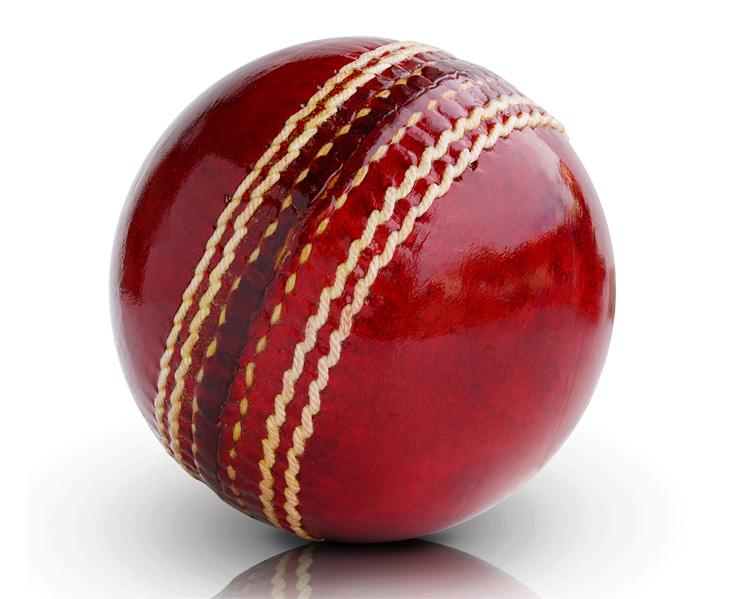

SOURCE 4 Part of Cricket Australia’s 2017–2022 strategy was to be No. 1 in all formats of the game. Goals such as this are often in conflict with other rules and policies, which can create ethical dilemmas for athletes.
In reality, however, certain aspects of the rules, policies or goals of a club or sport may conflict with, or contradict, each other, making what should be a simple decision much harder. In the case of the Australian ball-tampering scandal, Steve Smith faced an ethical dilemma because of the immense pressure on him to deliver a win for Australia. While Cricket Australia has strict rules and policies in place regarding cheating, they also widely promote the goal: "Elite players and teams – No. 1 in all formats". As a result, Smith was under intense pressure, both on and off the field, to win the match in South Africa. When Smith chose to ignore the actions of Warner and Bancroft, he prioritised winning the match over following the rules.
Stage 3 – Evaluate alternatives
Stage 3 of the ethical decision-making framework requires you to consider and evaluate a range of strategies or courses of action. Source 2 provides you with a range of questions to ask in developing and refining potential ethics strategies. In this stage you should reflect on your values, principles and morals to ensure that the options you consider are ethical. You will also need to consider if any of your values are in conflict with one another (e.g. your loyalty to a teammate who may be planning to do something unethical and your honesty, which obliges you to report that behaviour).
When evaluating all potential ethics strategies, you are aiming to identify strategies that produce more good outcomes than bad (i.e. strategies that serve the community as a whole, treat people fairly and equitably, encourage other players to act with integrity and promote positive engagement). It is also important to ensure that the rights of all stakeholders are recognised so that you don’t accidentally discriminate against a group.
Breaking the rules "just once" and "bending the rules a little" are examples of behaviours that can lead to what is known as a slippery slope trap
In the case of the Australian ball-tampering scandal, Steve Smith failed to uphold his personal values of honesty, fair play and respect for his opponents. Instead, he chose to show loyalty to his teammates and not report their actions. Had Smith applied the framework and considered the issues it highlights, it’s likely he would have considered a number of different strategies that were more ethical.
Stage 4 – Devise strategies
Stage 4 of the ethical decision-making framework requires you to decide on the most suitable and appropriate course of action and implement it. It supports you by providing a number of questions (see Source 2).
Your feelings and beliefs about what sport should be (i.e. the purpose of physical activity and sport) are key when committing to one of the strategies you have evaluated in Stage 3. In other words, you need to pick the ethics strategy and course of action you think will best represent your sport, physical activity and context. Consider the effect that your ethics strategy or action would have on the reputation of your sport, physical activity and context if your actions became public knowledge.

SOURCE 5 An emotional Steve Smith addressed the media in Sydney, saying: "I take full responsibility ... There was a failure of leadership, of my leadership. I’ll do everything I can to make up for my mistake and the damage it's caused."
In the case of the Australian ball-tampering scandal, if Steve Smith had chosen to commit to a strategy that aligned with his sense of purpose and belief about what cricket should be (i.e. if he had weighed up whether cricket was more about winning at all costs or more about the honour of competition and the spirit of fair play), it’s likely that he would have chosen a different path. Furthermore, if he had thought about whether he would be prepared to stand by his decision (even if it was not popular), the correct course of action should have been clear. If the situation had been different, Smith may have had time to consult with a trusted ally or "sounding board" to test his decision with them.
Stage 5 – Reflect on the outcome
Stage 5 of the ethical decision-making framework requires you to reflect on your strategy and consider how effective it was. Again, the framework provides questions to support your reflection (see Source 2).
In the aftermath of the ball-tampering scandal, Steve Smith, who lost his captaincy and was dealt a 12-month suspension, had several issues to reflect on, particularly regarding what he would do differently next time. What began as an incident involving a small number of players quickly developed into an international media sensation that sidelined careers, terminated sponsorship deals and damaged the reputation and integrity of the game – both in Australia and internationally. Smith, who was permitted to play Sydney Grade Cricket during his suspension, said he had struggled at times in the fallout from what happened in Cape Town.
"I’ve had my ups and downs. I’ve been really fortunate to have a close group around me that helped me get through those difficult times. There have been some dark days where I haven’t wanted to get out of bed and things like that. I’ve made a mistake and it was a big mistake, and from now on I’m trying to move on from that and improve as a person."
Study tip
Remember that using the ethical decisionmaking framework is a skill that can be learnt, practised and refined. Applying the framework might seem challenging at first, but with practice you’ll be able to move through it confidently. It will help you answer the key question: What is ethical in this situation and what should I do?
Overall, the Australian ball-tampering scandal highlights the need for better education for all stakeholders in all sports across all levels around what constitutes ethical behaviour – and how to respond when faced with ethical dilemmas. The ethical decision-making framework presented in Source 2 provides a way forward for you when you encounter ethical dilemmas in your personal and sporting life.
Check your learning 3.10
Check your learning 3.10
Retrieval and comprehension
1 Choose the correct answer.
Which stage of the ethical decision-making framework involves asking yourself: What would be an ideal or acceptable outcome from implementation of this ethics strategy?
A Stage 2
B Stage 3
C Stage 4
D Stage 5
2 Choose the correct answer.
Investigating an ethical dilemma by determining the facts (Stage 2 of the ethical decisionmaking framework) requires you to ask yourself which question?
A Are there any rules, policies, codes or laws that apply to the ethical dilemma?
B How will the strategy produce more good than harm?
C What is the best course of action when implementing this ethics strategy?
D Did the ethics strategy lead to enhanced integrity and positive engagement?
3 Explain how the ethical decision-making framework can support athletes, coaches and other key stakeholders to make ethical decisions in sport.
Analytical processes
4 Reflect on your "sense of purpose and belief of what sport should be". (Ask yourself, for example: Is winning more important than participating? Is fun and friendship more important than personal gain?) Determine how your personal position aligns with Stage 4 of the ethical decision-making framework and how it might influence the types of strategies you use.
5 Analyse a decision you have made (or an action you have taken) in sport that could be considered an example of the "slippery slope trap". In a 150-
word written response, reflect on how the ethical decision-making framework could help you to avoid making a decision like this again in future.
Knowledge utilisation
6 In 2018, the Board of Cricket Australia commissioned an independent, not-for profit organisation called The Ethics Centre to "undertake a review of the organisational culture and governance frameworks that affect its operations and have a wider impact on men’s cricket in Australia". The findings of the review were published in a report called "Australian Cricket – A matter of balance". Locate a copy of the report online and read pages 4–12 before completing task 7 below.
7 In a 400-word written response, discuss the reasons that led to the unethical behaviour of players such as Cameron Bancroft, David Warner and Steve Smith. Compare the findings of the report against the types of values included on the Sport Integrity Australia website and justify how this situation may have arisen.
8 Develop responses to the ethical dilemmas below by applying the ethical decision-making framework.
a Should male players not be allowed to jump while defending female shooters in mixed netball?
b In an HPE class, should tall players always be divided evenly between teams?
c In tennis, should the winners of an in-class doubles tournament automatically receive the highest marks in the class?
d In HPE classes, should senior classes be timetabled to receive the same access to good indoor courts as younger classes?
Weblink: Sport Integrity Australia
Lesson 3.11
Use the ethical decision-making framework to devise an ethics strategy and evaluate its effectiveness
Aim
• To use the ethical decision-making framework to devise an ethics strategy (in response to an ethical dilemma) that increases integrity and optimises engagement in a physical activity.
• To evaluate the effectiveness of the ethics strategy using primary and secondary data.
Time
1 lesson (i.e. 60 minutes) with additional time (if required) to complete analysis and discussion tasks.
Equipment
• Netball equipment (balls, bibs etc.) and playing facilities (courts)
• Game Performance Assessment Instrument 5 (GPAI 5)
• A copy of the ethical decision-making framework
• Clipboard
• Pen Game Performance Assessment Instrument 5 (GPAI 5)
Additional resource: Ethical decision-making framework
Note to teachers
This activity can be applied to a number of different "Net and court" or "Invasion" physical activities. If students are unfamiliar with the rules of netball (or if equipment and playing facilities are unavailable), you can substitute a game of your choice.
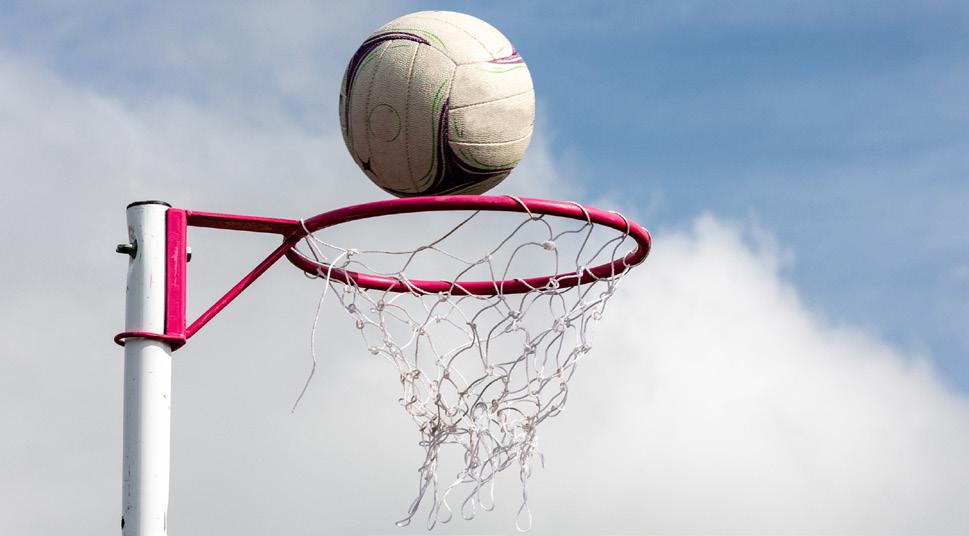
SOURCE 1 Playing a game of netball without an umpire can create a number of ethical dilemmas.
Method
Step 1
Form teams of seven and familiarise yourself with the rules of netball.
Step 2
Take part in a teacher-led warm-up.
Step 3
Your teacher will now explain the rules of netball (if required). Participate in a game of netball for 10 minutes (Game 1). There should be no umpire for this game.
Step 4
At the end of play, complete the column in GPAI 5 titled "Game 1" (Parts A and B), taking care to:
• identify an ethical dilemma you faced during the game. Express the ethical dilemma as a "should" question (e.g. "Should I abide by the stepping rule if there is no umpire present to enforce it?" or "Should I ensure I maintain a space of 0.9 metres [3 feet] between me and my opponent when in defence to optimise fair play and integrity?")
• describe how you responded to the dilemma
• use the five-point self-assessment scale to record your thoughts and feelings about other aspects of the game (where 1 = low/negative; 5 = high/ positive).
Step 5
With the other members of your team, discuss the different ethical dilemmas that you each identified in Game 1. As a group, pick one of these ethical dilemmas and use the ethical decision-making framework to devise an ethics strategy that you believe will address this ethical dilemma in order to increase integrity and optimise engagement in Game 2.
Step 6
Complete the column titled "Game 2", taking care to:
• record your ethics strategy (in the top row)
• identify an ethical dilemma you are attempting to respond to (in Part A).
Step 7
Participate in a second game of netball for 10 minutes (Game 2). Again, there should be no umpire for this game. Throughout the game, you and your team should attempt to implement your ethics strategy.
Step 8
At the end of play, complete Part B of the column titled "Game 2", taking care to use the five-point selfassessment scale to record your thoughts and feelings about aspects of the game (where 1 = low/negative; 5 = high/positive).
Analysis and discussion tasks
1 Analyse your primary data and determine how your responses to the ethical dilemma changed between Game 1 and Game 2.
2 Reflecton how the personal values you identified in Question 4 of Check your learning 3.4 (page 118) align with your responses in Part B of Game 1. Discuss reasons for this.
3 Compare the "Level of personal integrity" ratings you gave yourself in Game 1 and Game 2. Using examples, discuss reasons why this rating changed/stayed the same.
4 Synthesise the primary data you have collected with secondary data gathered online and evaluate the effectiveness of your ethics strategy for enhancing integrity and optimising class engagement. Provide examples to support your response.
5 Reflecton the effectiveness of your team’s ethics strategy. Using evidence from your primary and secondary data, justify whether you think you should maintain your strategy or modify it.
SOURCE 2 GPAI 5
Lesson 3.12 Assessment support – Internal assessment 2: Investigation – report
Overview of Internal assessment 2: Investigation – report
As part of your assessment for Unit 3 of the QCE Physical Education syllabus, you will be required to complete an Investigation – report.
This part of the module is designed to support you as you complete your Investigation – report. It provides a structured explanation of what is required in the task and offers practical tips and suggestions to help you perform at your best. The Investigation –report requires you to research an ethical dilemma relevant to a class, school or community sport or physical activity context by collecting, analysing and synthesising primary and secondary data to devise an ethics strategy.
In its purest sense, an ethical dilemma is a situation in which a difficult choice must be made between two options, even though neither option will result in an outcome that is ethically or morally acceptable. In practice, an ethical dilemma in the context of sport and physical activity is any problem or situation that causes tensions between stakeholders' values and compromises the ethical principles of integrity and fair play.
An ethics strategy is any plan of action created with the goal of promoting ethical values, ethical behaviours and fair play.
Source 1 will help you revise these concepts and consider the ethical dilemma you will choose as the focus of your Investigation – report.
Example of ethical dilemma
• Students not feeling safe when participating or being involved in HPE lessons
• Talented athletes missing out on representative school sport opportunities because of the costs of the activities and/or programs
• Community sport programs that exclude athletes with a disability or fail to provide appropriate equipment or technology
ethical dilemmas situations in which a difficult choice must be made between two options, when neither option will result in an outcome that is ethically or morally acceptable; in Physical Education, ethical dilemmas are determined by the interactions between your values and principles, and your purpose for engaging in physical activity ethics strategies any plans of action created with the goal of promoting ethical values, ethical behaviours and fair play
Example of ethics strategy
• Developing a policy to safeguard young athletes in school sports and community sports programs
• Investigate and provide funding or support to make engagement more equitable
• Engage in education and awareness initiatives to promote inclusivity and diversity in class, school and community sports
SOURCE 1 This assessment task requires students to devise an ethics strategy about an ethical dilemma relevant to a class, school or community physical activity context.
The Investigation – report will be assessed and marked against an instrument-specific marking guide (ISMG). This means that all parts of the task must be completed to maximise your chances of success. Detailed information on how to structure, create and present your Investigation – report is provided in Lesson 1.5 Tips for success on the Investigation – report (page 13). In addition to this, Lesson 1.6 Skill drill: Creating and presenting an Investigation – report on Oxford Digital provides a number of useful tips and instructions to help you.
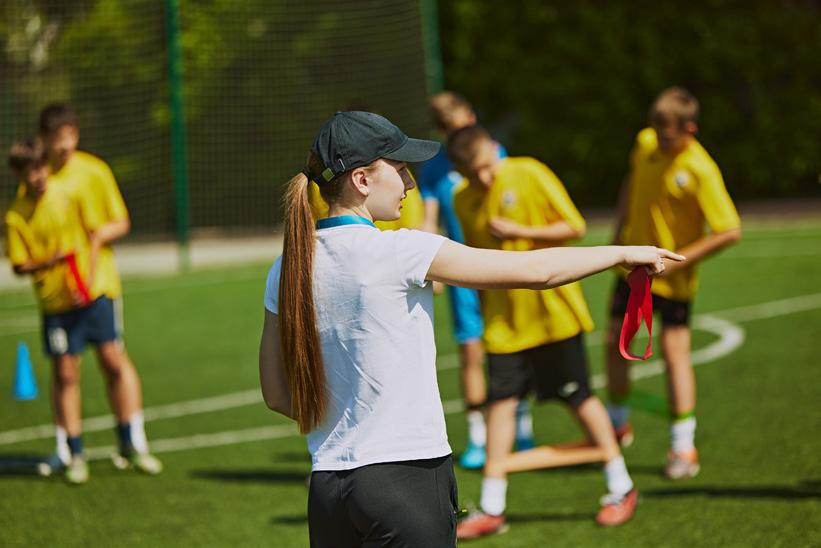
You may find it helpful to complete the Investigation – report in two sections. We will model one possible approach for completing the task, as follows.
• Section 1 – Conduct research
• Section 2 – Present your findings in report format
Section 1 – Conduct research
Section 1 of this task requires you to complete a number of steps in your research. You will need to:
• define an ethical dilemma relevant to a class, school or community physical activity context
• gather and analyse primary and secondary data relating to the ethical dilemma
• devise an ethics strategy to optimise access and positive engagement, justifying the course of action
• evaluate the ethics strategy.
At each step, we will provide an example of what this might look like in action for a student completing their Investigation – report.
As you conduct these stages of research, you should refer to the ethical decision-making framework (Source 2 in Lesson 3.10 The ethical decision-making framework, page 154). The framework will pose a number of relevant questions and will help you ensure that you are considering the issues from all angles. Source 2 will help you align the stages of your research to the relevant stage of the ethical decision-making framework.
Stages of ethical decision-making framework
Define an ethical dilemma relevant to a class, school or community physical activity context
Gather and analyse primary and secondary data relating to the ethical dilemma
Devise an ethics strategy and justify the course of action
Evaluate the ethics strategy
Stage 1 – Identify the ethical dilemma
Stage 2 – Find information Stage 3 – Evaluate alternatives
Stage 4 – Devise strategies
Stage 5 – Reflect on the outcome
Step 1 – Define an ethical dilemma relevant to a class, school or community physical activity context
As noted above, in the context of sport and physical activity, an ethical dilemma is any problem or situation that causes tensions between stakeholders' values and compromises the ethical principles of integrity and fair play. To begin your investigation, you will need to identify and define an ethical dilemma that exists within a class, school or community physical activity context.
You may have a specific ethical dilemma in mind; if so, once you have defined it, you will need to select a relevant class, school or community context to frame it.
Alternatively, you may like to select the class, school or community context first, and then identify and define an ethical dilemma that exists within it. Once you have identified an ethical dilemma and decided on the context (i.e. class, school or community) you will need to express it as a "should" question. Below is an example for each possible context.
SOURCE 2
Stages of research
Class context
• Ethical issue: Some of the less experienced and less capable students do not feel safe playing direct intercept sports such as basketball and soccer when matched up against the stronger, bigger and faster students, especially when the teacher allows the games to become overly competitive and rough.
• "Should" question: Should our class devise a set of rules or guidelines around team composition in HPE classes to promote inclusive, fair play?
School context
• Ethical issue: Some of the most talented athletes are selected for school representative teams but miss out on attending because of the costs associated with competition, travel and accommodation.
• "Should" question: Should our school provide financial support to athletes who cannot afford the costs associated with representative sport?
Community context
• Ethical issue: Some community sports clubs unwittingly exclude athletes with a disability by failing to provide adequate accessibility, equipment or other resources.
• "Should" question: Should community sporting organisations be held to account to ensure they are inclusive of people of all levels of ability?
Example
David, a Year 11 student, has just moved to Queensland from Victoria, where he was playing basketball at a representative level in the wheelchair basketball club competition and as a member of the State Development Program (SDP). On David’s first day at his new school, he asks about playing wheelchair basketball through the school sport system and is advised that the school does not offer team-based wheelchair sports because there are not enough students to make a team. If he wants to be active, he can engage in wheelchair athletics. Otherwise, he will have to seek team sport options via the local club system.
It becomes clear to David that his new school lacks the resources, expertise and inclusive structures to accommodate his needs. David believes this is an ethical dilemma because he should have the same right to play organised school-based team sport as his peers. He has the same rights to the social and emotional benefits associated with organised team sport, especially the camaraderie and joy that comes from teamwork. He believes that the school’s failure to provide inclusive team sport opportunities can perpetuate negative attitudes and discrimination towards people with disabilities.
He articulates this and then frames his ethical dilemma in the following "should" question: "Should all school sport programs provide students with disabilities access to organised team sport opportunities across all categories of disability?"
Step 2 – Gather and analyse primary and secondary data relating to the ethical dilemma
Once you have defined your ethical dilemma, you are required to investigate it by gathering a range of relevant primary and secondary data. You will then be required to analyse and synthesise this data to help you devise an ethics strategy that appropriately addresses the dilemma.
Study tip
Creating a table is an easy way to compare the pros and cons of possible strategies (or courses of action) and decide on the best one. A table like this can also be included in your report as an appendix as evidence of your research.
The data you gather and analyse should help you explore the relationships between:
• the ethical dilemma
• barriers and enablers
• personal, social, cultural and environmental factors that result in limited access to personal, social and community resources in the class, school or community physical activity context
• strategies that have been used in response to similar ethical dilemmas.
Through your analysis of the above relationships, you will be able to home in on the most significant needs of the individuals within the given context. The primary data you gather will need to show that the ethical dilemma has an impact on people in the class, school or community physical activity context you have selected.
Example
David thinks about the most relevant types of primary data he could collect and refers to the ethical decisionmaking framework to read about a range of questions that will guide his thinking. He decides that the best way to collect primary evidence related to the ethical dilemma is to conduct three surveys:
1 a survey that asks all students about their beliefs concerning their rights to have fair and equitable access to the benefits associated with organised team sport

2 a survey of the teachers to ascertain their beliefs concerning students rights, as above
3 a survey of a range of similar schools about their team sport offerings for students with a disability.
At the same time, David researches online for:
• national and state legislation (law), guidelines and policies on giving individuals with disabilities access to sporting opportunities, specifically team sport
• Queensland Education and Queensland Representative School Sport guidelines concerning student access
• evidence of best practice, i.e. schools in Queensland or interstate that are showing how this can be done well.
Step 3 – Devise an ethics strategy and justify the course of action
In response to the "should" question, you will need to create an ethics strategy which will best serve the class, school or community and their access to physical activity. An ethics strategy is any plan or course of action that aims to value or celebrate personal, social and cultural differences in society, especially as they relate to physical activity. It is essential that the strategy directly addresses the needs identified through your analysis in the preceding steps. If you can methodically outline how your strategy addresses the established needs, this will enable you to show or prove your strategy to be right or reasonable; that is, it will enable you to justify your strategy, which is a key requirement of the task and the ISMG.
It is useful to be able to implement a version (or aspects) of this strategy, if possible, so that you can collect more primary data that further justifies the development of the strategy.
If your context does not allow for the implementation, your secondary data can be used to analyse similar devised strategies and determine the best course of action.
Example
After analysing and synthesising all the primary and secondary data, David devises an ethics strategy for his school to implement, consisting of three elements. David will work with his school’s sports department to:
1 Devise a mission statement concerning inclusive school sport. This statement will be available on the school’s sports portal and celebrated at an assembly.
2 Run an awareness campaign on inclusive sport, particularly team sport. This will involve an information evening and "think tank" on the need for schools to create opportunity and access when existing structures or resourcing are a barrier. The result will be a list of initiatives that schools can put in place.
3 Set a 12-month goal to meet a target of 70 per cent of the initiatives and have key stakeholders sign this goal statement.
While David knows that he cannot implement all of this in the timeframe of the assessment task, he arranges two meetings with his school’s sports department with the view to drafting the mission statement. This will allow him to gather some primary data to justify the development of his strategy.
Step 4 – Evaluate the ethics strategy
To evaluate the effectiveness of the ethics strategy you have developed, you will need to consider:
• the potential outcome of the strategy – you will need to use the data to predict whether the ethics strategy you have devised will be effective within your context and explain why
• the potential limitations of the strategy – you will need to predict whether the ethics strategy may encounter any issues.
Example
David reflects on his strategy and gathers feedback from the sports department after their two meetings. He also reviews his journal entries over the course of the unit. He concludes that his ethics strategy has the potential for positive outcomes such as increased access for students with a disability to the benefits associated with team sport. He also identifies that changes to the school’s staffing and resources might limit the ongoing success of this strategy. He backs up these conclusions with primary and secondary data.
Section 2 – Present your findings in report format
Unlike the Project – folio, your Investigation – report needs to follow a specific format. Lesson 1.5 Tips for success on the Investigation – report (page 13) describes in detail the structure of the report you will need to write and what you need to include in each section. It also provides a number of tips and suggestions for referencing and crediting sources in your report.
3 MODULE
Lesson 3.13 Review: Ethics and integrity
Module summary: Module 3
• Ethics is a set of principles and values that help us to judge what is morally "good" or "bad"; "right" or "wrong". A system of ethics usually develops between members of particular social groups (e.g. friends, families, social or sporting clubs, communities, societies and nations) over a period of time until they become a set of accepted norms (i.e. normal, typical, expected or accepted behaviours).
• Integrity is the quality of being honest and having strong morals and personal values.
• Ethics and integrity help to promote positive engagement in sport and physical education (i.e. participation that sets a good example, both for those who play and watch the sport, and for the wider community).
• Sporting clubs and codes set expectations around ethical behaviours and provide ongoing training and support to stakeholders. Many clubs and teams use the following tools to support and encourage ethical behaviour:
– a code of conduct
– a code of behaviour.
• Fair play means following the rules of competition and showing respect, fairness, friendship and tolerance to others (both on and off the field).
• The elements of fair play include: observing rules; demonstrating appropriate attitudes and behaviours; eliminating forms of exploitation; fair competition and equality; respect; team spirit; and respect for written and unwritten rules.
• Personal values are the principles, standards of behaviour and qualities that every person relies on to help them guide how they live their life. When it comes to sport and physical activity, a number of different factors can influence the development of someone’s personal values.
• Ethical values is a term used to describe a specific group of principles, characteristics or standards of behaviour that most people in a community or society would associate with ethical behaviour.
• Ethic strategies are any plans of action created with the goal of promoting ethical values, ethical behaviours and fair play. More often than not, ethical strategies include a number of tools designed to help the strategy succeed. These tools include things such as: – codes of behaviour and codes of conduct – rules and policies (including risk management).
• Globalisation in sport is the process by which sporting organisations (e.g. clubs, teams, sporting codes) begin to operate on an international scale and/or develop international influence (i.e. financial, social, cultural).
• Mass media is a term used to describe a collection of technologies that are used to communicate messages to very large numbers of people.
• An ethical dilemma is a situation in which a difficult choice must be made between two options, even though neither option will result in an outcome that is ethically or morally acceptable.
• In sport, most ethical dilemmas relate to one of the following areas: gender inclusion or exclusion; ability; enhancements in technology and equipment; corruption.
• The ethical decision-making framework is a tool used to help people analyse and respond to ethical dilemmas.
Review questions 3.13 Exam-style revision questions and tasks
Section 1
• Ten multiple-choice questions
Question 1
Ethics is
A a decision-making framework.
B a set of rules for living life.
C a set of principles and values that help us to judge what is morally "good" or "bad"; "right" or "wrong".
D a code of conduct.
Question 2
An ethical dilemma is any situation in which
A a person must make a difficult decision.
B a difficult choice must be made, when no available option will result in an outcome that is acceptable.
C a difficult choice must be made that breaks any written or unwritten rule.
D a person must make a decision somebody else does not agree with.
Question 3
Which of the following groups has the most significant impact on the development of personal values by children and young people?
A Family
B Peers
C Coaches
D School and community
Question 4
In simple terms, globalisation
A generally has a negative effect on ethics.
B results in the increased involvement of global media companies in sport.
C is a process that results in the economies, societies and cultures of different regions becoming more interconnected.
D is responsible for the increased financial value of sporting clubs.
Question 5
In a sporting context, codes of conduct and codes of behaviour both
A recognise ethical behaviour.
B restrict player involvement.
C contain values that stakeholders are expected to conform to over time.
D set and communicate values and outline acceptable and unacceptable behaviours and attitudes.
Question 6
Stage 1 of the ethical decision-making framework is:
A Evaluate alternatives
B Find information
C Identify the ethical dilemma
D Devise strategies
Question 7
The globalisation of sport is
A the increased ability of sporting organisations to generate revenue by selling television rights.
B the expansion of regional sports tournaments and competitions to new geographic areas.
C the process by which sporting organisations begin to operate on an international scale.
D the expansion of regional sports tournaments and competitions to new geographic areas.
Question 8
In sport, four of the most common areas in which ethical dilemmas arise are
A gender, mass media, enhancements in technology and equipment, and corruption.
B gender, ability, enhancements in technology and equipment, and corruption.
C gender, ability, enhancements in technology and equipment, and globalisation.
D gender, ability, mass media, competitive coaching and corruption.
Question 9
Mass media can be considered an agent of socialisation. This means it
A has significant influence on ethical values.
B has significant effects on the popularity of various sporting codes.
C can challenge existing stereotypes and promote examples of good sportsmanship.
D can reinforcing inequalities by restricting coverage.
Question 10
Fair play means
A winning at all costs.
B observing rules.
C showing respect and tolerance on and off the field.
D respecting your opponents.
Section 2
• Three short-response questions
Stimulus 1
A memo sent to all coaches at Gumnut State High School from the head coach.
To: All coaches
From: Rob Citizen – Head coach
This season, it is imperative that we see an improvement in our school’s sporting results. Please ensure that you take necessary measures throughout the season to guarantee an improvement in our results across all sports. These measures may include (but are not limited to):
• increasing training times
• playing strongest players whenever possible
• targeting strong opposition players.
Cheers,
Rob
Question 11 (11 marks)
Examine Stimulus 1 and assess whether the strategy outlined by the head coach at this school adheres to the elements of "fair play". Provide examples to justify your response.
Stimulus 2
During a game of Under-12 soccer, a parent verbally abuses an umpire because the parent disagrees with a ruling the umpire has made.
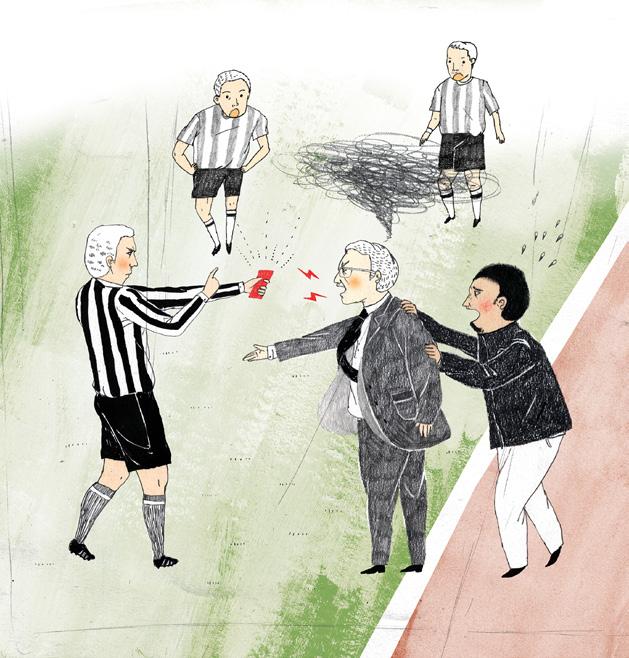
Question 12 (16 marks)
Reflect on Stimulus 2 and assess the potential impact of this parent’s behaviour on their child’s integrity and engagement in physical activity, now and in the future. In your assessment, consider the role of agents of socialisation on the development of personal values.
Stimulus 3
An extract from a newspaper article.
Giro d’Italia: Richie Porte docked two minutes
Barry Ryan
Australian loses time after taking help from Orica-GreenEdge
Richie Porte (Sky) has been docked two minutes by the race jury after he received an illegal wheel change from Orica-GreenEdge’s Simon Clarke following his puncture in the closing kilometres of stage 10 of the Giro d'Italia from Civitanova Marche to Forlì.
UCI rule 12.1.040 prohibits "non-regulation assistance to a rider from another team" with a twominute penalty and a fine of 200 Swiss Francs for a first offence ...
"If that’s not Aussie mate ship then what is?
Punctured and Clarkey gave me his front wheel …" Porte wrote.
Cycling News, 19 May 2015
Question 13 (21 marks)
Examine the data provided in Stimulus 3. Although Australian cyclists Simon Clarke and Richie Porte did not respect the written rules of their sport, discuss whether their actions still support other elements of fair play.
Section 3
• One extended-response question
Stimulus 4
A Year 12 Physical Education class at a coeducational school plays a mixed game of touch football. The following data on ball possession was collected during the game.
Boy with possession Girl with possession
Question 14 (21 marks)
Analyse the data from Stimulus 4 to identify an ethical dilemma faced by the class. Apply the ethical decisionmaking framework to devise an ethics strategy to help optimise integrity and engagement for all.
Practice assessment task
This practice assessment task was prepared according to the specifications in the Physical Education 2025v1.2 General Senior Syllabus. It has not been endorsed by the QCAA.
Subject Physical Education
Instrument number IA2
(i.e. Internal assessment 2)
Technique Investigation – report
Unit 3 Tactical awareness and ethics in physical activity
Topic 2 Ethics and integrity in physical activity
Conditions
Duration 5 hours of class time
Mode Investigation – Report
Length Up to 2,000 words
Individual / Group Individual
Other
The reference list, title page and table of contents are not included in the word count. Schools implement authentication strategies that reflect QCAA guidelines for ensuring student authorship.
Context
Throughout this topic, you have engaged in integrated learning experiences to explore ethics and integrity concepts in a class physical activity context. To enhance positive engagement in physical activity, you have explored how ethical values influence fair play and integrity, and how ethics strategies can be used in response to ethical dilemmas.
Task
Investigate the following ethical dilemma occurring in a school physical activity context:
Students who fail to bring the full school PE uniform will be excluded from participating in the physical performance activity.
Devise one ethics strategy to provide a course of action in response to this ethical dilemma.
Evaluate the effectiveness of the devised ethics strategy to optimise integrity and positive engagement for students in senior Physical Education.
To complete this task you must:
• select an ethical dilemma in a class, school or community physical activity context to devise an
• ethics strategy
• identify the class, school or community physical activity context to frame the investigation
• use the ethical decision-making framework to conduct a context analysis
• define the ethical dilemma
• analyse and synthesise primary data and secondary data to ascertain the most significant
• relationships between the – ethical dilemma
influence of stakeholders on the ethics and values demonstrated in the school physical activity context
tensions that exist in relation to integrity and fair play
strategies that have been used in response to similar ethical dilemmas
• analyse and synthesise primary data and secondary data to devise an ethics strategy that
• provides a course of action in response to the ethical dilemma
• justify the development of the ethics strategy using evidence from primary data and secondary
• data
• evaluate the effectiveness of the ethics strategy to optimise integrity and positive engagement
• in the school physical activity context by appraising the potential outcome
• and limitations
• evaluate the effectiveness of the ethics strategy to optimise integrity and positive engagement
• in the class, school or community physical activity context by appraising the potential outcome
• and limitations
Detailed instructions for this task (including a copy of the ISMG) are available for teachers to download.
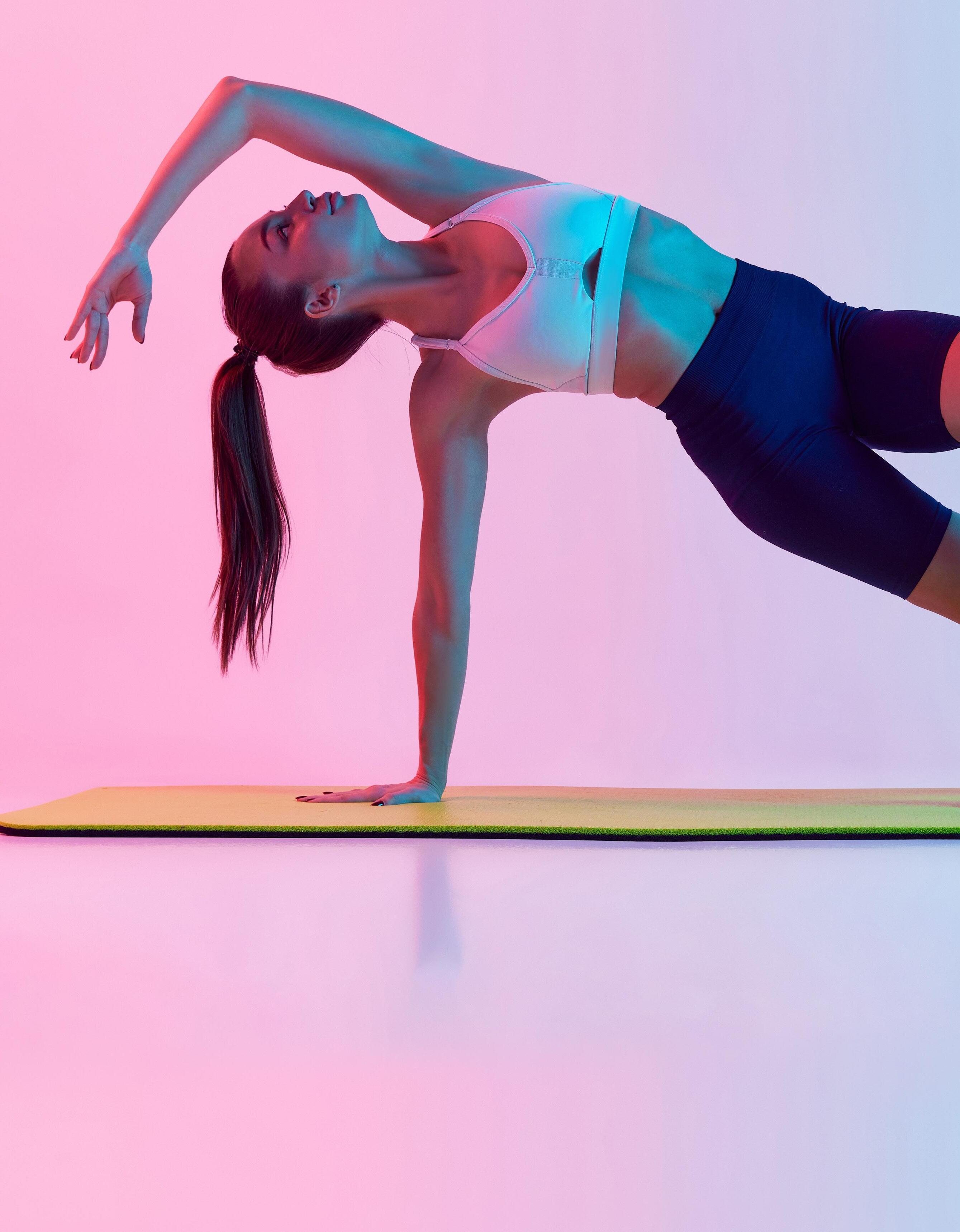
X UNIT 4
Energy, fitness and training in physical activity
Unit 4 objectives
In this unit you will:
1 Recognise and explain energy, fitness and training concepts and principles about physical activity
2 Demonstrate specialised movement sequences and movement strategies in selected physical activities
3 Apply concepts to specialised movement sequences and movement strategies in selected physical activities
4 Analyse and synthesise data to devise a training strategy
5 Evaluate training and movement strategies
6 Justify training and movement strategies
7 Make decisions about and use language, conventions and mode-appropriate features for particular purposes and contexts.
Source: Physical Education 2025 v1.2 General Senior Syllabus © Queensland Curriculum & Assessment Authority
Unit 4 topics
The learning for this unit is covered in one topic. The table below shows how this topic aligns with the modules in this book and lists the notional hours of teaching time.
Topic 1 Energy, fitness and training integrated in physical activity
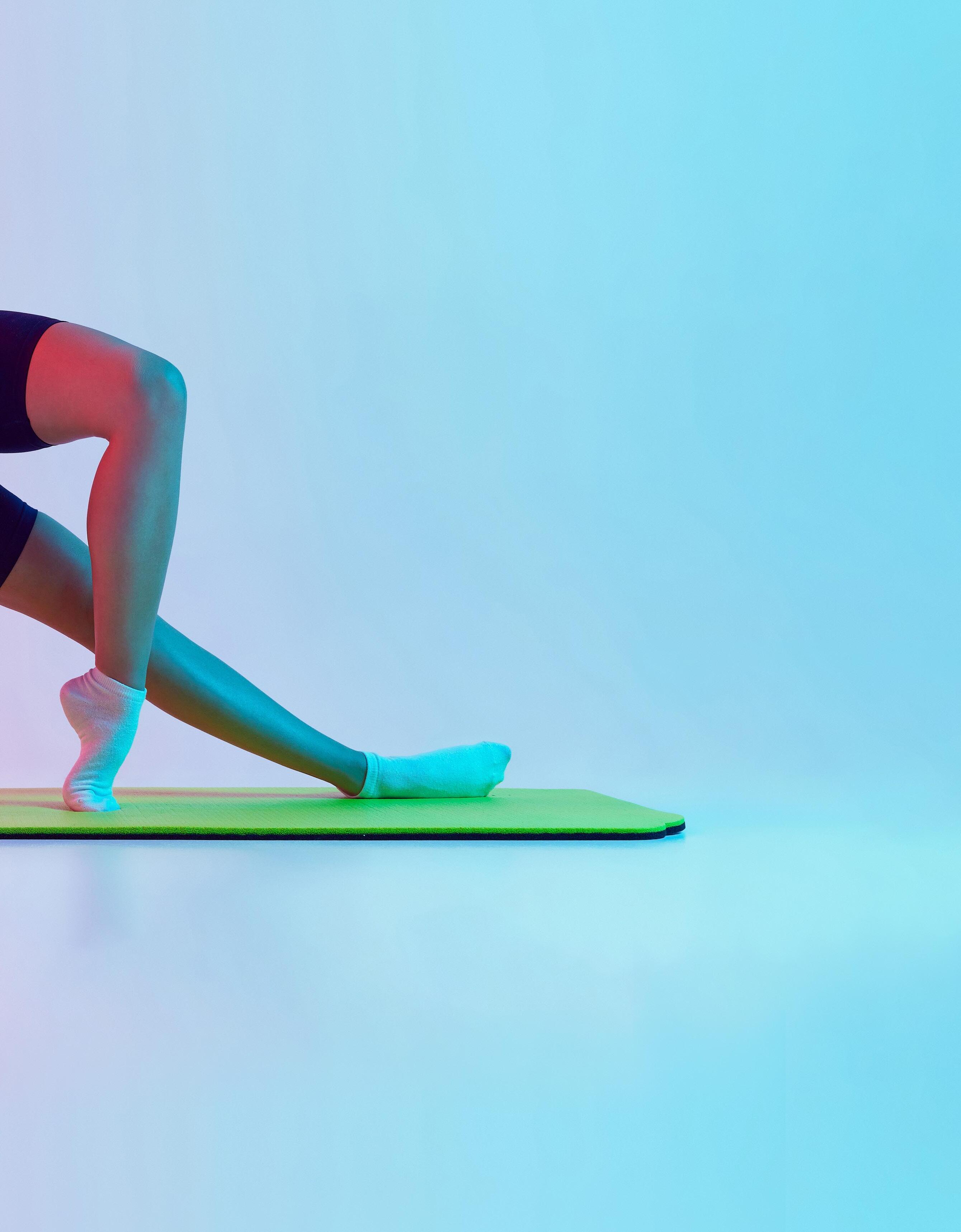
Module 4 Energy, fitness and training (page 174) 55
Note to teachers and students:
To enable the integration of the subject matter of Topic 1 – Energy, fitness and training integrated in physical activity, the physical activity must be selected from the "Invasion", "Net and court" or "Performance" categories. Schools must select a physical activity from a different category to the one chosen in Unit 3.
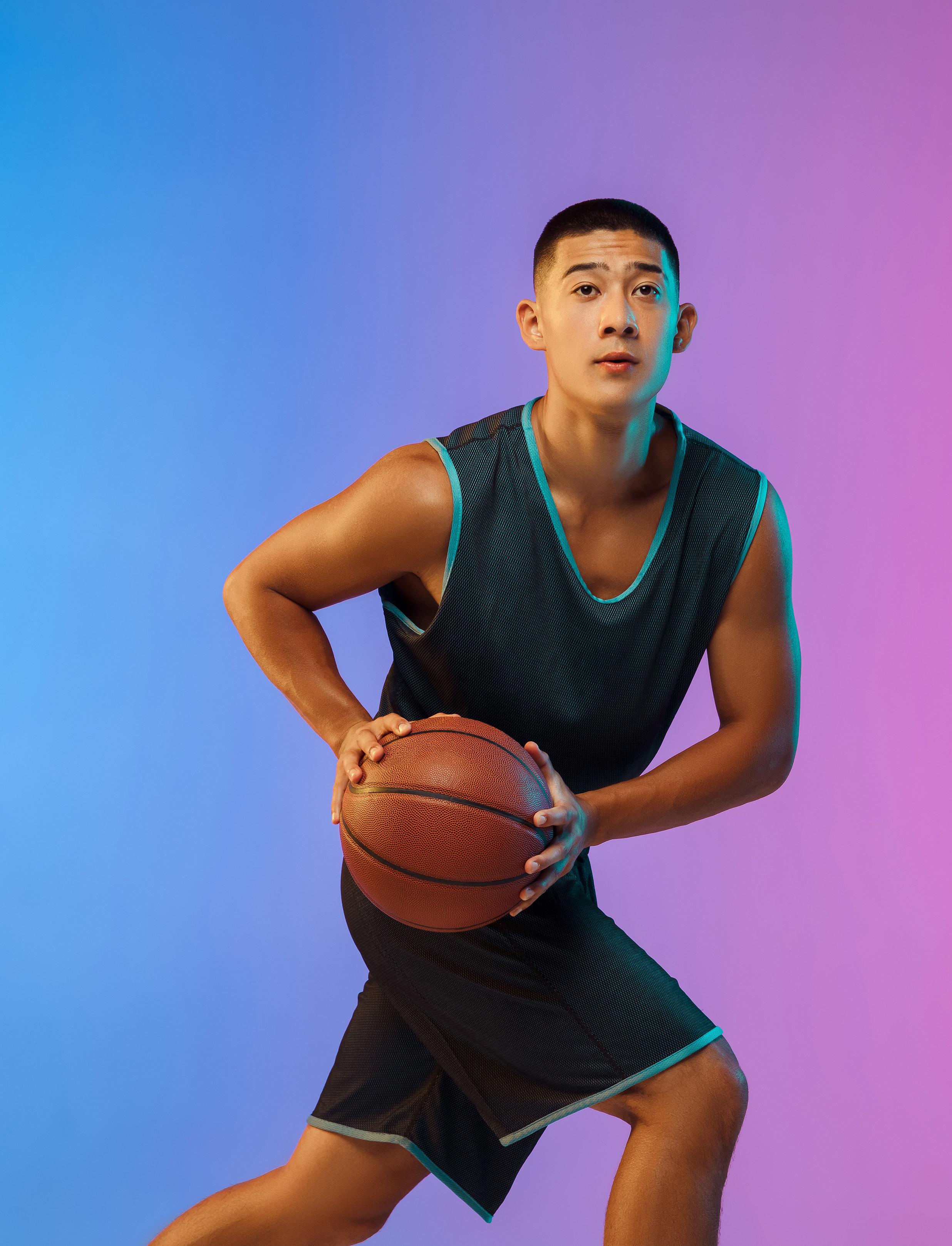
Subject matter outcomes covered in Module 4
The following table lists all the subject matter outcomes you are required to cover in Unit 4 – Topic 1 of the Physical Education General Senior Syllabus. It also shows you exactly where that subject matter is covered in this course. The full syllabus is available on the QCAA website.
Unit 4 – Topic 1: Energy, fitness and training integrated in physical activity
In Unit 4 – Topic 1, students engage with concepts, principles and strategies about energy, fitness, training and physical activity.
Subject matter
• Recognise and explain that energy for physical activity is provided by adenosine triphosphate (ATP).
• Recognise and explain that energy requirements for physical activity
involve an ongoing process of ATP resynthesis using various fuel sources
• Recognise and explain that energy requirements for physical activity – are provided by the interplay of three different pathways, known as energy systems
– are dependent on the intensity and duration of exercise.
• Recognise and explain which energy systems are used in a range of physical activity contexts. Energy systems include
– ATP–PC – provides energy anaerobically, without oxygen, for high intensity, short duration exercise
– lactic acid – provides energy anaerobically, without oxygen, for high intensity, moderate duration exercise, where ATP is resynthesised using muscle glycogen as the fuel, with resulting lactate formation
– aerobic – provides energy aerobically, with oxygen, for sub-maximal intensity, longer duration exercise.
• Recognise and explain how fitness requirements for physical activity are classified as components of fitness and include aerobic capacity, muscular endurance, speed, strength, power, flexibility and agility.
• Recognise and explain physiological responses to training, including
VO2 max
lactate threshold
– lung capacity
– the effects on slow- and fast-twitch muscle fibres
– hypertrophy
– stroke volume
– cardiac output.
• Identify and explore the energy requirements for specialised movement sequences and movement strategies in physical activity by analysing
– how ATP is resynthesised and transferred during performance
– the contribution ratios and interplay of the different energy systems during performance.
• Identify and explore the fitness requirements for physical activity contexts by considering the components of fitness necessary for the specialised movement sequences.
Lesson/s
Lesson 4.2 Energy requirements for physical activity (page 181)
Lesson 4.2 Energy requirements for physical activity (page 181)
Lesson 4.3 Energy systems used in physical activity (page 189)
Lesson 4.3 Energy systems used in physical activity (page 189)
Lesson 4.4 Fitness requirements for physical activity (page 200)
Lesson 4.6 Physiological responses to training (page 212)
Lesson 4.3 Energy systems used in physical activity (page 189)
Lesson 4.4 Fitness requirements for physical activity (page 200)
Subject matter
• Recognise and explain the application of the principles of training in physical activity, including
– progressive overload – the planned, gradual increase in training load to ensure that fitness continues to be optimised
– frequency – the number of times training occurs in a given period
– reversibility – the reversal of adaptations due to a cease in training or training load
– intensity – the magnitude of exertion required
– duration – the length of training time
– specificity – relevant to the energy system, position-specific movements and fitness requirements of an activity
– individuality – considerate of personal needs, goals, fitness levels, motivation and skills
– variety – the inclusion of a range of movement options, activities and contexts in training.
• Identify and explore the application of training methods for physical activity, including
– flexibility training – to enhance the motion of the body’s joints
– resistance training – to enhance muscular strength, power and muscular endurance
– variations of interval training – manipulation of work periods and rest periods to enhance specific components of fitness and enhance the aerobic, lactic acid and ATP–PC energy systems, e.g. high-intensity interval training (HIIT), sprint interval training (SIT), aerobic interval training
– circuit training – to enhance specific components of fitness
– continuous training – to enhance aerobic capacity
– fartlek training – to enhance aerobic capacity.
• Recognise and explain how the application of different training phases can be sequenced to form an annual plan, known as periodisation, that includes the preparatory phase, precompetition phase, competition phase and transition phase.
• Recognise and explain how the different parts of an annual plan can target a specific or series of energy and/or fitness requirements within a designated period of time; the parts include
– mesocycles – a training period of generally 4–6 weeks with a specific training focus
– microcycles – a shorter training period, generally one week, with a more specific training focus and made up of a number of training sessions
– training sessions – the organised description of activities within an identified time frame.
• Recognise and explain the features of a training program, including – specific training objectives to achieve a determined outcome – game analysis – work volume, frequency, intensity and duration of exercise
– tapering and recovery to achieve the determined outcome for a particular phase.
• Recognise and explain the features of a training session, including
warm-up – e.g. RAMP (raise, activate, mobilise and prepare) approach designed to
raise body temperature, heart rate, respiration rate and joint viscosity
– activate and mobilise key muscle groups, joints and range of motion
– prepare for exercise by incorporating dynamic stretching
– conditioning phase – specifies the relevant fitness components being developed, training methods used, intensity and volume of work, work:rest (W:R) ratios and repetitions, while following relevant training principles
– cool down – gentle cardiovascular exercise and stretching designed to gradually reduce heart rate, body temperature, remove waste products and relax muscles.
• Recognise and explain the importance of recovery in training, including active recovery, to allow the body to overcome the effects of fatigue and increase readiness for competition or future training.
Lesson/s
Lesson 4.12 Principles of training (page 236)
Lesson 4.13
Training methods (page 243) to Lesson 4.19 Circuit training (page 268)
Lesson 4.21 The theory of periodisation (page 277)
Lesson 4.21 The theory of periodisation (page 277)
Lesson 4.10 Training requirements for physical activity (page 277)
Lesson 4.22 Developing a training program (page 288)
Lesson 4.24 Developing a training session plan (page 300)
Lesson 4.20 Fatigue and recovery in training (page 271)
Subject matter
• Gather primary data about personal energy, fitness and training requirements for specialised movement sequences and movement strategies in authentic performance environments.
• Use primary and secondary data to
– analyse how energy, fitness and training concepts and principles can influence performance in physical activity.
– ascertain the most significant relationships between the training strategy, energy, fitness and training concepts and principles, and personal performance of the specialised movement sequences and movement strategies.
• Analyse and synthesise primary data and secondary data about
– position- or event-specific fitness testing of the relevant components of fitness to identify personal performance capacities
– specialised movement sequences and movement strategies in authentic performance environments to identify the frequency, direction, intensity and duration of movements
– work:rest (W:R) ratios
– target heart rate (THR) and maximum heart rate (MHR) to identify training zones.
• Optimise performance in physical activity by devising one personal training strategy for a mesocycle or microcycle that considers the – components of fitness and energy demands of the physical activity – relevant training methods, principles of training and recovery principles – personal performance of specialised movement sequences and movement strategies
– training objectives to achieve a determined outcome.
• Justify the development of the training strategy and movement strategies using evidence from primary data and secondary data.
• Implement sessions from the training strategy to gather primary data about the outcomes and limitations of decisions.
• Reflect on primary data and secondary data to evaluate the effectiveness of the training strategy to achieve a determined outcome including
meeting the energy and fitness requirements of the physical activity
using relevant training principles, training methods and recovery principles
optimising performance of the specialised movement sequences and movement strategies.
• Make decisions to maintain or modify the training and movement strategies using evidence from primary and secondary data.
• Justify maintenance or modification of the training strategy using evidence from primary data and secondary data.
Lesson/s
Lesson 4.5 Skill drill:
Determine your fitness profile (page 210)
Lesson 4.7 Skill drill: Determine your VO2 max (page 221)
Lesson 4.8 Skill drill: Determine your lacate threshold (page 223)
Lesson 4.9 Skill drill: Analyse your heart rate recovery (page 225)
Lesson 4.23 Skill drill: Conduct a game analysis (page 296)
Lesson 4.25 Skill drill: Determine your initial training values (page 311)
Module 4 Energy, fitness and training
Lesson 4.5 Skill drill: Determine your fitness profile (page 210)
Lesson 4.7 Skill drill: Determine your VO2 max (page 221)
Lesson 4.8 Skill drill: Determine your lacate threshold (page 223)
Lesson 4.9 Skill drill: Analyse your heart rate recovery (page 225)
Lesson 4.23 Skill drill: Conduct a game analysis (page 296)
Lesson 4.25 Skill drill: Determine your initial training values (page 311)
Lesson 4.27 Review: Energy, fitness and training (page 326)
Source: Physical Education 2025v1.2 General Senior Syllabus © Queensland Curriculum & Assessment Authority
Learning intentions and success criteria
energy (in the context of sport and physical activity)
power derived from fuels (e.g. foods we eat) and used by the body to perform basic bodily functions and produce movement
fitness a term used to describe the condition of being physically fit and healthy, as well as a person’s ability to participate effectively in a particular sport or physical activity
training (in the context of sport and physical activity) the specific tasks an individual completes to enhance their energy and fitness in preparation for their chosen physical activity
exercise physiology a specialised field of physiology that studies the short- and long-term effects of exercise on the human body
physiology a field of science that studies the functions and mechanisms at work within living organisms (e.g. humans, animals and plants)
Lesson 4.1 Introduction to energy, fitness and training
Key ideas
→ Energy is a term used to describe the power derived from fuels (i.e. food) by a range of systems and chemical reactions that take place in the body in order to produce movement.
→ Fitness is a term used to describe the body’s ability to function efficiently and effectively.
→ Training is a term used to describe the specific tasks and activities an athlete completes to enhance or improve their energy and fitness in their chosen physical activity.
→ The study of energy, fitness and training in sport is known as exercise physiology.
Defining energy, fitness and training
Energy, fitness and training are three concepts that underpin the study of sport and physical activity. A thorough understanding of the role that each of these concepts plays in physical activity and performance – together with an appreciation of how all three concepts interrelate – is vital for athletes to maximise their potential and perform at their best.
It’s common to hear all three terms being used in everyday conversation, but in the context of sport and physical activity, they have quite specific definitions:
• energy – the power derived from fuels (i.e. food) by a range of systems and chemical reactions that take place in the body in order to produce movement
• fitness – the body’s ability to efficiently and effectively participate in physical activity
• training – the specific tasks and activities an athlete completes to enhance or improve their energy and fitness in their chosen physical activity.
The study of energy, fitness and training in sport is known as exercise physiology. Exercise physiology is a specialised branch of physiology that studies the body’s response to all types of physical activity (including changes in metabolism and the structure and function of organs such as the heart, lungs and muscles). Exercise physiologists work with athletes to:
• develop exercise and training programs that will help them optimise their physical performance, tailored to their chosen sport if appropriate
• avoid injury during training and performance
• design recovery and rehabilitation programs in the event of injury.
To do this, they gather information about the athlete and their chosen sport to tailor training strategies to suit their individual needs and environment. Training strategies can also be tailored to specific events or competitions that athletes are planning to participate in to ensure their performance peaks at the right time.
The continued demand for athletes at all levels to be better, faster and stronger means that a sound understanding of the concepts of energy, fitness and training is essential for all athletes. Not only will it help you get the most out of your training and optimise your performance in your chosen physical activity, but it will also help you train safely and avoid injury.
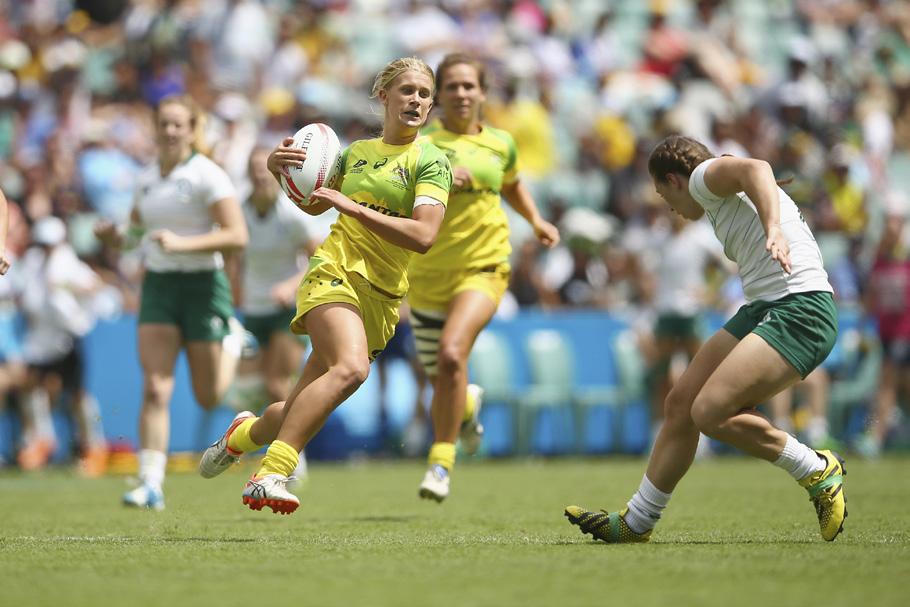
SOURCE 1 The study of energy, fitness and training in the context of sport and physical activity is known as exercise physiology. It is a specialised branch of physiology that studies the body’s response to all types of physical activity.
As shown in Source 2, in this module you will learn in detail about each aspect of energy, fitness and training.
Lessons
Energy
Lesson 4.2 Energy requirements for physical activity (page 181)–Lesson 4.3 Energy systems used in physical activity (page 189)
Fitness
Lesson 4.4 Fitness requirements for physical activity (page 200)–Lesson 4.6 Physiological responses to training (page 212)
Training
Lesson 4.7 Skill drill: Determine your VO2 max (page 221)–Lesson 4.26 Assessment support –Internal assessment 3: Project – folio (page 314)
Subject matter covered
the role of food as a fuel source in the production of energy
• the role of adenosine triphosphate (ATP) in muscular contraction
• the role of energy systems in the resynthesis of ATP
• the interplay of energy systems in the resynthesis of ATP
fitness requirements for physical activity – specifically, the components of fitness
• physiological responses to training, including VO2 max, lactate threshold, lung capacity, the effects on slow- and fast-twitch muscle fibres, hypertrophy, stroke volume and cardiac output
• conducting a game analysis to understand the energy and fitness requirements of specialised movement sequences for individual athletes and/or particular sports and physical activities
principles of training for physical activity
• training methods
• fatigue in training
• recovery in training
• training phases and training cycles in the annual plan
• setting training objectives
• devising training strategies
SOURCE 2 In Unit 4 – Topic 1 of QCE Physical Education, you will learn about the aspects of energy, fitness and training listed above.
At the end of the module, you will be provided with assessment support designed to help you complete Internal assessment 3: Project – folio (see Lesson 4.26 Assessment support – Internal assessment 3: Project – folio, page 314). This lesson will guide you through the process of devising and evaluating a training strategy. A training strategy is a plan devised to help an individual or team to optimise their performance. The subject matter covered in this module will also be assessed in the external examination.
training strategies plans developed to improve the performance of an athlete or to help them achieve a goal; training strategies consider the personal requirements of an athlete (e.g. their individual physical and mental characteristics) as well as the requirements of their chosen physical activity (e.g. the physical demands, skills, strategies and techniques needed)
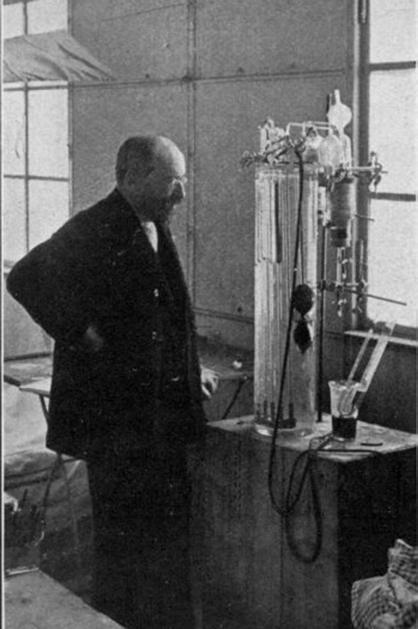
The human body has been studied for thousands of years, but the field of science known as exercise physiology is relatively new. One of the pioneers of exercise physiology was a German scientist by the name of Nathan Zuntz. In 1889, Zuntz invented a respiratory apparatus attached to one of the earliest examples of a motorised treadmill. This invention made it possible for exercise physiologists to gather information (in a controlled manner) about how the human body uses oxygen during exercise.
Zuntz later added an X-ray apparatus to his exercise machine, which enabled him to determine the changes in heart volume during exercise. He also built a climate chamber to study exercise under varying – and sometimes extreme – temperatures.
Zuntz’s inventions resulted in huge advances in the study of the body’s responses to exercise, including research into metabolism, nutrition, respiration, blood gases, exercise and the body’s reaction to high altitudes. Many of Zuntz’s studies were so pioneering that the results are still relevant today.
SOURCE 3 Nathan Zuntz
Check your learning 4.1
Check
your learning 4.1
Retrieval and comprehension
1 Choose the correct answer.
The specialised field that studies the short- and long-term effects of exercise on the human body is known as:
A physiology.
B exercise physiology.
C exercise psychology.
D kinesiology.
2 Choose the correct answer.
Fitness is:
A a term used to describe the power derived from fuels (i.e. food) by a range of systems and chemical reactions that take place in the body in order to produce movement.
B a term used to describe the specific tasks and activities an athlete completes to enhance or improve their energy and fitness in their chosen physical activity.
C a term used to describe changes in an individual’s metabolism.
D a term used to describe the body’s ability to efficiently and effectively participate in physical activity.
3 Define the terms "energy", "fitness" and "training" in your own words.
4 Describe the benefits to athletes from working with an exercise physiologist.
5 Summarise the contribution made by Nathan Zuntz to the field of exercise physiology. Why do you think he is described as a "pioneer"?
Analytical processes
6 Reflect on the subject matter listed in Source 2 and categorise the concepts into three groups:
– "I have never heard of this concept before"
– "I know a little about this concept" – "I am quite familiar with this concept".
Knowledge utilisation
7 From your response to Question 6, select one of the concepts that you are "quite familiar with" and discuss its importance to you with regard to a selected physical activity. Present your response as a paragraph of approximately 150 words.
Lesson 4.2 Energy requirements for physical activity
Key ideas
→ There are three main types of nutrients found in all foods. They are carbohydrates, protein and fats.
→ The energy content of different nutrients is measured in kilojoules (kJ). Kilojoules are the unit used to measure the amount of chemical energy provided by various types of foods. This chemical energy is converted into mechanical energy for movement.
→ Carbohydrates can be categorised as simple carbohydrates or complex carbohydrates. When carbohydrates are digested, a chemical reaction takes place and they are broken down into glucose.
→ When proteins are digested, a chemical reaction takes place and they are broken down into amino acids. Amino acids can be categorised as essential amino acids and nonessential amino acids.
→ When fats are digested, a chemical reaction takes place and they are broken down into fatty acids. Fats can be categorised as essential fatty acids and non-essential fatty acids.
→ Adenosine triphosphate (ATP) is a complex molecule found in the cells of every living thing. ATP captures chemical energy from the breakdown of food molecules and releases it when needed in order to fuel a range of tasks, including moving the muscles.
Energy requirements of the human body
Whether you are asleep in bed, watching TV on the couch, walking the dog or pushing yourself to your physical limit in a particular sport or physical activity, your body is constantly at work. To carry out this work, your body needs a constant source of energy. This energy fuels many different body systems that:
• keep the body functioning – e.g. the circulatory system (which keeps your heart beating and blood pumping around your body), the respiratory system (which keeps you breathing and supplies oxygen to your organs) and the nervous system (which processes information and activates responses in your muscles)
• enable the body to move – e.g. the skeletal system (which gives your body its structure and provides attachment points for muscles) and the muscular system (which enables movement through the contraction of muscles that pull on the bones in the skeleton to produce movement).
Learning intentions and success criteria
nutrients components of food that are absorbed and used by the body to provide energy for physical activity and support the growth, repair and proper functioning of cells, organs and body systems
carbohydrates a type of nutrient found in food and used as a source of energy; foods high in carbohydrates include grains (e.g. breakfast cereals), starchy vegetables (e.g. potatoes and peas), sugars, fruits and dairy products protein a type of nutrient found in food and used as a source of energy; foods high in protein include meat, eggs and dairy products, as well as grains, legumes, nuts and seeds fats a type of nutrient found in food and used as a source of energy; foods high in fat include oils, nuts, dairy products (e.g. milk, cheese), avocados, some cuts of meat and oily fish kilojoules (kJ) a standard unit of measure used to describe the energy content of different types of foods chemical energy a type of energy stored in the bonds of chemical compounds (e.g. atoms and molecules) in certain substances, such as food. Chemical energy is released through chemical reactions and transformed into other types of energy (e.g. mechanical energy) mechanical energy a type of energy that an object has when it is moving
The role of food in energy production
The energy needed to carry out these basic bodily functions and to perform physical activities comes from the foods we eat every day. As shown in Source 1, there are three main types of nutrients found in all foods. They are:
• carbohydrates – grains (e.g. breakfast cereals), starchy vegetables (e.g. potatoes and peas), sugars, fruits and dairy products (e.g. milk, cheese)
• protein – meat, eggs and dairy products, as well as grains, legumes, nuts and seeds
• fats – oils, nuts, dairy products, avocados, some cuts of meat and oily fish.
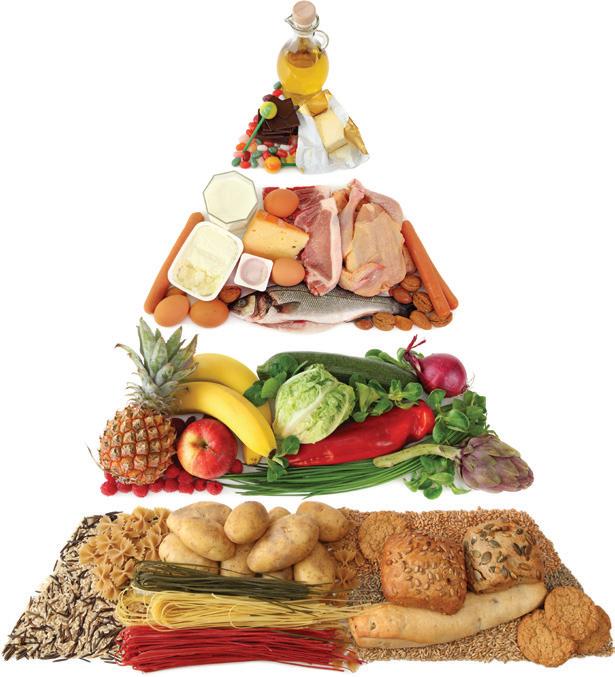
SOURCE 1 The energy needed to carry out basic bodily functions and perform physical activities comes from the foods we eat every day. Nutrients found in foods, such as carbohydrates, protein and fats, contain different amounts of energy.
Carbohydrates, protein and fats are often incorrectly thought of as foods, when in fact they are components of food known as nutrients. Some foods are higher in certain types of nutrients than others. These nutrients all contain different amounts of chemical energy and are used by the body in different ways. The energy content of different nutrients is measured in kilojoules (kJ). Kilojoules are the unit used to measure the amount of chemical energy provided by various types of foods. This chemical energy is converted into mechanical energy for movement. We will now learn about each of these types of nutrients in more detail.
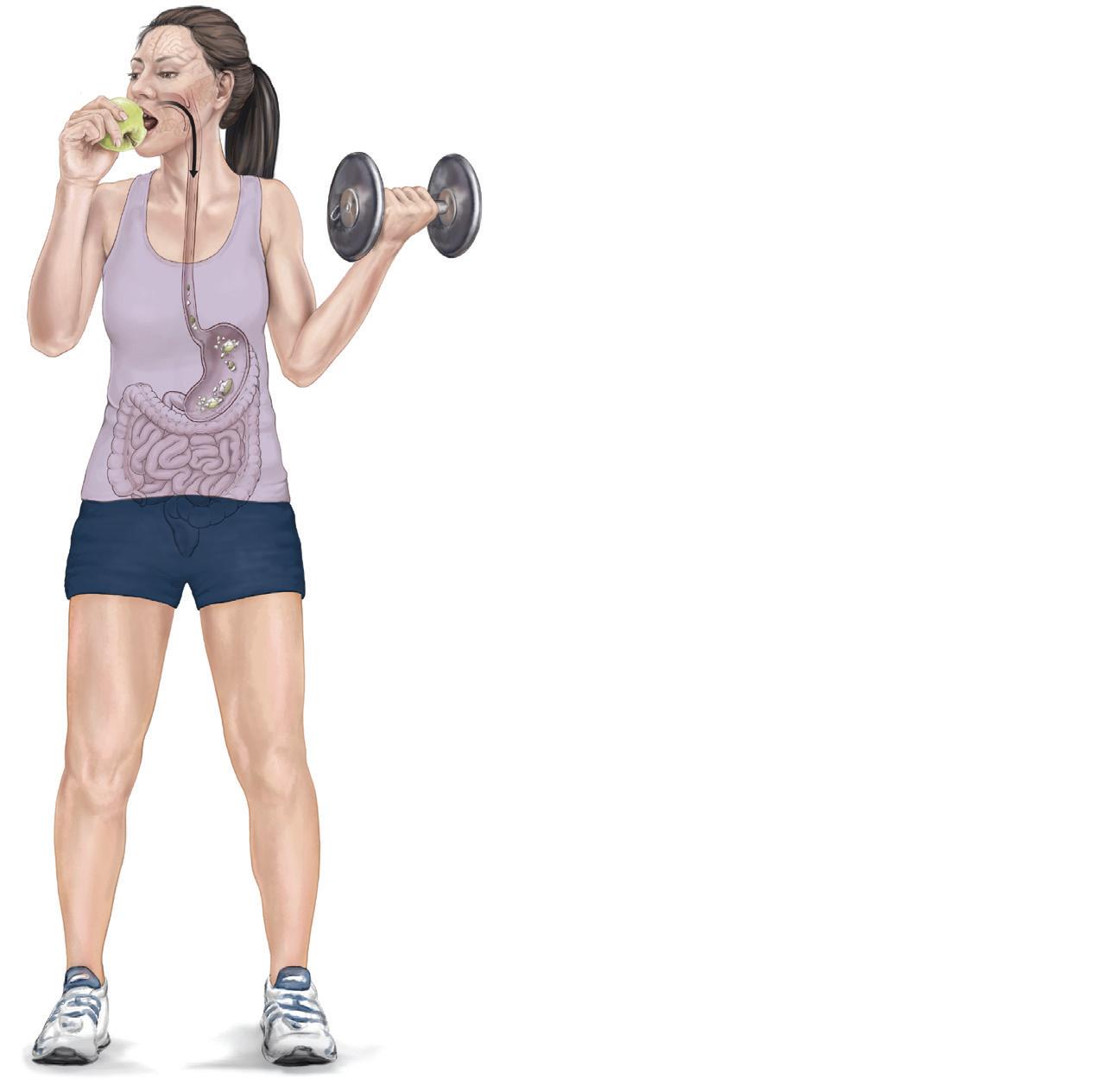
SOURCE 2 The energy we need to fuel the systems that keep our bodies functioning and moving comes from the foods we eat.
Fats Protein
Carbohydrates
Carbohydrates as an energy source
After water, carbohydrates are the most commonly consumed nutrient in the world. Carbohydrates are a great source of energy and are widely found in plant foods such as grains, fruits, vegetables and legumes (i.e. peas, beans, pulses). On average, 1 gram of carbohydrate yields around 16 kilojoules of energy.
Carbohydrates are made up of the elements carbon (C), hydrogen (H) and oxygen (O). This is useful to know, as the term "carbohydrate" is often abbreviated to CHO. Carbohydrates can be categorised as:
• simple carbohydrates (e.g. sugar)
• complex carbohydrates (e.g. breads, grains, vegetables).
When foods containing carbohydrates are digested, a chemical reaction takes place, and they are broken down into glucose. Glucose is a type of sugar that easily dissolves in the blood.
During physical activity, glucose can be carried through the blood to the muscles, providing the energy they need. If there is an excess supply of glucose in the body, it can be converted to glycogen and stored for later use (mainly in the muscles). As carbohydrates are quickly and easily broken down in the body, they are the fuel of choice in most high-intensity physical activities. The body, however, is only able to store limited quantities of glycogen (compared to energy stored from fats), so energy from carbohydrates is usually used quickly by the body. In fact, most athletes are only able to store enough glycogen for 60 minutes of continuous, vigorous exercise or 90–120 minutes of continuous moderate exercise.

SOURCE 3 After water, carbohydrates are the most commonly consumed nutrient in the world. Carbohydrates are a great source of energy.
Nutrient type Food source Chemical reaction Broken down into Stored as Energy yield
Carbohydrates • Sugars
• Grains
• Cereals
• Bread
• Vegetables
• Dairy
• Glycolysis
• Glycogenolysis Glucose Glycogen 1 g carbohydrate = 16 kJ energy
SOURCE 4 The characteristics of carbohydrates
glucose a simple sugar that is commonly found in many carbohydrates and is used as an energy source by the body
glycogen a substance stored in body tissue that comes from carbohydrates (i.e. a stored form of glucose)
cells the basic building blocks of all living things; membrane-bound units that contain the fundamental molecules of life amino acids the building blocks of protein in our bodies and in food; they come from the food we eat and are also produced by the body
Protein as an energy source
Protein is required by the body for the growth, maintenance and repair of cells. Protein is also required by the body to make enzymes, hormones, haemoglobin and antibodies to fight disease.
When foods containing protein are digested, a chemical reaction takes place and they are broken down into amino acids. About 20 different amino acids are found in food, but the number of combinations in which the amino acids can be arranged is unlimited.
Amino acids can be categorised as:
• essential amino acids (those that cannot be made by the body). There are nine essential amino acids, which cannot be made by the body, so they must come from the foods we eat
• non-essential amino acids (those that can be made by the body from essential amino acids).
SOURCE 5 The body requires protein for the growth, maintenance and repair of cells.
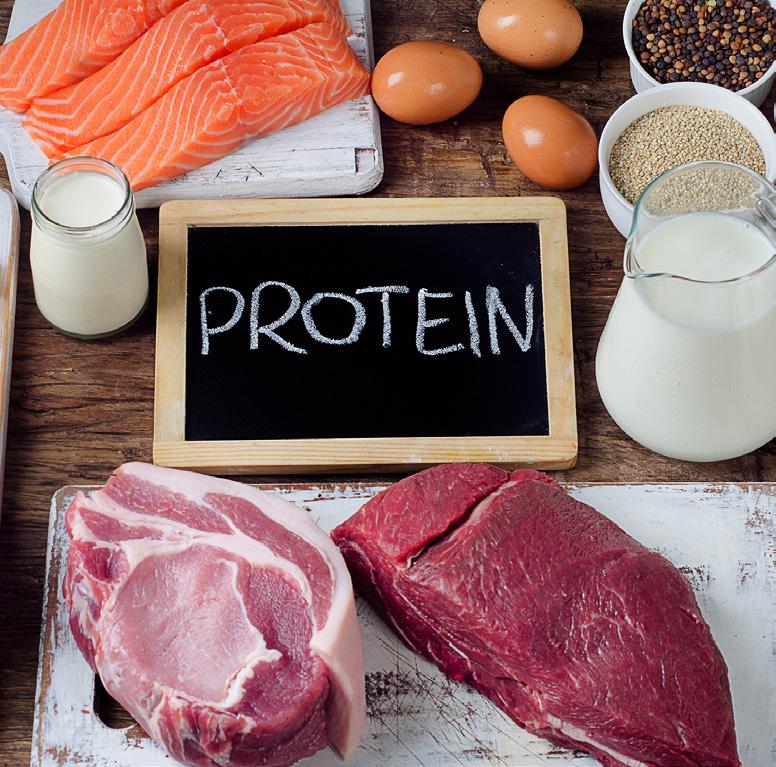
Under normal circumstances, protein is not used as an energy source during physical activity, because converting amino acids in skeletal muscle tissue into glucose is a slow process and results in the breakdown of muscle tissue. For this reason, using protein as a source of energy during physical activity is strictly reserved for times when glycogen stores in the body have been exhausted and the body has no other option (e.g. in the final stages of extreme endurance events like a marathon). In these cases, skeletal muscle protein can supply up to 15 per cent of the body’s energy needs. On average, 1 gram of protein yields around 17 kilojoules of energy.
• Meat
• Eggs
• Nuts
• Pulses
• Seeds
• Dairy Proteolysis
SOURCE 7 The characteristics of protein
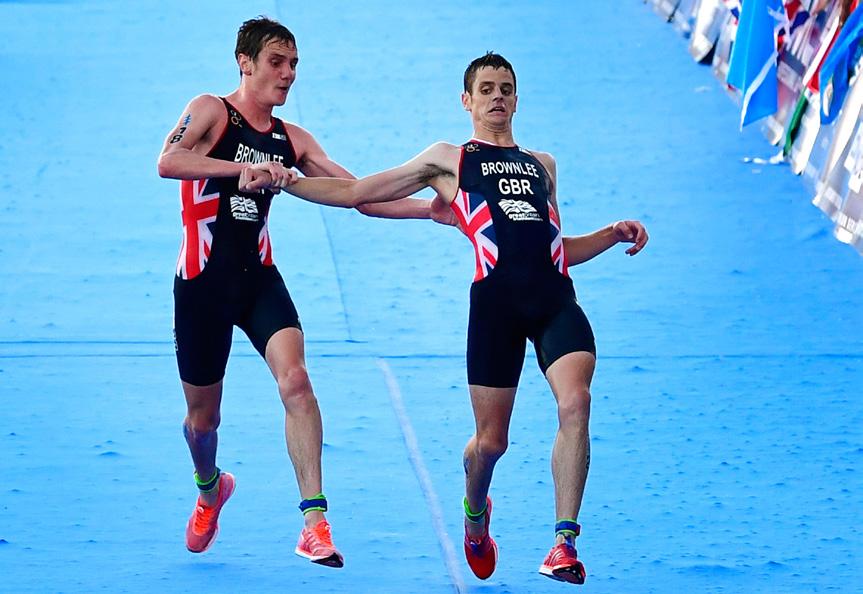
acids 1 g protein = 17 kJ energy
SOURCE 6 British athlete Alistair Brownlee supports his brother Jonathan to cross the finish line at the ITU Triathlon World Championship race in Mexico in 2016. Jonathan was leading the race, but with only 200 metres left in the endurance event, he collapsed due to dehydration and a lack of glycogen stores. The brothers finished in equal second place, but the medal ceremony was cancelled due to Jonathan’s critical medical condition.
Fats as an energy source
Fats are made up of the same elements as carbohydrates – namely, carbon (C), hydrogen (H) and oxygen (O) – but in different proportions. They are found in both animal- and plant-based foods.
When foods containing fat are digested, a chemical reaction takes place and they are broken down into fatty acids that can enter the bloodstream and be transported around the body for use by cells. If there is an excess supply of fatty acids in the body, it can be converted to triglycerides and stored for later use. Triglycerides are formed from three fatty acids and one glycerol molecule Fatty acids can be categorised as:
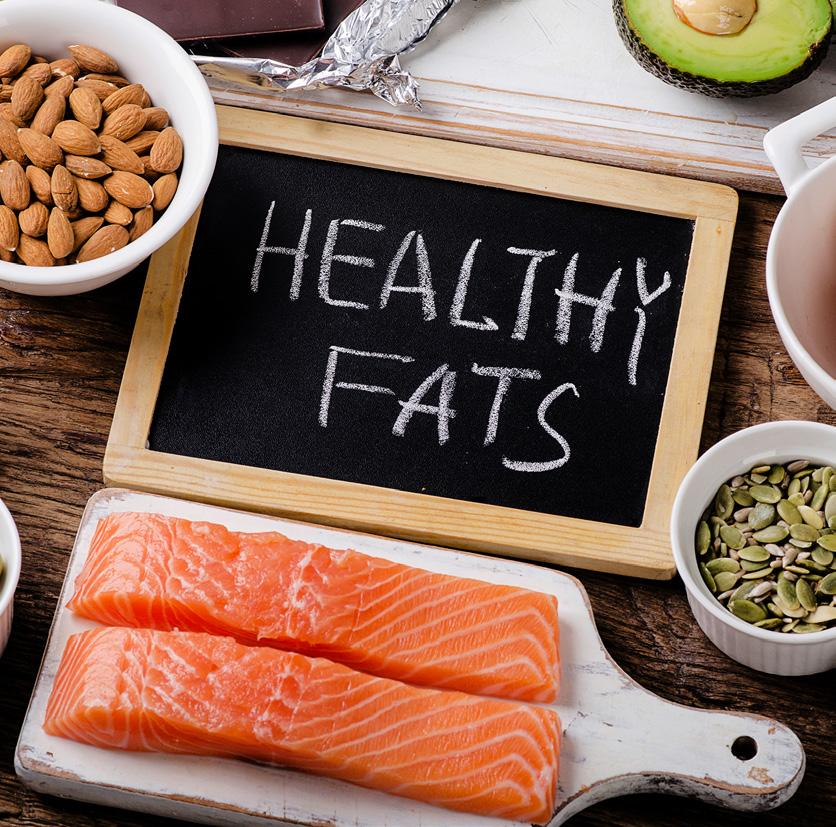
• essential fatty acids (those that cannot be made by the body). These must come from the foods we eat
• non-essential fatty acids (those that can be made by the body).
Our bodies have an almost unlimited capacity to store fat. This means that fat is the most abundant source of stored energy in the human body. On average, 1 gram of fat yields around 37 kilojoules of energy, meaning it yields more than twice as much energy per gram as carbohydrates or protein.
During physical activity, triglycerides are broken down into fatty acids and carried through the blood to the muscles, providing the energy they need. Unfortunately, the process of breaking down and transporting fats is quite time-consuming. It also requires sufficient oxygen to be present for the energy from fat to be harvested. This means that fat is not able to be used as an energy source if the intensity of activity is very high (i.e. it is the fuel of choice for low- to moderate-intensity physical activities).
How energy is accessed by the body
As discussed, the energy we need to fuel each of these body systems comes from the foods we eat every day. However, the energy gained from carbohydrates, protein and fats cannot be used directly to carry out basic bodily functions and fuel physical activities. Instead, the chemical energy from these nutrients is processed by the body (i.e. metabolised) to produce an energy-rich molecule known as adenosine triphosphate, which is more commonly referred to as ATP.
fatty acids the building blocks of the fat in our bodies and in food; they come from the food we eat and are also produced by the body triglycerides the main constituents of natural fats and oils, as well as the chemical form of fat stored by the body; they come from the food we eat and are also produced by the body
molecule a group of two or more atoms that are bonded together
adenosine triphosphate (ATP) an energyrich molecule found in the cells of every living organism that provides the energy required for most bodily functions (especially the muscle contractions that enable physical activity); ATP is made up of adenosine and three phosphate groups SOURCE 8 Fats are found in both animaland plant-based foods.
Study tip
It is important to know and understand the subject matter relating to energy systems well because it is highly likely to be included in multiple-choice questions on the external examination. Make sure you know how we use foods as fuel for energy production and the role of energy systems in keeping our bodies moving.
What is adenosine triphosphate (ATP)?
Adenosine triphosphate (ATP) is a complex molecule found in the cells of every living thing, including human beings. In simple terms, ATP captures chemical energy from the breakdown of food molecules and releases it when needed to fuel a range of tasks, including moving the muscles.
Adenosine
P P
High-energy
bond
SOURCE 10 Adenosine triphosphate (ATP) is a complex molecule found in the cells of every living thing. It is made up of adenosine and three chained phosphate groups.
As shown in Source 10, ATP is made up of two parts:
• a compound known as adenosine
• three chained phosphate groups.
These two parts give ATP its name – adenosine triphosphate (tri meaning "three").
When ATP is required to power tasks that need to be completed by cells (e.g. when a muscle cell needs to contract to cause movement), an instantaneous chemical reaction takes place inside the muscle cells (i.e. energy is released in a single step).
As shown in Source 11, during an ATP reaction, the high-energy bonds joining the second and third phosphate groups are broken. This releases energy that can be used by the cell to power energy-consuming reactions (e.g. in a muscle cell, this energy powers muscle contractions that result in movement).
Heat
Adenosine P P P
Energy
SOURCE 11 During an ATP reaction, the high-energy bond joining the third phosphate group is broken and energy and heat are released.
As well as releasing energy, ATP reactions release heat. This is why the muscles heat up during exercise. This same reaction takes place in all different types of cells within the body (e.g. blood cells, bone cells, skin cells) to produce the energy they need to perform their different functions and drive the body systems we rely on.
As shown in Source 12, the result of every ATP reaction is the creation of an adenosine diphosphate (ADP) molecule (di meaning "two"), as well as a separate phosphate molecule.
Adenosine P P P
SOURCE 12 Once energy and heat are released, ATP becomes adenosine diphosphate and a separate phosphate molecule.
Theory in action How cells produce ATP
A cell is the basic unit of life. It is called this because it is the smallest unit of an organism that is considered living. However, just as the basic unit of length – the metre – can be broken down into smaller parts (e.g. centimetres and millimetres), a cell is made up of smaller parts, too. Cells are made up of mini-organs known as organelles.
The different organelles in cells all have specific functions. These functions are necessary for the cell to survive. The organelle responsible for producing ATP is known as a mitochondrion (plural: mitochondria). Mitochondria are the site of energy production in every cell – a bit like miniature power plants. There can be several thousand mitochondria in a cell, depending on the specific type and function of the cell. For example, skeletal muscle cells contain a lot of mitochondria to make sure we have enough energy to perform physical activity when we need to.
As shown in Source 13, mitochondria are rod-shaped organelles with an inner and an outer membrane. Inside each mitochondrion, a reaction takes place that involves the rearrangement of the atoms in glucose (from the food we eat) and oxygen to produce water, carbon dioxide and energy (in the form of ATP). This ATP is then used by our bodies to help us move and grow.
It is important to note that ATP is not a storage molecule for chemical energy (i.e. it doesn’t function like a battery). That is the job of other substances in the body (such as carbohydrates and fats). Instead, when energy is needed by the cells, these substances or "fuels" enable the regeneration of ATP from ADP. Because of the high-energy bond between the second and third phosphate molecule in ATP, when they separate, energy is released and used where it is needed in the body.
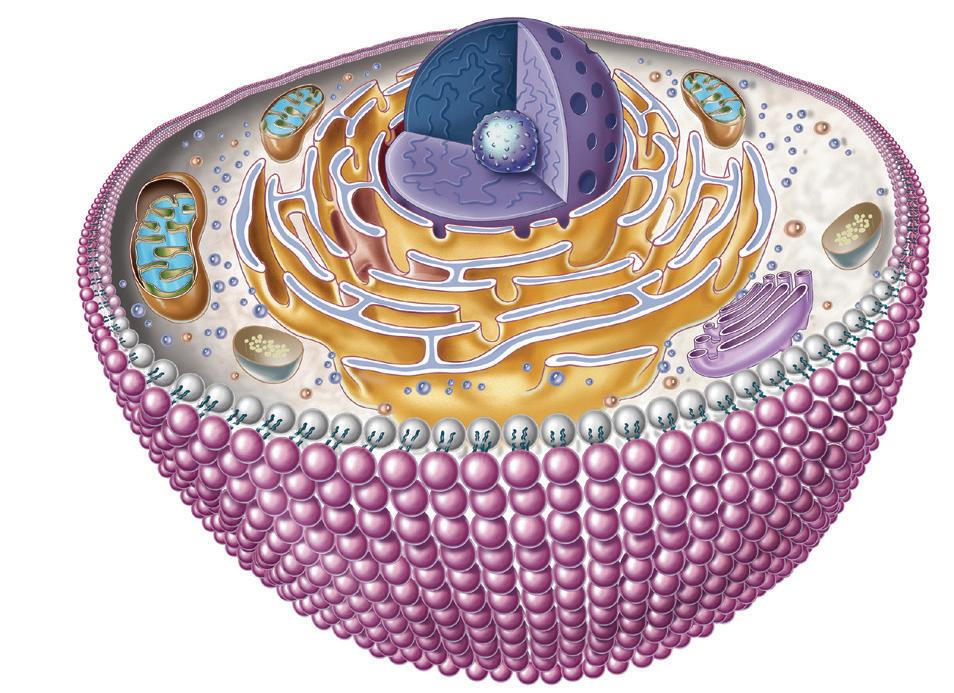

Nucleus
Chromatin (DNA) Nucleolus
Mitochondrion
Ribosome
Cytoplasm
SOURCE 13 The organelle responsible for producing ATP is known as a mitochondrion (plural: mitochondria). Mitochondria are the site of energy production in every cell – a bit like miniature power plants.
resynthesise to put different elements back together again after they have been broken apart
The ATP cycle
Although our cells are continuously breaking down ATP to obtain energy, it is not available in endless supply. To ensure that the body gets the energy it needs at all times, every cell in the body needs to continuously:
• release energy captured in ATP by breaking it down via a chemical reaction that produces ADP and a separate phosphate
• use energy from food to resynthesise (i.e. remake) ADP and phosphate into ATP.
This process takes place inside the mitochondria of each cell and is known as the ATP cycle. As shown in Source 14, the ATP cycle is a process that simultaneously uses and releases energy. It might help you to think of the process of the ATP cycle in terms of a rechargeable battery.
ATP cycle a process that simultaneously releases the energy captured in ATP (by carrying out a chemical reaction that produces ADP and phosphate) and uses energy to resynthesise (i.e. remake) ATP (from ADP and phosphate) Check your learning 4.2
ENERGY IN
• ADP + P resynthesised to create ATP
• Energy from food captured for use by cells
ENERGY OUT
• ATP broken down into ADP + P
• Energy released for cells to use
SOURCE 14 The ATP cycle
Retrieval and comprehension
1 Choose the correct answer. When foods containing carbohydrates are digested, a chemical reaction takes place, and they are broken down into:
A glucose.
B glycogen.
C amino acids.
D fatty acids.
2 Choose the correct answer. Why do muscles heat up during exercise?
A ATP reactions within cells and muscle contractions produce heat.
B External temperature changes and completion of an appropriate warm-up.
C When muscles contract to move the body, they produce heat.
D The body generates heat via the muscles to maintain its core temperature.
3 Define the term "ATP" and describe the role it plays in supplying energy to the body. Make reference to the chemical structure of ATP in your response.
Adenosine
Adenosine
4 Identify the process that is taking place in Source 14. In your own words, explain what happens at each stage.
5 Define the term "nutrients" and identify the three main types of nutrients found in foods.
Analytical processes
6 Complete the following table to compare and contrast the characteristics of the three nutrients found in foods in regard to energy production.
Characteristic Carbohydrates Protein Fats
Commonly found in the following food sources:
Broken down into:
Stored as:
Energy yield per gram:
7 Determine which type of nutrient would most likely be used by the body as a source of energy in the following situations:
a a touch player sprinting away from a defensive player in a breakaway try
b a netball goalkeeper, waiting for the ball to come to his end during a training match
c a marathon runner who had "hit the wall" in the last 2 kilometres of her race.
Knowledge utilisation
8 In a 250-word written response, discuss the energy requirements for your selected physical activity in Unit 4. In your response, assess whether your current diet is providing the types of energy necessary for you to maximise your physical performance in your selected physical activity. You may need to conduct additional research to complete your response.
Lesson 4.3
Learning intentions and success criteria
Energy systems used in physical activity
Key ideas
→ There are three main energy systems in the body that power ATP resynthesis and ensure that our body has the energy it needs to take part in physical activity: the ATP–PC system, the lactic acid system and the aerobic system.
→ The ATP–PC system and the lactic acid system are anaerobic, meaning they don’t use oxygen to resynthesise ATP, while the aerobic system does.
→ The ATP–PC energy system is used by the body for short, maximum-intensity activities that last between 10 and 15 seconds. The ATP–PC system resynthesises ATP quickly and efficiently due to the readily available stores of phosphocreatine (PC) in the muscles.
→ Once PC stores in the muscles have been depleted after about 10 to 15 seconds, the lactic acid system becomes the predominant energy system and is typically used for high-intensity activities lasting approximately 60 to 90 seconds. The lactic acid system provides energy by using supplies of sugar circulating in the blood (as glucose) and stored in the muscles and liver (as glycogen).
→ The aerobic system is typically used by the body for low- to moderate-intensity activities lasting longer than 90 seconds. The aerobic system produces the energy required to resynthesise ATP using the same chemical process used in the lactic acid system (i.e. glycolysis), but with the presence of oxygen.
energy system a system used by the body to provide the energy required to resynthesise ATP and ensure that the body has the energy it needs to take part in physical activity. There are three main energy systems used by the body – the ATC–PC system, the lactic acid system and the aerobic system
ATP–PC system an energy system that resynthesises ATP anaerobically for use in maximumintensity activities lasting 0 to 15 seconds
lactic acid system an energy system that resynthesises ATP anaerobically for use in high-intensity activities lasting 15 to 90 seconds
aerobic system an energy system that resynthesises ATP aerobically for use in low- to medium-intensity activities lasting longer than 90 seconds
anaerobic a term used to describe a chemical reaction that takes place without the presence of oxygen
aerobic a term used to describe a chemical reaction that takes place with the presence of oxygen
Introducing energy systems
As we have learnt, energy taken from the foods we eat is used by the body to synthesise (i.e. make) and resynthesise (i.e. remake) ATP via a process known as the ATP cycle. The ATP cycle ensures that our bodies have the energy they need to maintain bodily functions and take part in physical activities.
It’s important to note that the body does not have an unlimited supply of ATP on hand at any time. In fact, the small amount of ATP stored in our muscles' cells only provides enough energy for around two seconds of intense physical activity. Once this supply has been used, the ATP must be replenished through a process of resynthesis for activity to continue. There are three main energy systems in the body that power ATP resynthesis and ensure that our body has the energy it needs to take part in physical activity. The three energy systems are the:
• ATP–PC system
• lactic acid system
• aerobic system
Although each of these energy systems essentially does the same thing (i.e. resynthesises ATP), the ways in which they do it are different. This makes each energy system more or less suited to particular types of activities. Which energy system (or systems) the body uses to resynthesise ATP at any given time depends largely on the:intensity of the physical activity being performed
• duration of the physical activity being performed.
As shown in Source 1, the energy systems can be categorised as:
• anaerobic – meaning that the energy system resynthesises ATP without oxygen present
• aerobic – meaning that the energy system resynthesises ATP with oxygen present.
We will now learn about each energy system in more detail.
Energy systems
Anaerobic (i.e. not using oxygen)
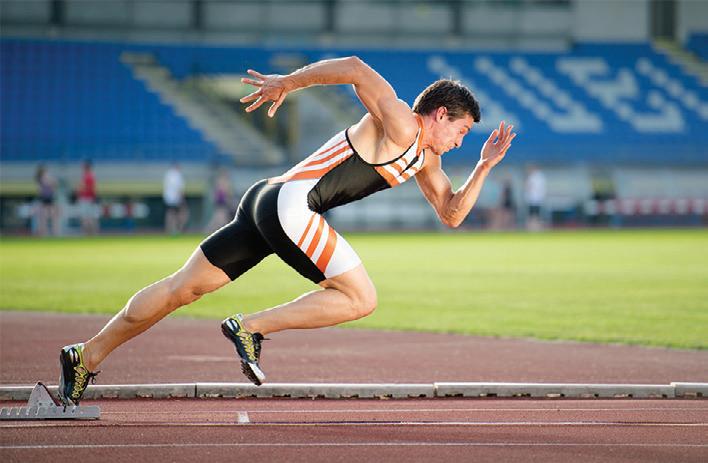
ATP–PC system
Suitable for high-intensity activities that have a short duration, like a 50-metre sprint
Aerobic (i.e. using oxygen)
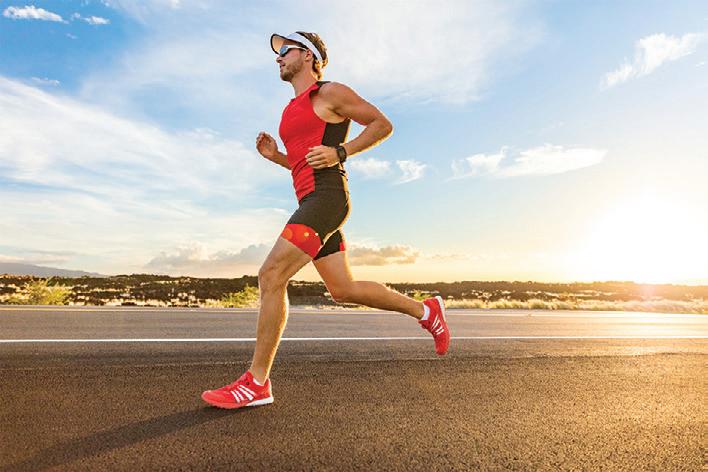
Suitable for lower-intensity activities that have a long duration, like a 15-kilometre run
acid system
Suitable for high-intensity activities that have a short to medium duration, like a 500-metre run
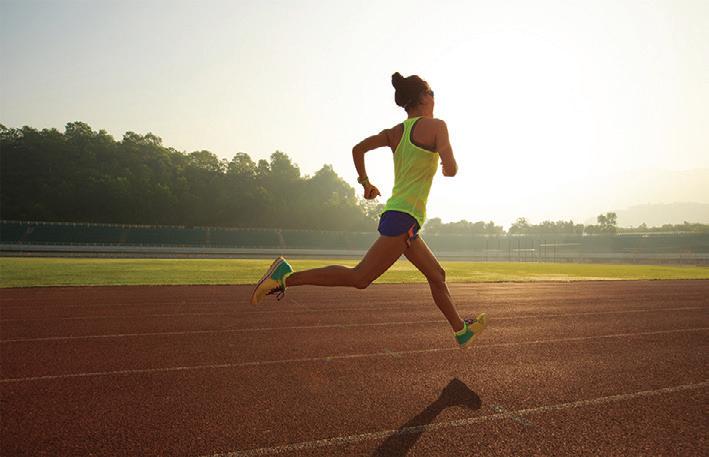
SOURCE 1 There are three energy systems in our body that resynthesise ATP, but the way in which each one does this is different. This makes them more or less useful to particular physical activities.
Aerobic system
Lactic
The ATP–PC system
The ATP–PC system resynthesises ATP anaerobically (i.e. without oxygen). This energy system is used by the body for short, maximum-intensity activities that last between 10 and 15 seconds, such as:
• 50- or 100-metre sprints
• long jump
• shot put
• specialised movement sequences in "Invasion" and "Net and court" physical activities, such as making a jump shot in basketball, kicking a goal in Australian football or diving to save a goal in soccer.
How does the ATP–PC system work?
The ATP–PC system resynthesises ATP quickly and efficiently due to the readily available stores of phosphocreatine in the muscles. Phosphocreatine (more commonly referred to as PC) is a chemical compound made up of creatine and phosphate. PC is stored in small quantities within our muscle cells. Around half the available PC stored in our bodies come from the foods we eat, while the other half is manufactured by our liver and kidneys.
Just like ATP, PC can store and release energy via a high-energy chemical bond that binds the creatine and phosphate molecule together (see Source 2). When this bond is broken, energy is released that enables ATP to be resynthesised from ADP and separate phosphate (see Source 3). Once resynthesised, the ATP molecule can break down again – and so the process repeats (see Source 4).
Oxygen is not needed for these reactions to occur, which enables the body to draw on this energy system instantly. In fact, it is often considered our emergency system, allowing us to flee from immediate danger quickly and efficiently, regardless of training.
P
SOURCE 2 Phosphocreatine (more commonly referred to as PC) is a chemical compound made up of creatine and phosphate. PC is stored in small quantities within our muscle cells.
phosphocreatine (PC) a substance found in the body that is broken down via the ATP–PC system in order to resynthesise ATP
SOURCE 3 Phosphocreatine is broken into phosphate and creatine, releasing energy to resynthesise ATP.
(PC)
SOURCE 4 The ATP–PC system resynthesises ATP by breaking down phosphocreatine (PC) into phosphate and creatine. The process releases energy to resynthesise ATP and produce energy for muscle contractions.
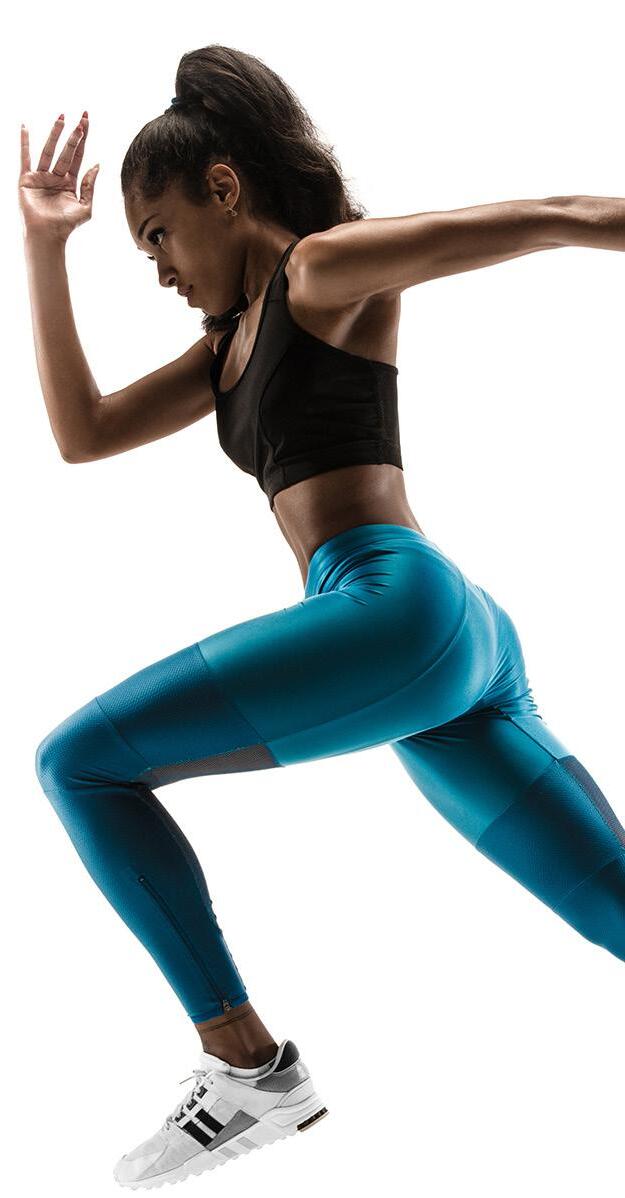
For the record!
The average person has around 50 to 100 grams of ATP stored in their muscles, but that same person will generally use approximately 50 to 75 kilograms of ATP on a normal day. In other words, the average person will use their body weight in ATP over the course of a normal day. This amount can more than double if they take part in intense physical activity. To meet this demand, on average, every cell of the body needs to resynthesise around 10 million new ATP molecules every second of the day. That’s a lot of ATP!
The main limitation of the ATP–PC system is that only small amounts of PC are stored in the muscles. Generally, most people store enough PC for between 10 and 15 seconds of strenuous physical activity. The amount of PC stored in a person’s muscles is dependent on their:
• genetics
• diet
• training.
Once PC is depleted, the body must use another energy system to resynthesise ATP. Although the stores of PC are quickly used up, they are also quickly restored – within 2 to 3 minutes of resting. This allows activity to be repeated in intense, short bursts, without immediate exhaustion.
The lactic acid system
As shown in Source 5, the lactic acid system resynthesises ATP anaerobically (i.e. without oxygen). Once PC stores in the muscles have been depleted, after about 10 to 15 seconds, the lactic acid system is typically used by the body for high-intensity activities lasting approximately 60 to 90 seconds. This includes activities such as:
• 400-metre sprints
• high-intensity movements in "Invasion" and "Net and court" physical activities that need to be sustained for longer periods of time without break (e.g. maintaining continued oneon-one defence in netball or basketball, repeatedly rucking and defending in the middle in touch football or continuing a long, intensive rally in tennis).
How does the lactic acid system work?
glycolysis the process of breaking down glycogen in order to resynthesise ATP anaerobic glycolysis the process of breaking down glycogen without oxygen present via the lactic acid system
lactic acid a byproduct of anaerobic glycolysis that is created when glucose is partially broken down to provide energy for ATP resynthesis
lactate a component of lactic acid that remains after hydrogen ions (i.e. the acidic component of lactic acid) are separated
After 10 to 15 seconds of maximum-intensity activity, PC supplies are exhausted, so the body must rely on another body system to resynthesise the ATP needed to provide the energy for continued physical activity. The lactic acid system provides this energy by using supplies of sugar (i.e. a simple form of carbohydrate) circulating in the blood (as glucose) and stored in the muscles and liver (as glycogen).
The chemical reaction that converts glucose or glycogen into the energy required to resynthesise ATP is known as glycolysis. Because levels of glucose and glycogen in the body are much higher than levels of PC, these can be used as an energy source for ATP resynthesis over a much longer period of time than PC.
Because the body relies on the lactic acid system for high-intensity activities lasting approximately 60 to 90 seconds, there is generally not enough time for the blood to carry oxygen from the lungs to the working muscles where ATP resynthesis (via glycolysis) takes place. This means that glycolysis takes place without oxygen being present (i.e. anaerobically). This is referred to as anaerobic glycolysis
As shown in Source 5, during anaerobic glycolysis, stores of glycogen in the muscles and liver are converted into glucose, which is used to fuel ATP resynthesis. However, because oxygen is not available for this chemical reaction, the glucose is only partially broken down. This partial breakdown of glucose produces a by-product known as lactic acid.
The amount of lactic acid produced – and the speed at which it is produced – depends on the intensity and length of the physical activity. The harder a person works, the more quickly lactic acid will be produced.
As soon as lactic acid is produced, it separates into:
• lactate – a component of lactic acid that remains after hydrogen ions are removed
• hydrogen ions – the acidic component of lactic acid.
Both of these substances then begin to accumulate (i.e. build up) in the muscles. When very high levels of lactic acid build up, they can prevent the muscle fibres from contracting properly or negatively affect performance by bringing about fatigue. This causes a burning sensation in fatigued muscles that is actually caused by the build-up of hydrogen ions.
SOURCE 5 The lactic acid system resynthesises ATP by breaking down glucose and glycogen without the presence of oxygen. This process is known as anaerobic glycolysis. It releases energy to resynthesise ATP and produce energy for muscle contractions. It also produces a by-product known as lactic acid.
If lactate is not used as an energy source, it is transported in the bloodstream to the liver, where it is converted back to glucose and stored as glycogen. In this form, it can be used again in future as a fuel for ATP resynthesis. In fact, it is estimated that as much as 30 per cent of all glucose used for ATP resynthesis comes from blood lactate that has been "recycled" into glycogen through the liver. It can take up to 2 hours for the breakdown and removal of blood lactate and hydrogen ions from the muscles. However, in extreme cases the effects of the build-up can last a couple of days.
An "active recovery" (i.e. participating in low-intensity exercise after high-intensity activity) helps to lower blood lactate and hydrogen ion levels in the muscles by ensuring that oxygen is resupplied to the working muscles.
The aerobic system
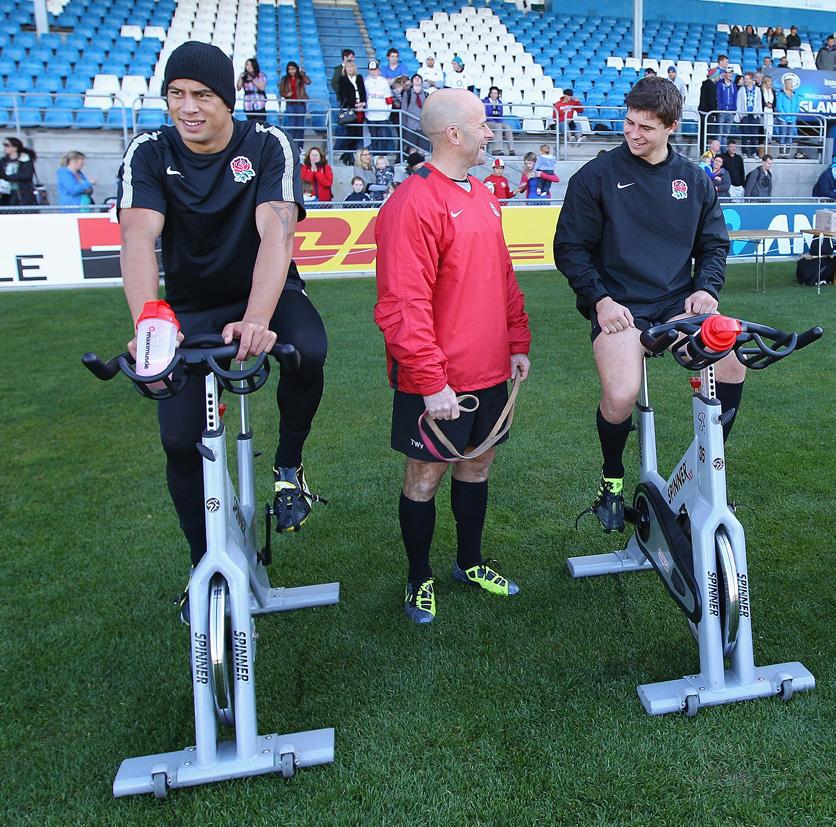
The aerobic system resynthesises ATP with oxygen (i.e. aerobically). This energy system is typically used by the body for low- to moderate-intensity activities and those lasting longer than 90 seconds, such as:
• extended periods of walking
• a 15-kilometre jog
• "Invasion" and "Net and court" physical activities where movement is slower and more sustained (e.g. a soccer midfielder moving the ball around with his teammates before setting up their attack on goal, or a centre basketball player defending the keyway in a zone defence pattern while the opposition set up their attack outside the key)
• "Performance" physical activities like aquathlon, triathlon, or 800-metre or 1500-metre events.
SOURCE 6 Athletes often use stationary bikes to participate in active recovery. Active recovery helps the body to remove lactate and hydrogen ions that may have accumulated in the muscles during periods of intense physical activity fuelled by anaerobic glycolysis.
Glycogen Glucose
aerobic glycolysis the process of breaking down glycogen in the presence of oxygen via the aerobic system
How does the aerobic
system work?
When athletes participate in low- to moderate-intensity activities, the body begins to predominantly use the aerobic system for ATP resynthesis. The aerobic system produces the energy required to resynthesise ATP using the same chemical process used in the lactic acid system (i.e. glycolysis). The only difference is the presence of oxygen. This type of glycolysis is known as aerobic glycolysis. Unlike anaerobic glycolysis, aerobic glycolysis does not produce the by-product of lactic acid.
Of all of the energy systems, the aerobic system is able to yield the most ATP through the process of glycolysis.
Another advantage of the aerobic system is that it can use a variety of energy sources to fuel ATP resynthesis. These include:
• carbohydrates – (i.e. glucose and glycogen) the most efficient fuel used by the aerobic system and therefore the preferred fuel in moderate exercise, such as the early stages of endurance activities
• protein – only used rarely as it is too inefficient to allow the movement required in most physical activities
• fats – (i.e. triglycerides) the preferred fuel source used by the aerobic system during low-intensity activity, such as walking, or if exercise continues for more than an hour or so. Fats are broken down via a process known as lipolysis. The benefit of using fat is its abundant availability. Through strategic training, the body can be made more efficient at metabolising fat and the athlete is able to run at a higher intensity while still drawing on fat as the fuel source.
The drawback of the aerobic system is that it takes time to deliver adequate oxygen to the muscles in order to activate the system, so it can only be used in comparatively low- to moderate-intensity activities.
The by-products of the aerobic system are carbon dioxide, water and heat, all of which are harmless and can be eliminated (expelled) easily by the body.
Comparing energy systems
For the record!
The longest continuous tennis rally recorded in competition took place in a match between Vicki Nelson and Jean Hepner in 1984. The 643-shot rally lasted for 29 minutes and by the end, neither player had enough energy left to do anything more than stand on the baseline and lob the ball back and forth. During the rally, both players would have had to lower the intensity of their activity to prevent the fatiguing effects of lactic acid build-up.
An example of how the three energy systems can be used at different times is provided in Theory in action The body’s energy systems in action.
Theory in action The body’s energy systems in action
On Monday afternoon, Jason and his friends decide to go for a leisurely 5-kilometre run. They set out slowly, maintaining a steady pace for several minutes, chatting and laughing as they run. Their run finishes after 30 minutes. In this instance, they have predominantly used their aerobic system to resynthesise ATP and provide the energy they need.
On Tuesday afternoon, Jason decides to go for another run. This time he takes a different route, and as he’s running
along the street a large, angry dog races up a driveway, growling and barking. The driveway gate has been left open, so Jason must sprint away from the dog for approximately 100 metres before the owner calls it back and Jason can reduce his speed. This 15-second burst momentarily uses Jason’s ATP–PC system. As he returns to a jog, his body reverts to resynthesising ATP aerobically and replenishes his PC stores.
On Wednesday afternoon, Jason goes for another run. He forgets to take a different route and passes the same aggressive dog. Unfortunately, the owner doesn’t appear to be home, so Jason must sprint as fast as he can to escape the dog. He eventually finds safety about 600 metres down the road. This requires about 2 minutes of maximum effort. Over this period, Jason uses up all his PC supplies and begins to rely on his lactic acid system. As he slows his pace down to a walk, he reverts to using his aerobic system, beginning the removal of the lactic acid in his muscles and replenishing PC stores. Jason staggers home with "jelly legs". He vows never to run down that street again! Intensity and duration are both factors that determine which energy system resynthesises Jason’s ATP during his runs.
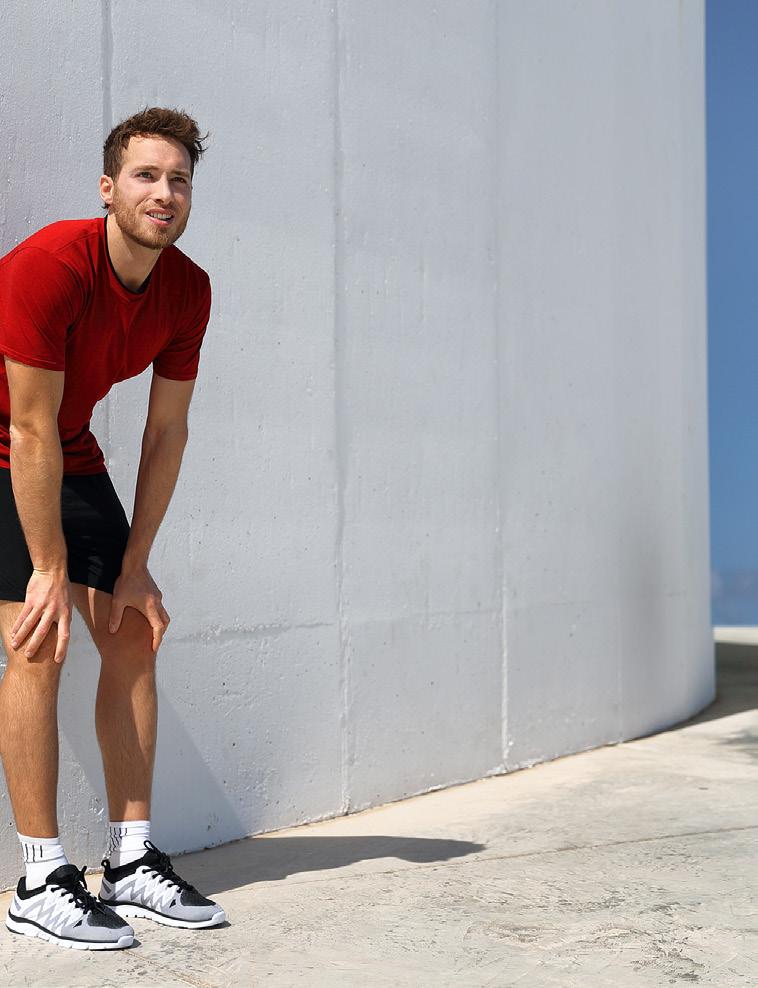
SOURCE 7 During his daily run, Jason uses all three of his energy systems depending on the intensity and duration of his efforts.
How energy systems interact during physical activity
Although we have been learning about each of the body’s energy systems separately, it is important to realise that each energy system does not operate in isolation of the others. Instead, over the course of a particular physical activity (and depending on what we are doing), each system contributes to the production of ATP at different times and at different rates. In other words, there is often a degree of overlap in the types of systems producing energy and the contributions they are making to the body’s energy needs.
Source 9 provides general estimates of the contributions of the three energy systems in a variety of "Invasion", "Net and court" and "Performance" physical activities. It is important to note that the qualitative data provided is broadly in line with an Under-18 representative level performance. When considering this data, remember that the percentage contributions of each energy system can vary widely, depending on:
• the position played by the athlete (i.e. in a team sport)
• the level of fitness of the athlete
• the level of the competition (e.g. beginner versus elite)
• the kinds of tactics and plays executed by the team.
As a result, when determining the contributions of energy systems for your selected physical activity, you will need to make adjustments to reflect the movements you experience (i.e. duration and intensity). Percentage contributions will also differ, depending on whether the data is considering just time in action or breaks in play. For example, if breaks in play are considered, a sport such as tennis would be deemed mostly aerobic. If breaks are not considered, then the game has a much stronger anaerobic contribution.
In “Invasion” physical activities
"Invasion" physical activities generally run for durations of 40 minutes or more and incorporate a wide variety of specialised movement sequences and movement strategies at varying levels of intensity, interspersed with rest periods. For this reason, there is significant contribution from all three systems in most invasion activities. The percentage contribution depends a lot on the level of competition and an individual’s position on the team. "Invasion" physical activities generally run for durations of 40 minutes or more and incorporate a wide variety of specialised movement sequences and movement strategies at varying levels of intensity, interspersed with rest periods. For this reason, there is significant contribution from all three systems in most invasion activities. The percentage contribution depends a lot on the level of competition and an individual’s position on the team.
For example, in water polo, a wing is required to stay afloat through constant movement, requiring a significant contribution from the aerobic system. This is interspersed with short, intense bursts of movements for passing, lunging, intercepts and repeated sprint efforts (i.e. transitions from attack to defence). These short, intense bursts rely on the ATP–PC system. As there is little recovery time between these high-intensity efforts, there is a heavy reliance on the lactic acid system.
In “Net and court” physical activities
"Net and court" physical activities are usually played for durations of more than an hour. They involve a wide variety of specialised movement sequences and movement strategies. For this reason, energy system contribution is often supplied anaerobically. Frequent breaks in play enable some recovery so anaerobic systems can be used. The percentage contribution depends a lot on the level of competition.
For example, in tennis, individual explosive shots will predominantly use the ATP–PC system (as will rallies of 8–15 seconds). Individual rallies lasting longer than 20–30 seconds, or a string of intense rallies, will utilise the lactic acid system. As the match goes on, if PC supplies are not adequately replenished between points, the body will use the lactic acid system much sooner in the tennis rally, causing fatigue that could impact performance.
In “Performance” physical activities
"Performance" physical activities vary in length, ranging from a throw or jump lasting a couple of seconds to a triathlon lasting an hour or more. The contribution of particular energy systems is highly dependent on the duration and intensity of the activity. In shorter events (e.g. a discus throw), the ATP–PC system is the predominant energy system. In longer events (e.g. the 1500 metres), there is contribution from all three energy systems depending on specific race situations.
In a triathlon, race starts or short surges when overtaking a competitor use the ATP–PC system. The lactic acid system contributes during longer surges or accelerations (e.g. in the first 2 minutes of the swim leg when the body is still trying to adapt to the sudden demand for ATP production) or during hill climbs in the bike and run legs (i.e. where intensity increases over periods of 20 seconds or more). Energy can be provided by the aerobic system during the main body of the swim and the flat components of the bike and run leg.
SOURCE 8 A summary of the contributions of energy systems to various "Invasion", "Net and court" and "Performance" physical activities. Note: Percentages provided are approximations are based on an Under-18 representative level performance for the positions indicated and do not include breaks in play in the calculations. These values should be adjusted for performers and their positions according to their individual circumstances.
Source 9 shows how all three energy systems can be working simultaneously to provide the ATP resynthesis required.
SOURCE 9 The contribution of the energy systems is dependent on the intensity and duration of the activity. Although there is a dominant energy system supplying the energy needs during these times, the non-dominant systems are usually also playing a minor role in the resynthesis of ATP.
Aerobic system (CHO)
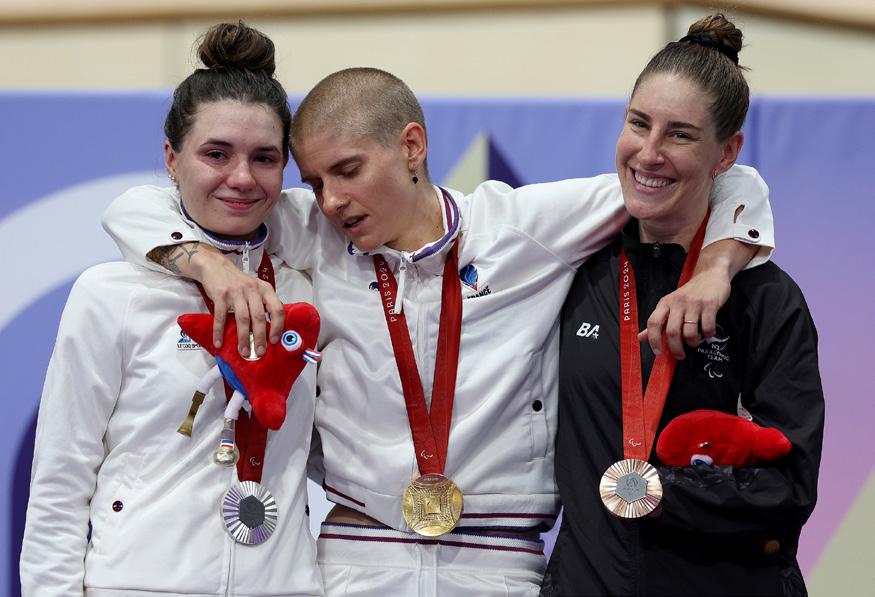
Check your learning 4.3
Check your learning 4.3
Retrieval and comprehension
1 Choose the correct answer.
Identify the three energy systems used to resynthesise ATP.
A ATP–PC system, lactic acid system, aerobic system
B ATP–PC system, ADP system, lactic acid system
C anaerobic glycolysis, aerobic glycolysis, ATP glycolysis
D glygocen system, lactate system, anaerobic system
2 Choose the correct answer.
Recall the purpose of active recovery.
A Active recovery helps the body to remove lactate and hydrogen ions that may have accumulated in the muscles during physical activity.
B Active recovery helps the body to remove lactic acid in order to prevent post-workout soreness.
C Active recovery assists athletes to increase their work capacity and overall fitness levels.
D Active recovery supports the body to recover from physical activity as the athlete does not need to perform an extensive cool-down.
3 Describe the key features of the three energy systems (e.g. their advantages and limitations).
4 Identify the factors (e.g. physical activities) that determine the type of energy that is used by the body.
SOURCE 10 French cyclist Marie Patouillet (centre) won Gold at the 2024 Paris Paralympics in the Women’s C5 3000 metres Individual Pursuit. The C5 category is for athletes competing with a single limb amputation or prosthesis or limited movement of their upper or lower limbs. This was the last race of Patouillet’s velodrome track racing career, and she suffered a dizziness and fainting episode during the medal ceremony and national anthem. She was supported by Silver medallist Heidi Gaugain (France) and Bronze medallist Nicole Murray (New Zealand).
5 Explain why the ATP–PC system is only used in efforts lasting 10 to 15 seconds.
6 Recall the main limitation of the lactic acid system.
7 Describe the main differences between anaerobic glycolysis and aerobic glycolysis.
Analytical processes
8 Read Theory in action The body’s energy systems in action. Analyse the cause of Jason’s "jelly legs" after he has been chased by the dog for a second time. Provide as much detail as possible in your response.
9 For each activity below, identify which energy system – ATP–PC, lactic acid or aerobic – would provide the most energy for ATP resynthesis in that activity.
a A basketball jump shot
b A swimmer completing a 1500-metre race
c A touch football player engaged in a fast rucking pattern for 25 seconds
d A futsal goalkeeper diving to stop a goal
e A volleyball setter involved in consecutive ballchasing efforts longer than 1 minute, with little recovery between efforts
f A netball shooter moving around in the circle while the ball is at the opponent’s end of the court
10 Consider the interplay of energy systems for the following positions and events. Write a short paragraph describing each one.
a A goalkeeper during a soccer match
b An athlete competing in a long jump event
c A centre during a game of netball
d A winger during a game of touch football
Knowledge utilisation
11 Review the information provided about Paralympic cyclist Marie Patouillet in Source 10. Using knowledge gained from this lesson, and the information about energy systems for performance events in Source 9, determine the causes of Patouillet’s fatigue after she completed her 3000-metre race in 3 minutes 35 seconds. Refer to energy systems in your response, providing as much detail as possible.
12 Assess Olivia’s training session outline below and justify whether it would be a suitable session for developing her lactic acid system.
Olivia's training session outline
– 5-minute warm-up jog followed by dynamic stretches and run-throughs
– 5 x 30-second fast sprints with 2 minutes rest between each sprint
– 5 x 45-second fast sprints with 2.5 minutes rest between each sprint
– 5-minute cool-down jog
13 Source 11 shows the energy contribution of an Australian football player who is participating in two different periods of high-intensity physical activity during a game.
– The first graph (top) shows a 5-second, highintensity burst of physical activity.
– The second graph (bottom) shows a 20-second, high-intensity burst of physical activity.
Based on the data provided, discuss why it is difficult to generalise the energy contributions for different sports.
14 Evaluate one specialised movement sequence and movement strategy within your selected physical activity and determine the contributions of the three energy systems to it. Justify your response in one or two paragraphs.
Energy system contribution to a 5-second high-intensity passage of play in Australian football
Energy system contribution to a 20-second high-intensity passage of play in Australian
SOURCE 11 Energy systems in an Australian football game
Learning intentions and success criteria
Lesson 4.4 Fitness requirements for physical activity
Key ideas
→ The term "fitness" refers to the condition of being physically fit and healthy, and a person’s ability to participate effectively in a particular sport or physical activity.
→ There are seven components of fitness: aerobic capacity, power, strength, speed, agility, muscular endurance and flexibility.
components of fitness a series of seven categories used to identify specific aspects of an athlete’s overall fitness (aerobic capacity, power, strength, speed, agility, muscular endurance, flexibility)
aerobic capacity the ability of the heart, lungs and circulatory system to supply oxygen and other nutrients to working muscles so that an athlete can exercise continuously for extended periods without tiring; one of the seven components of fitness
power the ability to exert maximum force in the shortest amount of time; one of the seven components of fitness
strength the ability of a muscle (or muscles) to exert force by contracting against resistance; one of the seven components of fitness
speed the ability to move the entire body (or specific parts of the body) quickly; one of the seven components of fitness
→ Athletes use fitness tests, which measure and test the components of fitness, in order to develop and implement personalised training strategies.
Defining fitness
In the simplest terms, fitness refers to:
• the condition of being physically fit and healthy
• a person’s ability to participate effectively in a particular sport or physical activity. However, the concept of fitness is actually quite difficult to define because it can mean different things to different people in different contexts. In Senior Physical Education, fitness can be defined as the ability of an athlete to perform a range of specialised movement sequences for movement strategies:
• at an appropriate intensity
• for an appropriate length of time.
As different sports and physical activities have different rules, conditions and requirements, being "fit" for one sport (or one position) does not necessarily make you "fit" for another. Furthermore, when measuring physical fitness, describing the fitness levels of an athlete in terms of "fit" or "unfit" is inadequate. For this reason, exercise physiologists use a number of different perspectives and criteria to get a more accurate and holistic understanding of what it means to be fit. These criteria are known as the components of fitness
Components of fitness
The components of fitness are used to identify specific aspects of an athlete’s overall fitness so that these aspects can be understood, measured, tested and addressed through training opportunities, as required. The seven components of fitness included in the QCAA Physical Education General Senior Syllabus are:
• aerobic capacity – the ability of the heart, lungs and circulatory system to supply oxygen and other nutrients to working muscles so that an athlete can exercise continuously for extended periods without tiring
• power – the ability to exert maximum force in the shortest amount of time
• strength – the ability of a muscle (or muscles) to exert force by contracting against a resistance
• speed – the ability to move the entire body (or specific parts of the body) quickly
• agility – the ability to move the entire body from one position to another, or from one direction to another, quickly and precisely
• muscular endurance – the ability to sustain or repeat a series of muscle contractions without fatigue
• flexibility – the ability of a joint to move through its full range of motion.
The components of fitness are useful because different athletes have different types and levels of fitness, depending on their:
• age
• physical and mental ability
• experience or level of competition
• sex
• lifestyle
• training.
As a result of these differences, it’s essential for coaches to identify particular strengths and weaknesses and tailor training opportunities to the needs of individual athletes. Data gathered on each of the different components of fitness allows coaches to develop a fitness profile (i.e. a table of fitness-based values) and a training program suited to the specific requirements of individual athletes. Exercise physiologists and strength and conditioning coaches also use athlete-specific data from fitness profiles to develop individual and group training programs.
Some components of fitness listed above are dependent on the oxygen uptake and delivery to working muscles through the respiratory and circulatory systems, while others are dependent on the structure and function of the body’s musculoskeletal system. We will look at each of the components of fitness in more detail in this lesson, but first it is important to discuss some of the reasons why it is useful to measure the components of fitness and how these results can be used to improve performance.
Measuring and testing fitness
The main reason for measuring and testing the components of fitness is so that a personalised training strategy can be developed and implemented, with the goal of improving the ability of an athlete to perform a specific physical activity.
When fitness data is collected regularly (through fitness testing), it provides accurate information about an athlete’s development and level of fitness over time. Fitness tests can also highlight where improvements have been made or where deterioration has occurred.
It is common for athletes to take part in a series of pre-training and post-training fitness tests. These tests help to identify if any changes in fitness levels have taken place over the course of a training session or training program. This process is generally referred to as "pre" and "post" testing.

agility the ability to move the entire body (or specific parts of the body) from one position to another, or from one direction to another, quickly and precisely; one of the seven components of fitness muscular endurance the ability to sustain or repeat a series of muscle contractions without fatigue; one of the seven components of fitness flexibility the ability of a joint to move through its full range of motion; one of the seven components of fitness
fitness profile a table of fitness-based values designed to help individual athletes understand their overall fitness level (by providing data on a range of components of fitness) and design an appropriate training strategy training program a series of training events/ activities planned over a specific period of time (e.g. 1 week, 2 months, 1 year), designed to help an individual or team achieve a range of energy, fitness and skill goals. The features of training programs include: specific training objectives; game analysis; work volume (frequency and duration) and intensity; tapering and recovery
SOURCE 1
Components of fitness can be measured using field or laboratory tests. These tests help athletes develop a fitness profile.
Collecting and recording data on the components of fitness usually involves the use of laboratory or field tests. Measuring physical fitness is important to:
• evaluate progress
• make comparisons with other similar populations
• determine event or position suitability
• develop accurate training strategies
• set realistic, achievable fitness goals
• identify baseline and follow-up fitness levels
• assess individual strengths and weaknesses
• identify medical problems
• motivate athletes to improve results.
There isn’t one standalone test that will measure all of the components of fitness simultaneously; often a collection of different tests will be required to do this. Performing more than one test for each component can provide more accurate information for individuals wanting to develop a personalised training program.
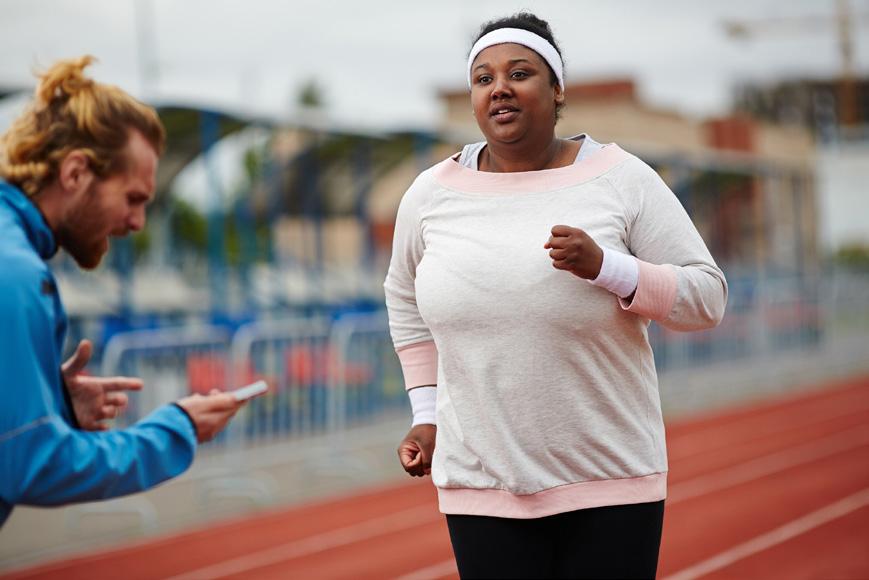
When testing specific components of fitness, the physical requirements of the physical activity being tested should be taken into account. In many cases, traditional fitness tests are inadequate for assessing the event-specific or position-specific fitness requirements of an individual. In order to get the most reliable and useful data, it is necessary to simulate authentic tasks and performance environments. To do this, you may need to design your own customised fitness tests. An example of this is provided in Theory in action The best teams use specialised fitness tests.
Theory in action The best teams use specialised fitness tests
Many elite sporting teams employ strength and conditioning specialists whose job it is to get their team into the best physical shape possible. It is crucial that each player is prepared for the energy and fitness requirements of their particular position in the team. Part of this strength and conditioning side of training is participating in regular testing and evaluation to ensure gains are being made where they are needed. For example, the Wallabies have a test protocol called "The Australian Rugby Union fitness tests".
These tests were designed specifically to assess the fitness requirements of
the sport and the different positions on the team. Traditional speed tests were inaccurate because rugby players never run in a straight line, or for such long distances, during a game. To address this, a specialised fitness test called the "10–10–20" quickness test was developed. Players are required to run a decelerated 10-metre sprint around a flagpole –turning left to right – followed by a decelerated turn around another flagpole – turning right to left. The advantage of this specialised test is that it simulates the movements required in authentic performance environments and it assesses the ability of an athlete to complete them.
SOURCE 2 Designing a specialised fitness test is recommended if you wish to gain more accurate information about an individual’s fitness profile.
Aerobic capacity
Aerobic capacity is the ability of the heart, lungs and circulatory system to supply oxygen and nutrients efficiently to working muscles and to remove waste products. Aerobic capacity is an essential component of fitness in almost all sports. Aerobic capacity not only enables athletes to perform faster for longer – with fewer negative effects from fatigue – it also helps the body to recover after exercise.
Traditional tests of aerobic capacity include:
• the multi-stage fitness test (also known as beep tests) – a running test used to estimate an athlete’s aerobic capacity and predict their VO2 max (i.e. the maximum amount of oxygen in litres an athlete can use per minute)
• the Astrand-Rhyming cycle ergometer test – a submaximal cycle ergometer aerobic fitness test based on the relationship between heart rate during work and percentage of maximal aerobic capacity
• Cooper’s 12-minute run – a test that requires an athlete to run as far as possible in 12 minutes and can be used to predict VO2 max
• the step test – a test designed to measure an athlete’s aerobic fitness by stepping up and down a step for 3 minutes.
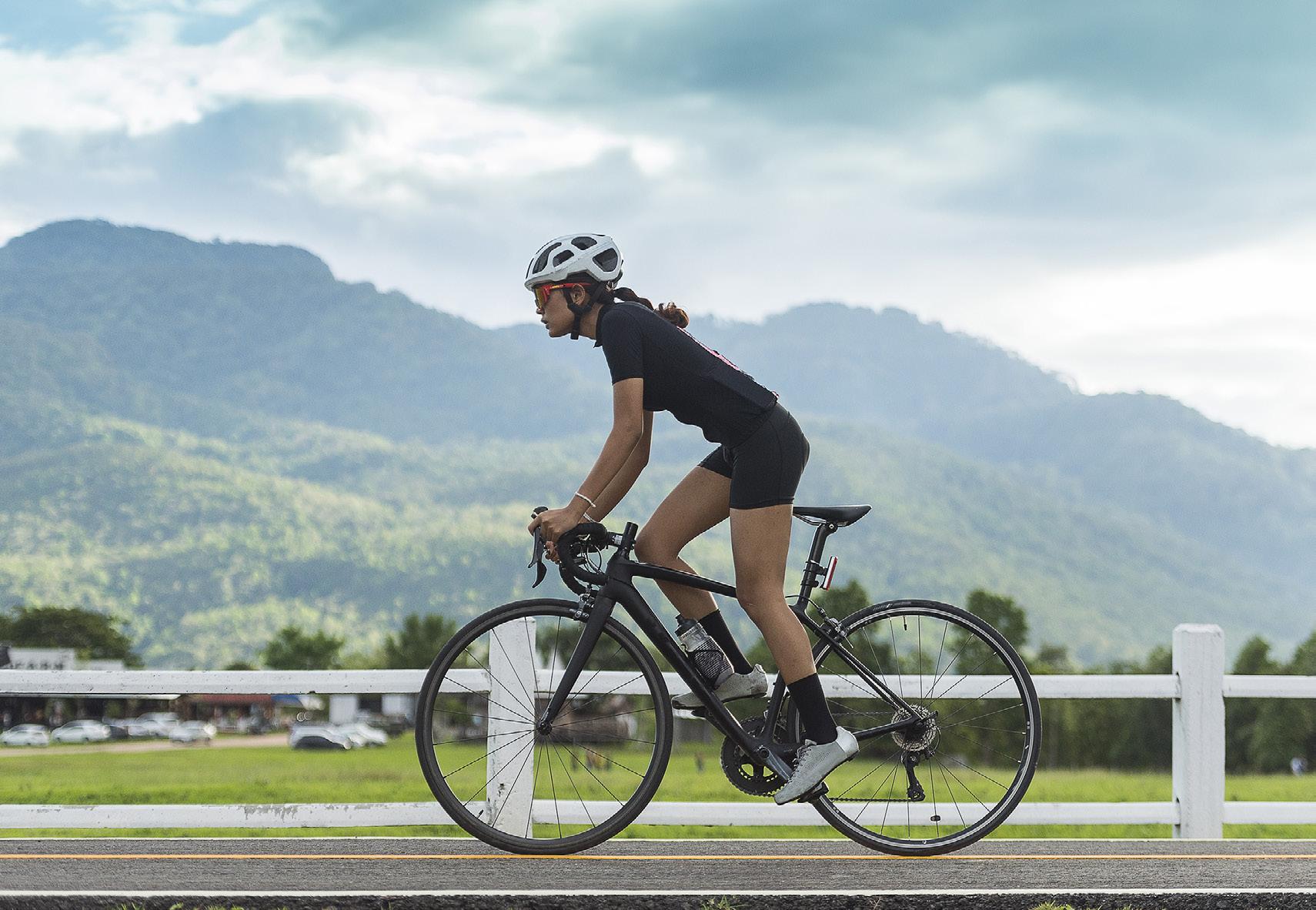
Study tip
If you have identified aerobic capacity as an important component of fitness for your selected physical activity, you may decide to include the following training methods in your training strategy:
• continuous training –see Lesson 4.14
Continuous training (page 245)
• fartlek training – see Lesson 4.15 Fartlek training (page 247)
• interval training – see Lesson 4.17 Interval training (page 259).
When designing a customised aerobic capacity fitness test that suits the fitness requirements for your physical activity, it is important to consider:
• the timeframe for which aerobic capacity is required
• the designated rest periods of the physical activity (if applicable)
• the maximum length of the physical activity.
SOURCE 3 Cycling in triathlon and duathlon is an example of a physical activity that requires competitors to have a good aerobic capacity.
Study tip
If you have identified power as an important component of fitness for your physical activity, you may decide to include the following training methods in your training strategy:
• resistance training (specifically plyometric training) – see Lesson 4.16
Resistance training (page 250)
• interval training
– see Lesson 4.17
Interval training (page 259)
• circuit training
– see Lesson 4.19
Circuit training (page 268).
Power
Power is the ability to exert maximum force in the shortest amount of time. Power is the product of strength and speed. Having power enables an athlete to apply greater amounts of force to either accelerate their body (e.g. from standing to sprinting or jumping) or propel an object (e.g. a ball or javelin).
A volleyball player who can jump high in their spike approach and swing their arm quickly to apply a strong force to the ball is said to have power in their legs for jumping and power in their arms for spiking. Similarly, a swimmer performing breaststroke will use power in two specialised movement sequences to propel themselves quickly down the pool (i.e. the forceful action of the arms during the pull phase and the explosive movement of the legs during the frog kick phase).
Traditional tests of power include:
• the standing long jump test – a test that measures the maximum distance an athlete can jump from a stationary position
• the vertical jump test – a test that measures the maximum height an athlete can jump from a stationary position
• the throw test – a test that measures the maximum distance an athlete can throw an implement (e.g. a ball) from a stationary position.
When designing a customised power fitness test that suits the fitness requirements for your physical activity, it is important to consider:
• the body part requiring power (e.g. the legs or arms)
• the type of action required (e.g. running acceleration, jumping for height, jumping for distance, pulling, pushing or throwing)
• the object (if relevant) to which power is being applied. (Does the size, shape or weight of the object have an impact on the sub-routines of the specialised movement sequence involved?)
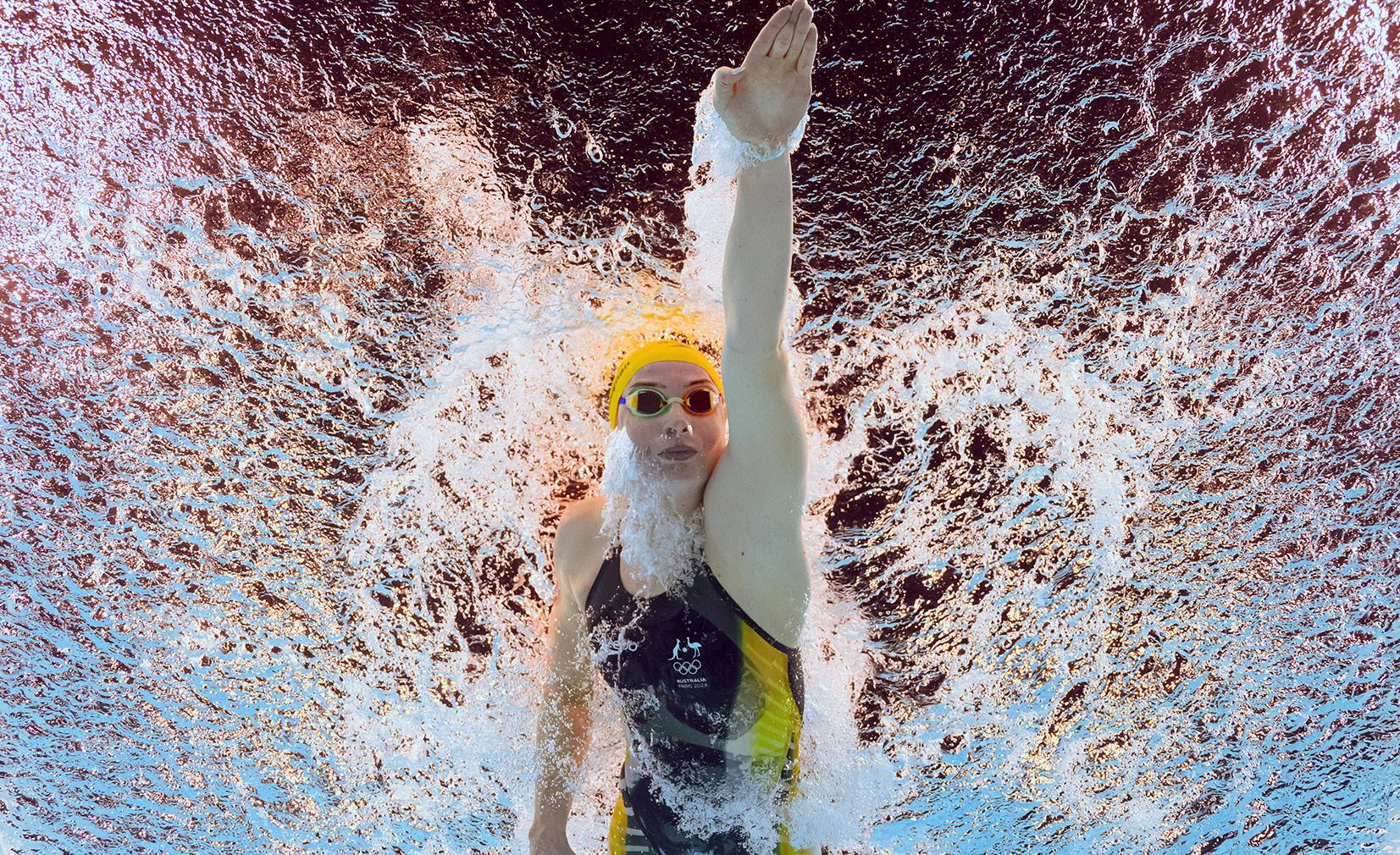
SOURCE 4 Queensland freestyle and butterfly swimmer Mollie O'Callaghan successfully applies power to her arms (in the pull phase) and legs (in the kick phase) to propel herself quickly down the pool during races, including at the 2024 Paris Olympics, where she won gold in the 200 metres freestyle.
Strength
Strength is the ability of a muscle (or group of muscles) to exert force by contracting against resistance. In other words, strength measures an athlete’s maximum ability to apply a force against an object. Lifting a heavy weight for a single repetition is an indicator of the strength of the muscles involved in this task. It is possible for an athlete to possess strength in some muscle groups and not others (e.g. muscles in the arms may be strong, while muscles in the back and legs may be weak).
A basketball player uses strength in a number of specialised movement sequences, including setting screens and boxing out opposition. It also takes strength to apply the specialised movement sequence of gripping a competition shot put weighing over 6 kilograms.
Traditional tests of strength include:
• the one-repetition maximum test – a test that measures the maximum weight an individual can lift for only one repetition with correct technique (e.g. a bicep curl or deadlift)
• the strength dynamometer test – a test using specialised equipment to measure muscular strength (e.g. in the back, legs and hands) in newtons.
When designing a customised strength fitness test that suits the fitness requirements for your physical activity, it is important to consider:
• the muscle groups that require strength
• the specialised movement sequences requiring strength.
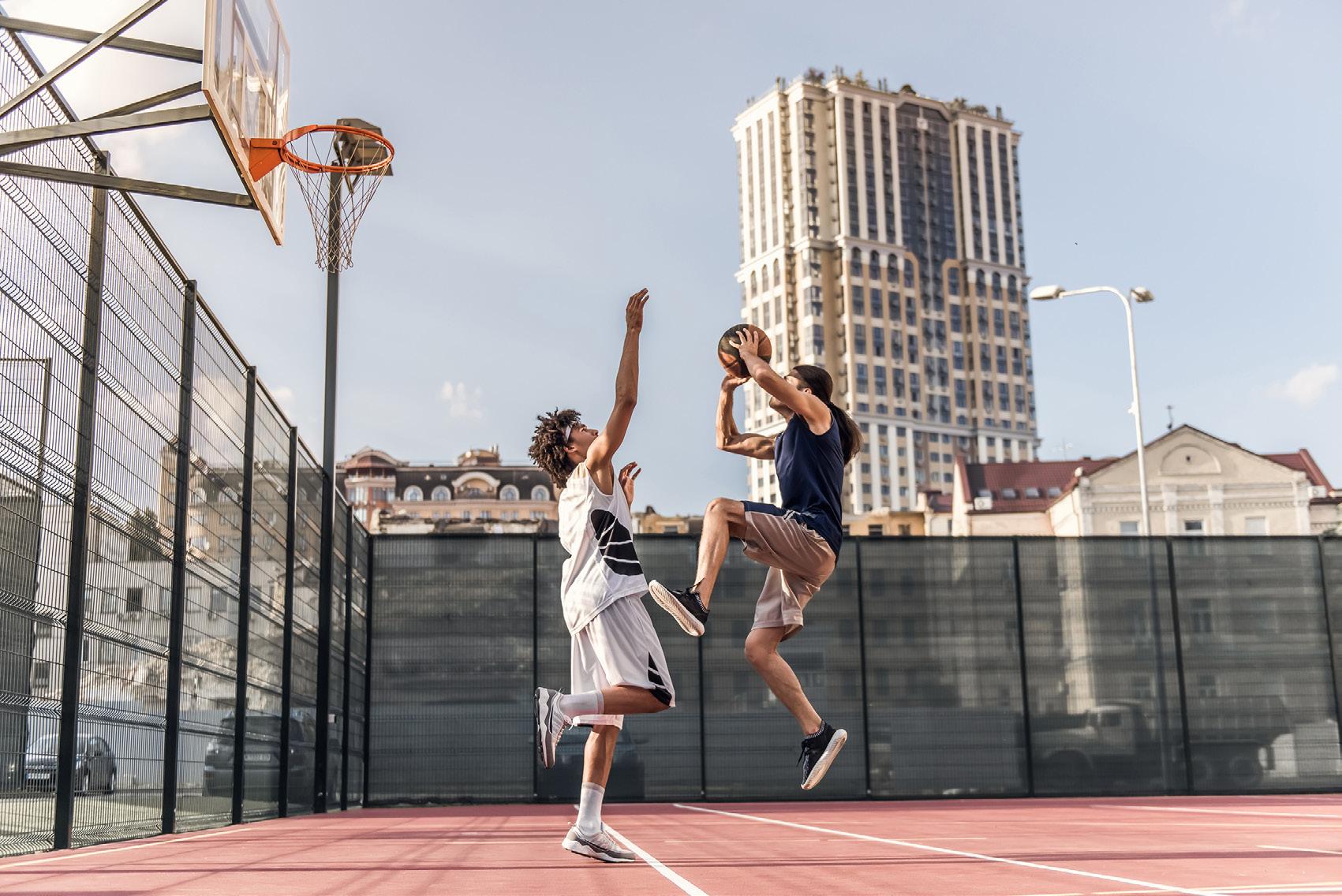
Study tip
If you have identified strength as an important component of fitness for your physical activity, you may decide to include the following training methods in your training strategy:
• resistance training – see Lesson 4.16
Resistance training (page 250)
• circuit training – see Lesson 4.19 Circuit training (page 268)
SOURCE 5 Basketball players require muscle strength to build up the endurance and stamina needed for specialised movement sequences.
Study tip
If you have identified speed as an important component of fitness for your physical activity, you may decide to include the following training methods in your training strategy:
• resistance (plyometric)
training – see Lesson 4.16
Resistance training (page 250)
• interval training (specifically highintensity interval training and short interval training)
– see Lesson 4.17
Interval training (page 259)
• circuit training – see Lesson 4.19
Circuit training (page 268).
Speed
Speed is the ability to move quickly. Speed can be used to describe:
• the movement from one point to another (e.g. the ability to move an entire body quickly across a field or court)
• the movement of specific limbs or muscles (e.g. the ability to move a limb or contract a muscle to complete a specialised movement sequence).
A traditional test of speed is:
• the straight line sprint test – a test that measures the time it takes for an athlete to cover a set distance of 20 or 40 metres.
When designing a speed fitness test that suits the fitness requirements for your physical activity, it is important to consider:
• the maximum distance you will be required to run in a straight line
• the direction you will be required to run quickly (e.g. forwards, backwards or sideways)
• the types of specialised movement sequences that require maximum speed.
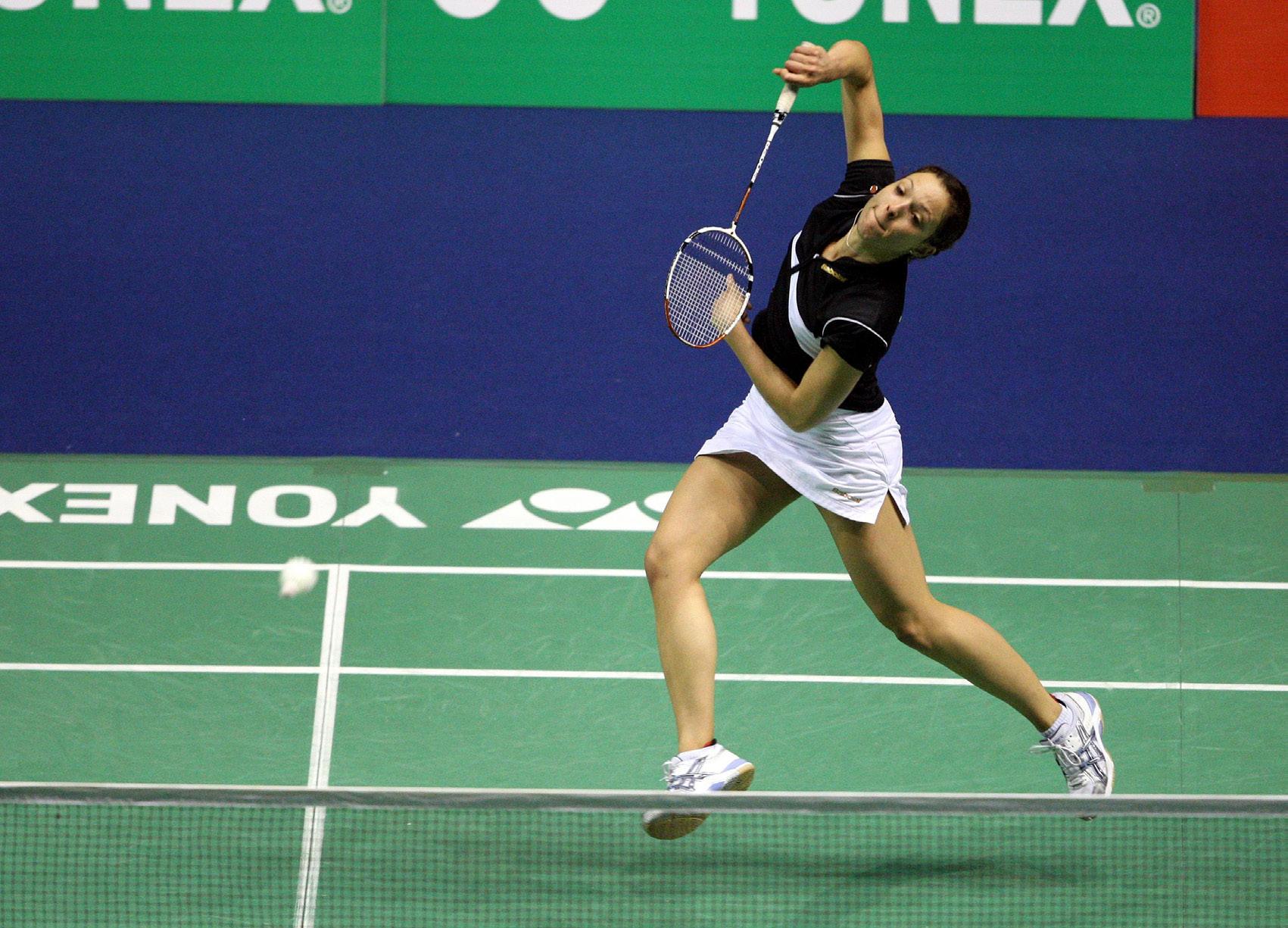
6 A
SOURCE
smash in badminton is an example of a specialised movement sequence that requires speed.
Agility
Agility is the ability to move the entire body from one position to another, or from one direction to another, quickly and precisely. An athlete who is agile can successfully dodge opponents, accelerate and decelerate quickly, and rapidly change the position of their body (or body parts), as required.
Touch football players require agility in many of their specialised movement sequences (e.g. sidestep and swerve, slow then fast movements, and the dump and split). Similarly, a volleyball player requires agility to move around the court in transition from defence to attack, in response to receiving a hit.
Traditional tests of agility include:
• the burpee test – a test that measures the maximum number of burpees a participant can complete in a set period of time
• the figure 8 agility run – a test that records the ability of an athlete to quickly run and turn in a figure 8
• the shuttle run test – a test that measures the ability of an athlete to run quickly between two lines that are 10 metres apart to pick up small blocks
• the Illinois agility test – a test that measures the ability of an athlete to run quickly in different directions and at different angles.
When designing a customised agility fitness test that suits the fitness requirements for your physical activity, it is important to consider:
• the types of movement strategies required in your physical activity (e.g. dodging and marking)
• the characteristics of the movements commonly experienced in your physical activity (e.g. the length of runs, the direction of runs, the angles and changes in direction of runs).
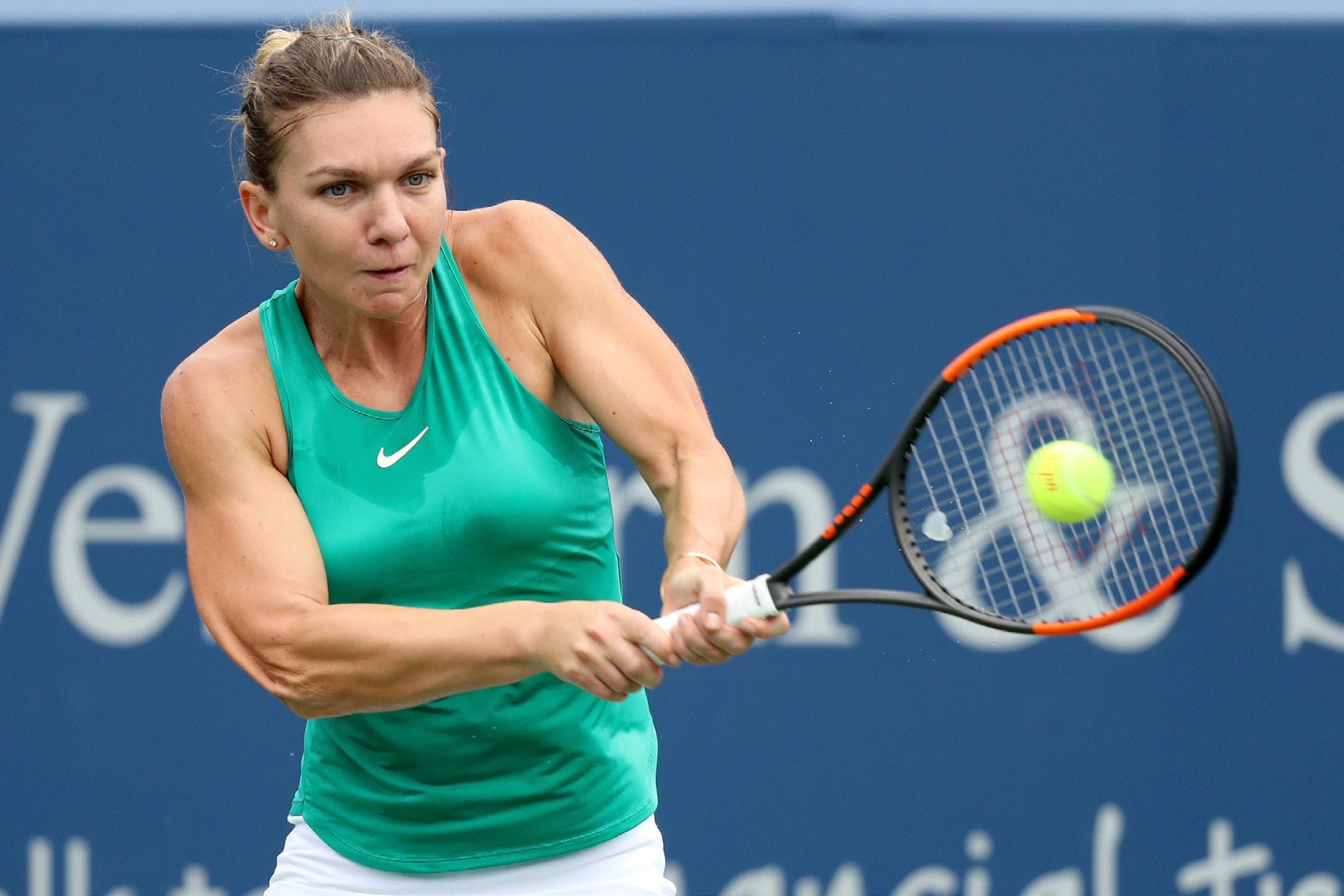
Study tip
If you have identified agility as an important component of fitness for your physical activity, you may decide to include the following training methods in your training strategy:
• interval training –see to Lesson 4.17 Interval training (page 259)
• circuit training – see Lesson 4.19 Circuit training (page 268)
SOURCE 7 A tennis player who repeatedly performs forehand and backhand shots in a long rally will require excellent muscular endurance in their arms.
Study tip
If you have identified muscular endurance as an important component of fitness for your physical activity, you may decide to include the following training methods in your training strategy:
• continuous training – see Lesson 4.14
Continuous training (page 245)
• resistance training
– see Lesson 4.16
Resistance training (page 250)
• interval training
– see Lesson 4.17
Interval training (page 259)
• circuit training
– see Lesson 4.19
Circuit training (page 268).
Muscular endurance
Muscular endurance is the ability to sustain or repeat a series of muscle contractions without fatigue. Having muscular endurance enables athletes to repeat a task over and over without suffering the effects of fatigue or causing injury.
A runner who can sustain repeated muscular contraction in their legs over a long distance, or a tennis player who can repeatedly perform forehand and backhand shots in a long tennis rally, is said to have good muscular endurance.
Traditional tests of muscular endurance include:
• the push-up test – a test that measures the number of push-ups an athlete can perform in a set period of time
• the sit-up test – a test that measures the number of sit-ups an athlete can perform in a set period of time
• the pull-up test – a test that measures the number of pull-ups an athlete can perform in a set period of time
• the flexed-arm hang test – a test that measures the period of time for which an athlete can perform a flexed-arm hang.
When designing a customised muscular endurance fitness test that suits the fitness requirements for your physical activity, it is important to consider:
• the muscle groups central to the repeated muscular efforts
• the amount of time in which repeated effort is required
• the level of intensity of the muscular contraction.
Flexibility
Study tip
If you have identified flexibility as an important component of fitness for your physical activity, you may decide to include the following training methods in your training strategy:
• flexibility training
– see Lesson 4.18
Flexibility training (page 264)
Flexibility is the ability of a joint to move through its full range of motion. Having flexibility enables an athlete to stretch a muscle (or group of muscles) across one or more joints to perform a wide range of motion. Being flexible also allows an athlete to make biomechanical adjustments to their technique, without stressing muscles and joints. It also reduces instances of injury caused when a joint is stretched and stressed beyond its elastic capacity. Many specialised movement sequences require a degree of flexibility, with some actually requiring increased flexibility for increased quality of movement.
A badminton player lunging to perform a drop shot requires a high level of groin flexibility, while a long jumper requires a high degree of flexibility to withstand the stress on their hamstring muscles during the flight phase of their jump.
Traditional tests of flexibility include:
• the goniometer test – a test that measures the range of motion of an athlete’s joints
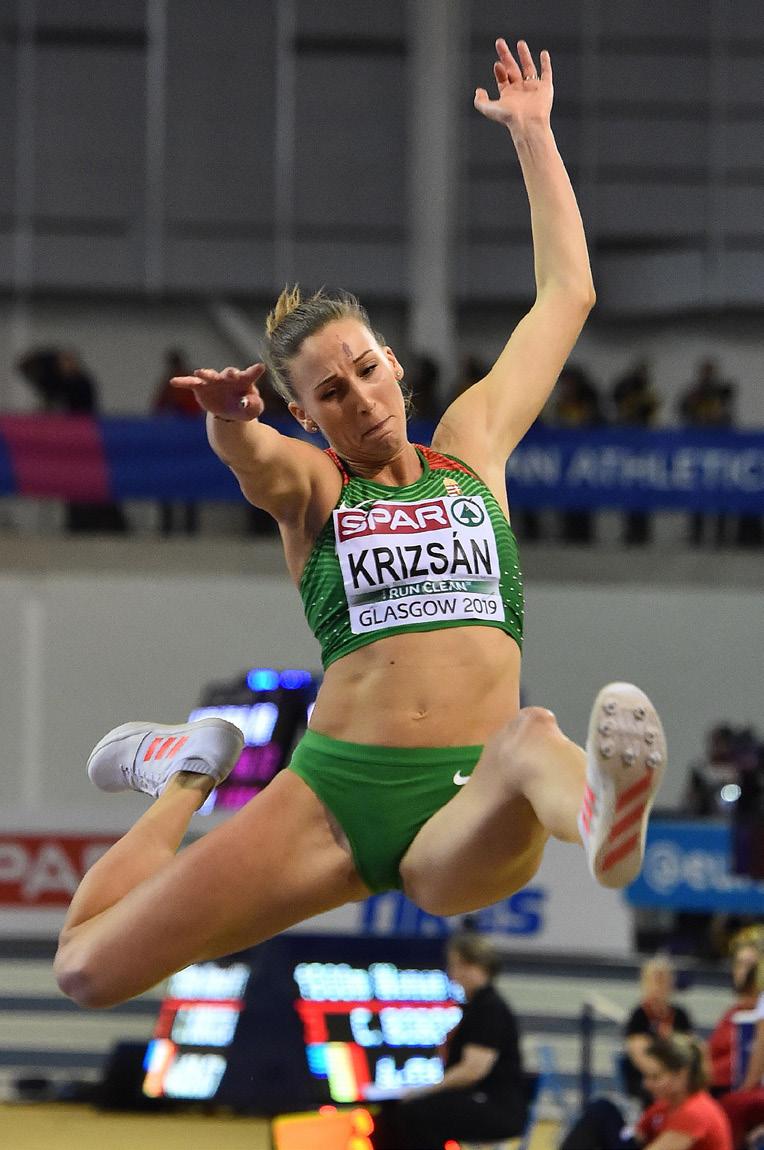
SOURCE 8 A long jumper requires good flexibility to handle the stress on their hamstring muscles during the flight phase of their jump.
• the sit-and-reach test – a test that measures how far an athlete in a seated, straight-legged position can reach towards their toes
• the shoulder rotation test – a test that measures an athlete’s degree of rotational spinal flexibility
• the ankle extension test – a test that measures an athlete’s degree of plantarflexion
• the Leighton flexometer test – a test that measures the angle of movement in a joint. When designing a customised flexibility fitness test that suits the fitness requirements for your physical activity, it is important to consider:
• the joint actions and muscle involvement in the specialised movement sequences of your physical activity
• the speed of joint movement.
Check your learning 4.4
Check your learning 4.4
Retrieval and comprehension
1 Choose the correct answer.
Identify the seven components of fitness in the Senior Physical Education syllabus.
A aerobic capacity, agility, balance, coordination, speed, strength, power
B agility, balance, muscular endurance, reaction time, speed, power, flexibility
C aerobic capacity, muscular endurance, speed, strength, power, flexibility, agility
D accuracy, body composition, speed, strength, power, flexibility, agility
2 Choose the correct answer.
Identify appropriate reasons why fitness testing might be undertaken for student athletes in Years 11 and 12.
A to evaluate progress, to determine event or position suitability, to identify baseline and follow-up fitness levels
B to identify medical problems, to set realistic and achievable fitness goals, to promote healthy lifestyles
C to identify weight loss goals, to develop team training strategies, to motivate athletes to improve results
D to evaluate progress, as part of an overall fitness plan, to rank students within a class
3 In your own words, define the term "fitness" as it relates to exercise physiology.
4 Explain why it is important to think about fitness in terms of the components of fitness.
5 Explain why it is important to measure physical fitness.
6 Identify and describe one specialised movement sequence from badminton and one specialised movement sequence from long jump that require athletes to have flexibility.
Analytical processes
7 Read Theory in action The best teams use specialised fitness tests. Analyse how traditional fitness tests were inadequate compared to the Wallabies’ special test protocol.
8 Determine which traditional aerobic capacity test would give you the most valid data for your selected physical activity. Explain your choice.
9 Identify a specialised movement sequence from your selected physical activity that requires power. Consider the features of the specialised movement sequence that make power a necessary component of fitness for successful performance.
Knowledge utilisation
10 Create a simple diagram that shows the relationship between power, speed and strength.
11 Select a position (if applicable) in your chosen physical activity and justify which two fitness components are most necessary for optimal performance.
12 Design a fitness test for one component of fitness relevant to a position within your selected physical activity or event. Justify your design, referring to the characteristics of the specialised movement sequences or movement strategies used in that position.
Lesson 4.5
Determine your fitness profile
Aim
To determine your level of fitness for your chosen physical activity using a range of traditional fitness tests.
Time
1 lesson (i.e. 60 minutes) with additional time (if required) to complete analysis and discussion tasks.
Equipment
• Game Performance Assessment Instrument 6 (GPAI 6)
• Pens
• Equipment for a fitness test, including:
stopwatch
cones
measuring tape
handgrip dynamometer (see Source 1)
Game Performance Assessment Instrument 6 (GPAI 6)
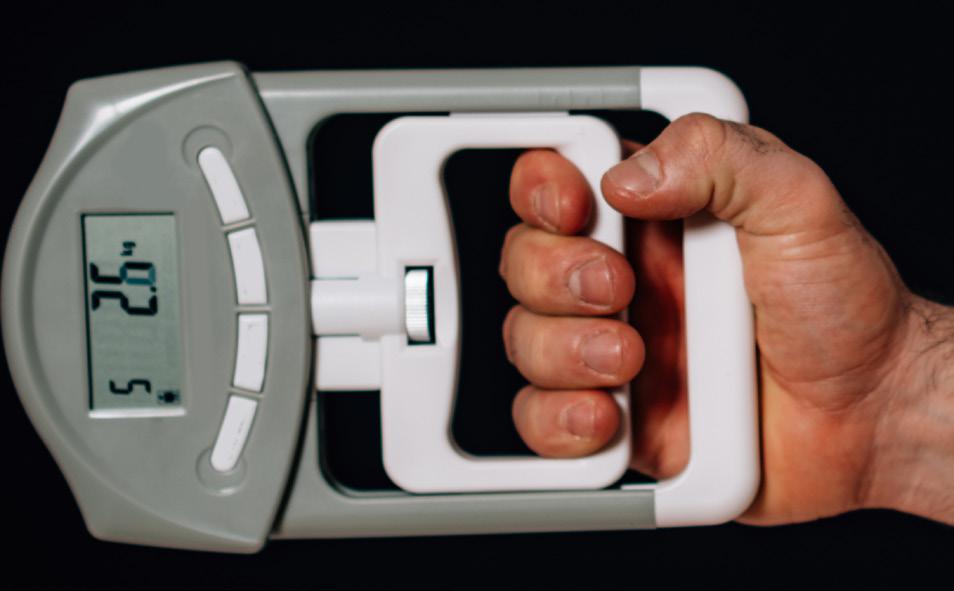
SOURCE 1 An example of a handgrip dynamometer used to measure grip strength
Note to teachers
Additional information, instructions and rating norms for the eight fitness tests covered in this Skill drill are provided for download.
Method
Step 1
Complete a teacher-led RAMP warm-up.
Step 2
Complete as many of the following fitness tests as are deemed relevant to your physical activity by your teacher. Instructions for these fitness tests are available to download.
• Beep test
• Sit-up test
• Sit-and-reach test
• Standing long jump test
• Grip strength test
• Push-up test
• Illinois agility test
• 40 m sprint test
Step 3
Record your fitness test results and ratings usings columns 1 and 2 of GPAI 6. You can find rating norms for each fitness test in the additional resource.
Additional resource: Additional information for the eight fitness tests
= worst)
Beep test
Sit-up test
Sit-and-reach test
Standing long jump test
Grip strength test
Push-up test
Illinois agility test
40 m sprint test
SOURCE 2 GPAI 6
Analysis and discussion tasks
1 It is important that you are able to analyse the primary data you have collected to design and implement a training strategy.
a Based on your understanding of components of fitness, use column 3 of GPAI 6 to record the component of fitness being targeted in each of the fitness tests you carried out.
b Using column 4 of GPAI 6, consider your fitness test results and rank them from your best (1) component of fitness to your worst (8).
2 Once you have analysed your fitness data, you will need to determine the limitations of your fitness profile to make decisions about your suitability in your selected physical activity.
a Identify the fitness and energy requirements of a variety of positions (if applicable) within your selected physical activity.
b Synthesise the primary data about your fitness and justify which position or event you would be most suited to in your selected physical activity.
3 As always, it is necessary to be discerning about the validity and reliability of the tests conducted when using the data in decision-making.
a For each fitness test you completed, evaluate how relevant the results are to your selected physical activity. Assess factors such as specialised movement sequences, movement strategies and game features, including duration, playing area, body parts used, etc.
b Identify one component of fitness and design a fitness test that considers the specific requirements of your selected physical activity.
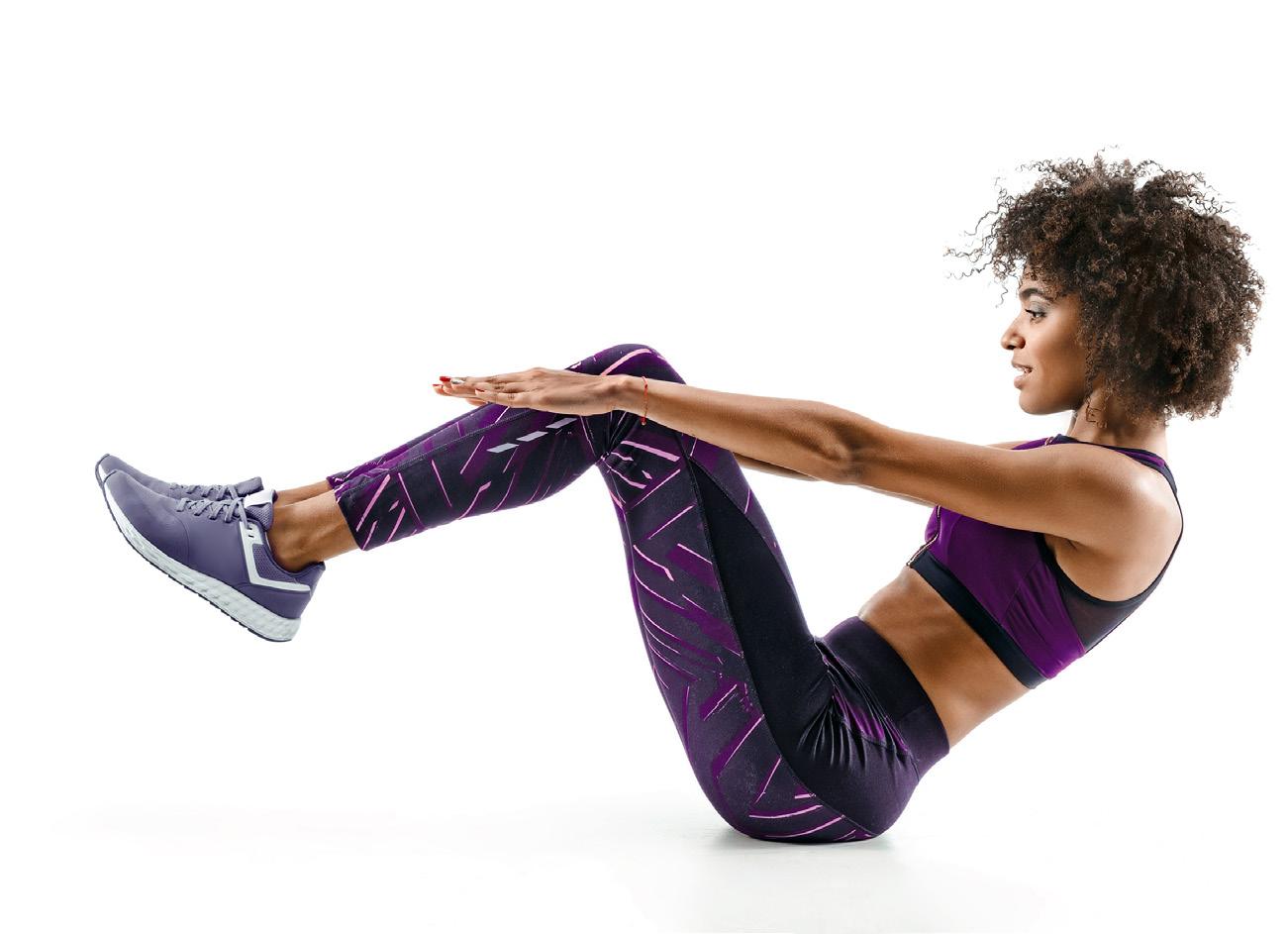
Learning intentions and success criteria
Lesson 4.6 Physiological responses to training
Key ideas
→ The body systems involved in oxygen uptake and delivery during physical activity are the respiratory system, the circulatory system and the muscular system.
→ The stress put on the body during training causes a number of changes to occur in the body. Some of these changes are immediate, and are known as acute physiological adaptations (e.g. increased heart rate [HR], increased respiratory rate [RR] and increased muscular temperature); others take place over a longer period of time, and are known as chronic physiological adaptations (e.g. increased number of lung capillaries, increased size and strength of heart, increased muscle mass).
→ An athlete’s maximal oxygen uptake is commonly referred to as VO2 max. VO2 max is impacted by the efficiency of the cardiovascular and respiratory systems, including factors such as lung capacity, stroke rate and cardiac output.
→ The intensity at which lactate begins to accumulate in the blood is known as the lactate threshold. The lactate threshold for an average athlete is reached at around 80 to 85 per cent of their maximum heart rate (MHR). If the intensity of physical activity is not reduced at this point, a more pronounced accumulation in blood lactate occurs, known as the lactate turn point (LTP). When the LTP is reached, muscle fibres can be prevented from contracting properly, causing fatigue.
respiratory system a body system responsible for the inhalation and exhalation of air (via the lungs, trachea, mouth and nasal passage)
circulatory system a body system responsible for moving blood, oxygen and nutrients around the body (via the heart, veins, arteries and smaller blood vessels)
muscular system a body system responsible for movement (via the muscles and tendons) haemoglobin a protein-based molecule in the blood that carries oxygen
Oxygen uptake and delivery to working muscles
As we have learnt, when athletes participate in physical activity for extended periods of time, oxygen must be present in the muscles for the aerobic system to resynthesise ATP without suffering fatigue. However, for adequate levels of oxygen to be made available during ATP resynthesis, a number of different body systems need to work together to extract oxygen from the air we breathe (i.e. oxygen uptake) and transport it to the working muscles (i.e. delivery).
The body systems involved in oxygen uptake and delivery during physical activity are:
• the respiratory system
• the circulatory system
• the muscular system.
Optimising the delivery of oxygen via these systems increases an individual’s aerobic capacity.
As shown in Source 1, breathing allows oxygen in the air to be extracted by the lungs (i.e. part of the respiratory system) so that it can be transported around the body in the blood (i.e. part of the circulatory system) and delivered to the muscles (i.e. part of the muscular system).
Oxygen passes from the lungs into the bloodstream through the alveoli walls. Once in the bloodstream, oxygen molecules attach to haemoglobin in red blood cells. From there, the circulatory system transports the oxygen via blood vessels to the working muscles. Source 2 shows how the heart acts as a pump, pushing the blood around the body, delivering oxygen to muscles and removing carbon dioxide (a waste product of the aerobic energy system) to be exhaled via the lungs.
Pulmonary artery
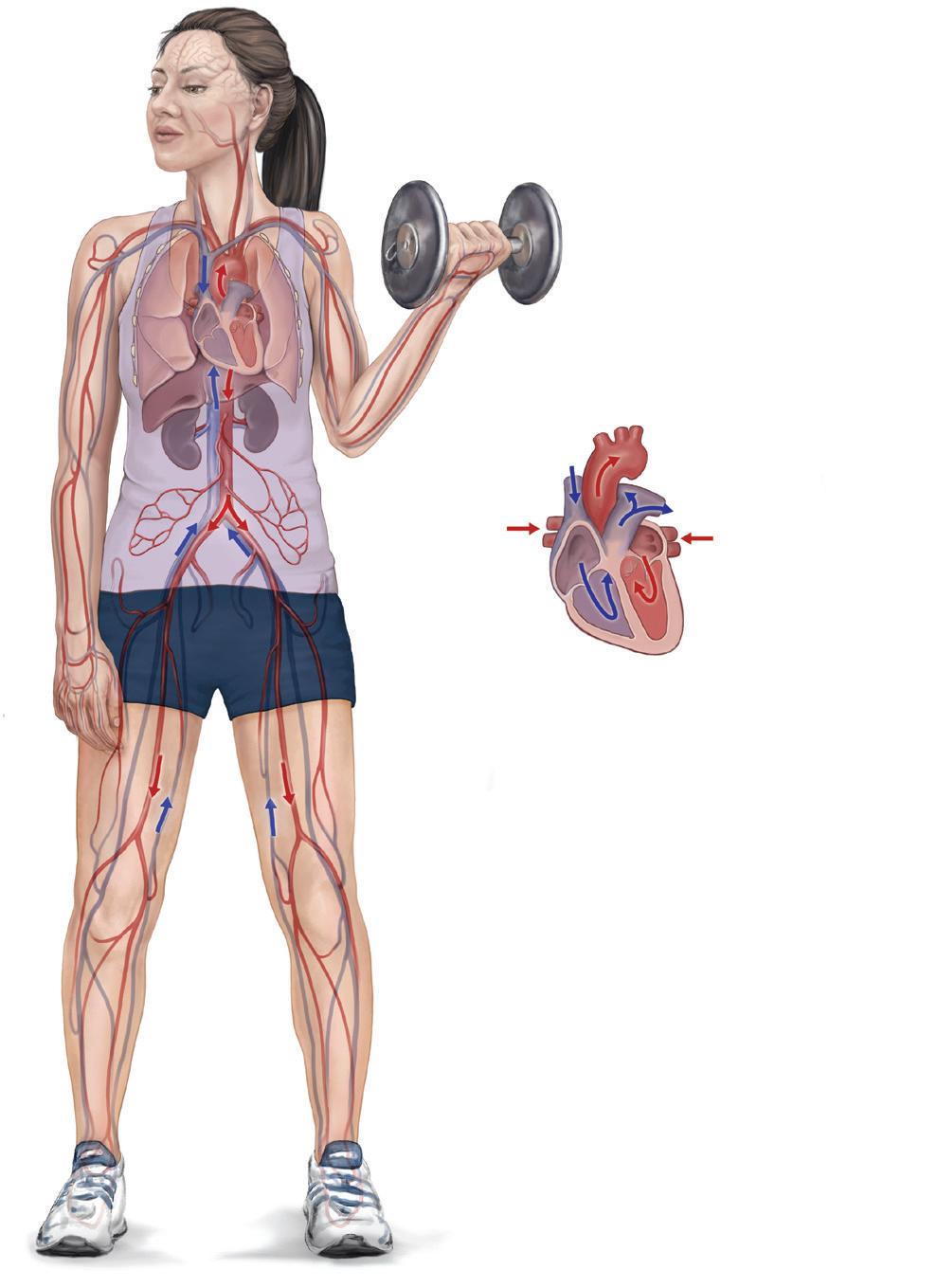
1 Oxygen
Right atrium
Right ventricle
Left ventricle
Left atrium
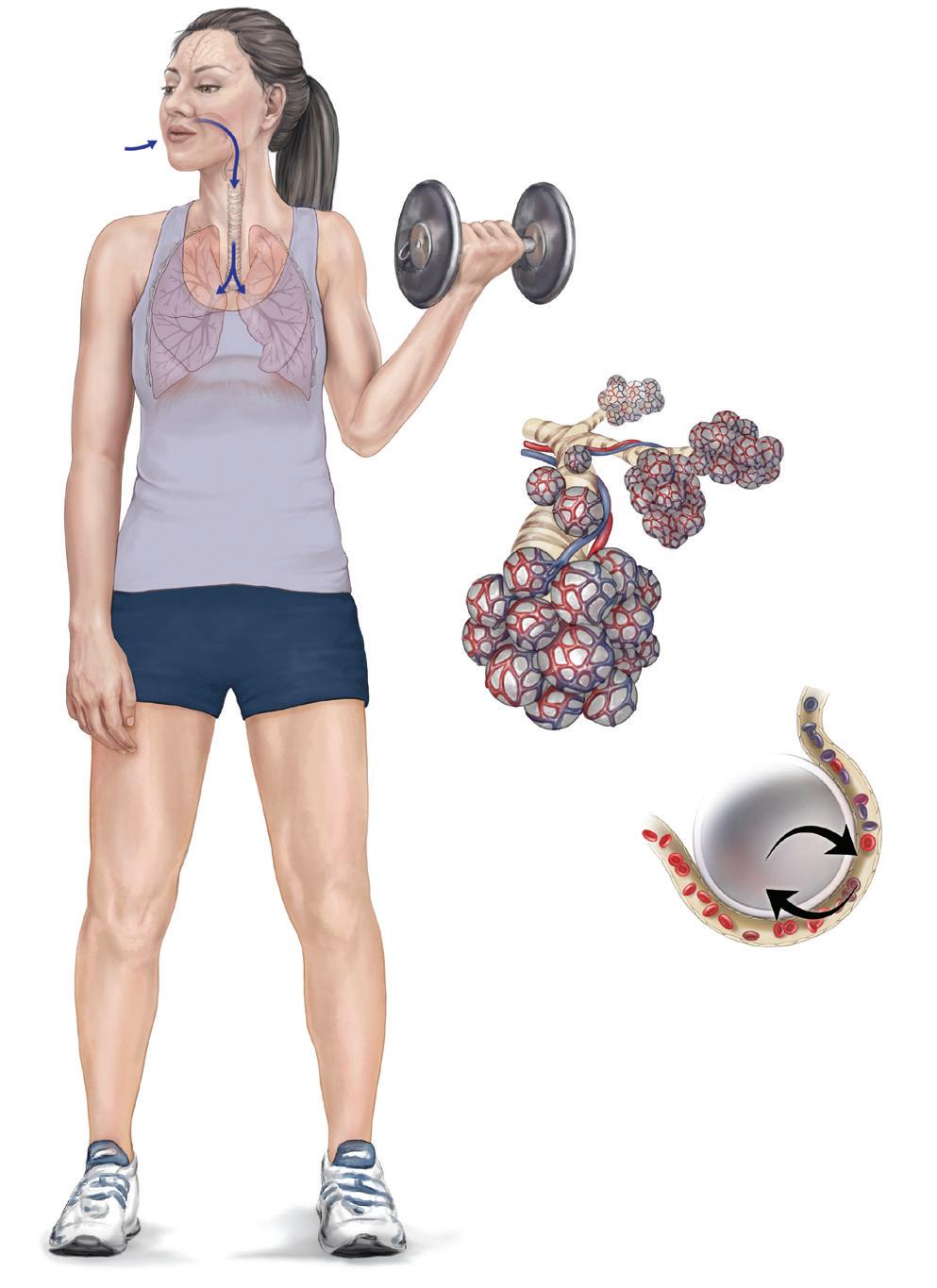

Maximal oxygen uptake – VO2 max


SOURCE 2 Oxygen-rich blood is taken from the lungs to the heart, from where it is pumped to the rest of the body (shown in red), including the working muscles. Carbon dioxide-rich blood travels from the muscles to the heart, from where it is pumped to the lungs to be exhaled out of the body (shown in blue).
An athlete’s maximal oxygen uptake is a measure of the maximum amount of oxygen they can use during intense physical activity. Maximal oxygen uptake considers an athlete’s ability to take in oxygen and deliver it efficiently to muscles during activity. Maximal oxygen uptake is more commonly referred to as VO 2 max ("V" for volume, "O2 " for oxygen and "max" for maximal).
The main factors that determine an athlete’s VO2 max are the function and structure of their respiratory and circulatory systems. In particular, VO2 max is strongly linked to overall cardiac output . Cardiac output is measured in litres of blood per minute and is the product of heart rate (HR) and stroke volume (SV). In simple terms, heart rate (HR) is the number of times the heart beats in one minute – and this can be counted easily using your watch and a simple pulse check.
Additional resource: How to measure your own heart rate
Stroke volume is the volume of blood pumped out of the left ventricle of the heart during each contraction. Specialised medical equipment is needed to measure this, using echocardiography or doppler ultrasound. As shown in Source 3, the blood from the left ventricle used to calculate stroke volume is reoxygenated blood from the respiratory system and lungs, which is travelling to the body and muscles.
VO2 max a measure of an individual’s maximum oxygen consumption during intense physical activity
SOURCE
is breathed into the lungs, where it is filtered into the bloodstream and carried in the blood to the heart.
Oxygen (O2) in
Carbon dioxide (CO2) out
CO2
Aorta
Right pulmonary artery (to right lung)
From upper body
Superior vena cava
Pulmonary valve
From right lung
Right atrium
Tricuspid valve
Right ventricle
Inferior vena cava
From lower body
SOURCE 3 The circulation of blood through the heart
For the record!
British rower and three-time Olympic champion Pete Reed has recorded a lung capacity of 11.68 litres. While there are rumours that US swimmer Michael Phelps had a lung capacity of around 12 litres, Reed’s is officially the largest lung capacity ever recorded.
Reed’s height of 1.98 metres and Phelps's height of 1.93 metres, along with body composition, sex and their physical activity as elite athletes, no doubt contributed to these impressive lung capacity measurements.
To body
Left pulmonary artery
From left lung
Left atrium
Aortic valve
Left ventricle
Interventricular septum
Research shows that an athlete who can can pump out more reoxygenated blood will be likely to have a higher VO2 max. The size and efficiency of an athlete’s lungs can influence the amount of oxygen available for uptake by the blood within the cardio-respiratory process. The overall volume of air that an athlete can breathe in is referred to as lung capacity. For most adult males this is around 6 litres, and for adult females it is around 4.7 litres, although this can be affected by age, body composition, ethnicity and the presence of respiratory illnesses such as asthma. Height can also impact overall lung capacity, with taller athletes often having a greater lung capacity than shorter athletes.
Lung capacity is influenced by the amount of physical activity a person undertakes and can be improved via aerobic endurance training. It is important to note that improving lung capacity alone will not necessarily improve VO2 max as this is a very specific measure of oxygen exchange within cells, not simply a measure of lung capacity.
As we have learnt, when you exercise, it is ideal for your body to resynthesise ATP in the presence of oxygen because no fatiguing by-products (such as lactic acid) are produced when oxygen is present. Therefore, it is beneficial to improve VO2 max through training your aerobic system.
Determining VO2 max is important for understanding how effectively your body can access the oxygen needed to produce ATP aerobically. Knowing your VO2 max can also be useful when planning and developing training programs and training sessions. The main factors influencing a person’s VO2 max results include their:
• age
• physical ability (i.e. genetics)
• sex
• level of physical fitness.
Determining VO2 max
The only way to measure VO2 max with a high degree of accuracy is in a sports laboratory. As shown in Source 4, athletes are connected to a breathing apparatus and heart rate monitor and asked to engage in a controlled physical activity (e.g. run on a treadmill, row on a rowing machine or ride on a stationary bike) for 10 to 20 minutes at ever-increasing speeds and levels of intensity. Specialised equipment is then used to measure respiratory rate and volume, as well as the concentration of oxygen and carbon dioxide inhaled and exhaled. The difference between these variables determines the maximum volume of oxygen used by the body over the course of the test. Measurements are provided in millilitres of oxygen used in one minute per kilogram of body weight (mL/kg/min).
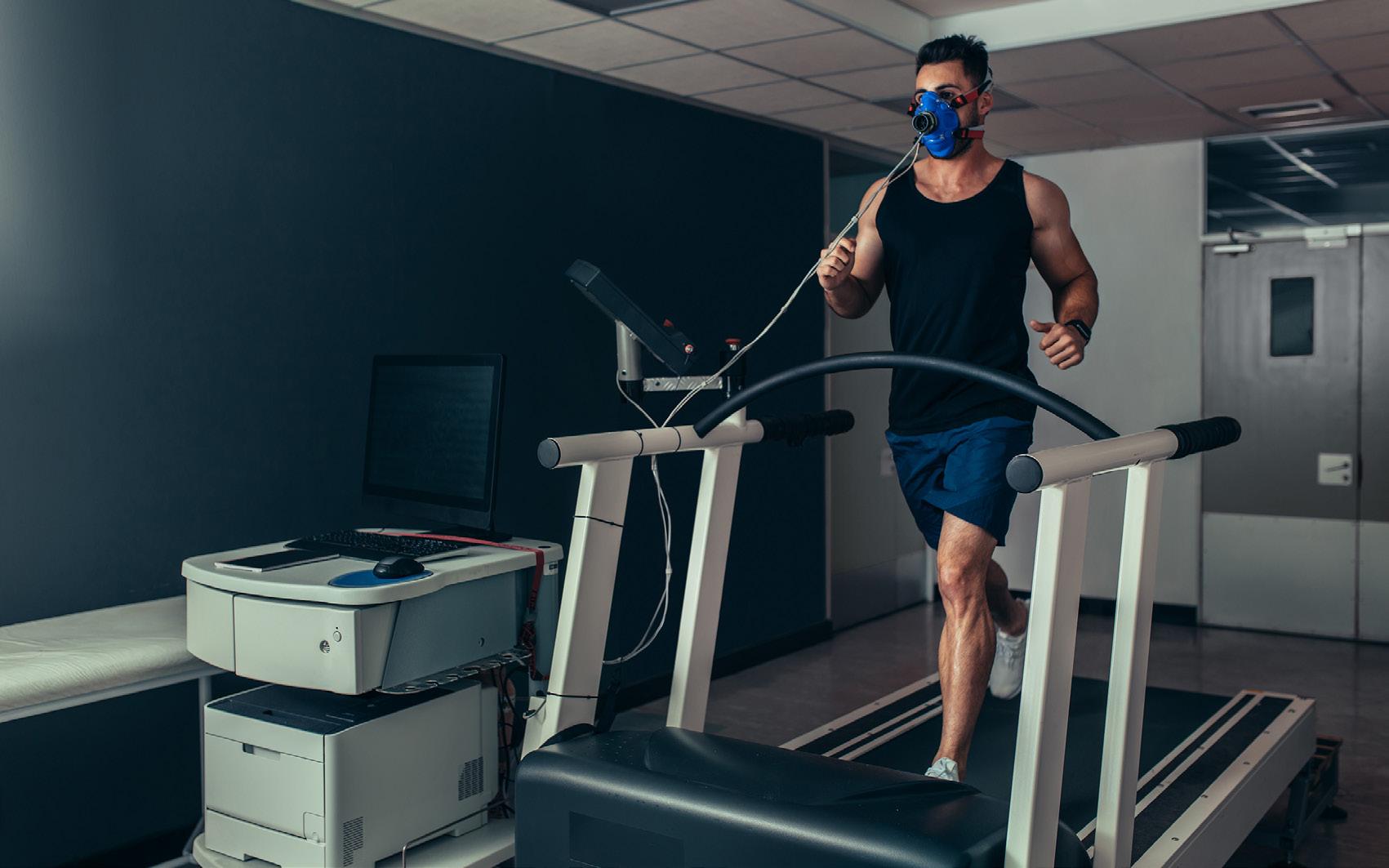
SOURCE 4 The only way to measure VO2 max with a high degree of accuracy is in a sports laboratory.
For most people, accessing this kind of specialised equipment is not possible, so a range of other tests designed to measure VO2 max have been developed, such as the beep test, Cooper’s 12 minute run test and the Balke VO2 max test. While such tests may not be as accurate as those conducted in a sports lab, they are often used to gain an estimate of VO2 max based on averages.
A number of other (less formal) tests can also be used to predict an athlete’s VO2 max. These will not be as accurate – and therefore should not be relied upon in isolation when determining your VO2 max – but they are useful for cross-checking against your field test results. These tests include:
• the race pace test – a test that measures the distance run (must be greater than 1.5 km) and time it took to complete and then applies a formula to calculate VO2 max
• the talk test – a test that that uses an athlete’s ability to hold a conversation to predict VO2 max based on the fact that breathing rate increases rapidly when nearing the ventilatory threshold.
In addition to these tests, some smart watches provide data predicting an athlete’s VO2 max (as shown in Source 5).
For the record!
Professional athletes (e.g. those who specialise in crosscountry skiing, cycling, rowing and marathon running) can obtain VO2 max scores in the 80s and 90s! In fact, the highest VO2 max score on record was achieved in 2012 by an 18-year-old Norwegian cyclist by the name of Oskar Svendsen, who had a score of 97.5 mL/kg/ min.
lactate threshold the point at which lactic acid (i.e. lactate and hydrogen ions) begins to accumulate in the muscles at a faster rate than it can be removed (in the blood)
lactate turn point (LTP) a term used to describe the point at which the accumulation of lactic acid (i.e. lactate and hydrogen ions) results in negative effects (e.g. prevents the muscle fibres from contracting properly) and fatigue
The lactate threshold
For athletes to perform at maximum efficiency for extended periods of time, it is important for a steady supply of oxygen to be delivered to the working muscles. In situations where oxygen is required by the muscles at a higher rate than the rate at which it can be delivered in the blood (i.e. when the body can’t deliver oxygen to the working muscles fast enough), ATP resynthesis takes place via anaerobic glycolysis and lactic acid is produced.

The exercise intensity at which blood lactate begins to accumulate in the muscles at a faster rate than it can be removed (in the blood) is known as the lactate threshold When exercising below the lactate threshold, the blood lactate being produced in the body can be removed without building up. If the intensity of physical activity is not reduced when the lactate threshold is reached, athletes experience an onset of blood lactate accumulation (OBLA) whereby blood lactate begins to accumulate exponentially (more and more quickly). This is also referred to as the lactate turn point (LTP). When the LTP is reached, the effects of the lactate can prevent the muscle fibres from contracting properly and negatively affect performance by bringing about fatigue.
Finding the balance between levels of lactic acid accumulation that are beneficial and those that are detrimental comes with training and experience. Blood lactate tolerance can improve as a physiological response to training, as can removal rates. This means that even though lactate production rates may be high during intense exercise, high removal rates may ensure that the athlete’s performance is not significantly affected.
Recent research indicates that lactate is mainly produced in the fast-twitch muscle fibres during exercise, as they use significant amounts of glucose for energy. Lactate is then cleared primarily by slow-twitch muscle fibres. The classification of muscle fibres into slow- and fast-twitch is a way to consider their structure and function. Type 1 or slow-twitch fibres are slower to contract (or "twitch") and slower to fatigue, while Type 2 or fast-twitch fibres are less fatigue-resistant but offer higher contraction or twitch speeds.
Both the production and the clearing of lactate are complex chemical processes that occur within cells. Fast-twitch muscle fibres have a higher content of a lactate transporter called MCT-4, which works to transport lactate away, while slow-twitch muscle fibres have more MCT-1, which accepts lactate into the fibres to synthesise into a final product of ATP.
hypertrophy an increase and growth in muscle cells as a response to longterm resistance training
One of the key considerations for planning to improve production and clearance of blood lactate within the muscles is to increase the overall size of the muscles. This is a long-term or chronic physiological adaptation to resistance training called hypertrophy, where the crosssection and overall mass or size of the muscle increases. Hypertrophy is easier to achieve with Type 2 fast-twitch muscle fibres, and generally is experienced after a minimum of six weeks of resistance training.
SOURCE 5 A number of smart watches and fitness trackers are available that measure and estimate VO2 max, but they are not very accurate. However, they can provide accurate heart rate readings, which can be beneficial for people who want to determine the heart rate they should train at.
To enhance physiological adaptations for slow-twitch muscle fibres, exercise physiologists plan for endurance training as this can enhance lactate clearance by increasing the number of MCT-1 in slow-twitch muscle fibres. When planning for training to increase lactate transport away from fast-twitch muscle fibres via an increase of MCT-4 transporters, exercise physiologists would include a combination of high-intensity and endurance training.
Athletes who have a good aerobic capacity, with physiological adaptations facilitating efficient oxygen uptake, generally have a higher lactate threshold than those with a lower aerobic capacity. This is because they are able to clear the lactate produced during anaerobic glycolysis more efficiently, and keep the amount of lactate at an appropriate level for long periods of time. Experiencing the effects of OBLA can also build an athlete’s tolerance to this fatiguing by-product, indicating the importance of incorporating anaerobic-based training in aerobic-based training strategies.
Calculating your lactate threshold
The lactate threshold for an average athlete is reached at around 85 per cent of their maximum heart rate (MHR). MHR is the highest number of beats your heart is capable of pumping per minute during exercise.
An estimated MHR can be calculated using one of the following formulas:
• 220 – age in years
• 206.9 – (0.67 × age in years).
The second formula is often more accurate for younger athletes, and it is recommended you use this formula when determining your MHR.
It is helpful to know your own lactate threshold in terms of your heart rate in order to determine:
• training intensities for optimal improvement
• performance intensity to avoid fatiguing effects of working within anaerobic training zones.
A Skill drill is also provided in Lesson 4.8 Skill drill: Determine your lacate threshold (page 223) to help you determine your lactate threshold.
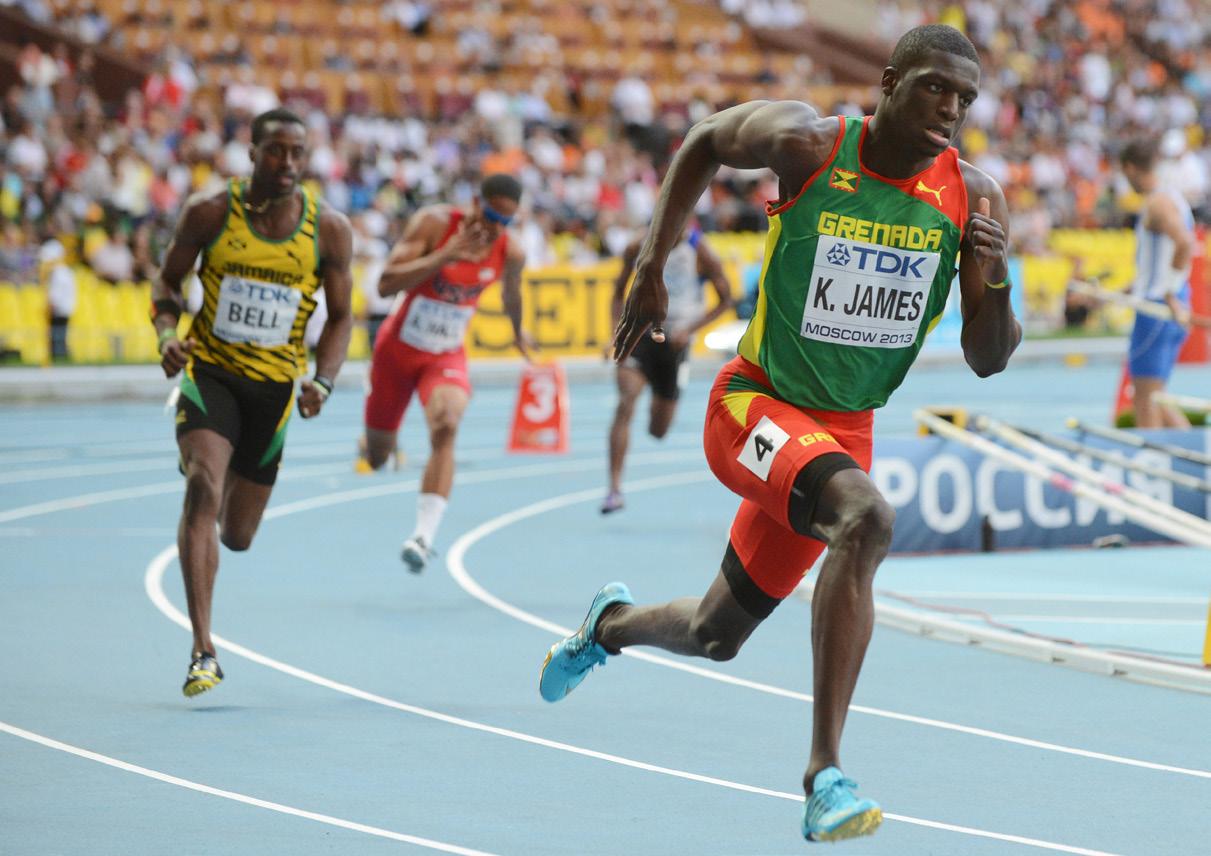
SOURCE 6 400-metre sprinters must cope with the onset of blood lactate accumulation in order to finish with a burst of high-intensity effort.
For the record!
An athlete’s muscle fibre composition can be a predictor of their sporting performance. Athletes with a higher proportion of Type 1 slow-twitch fibres tend to be more successful in longer-distance or slower endurance events. In comparison, athletes with a high proportion of Type 2 fast-twitch fibres are more successful in high-velocity, shorterduration or powerbased events. Muscle fibre type can have an impact on talent identification and on training methods for elite athletes. To determine the types and proportions of muscle fibres, highly sophisticated medical testing using antibodies can be undertaken; or athletes can undergo a more invasive muscle biopsy.
Study tip
You will need to determine your heart rate recovery as part of the primary data collection that will inform your training strategy in Internal assessment 3: Project – folio. To do this, it is important to measure your heart rate in beats per minute (bpm):
• immediately following exercise
• after 30 seconds
• after 1 minute. It is useful to do this several times over the course of your training session to see the impact of fatigue on your heart rate recovery. When evaluating the effectiveness of your training strategy, you can compare your heart rate recovery at 30-second intervals over time to see if it has improved.
acute physiological adaptation
immediate changes in body structures and organs in response to exercise
chronic physiological adaptation longerterm changes in body structures and organs in response to training
The impact of training on VO2 max and lactate threshold
When an athlete trains, they place their body under stress. This stress causes a number of changes to occur in the body that can increase VO2 max and lactate threshold. These changes can:
• be immediate – known as acute physiological adaptations
• take place over a longer period of time – known as chronic physiological adaptations
Acute physiological adaptations
Acute physiological adaptations are immediate changes that take place in response to exercise and which result in an increase in oxygen delivery to the working muscles. Acute physiological adaptations take place in the respiratory, circulatory and muscular systems. Acute physiological adaptations include:
• increased heart rate (HR)
• increased respiratory rate (RR)
• increase muscular temperature
• increased muscular fibre recruitment (i.e. when more and more muscle fibres are activated to increase the ability of the muscle to contract, and therefore the muscle increases in strength)
• dilation of blood vessels near the skin and redistribution of some blood volume to this area (resulting in reddening)
• sweating.
heart rate recovery a measure of the rate at which the heart returns to normal resting levels (in beats per minute) between periods of exercise
Acute adaptations occur during (and immediately after) exercise and place an athlete’s body under stress. It is this stress that sends messages to the body to make changes to the structure and function of the relevant body systems to improve their efficiency and reduce the stress experienced in future performances of the same activity.
After exercise, the body returns to its normal resting state. In fact, heart rate recovery is often used as a measure of fitness. Heart rate recovery is the measure of time it takes for the heart to return to normal resting levels.
The average person’s heart rate should drop by at least 20 beats per minute in the first minute following exercise. Highly trained athletes with efficient oxygen uptake and delivery can return their heart rate to normal within 30 seconds of finishing exercise. This allows them to participate in episodes of high-intensity activity with minimal recovery periods in between.
During a training session, it will generally take longer and longer for the heart rate to recover between bouts of intense physical activity. The amount of time required for heart rate recovery increases as an athlete becomes more and more fatigued.
However, with physiological adaptation, the heart’s ability to recover will improve. This is important in many "Invasion" and "Net and court" physical activities that require repeated episodes of high-intensity activity followed by short periods of rest.
Although heart rate recovery will differ from one athlete to another, generally speaking an athlete’s heart rate should decrease by around 20 beats per minute in the first minute after high intensity. If this is not the case, the athlete’s fitness is poor or they may have a medical condition that should be investigated further.
Chronic physiological adaptations
Chronic physiological adaptations are longer-term changes in body systems and organs that take place with training over time. Chronic physiological adaptations improve the ability of an athlete to deliver oxygen around the body during exercise and also help with recovery. The stress placed on a body during training sends a message to the body that adaptation is required. Once the stress is removed (i.e. in recovery), the body makes small changes to the structure and function of organs such as the lungs, heart, blood vessels and muscles so that they are better prepared to deal with this stress the next time. The changes that take place increase the efficiency of the delivery of oxygen throughout the body (i.e. VO2 max is increased). With greater access to oxygen, athletes can work at higher intensities for longer periods without experiencing the onset of blood lactate accumulation. Heart function
Study tip
For more information about planning and developing training programs and training sessions, refer to the following lessons:
• Lesson 4.21
The theory of periodisation (page 277)
• Lesson 4.22
Developing a training program (page 294)
• Lesson 4.24
Developing a training session plan (page 300)
SOURCE 7 A comparison of heart function for a trained and untrained 17-year-old athlete
Source: Adapted from NSCA – National Strength & Conditioning Association, 2016, Essentials of Strength Training and Conditioning, 4th edn, Human Kinetics, Champaign
You can download a table outlining the types of chronic physiological adaptations that take place over time with appropriate training.
Additional resource: Types of chronic physiological adaption
Check your learning 4.6
Check your learning 4.6
Retrieval and comprehension
1 Choose the correct answer.
Identify the most significant factors impacting lung capacity.
A age, gender, body composition, height
B age, gender, weight, heart size
C age, gender, height, diet
D age, gender, exposure to mould, height
2 Choose the correct answer.
The average person’s heart rate should drop by at least _____ in the first minute that exercise is stopped.
A 10 beats per minute
B 20 beats per minute
C 30 beats per minute
D 40 beats per minute
3 Construct a simple flowchart or diagram to explain how the oxygen from the air we breathe is delivered to the working muscles during physical activity.
4 Identify three acute physiological adaptations that take place during exercise and explain the reasons for these adaptations.
5 Identify three chronic physiological adaptations that take place after repeated periods of exercise. Explain how these adaptations help to optimise your performance.
6 Define the term "VO2 max".
7 Identify three tests that can be used to determine your VO2 max.
Analytical processes
8 Reflecton a time when you accumulated blood lactate. Identify the activity you were doing, describe the symptoms you experienced and explain the chemical process that took place.
9 During a touch football match, a winger scores a breakaway try, running the length of the field. After completing the try, they walk the ball back to the halfway line and note that their heart rate and respiratory rate are still elevated, despite the fact that they are no longer running.
a Determine which energy system they most likely used during the try.
b Consider some possible reasons for their elevated heart and respiratory rates, providing as much detail as possible.
10 Interpret Source 7 to explain why the trained athlete’s heart rate is lower than the untrained athlete’s heart rate in all conditions except for maximal heart rate.
Knowledge utilisation
11 Source 8 displays the blood lactate concentrations for trained and untrained males at various exercise intensities.
a Both lines move along the bottom of the graph for a period of time before turning upwards. Evaluate what this upwards turn represents. Justify your response.
b Decide whether line A or B represents the trained athlete. Justify your decision.
c If you were to plot a line on the graph that represented your own blood lactate concentration during the same exercise intensities, predict where your upwards turn would be. Copy this graph into your notebook and add your line to it.
SOURCE 8 Blood lactate concentration for male athletes at various exercise intensities
Lesson 4.7
Determine your VO2 max
Aim
To determine your VO2 max and reflect on its importance in your selected physical activity.
Time
1 lesson (i.e. 60 minutes) with additional time (if required) to complete analysis and discussion tasks.
Equipment
• Cones
• 400-metre running track
• Stopwatch
• Game Performance Assessment Instrument 7 (GPAI 7)
• Clipboard
• Pen Game Performance Assessment Instrument 7 (GPAI 7)
Method
Step 1
Place cones every 50 metres around a 400-metre track.
Step 2
Complete a teacher-led RAMP warm-up and form pairs.
Step 3
On a given signal, start running and attempt to keep a steady pace around the track. The aim is to run as far as you can in 15 minutes.
Step 4
Every time you finish a lap (i.e. cross the 400-metre start/finish line), your partner will run alongside you while you attempt to sing the first verse of a simple song (e.g. "Twinkle, Twinkle, Little Star"). After each attempt, your partner gives you a rating from 1 to 5 using GPAI 7, as follows:
1 – Can sing the song perfectly
2 – Can sing the song but with long gaps for breaths
3 – Can talk the song
4 – Can talk the song in single syllables
5 – Cannot talk the song with any coherence.
After 15 minutes, the teacher will signal to stop running. Your partner records how far you have run using GPAI 7.
Step 5
Swap roles with your partner and conduct the test again.
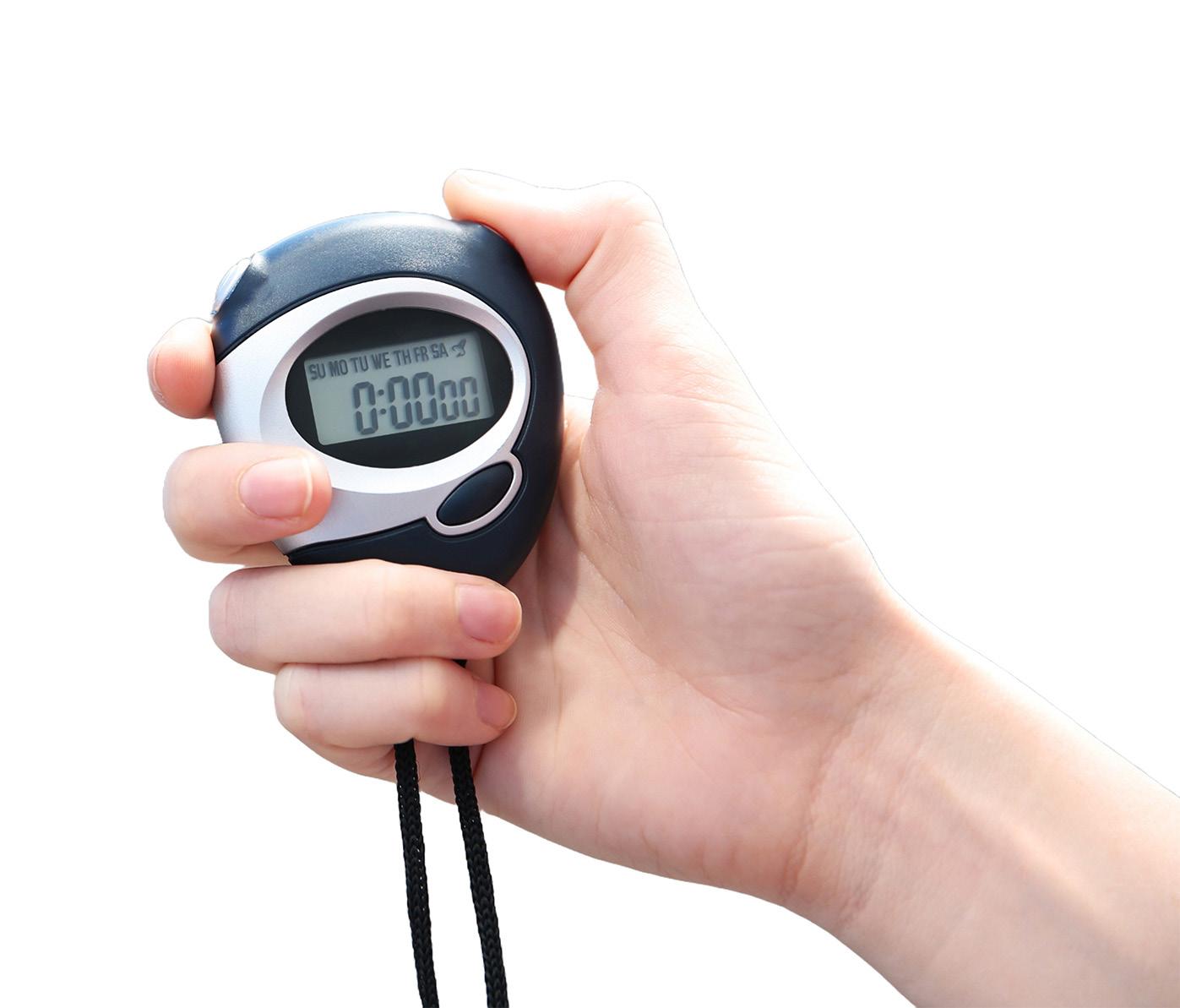
Total distance covered in metres
Predicted VO2 max – using the formula in Question 1 below
Rating for VO2 max – using data in Source 2 (for females) or Source 3 (for males)
SOURCE 1 GPAI 7
Analysis and discussion tasks
1 Calculate your VO2 max using the following formula: (((Total distance covered in metres ÷ 15) – 133) × 0.172) + 33.3. Record the data in GPAI 7.
2 Synthesise your primary data with the secondary data in Source 2 and Source 3 and assess your result. Record this information in GPAI 7.
3 The talk test suggests that when you are performing at your VO2 max, you will find it very difficult to talk or sing coherently. Analyse your talk test data. What do the results say about your performance? Does your talk test result indicate that you were getting an indication of your true VO2 max through this test? Explain your answer.
4 Once an initial analysis of data has been conducted, it is important to use this information to develop strategies to optimise your performance.
a Assess the importance of having a good VO2 max for your performance of specialised movement sequences and movement strategies in your selected physical activity.
b Determine whether improving your VO2 max should be a training objective in your training strategy. Justify your decision.
SOURCE 2 VO2 max norms for females (values in mL/kg/min)
SOURCE 3 VO2 max norms for males(values in mL/kg/min)
Lesson 4.8
Determine your lacate threshold
Aim
To determine your lactate threshold and reflect on its importance in your selected physical activity.
Time
1 lesson (i.e. 60 minutes) with additional time (if required) to complete analysis and discussion tasks.
Equipment
• 400-metre running track
• Heart rate monitors
• Stopwatch
• Data Collection Instrument 2 (DCI 2)
• Pen
• Clipboard
Data Collection Instrument 2 (DCI 2)
Method
Step 1
Conduct a teacher-led RAMP warm-up and put on your heart rate monitor.
Step 2
Determine your maximum heart rate using the formula 206.9 – (0.67 × age in years)
Calculate your target heart rates at 65%, 75%, 85% and 90% intensity by multiplying the percentage (as a decimal) by your maximum heart rate (e.g. 0.65 × 196).
Step 3
Complete the following set of intervals with 3 minutes' rest between each one:
• Interval A – 400 m run at 65% intensity
• Interval B – 400 m run at 75% intensity
• Interval C – 400 m run at 85% intensity
• Interval D – 400 m run at 90% intensity.
As you are completing each interval, feel for the signs of onset of blood lactate such as sore, heavy (jelly) legs, burning chest, nausea. This should occur at some point between intervals A and D, depending on your fitness levels. When you notice the symptoms note your HR, and at your next rest interval record it in DCI 2. This HR is your lactate threshold.
At each rest interval, record the following using DCI 2:
• heart rate (HR)
• rate of perceived exertion (RPE)
• qualitative data (e.g. observations and notes about muscle soreness, breathlessness).
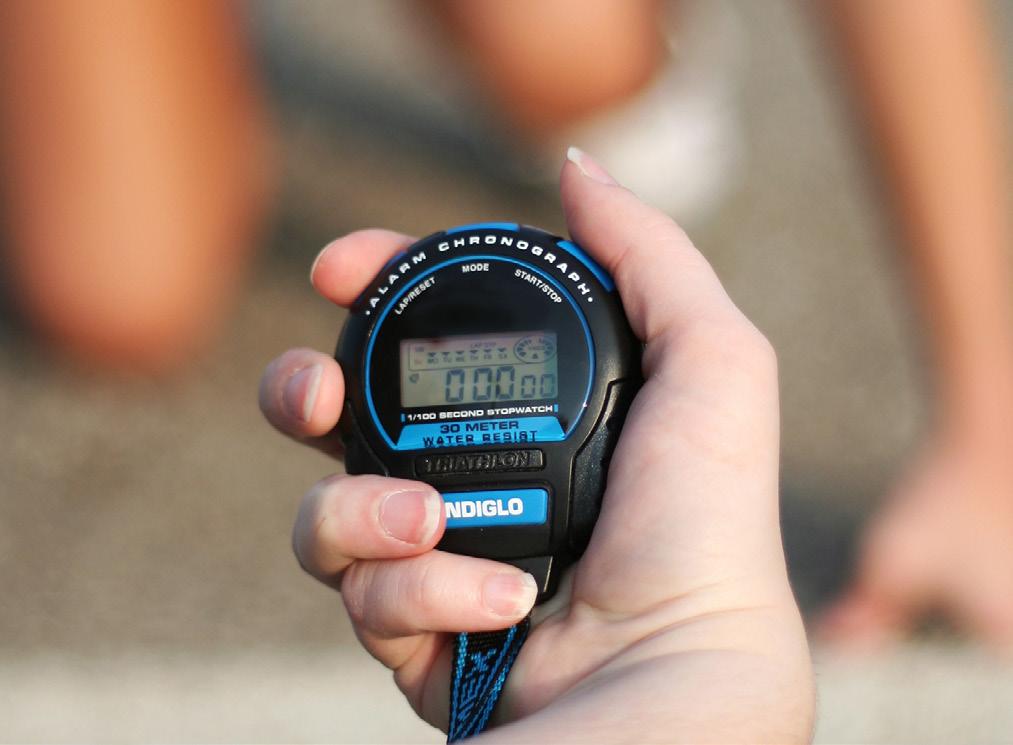
SOURCE 1 The exercise intensity at which blood lactate begins to accumulate in the muscles at a faster rate than it can be removed (in the blood) is known as the lactate threshold.
Heart rate (HR)
Rate of perceived exertion (RPE) (1–10)
Qualitative data (e.g. observations about muscle soreness, breathlessness)
Interval A – 400 m @ 65% intensity
Interval B – 400 m @ 75% intensity
Interval C – 400 m @ 85% intensity
Interval D – 400 m @ 90% intensity
Heart rate when symptoms of onset of blood lactate occur
This is an indication you have reached or exceeded your lactate threshold.
Heart rate at 85% of your maximum heart rate
This is a predicted lactate threshold.
SOURCE 2 DCI 2
Analysis and discussion tasks
1 Lactate threshold is commonly considered to be approximately 85% of your maximum heart rate, but there can be variations to this figure depending on an athlete’s fitness.
a Calculate 85% of your maximum heart rate and record it using DCI 2.
b Calculate the percentage max heart rate you were at when you first began to feel symptoms of an onset of blood lactate accumulation (OBLA). Was it over or under 85%?
2 Qualitative data can be a useful complement to quantitative data when analysing your findings and determining trends and relationships.
a Describe the relationship between your heart rate, your RPE and your data observations.
b Plot a line graph with HR on the y-axis and RPE on the x-axis. Annotate the graph with the qualitative data you collected at each rest interval.
3 Your lactate threshold can have an impact on your training and performance in your selected physical activity.
a Assess your lactate threshold result and determine the impact it may have on your ability to perform well in your selected physical activity.
b Argue the case for increasing your lactate threshold and determine ways this might be achieved.
Lesson 4.9
Analyse your heart rate recovery
Aim
To determine your heart rate recovery and reflect on its importance in your selected physical activity.
Time
1 lesson (i.e. 60 minutes) with additional time (if required) to complete analysis and discussion tasks.
Equipment
• Running field
• Agility poles
• Heart rate monitors
• Data Collection Instrument 3 (DCI 3)
• Stopwatches
• Whistle
• Clipboard
• Pen Data Collection Instrument 3 (DCI 3)
Method
Step 1
Form pairs and begin by measuring your own resting heart rate (HR) and the resting HR of your partner. Record your results in the "Resting HR" row of DCI 3.
Step 2
Now place two agility poles 40 metres apart. One pole marks Point A and the other marks Point B. The space between the poles is the sprint area. Set up enough agility poles to ensure there are no more than three pairs per sprint area.
Step 3
Participate in a teacher-led warm-up. At the end of the warm-up, conduct another HR check. Record this result in the "HR prior to sprint" column of "Interval 1".
Step 4
Start the first sprint, running at 100 per cent intensity from Point A to Point B and back again (i.e. 80 metres). Try to complete this in under 10 seconds. After 10 seconds, your teacher will blow a whistle to signal you to stop running.
If you were able to cover the 80 metres in 10 seconds, your partner will record this in the "Distance covered" column. If not, your partner will estimate the total distance you covered in 10 seconds and record it.
Measure your heart rate immediately after the sprint and ask your partner to record it in the "HR immediately after sprint" column.
Measure your heart rate again after 30 seconds (timed by your partner) and have your partner record it in the "HR 30 seconds after sprint" column.
Rest for 40 seconds (timed by your partner) before beginning "Interval 2". Note: You should rest for a total of 70 seconds between each sprint.
After 70 seconds, measure your heart rate again and record it in the "HR prior to sprint" column of "Interval 2".
Repeat these steps until you have completed all five intervals and have recorded all results using DCI 3.
Step 5
Switch with your partner and repeat this process.
Resting HR : 10-second sprints (max 80 m)
Interval 1
Interval 2
Interval 3
Interval 4
Interval 5
SOURCE 1 DCI 3
Analysis and discussion tasks
1 Analyse the results in the "Distance covered (m)" column of DCI 3 and comment on your ability to maintain speed across the five intervals. Explain how the ability to maintain speed may affect the validity of the test.
2 Use Source 2 (also available for download) to create a line graph using the heart rate data you have collected.
a Plot the results of your "HR prior to sprint" for each of the five intervals using a blue pen. Join these points using the same blue pen.
b Plot the results of your "HR immediately after sprint" for each of the five intervals using a red pen. Join these points using the same red pen.
c Plot the results of your "HR 30 seconds after sprint" for each of the five intervals using a green pen. Join these points using the same green pen.
Additional resource: Line graph template
3 Your line graph will now show a blue line representing your HR prior to each sprint, a red line representing your HR immediately after each sprint and a green line representing your HR 30 seconds after each sprint. Identify and analyse any trends or relationships you observe in the data.
4 Read the following quote taken from an article published by the School of Public Health at
University of California, Berkeley (USA):
5 "The length of time it takes for heart rate to return to normal is a good measure of fitness. The more fit you are, the faster the recovery."
a Consider this quote in the context of the results you gathered using DCI 3. With this secondary data in mind, assess your current level of fitness.
b Predict what the graph of a professional athlete would look like. Think about what the gradient (i.e. angle or steepness) of a graph showing heart rate increase (during exertion) or heart rate decrease (during rest) at each interval might look like compared to yours.
c Propose how you might modify this test to get more position- or event-specific data on heart rate recovery for your selected physical activity.
SOURCE 2 Line graph template
Lesson 4.10
Training requirements for physical activity
Key ideas
→ Athletes use training programs to plan, implement and evaluate training.
→ Before designing a training program, athletes should perform a game analysis and identify training objectives.
→ A training program is written on many levels over different time periods with increased detail. The time periods are annual plan, macrocycles, training phases, mesocycles, microcycles and training sessions.
→ Training programs should consider game analysis, training objectives, work volume, training load, tapering and recovery.
Defining training
Now that you have learnt how the body produces energy for physical activity, and how fitness is measured and classified, it is time to apply this knowledge to your training.
Learning intentions and success criteria
annual plan an athlete’s overall training plan for the year, which includes an overview of the physical activities that they need to train for and the times at which they must be in peak physical condition for competition. Annual plans can consist of one or more macrocycles game analysis the process of observing, recording and analysing performance and skill data from a selected game, sport or physical activity so that this information can be used to design relevant and appropriate training activities
Training is the action of undertaking a course of physical activity to:
• prepare for a particular physical activity and its movement strategies and specialised movement sequences
• prepare for a particular sporting event or performance
• achieve a personal energy or fitness goal
• encourage chronic physiological adaptations in the body.
Because both energy use and physical fitness vary between athletes, training is not a one-size-fits-all process. Furthermore, energy and fitness requirements also vary between different sports. For training to be effective (i.e. help athletes or teams to meet their individual goals and optimise their performance in their chosen sport), it has to be carefully planned, implemented and evaluated. To achieve this, athletes, coaches and exercise physiologists use a planning tool known as a training program.
In this lesson we will discuss the concept of training programs and introduce some key terms that you will need to become familiar with. Developing a training program can be a complex process because there are many factors to take into account. Don’t worry if the information provided here seems overwhelming to begin with. Each of these key terms and concepts will be revisited and explained in more detail over the remainder of this module. We will also demonstrate how they can be applied to a range of different physical activities and for a variety of timeframes to help athletes optimise their performance (see Source 2).
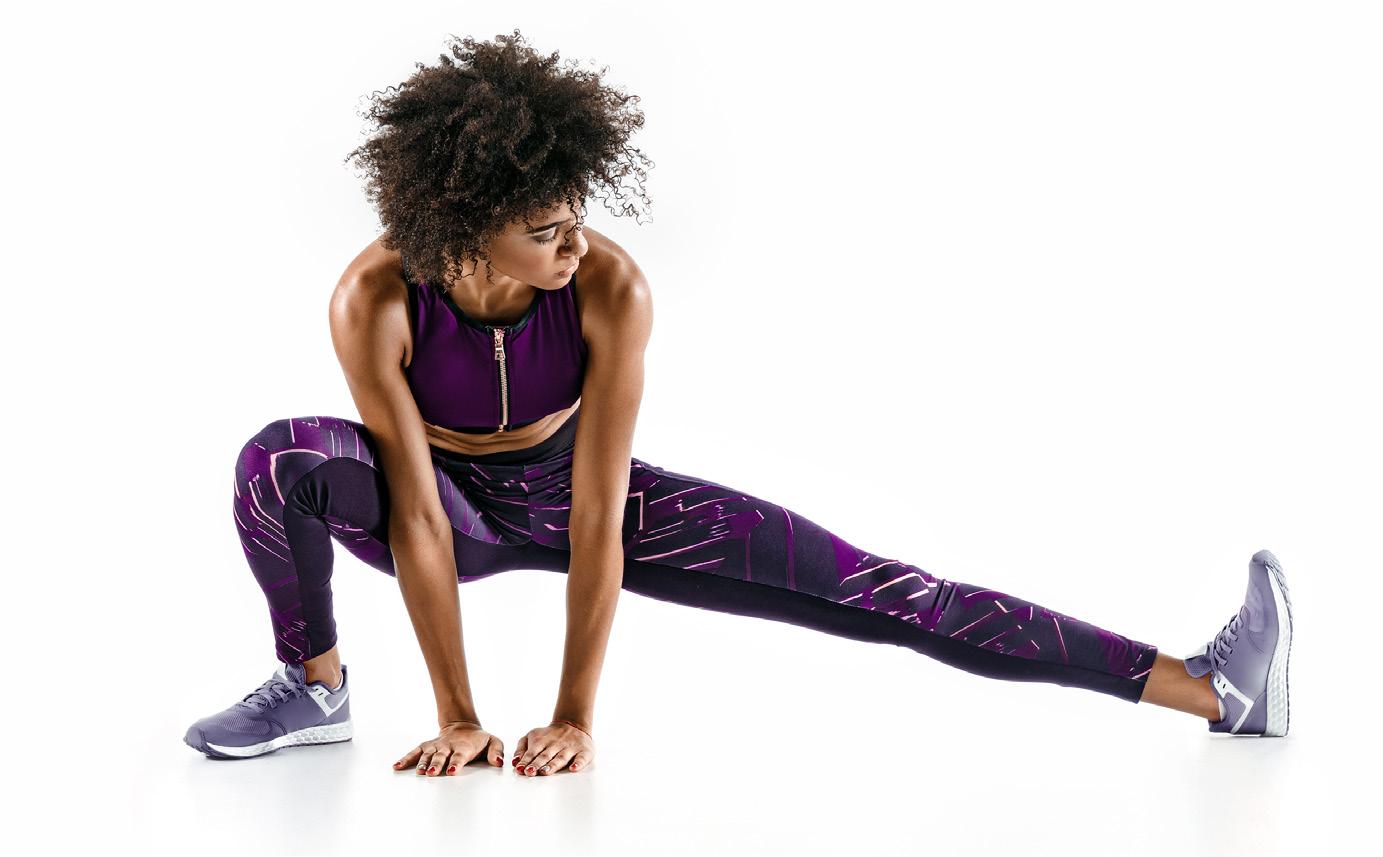
Introducing training programs
A training program is a comprehensive plan that athletes use to map out future training sessions. Having a training plan helps individuals or teams achieve energy, fitness and skill goals over a specific period of time (e.g. one week, two months, one year, or even a four-year Olympic or Paralympic cycle).
Athletes begin the process of designing a training program by creating an annual plan. This is an overview of the year, highlighting the times when the athlete needs to be in optimal physical condition. Annual plans can also help to point out where clashes can occur (e.g. when an athlete needs to be training and competing for two physical activities at the same time).
There are several factors to consider when developing a training program, and they will be discussed in more detail later in this module. For now, you need to know that there are three crucial steps to follow when drafting a training program.
• Step 1 – Determine personal training needs through game analysis
• Step 2 – Identify specific training objectives
• Step 3 – Develop a training program
We will now look at each of these steps in more detail.
Step 1 – Determine personal training needs through game analysis
The first step in developing a training program is for an athlete to determine their personal needs by conducting a game analysis. Game analysis is the process of an athlete observing, recording and analysing performance and skill data from a selected game, sport or physical activity and using this to design relevant and appropriate training activities. You will learn more about game analysis and how to conduct your own in Lesson 4.22 Developing a training program (page 288) and Lesson 4.23 Skill drill: Conduct a game analysis (page 296).
Step 2 – Identify specific training objectives
The second step in developing a training program is to identify the specific training objectives that an athlete will have to achieve to reach their overall goals. It is important to have an understanding of the science of training, especially principles of training and training methods, before setting objectives. These concepts are introduced below and will be discussed in more detail in Lesson 4.12 Principles of training (page 236) and Lesson 4.13 Training methods (page 243).
Step 3 – Develop a training program
Once an athlete has conducted a game analysis and identified their specific training objectives, they must now address some other important features of a training program. These include:
• work volume and training load – this includes a detailed overview of the frequency (how often), the duration (how long) and the intensity (how hard) of training over time. The frequency and the duration combined is referred to as the work volume. The work volume combined with the intensity is known as the training load
• tapering and recovery – tapering is the process of gradually reducing the difficulty and intensity of training as an athlete nears competition. All training programs must include a tapering period to optimise performance. Recovery is the process of allowing the body to recuperate and return to its normal resting state after training. It is important as it allows the physiological adaption to take place.
Things to consider when developing a training program
To correctly and appropriately plan and construct the core features of a training program, an athlete will need to consider:
• principles of training – the eight principles of training in the Physical Education 2025 General Senior Syllabus are progressive overload, frequency, reversibility, intensity, duration, specificity, individuality and variety
• training methods – the six training methods in the Physical Education 2025 General Senior Syllabus are flexibility training, resistance training, interval training, circuit training, continuous training and fartlek training
principles of training a set of guidelines considered in the development, design and evaluation of a training strategy (specificity, frequency, intensity, duration, progressive overload, individuality, variety) training methods forms of exercise that can be selected and used to target particular components of fitness and performance (i.e. continuous training, fartlek training, resistance training, interval training, flexibility training, circuit training) work volume a general measure of how much exercise an athlete does; a combination of the frequency and duration of the training activities undertaken training load the combination of work volume and intensity; a general measure of the overall difficulty of the training tapering the gradual reduction of work volume and/or intensity of training, in the lead-up to a major competition, in order for the athlete to peak recovery the process of an athlete’s body returning to its normal state; for example, a fatigued athlete’s muscles beginning to feel normal again, and their breathing rate slowing to a normal rate
periodisation the process of dividing an annual training plan into a series of smaller, more manageable periods of time (known as macrocycles, training phases, mesocycles, microcycles and training sessions). Each period of time is designed to target specific training objectives
training phases four distinct stages of training that combine to make an annual plan. Each training phase is designed to target a specific training objective over a specific period of time. There are four main training phases: the preparatory phase, the precompetition phase, the competition phase and the transition phase
• periodisation – the process of dividing a large period of time for training into a series of smaller, more manageable periods of time, each with a specific training objective is called periodisation. There are six building blocks, or levels, to the periodisation model:
– annual plan – a term used to describe an athlete’s planning over a 12-month period
– macrocycle – a term used to describe the time from when an athlete starts to train for a season or event, to the completion of their post-season or post-event recovery; an annual plan can consist of one or more macrocycles
– training phases – each macrocycle is made up of four training phases, each with its own specific training objective; the four training phases are the preparatory phase, the pre-competition phase, the competition phase and the transition phase
– mesocycles – each training phase is broken into four- to six-week blocks called mesocycles, each with a specific training focus
– microcycles – each mesocycle is further broken down into microcycles, or training periods of 7 to 10 days, each with a specific training focus
– training sessions – the smallest component in a training program, the training session, is a period of approximately one to two hours, with a specific energy, fitness or skill development focus.
• training zones – the range of intensity within which an athlete should train depending on whether they wish to target the anaerobic energy system or the aerobic energy system
• fatigue and recovery – fatigue is the tiring of muscles and organs that occurs when bodies are placed under stress during and after training; recovery is the process of an athlete’s body returning to its normal state.
This information is provided here so that you can develop a general idea of what training programs are and what needs to be taken into consideration in order to create effective training programs. Over the remainder of this module, you will develop a more thorough understanding of each of these concepts and how they relate to each other.
macrocycle the training period from the beginning of the preparatory training phase to the end of a transition training phase within an annual plan
mesocycles training periods, generally 4 to 6 weeks in duration, with a specific training focus microcycles training periods, generally 7 to 10 days in duration, with a specific training focus
SOURCE 1 A visual overview of how periodisation works over the course of an annual plan
Developing a training program that works for you
To be most effective, every training program should be tailored to the needs and wants of each individual athlete.
Source 2 provides some examples of how the needs of three different athletes (competing in different sports) can influence the training goals and the initial planning for their individual training programs. Each of these athletes has a different level of experience and proficiency, and particular areas in which they would like to improve.
Athlete Category of physical activity
Event/ sport position
Jayden Invasion Basketball (centre)
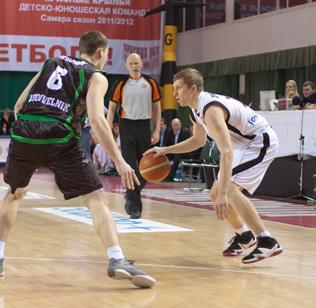
Beginner–intermediate "I feel puffed, with a burning chest after the first quarter of most games. This reduces my ability to keep up with the pace of the game and perform effectively after the first quarter."
Sam Performance 100 m sprint Intermediate–advanced
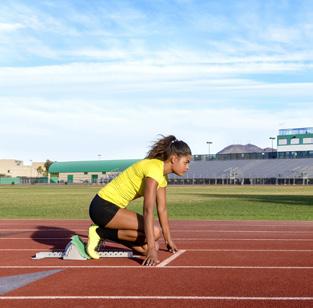
Ada Net and court Volleyball (passer hitter)
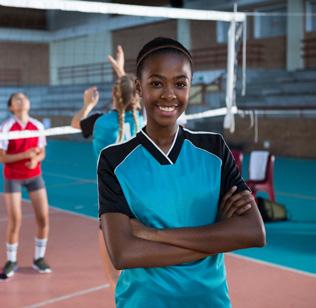
"I am too slow out of the starting blocks."
"I want to improve my aerobic capacity so that I can be effective for more than the first quarter."
1 × mesocycle targeting aerobic capacity (specific to the specialised movement sequences and movement strategies of basketball)
Advanced "I feel fatigued in the legs as the game goes on and I lose effectiveness in attack because I can’t maintain a powerful spike approach. My jumps lose height and my spikes go into the net and/or are mistimed."
"I want to learn how to drive out of the starting blocks with more power to improve my start time (first three steps)."
"I want to improve my muscular endurance so that I can jump higher and my spikes can remain effective for the entire game."
SOURCE 2 Training programs should be written specifically for an athlete’s individual needs. The length of a training program will depend on the difficulty level of the athlete’s goal.
Study tip
The Physical Education 2025 v1.2 General Senior Syllabus identifies the features of a training program as:
• specific training objectives to achieve a determined outcome
• game analysis
• work volume, frequency, intensity and duration of exercise
• tapering and recovery to achieve the determined outcome for a particular phase. You need to be familiar with this information, as you may be required to answer questions about this in the external examination.
Weblink: Physical Education General Senior Syllabus.
3 × 60-minute training sessions targeting power and technique for block starts
1–2 × microcycles targeting muscular endurance (specific to the specialised movement sequences and movement strategies of volleyball) Implement as many training sessions as possible within allocated microcycle
Check your learning 4.10
Check your learning 4.10
Retrieval and comprehension
1 Choose the correct answer.
Identify the four main phases of training.
A the preparatory phase, the pre-competition phase, the competition phase, the off-season
B periodisation, the macrocycle phase, the mesocycle phase, the microcycle phase
C the preparatory phase, the pre-competition phase, the competition phase and the transition phase
D the preparatory phase, the mesocycle phase, the competition phase, the microcycle phase
2 Choose the correct answer.
Identify the eight principles of training.
A specificity, frequency, reversibility, intensity, duration, progressive overload, individuality and variety
B specificity, work volume, reversibility, intensity, duration, individuality, variety, recovery
C specificity, progressive overload, variety, tedium, warm-up, reversibility, duration, intensity
D FITT, recovery, adaptability, individuality, duration, reversibility, work volume, specificity
3 Define what is meant by a "training program".
4 List the key features of a training program.
Analytical processes
5 Analyse Jayden, Sam and Ada’s initial planning for their training programs. Using a list of dot points, contrast their goals and planned training time.
Knowledge utilisation
6 In a written response of 150 words, discuss why training programs require a high degree of thought and planning to be successful. You may need to conduct some additional research online to help you formulate your response.
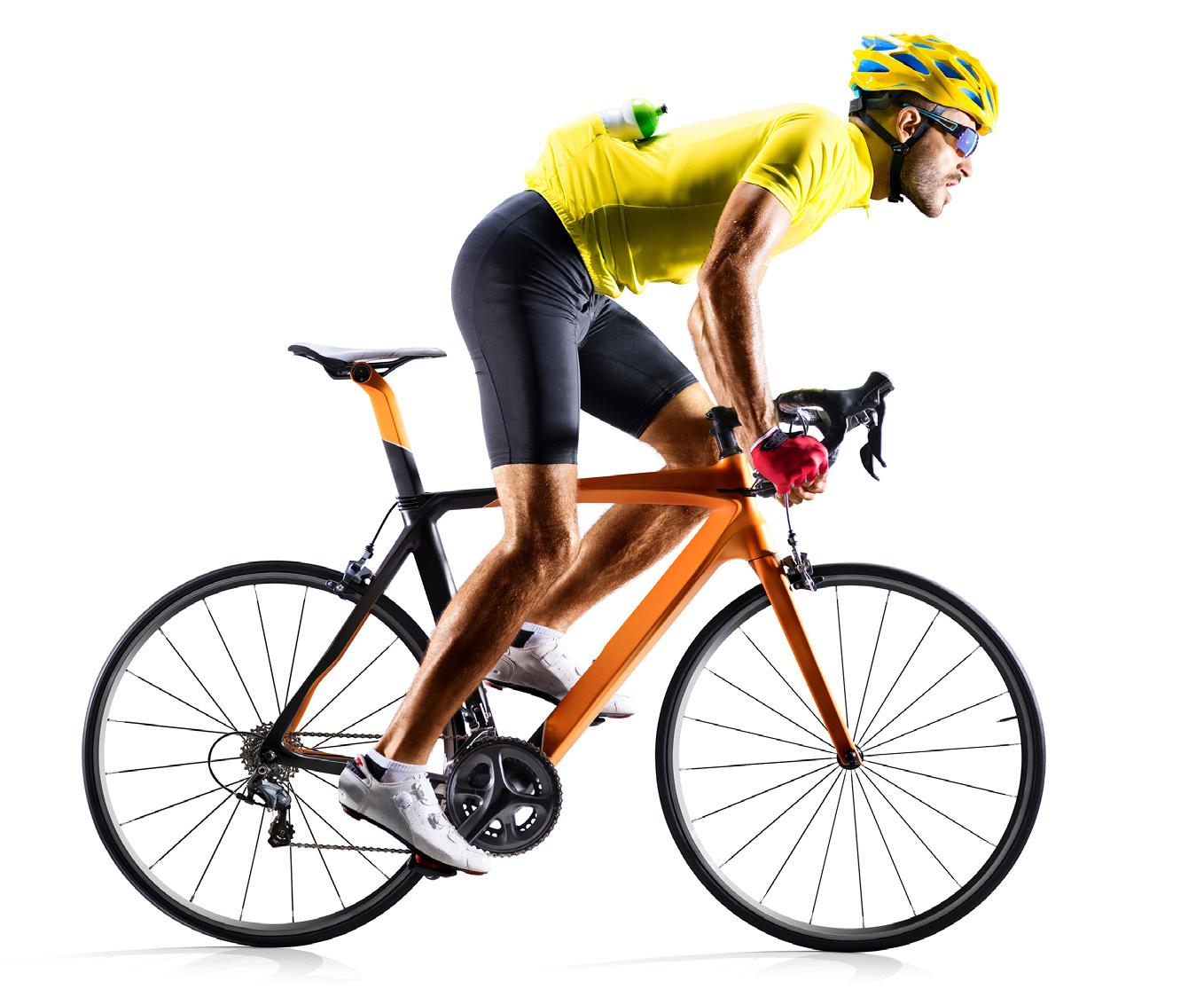
Lesson 4.11 Training zones
Key ideas
→ A training zone is a range that indicates the upper and lower limits of intensity for training.
→ There are four major training zones: the recovery training zone, the aerobic training zone, the lactate threshold training zone and the anaerobic training zone.
Defining training zones
To ensure that training leads to the desired physical adaptations, one of the first questions an athlete should ask themselves when planning their training is what energy systems they need to use, and at what level they need to exert themselves. In other words, they need to identify what training zone they should work in to optimise their performance and get the most out of their training.
A training zone is a range that indicates the upper and lower limits of intensity for training. Training zones are used by athletes to ensure they are training at the right intensity for the energy system they wish to train and for the training objectives they have set for the session. Training zones are normally expressed as a percentage of maximum heart rate (MHR) and the range given is based on norms and averages. It is important that individuals use the given ranges as a guide only, and make modifications to their training intensity based on their unique needs. Generally, an athlete can train in the following zones:
• recovery training zone
• aerobic training zone
• lactate threshold training zone
• anaerobic training zone
When determining training zones, you will need to know your MHR and target heart rate (THR). MHR is the highest number of beats your heart is capable of pumping per minute during exercise. To estimate your MHR, use the recommend formula: 206.9 – (0.67 × age in years).
Once you have established your MHR, you can use it to determine the heart rate you need to be training at for the physiological adaptations required for success in your physical activity. This is known as your target heart rate (THR) – the heart rate you aim to train at or reach during exercise. THR is a measure of intensity and is based on a percentage of MHR. For example, a 17-year-old who has a MHR of 195 bpm and wants to reach a THR of 75 per cent of their MHR, would need to multiply 0.75 by 195 (to find that their THR would be 144 bpm). Due to its ease of calculation, this is the most popular method for determining THR to achieve a desired intensity.
We will now look at each of the training zones in more detail.
Recovery training zone
The recovery training zone is a low-intensity training zone that allows for the recovery and adaptation of the body’s structures after a bout of high-intensity work. This zone uses the aerobic energy system and allows for the optimisation of physiological adaptation such as
Learning intentions and success criteria
maximum heart rate (MHR) the highest number of times (i.e. beats) your heart is capable of pumping per minute during exercise
recovery training zone a low-intensity training zone that allows the recovery and adaptation of the body’s structures following a bout of high-intensity work
aerobic training zone a mediumintensity training zone that allows the development of the body’s circulatory system
lactate threshold training zone a specific zone in which the athlete trains at or just under their lactate threshold
anaerobic training zone a high-intensity training zone in which an athlete works above their lactate threshold in intervals
target heart rate (THR) the heart rate you aim to train at during exercise
muscle fibre stimulation, mitochondrial development and capillary development. Athletes generally stay under 65 per cent of MHR in the recovery training zone. Training in this zone should feel easy, and to achieve the full benefits of a well-planned recovery zone session, athletes should avoid the temptation to push themselves harder.
Theory in action The "middle of the week" training theory
Professional sports teams, such as the Brisbane Broncos, take recovery training during their competitive season very seriously. In situations where they play a match every weekend, the training in the 24 to 48 hours before and after these high-intensity games is usually conducted in the recovery training zone. This allows the players to repair and regenerate muscle tissue and increase their muscles’ ability to store and resynthesise ATP. In fact, it is standard practice for most professional rugby league teams to train at a very high intensity only once in each week of the competitive season. This highintensity training is reserved for the middle of the week only; several days after the last game and several days before the next.
Aerobic training zone
The aerobic training zone is a moderate-intensity training zone that allows for the development of the body’s circulatory system. In this zone, the body uses the aerobic energy system, and training here allows the body to become stronger while recovering from harder bouts of training. The aerobic training zone pace is comfortable, placing some stress on breathing, but not so much that the pace cannot be maintained indefinitely.
This training zone is useful for physical activities that have a high aerobic energy contribution. Source 1 shows the aerobic and anaerobic energy contributions for distance runners. It is clear that the aerobic contribution is significant when compared to the anaerobic contribution. Such runners would benefit from training in the aerobic training zone for at least some of their training. In the aerobic training zone, the body is able to metabolise fat for longer, which is desirable in activities with high aerobic contribution because fat supplies are more abundant than carbohydrate supplies.
The aerobic training zone is generally between 60 and 80 per cent of MHR. A good indication of being in the aerobic training zone is the ability to hold a simple conversation during training. If you struggle to catch your breath, it is likely you have entered the anaerobic training zone.
SOURCE 1 Distance runners have a high proportion of their energy supplied by the aerobic energy system and need to train their bodies to metabolise fat. Therefore, they should ensure some of their training has them working in the aerobic training zone.
Source: Gastin, Paul B, “Energy System Interaction and Relative Contribution During Maximal Exercise,” Sports Medicine 31.10 (2001): 725–41
Lactate threshold training zone
The lactate threshold training zone is a specific zone in which the athlete trains at – or just under – their lactate threshold. For example, the aim for a runner in the lactate threshold training zone is to run as fast as possible using the aerobic energy system (i.e. 60–80 per cent of MHR). At this pace, the body has to work hard to clear the lactate from the muscles and bloodstream, but it is capable of doing so. If they run any faster, and the lactate cannot be cleared, they will be running above their lactate threshold (i.e. anaerobically).Running at this pace trains the body to be more efficient at clearing lactate. This ultimately allows athletes to be able to run faster while still clearing lactate; it raises their lactate threshold.
For most people, the lactate threshold training zone is around 80 to 85 per cent of their maximum heart rate. Like the aerobic zone, training in this zone is comfortably hard, meaning it is harder than moderate but not "extreme". It should be possible to maintain the pace for a 10-kilometre run.
Anaerobic training zone
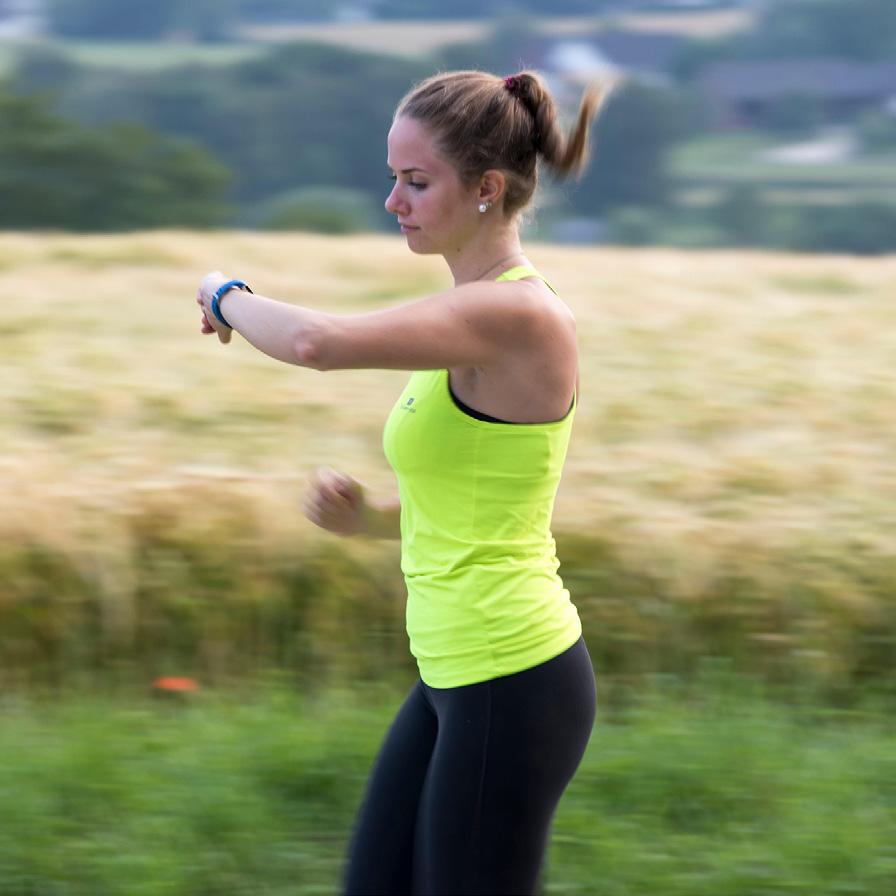
The anaerobic training zone is a high-intensity training zone in which an athlete works above their lactate threshold in intervals. In this training zone, an athlete engages their ATP–PC and/or lactic acid systems. Despite being called the anaerobic training zone, working at these high-intensity intervals helps to improve aerobic capacity by increasing VO2 max and lactate threshold. Training in this zone means athletes will experience a build-up of lactate in their muscles, which is important because it leads to an increased tolerance to the fatiguing effects of the lactic acid. It also improves the efficiency of the heart to get oxygen to the working muscles.
The anaerobic training zone is between your lactate threshold and your VO2 max. Training at this intensity can generally only be sustained for small periods of under 2 minutes, followed by rest and then repeated. Lesson 4.17 Interval training (page 259) provides more details about this type of training.
If your training objective is to work on your ATP–PC energy system, training would be for no more than 20 seconds and with a 2- to 3-minute rest to ensure PC is replenished between efforts. In this case, you wouldn’t need to measure your heart rate, but you would still be technically training in your anaerobic training zone.
2 Training in the lactate threshold zone requires athletes to continually monitor and maintain a steady high intensity that does not exceed their lactate threshold.
SOURCE
Check your learning 4.11
Check your learning 4.11
Retrieval and comprehension
1 Choose the correct answer.
Identify the correct definition for MHR.
A the lowest number of times your heart is capable of beating per minute during exercise
B the highest number of times your heart is capable of beating per minute during exercise
C the range between the highest number of times your heart is capable of beating per minute during exercise and your resting heart rate
D the highest number of beats your heart is capable of when working at a rate of perceived effort over 8
2 Choose the correct answer.
Identify which training zone uses the aerobic energy system and allows for the optimisation of physiological adaptations.
A aerobic training zone
B lactate threshold training zone
Lesson
4.12
Learning intentions and success criteria
specificity a principle of training that states the type of exercise used in training should be relevant (i.e. specific) to the energy systems, positionspecific movements, and the fitness requirements of the selected sport or physical activity frequency a principle of training that states the number of times training occurs in a given period should be appropriate for the selected sport or physical activity
C recovery training zone
D anaerobic training zone
3 Write a definition for each of the four training zones.
4 Explain why it is important to keep your heart rate within a very small range when training in the lactate threshold training zone.
Analytical processes
5 Deduce the confusion that can arise from the term "anaerobic training zone".
Knowledge utilisation
6 Determine why a coach would ask a 17-year-old 1500-metre runner to ensure that her heart rate remained between 155 and 165 beats per minute during a training session.
7 Predict your heart rate for each of the four training zones.
Principles of training
Key ideas
→ The principles of training are guidelines that help to ensure that athletes get the most value and benefit out of their training and are able to achieve their training objectives.
→ The eight principles of training are: progressive overload, frequency, reversibility, intensity, duration, specificity, individuality and variety.
Principles of training
The principles of training are a set of guidelines that should be considered in the development, design and evaluation of a training program. The principles of training help to ensure that all athletes get the most value and benefit out of their training and can achieve their training objectives and performance goals. They do this by assisting athletes and coaches to:
• select training activities that are relevant (i.e. specific) to the energy systems, positionspecific specialised movement sequences and the fitness requirements of the selected sport or physical activity (i.e. specificity)
236 PHYSICAL EDUCATION FOR QUEENSLAND UNITS 3 & 4
• decide how often they should train to get the best results (i.e. frequency)
• decide how hard they should train to get the best results (i.e. intensity)
• decide how long they should train for to get the best results (i.e. duration)
• determine the rate at which training load is increased to encourage physiological adaptation (i.e. progressive overload)
• decide on the most appropriate training strategies for their individual circumstances (i.e. individuality)
• include a range of different training activities, movement options and training contexts so that athletes stay motivated and interested (i.e. variety) take into account that if training is interrupted or stops, then gains or adaptations will be lost (i.e. reversibility).
We will now look at each of these eight principles of training in more detail.
Specificity
The principle of specificity states that the type of exercises used in training should be relevant to the energy systems, the position-specific movements and the fitness requirements of the selected sport or physical activity. In other words, specificity suggests that the physical demands, skills and contexts of a particular sport or position should be replicated in training activities as much as possible. To do this, athletes need a thorough understanding of the physical requirements of their selected sport or physical activity, so they can tailor their training program and activities to meet those requirements.
For example, the soccer goalkeeper shown in Source 1 requires speed, power, agility and flexibility to be effective. He also relies heavily on his anaerobic energy systems. By comparison, a midfielder requires speed, aerobic capacity, muscular endurance and agility to be effective. He relies more on his aerobic energy system. As a result, the training programs and activities for these two positions would need to differ to ensure the athletes were prepared for their specific positions.
Specificity also encourages athletes to consider the specialised movement sequences required in their chosen sport or physical activity. It is important to ensure that training activities provide opportunities for athletes to practise specialised movement sequences that are specific to their sport or position.
Specificity also suggests that environmental factors (e.g. weather, lighting, playing surface) should replicate (as much as possible) the conditions likely to be experienced during competition. For example, if an athletics competition is going to be held on a tartan track in the middle of the day when it is hot, then the principle of specificity would suggest that training conditions should replicate this, because training on a grass track in the cool of night will not adequately prepare the athlete for this competition.
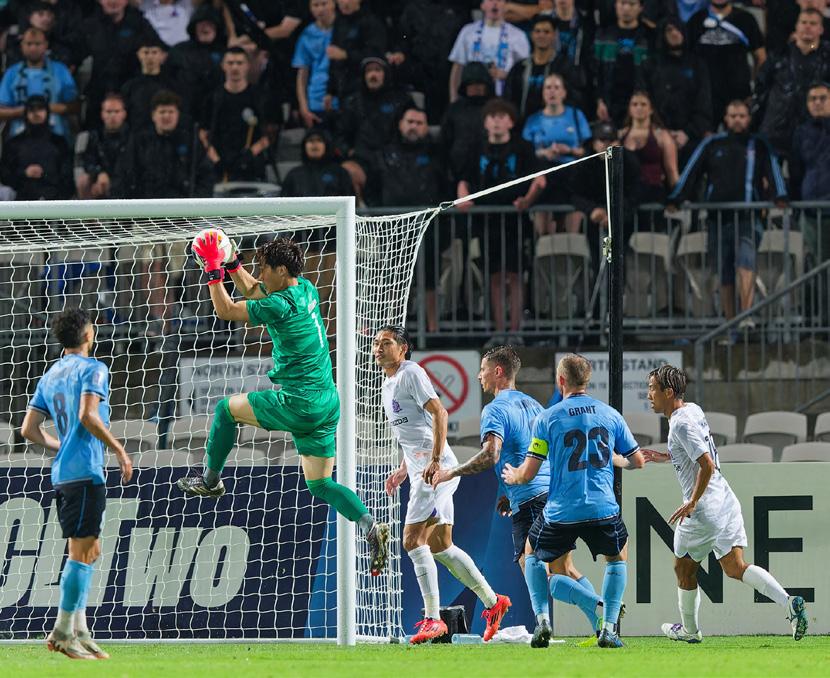
intensity a principle of training that states the magnitude of exertion (i.e. how hard an athlete trains) should be appropriate for the selected sport or physical activity
duration a principle of training that states the length of training time should be appropriate for the selected sport or physical activity
progressive overload a principle of training that states that training should be planned to ensure gradual increases in training load so that physiological adaptation is appropriate for the selected sport or physical activity
individuality a principle of training that states the personal needs, goals, fitness levels, motivation and skills of individual athletes should be considered when designing a training program
variety a principle of training that states a range of different training activities, movement options and training contexts should be included in a training program
reversibility a principle of training that states that when training is decreased or stops, the physiological adaptations, increased function or fitness gains are lost or reversed
SOURCE 1 A goalkeeper’s training program needs to be targeted to their specific need for speed, power, agility and flexibility.
Frequency
The principle of frequency states that the number of times an athlete trains within a given period should be appropriate for their selected sport or physical activity. In other words, the frequency at which an athlete trains needs to be appropriate for their chosen sport or position, as well as their individual circumstances (e.g. general fitness level, level of proficiency, age).
Generally speaking, the frequency of aerobic zone training is recommended at three to five days per week, while the frequency of anaerobic zone training is recommended at three days per week. It is important to note, however, that an appropriate frequency of training –and frequency of particular training activities used within training sessions – will depend on many factors, such as:
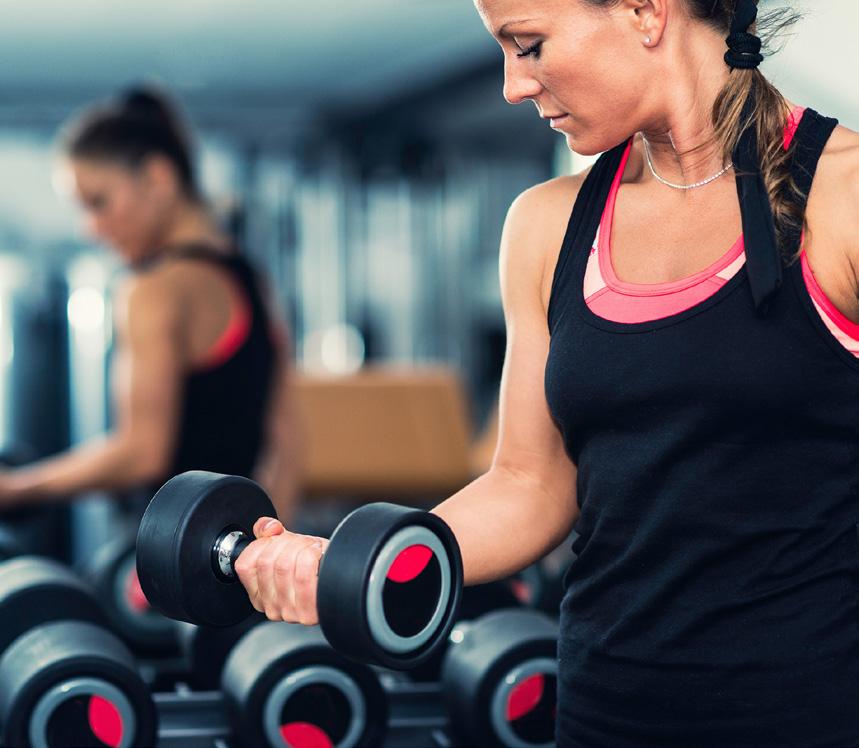
SOURCE 2 The frequency of training is dependent on many factors; however, with thoughtful planning, it is possible to train more frequently by targeting different skills, body parts and training methods over the course of several training sessions.
Intensity
• the intensity, duration and type of training activities or training sessions
• the individual characteristics of particular athletes (e.g. level of fitness, skill, experience)
• the specific muscles or body parts being trained
• the fitness components and energy systems being focused on
• the particular training methods being used
• a range of environmental factors (e.g. weather, temperature).
For example, an athlete who participates in three high-intensity training sessions in a week may not be able do more without risking injury and/or negative physiological adaptations. However, if a session targets one particular body part (e.g. legs) on one day, a different body part (e.g. arms) can be targeted the next day. In this way, frequency of training can be increased. When determining frequency of training, it is important to achieve balance: to stress the body enough to cause positive physiological adaptation without overtraining (i.e. causing harm or negatively impacting the benefits of training).
The principle of intensity states that that the magnitude of exertion (i.e. how hard an athlete trains) varies between athletes, depending on their training objectives, the training phase they are in, the sport or physical activity they are participating in, and so on. Intensity is generally measured in terms of:
• the relative percentage of maximum heart rate
• the relative percentage of VO2 max
• lactate threshold
• weight, reps and sets (in resistance training)
• pace (i.e. speed)
• the Borg Rating of Perceived Exertion (RPE) scale.
The level of intensity at which an athlete trains is dependent on their training objectives for a particular training session. Intensity can be manipulated to ensure an athlete experiences the desired physiological adaptations. For example, a netball player who wants to improve her fitness to prepare for competitions would need to train at an intensity that replicates competition intensity. Heart rate is a reliable form of intensity measurement in longer forms of exercise; however, it is not useful for measuring intensity in activities designed
to develop the ATP–PC system and it doesn’t always adapt quickly enough to use as a guide early on in repeated high-intensity periods of exercise. In such cases, perceived effort or rate of exertion can be used; or, in the case of weight training, the weight of the resistance used, the number of reps or sets in a session, or the speed of completion of the reps and sets, can help determine intensity.
When determining intensity, it is also important to consider the principles of frequency and duration. The length of training and how often the athlete intends to train in the week will impact on how appropriate the level of intensity is in any given activity.
Duration
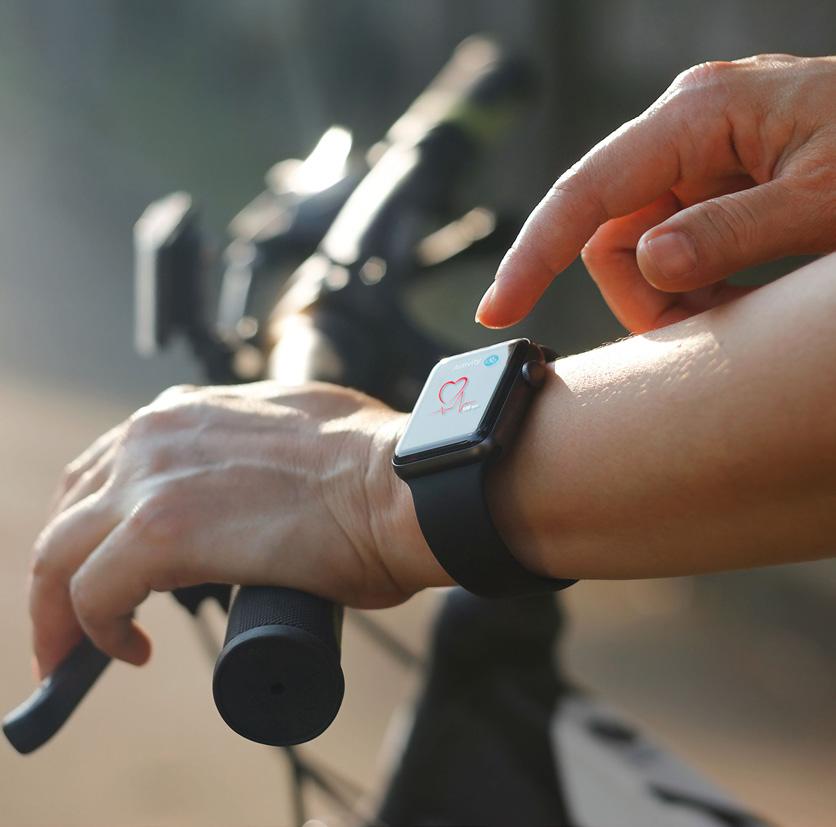
The principle of duration states that the length of training time should be appropriate for the selected sport or physical activity. The length of time spent training can be viewed on many levels. It can refer to anything from the length of an entire training program down to individual training sessions. For example, a year-long training program is a measure of duration in the same way that the number of repetitions of a bicep curl performed within a particular set is a measure of duration.
To determine an appropriate duration for training activities, a number of factors need to be considered, such as the athlete’s level of fitness, the training method being used and the intensity of the activity. As an athlete’s level of fitness improves, they will need to increase the duration of training activities to make gains.
The duration of a training program is usually dependent on the amount of time an athlete has available, but it is generally considered necessary for a training program to be a minimum of 8 to 12 weeks long for physiological adaptations to occur that result in measurable improvements to performance. The duration of a training session typically varies between 1 and 2 hours.
Progressive overload
The principle of progressive overload states that training should involve gradual increases in the physical demands on the athlete to drive physiological adaptations. Using the principle of progressive overload ensures that an athlete’s fitness does not stagnate as they become accustomed to the demands being placed on them. Rather, through gradual increases in training load, their body continually adapts accordingly, leading to greater overall gains.
These gradual increases in the athlete’s training load occur through gently manipulating work volume (i.e. frequency and duration) and/or intensity. This manipulation is known as loading
It may help you to think of loading being achieved through manipulation of the dials on an audio mixing board (as shown in Source 4). Not all the dials need to be turned up at once to achieve a change. Sliding the "intensity" control upwards, for example, without touching any of the other controls, may be enough to "overload" a particular athlete and cause a desired physiological adaptation. Over time, however, that athlete may need to slide the "frequency" and/or "duration" controls upwards to overload the body and cause a further physiological adaptation. All of this will depend on the individual.
SOURCE 3 Heart rate monitors are one tool that can be used to determine intensity in some types of training by measuring the relative percentage of maximum heart rate.
Study
tip
When making decisions about the duration of training activities within training sessions, it is important to also take frequency into account. As we learnt in Lesson 4.10 Training requirements for physical activity (page 227), frequency and duration combined make up the total work volume. In other words, if an athlete trains for 1 hour (duration) once per week (frequency), the work volume is lighter than if she trains for 1 hour three times per week.
loading an increase in work volume and/ or intensity of work, placing the athlete’s body under stress
In Lesson 4.22 Developing a training program (page 288) and Lesson 4.24 Developing a training session plan (page 300), you will learn in more detail about how training loads can be manipulated to achieve a desired physiological adaptation.

SOURCE 4 The principle of progressive overload states that training should be planned to ensure gradual increases in the physical demands of training activities to drive positive physiological adaptations. Just like sliding the controls on an audio mixer up or down, intensity, frequency and duration can be manipulated to overload the body and bring about these adaptations.
Individuality
The principle of individuality states that the personal goals, fitness levels, motivation and skills of individual athletes should be considered when designing a training program or strategy. In other words, it is important to determine how a person’s individual circumstances may impact their capacity to complete a training plan when deciding on the specifications of a training program. Individual considerations include:

SOURCE 5 The principle of individuality states that the personal needs, goals, fitness levels, motivation and skills of individual athletes should be considered when designing a training program. Whether an athlete is looking to improve their baseline fitness, or training for a one-off event, an ongoing competition or the Olympic Games, this will have an impact on their training program.
• personal goals and training objectives – these are key factors in the design of an appropriate training program. Whether an athlete is looking to improve their baseline fitness, or training for a one-off event, an ongoing competition or the Olympic Games, their goal is key to determining an appropriate training program
• fitness level – an individual’s fitness level will impact an athlete’s ability to complete certain training activities, so it must be considered in the design of an appropriate training program and training sessions
motivation – motivation levels will impact an athlete’s ability to complete certain training activities; for example, more intrinsically motivated athletes may need to plan training activities that are different to more extrinsically motivated athletes. For this reason, motivation must be considered in the design of an appropriate training program and training sessions
• skill level – an individual’s skill will impact their ability to complete certain training activities and must therefore be considered in the design of an appropriate training program and training sessions
• personal circumstances – personal factors (e.g. their work or study commitments, travel requirements, medical history, religious beliefs, financial issues) should also be considered when designing an appropriate training program as they may affect when an athlete can train and the types of training activities they can take part in.
Variety
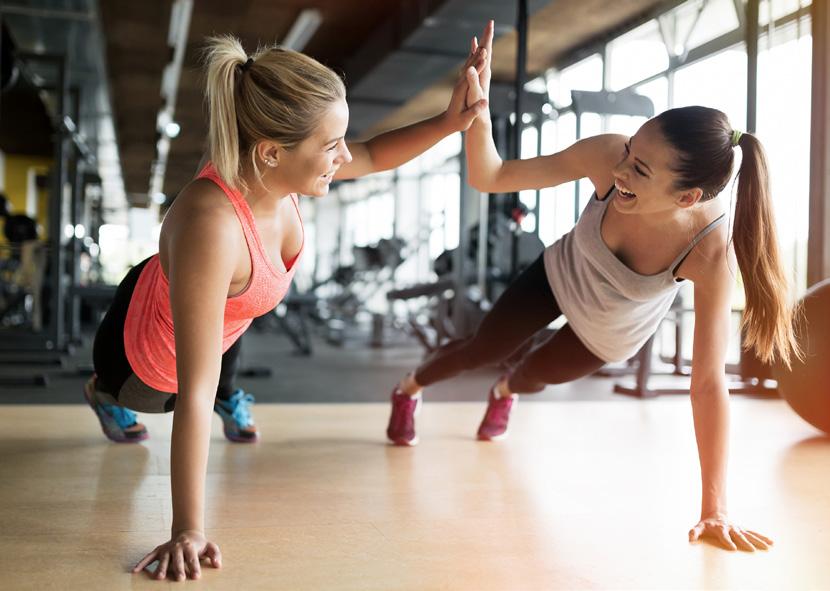
SOURCE 6 The principle of variety states that it is important to include a range of different activities in a training program. Alternating training activities or training with friends can help to keep athletes challenged and motivated, and can stimulate positive physiological adaptations.
Reversibility
The principle of variety states that it is important to include a variety of different activities in a training program. To stay on target, create progressive overload and ensure training meets the objectives, a training program needs to "mix it up" so that athletes don’t get bored and lose motivation.
Alternating between different types of training activities from one training session to another – or training with different people – can help to keep athletes feeling interested and challenged. It also helps to prevents automation (when athletes stop thinking about what they are doing because they have done it so often). Automation can result in reduced benefits from training, so it is best avoided through the use of variety.
Reversibility is a principle of training that states that when the training load is significantly decreased or stops, then the physiological adaptations, increased function or fitness gains are lost or reversed. In simple terms, if an athlete doesn’t use it, they lose it! For most athletes, the physiological adaptations made as a result of training are lost at a similar rate to which they were gained. You might have noticed reversibility in action if you have had a break from a specific sport, physical activity or type of training; you need to restart from a lower level than you finished at.
After rupturing her Achilles tendon while competing in the steeplechase at the 2021 Tokyo Olympics, Genevieve Gregson experienced reversibility through muscle degeneration. She posted on Instagram:

… muscle wastage is very confronting for an athlete. Athletes spend so much time building muscle mass and working on strength and power. It’s obviously a shock to anyone going through an injury where you are so immobile to see what can happen within just 3 weeks of being inactive. Years of work goes into getting your lean muscle mass right. Seeing my calf come out of a cast and watching my body start to drastically change has been difficult, especially as my right leg muscles reduce in size and bulk …
Source: Genevieve Gregson’s Instagram, 26 August 2021
SOURCE 7 Genevieve Gregson was injured when her Achilles tendon ruptured during the steeplechase at the Tokyo Olympics in 2021.
Check your learning 4.12
Check your learning 4.12
Retrieval and comprehension
1 Choose the correct answer.
Identify the factors that the principle of individuality considers.
A an individual athlete’s personal goals, past fitness levels, team dynamics, time and skills
B an individual athlete’s personal goals, motivation, skills for specialised movement sequences required, periodisation
C an individual athlete’s personal goals, fitness levels, motivation, skills and personal circumstances
D an individual’s personal needs, motivation and skills
2 Choose the correct answer.
Identify the principles of training that must be manipulated for progressive overload to occur.
A intensity, frequency, duration
B intensity, frequency, variety
C frequency, individuality, duration
D intensity, frequency, specificity
3 Describe the purpose of following the principles of training when creating a training strategy.
4 Identify the eight principles of training and define each one in your own words.
5 Describe the factors that an athlete should take into consideration when planning the frequency of activities for a training program.
Analytical processes
6 Compare and contrast the energy, fitness and training requirements for the following athletes, with direct reference to the principles of specificity and individuality:
– a basketball player who is new to the sport
– an experienced 1500-metre runner who is recovering from injury.
7 Apply the principle of progressive overload to the following training example and suggest changes to the training load (i.e. work volume and intensity) to encourage physiological adaptation over time. Assume that there is one week between sessions.
Volleyball training session
– Warm-up (i.e. light jog and dynamic stretches)
– 5 × court sprints at 80% intensity (i.e. touching each line and returning to baseline on the way to completing 1 full court sprint) – 5 × consecutive squat jumps
– 5 × clap push-ups
– 5 × court sprints (i.e. touching each line and returning to baseline on the way to completing 1 full court sprint)
– Pepper drill in pairs (i.e. dig, set, spike) – 10 mins
– Serving to a target – 10 mins
– 3v3 (single point) king of the court – 10 mins
– Game play
Knowledge utilisation
8 The FITT principle is a tool some coaches use to help design training programs for athletes. FITT stands for Frequency, Intensity, Time (i.e. duration) and Type. FITT is often thought of as a single principle of training, suggesting that there is a relationship between these factors that needs to be considered when planning a training strategy. Conduct some online research into the FITT principle and construct an argument for or against the principles of frequency, intensity and duration being thought of as a single principle of training. Justify your position in a 150-word written response using examples from your selected physical activity.
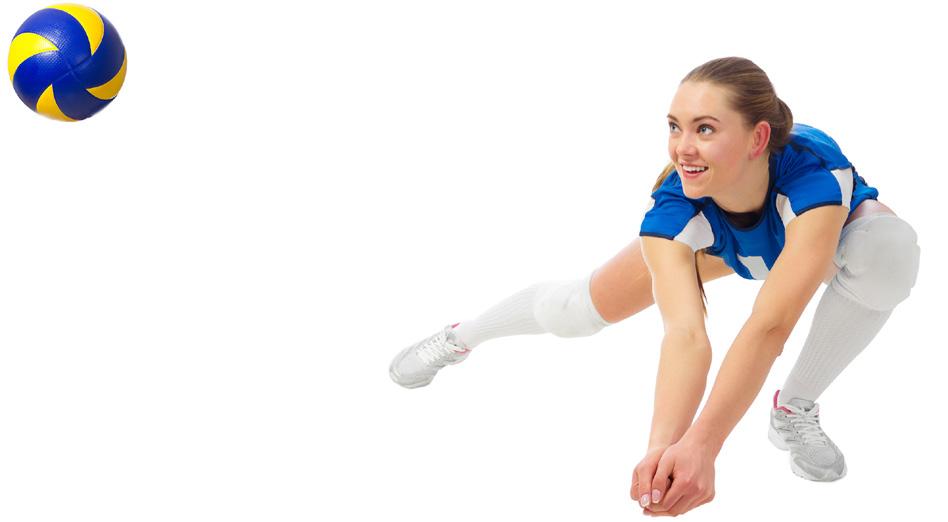
SOURCE 8 The principles of training are a set of guidelines that should be considered in the development, design and evaluation of training sessions.
9 Evaluate your individual needs through the lens of the individuality training principle to determine how your training program might differ from those of other members of your class or team who play in the same position as you in your selected physical activity. (If position is not applicable,
then evaluate based on the entire physical activity or event.) Consider factors such as your work and study commitments, family circumstance, fitness, skill and motivation levels to answer this question in 150 words.
Lesson 4.13
Training methods
Key ideas
→ Training methods are forms of exercise that athletes can use to target different components of fitness and optimise particular aspects of their performance.
Defining training methods
Training methods are forms of exercise that athletes can use to target different components of fitness and optimise particular aspects of their performance. As shown in Source 1, there are six main training methods:
• continuous training – a form of exercise performed at the same intensity for an extended period of time, without periods of rest (discussed in more detail in Lesson 4.14 Continuous training, page 245 )
• fartlek training – a variation of continuous training in which athletes vary the intensity of their exercise by alternating the speed or resistance of their work (e.g. by adding incline, running on sand, running up stairs) (discussed in more detail in Lesson 4.15 Fartlek training, page 247 )
• resistance training – a form of exercise that requires an athlete to work against something that resists the movement of the body (or particular body parts) (discussed in more detail in Lesson 4.16 Resistance training, page 250)
• interval training – a form of exercise that manipulates periods of work and rest to enhance a specific component of fitness and target a particular energy system (discussed in more detail in Lesson 4.17 Interval training, page 259)
• flexibility training – a form of exercise that involves stretching the muscles, tendons and ligaments in and around joints (discussed in more detail in Lesson 4.18 Flexibility training, page 264)
continuous training a type of training performed at the same intensity for an extended period of time without periods of rest
fartlek training a variation of continuous training in which athletes vary the intensity of their exercise by increasing the speed or resistance of their work (e.g. by adding incline, running on sand, running up stairs)
Learning intentions and success criteria
resistance training a type of training that requires an athlete to work against something that resists the movement of the body (or particular body parts)
interval training a type of training that manipulates periods of work and rest to enhance a specific component of fitness and target a particular energy system
flexibility training a type of training that involves stretching the muscles, tendons and ligaments in and around joints to promote flexibility
circuit training a type of training method in which a variety of different activities are performed consecutively (in a cycle)
• circuit training – a form of exercise that combines a variety of different training methods and activities that are performed consecutively (i.e. in a cycle) (discussed in more detail in Lesson 4.19 Circuit training (page 268))
Each one of these training methods can be used in training programs to target different energy systems and fitness components. For this reason, a single training method – or a number of different training methods used in different combinations – can help athletes from all sports achieve their personal training goals or objectives. However, it is important for athletes to select the training methods that will be most beneficial for them, based on the following factors:
• the goal of their training program and training objectives
• the results of a game analysis
• the results of a fitness assessment
• the desired physiological adaptations.
SOURCE 1 Training methods are types of exercises that an athlete can use to target particular components of fitness and to optimise performance. There are six main training methods, but several of these have a number of subcategories within them.
Check your learning 4.13
Check your learning 4.13
Retrieval and comprehension
1 Choose the correct answer.
Select the correct definition for fartlek training.
A a variation of continuous training in which athletes vary the intensity of their exercise by increasing the speed or resistance of their work
B a variation of circuit training in which athletes vary the intensity of their exercise by increasing the speed or resistance of their work
C a variation of continuous training in which athletes use resistance to vary the intensity of their exercise
D a consecutive form of training that combines a variety of different training methods and activities
2 Choose the correct answer.
Identify the correct definition for flexibility training.
A a type of training that involves stretching the muscles to allow for greater range of movement
B a type of training that involves stretching the muscles, tendons and ligaments in and around joints
C a type of training performed at the same intensity for an extended period of time
D a type of training specific to individual sports and physical activities including gymnastics, aerobics and dance
3 In your own words, define the term “training methods”.
4 Identify and describe the six training methods discussed in this section.
Lesson 4.14 Continuous training
Key ideas
5 Explain the need for different training methods. Analytical processes
6 Based on what you have learnt about the six main training methods so far, determine which one would be most helpful to you in your selected physical activity. Provide a reason for your choice.
→ Continuous training is a form of exercise performed at the same intensity for an extended period of time without rest.
What is continuous training?
Continuous training is a form of exercise performed at the same intensity for an extended period of time without rest. Continuous training can improve aerobic capacity by increasing the body’s efficiency in uptake and use of oxygen, and also improve muscular endurance through the repeated muscle contractions required in this type of training.
Types of continuous training
There are two types of continuous training:
• long slow distance (LSD) training
• tempo training
Long slow distance (LSD) training
LSD training is a type of continuous training performed at a low to moderate intensity over an extended period of time (i.e. duration) or distance. Examples of long slow distance (LSD) training methods are running, swimming and cycling. Generally, LSD training is performed at an intensity of around 70 per cent of maximum heart rate (MHR) and carried out for periods greater than 30 minutes. During LSD training, fat is the primary fuel source for the body. This is beneficial because, as learnt in Lesson 4.2 Energy requirements for physical activity (page 181), carbohydrates, while an excellent source of fuel, are limited in supply. By training the body to use fat as an energy source, it reserves carbohydrates for the more intense periods of exercise.
Learning intentions and success criteria
long slow distance (LSD) training a type of continuous training performed at a steady, low to moderate intensity over an extended distance or duration tempo training a type of continuous training performed just under an athlete’s lactate threshold
For the record!
Kelvin Kiptum of Kenya holds the current male world record for marathon running. He set the record in 2023 when he ran the Chicago Marathon in a time of 2:00:35. This is an average of 2 minutes and 51 seconds per kilometre. To achieve this, Kiptum would have had to run at a constant speed of greater than 20 km/h. This intensity equates to around 93 per cent of an average marathon runner’s MHR. He would have to have a highly efficient circulatory system to achieve this intensity without experiencing lactic acid fatigue. Tempo runs would, therefore, make up a considerable portion of his training program.
Tempo training
Tempo training is a type of continuous training performed just under an athlete’s lactate threshold. For most athletes, this is equivalent to approximately 80–85 per cent of their maximum heart rate (MHR). Tempo training coaches the body to use oxygen more efficiently and remove lactic acid build-up more quickly by increasing an athlete’s lactate threshold. As a result, athletes can maintain a faster pace for longer. Due to the fatiguing nature of tempo training, these sessions will generally be shorter in duration than LSD training. To begin, athletes should aim for a minimum of 20 minutes of activity at approximately 80–85 per cent of their maximum heart rate and gradually increase this over time.
Examples of continuous training
Examples of continuous training activities include:
• swimming laps of a pool at a steady pace (70 per cent of MHR) for 40 minutes
• cycling at a moderate intensity (70 per cent of MHR) for 60 minutes
• completing a 5-kilometre run at a “tempo pace” (80–85 per cent of MHR).
Applying continuous training
To be effective, continuous training should continue for periods greater than 20 minutes. Intensity should stay between 70 and 85 per cent of the athlete’s maximum heart rate; however, this is dependent on the training objective of the individual athlete and their fitness level. In any case, intensity needs to keep the athlete below their lactate threshold. When the athlete pushes their intensity to above their lactate threshold, they will no longer be training aerobically and will be unable to sustain continuous physical activity. The training load for continuous training can be manipulated by increasing or decreasing factors, including:
• the duration of the exercise
• the pace of the exercise
• the incline (e.g. if on a treadmill)
• the resistance (e.g. if on a stationary bike).

SOURCE 1 Continuous training is any training performed at the same intensity for an extended period of time without rest. Cycling for 60 minutes at a moderate intensity (i.e. 70 per cent of MHR) is an example of continuous training.
Check your learning 4.14
Check your learning 4.14
Retrieval and comprehension
1 Choose the correct answer.
Identify the components of fitness that are most likely to improve due to continuous training.
A aerobic capacity and muscular strength
B aerobic capacity and power
C muscular endurance and flexibility
D aerobic capacity and muscular endurance
2 Choose the correct answer.
Identify how the training load can be manipulated when undertaking continuous training.
A duration of exercise, pace of exercise, resistance, equipment used
B duration of exercise, pace of exercise, incline, resistance
C pace of exercise, incline, resistance, competition with teammates
D use of pool, track or bike
3 Define “continuous training” in your own words.
4 Identify the two types of continuous training and provide two examples of each type.
Lesson 4.15
Fartlek training
Key ideas
Analytical processes
5 Consider the suitability of using continuous training as part of a training program for your selected physical activity. Reflect on whether it would help you to maximise your performance and meet your training objectives. Provide reasons to support your view.
Knowledge utilisation
6 Predict which one of the following athletes would benefit most from continuous training. Justify your selection in a 150-word written response.
a a triathlete
b a netball goal shooter
c a volleyball libero
d a 1500 m runner
e a swimmer
f an Australian football midfielder
g a high jumper
→ Fartlek training is a form of continuous training that enhances aerobic capacity by athletes varying the intensity of their exercise through increasing their speed and/or increasing their resistance.
What is fartlek training?
Fartlek training is a form of continuous training that enhances aerobic capacity by having athletes vary the intensity of their exercise through increasing their speed and/or increasing their resistance (e.g. by adding incline, running on sand, running up stairs). Fartlek is a Swedish word meaning “speed play”. Anything that “plays” with the intensity during continuous exercise is a form of fartlek training.
The idea of fartlek training is to push the athlete into the anaerobic training zone for short periods of time. This not only helps to increase lactate threshold and VO2 max, it also more closely resembles the type of stress placed on athletes who compete in “Invasion”, “Net and court” and long-distance “Performance” physical activities.

Examples of fartlek training
Fartlek training can come in many different forms. Examples of fartlek training activities include:
• running for 5 minutes, sprinting for 1 minute, running for 5 minutes, and so on
• cycling slowly for 4 minutes, moderately for 5 minutes, fast for 1 minute, slowly for 4 minutes, and so on
• swimming fast, then slow, in ever-increasing time increments before peaking and slowly decreasing the time increments (e.g. 1 minute fast, 1 minute slow; 2 minutes fast, 2 minutes slow; 3 minutes fast, 3 minutes slow; 2 minutes fast, 2 minutes slow, and so on).
Applying fartlek training
There are many different types of fartlek exercises that athletes can use to enhance aerobic capacity. Source 2 provides more details about three common fartlek exercises.
SOURCE 1 Fartlek training is a variation on continuous training in which athletes vary the intensity of their exercise. In “Invasion” physical activities such as futsal, it resembles the authentic performance conditions more closely than any other type of training.
Type of fartlek exercise
Time warps
Explanation
This is the simplest and most common form of fartlek training.
Zone hopping
This form of fartlek training is more random and requires the use of a heart rate (HR) monitor.
Pyramid runs
This form of fartlek training is becoming more popular. You can measure your intensity on your rate of perceived exertion (RPE) or use a HR monitor (as per the “Zone hopping” activity).
Example
Run for 5 minutes at a comfortable pace. On the 5-minute mark, increase your speed for 1 minute and then return to the previous comfortable pace.
Complete this exercise for 30 minutes, with speed bursts every 5 minutes.
Determine your HR zones for your aerobic zone:
• Easy: 60–70% MHR (aerobic zone)
• Moderate: 80–85% MHR (lactic threshold zone)
• Hard: 85–95% MHR (anaerobic zone).
Run for 20 minutes in the following pattern of intensity:
• 4 minutes easy
• 5 minutes moderate
• 1 minute hard
• 5 minutes moderate
• 1 minute hard
• 4 minutes easy.
Run for 18 minutes in the following pattern of intensity:
• 1 minute hard RPE 7+
• 1 minute easy RPE 2–5
• 2 minutes hard RPE 7+
• 2 minutes easy RPE 2–5
• 3 minutes hard RPE 7+
• 3 minutes easy RPE 2–5
• 2 minutes hard RPE 7+
• 2 minutes easy RPE 2–5
• 1 minute hard RPE 7+
• 1 minute easy RPE 2–5.
Note:
An RPE of 2–5 is “easy” (i.e. a conversation can flow without interference).
An RPE of 7–10 is “hard” (i.e. it’s very difficult to speak).
Check your learning 4.15
Check your learning 4.15
Retrieval and comprehension
1 Choose the correct answer.
Identify the most relevant reason why fartlek training is valuable for athletes who compete in “Invasion” sports.
A It helps to increase lactate threshold and VO2 max needed for “Invasion” sports.
B The short periods of anaerobic training resemble the type of stress placed on athletes who compete in “Invasion” sports.
C The recovery time allows players to put in maximal effort when required in both training and game contexts.
D It allows periods of work and rest that can alternate with teammates.
SOURCE 2 This table demonstrates different fartlek training strategies. In each case, training is continuous, but modifications are made to the intensity of the workout.
2 Choose the correct answer. Select the component/s of fitness that fartlek training targets.
A aerobic capacity
B anaerobic capacity
C muscular endurance and anaerobic capacity
D muscular endurance and power
3 Define the term “fartlek training”.
4 Describe the energy systems that fartlek training is useful for targeting and developing.
Analytical processes
5 Determine two different physical activities that have fitness requirements suited to the fartlek training method. Explain your response.
Lesson 4.16
Knowledge utilisation
6 Design and evaluate a 30-minute fartlek training activity for a beginner water polo player. Justify your design by considering how well the activity incorporates “speed play” and how it would suit the needs of a beginner water polo player.
7 The caption for Source 1 states that fartlek training resembles authentic performance conditions in most “Invasion” sports. Based on this logic, select a physical activity that fartlek training would not be suited to and justify your point in a paragraph of approximately 150 words.
Resistance training
Key ideas
Learning intentions and success criteria
→ Resistance training is a form of exercise that requires an athlete to work against something (e.g. weights) that resists the movement of their body or specific parts of their body (e.g. arms, legs, particular muscles).
→ There are four types of resistance training: isotonic (dynamic) resistance training, isometric (static) resistance training, isokinetic resistance training and plyometric training.
What is resistance training?
Resistance training is a form of exercise that requires an athlete to work against something that resists the movement of their body or specific parts of their body (e.g. arms, legs, particular muscles).
Pushing or pulling against an external force or weight – such as your own body weight – is the most basic form of resistance training (as shown in Source 1), but there are many kinds of equipment that can be used for resistance training, including:
• free weights (e.g. dumbbells, barbells, kettlebells, medicine balls)
• weight machines (e.g. pin-loaded, plate-loaded)
• hydraulic resistance machines (e.g. weight machines that use hydraulic cylinders rather than traditional weights)
• elastic resistance bands (e.g. flat bands, resistance tubes).
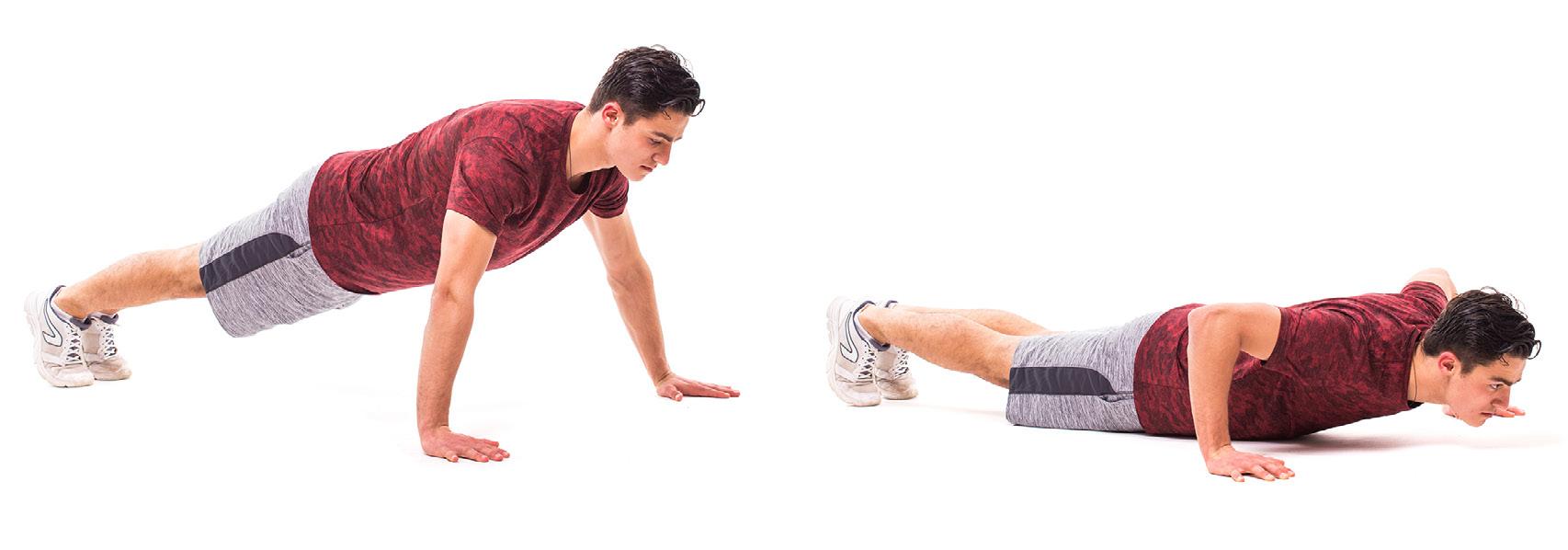
SOURCE 1 Resistance training is a form of exercise that requires an athlete to work against something that resists the movement of their body (or a specific part of their body). A push-up is an example of a resistance training exercise as it requires the athlete to push their body weight against the resistance of gravity.
Depending on the amount of resistance and the number of repetitions performed, resistance training can be ideal for developing strength, power and muscular endurance. As the first repetition of a resistance exercise (e.g. a bicep curl) is performed, muscle fibres are recruited (i.e. engaged). With every subsequent repetition, it becomes more difficult and more muscular fibres are engaged to continue the exercise. Eventually, when no more muscle fibres can be recruited, the point of failure is reached, and the exercise must stop. Reaching the point of failure is important to maximise muscle growth – a process known as hypertrophy.
Types of resistance training
There are four main types of resistance training:
• isotonic (i.e. dynamic) resistance training
• isometric (i.e. static) resistance training
• isokinetic resistance training
• plyometric training
We will now look at each of these types of resistance training in more detail.
Study tip
It may help you to revisit and revise the section “Types of muscle contractions” in Physical Education for Queensland Units 1 & 2, Lesson 3.5, to improve your understanding of these types of resistance training.
Isotonic (dynamic) resistance training
Isotonic (i.e. dynamic) resistance training involves performing movements against a constant resistance. In isotonic training, muscle tension is maintained evenly throughout the length of the movement. Isotonic training can be performed with or without weights and is the most common form of resistance training. Isotonic training is a recommended form of resistance training because it requires little or no equipment. It involves intuitive movements and it can be used to engage and train almost all muscle groups.
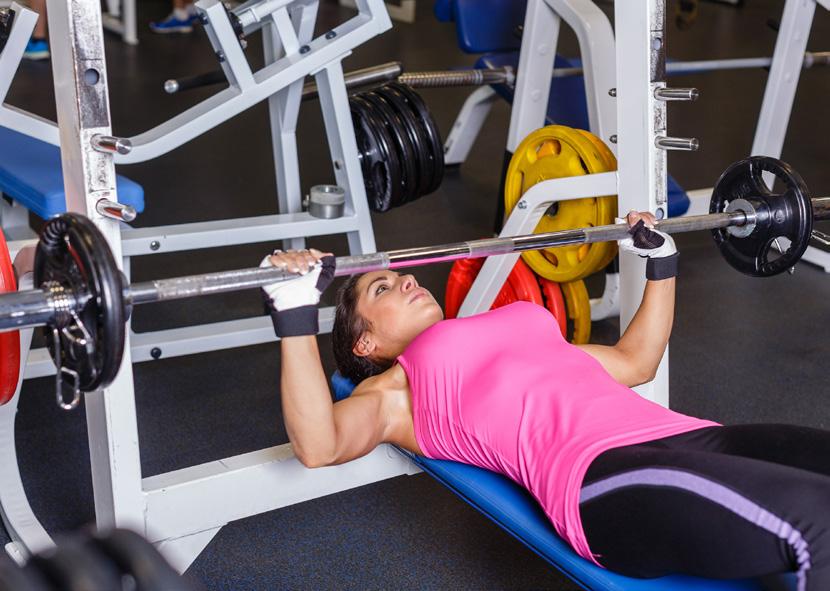
2 A bench press
resistance exercise.
point of failure the moment when no more muscle fibres can be recruited to engage in an activity (e.g. the moment an athlete cannot perform any more bicep curls)
isotonic (dynamic) resistance
training a type of resistance training in which the muscle contraction is dynamic (i.e. there is tension in the muscle and movement across the joint) against a constant resistance isometric (static) resistance training a type of resistance training in which the muscle contraction is static (i.e. there is tension in the muscle but no movement across the joint) isokinetic resistance training a type of resistance training in which movement against a resistance maintains a constant speed, no matter how much force is applied plyometric training a type of resistance training that involves rapid concentric (i.e. shortening) movements of muscle groups followed by rapid eccentric (i.e. lengthening) movements of the same muscle groups
SOURCE
is an example of an isotonic (dynamic)
cadence the pace, timing or rhythm of an exercise (e.g. performing squats with a 1-down, 1-up or a 3-down, 1-up rhythm)
Examples of isotonic (dynamic) resistance training
Lunges are an example of an isotonic exercise that develops the large muscle groups of the upper legs and buttocks. Isotonic exercises can be varied in cadence to encourage muscle endurance. For example, lunges can be performed with the same weight, but some can be completed with a single up-down count, while others can be completed with a 3-down, 1-up count. Other examples of isotonic resistance exercises include:
• squats
• stair climbing
• push-ups
• pull-ups
• bicep curls
• deadlifts
• bench presses.
Isometric (static) resistance training
Isometric (i.e. static) resistance training involves exercises in which the muscle contraction is static. In other words, while the muscle fibres produce tension (i.e. force), they neither shorten nor lengthen and there is no movement across the joint. During isometric resistance exercises, the muscles are held in this state for a nominated length of time.
The benefit of isometric training is:
• the low requirement for specialised equipment
• the ability to target weakness at particular joint angles
• the ability to safely target muscles during rehabilitation.
Examples of isometric (static) resistance training
Holding your body in an extended push-up position (i.e. planking) is a common form of isometric resistance training. This exercise develops muscles in and around the abdomen and requires core muscles in the front and back of the torso to hold this position steady. Other examples of isotonic resistance training include:
• wall sit
• bridge
Isokinetic resistance training
• pushing or pulling against a fixed object
• self-arm wrestle.
Isokinetic resistance training uses specialised machines to ensure movement against a resistance is kept at a constant speed, regardless of how much force is applied. In other words, the harder the resistance is pushed, the harder it pushes back.
The maintenance of constant speed during isokinetic resistance training allows specific muscle groups to be targeted with precision. Exercise cadence and range of motion can also be targeted to suit the individual needs of the athlete and develop a particular component of fitness.
Isokinetic resistance training is beneficial because:
• it allows muscles to gain strength consistently through the whole range of movement
• it provides more precise information about the muscle groups and fitness component being targeted
• it controls movement and therefore prevents injury.
When isokinetic resistance exercises are evaluated, there is less room for variables to impact the levels of fatigue reached. This means overload can be achieved more accurately. The downside is that such precision requires the use of electronic or hydraulically controlled equipment, which is not always accessible to athletes.
Examples of isokinetic resistance training
Where specialised equipment is not available, it is possible to replicate isokinetic resistance training using a range of commonly available equipment. In such cases, care must be taken to ensure force is applied constantly and that the speed of movement also remains consistent throughout the exercise. Use of a metronome (pacing device) can help to achieve a steady pace. Some common forms of isokinetic resistance training include:
• training against a high resistance on a stationary bike
• using elastic bands
• using specialised dynamometers
• machine weights with monitored timing
• self-timing reps of non-machine-based exercises.
Plyometric training
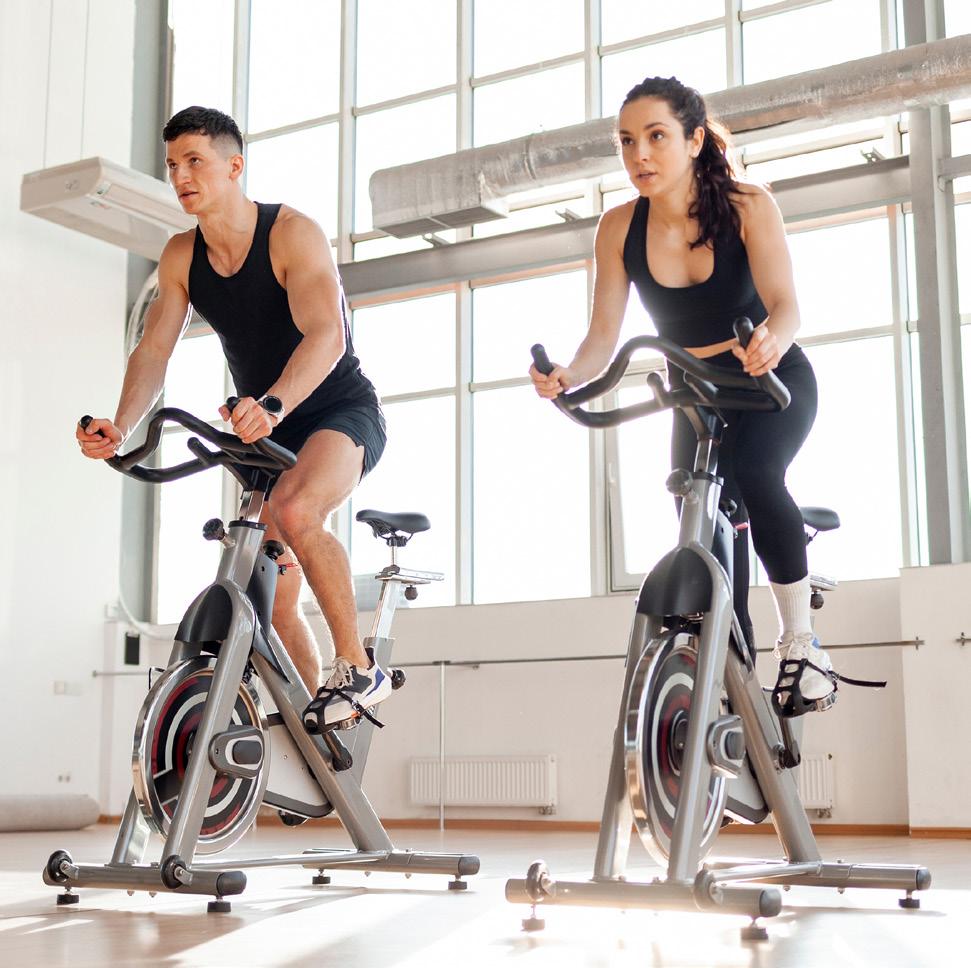
Plyometric training uses rapid concentric movements (i.e. shortening) of muscle groups followed by rapid eccentric movements (i.e. lengthening) of the same muscle groups. In other words, muscles are rapidly contracted and then rapidly extended during their natural elastic recoil action, such as when an athlete jumps off a box to the ground and then immediately springs back up onto the box (as shown in Source 4).
The explosive movements demanded by plyometric training exercises are perfect for developing strength and power, but care should be taken to ensure training is performed safely and with adequate recovery time.
Examples of plyometric resistance training
Examples of plyometric training exercises include:
• box jumps
• bounding
• hopping
• clap push-ups
• medicine ball throws.
Source 5 provides a guide for practising plyometric resistance activities safely.
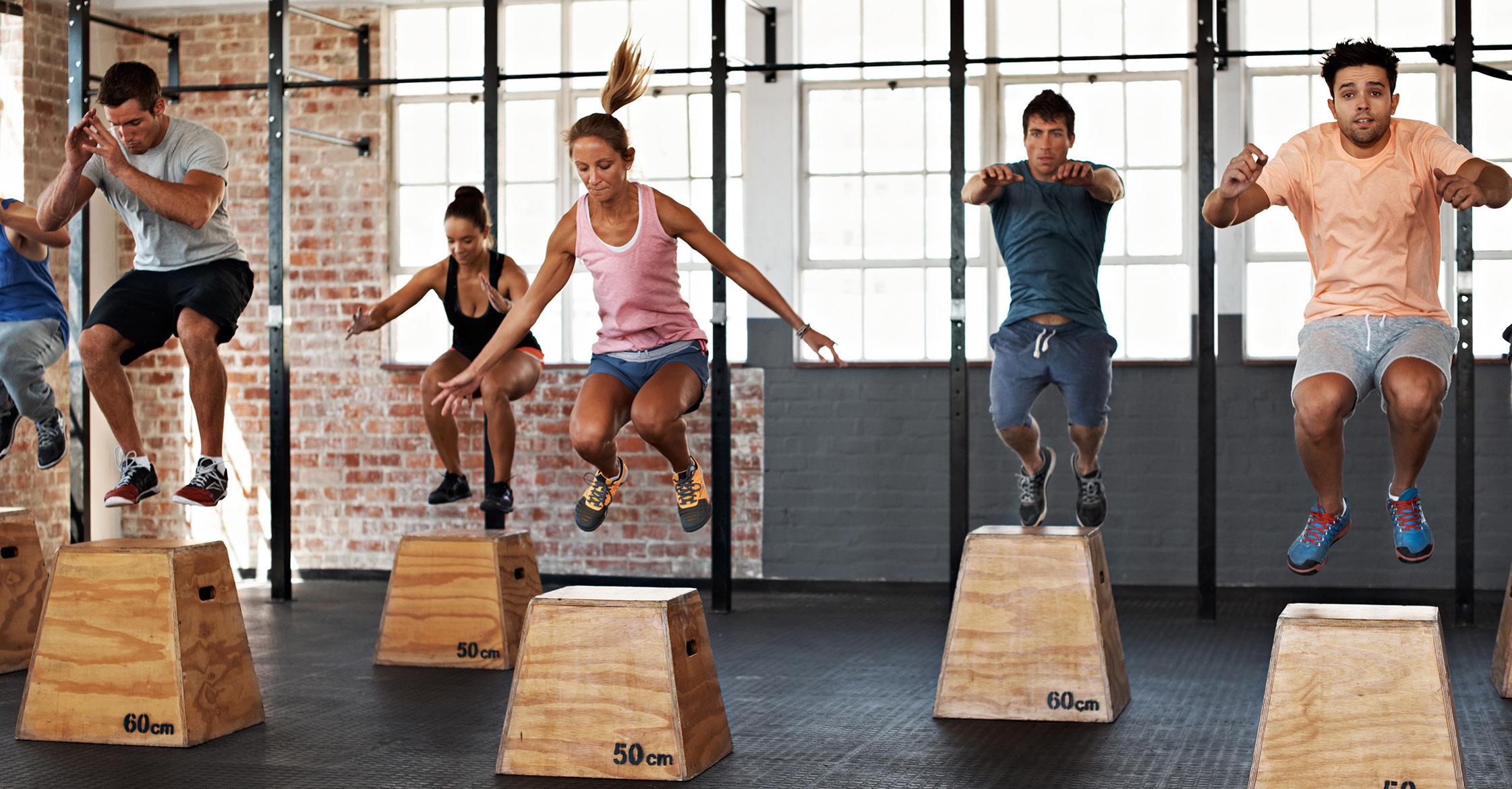
SOURCE 3 Isokinetic resistance training involves the use of specialised equipment, such as stationary bikes, to ensure resistance to movement remains at a constant speed. If specialised equipment is not available, it is possible to replicate isokinetic resistance training using a range of commonly available equipment, such as elastic bands.
SOURCE 4 Jumping from a box to the floor and then using elastic recoil to immediately spring up again is an example of plyometric training.
Rating
1 Very low stress
Recovery time Examples
Very rapid recovery Jump rope or ankle bounces or other low-amplitude jumps
2 Low stress Rapid recovery: 1 day required Tuck jumps, heel kicks, 360° jumps
3 Moderate stress Moderate recovery: 1–2 days required Stair jumps, stride jumps
4 High stress Slow recovery: at least 2 days required Hops, bounds or jumps for distance
5 Very high stress
Very slow recovery: 3 days required Depth jumps or other shock jumps
SOURCE 5 Guidelines for determining adequate recovery between plyometric training sessions
Source: Adapted from V. Gambetta, “Plyometrics: Myths and Misconceptions”, Sports Coach, vol. 20, 1998, pp. 7–12.
Applying resistance training
Resistance training can be manipulated to target strength, power and muscular endurance; for example:
• athletes wanting to develop their strength are generally advised to use a higher weight and lower repetitions
• athletes wanting to develop their power are generally advised to increase the cadence of the movements using a higher weight and lower repetitions
• athletes wanting to develop their muscular endurance are generally advised to use a lower weight and higher repetitions.
Source 6 provides an example of how resistance training can be manipulated to train for strength, power or muscular endurance. It is important to remember that these recommendations are simply a guide; you may need to adjust them to suit your individual needs.
Training objective
Build strength
Build power
Build muscular endurance
Sample training activities
• Use high resistance, e.g. 4–10RM
• Complete 2–6 reps
• Complete 4–8 sets
• Use a slow cadence
• Allow 3–5 minutes rest between sets
• Use a variety of exercises
• Use moderate resistance, e.g. 8–15RM
• Complete 2–8 reps
• Complete 2–6 sets
• Use a fast cadence, i.e. an explosive force
• Allow 10 seconds between reps
• Allow 3–5 minutes between sets
• Use a variety of exercises
• Use a low resistance, e.g. 15–35RM
• Complete 15–30 reps
• Complete 2–3 sets
• Use a fast cadence
• Allow 2–5 minutes rest between sets
SOURCE 6 A guide for using resistance training to train for strength, power and muscular endurance
To overload a weights session, an athlete can manipulate the weight used, the number of repetitions performed or the cadence (pace and timing) of their repetitions. Source 7 shows some commonly used techniques for applying overload to a weight training session.
Techniques
Blitzing
Forced repetitions
Cheating
Negative repetitions
Pre-exhaustion
Explanation
The practice of working a muscle or muscle group with different exercises from different angles on one training day.
Exercises in which a partner gently supports the athlete through the point where the muscles are weakest.
Exercises in which other muscles are used to assist in lifting the weight over the weakest point. The aim is to move past the weak point and overload the strongest part of the muscle. For example, in a very heavy arm curl, the trunk is bent slightly forward and the muscles of the small of the back are used to lift through the weakest point.
Exercises that use eccentric isotonic contractions after the muscle is fatigued. For example, after the biceps muscle is tired from performing bicep curls, a partner assists by lifting the weight and allowing further lowering (eccentric contractions) of the weight by the athlete.
Exercising to isolate and fatigue a muscle, and then once more using the muscle (along with other muscles) in a more complex exercise so that it works further. For example, performing leg extensions to tire the legs and then doing squats.
SOURCE 7 Examples of activities that create overload in athletes participating in resistance training
Key terms and basic principles of resistance training
Before starting resistance training, it is important to have completed a thorough game analysis and devised a training program that considers the principles of training. It is also important to understand some key terms and basic principles that apply to all four types of resistance training. These include:
• repetition maximum
• repetition duration
• isolated versus compound exercises
We will now look at each of these in detail.
Repetition maximum
Repetition maximum (RM) is the weight an individual can lift for a defined number of repetitions. In resistance training, the point of failure is key when determining an individual’s RM. When designing your training strategy, you need to understand what it means to talk in sets and repetitions (“reps”) and you will need to know what your own RM values are.
In training sessions, reps are referred to as the number of times you are required to repeat an exercise in succession. Sets refer to the number of times you repeat the complete number of repetitions.
For example, if you are instructed to perform three sets of 10RM lifts, you would use a weight that you can lift with good form (i.e. to the point of failure) for 10 repetitions only, and you would repeat those 10 repetitions three times. You will often see this written as, for example, “3 × 10RM bicep curls”.
If you are instructed to perform three sets of 10 repetitions of your 15RM lifts, you would use the weight you can lift with good form 15 times but lift it 10 times and repeat that for
repetition maximum (RM) the most weight an individual can lift for a defined number of repetitions repetition duration the amount of time it takes to perform one repetition of an exercise (e.g. the repetition duration of a bicep curl is commonly around 3 seconds)
SOURCE 8 A 10RM would be the heaviest weight you could lift for 10 consecutive repetitions, where you reach the point of failure on your 10th repetition.
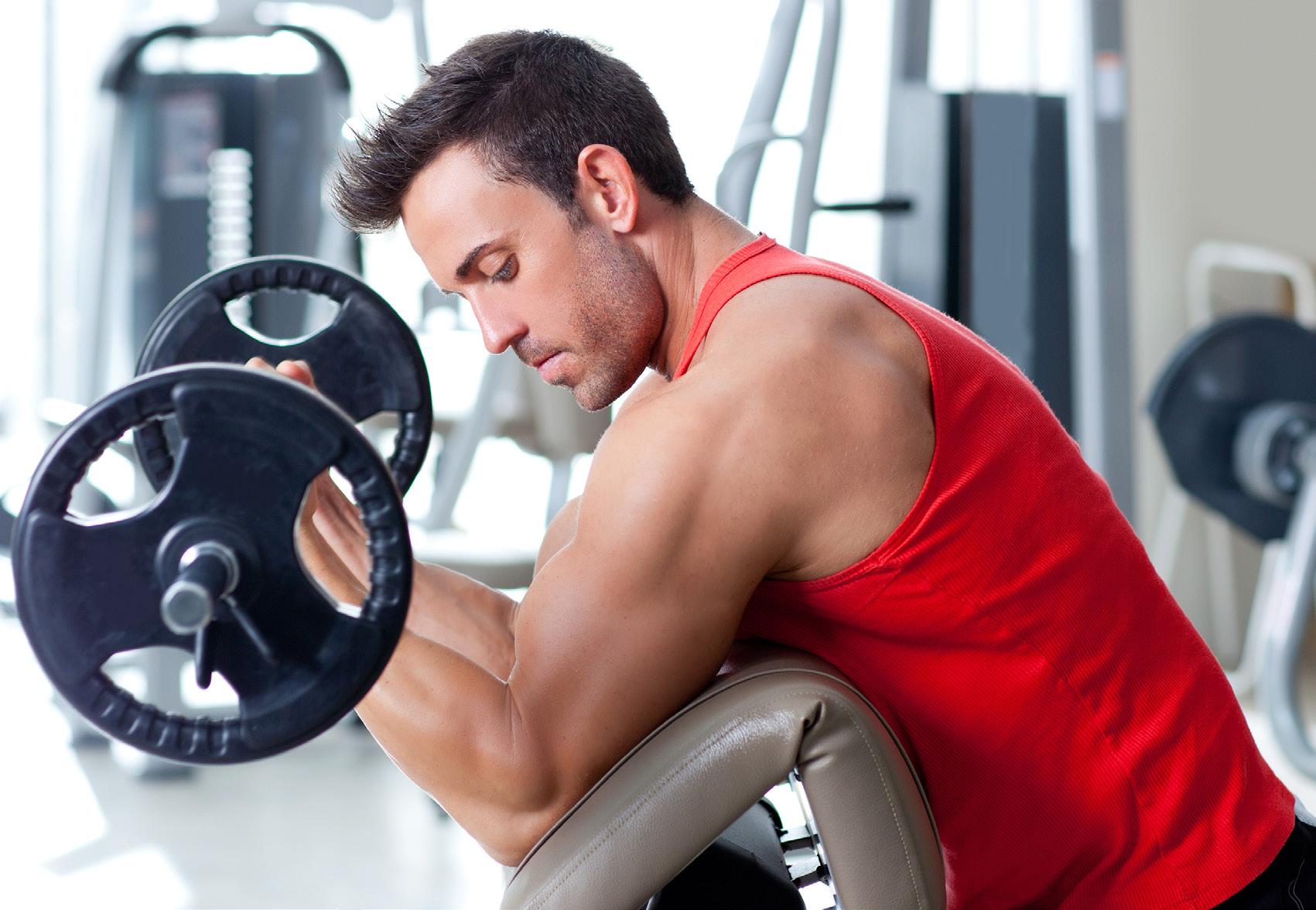
three sets. This is a lower intensity than the previous 10RM exercise. You will often see this written as, for example, “3 × 10 15RM bicep curls”.
It is also common to see instructions to use weights based on a percentage of your 1RM, which is the maximum weight you could lift just once. Working at 75 per cent of your 1RM would mean that if your 1RM is 20 kilograms, you would use 15 kilograms for the exercise. You might see this written as “3 × 10 50% 1RM”. Determining your 1RM is not always easy because of the risks involved with lifting such a heavy weight, especially in untrained athletes. It is often recommended to use estimated 1RM formulas, which use literature based on averages. This means that, if you can determine your 5RM, you can estimate your 1RM. Source 9 takes you through the steps for estimating your 1RM safely.
Determining your estimated 1RM (based on averages)
Complete the following steps with 3–4 minutes of rest between each one. You will need to do this for each resistance exercise you perform.
Step 1: 10 reps with the bar only (no weights)
Step 2: 8 reps with a light/easy weight
Step 3: 6 reps with a moderately heavy weight
Step 4: 5 reps with a heavier weight than previously used – moderately heavy
Step 5: 5 reps with a heavy weight
Step 6: 5 reps with a heavier weight than previously used (you should reach the point of failure by the 5th lift and not before)
Step 7: Multiply the weight lifted in Step 6 (5RM) by 1.15 to estimate your 1RM.
Note: At Step 6, if you can continue beyond 5 lifts, do so until you reach the point of failure, taking note of how many repetitions you complete.
SOURCE 9 How to safely estimate your 1RM
SOURCE 10 Charts can be used to find your 1RM based on the maximum reps performed.
Source: Chart from G. Gregory Haff, N. Travis Triplett, Essentials of Strength and Conditioning 4th Edition, Human Kinetics, Inc.
Repetition duration
When discussing resistance training, it is also important to consider the repetition duration of the exercise. Repetition duration is the amount of time it takes to perform one repetition. This is sometimes referred to as cadence. Repetitions should be performed steadily, without jerking, to ensure muscular tension is maintained.
The speed of repetition depends on the fitness goal of the training. Faster repetitions are important for power development, while strength and muscular endurance require slower movements. Generally, explosive power-based lifts are performed with 1- to 2-second reps, while strength-based training uses 3- to 4-second reps.

isolated exercise an exercise targeting a single group of muscles over a single joint compound exercise an exercise targeting two or more muscle groups over multiple joints
Isolated versus compound exercises
It is important to identify the muscle groups you want to develop in a resistance training session. Resistance training can target:
• a single group of muscles over a single joint; in this case, the exercise is called an isolated exercise (e.g. a bicep curl)
• two or more muscles over multiple joints; in this case, the exercise is called a compound exercise (e.g. a chest press).
Below are some common weight training exercises for particular muscle groups, identified as isolated or compound exercises.
Muscle group Exercise
Chest
Biceps
Triceps
Shoulder
Flat dumbbell press
Bicep curl
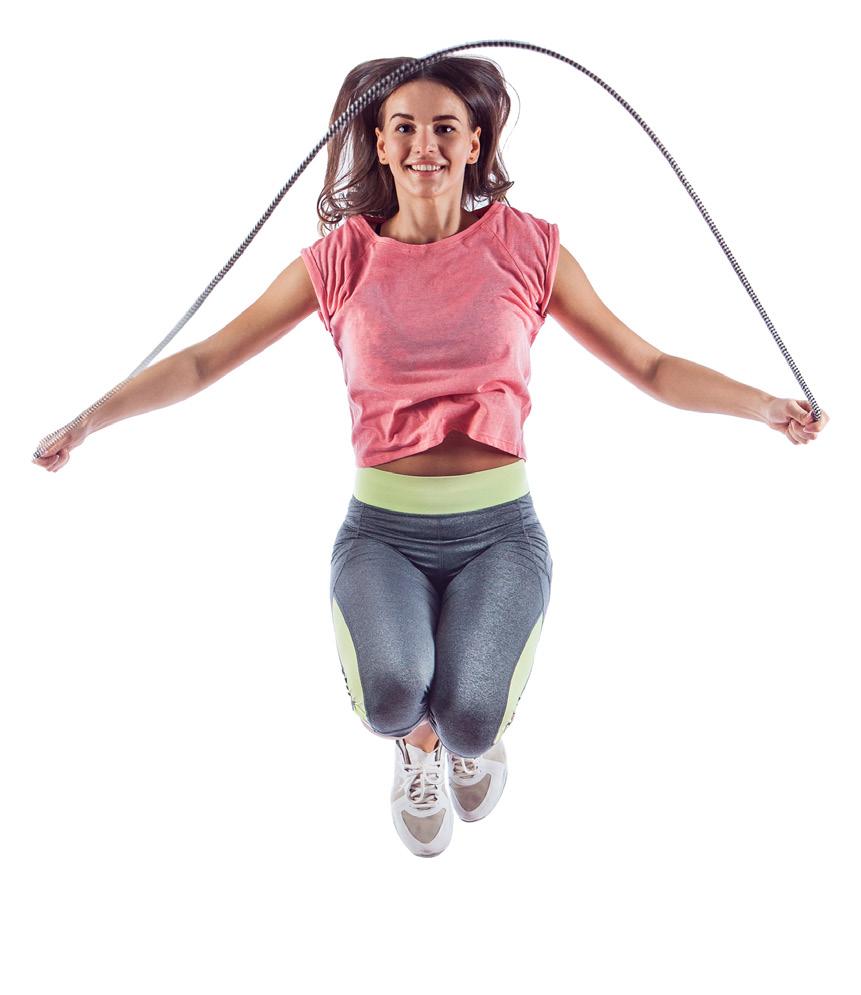
Type of exercise
Compound
Isolated
One-arm triceps kickback Isolated
Chin-ups
Back Upright row
Abdominals
Quadriceps
Hamstrings
Calf
Side crunches
Squat
Hamstring curl machine
Compound
Compound
Isolated (can be compound depending on technique)
Compound
Isolated (can be compound depending on technique)
Calf raises Isolated
SOURCE 11 Examples of isolated and compound exercises common in resistance training
Check your learning 4.16
Check your learning 4.16
Retrieval and comprehension
1 Choose the correct answer. Select the most correct definition for resistance training.
A a training method that uses dumbbells and barbells
B a form of exercise that requires an athlete to work against something that resists the movement of their body
C a form of exercise that requires an athlete to work continuously
D a training method that applies sets of exercises, often in a circuit
2 Choose the correct answer.
Identify the four types of resistance training.
A isotonic, isometric, plyometric, dynamic
B isotonic, isometric, isokinetic, plyometric
C dynamic constant training, dynamic progressive training, isotonic training, plyometric training
D dynamic variable training, isotonic training, isometric training, isokinetic training
3 Construct a diagram showing the four types of resistance training and include three to five examples of exercises that could be used in each.
4 In your own words, summarise the terms “sets” and “reps”.
5 Explain the terms “repetition maximum” and “repetition duration”. Provide examples of how these concepts can be used as part of a training strategy.
Analytical processes
6 Determine the types of resistance training that would be best suited to a triple jumper, taking the energy and fitness needs of this event into account. Explain your choice.
Lesson 4.17
Interval training
Key ideas
Knowledge utilisation
7 Select one specialised movement sequence you are required to complete in your selected physical activity. Create a list of resistance training exercises that would help to develop your strength, power or endurance in the performance of that specialised movement sequence.
→ Interval training is a form of exercise that uses alternating periods of work with periods of rest to enhance specific components of fitness and target particular energy systems.
→ There are three main types of interval training: high-intensity interval training (HIIT), sprint interval training (SIT) and aerobic interval training (AIT).
What is interval training?
Interval training is a form of exercise that uses alternating periods of work with periods of rest to enhance specific components of fitness and target particular energy systems. Essentially, interval training is completing an exercise (e.g. a run), following it with a rest period and then repeating this pattern for a predetermined number of repetitions. Interval training is an effective method for developing both aerobic and anaerobic fitness. In particular, interval training can work to enhance aerobic capacity, muscular endurance, speed and agility. Including interval training in a training strategy has many benefits, such as:
• more efficient workouts, which allow you to get a lot done in a short amount of time
• increased fuel efficiency due to enhanced use of your body’s fats and carbohydrates
• increased aerobic capacity
• enhanced power and muscular endurance
• increased lactate threshold
• more fun due to increased variety. Learning intentions and success criteria
high-intensity interval training (HIIT) a form of interval training that alternates short, intense, unsustainable bursts of anaerobic-zone exercise (lasting less than 20 seconds) with short recovery periods sprint interval training (SIT) a form of interval training that alternates periods of high-intensity sprints with rest periods aerobic interval training (AIT) a form of interval training that incorporates longer work periods and rest periods than other forms of interval training (i.e. HIIT and SIT)
Types of interval training
There are three main types of interval training:
• high-intensity interval training (HIIT)
• sprint interval training (SIT)
• aerobic interval training (AIT)
The type of interval training you choose will determine which fitness component is targeted. It is helpful to choose activities that have similar actions to the specialised movement sequences in your selected physical activity.
We will now look each each of these in more detail.
High-intensity interval training (HIIT)
High-intensity interval training (HIIT) is a form of interval training that alternates short, intense, unsustainable bursts of anaerobic zone exercise lasting less than 20 seconds with a short recovery session. HIIT is an effective method for improving speed, strength and power but also has a positive effect on aerobic capacity by increasing lactate threshold. Research has shown that effective completion of a HIIT session is just as beneficial as completing a longer, steadier session in raising an athlete’s VO2 max.
The duration of a HIIT session is largely dependent on the fitness of the athlete. The more fitness they have, the longer they can continue repeating the work intervals. HIIT sessions are generally finished once the athlete reaches exhaustion, usually in under 30 minutes.
In HIIT, the rest intervals are short to ensure the athlete remains in the anaerobic training zone. The work:rest (W:R) ratio is recommended to be 2:1. So for 20 seconds of work, there would be 10 seconds of rest. For less fit athletes, this ratio could be modified to 2:2 (i.e. 20 seconds work to 20 seconds rest).
Examples of HIIT training
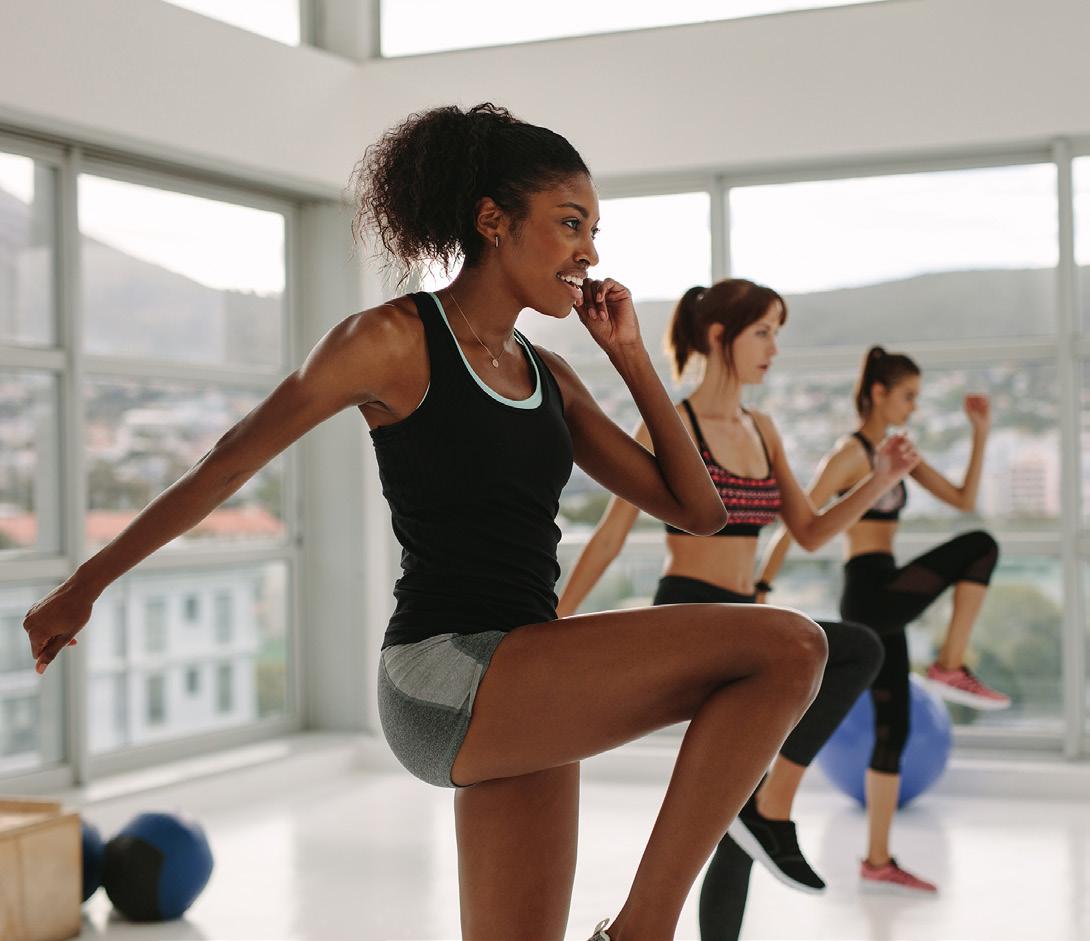
Source 2 shows a sample HIIT session designed for a beginner athlete. You can see that the session is short but intense. Due to the gruelling nature of HIIT, athletes need to have high levels of motivation and a strong sense of purpose when completing these sessions. There is usually significant fatigue experienced in HIIT sessions, so around 48 hours of recovery is recommended before repeating a HIIT session.
SOURCE 1 High-intensity interval training (HIIT) involves very short, unsustainable, high-intensity efforts followed by even shorter rest intervals.
Sample HIIT session for a beginner
Total training time: 20 minutes
Warm-up
• 1 minute fast walking on the spot
• 30 seconds torso rotations
• 30 seconds high kicks
• 1 minute side steps
• 1 minute squats
HIIT exercises
(20 seconds on at 100% intensity, 10 seconds off; repeat each exercise three times before moving on to the next)
• Jumping jacks
• Running on the spot
• Elbow to knee sit-ups
• Jump lunges
• Travelling push-ups
Once you have completed all HIIT exercises three times each, have a 2-minute active rest (e.g. walk on the spot) before repeating the whole session one more time.
SOURCE 2 A sample HIIT session designed for a beginner athlete
Theory in action HIIT training
Short, intense interval workouts – such as HIIT –can produce similar results to longer, slower cardio workouts in a much shorter time period. They can also stimulate physiological adaptations in the body that help athletes transition from burning fats to carbohydrates more efficiently and help to reduce the need for long rest periods between intervals of work. However, this does not mean that athletes can just ignore less intense, continuous-type exercise completely. Research shows that too much HIIT can lead to overtraining and injury.
Sprint interval training (SIT)
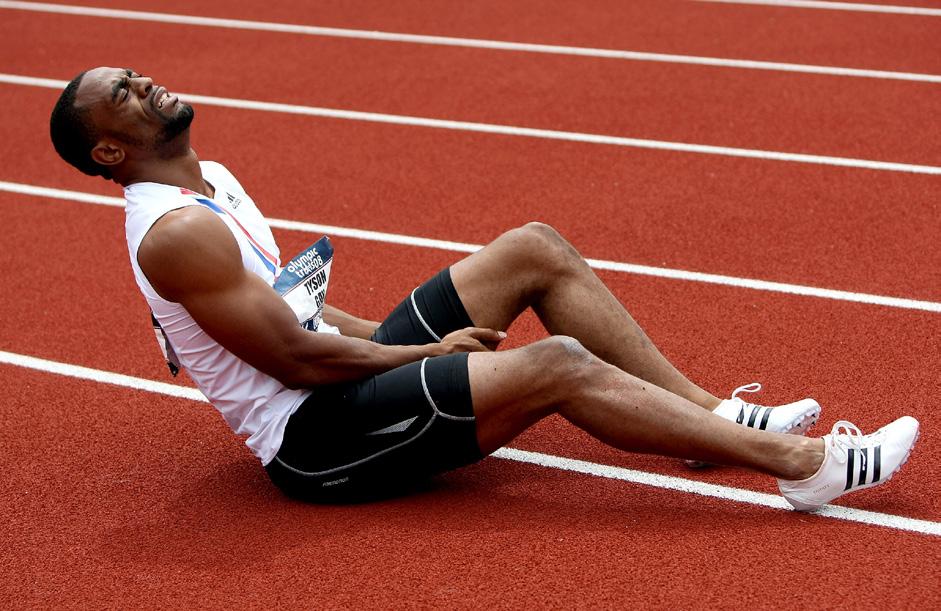
SOURCE 3 HIIT is highly effective for stimulating physiological adaptation; however, it must be used sparingly to avoid overtraining and injury.
Sprint interval training (SIT) is a form of interval training that alternates periods of highintensity, anaerobic zone training with rest periods. As the name suggests, this type of interval training uses sprints to stress the anaerobic systems. SIT can lead to improvement in activities where aerobic capacity, strength, power and speed are required.
SIT training is often used for short-distance race events and team sports that have moments of high-intensity work followed by less intense periods. It is a convenient form of training due to its ability to develop many components of fitness in a short time, without much equipment needed.
When performing SIT, it is important to use maximum or near maximum intensity during the work period and to have adequate rest between efforts. If the rest period is not long enough to restore levels of phosphocreatine in the muscles, then it will be difficult for the athlete to maintain a high intensity due to the onset of blood lactate accumulation (OBLA). In this case, it is generally advised to use a work:rest ratio of 1:4 or 1:5. If the aim is to increase lactate threshold in an attempt to improve an athlete’s ability to maintain
speed over a greater distance, then the work:rest ratio needs to be lower, at around 1:2 or 1:3, to ensure athletes experience the effects of blood lactate and subsequently increase their tolerance to it. Where training aims to target the ATP–PC system only, the minimum rest required is 2–3 minutes, with sprint intervals less than 20 seconds.
Examples of SIT training
Source 5 shows a sample SIT session designed to mirror the movements common in “Invasion” and “Net and court” physical activities (i.e. lots of changes in direction).
Due to the high stress placed on an athlete’s body when performing SIT, and the subsequent fatigue experienced, it is recommended to avoid repeating SIT sessions within less than 48 hours.

4 In sprint interval training (SIT), short bursts of sprints are alternated with rest periods to develop aerobic capacity, speed and power.
Sample SIT session
Total training time: 20 minutes
Warm-up
• 2-minute continuous run
• 4 sets of 3 × 20 m run-throughs, progressing from 50% to 80% intensity (i.e. set 1: 50%; set 2: 60%; set 3: 70%; set 4: 80%)
SIT activity
• Set up cones at 5 m intervals, up to 30 m.
• Sprint shuttles for 30 seconds, starting with 5 m up and back, then 10 m, 15 m, and so on. At the end of 30 seconds, walk back to the start line and rest for 2 minutes.
• Complete 6 sets.
SOURCE 5 A sample SIT session designed to mirror the movements common in “Invasion” and “Net and court” physical activities
SOURCE
Aerobic interval training (AIT)
Aerobic interval training (AIT) is a form of interval training that incorporates longer work periods and rest periods than other forms of interval training. As the name suggests, it has a focus on building aerobic capacity. Generally, work intervals in AIT are greater than 1 minute and rest intervals match the work in a 1:1 ratio; for less fit athletes, a ratio of 1:2 might be more appropriate. During periods of work, athletes will look to enter the anaerobic training zone for short periods (i.e. work between 80 and 90 per cent MHR), while the less intense periods should stay in the aerobic zone (i.e. 60–80 per cent MHR) to ensure they do not continue to accumulate lactic acid.
Examples of AIT training
An example of AIT is to complete a 1-minute (or 400-metre) high-intensity (i.e. 80–90 per cent MHR) run and follow with a 1- to 2-minute walking rest interval, repeated three or four times. Another example is to complete a 1500-metre run just below lactate threshold (i.e. approximately 80–85 per cent MHR) and then walk or jog for 400 metres before repeating the interval two to three times.
Applying interval training
Athletes wanting to improve their:
• ATP–PC system need to use short, high-intensity work intervals of 10–20 seconds and allow 2–3 minutes of resting recovery between each effort (i.e. HIIT or SIT). When athletes don’t allow adequate time for recovery, two things happen: performance starts to drop off and the lactic acid system starts contributing greater amounts of ATP
• lactic acid system need to use moderate-length, high-intensity work intervals of 30–90 seconds and allow a work:rest (W:R) ratio of 1:2 to 1:3, using a light active recovery in the rest periods (i.e. HIIT, SIT or AIT)
• aerobic system need to use longer, moderate- to high-intensity work intervals of anywhere from 1 to 4 minutes. The work:rest (W:R) ratio for intervals around 1–2 minutes are usually 1:1. For intervals around 3–4 minutes, the W:R could become 1:1 or even 1:0.5. This information is summarised in Source 6.
Always 2–3 minute recovery after every effort (if training ATP–PC system only)
SOURCE 6 Guidelines for designing an interval training session
Check your learning 4.17
Check your learning 4.17
Retrieval and comprehension
1 Choose the correct answer. Identify three types of interval training.
A high-intensity, sprint, aerobic interval training
B high-intensity, fartlek, sprint
C sprint, aerobic interval training, long slow distance
D lactate intensity training, sprint training, aerobic interval training
2 Choose the correct answer. Select the components of fitness that interval training can enhance.
A aerobic capacity, anaerobic capacity, muscular endurance, agility
B aerobic capacity, muscular endurance, agility, muscular power
C anerobic capacity, muscular power, speed, agility
D aerobic capacity, muscular endurance, speed, agility
3 Define the term “interval training”.
4 Identify the three different types of interval training and provide an example of a training activity for each that applies to one of the physical activities you have participated in during this unit.
5 Summarise the recommended work:rest (W:R) ratios for each type of interval training.
Lesson 4.18
Analytical processes
6 Compare and contrast HIIT and SIT.
7 Determine which type of interval training would be most beneficial for each of the following athletes and provide a reason to support your selection:
a a volleyball outside hitter
b an 800 m runner
c a touch football middle player
Knowledge utilisation
8 Evaluate the need for interval training in your training strategy based on your fitness profile and the physical requirements of your selected physical activity. Write a response of 150 words, making use of primary data to justify your evaluation.
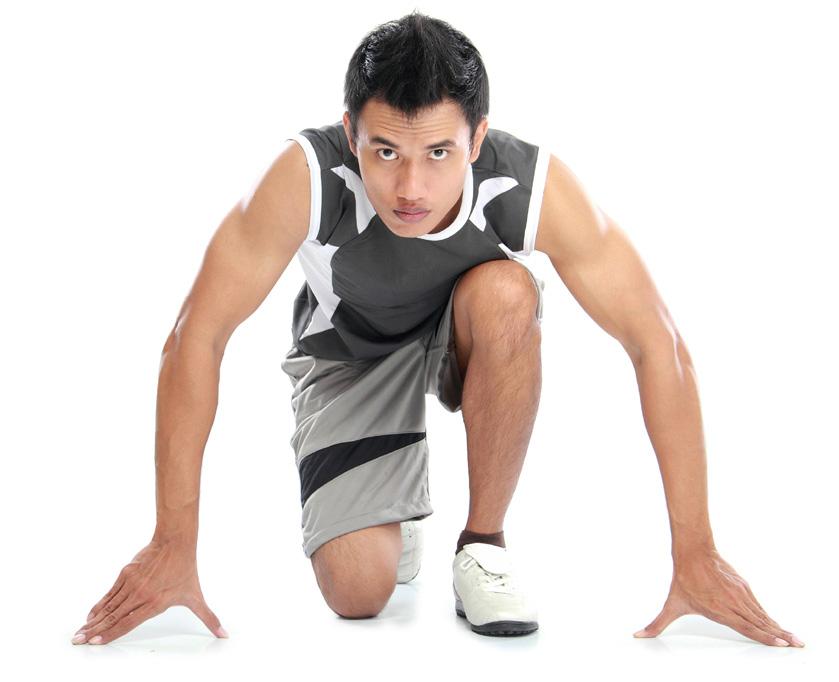
Flexibility training
Key ideas
Learning intentions and success criteria
→ Flexibility training is a form of exercise that involves stretching the muscles, tendons and ligaments in and around joints.
→ There are four main types of flexibility training: dynamic flexibility training, static flexibility training, passive flexibility training and proprioceptive neuromuscular facilitation (PNF) flexibility training.
SOURCE 7 Interval training is an effective method for developing both aerobic and anaerobic fitness.
What is flexibility training?
Flexibility training is a form of exercise that involves stretching the muscles, tendons and ligaments in and around joints. The aim of flexibility training is to enhance the motion of the body’s joints. It is one of the most neglected methods of training; however, stretching muscles and increasing their range of motion is important because it improves an athlete’s ability to perform specialised movement sequences fluently and also decreases the risk of injury.
Types of flexibility training
There are four main types of flexibility training:
• dynamic flexibility training
• static flexibility training
• passive flexibility training
• proprioceptive neuromuscular facilitation (PNF) flexibility training
The type of flexibility training you choose will depend on the timing and content of the training in relation to other exercise. It is helpful to choose activities that have similar actions to the specialised movement sequences in your selected physical activity.
We will now look at each type in more detail.
Dynamic flexibility training
Dynamic flexibility training involves stretching body parts and muscles in a controlled way through dynamic movement. This type of flexibility training closely resembles the actions of joints and muscles during performance; it should start slowly and increase in intensity as the muscles stretch. Dynamic stretching is recommended before commencing any physical activity.
Examples of dynamic flexibility training
Examples of dynamic flexibility exercises include:
• lunges
• torso twists
• high knees
Static flexibility training
Static flexibility training involves stretching body parts and muscles through a full range of motion and holding them in that position for a period of time using nothing but the agonist muscle (i.e. no assistance).
Examples of static flexibility training
Examples of static flexibility exercises include:
• hamstring stretch
• quadriceps stretch
• gluteus maximus stretch.
• side bends
• leg swings
• alternating toe touches.

SOURCE 1 Static flexibility stretching involves holding a position for a period of time.
dynamic flexibility
training a type of flexibility training that involves stretching body parts and muscles in a controlled way, gradually increasing reach and/or speed of movement
static flexibility training a type of flexibility training that involves stretching body parts and muscles through a full range of motion and holding them in that position for a period of time with nothing but the use of the agonist muscle (i.e. with no assistance) passive flexibility training a type of flexibility training that involves having another person stretch body parts and muscles through a full range of motion and hold them in that position for you proprioceptive neuromuscular facilitation (PNF) flexibility training a type of flexibility training that involves stretching body parts and muscles through a full range of motion passively (i.e. with the assistance of another person), followed by the athlete pushing against the resistance, and then another round of passive stretching that pushes the stretch a little beyond the previous range of motion
Passive flexibility training
Passive flexibility training involves having another person stretch body parts and muscles through a full range of motion and hold them in that position for you. This type of training is typically done at the completion of exercise or between periods of exercise.
Examples of passive flexibility training
Examples of passive flexibility exercises include:
• partner-assisted chest stretch
• partner-assisted one-leg hamstring stretch
• partner-assisted hamstring and erector spinae stretch (in which the athlete sits with legs outstretched and resistance is placed on their upper back, forcing their chest towards their feet).
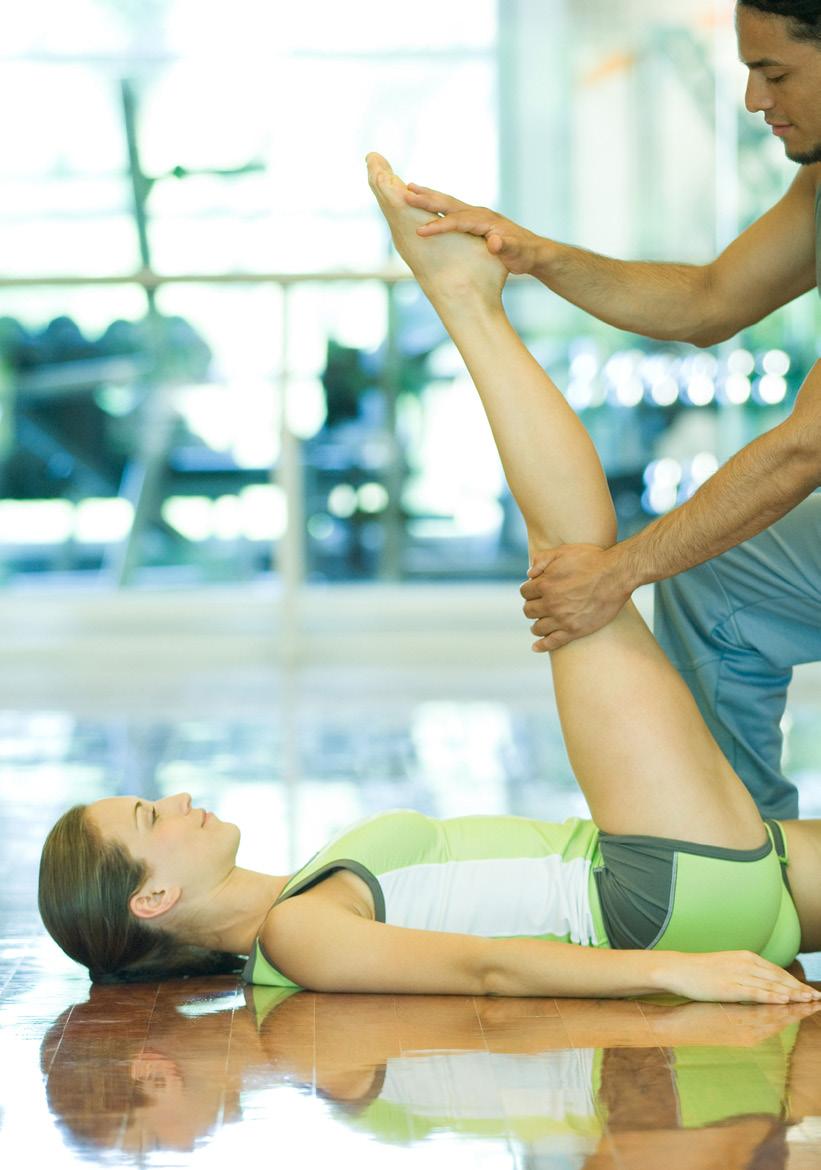
Proprioceptive neuromuscular facilitation (PNF) flexibility training
Proprioceptive neuromuscular facilitation flexibility training (more commonly known as PNF training) involves stretching body parts and muscles through a full range of motion passively (i.e. with the assistance of another person or a resistance band), followed by the athlete pushing against the resistance, and then another round of passive stretching that pushes the stretch a little beyond the previous range of motion. This type of training is often performed outside training times and improves not only flexibility but also strength.
Examples of PNF flexibility training
Examples of PNF flexibility exercises include:
• partner-assisted groin stretch
• elastic band–assisted hamstring stretch
Watch a range of videos demonstrating the different types of flexibility training.
Video: Dynamic flexibility training
Video: Proprioceptive neuromuscular facilitation training
Video: Static flexibility training
• wall-assisted gastrocnemius stretch.
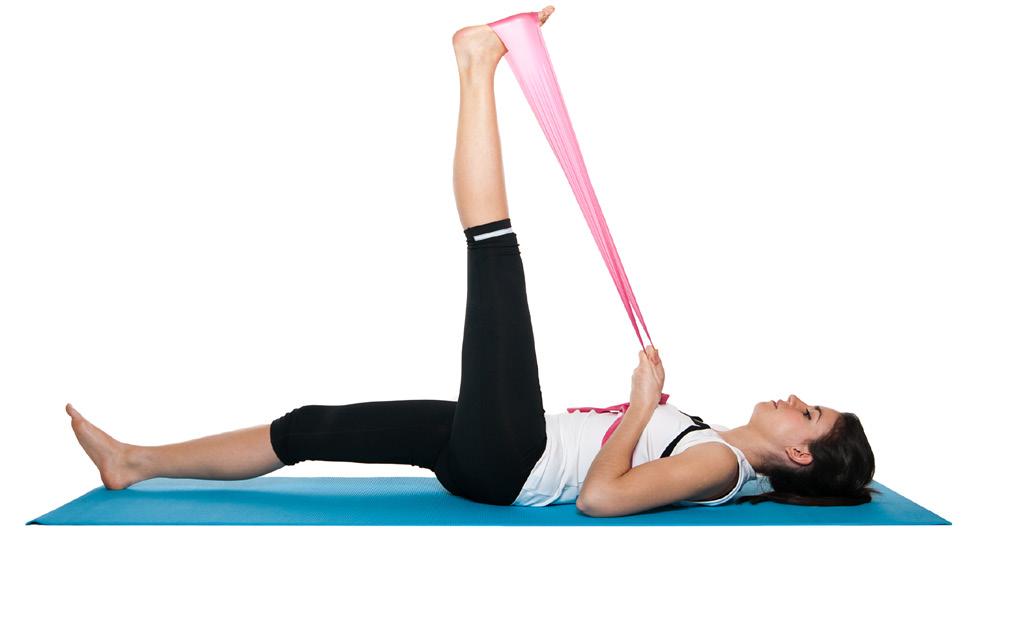
SOURCE 3 PNF training requires a partner, or a prop such as an elastic band or wall so that the athlete can push against the resistance.
SOURCE 2 Passive flexibility training involves having another person stretch body parts and hold them in position for you.
Study tip
Applying flexibility training
Decisions around which flexibility training type to choose depend on a range of factors, as outlined in Source 4.
Flexibility training Why When How
Dynamic To warm up or to keep blood flowing during and/or after performance and to increase range of movement
Static To increase range of movement
Passive To increase range of movement
PNF To increase range of movement and increase strength in weak stretched positions
• Before training or performance
• During training or performance
• Sometimes after training or performance
• After training or performance
• After training or performance
• After training or performance
• During specialised training sessions
Controlled (non-jerky), gentle movements across the entire range of motion are performed in sets of approximately 10 repetitions.
Without props or a partner, athletes hold a static stretch for 10–30 seconds.
A partner holds a static stretch for 10–30 seconds.
Each stretch is conducted in three phases:
1. Partner holds static stretch for 10–30 seconds.
2. Athlete performs an isometric contraction (no movement) against the stretched position.
3. Athlete relaxes and then repeats Phase 1 while exhaling.
Retrieval and comprehension
1 Choose the correct answer.
Identify the four types of flexibility training.
A dynamic, static, passive, neurological
B dynamic, static, passive, proprioceptive neuromuscular facilitation
C active, dynamic, ballistic, fascia
D fascia, static, passive, proprioceptive neuromuscular facilitation
2 Choose the correct answer.
Identify why it is important for athletes to stretch their muscles and increase their range of movement via flexibility training.
A It improves an athlete’s ability to move muscles at the point of connection to joints and allows for superior movement.
B It improves an athlete’s ability to perform specialised movement sequences fluently and also decreases the risk of injury.
C It decreases injury risks through appropriate warm-up and cool-down for muscle groups used within the selected physical activity.
D It improves an athlete’s recovery and physical capabilities through their muscles and ligaments.
3 Construct a diagram that explains the four types of flexibility training and provides an example of each one.
Analytical processes
4 Determine which types of flexibility training you would most benefit from in your selected physical activity and/or position. Explain your response, making use of primary data.
Learning intentions and success criteria
Lesson 4.19 Circuit training
Key ideas
→ Circuit training involves a series of exercises that are performed in a consecutive rotation, with minimal rest periods in between.
What is circuit training?
Circuit training involves a series of exercises that are performed in a consecutive rotation, with minimal rest periods in between. Circuit training is an excellent training method for enhancing specific fitness components (e.g. power, agility or speed) and skills. Circuit exercises can be varied to fit an individual athlete’s needs and fitness levels.
Examples of circuit training
A circuit can have any number of exercises. Generally, 10 activity stations are recommended but as few as five and as many as 15 can achieve gains. When training in a group, it is important to take the number of participants into consideration to ensure there are enough stations for everyone.
Circuit training can use components of other training methods such as interval training, resistance training and flexibility training. Examples of circuit activities include:
• plyometric activities
• weight lifting activities
• HIIT activities
• flexibility activities.
Circuits can be controlled by time or number of repetitions. For large groups, it is best to control by time so that circuits are completed simultaneously, enabling ease of rotation. However, number of repetitions ensures a certain workload is complete before moving on to the next station.
SOURCE 1 Circuit training involves setting up a variety of exercise stations that aim to target different fitness components or skills.
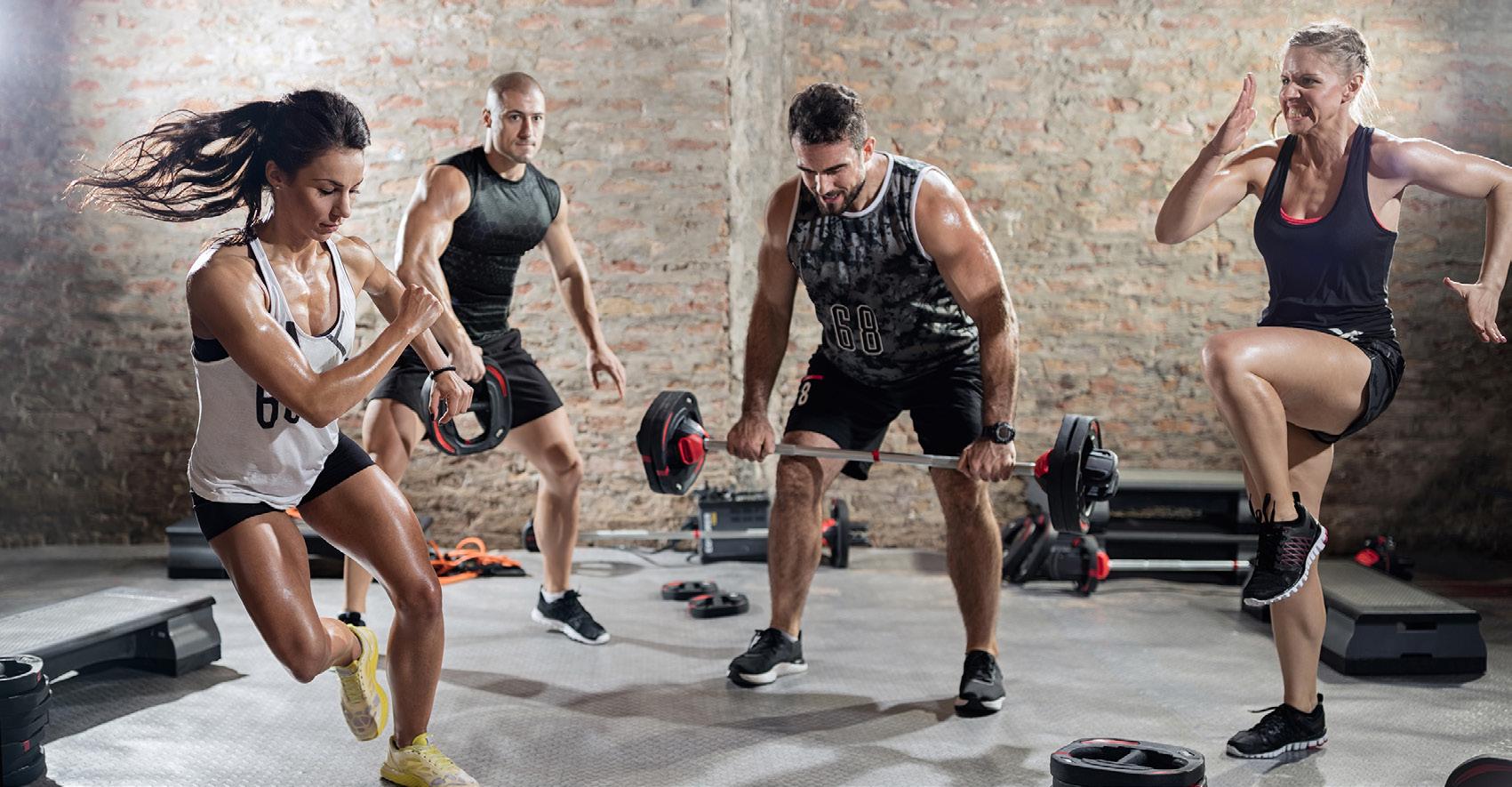
Applying circuit training
Activities chosen for circuit training can target different components of fitness and different energy systems, depending on the duration of the exercises and the intensity. It is recommended to choose exercises that target the fitness components identified in your physical activity’s specialised movement sequences. Manipulating the work:rest (W:R) ratio can impact the energy system that is targeted in circuit training. It is ideal to consider the W:R ratios and exercise intensity experienced in your physical activity when designing this training method.
When designing a circuit, it is important to determine how much time you have overall –anywhere from 10 to 45 minutes is suitable. The less time you have, the fewer exercises you will need in the circuit and the more intensely you will need to work. Once you have set the time, you will need to structure the circuit so that you are working on different fitness components and different body parts in consecutive exercises. This way, very little rest will be needed between stations.
Futsal is a fast, explosive sport requiring speed, power and agility, as well as muscular endurance and aerobic capacity. Most of the work completed in a futsal game uses the aerobic system with the ATP–PC system contributing in short spurts in a ratio of about 1:1. An example of circuit training activities suitable for a futsal player is shown in Source 2.
Upper body Lower body Compound Travelling motion Core
• Push-ups
• Triceps dips
• Bicep curls
• Chin-ups
• Russian twist
• Lunges
• Squats
• Calf raises
• Superman leg raises
• Step-ups
• Leg curls
• Jump lunge
• Jump squat
• Tuck jump
• Mountain climbers
• Bench-overs
• Jumping rope
SOURCE 2 An example of circuit training activities suitable for a futsal player
Source 4 shows a sample circuit training session for a futsal player. Due to the high W:R ratio in futsal, the rest time between each station has been set at 1:1. So, athletes will rest for the same amount of time they work. They should be working at an intensity of 8–9 RPE at each station to match the high intensity of the sport. In this sample circuit, some skill work has also been included, which keeps it interesting for participants while developing their specialised movement sequences.
• Shuttle sprints
• Stair climbs
• Hill sprints
• Power skipping
• Hopping/jumping over cones
• Cycling
• Rowing
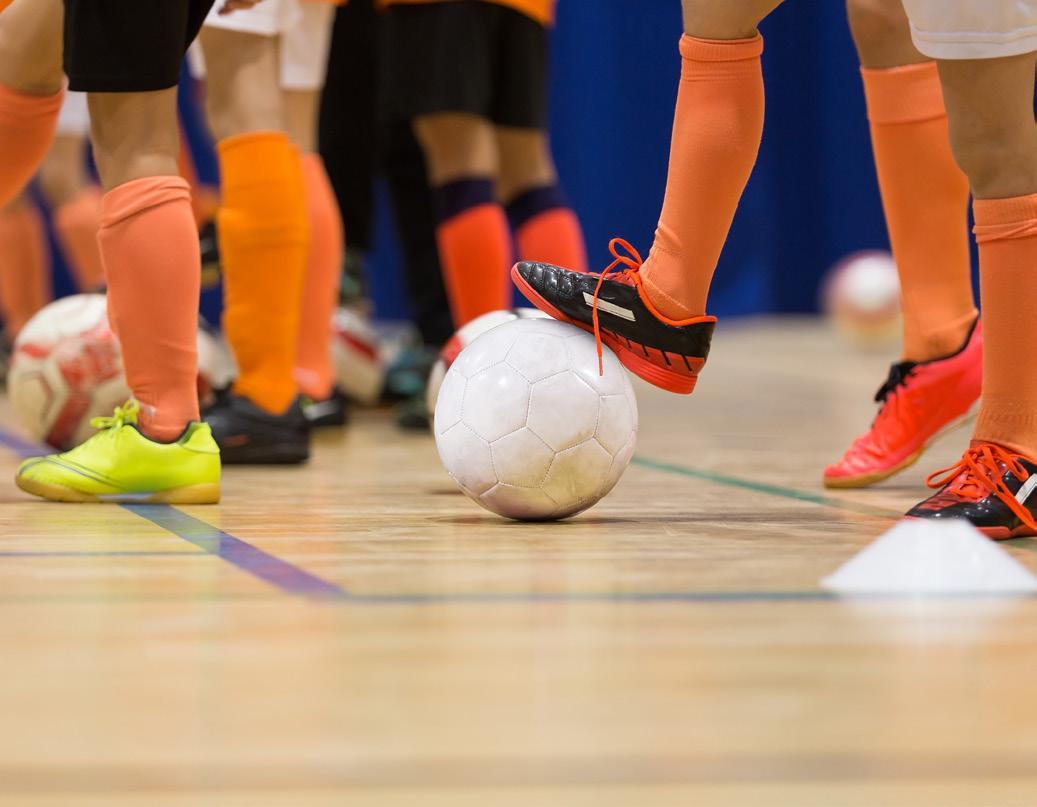
SOURCE 3 Futsal is a high-intensity sport with a variety of fitness and energy requirements, which makes circuit training an ideal component of a training strategy.
• Sit-ups (with or without variations)
• Planking
• Bridge
• Dish
Sample circuit training session for a futsal player
Time: 60 minutes
Follow the repetitions prescribed for each station.
Use a W:R ratio of 1:1.
Aim for an intensity of 8–9 RPE.
Repeat the circuit three times with a 1-minute rest/ drink break between each set.
• 5 m shuttle runs (10 reps): speed
• Clap push-ups (10 reps): power
• Tuck jumps (10 reps): power
• Crunches (30 reps): muscular endurance
• Dribble zigzags (5 reps): agility
• Leg swings (groin and hamstring stretches; 20 reps): flexibility
• Lunges (10 reps): muscular endurance and flexibility
• 3 m side-to-side cone touches (10 reps): agility
SOURCE 4 A sample circuit training session for a futsal player
• Ball keepy uppy (aim for 10 touches): agility
• Mountain climbers (10 reps): aerobic capacity and muscular endurance

Check your learning 4.19
Check your learning 4.19
Retrieval and comprehension
1 Choose the correct answer. Identify the appropriate time range for circuit training.
A 10 to 45 minutes
B 20 minutes to 1 hour
C 30 to 45 minutes
D 45 minutes to 1.5 hours
2 Choose the correct answer. The energy systems targeted by circuit training can be manipulated by:
A adjusting the method of resistance.
B increasing or decreasing the number of work stations or rotations.
C including skill work.
D adjusting the work:rest (W:R) ratio.
3 Define the term “circuit training”.
4 Explain how you might determine the amount of time spent at each exercise station during circuit training.
5 Describe the impact of group size on the structure of a circuit.
Analytical processes
6 Compare and contrast the two circuits below. Determine some of the training objectives for each circuit, considering target components and fitness and energy systems. Deduce the physical activity or category of physical activity each circuit has been designed for.
Have a 2-minute rest between each exercise. Aim for an intensity of 9–10 RPE.
Repeat the circuit twice.
• 5 × box jumps
• 5 × one-arm medicine ball throws (4 kg minimum)
• 5 × high cone hops forwards
• 5 × hops backwards
• 5 × clap push-ups
• 5 × squat jumps
Knowledge utilisation
7 Design and create a circuit training session that considers the fitness and energy requirements of your physical activity. Justify your design in a 100-word paragraph.
Lesson 4.20
Each station goes for 1 minute. Have a 1-minute rest between stations. Aim for an RPE of 7–8.
Repeat the circuit twice.
• 15 m sprints with walk back between
• 5-second up downs (patter feet then drop to push-up every 5 seconds)
• 3 m side shuffles between cones
• Medicine ball chest passes
• Squat jumps
• 10 m agility zigzag run between poles
Fatigue and recovery in training
Key ideas
→ Fatigue is defined as the reduction in the efficiency of a muscle or organ that occurs when the body is placed under physical stress.
→ Recovery is defined as the process of an individual returning to their normal physiological state after a period of physical activity. There are two types of recovery: intra-session recovery and inter-session recovery. Recovery can also be active or passive.
→ General Adaptation Syndrome (GAS) explains that the human body adapts when the right amount of stress is applied and then removed.
→ The fitness–fatigue model explains that there is an optimal window for training after a previous session when the body has recovered from fatigue and made physiological adaptations and before they begin losing these gains through too much rest.
Defining fatigue
In sport and physical activity, fatigue is defined as the reduction in the efficiency of a muscle or organ that occurs when the body is placed under physical stress. For example, when an athlete’s muscles burn from a series of sprints and they find it difficult to go on, they are experiencing fatigue. Breathlessness experienced due to a workout is also a form of fatigue.
Learning intentions and success criteria
unloading a decrease in work volume and/or intensity of work, purposefully reducing the stress placed on the athlete’s body
As we have learnt, when training places the athlete’s body under stress to stimulate a physiological adaptation, this is called loading. Loading can be achieved and manipulated by stressing the body in the following ways:
• increasing work volume (a combination of frequency and duration)
• increasing intensity.
Defining recovery

In sport and physical activity, recovery is defined as the process of an individual returning to their normal physiological state after a period of physical activity. For example, when a fatigued athlete’s muscles begin to feel normal again, and their breathing slows to a normal rate, this is a form of recovery. Recovery occurs in various physiological ways, depending on the part of the body stressed. These include:
• respiratory system recovery – when breathing rates regulate after exercise
• circulatory system recovery – when heart rates return to a resting level after exercise
• endocrine system recovery – when hormones are released to stimulate body repair and growth
• nervous system recovery – when neurochemical functions are restored, allowing for normal bodily functioning
• muscular system recovery – when the muscles remove waste and “refuel”, ready for contraction.When an athlete’s training load reduces or training stops, the absence of stress placed on the body promotes recovery. This is called unloading. This is different from the principle of reversibility, as unloading is specifically planned as part of fatigue management within a quality training program. Unloading can be achieved by:
• reducing work volume (the combination of frequency and duration)
• reducing intensity.
Cycling the body through periods of stress and recovery (i.e. loading and unloading) is the foundation of any training program; without it, we would not adapt.
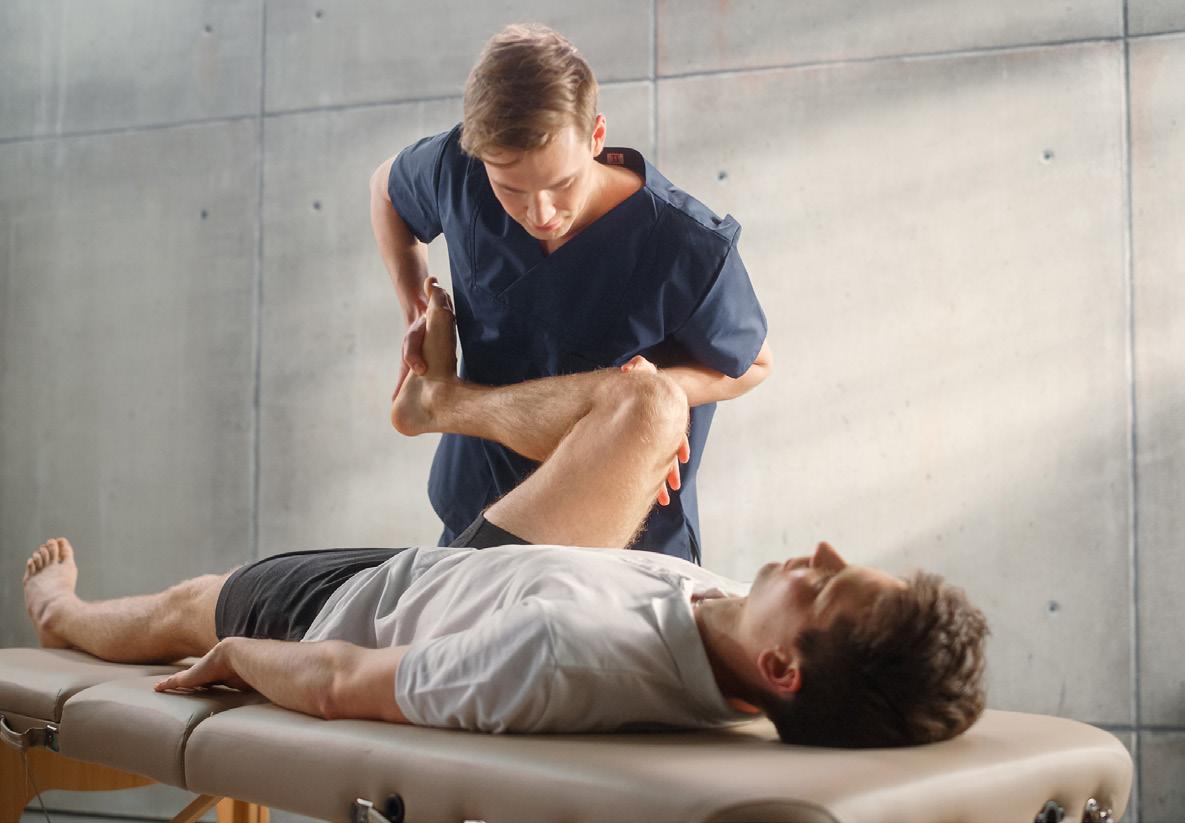
SOURCE 1 Muscle soreness can result in greater strength, if recovery is adequate.
Why fatigue and recovery are important
The human body has self-healing mechanisms in place that respond to all kinds of stress. However, when the body heals, it doesn’t just return to its previous level of functioning; rather, it betters itself, putting mechanisms in place to prepare for a return of the initial stressor. As discussed throughout this module, this idea is known as physiological adaptation. When the athlete’s training load is appropriate, and they have adequate time to recover, the body doesn’t just compensate for the stress; it goes beyond that level.
For example, muscle soreness is the result of micro-tears forming when a muscle is placed under strain during physical activity. With adequate recovery, the muscles not only heal, they strengthen.
The phenomenon of stress being essential for physiological adaptation is best described by Hans Selye’s General Adaptation Syndrome (GAS) (1936).
The science behind fatigue and recovery
General Adaptation Syndrome (GAS) is a theory that explains how the body responds to stress. It states that the human body goes through three phases when placed under stress:
• the alarm phase
• the resistance phase
• the exhaustion phase.
The alarm phase takes place when the body first encounters physical stress (i.e. at the beginning of physical exercise). Acute physiological adaptations such as increased heart rate and increased respiratory rate occur during this phase. The body then attempts to draw on all its existing resources to cope with the stress and bring it back to a stable state during the resistance phase. If the body does not cope with the stress, and the athlete does not stop exercising at this point, they will enter the exhaustion phase. In this phase, the athlete is said to be experiencing a negative form of stress, known as distress. However, if the body copes with the stress during the resistance phase, this is referred to as the body being under positive stress, or eustress. When an athlete’s body is put under eustress, the athlete will experience chronic physiological adaptation once they cease exercising and recovery begins.
General Adaptation Syndrome (GAS) a theory that explains that the body responds to stress in three phases –alarm, resistance, exhaustion; it states that positive stress (eustress) results in chronic physiological adaptation and that negative stress (distress) results in exhaustion distress a bad form of stress that leads to injury, illness or exhaustion eustress a good form of stress that leads to physiological adaptation
1 The body is in a stable state.
2 Stress occurs, ‘shocking’ the body.
3 The body begins to cope with the stress (i.e. resist).
4 At this point, the athlete either stops and lets the positive adaption occur, or
5 The athlete doesn’t heed the warning and it spirals into exhaustion.
While the GAS model looks at a body’s responses during exercise, the fitness–fatigue model explains how a body’s response impacts how much recovery is needed before it is ready to train again in order to optimise physiological adaptation. The fitness–fatigue model explains that, while the body experiences fatigue during training, it simultaneously experiences fitness gains. According to this model it is important to allow the body time to recover, and the fatiguing effects to dissipate, in order to make these gains. It is generally recommended that the body is allowed approximately 48 hours of recovery time between
SOURCE 2 Good training programs manipulate training variables to keep the athlete out of the exhaustion (orange) phase of GAS. fitness–fatigue model a theory that explains that the body responds to every training session by experiencing a ‘fitness effect’ and a ‘fatigue effect’ simultaneously, and it is the relationship between the two that determines when an athlete will benefit from training again
training sessions to build on the fitness gains achieved in the previous training session. Source 3 shows that there are three zones for training. In the red zone (0–48 hours), the body is still experiencing fatigue and therefore training should not occur. In the green zone (48–72 hours), the body is highly prepared to train again, and in the orange zone (72+ hours), fitness gains have been lost and the window of opportunity for building on any fitness gains from the prior training session is closed.
Key:
= Detrimental impact (too fatigued to train)
= Optimal impact (optimal fitness gains)
= Low impact (fitness gains lost)
SOURCE 3 The fitness–fatigue model explains that for optimal physiological adaptation after high-intensity training, athletes should ensure enough time has been allowed for recovery before training again.
intra-session recovery the recovery that takes place within a single a training session (e.g. between sets) inter-session recovery the recovery that takes place in between one training session and another training session active recovery recovery through low-intensity movement that helps reduce heart rate passive recovery recovery where the body is inactive
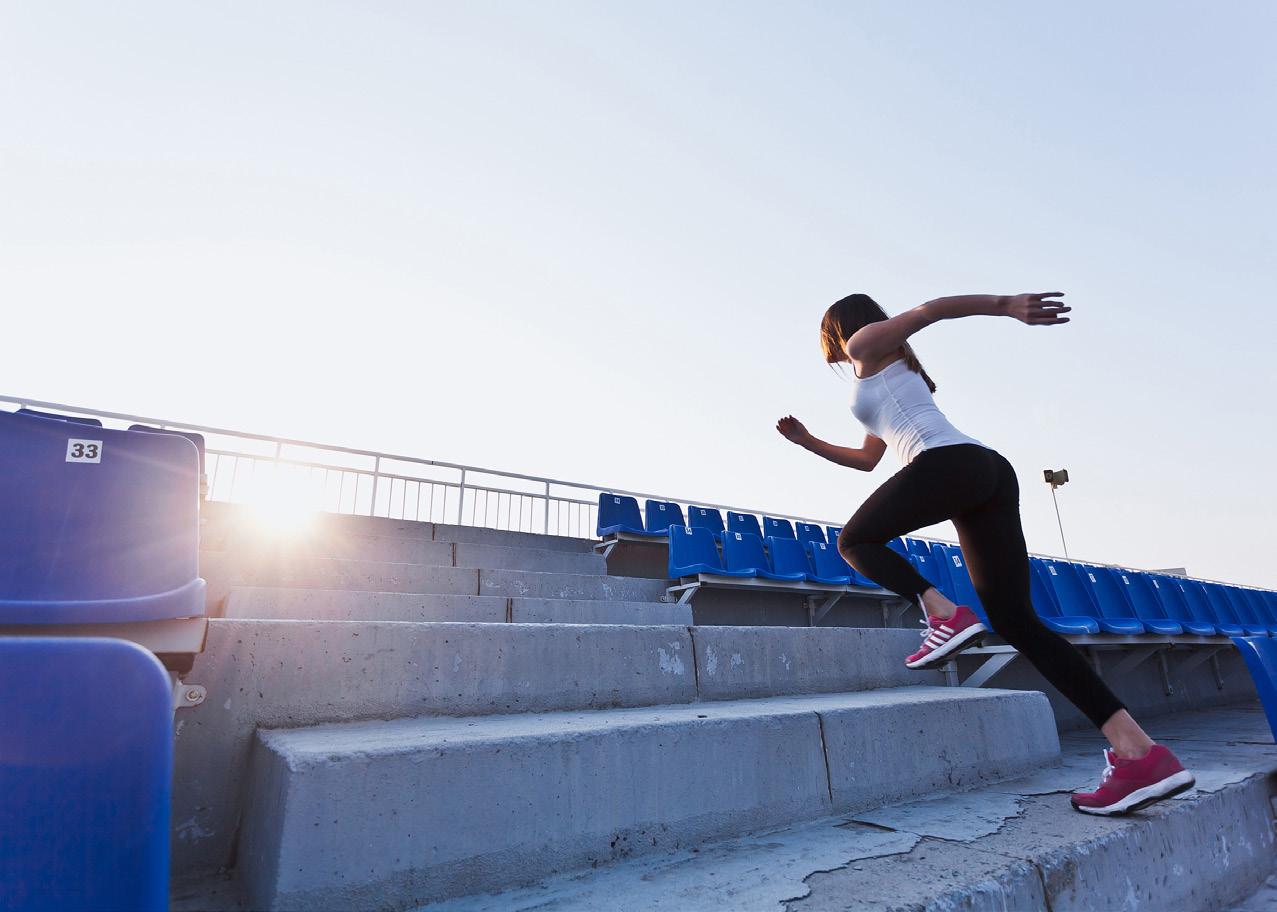
Methods of recovery
The term “recovery” can refer to two things:
• intra-session recovery – the recovery that takes place within a single training session (i.e. between sets of activities)
• inter-session recovery – the recovery that takes place in between sessions (i.e. from one session to the next).
Intra-session recovery
Most training methods involve a series of activities or intervals that aim to fatigue the athlete. Intra-session recovery (also known as immediate recovery) is the recovery that happens between these activities or intervals; after each repetition or set. Intra-session recovery between intervals is expressed within the work:rest (W:R) ratio. For example, if an athlete’s W:R is 1:3, then 1 minute of work would be followed by 3 minutes of recovery time. Intrasession recovery can also be expressed as a stated rest period between sets. For example, a training session might state that an athlete performs “3 sets of 4 intervals with 3 minutes recovery”. There are two ways that intra-session recovery can occur: active recovery and passive recovery.
Active recovery
Active recovery is the process of recovering while moving. It includes performing light tasks such as slow running, walking and stretching. In general, after an all-out exhaustive effort, an active recovery is recommended to restore ATP–PC stores and to remove lactic acid by continuing to send oxygen to the working muscles. In most cases, active recovery is more beneficial than rest recovery due to its ability to quickly remove lactic acid from the muscles.
Passive recovery
Passive recovery is a period of no movement. It is sometimes employed during sessions where an athlete has to complete many high-intensity repetitions of short duration. For example, a sprinter performing six repetitions of a 60-metre sprint at 100 per cent intensity would typically use a passive recovery between each repetition.
Whether using active or passive recovery, it is recommended that athletes monitor their fatigue by considering their RPE at the end of each set and adjusting their intensity and work volume accordingly. For example, if the aim of a particular set is for an athlete to work at 70 per cent but they score themselves a 9 on the RPE scale, then they should reduce the intensity and/or work volume.
Inter-session recovery
Inter-session recovery refers to the rest that must take place between one session and the next. After any fatiguing session or competition, the time required to fully restore the body to as close to its pre-exercise state as possible will depend on the type, intensity and duration of the activity, recovery techniques and the athlete’s accumulated oxygen debt. Source 4 shows how recovery times can vary for different physiological functions. It is recommended that athletes use the Rating of Fatigue (ROF) scale (see Lesson 4.22 Developing a training program (page 288), and download GPAI 13) along with the preparedness flowchart (see Lesson 4.24 Developing a training session plan, page 300) at the end of every training session to assist them to make decisions about how much recovery they need between sessions, so they can train in the green zone (as per the fitness–fatigue model).
Game Performance Assessment Instrument 13 (GPAI 13)
Restoration of ATP–PC Not recommended PC stores mostly restored by 2–3 minutes
Replenishment of muscle glycogen 10 hours (continuous
SOURCE 4 Recovery times vary for different physiological functions.
For the record!
For the record!
It could be argued that a key contributor to the success of the New Zealand All Blacks is their approach to recovery. They do not consider the end-of-game siren the finish of the game. Rather, the game is truly finished when they get changed out of their playing gear. In other words, they take their post-game recovery routine very seriously.

The elliptical machines you commonly find in gyms were invented so that fatigued or injured runners could do the closest thing to running, without actually having to run and bear weight. These machines are often used as a means of active recovery, particularly during gym-based circuits.
SOURCE 5 Elliptical machines are often used as a means of active recovery in gym-based circuits.
Check your learning 4.20
Check your learning 4.20
Retrieval and comprehension
1 Choose the correct answer.
Identify the body systems that are recovering when heart rates return to a resting level and when the muscles have removed waste and “refuelled” after exercise.
A muscular system and circulatory system
B muscular system and respiratory system
C circulatory system and respiratory system
D nervous system and endocrine system
2 Choose the correct answer. Identify how unloading can occur.
A through reducing work volume (the combination of frequency and duration) and repetitions
B through reducing training time cyclically across each calendar year
C through reducing work volume (the combination of frequency and duration) and reducing intensity
D through increasing recovery time between sets and reps
3 Explain what is meant by the terms “loading” and “unloading”.
4 Define the term “eustress” in the context of training.
5 Describe the relationship between fitness and fatigue in the fitness–fatigue model.
Analytical processes
6 Compare and contrast the General Adaptation Syndrome and the fitness–fatigue model.
7 Differentiate between active and passive recovery.
8 Review the Rating of Fatigue (ROF) scale in GPAI 13. Determine how it can assist an athlete when training.
9 Reflect on the different ways in which an athlete might determine when they are in the “green zone” in training. Present your thoughts as a list.
Game Performance Assessment Instrument 13 (GPAI 13)
Knowledge utilisation
10 Justify why an applied knowledge of the General Adaptation Syndrome and the fitness–fatigue model can help you make decisions about the frequency of your training. Present your answer in one or two paragraphs.
11 The secondary data in Source 6 shows the difference between the post-exercise blood lactate removal that is achieved by passive and active recovery. In 150 words, discuss why this occurs, conducting additional research where necessary.
SOURCE 6 Recovery and blood lactate levels
Lesson 4.21
The theory of periodisation
Key ideas
→ The process of breaking down a training program into smaller and smaller blocks so that energy, fitness and skill can be built over time is called periodisation.
→ The annual plan is a term used to describe an athlete’s planning over a 12-month period.
→ An annual plan can consist of one or more macrocycles. “Macrocycle” is a term used to describe the time from when an athlete starts to train for a season or event, to the completion of their post-season or post-event recovery.
→ Each macrocycle is divided into four training phases, each with its own goals for energy and fitness development.
→ The preparatory phase is when the athlete focuses on increasing their general level of fitness.
→ The pre-competition phase is when the athlete focuses on optimising their energy, fitness and skill levels for their specific sport, position and/or event.
→ The competition phase is when the athlete focuses on maintaining their energy, fitness and skill levels for their specific sport, position and/or event and maximising their performance in authentic game or performance environments.
→ The transition phase is when the athlete focuses on rest and recovery from the physical and mental stress of training and competition.
→ Each training phase is divided into a series of 4- to 6-week blocks known as mesocycles.
→ Mesocycles can be divided into shorter blocks, usually 7 to 10 days in length, called microcycles.
→ Each microcycle consists of around three training sessions.
→ A training session has three phases: the warm-up phase (which should apply the RAMP warm-up), the conditioning phase and the cool-down phase.
Defining periodisation
Athletes who take their energy and fitness goals seriously usually write training programs, often on a year-by-year basis. These programs ensure that athletes can train with purpose and structure, as they help guide the decisions made over a long period of time. Just like when a builder takes the design plan for a home and builds one section at a time, an athlete takes the training program and divides it into smaller blocks of time to achieve specific energy and fitness goals. This process of breaking the training program down into smaller and smaller blocks so that energy, fitness and skill can be built over time is called periodisation. The building blocks of a training program include:
• annual plans
• macrocycles
• training phases
• mesocycles
• microcycles
• training sessions.
We will now discuss these building blocks in more detail.
Learning intentions and success criteria
Additional resource: Annual plan template
Annual plans
The starting point when building a training program is to develop an annual plan. This term is used to describe an athlete’s planning over a 12-month period. Annual plans can be very helpful because they allow the athlete and their coach to:
• see how competitions are spread across the year (for one or more sports)
• determine when they need to start and finish training for each sport, allowing them to identify any overlaps
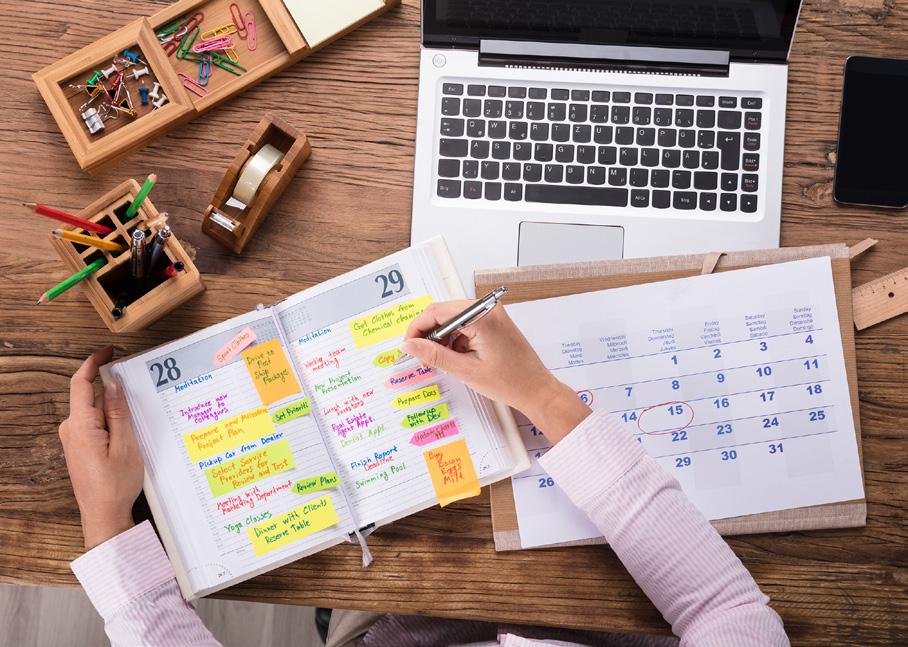
SOURCE 1 To help athletes achieve their energy and fitness goals, annual plans are broken down into smaller blocks of time. This process is called periodisation.
• determine times in the year when a particular sport must take priority over all others
• identify times in the year when they will need to pay special attention to avoiding excessive fatigue and injury.
Training phases
Mesocycles (4–6 weeks)
Microcycles (7–10 days)
Training sessions
SOURCE 2 An annual plan is broken into smaller parts. Firstly, the plan is divided into macrocycles; one for each sport (or season). Each macrocycle is then divided into the four training phases. Each phase is divided into mesocycles, microcycles and individual training sessions. This picture shows part of an annual plan. A template of a full annual plan is available for download.
Macrocycles
Annual plans can consist of one or more macrocycles. “Macrocycle” is a term used to describe the period of time from when an athlete starts to train for a season or event, to the completion of their post-season or post-event recovery. Athletes who train over one long season, such as Australian football players working towards a grand final, will only have one macrocycle in their annual plan. Athletes who compete regularly throughout the year, such as a marathon runner with a number of international races, will need more than one macrocycle in their annual plan to ensure that they are at the top of their game at competition time and have sufficient time to recover after each race.

Athletes who compete in multiple sports, each with its own season, will also have more than one macrocycle in their annual plan. Let’s look at an example of such an athlete, who we will call Alex. Alex is both a track runner and a rugby player. In order to optimise his performance in both of
SOURCE 3 Typically, senior PE students participate in multiple sports across the year. Some students, who compete in multiple sports, will need more than one macrocycle to be in optimal physical condition for these different sports.
these sports, his annual plan consists of two macrocycles; one for track and one for rugby. To ensure that he stays fit during the off-season, Alex might have a third macrocycle for participation in social sports; however, this third macrocycle would not always be formally planned. See Source 5 for an example of what Alex’s annual plan might look like.
Training phases
After establishing the structure and length of an athlete’s macrocycle, the next step in the periodisation process is to divide each macrocycle into four training phases, each with its own goals for energy and fitness development. The four training phases in a macrocycle are:
• the preparatory phase – a set period of time during which an athlete focuses on increasing their general level of fitness (also known as the general preparation phase)
• the pre-competition phase – a set period of time during which an athlete focuses on optimising their energy, fitness and skill levels for their specific sport, position and/or event (also known as the specific preparation phase)
• the competition phase – a set period of time during which an athlete focuses on maintaining their energy, fitness and skill levels for their specific sport, position and/or event and maximising their performance in authentic game or performance environments (also known as the in-season maintenance phase)
• the transition phase – a set period of time during which an athlete focuses on rest and recovery from the physical and mental stress of training and competition (also known as the off-season or post-season phase).
Subtle and important differences in training exist in each of these phases. From one phase to the next, the work volume, training intensity and skill work are adjusted to target specific energy, fitness and skill needs. From the moment an athlete begins training to the moment they finish their last competition, the general rule is that work volume of training should decrease while intensity increases. This opposite relationship between work volume and intensity (also called an inversely proportional relationship) applies to all physical activities. Precisely how and why you adjust work volume and intensity will be explained later in this module. For now, we will look at the general features of each phase of training.
The preparatory phase
The preparatory phase is a set period of time dedicated to increasing the athlete’s general level of fitness. More specifically, when training within the preparatory phase, athletes should aim to:
• build a base level of aerobic fitness
• build general strength
• increase flexibility
• rehabilitate from injury
• prevent excessive weight gain
• recuperate physically and mentally.
The preparatory phase typically involves loading the athlete by training them at higher work volumes (i.e. long, frequent training sessions) at a lower intensity. Regardless of the sport, variety is the key to training within the preparatory phase in order to keep the athlete motivated. Aerobic activities typically performed during the preparatory phase include running, cycling, swimming, boxing and cross training.
preparatory phase a set period of time within a macrocycle dedicated to increasing the athlete’s general level of fitness pre-competition phase a set period of time within a macrocycle dedicated to optimising the athlete’s position or event-specific energy, fitness and skill levels competition phase a set period of time within a macrocycle dedicated to maintaining and optimising an athlete’s energy, fitness and skill levels to enable them to compete transition phase a set period of time within a macrocycle dedicated to giving the athlete a physical and mental rest from energy and fitness training
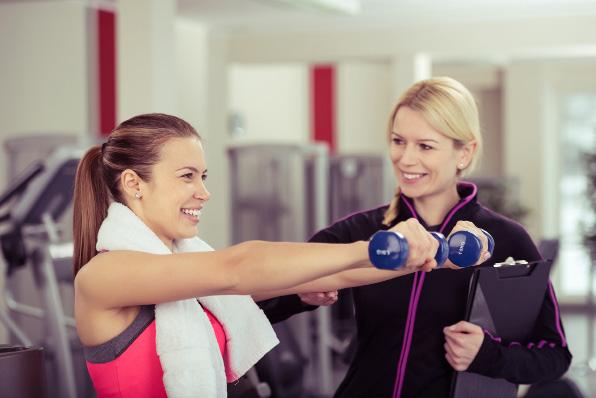
SOURCE 4 Rehabilitation from injury can be one of the key focuses in the preparatory phase of training.
In the preparatory phase, almost all training is run by a strength and conditioning coach. The skills coach plays a supporting role only as there are very few, if any, game-specific drills and skills practised in this phase. For example, Alex might spend the preparatory phase of his rugby season going for long runs or swims but keep his rugby-specific training to a minimum.
SOURCE 5 This annual plan shows multiple training phases for an athlete like Alex, who competes in multiple sports. Note that annual plans sometimes involve an overlap from one macrocycle to the next. For example, Alex might commence preparatory phase training for athletics towards the end of his rugby macrocycle.
Larger versions of the annual plans are available for download.
Additional resource: Sample annual plans
The pre-competition phase
The pre-competition phase is a set period of time dedicated to optimising the athlete’s position- or event-specific energy, fitness and skill levels. During the pre-competition phase, the athlete moves from general training to training of a game-specific nature. The art and science of periodisation is more apparent now, because the athlete’s training must increase in intensity, in increments, while the work volume drops off. There is also an increased emphasis on skill during this phase.
If the preparatory phase was effective, the athlete should come into the pre-competition phase adequately prepared for their sport – for example, at ideal weight, with ideal muscle mass and with a high aerobic capacity (for aerobic-based physical activities). Consequently, they can now begin to adapt speed and power. They can also start engaging in skill work that develops muscular endurance.
SOURCE 6 A marathon runner with four competitions per year might need to have four macrocycles in her annual plan.
SOURCE 7 An Australian football player’s annual plan will consist of one macrocycle, with the athlete aiming to maintain an optimal fitness and skill level across a long competition phase.
By the end of the pre-competition phase, the athlete should be in excellent physical condition, with a high degree of technical prowess, and be completely ready to compete. Alex might benefit from continuing his running during this phase, but he will also introduce rugby-specific skills such as on-the-ball and off-the-ball agility and acceleration/ deceleration activities. He will also need to increase his muscle mass by performing resistance work through a short hypertrophy (muscle growth) phase, in order to be in the best possible physical shape for the start of the season.
A period of physical and mental rest; the athlete may play another sport socially Preparatory phase Pre-competition phase
phase
Work volume Intensity Baseline level of fitness
phase
SOURCE 8 For an athlete to reach peak fitness by the end of the competition phase, the work volume should progressively decrease and intensity should increase.
The competition phase
If a team or athlete has periodised correctly, they should begin the competition phase in prime physical form. Their job now is to maintain this level of conditioning. The competition phase still requires progressive overload; however, the athlete must factor the physical and mental stress of competing into their training plan, carefully manipulating training work volume and intensity to ensure that a perfect balance is found between keeping their optimal fitness level (i.e. not losing any of their gains from the preceding months) and being fresh for each match or event. Intensity of energy, fitness and skill training is high during this phase, but the work volume should be low. Because of the demands of competition, it is critical that athletes allow their bodies ample time to return to a pre-exercise state and repair after each match or event.
During the competition phase, the skill and strategy coach will run most of the training sessions. The strength and conditioning coach will now step back to run warm-ups, provide top-up conditioning when the break between matches/events is too long and supervise resistance training. Strength and conditioning coaches who work with professional teams spend much of their time within the competition phase rehabilitating injured players, to speed up their return to play.
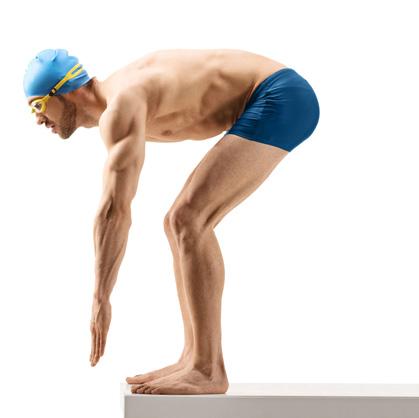
SOURCE 9
Periodisation ensures athletes are in prime physical form in the competition phase.
peak an optimal state of athletic readiness aimed at the highest possible performance
For Alex, during his rugby season, the competition phase is when all his practice and training gets tested in the field. If he is a regular player in the line-up, he will keep his weekly training sessions short and at high intensity, but with sufficient time to recover before game day. If he is benched, he might need to add an extra training session during the week to maintain his level of conditioning. In other words, he needs to stay as close as possible to his peak performance level throughout this phase.
For some professional athletes, their training load is managed from week to week, enabling them to recover well during the week but still perform on game day. This individual load management within the competition phase is something that enabled Brisbane Lions player Dayne Zorko in 2024 to become the oldest ever All-Australian player in history, at 35 years old and in his 14th season at the elite level.
Peaking
A peak is an optimal state of athletic readiness aimed at the highest possible performance. An athlete’s peak is a temporary state that occurs when the athlete’s psychological and physical capacities, and technical and tactical preparation, are optimal. An athlete’s peak is characterised by:
• good health
• an ability to cope with training workloads and stress
• quick recovery
• extreme efficiency at producing energy for performance
• excellent technique and strategic awareness
• self-confidence
• high motivation and aspirations.
A well-constructed training program should see athletes reach peak physical and psychological performance at the critical stages of competition. Some athletes’ journey to peak performance takes place over a long period of time. For example, an elite swimmer might plan their training so that they peak two years down the track, in time for the 200-metre final at the Olympic Games.
Tapering
To achieve peak performance in major competitions, many athletes reduce aspects of their training, notably the work volume, in the weeks leading up to the event. This is known as the "taper period" or tapering. Tapering allows the body and mind to have a break from vigorous physical exertion, and provides an opportunity to heal injuries and recharge energy reserves. It also allows the body to increase muscle glycogen stores in preparation for a match or competition. To help build energy stores, tapering should be accompanied by rest and good nutrition, including a high-carbohydrate diet.
The time to begin tapering varies from sport to sport, with a taper period of approximately seven to 10 days being appropriate for most sports. Note that speed, endurance, strength and power cannot be improved within three days of a match and that any training session held in the 36 hours before competition needs to be brief and intense, so as not to significantly deplete glycogen reserves.
Because of the lighter work volume during the tapering period, athletes typically experience a physical freshness that allows for improvements in their performance – for example, they may be able to lift more weights, run a little faster or generate more power. They must, however, be cautious to monitor their dietary intake during this time because they are not burning the usual levels of energy. If they continue to consume the same amount of food despite reducing their training load, they run the risk of gaining excess weight.
Theory in action How the Australian swim team was rewarded by changing their periodisation model
In the lead-up to the 2016 Rio Olympic Games, the Australian swim team held their Olympic trials nine weeks out from the games. This meant that the selected swimmers had to maintain peak condition for two months, and the timing backfired. For the most part, despite a few success stories (such as Mack Horton and Kyle Chalmers), the Australian team failed to deliver. This prompted Jacco Verhaeren, head coach of the Australian swim team, to make sweeping changes to the timing of the selection process for major events. He modelled the Australian program on that of the ever-successful American team, who hold their team selections as little as two weeks out from a major event. The result was overwhelmingly positive, evidenced by the record haul of 28 gold medals by the Australian team at the 2018 Gold Coast Commonwealth Games. Many swimmers posted personal best results.
The transition phase
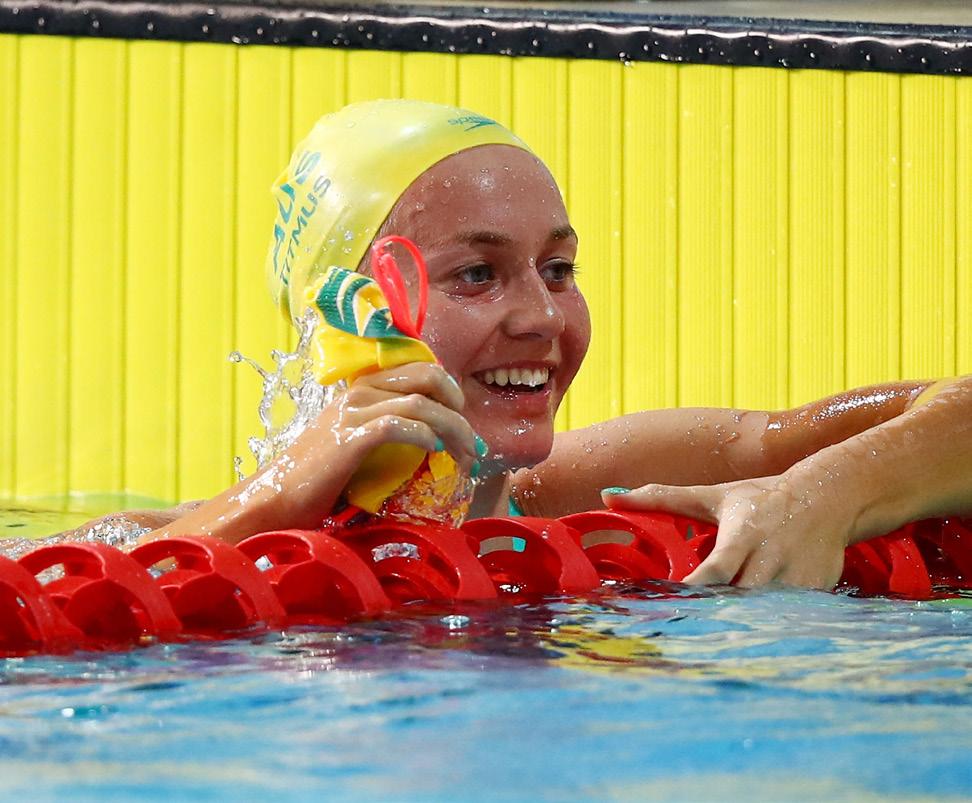
SOURCE 10 Under a new periodisation model, the Australian swim team secured a record haul of 28 gold medals at the 2018 Commonwealth Games. Queenslander Ariarne Titmus contributed three of those gold medals.
The transition phase is a set period of time dedicated to giving the athlete a physical and mental rest from energy and fitness training. It occurs after the competition phase has ended. This break from training can involve the athlete stepping away for complete rest and relaxation or playing a different sport.
This is particularly important for children and adolescents, as specialising and overtraining from too young an age can lead to demotivation or burnout. Many coaches of adolescents engaging in individual sports will suggest they play a team sport during the transition phase, as adolescence is a time when social needs and conformity are high. Without this, the athlete may feel isolated, which can also reduce the chances of them continuing in their chosen sport.
If the athlete plays a sport socially during the transition phase, it is crucial that their game/ training load occurs at a low intensity to give them sufficient time to recover. The overall focus of this phase should be on enjoyment, not performance.
Mesocycles
So far we have learnt that annual plans are made up of one or more macrocycles. A macrocycle is, in turn, made up of four distinct training phases: the preparatory phase, the pre-competition phase, the competition phase and the transition phase. These training phases can be further divided into a series of 4- to 6-week blocks known as mesocycles. This allows athletes to work towards the general goals of each training phase (e.g. increasing basic fitness in the preparatory phase, focusing on specific game-related fitness work in the precompetition phase) through a series of smaller goals over a specific period of time.
specialising concentrating on, and becoming good at, one physical activity only overtraining training excessively
For the record!
Some National Rugby League (NRL) clubs impose a "no footballs (or limited footballs) until January" rule. This is designed to break up the vast amount of ball work required of NRL players, preventing physical and mental fatigue.
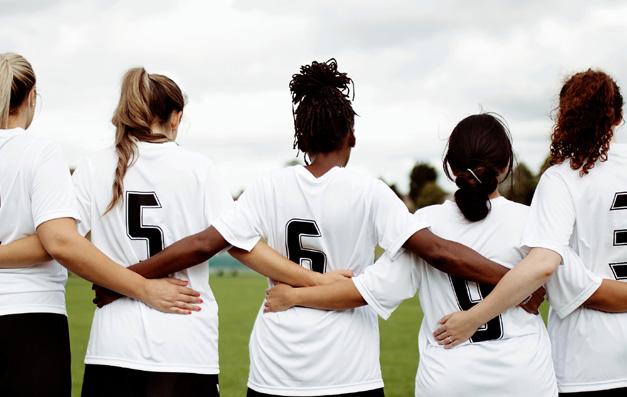
SOURCE 11 Playing a team sport during the transition phase can provide much needed social support for an athlete who is engaged in an individual sport as their main physical activity.
Each mesocycle should aim to develop:
• a predominant energy system (e.g. the ATP–PC system)
• a set of specialised movement sequences to improve a particular movement strategy (e.g. outside shooting in basketball for the movement strategy of advancing team play and scoring)
• one or more fitness components (e.g. power and strength).
If we look at Alex’s competition phase for his rugby macrocycle (see Source 5), we can see that this period runs for approximately 12 weeks, from the beginning of June until the beginning of September. This means that Alex can fit two 6-week mesocycles into his competition phase. In these two mesocycles, Alex can target more specific goals. As you will recall, the competition phase is about maintaining a high level of conditioning. To achieve this, Alex’s coach might set the following competition phase mesocycle plan:
• mesocycle 1: major focus – strength; minor focus – power
• mesocycle 2: major focus – power; minor focus – strength.
It is important to note that training phases may sometimes be composed of one mesocycle only. This is particularly true for short macrocycles and shorter training phases.
Microcycles
warm-up phase a period, or act, of preparation for a match, performance or exercise session, involving gentle exercise or practice
RAMP protocol a specific warm-up technique aimed at: raising body temperature, heart rate, respiration rate and joint viscosity; activating and mobilising key muscle groups, joints and range of motion; and preparing for exercise by incorporating dynamic stretching conditioning phase a section within a training session devoted to targeting specific energy, fitness and skill objectives; the main part of a training session cool-down phase a period of low to moderate physical activity (e.g. walking or jogging) conducted after vigorous exercise in order to reduce the chance of injury
Mesocycles can be further divided into shorter blocks called microcycles. Microcycles are usually 7–10 days in length. This shorter period allows athletes to work towards the general training objectives of each mesocycle (e.g. improving strength while enhancing power, or mastering a defensive strategy in the pre-competition phase) in individual training sessions.
To achieve the larger goals of the mesocycle, the microcycle will need to state detailed information, such as:
• the type of training to be completed (i.e. training method/s)
• how many times per week training should occur (i.e. the frequency)
• how hard the training should be (i.e. the intensity)
• how long training sessions should last (i.e. the duration).
In Lesson 4.22 Developing a training program (page 288), we will discuss the development of microcycles in more detail.
Training sessions
A training session is the smallest building block in the periodisation model. A training session is a short period of time within a day (e.g. 1 hour) that is devoted to energy, fitness and skill training. Every training session should include three phases:
• a warm-up phase (using the RAMP protocol)
• a conditioning phase that outlines the activities performed and training load (e.g. specialised movement sequences, fitness components, training methods used, repetitions, work volume, intensity, W:R and sets) while following the relevant principles of training
• a cool-down phase to gradually return the body to a resting state.
The warm-up phase
When designing a warm-up, the RAMP protocol should be applied (see Lesson 4.24 Developing a training session plan, page 300) to ensure that the movements used in the warm-up reflect the movements the athlete’s body will experience during the conditioning phase of the session.
The conditioning phase
The conditioning phase of the training session is sometimes referred to as the main part of the training session; where the major energy, fitness and skill training goals for the session are achieved. Activities conducted during the conditioning phase can involve:
• energy and fitness work only – the training does not have an explicit focus on skills (e.g. a soccer player doing energy and fitness work might not use a ball)
• skill and strategy work only – the activities are selected purely on the basis of their ability to facilitate skill and strategy work
• combined energy, fitness and skill work – the activities are designed to target specific energy and fitness needs while incorporating skill and strategy.
Sometimes, a conditioning phase might begin with an energy and fitness focus and conclude with a skill and strategy focus; while other times, the order is reversed. The general rule is that skill and strategy work should occur first, when the athlete is not fatigued. However, if a game analysis reveals that a drop in skill performance correlates with fatigue, then it might be preferable to perform skill and strategy work last, to address this weakness.
Every conditioning phase must meet the energy and fitness intentions of the training phase wherein it sits – for example, if the training phase is preparatory, the intentions of the training session will need to meet more general fitness goals (such as to build muscle or lose weight) than if the training session was held during the competition phase, where the goal is to maintain the conditioning that took place in the preparatory and pre-competition phases.
The conditioning phase of a training session should always follow the relevant principles of training and specify:
• the fitness components being developed
• the training methods being used
• the intensity and work volume
• the work:rest (W:R) ratio
• the number of repetitions.
The cool-down phase
The cool-down phase is the period of activity at the end of a training session that aims to:
• reduce the athlete’s heart rate, respiration rate and body temperature
• allow the oxygenated blood to flush out the waste products that form during activity
• relax the muscles
• begin to rebuild the energy stores required for the next performance.
A typical cool-down might involve light jogging or movement followed by a period of static or dynamic stretching that enables working muscles to be stretched to their original length, thereby reducing muscle soreness and aiding recovery.
Putting it all together
At this stage of the module it is important to understand the relationship between an annual plan, macrocycles, training phases, mesocycles, microcycles and training sessions, and how the duration of the various cycles can differ depending on the athlete’s physical activity and performance level.
Source 12 shows an example of an annual plan for a Physical Education student participating in multiple sports, with the relationship between all parts in the plan illustrated. An editable version of Source 12 is available for download.
Additional resource: Annual plan template
For the record!
In the past, it was common for athletes to finish their warm-ups with static stretching. However, this practice is now discouraged as static stretching sends messages that tell the brain: "It’s time to relax and repair now." Performing static stretching before a game or event can decrease your power by as much as 30 to 40 per cent. Static stretching should only be used during the cool-down or to increase range of movement during a flexibility stretching session.
SOURCE 12 This example provides a closer look at the relationship between the various cycles within a full annual plan, including three macrocycles, nine training phases, 12 mesocycles and 52 microcycles.
Check your learning 4.21
Check your learning 4.21
Retrieval and comprehension
1 Choose the correct answer.
Identify the phases of an annual training plan.
A pre-season, training, competition, recovery and review
B preparatory, pre-competition, competition, transition
C annual plan, macrocycle, mesocycle, microcycle
D annual plan, macrocycle, microcycle, training session
2 Choose the correct answer.
Recall the phases of a training session.
A warm-up, conditioning, cool-down
B warm-up, skills, cool-down
C warm-up, skills, conditioning, cool-down
D warm-up, skills, team drills, recovery
3 Define the terms "annual plan", "macrocycle", "training phase", "mesocycle", "microcycle" and "training session".
4 Describe the main aims for each phase of training.
5 Explain the roles of the following coaches in the competition phase: a strength and conditioning coach b skills coach.
Analyse and apply
6 Determine which level of periodisation the examples below fit into (e.g. annual plan, macrocycle, mesocycle, microcycle or training session).
a 1 hour of plyometric work
b an Australian football team’s training plan for the year
The annual plan
Muscular
Macrocycle 1
c 4 weeks of training
d a 2-year block in preparation for the Commonwealth Games
e 1 week of training
f a 3-month training program for a school student’s winter sport
7 Organise the following training aims into their correct training phase(s):
a Athlete should be at the ideal weight and musculature.
b Athlete should be in excellent physical condition.
c For the first time, work volume is lower than the intensity of training.
d Athlete recuperates mentally and physically.
e Emphasis is now largely on skill and strategy.
f Athlete takes a break altogether or plays a different sport.
g Athlete aims to maintain level of physical conditioning.
h Athlete begins to adapt speed and power.
i Work volume must be low.
j Athlete aims to prevent unnecessary weight gain.
8 Predict problems that might occur if an athlete doesn’t systematically work through the four training phases in a macrocycle.
Evaluate and justify
9 Create an illustration, diagram or chart to explore the difference between annual plans, macrocycles, training phases, mesocycles, microcycles and training sessions. Include examples relevant to your choice of sport or physical activity.
10 A futsal player records the following journal entry after a training session. Assess their primary data and determine which training phase they are most likely working within.
My training journal
Date: 29th of March Venue: Beach
Today we did a long beach run. The intensity wasn’t high but I ran 10 kilometres. It was pretty gruelling in the heat. I don’t really love these sorts of training sessions, but I know I have to build up my aerobic capacity over the coming months, so I need to grin and bear it. I can’t wait until we can start doing some actual ball work!
11 Refer to Source 6. Predict what would happen to a marathon runner’s overall performance if they were to follow one macrocycle, like the Australian football player, whose periodisation pattern is shown in Source 7.
12 Assess the usability of a single macrocycle for your senior Physical Education needs (e.g. from January to November of Year 12). Use data to justify why it might, or might not, be suitable.
Lesson 4.22
Developing a training program
Key ideas
Learning intentions and success criteria
training objectives the specific energy, fitness and skill outcomes that athletes aim to achieve through training
For the record!
Throughout the next few lessons, several templates will be referred to. These can all be found on Oxford Digital and can be customised to suit your needs.
→ A game analysis allows an athlete to study the demands on movement patterns, energy, fitness and skills, as well as strategy and tactics, and to recognise areas where they should focus their attention in order to improve their overall performance.
→ Training objectives are the specific energy, fitness and skill goals that athletes aim to achieve through the implementation of their training program.
Introduction
Now that we have discussed the theoretical concepts of energy, fitness and training, it is time to learn how athletes apply these to the development of training programs. As your training strategy will need to show an understanding of periodisation, a knowledge of training program design is important. There are three important steps that need to be taken in the development of a training program to ensure an athlete is adequately prepared for their performance:
1 Conduct a game analysis – athletes analyse the physical activity to determine fitness, energy and movement requirements, and assess their ability to meet those requirements.
2 Identify specific training objectives – athletes determine the fitness and skill-based aims of the training program.
3 Compile a training program – applying periodisation, athletes determine how the set time will be divided into phases and cycles to ensure the work volume and intensity is ideal, according to their schedule of competitions or events.
We will now discuss each of these steps in more detail.
1 Conduct a game analysis
A game analysis allows the objective study of movement patterns, energy and fitness demands, and skills, strategy and tactics. The data gathered during game analysis can support the improvement of both individuals and teams. Ultimately, the aim of a game analysis is to gather a set of data that can be analysed and evaluated so that athletes can make decisions about how to develop or modify training strategies to improve their performance. Source 1 outlines what the data collected during a game analysis should reveal.
What a game analysis should reveal about the game
• Game-related energy, fitness, skill and strategy needs
• Position- or event-related energy, fitness, skill and strategy needs, including the frequency, direction and intensity of movements
• The energy, fitness and skill needs for specialised movement sequences (for different movement strategies)
What a game analysis should reveal about the performer
An individual’s energy, fitness and skill-based performance in a specific:
• position
• event
• set of specialised movement sequences for a movement strategy
SOURCE 1 The data gathered during a game analysis should reveal information about both the game and the performer.
There are three components to consider in a thorough game analysis. These are:
• primary data collection – this can be done through observation of, and participation in, the physical activity. A GPAI can be created and used to record position- or eventspecific information such as necessary skills and movement strategies and the frequency, duration and intensity of movement. It can also record athlete-specific information such as work:rest (W:R) ratios, heart rate and rate of perceived exertion. A list of tools to facilitate the collection of primary data is shown in Source 2
• secondary data collection – this provides a general overview of the movement, energy and fitness requirements of a physical activity and can be collected from online or printed publications. While this information can be a good starting point for a game analysis, it is important to be discerning about the validity of the data gathered from secondary sources, particularly when looking to apply it to an individual with their own unique requirements. To increase the validity of data, it is helpful to seek information about performers of similar age, gender and ability as the person for whom the game analysis is being conducted
• primary and secondary data analysis – this is performed once data has been collected. This analysis determines an athlete’s specific performance requirements and training needs; information that is then used to set training objectives for the training program.
Study tip
Lesson 4.23 Skill drill: Conduct a game analysis (page 296) has been designed to help you conduct a game analysis. It is highly recommended that you watch the video provided, which walks you through the method for completing this task. Conducting a game analysis is time-consuming, so it is critical that you are well prepared and understand exactly what it is that you need to do and how much time you can allocate to gathering the different data.
Video tutorial: Developing a training program
Rating of perceived exertion (RPE) scale A scale used to give performers a rating of exertion on a scale from 1 to 10
Rate of fatigue (ROF) scale A scale designed to give a fatigue rating after a complete session on a scale from 1 to 10
Rating of session effectiveness GPAI A difficulty of training scale from 1 to 5
Heart rate (HR) monitor A watch (with or without chest strap) that digitally measures heart rate
GPS tracker A device that tracks movement, including distances, speed and direction
To determine the impact of a training activity or session on fatigue at the time of performance
To determine the impact of an entire training session on an athlete’s fatigue, with a view to understanding when to next perform the same activity
To determine the impact of the training session on physiological adaptation
To monitor heart rate before, during and after exercise
To monitor and record movement data
Game Performance Assessment Instrument 12 (GPAI 12)
Game Performance Assessment Instrument 13 (GPAI 13)
Game Performance Assessment Instrument 14 (GPAI 14)
See the manufacturer’s instructions
See the manufacturer’s instructions
Game analysis summary GPAI
Frequency, direction and duration of movement GPAI
Specialised movement sequence GPAI
Reflective journal template
A template for recording qualitative and quantitative data
A template for recording quantitative data
A template for recording quantitative data
A template for recording qualitative data
To collect, collate and summarise data from a number of other GPAIs (i.e. a master document for game analysis)
To record data about an athlete’s frequency, direction and duration of movement
To record data about how effectively or ineffectively an athlete performs specialised movement sequences
To record qualitative information about training and performance
SOURCE 2 Some of the many tools available to gather primary data for a game analysis
Study tip
You should be gathering data about your performance in a specialised movement sequence and conducting game analyses on a regular basis. If too much time has passed since your last game analysis, you may wish to consider performing some of the tests in Lesson 4.4 Fitness requirements for physical activity (page 200) again.
Study tip
For this unit, you will be required to devise a personal training strategy to optimise personal performance of the specialised movement sequences for a selected movement strategy. Therefore, this will be a very specific training strategy, based on a good understanding of the movement strategy you wish to target and the related specialised movement sequences. Conducting a game analysis will be an important first step.
2 Identify specific training objectives
Game Performance Assessment Instrument 8 (GPAI 8)
Additional resource: Frequency, direction and duration of movement GPAI
Game Performance Assessment Instrument 11 (GPAI 11)
Additional resource: Reflective journal template
Training objectives are the specific energy, fitness and skill goals that athletes aim to achieve through the implementation of their training program. Training objectives are more specific than goals – for example, if an athlete’s goal is to become a better basketball player, one training objective might be: "To remain effective at performing rebounds in the second half of games by increasing muscular endurance."
Training objectives are closely linked to an athlete’s game analysis, as the game analysis has identified both the physical requirements of a physical activity (e.g. the need to accelerate fast out of the blocks in track) and the strengths and weaknesses of the athlete (e.g. the inability to keep the same amount of power throughout the race). For a training program to effectively prepare an athlete for competition, it is important that the training objectives target the areas where the game analysis has identified weaknesses.
Training objectives will differ depending on what training phase or cycle an athlete is in. This is because each training phase has a different purpose and recommends a different volume and intensity of work, as well as different skill-to-fitness ratios. Training objectives may also vary depending on the athlete’s injury or rehabilitation history.
As we have learnt, the preparatory phase recommends a high work volume at a low intensity. Fitness training should have a 50–100 per cent contribution to this training phase, with skill training having a 0–50 per cent contribution. As part of the assessment for this topic, you will be required to identify the phase of training that your devised program is designed to address. Ensure that you keep the following in mind.
• The pre-competition phase recommends a decreasing work volume at increasing intensity. Fitness training should have a 30–60 per cent contribution to this training phase, with skill training having a 40–70 per cent contribution.
• The competition phase recommends a low work volume at a high intensity. Fitness training should have a 0–30 per cent contribution to this training phase, with skill training having a 70–100 per cent contribution.
• The recovery phase recommends a low work volume at a low intensity. There is no specific suggestions for distribution of fitness and skills training in this phase. Training objectives are usually evaluated regularly to ensure they are still relevant – for example, an injury, change of playing grade or playing position, or unexpected fitness increases might mean that previous training objectives are no longer appropriate.
Source 4 shows the training objectives for a tennis player, set out over all the four training phases. As you can see, many of her training objectives change from one training phase to the next, to reflect the preferred split between work volume and intensity.
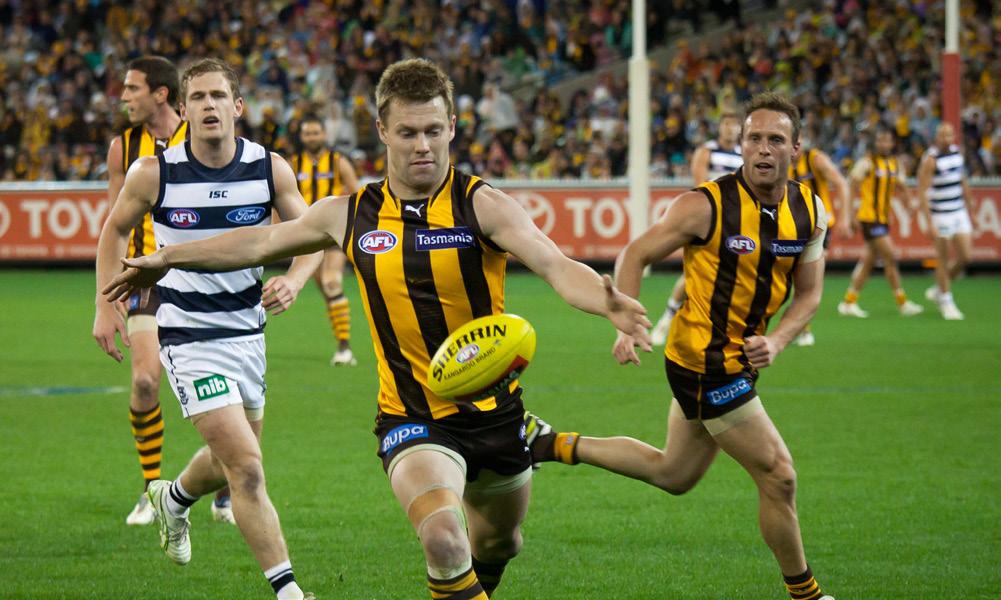
Note that once objectives have been set for a particular training phase, they will remain the same for each cycle within it, from the mesocycle to the microcycle, and right down to the individual training session. This is because the aspect of your performance that you wish to improve over the given training phase doesn’t change, only the level of detail you provide. In other words, as the blocks of time shorten, your plan must become more and more detailed.
Tennis season: Major training objectives
Movement strategy: Strategies for defending against attack and setting up attack
Specialised movement sequences: All baseline and net specialised movement sequences
Energy system/s: Aerobic and ATP–PC systems
Fitness components: Aerobic capacity, speed, agility and muscular endurance
Preparatory phase training objectives
Each mesocycle, microcycle and training session in this phase will focus on one, some or all of these objectives.
Movement strategies
None; general technique work only
Pre-competition phase training objectives
Each mesocycle, microcycle and training session in this phase will focus on one, some or all of these objectives.
Movement strategies
Build fitness to improve defence:
• move the opponent to the back court and create space in the front court through variations of ground strokes
• draw the opponent from the baseline to the front court to allow time to return to ready position (e.g. use drop shot)
• hit the ball from the attacker’s front court into the rear court of the opponent (e.g. use crosscourt forehand or backhand passing shot)
Specialised movement sequences
None; foundational movement skills only (e.g. footwork and positioning)
Specialised movement sequences
All baseline and net specialised movement sequences
Competition phase training objectives
Each mesocycle, microcycle and training session in this phase will focus on one, some or all of these objectives.
Movement strategies
Maintain fitness and improve attack:
• force the opponent to the baseline or to the corners of the court (e.g. use variations of ground strokes)
• control a rally and draw the opponent to a specific area on the court (e.g. use lob)
Transition phase training objectives
Each mesocycle, microcycle and training session in this phase will focus on one, some or all of these objectives.
Movement strategies
None
Specialised movement sequences
All baseline and net specialised movement sequences
Specialised movement sequences
None
SOURCE 3 Athletes, including Australian football players, require specific training objectives.
Energy system/s Aerobic system
Fitness components
A high work volume of aerobic capacity work at a low intensity
Tennis season: Major training objectives
Energy system/s Aerobic system
Fitness components
Increasing intensity while decreasing work volume focused on aerobic capacity, speed and muscular endurance
Energy system/s Aerobic system and ATP–PC system
Fitness components
Low work volume, highintensity work on aerobic capacity, speed, agility and muscular endurance with a lot of recovery time
Energy system/s Aerobic system
Fitness components
None; a complete rest from the sport or choose a different physical activity
SOURCE 4 This is an example of a tennis player’s training objectives per training phase. Notice that this player has used four categories for her objectives: movement strategies, specialised movement sequences, energy system/s and fitness components.
Study tip
When establishing training objectives, it is important to be organised and to record your training program from the broadest level down (i.e. starting from annual plan). A training program template is available to download. Once you have filled it out, you will be able to use your training program to help guide and justify your training strategy decisions, and you can refer to this document in your assessment.
Additional resource: Training program template
Once objectives have been set, the next step is to write the training program and/ or individual training sessions that address the objectives.
3 Compile a training program
Once a game analysis has been done and training objectives set, a training program – or annual plan – can be compiled. The training program is the master plan for an athlete’s training as they prepare for performance. As we have seen, a training program is usually presented as a detailed table that includes information about:
• macrocycles
• training phases
• mesocycles
• microcycles
• training sessions.
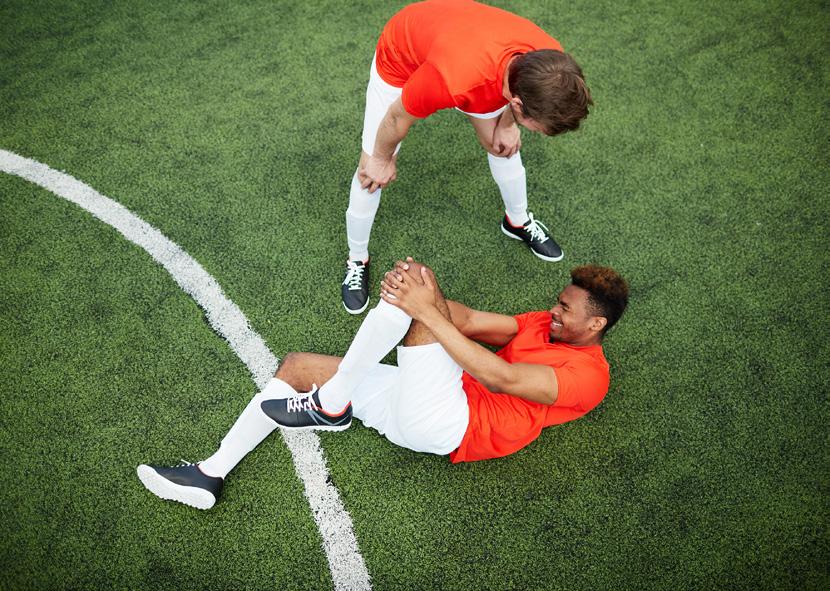
SOURCE 5 Your training objectives for any given training phase may need to change in response to unforeseen circumstances – for example, an injury might force you to reduce both your work volume and intensity.
loading–recovery pattern the relationship between loading and recovery, expressed as a ratio
It is important to note that the training program document is a planning document. The information included in the training program document is usually general in nature, with room for flexibility and modifications to the implementation of training sessions.
Macrocycles
The training program needs to show the length of the macrocycle and an estimated beginning and end date. Remember, depending on the type of sports the athlete is practising, their annual plan might consist of one or more macrocycles of varying length.
Training phases
Once the macrocycle has been established, the training program should show the length of the four training phases – the preparation phase, the pre-competition phase, the competition phase and the transition phase. The length of these will vary depending on the length of the
macrocycle and the training objectives of the individual athlete. For example, an athlete who already has a good baseline level of fitness may not need as much time in the preparatory phase as someone who does not.
Mesocycles
At the mesocycle level in training program development, you should include information about the length of the cycle, the training objectives and the loading–recovery pattern. The length of a mesocycle is affected by the length of the macrocycle that it sits in, but mesocycles are generally four to six weeks long.
Training objectives should be stated for each mesocycle and athletes should indicate whether the focus is on energy, fitness or skill, or all three. The loading–recovery pattern across a mesocycle should ensure that the difficulty level increases from one week to the next in the loading weeks, and that it allows time for the body to recover in the unloading weeks. The loading–recovery pattern is normally expressed as a ratio. For example, an athlete wishing to load for two weeks and recover every third week is said to be using a 2:1 loading–recovery pattern. A four-week mesocycle consisting of three increasingly difficult weeks followed by one easier week, as shown in Source 6 and Source 7, is said to use a 3:1 loading–recovery pattern, and so on.
SOURCE 6 This mesocycle uses a 3:1 loading–recovery pattern. The principle of progressive overload is evident in the increasing training load over weeks 1, 2 and 3. In week 4, the training load reduces significantly.
SOURCE 7 This mesocycle plan for the preparatory phase shows the four microcycles and their focus. In this case, the entire mesocycle is focused on developing aerobic capacity. This fitness objective is developed over the first three microcycles and maintained in the fourth.
Study tip
Presenting your loading–recovery pattern as a bar graph (as in in Source 6), makes planning easier. It is recommended that you do this in a separate training journal using different colours to map your planned relative contribution for work volume versus intensity across the mesocycle. This will allow you to visualise the difficulty of a week in relation to the one before and the one after. You should then transfer this information to your planner. When a week is harder than the one before it, place an "L" (for "loading") in the relevant cell. Alternatively, a "U" for "unloading" should be recorded to reflect recovery weeks.
Microcycles
At the microcycle level of a training program, the length of the microcycle and its training objective and loading information should all be stated. Microcycles are generally 7–10 days long and each microcycle should have a specific fitness and/or skill focus. Due to its limited duration, not all fitness objectives can be given the same focus within the microcycle. Instead, an athlete will select one or two fitness objectives (e.g. power or agility) as a primary focus for a microcycle, with the other fitness objectives taking a back seat. To show which objectives are in focus in any given microcycle, athletes can list them all and indicate whether each objective is being developed, maintained, improved, viewed as secondary or rested by adding a letter (i.e. D, M, S or R) next to it in the training program.
• Developed means that you will select appropriate training methods to achieve physiological adaptation by increasing work volume and/or intensity, as per the principle of progressive overload.
• M aintained means that this fitness component will not be the main focus of training but the adaptations that have already occurred in this component must not be lost.
• S econdary focus means that this fitness component is not deemed important for the sport you’re doing right now, but it may be trained as a side-effect of the component being developed or maintained.
• Rested means that a decision has been made to rest this component completely at this time. At the microcycle level, it is also important to indicate whether the week is to be a loading or an unloading week.
Training sessions
Study tip
When planning training sessions, it is important to determine how often to train. As a rule, athletes should aim to train on non-consecutive days, as per the fitness–fatigue model, which states that the fatigue effect from the most recent session is gone by around the 48to 72-hour mark. Thus, the number of training sessions considered "average" for a microcycle is three. However, if a training session involves low-intensity work, the fatigue effect will disappear sooner, meaning an athlete can train more frequently – sometimes four or five times per week. This information will be essential to remember for both your Internal assessment 3: Project –folio and your External assessment: Examination – combination response.
At the training session level of training program development, athletes need to include information about frequency, intensity and duration of training, as well as the training objectives for each training session. This will ensure that physiological adaptation is planned for and fatigue is managed. A seven-day microcycle should consist of three to five training sessions. Source 8 provides an example of how planning can look at the training session level. Note that this training session planner shows the intended training days, as well as the length of the session, the intended load (i.e. very high, high, moderate, low or very low) and the training objectives, showing the major fitness and skill focus for the sessions.
Training session (Y/N)
Length of session
Load (very high, high, moderate, low, very low)
Specific training objectives
Movement strategy
Specialised movement sequence Energy system/s
Fitness components
SOURCE 8 A training session planner can help to guide decisions around individual training session design.
Check your learning 4.22
Check your learning 4.22
Retrieval and comprehension
1 Choose the correct answer. Identify the correct definition for the term "training objectives".
A Training objectives are measurable goals to improve an athlete’s performance in their chosen sport.
B Training objectives are the specific energy, fitness and skill goals that athletes aim to achieve through the implementation of their training program.
C Training objectives help coaches to track progress and athletes to achieve better results in competition.
D Training objectives outline the daily schedule of training sessions and define the overall strategy for a team.
2 Choose the correct answer. Identify the phase of training where fitness training should have a 30–60 per cent contribution and skill training should have a 40–70 per cent contribution:
A preparation phase
B competition phase
C pre-competition phase
D transition phase
3 Identify the aims of a game analysis and list the information an athlete can gather from a game analysis.
4 Explain why a game analysis should always be conducted before setting objectives for training.
5 Describe the importance of establishing training objectives when attempting to devise a training strategy.
6 When an athlete is devising a strategy for a mesocycle, they must make decisions about the degree to which they will use each fitness component (e.g.
power or strength). List the four ways in which an athlete can approach how they will focus, or not focus, on the various fitness components in each mesocycle.
Analytical processes
7 Analyse the following athlete’s training objectives and organise them into the four categories of (a) movement strategy, (b) specialised movement sequence, (c) energy system/s and (d) fitness components:
i Forwards and backwards movement based on ball movement
ii Aerobic energy system
iii Setting up attack
iv Agility
v Passing
vi Aerobic capacity
vii Defending against attack
viii Shooting
Mesocycle 1: 4 weeks
Specialised movement sequences in focus Movement strategies in focus
No ball work allowed in this mesocycle; just fundamental movement skills such as body positioning and footwork.
Loading week (L) or unloading week (U)
Fitness components in focus
D = Develop M = Maintain S = Secondary focus
= Rest
Knowledge utilisation
8 Assess your own skill level (in your current physical activity) and state three implications this will have for your future energy and fitness training. Make sure you use language from the Physical Education syllabus when answering this question; for example, "specialised movement sequences" and "principles of play".
9 The following mesocycle belongs to a netball player. Evaluate the data and predict which training phase they are working within.
10 When you have completed Lesson 4.23 Skill drill: Conduct a game analysis (page 296), assess the results of the game analysis and devise a set of training objectives for your current physical
activity. These objectives should be categorised as: a movement strategy objectives b specialised movement sequence objectives c energy systems objectives d fitness components objectives.
11 Imagine that you will be training for a fivemonth macrocycle. Modify your objectives from Question 10 to show how they should either remain the same or change over the four training phases of a macrocycle. Hint: You might need to refer back to Lesson 4.21 The theory of periodisation (page 277) to refresh your understanding of the difference between these phases.
Lesson 4.23
Conduct a game analysis
Aim
To observe, record and analyse performance and skills data from a selected game, sport or physical activity and use this information to design relevant and appropriate training strategies.
Time
1 lesson (i.e. 60 minutes) with additional time (if required) to complete analysis and discussion tasks.
Equipment
• Equipment specific to your selected physical activity
• Heart rate monitors (enough for half the class)
• Video cameras (enough to capture each game or performance)
• GPS trackers (optional)
• Game performance assessment instruction 8 (GPAI 8 – Game analysis summary)
• Game performance assessment instruction 9 (GPAI 9 – Intensity of movement)
• Game performance assessment instruction 10 (GPAI 10 – Frequency, direction and duration of movement)
• Game performance assessment instruction 11 (GPAI 11 – Specialised movement sequence analysis)
• Clipboard
• Pen
Game Performance Assessment Instrument 8 (GPAI 8)
Game Performance Assessment Instrument 9 (GPAI 9)
Game Performance Assessment Instrument 10 (GPAI 10)
Game Performance Assessment Instrument 11 (GPAI 11)
Note to teachers and students
This Skill drill includes an example of a Game analysis summary GPAI for "Net and court" physical activities (i.e. GPAI 8).
The downloadable GPAI includes alternative versions of this for "Invasion" and "Performance" physical activities.
Please note that GPAIs 9, 10 and 11 are provided for download to support GPAI 8.
Method
Step 1
Identify your selected physical activity and make sure you have copies of the four GPAIs listed above (including sport-specific versions of GPAI 8 and GPAI 9 relevant to your selected physical activity).
Step 2
If you are participating in a "Net and court" or "Invasion" physical activity, form pairs and assign a role to each student (i.e. Student A and Student B).
If you are participating in a "Performance" physical activity, form groups of three and assign a role to each student (i.e. Student A, Student B and Student C).
Step 3
Next, set up your video equipment to record your performance.
If you are participating in a "Net and court" or "Invasion" physical activity, it’s likely you’ll need one or two cameras per game.
If you are participating in a "Performance" physical activity, it’s likely you’ll only need one camera per performer.
As a group, discuss your needs with your teacher and decide on an approach that works for your situation.
Step 4
Now it’s time to complete the first three rows of GPAI 8 (i.e. name, date, physical activity, position/ event and phase/cycle information).
You also need to complete Section 4 of GPAI 8, making note of the two specialised movement sequences you wish to collect data on during your performance.
Step 5
Now read the information and follow these instructions for each role.
Instructions for Student A – performer
Your role is to participate in your selected physical activity for a specific period of time while Student B observes you and collects data on your performance. Choose one of the following options:
Physical activity Duration
"Net and court"
"Invasion"
One set (i.e. approximately 10 minutes of activity)
One play (i.e. approximately 10 minutes activity)
"Performance" Activity representative of a competitive performance environment (e.g. 3 jumps for long jump, 1 × 400 m sprint, etc.).
Before you begin, use the heart rate monitor to record your resting heart rate (HR) in Section 1 of GPAI 8. Then record your (HR) immediately after activity, and 30 seconds after activity.
Immediately after you finish, record and rate of perceived exertion (RPE) in Section 2 of GPAI 8.
The remaining data can be completed later.
Instructions for Student B – statistician
Your role is to record live statistics of Student A during their performance using GPAI 11. Be sure to take care to record all data relating to the two
nominated specialised movement sequences Person A is investigating.
Note: Make sure you are familiar with the type of data you will be collecting ahead of the performance and that you are clear with the format of GPAI 11 before the performance begins.
Instructions for Student C – camera operator ("Performance" physical activities only)
If you are participating in a "Performance" physical activity, your group may need a camera operator. Your role is to record the performance of Student A.
Step 4
At the end of the first performance, switch roles and complete Step 3 a second time.
(If you are participating in a "Performance" physical activity, you may need to switch roles and complete Step 3 a third time.)
Step 5
Once everyone has completed their performances, you will need to gather and review your data (i.e. video footage and GPAI 11) so that you can complete GPAI 8.
Analysis and discussion tasks
Before attempting these tasks, you will need to review the video footage of your performance and complete GPAI 8.
1 Refer to Section 2 of GPAI 8 and use the data to analyse the intensity of your movement.
a Determine the average distance covered at high intensity.
b Compare this to the average distance covered at moderate intensity.
c Synthesise your responses in Questions a and b with your working heart rate range to determine the energy system predominantly used in your event/position/physical activity.
d Commenton how the distances covered at the various intensities could be used to design future training sessions. Refer to specific components of fitness and training methods in your response.
e Determine your approximate work:rest (W:R) ratio for this event/position/physical activity.
2 Refer to Section 3 of GPAI 8 and use the data to analyse the frequency, direction and duration of your movements.
a Identify and comment on any patterns in the data.
b Using an example, explain how this information might help you to design an effective training strategy.
3 Analyse the data collected relating to your performance of the two specialised movement sequences you identified in GPAI 8. Evaluate the effectiveness these specialised movement sequences in your performance.
4 Comment on the accuracy of the data that was collected about your performance (e.g. were the results typical for you?). Explain the reason for any possible discrepancies and suggest how accuracy of the data could be improved next time.
5 Evaluate your overall suitability to perform in your selected physical activity. Justify your judgements using information about the energy, fitness and skill requirements of your position or event and your own energy, fitness and skill capacities. You may like to refer to the data you collected in the Skill drills in Lesson 4.7 Skill drill: Determine your VO2 max (page 221), Lesson 4.8 Skill drill: Determine your lacate threshold (page 223) and Lesson 4.9 Skill drill: Analyse your heart rate recovery (page 225) to support your response.
6 Based on your results, decide on the areas of your performance that need the most attention in your training strategy.
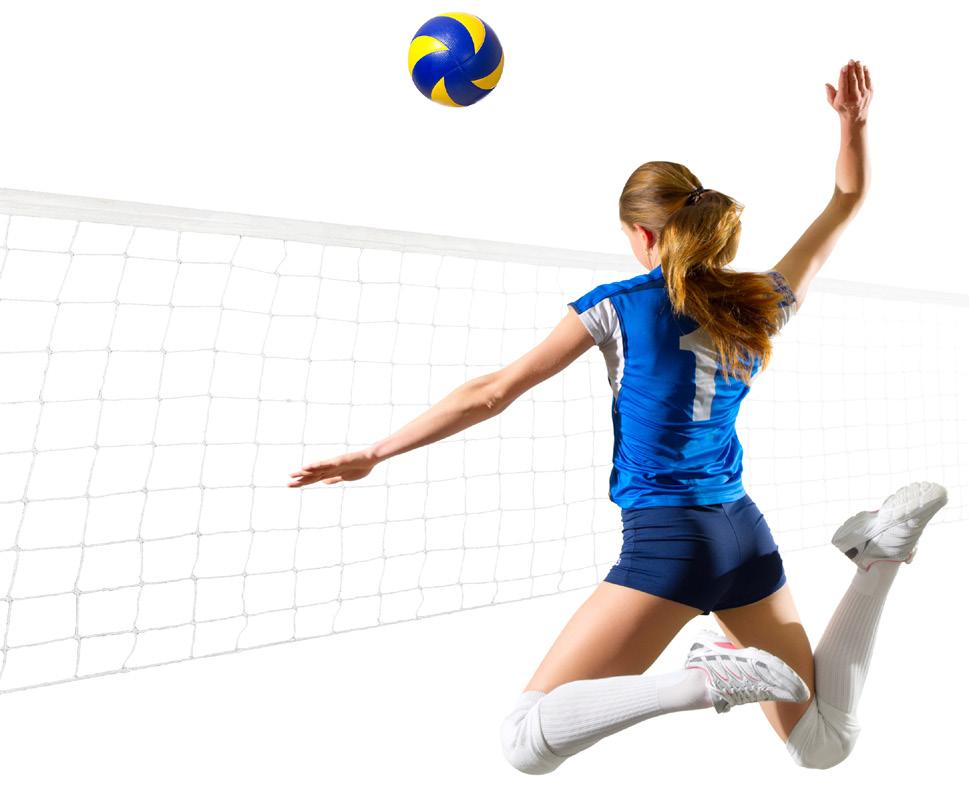
Name:
Physical activity:
Phase and cycle information
Game analysis summary: "Net and court" physical activities
Date:
Position/event:
Macrocycle number:
Mesocycle number:
Performance (i.e. any match, authentic scenario, event, or performance during the competition phase)
Set: _______________________________
1 Heart rate data
2 Intensity data
(Refer to GPAI 9 – Intensity of movement: "Net and court")
Resting heart rate (i.e. prior to performance)
Working heart rate range (i.e. use a HR monitor data to determine this)
Heart rate (HR) 1
(i.e. immediately after work)
Heart rate (HR) 2 (i.e. 30 seconds after work)
Heart rate recovery
(i.e. subtract HR 1 from HR 2)
Rating of perceived exertion (PRE) at end of 1st set
(i.e. provide rating from 1–10)
Average distance covered at high intensity
(e.g. fast positional shuffling, lunging during a point, efforts to retrieve or hit a ball, etc.)
Average distance covered at moderate intensity
(e.g. minor positional shuffling, time between points and games, during timeouts, etc.)
Overall distance covered at moderate intensity
Overall distance covered at high intensity
3 Movement data
(Refer to GPAI 10 –Frequency, direction and duration)
4 Skills data
(Refer to GPAI 11 –Specialised movement sequence analysis)
Main types of movement (e.g. running, sidestepping, jumping, etc.)
Main directions of movement (e.g. forward, backwards, etc.)
Phase of training:
Microcycle number:
Result Current vs previous game/event* Reflection and notes
*Key: B = better; W = worse; S = same; H = higher; L = lower; NA = not applicable
SOURCE 1 GPAI 8
Lesson 4.24 Developing a training session plan
Key ideas
Learning intentions and success criteria
preparedness an athlete’s level of readiness to achieve physiological adaptation from training
Study tip
If your training strategy involves the development of several training sessions in a microcycle, you will need to show how the specific training objectives for these sessions meet what has been set by the training program.
→ When drawing up a training session plan, athletes should include: general information such as date, time and phase of training; training session objectives such as energy, fitness and skill objectives; warm-up, cool-down and conditioning activities; and data collection and reflection.
Introduction
While a training program can be considered a master plan for an athlete in preparation for their ultimate competitive performance, training session plans are the detailed instructions used on a day-by-day basis to let athletes know exactly what they need to do in each training session. The development of a training session plan should be guided by the training program, taking into consideration the phase and cycle where the training session sits, as well as the athlete’s preparedness to train.
What to include in a training session plan
Training sessions are generally presented in the form of a table and commonly include:
• general information such as the date, time and phase of training
• training session objectives such as the energy, fitness and skill objectives
• warm-up activities using the RAMP approach
• conditioning phase activities
• cool-down activities
• space for data collection and reflection.
Templates have been provided on Oxford Digital to support you in developing your own training sessions. You can see a detailed example of a training session plan in Source 8 of Lesson 4.22 Developing a training program (page 294).
Additional resource: Training session plan (simple)
Additional resource: Training session plan (detailed)
General information
General information is beneficial from an administration perspective. General information should include:
• the date, time and location
• the equipment needed
• the phase and cycle of training.
Filling out a general information section of a training session plan can come in handy later, when the athlete or coach might want to go back and reflect on past sessions and identify trends.
Training session objectives
Every training session should communicate which specific training objectives will be met on the given day. These objectives will be guided by the microcycle objectives indicated in the training program. Training session objectives should take into consideration:
• energy systems
• fitness components
• specialised movement sequences
• movement strategies.
It is important to note that not every objective for that microcycle needs to be targeted in every single training session. In other words, the current microcycle may have identified energy, fitness and skill objectives for an athlete to meet during the week; however, there may be a particular training session in which they will focus on fitness only.
Warm-up activities
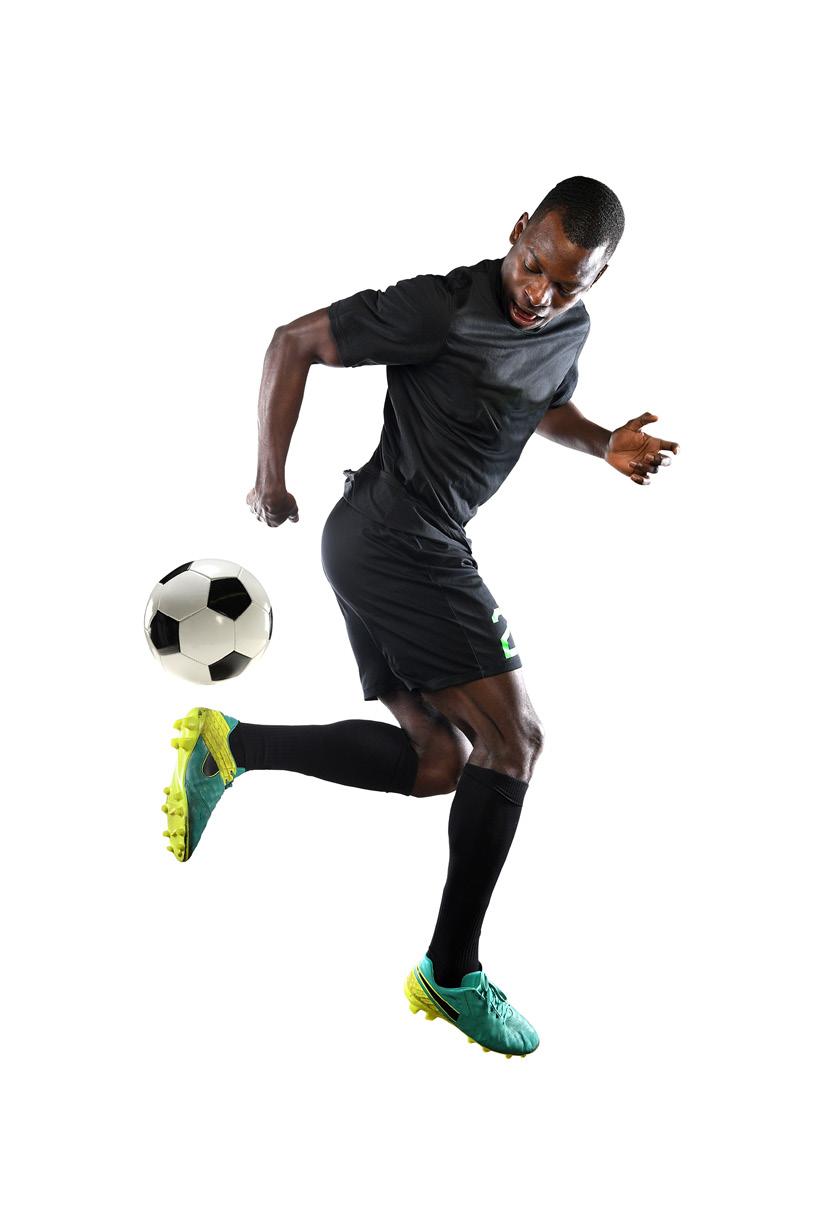
SOURCE 1 Planning and preparing for training sessions helps athletes become competition ready.
Warm-ups are critical as they prepare an athlete to safely meet the physical and mental demands of the training session or competition. It is essential that warm-ups begin gently and gradually increase in intensity to bring the athlete’s body systems to the point of readiness for full exertion. A warm-up usually takes 10 to 15 minutes but can be longer depending on the activity. For instance, it is not uncommon to see professional teams warm up for almost an hour. The way warm-ups are conducted has evolved over time. A contemporary framework that facilitates an effective warm-up was developed in 2007 by international strength and conditioning coach Ian Jeffreys. It is known as the RAMP approach, which stands for:
• R aise
• Activate and Motivate
• Potentiate.
In the RAMP protocol, an athlete moves sequentially through the following stages.
Stage 1: Raise
This stage involves raising the athlete’s body temperature, heart rate, respiration rate, blood flow and joint viscosity through low-intensity (increasing to moderate-intensity), sportspecific activities. The target heart rate for the main part of a training session should guide the level to which the heart rate is raised in the warm-up:
• approaching 60 per cent of maximum heart rate (MHR) for planned aerobic zone training
• approaching 80 per cent MHR for planned anaerobic zone training. Refer to Lesson 4.11 Training zones (page 233) for more information on target heart rates.
Examples of Stage 1 activities include: cycling; using a skipping rope; jogging; swimming; or general movements such as heel flicks, high knees, carioca, shuffling, and ladder drills.
Stage 2: Activate and Mobilise
This stage involves the athlete engaging or "turning on" their muscles and deploying or readying their joints by taking part in activities that will not just use the relevant joints, but put them through their full range of motion, subsequently flexing and extending the muscles. This needs to be done in a way that builds on Stage 1 by maintaining body temperature and heart rate. In other words, an athlete’s heart rate and respiration rate should never return to a resting state while an athlete is in Stage 2.
Examples of Stage 2 activities include: glute bridges, hamstring sweeps, leg swings, shoulder rotations, squats, lunges, and high skips.
Stage 3: Potentiate
At this stage the athlete must engage in activities that build on Stages 1 and 2 and reflect the skills and actions specific to their position or event. This phase is considered a rehearsal and should gradually build up intensity to near maximum so that the athlete is fully prepared to take to the playing field, court, etc.
Examples of Stage 3 activities include: sprinting; bounding; zigzagging; jumping; dodging; or any similar intensity activities that mimic the actions of the sport such as sprinting and jumping to mock head a ball into a net (football).
Specificity in warm-up activities
The principle of specificity is key to a good warm-up. For example, if your conditioning phase involves fast running, the warm-up should prepare you for this. One of the most common mistakes made in warm-ups is moving through generic activities and then performing a completely different skill-set during the conditioning phase. Following the RAMP protocols ensures that the principle of specificity is being applied.
What the research says
The RAMP warm-up protocol has been found to enhance training efficiency by sequentially optimising performance in each phase while achieving both short-term and long-term athletic development. Consequently, it maximises training effectiveness without significantly increasing time commitment, ensuring efficient and effective application (Jeffreys, 2017).
A 2024 study by Vadher et al., which evaluated the RAMP warm-up's impact on football players' speed, agility and endurance, supported this positive finding. Fifty participants were divided into RAMP and traditional warm-up groups. Results showed RAMP significantly improved speed, agility and endurance. The study concluded RAMP was a valuable addition to training programs as its structured approach optimally prepares athletes for intensive, sport-specific activities.
Despite the RAMP warm-up's proven effectiveness, Recinais et al. (2017) cautioned that the rise in whole-body temperature should be carefully monitored and even limited in hot environments. In other words, the RAMP warm-up should be manipulated to suit the demands of competition in hot environments to avoid limit endurance capacity in relevant sports.
References
• Racinais, S., Cocking, S. & Périard, J. D., 2017, "Sports and environmental temperature: From warming-up to heating-up". Temperature, 4(3), 227–257. https://doi.org/10.1080/23328940.2017.1356427
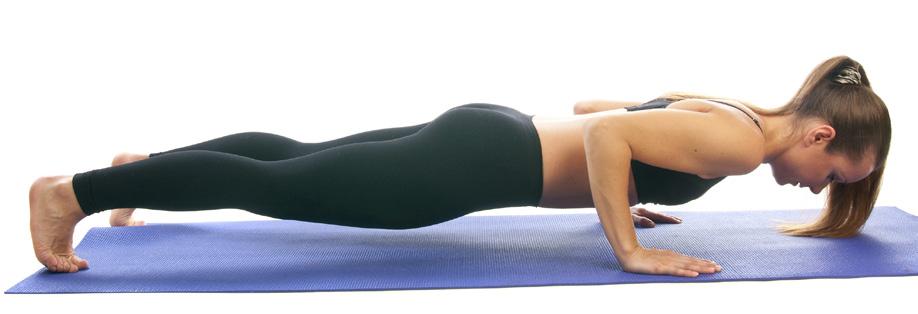
• Jeffreys, I, 2017, May 12, (PDF) "RAMP warm-ups: more than simply short-term preparation". ResearchGate. Retrieved November 20, 2024, from https://www.researchgate.net/profile/Ian-Jeffreys-2/publication/316878902_RAMP_warm-ups_more_than_simply_short-term_ preparation/links/591588cca6fdcc963e831fdf/RAMP-warm-ups-more-than-simply-short-term-preparation.pdf
• Vadher, K. P., Sanghvi, M. & Tank, K., 2024, "The impact of a raise, activate, mobilize, and potentiate (RAMP) warm-up protocol on speed, agility, and endurance in competitive male football players: a quasi-experimental study". Journal of Society of Indian Physiotherapists, 8(1):p 10–13, January–June 2024. DOI: 10.4103/jsip.jsip_84_23
Conditioning phase activities
The conditioning phase is the most important part of the training session. It is here that the athlete participates in activities that will satisfy principles of training, contribute to physiological adaptation and prepare them for performance. In the conditioning phase, the following components should be determined:
• activity (including training method and task description)
• load (including sets, repetitions, volume, intensity, work:rest ratio and type of recovery).
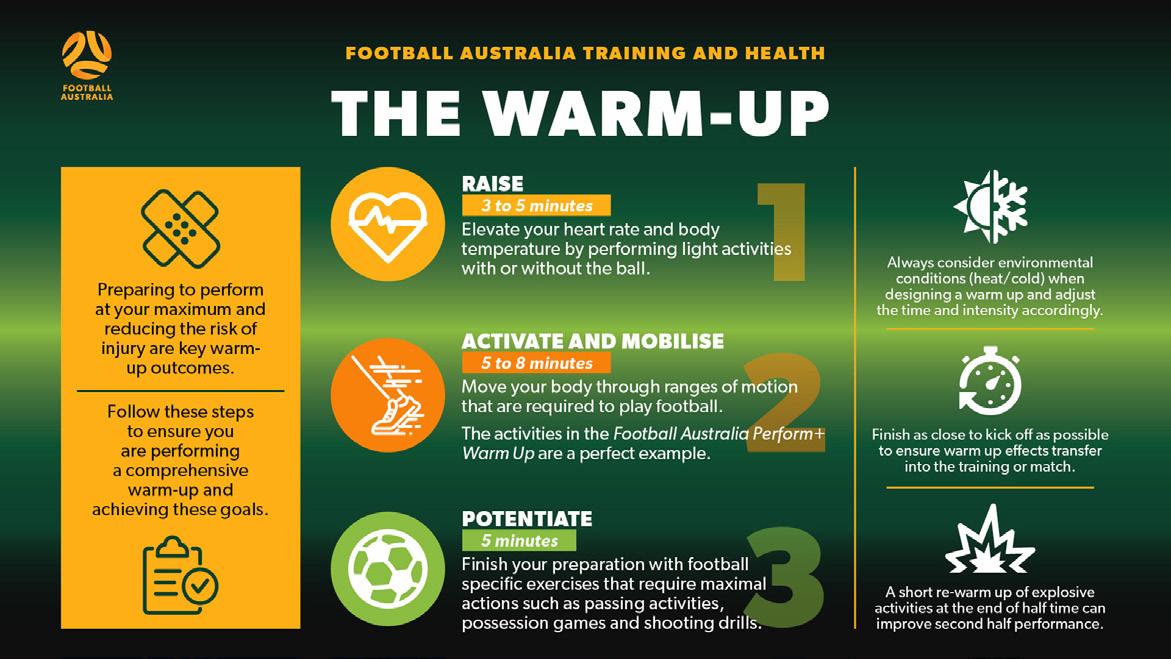
The design of training activities in the conditioning phase is the most complex and important part of developing a training session, so we will now focus on how to determine the activity and load for a training session in more detail.
Activity (including training method and task description)
There are many different ways to begin developing activities for the conditioning phase of a training session. For example, some people like to start by considering what skills are needed and then work out how they can incorporate fitness needs. Others switch that approach and start by deciding what fitness needs they will target before finding a way to include a skill focus.
Regardless of the approach taken, the important thing is that the activities meet the identified training objectives, including energy system objectives, fitness component objectives and skill objectives.
Load (including sets, repetitions, work volume, intensity, work:rest ratio and type of recovery)
Once athletes have determined what their activities will look like, they must decide on the appropriate difficulty level to assign to each activity. In other words, they must decide how they will make the activity’s difficulty level very high, high, moderate, low or very low. This is called setting the load. Setting the load involves the use of measurable quantities, as shown by the examples in Source 4. The overall load experienced by the athlete depends on the manipulation of five variables. These are:
• sets
• reps
• volume
• intensity
• work rest (W:R) ratio.
Knowing how to manipulate these variables can be challenging. It is a process that takes time to master and involves trial and error. There are different approaches that athletes can take to determine the load. For the purposes of Senior Physical Education, we have categorised these into two groups:
• using secondary data to determine the load
• using primary data to determine the load.

SOURCE 3 It is important for training sessions to communicate which specific training objectives will be met on a given day.
SOURCE 2 Football Australia is one of many sporting organisations to advocate for the RAMP warm-up.
initial training values the quantitative measurement of training that you can realistically manage at the start of any training program (number of repetitions, work volume, intensity, W:R, duration, sets)
Using secondary data to determine the load
An abundance of information from credible secondary sources exists on the initial training value suggested for athletes of varying fitness levels. Initial training values are the quantitative measurement of training that an athlete can realistically manage at the start of any training program. In other words, these values refer to a load that would be considered moderately difficult for an athlete. For the purposes of Senior Physical Education, Source 5 provides a general set of guidelines that athletes can follow to determine their initial load.
Using primary data to determine the load
Another way that athletes can determine their load is to attempt an activity and reflect on the difficulty level of the quantities set. This process is known as conducting an initial training values test.
Initial training values tests can be performed for each activity that the athlete plans to perform. The tests are designed to be moderately difficult. Therefore, if an athlete finds them difficult, they can determine that their training values need to be lowered (e.g. by performing fewer sets or repetitions). On the other hand, if an athlete finds a session easy, then they can conclude that their starting values need to be increased. The Skill drill in Lesson 4.25 Skill drill: Determine your initial training values (page 311) has been designed to help you determine your initial training values. It uses aerobic interval training, but you can substitute this for any training method relevant to your training. It is highly recommended that you complete this Skill drill before you decide on the load for the activities within your training sessions.
Guidelines for activity design
Component of fitness Specificity
Strength
Resistance training with 1–8 repetitions that should be of both a specific (i.e. specific sport movements) and general nature
Variety Frequency
Free weights, cables, machines and own body weight to train isotonically, isometrically and isokinetically
Power
Muscular endurance
It is necessary to have adequate strength before one can develop power. Therefore, it is recommended that a power program includes a strength program. Where possible, actions should mimic those of the sport.
Any activity requiring the muscle to repeatedly contract against a resistance
Plyometrics, ballistic training, resistance towing or pushing, Olympic weight lifting
3 times per week with 48 hours minimum rest between each session if training a whole-body program. On a split routine (i.e. concentrating on specific muscle groups), training can occur every day.
2–3 sessions per week
Free weights (e.g. barbells, dumbbells, kettlebells), own body weight or a moveable object (e.g. medicine ball)
*RM is the most weight an individual can lift for a defined number of repetitions
**MHR is maximum heart rate
Up to 7 sessions per week if muscle groups and exercises are varied; usually, 3 times per week for a whole-body program
SOURCE 5 Use the principles of training to guide decisions about activity design and load (per fitness component).
Training objectives
Activity (including training method)
Activities for netball (invasion)
Movement strategy: Driving into space
Specialised movement sequences: Passing
Energy system: Lactic acid system
Fitness component: Agility
Netball running box drill (highintensity interval training)
Players form a square. Ball carrier passes to player to their left, following the pass in a clockwise direction and waiting at the corner to receive the ball and continue around the square.
Sets, repetitions, work volume and intensity
Work:rest ratio (if applicable)
1 × 10-minute drill completion at 90% intensity
1:3 (approximately)
Activities for tennis (net and court)
Movement strategy: n/a
Specialised movement sequences: n/a
Energy system: Lactic acid system
Fitness component: Speed, agility
Tennis run-shuffle-run drill (sprint interval training)
Player moves from sideline A to sideline B, back to A and then back to finish at B; this would be one repetition. Throughout this movement, they must alternate between running steps and shuffling steps to mimic typical movement during points.
3 sets of 5 x run-shuffle-run drills at 100% intensity (4 minutes of passive rest between each set)
1:2 (e.g. 10 seconds work to 20 seconds active rest)
Activities for track and field (performance)
Movement strategy: n/a
Specialised movement sequences: n/a
Energy system: Lactic acid system
Fitness component: Power, speed
Hill sprints (resistance training – plyometrics)
Repetitive sprinting up a steep incline
2 sets of 3 × 80 m hill sprints at increasing intensities: 90% (3 minutes passive rest between sets)
1:3 (e.g. 15 seconds work to 45 seconds active rest)
SOURCE 4 When choosing activities for a training session, there are two key questions athletes need to ask themselves: What do I want to achieve with this activity (objectives)? How will I do it (elements)?
Guidelines for load
Duration
Untrained athletes: a maximum of 1 hour per session
Duration can also be determined by number of reps and sets (e.g. 12 exercises × 2 sets, or 8 exercises × 3 sets is common). Advanced lifters can spend up to 2.5 hours per session; sometimes with as few as 4 exercises × 8 sets; normally 6 exercises × 4 sets or 5 exercises × 5 sets (especially in split routines) 4–6 minute rest between sets.
Sessions usually last no more than an hour. Advanced athletes could train for up to 1.5–2 hours. Usually 2–3 sets of each exercise, with no more than 6 reps. (Note: If you go past 6 reps, you decrease speed and lose power – allow 10 seconds between reps. Allow 4–6 minutes rest between sets.)
Sessions should be approximately 45 minutes to 1.5 hours. The repetition range is often greater than 15 reps, 2–3 sets. Often, these activities are measured by time, not repetition (e.g. number of chin-ups in a minute). Aim for 20–60 seconds per set. 10 minutes rest between sets.
Intensity
Untrained athletes: 8–12RM*; slow–moderate speed
Advanced athletes: 1–8RM; slow–moderate speed
30–60% of 1RM or 6–12RM performed with explosive force
Progressive overload
Gradual increases in weight lifted and gradual reduction in number of repetitions
Less than 70% of 1RM or 15–20RM
Gradual increases in power output required (e.g. increase height of bench jump or number of claps between each push-up)
Gradual increase in the weight lifted but reps are kept the same, or the weight is kept the same and the reps increase; also an option to increase the number of sets
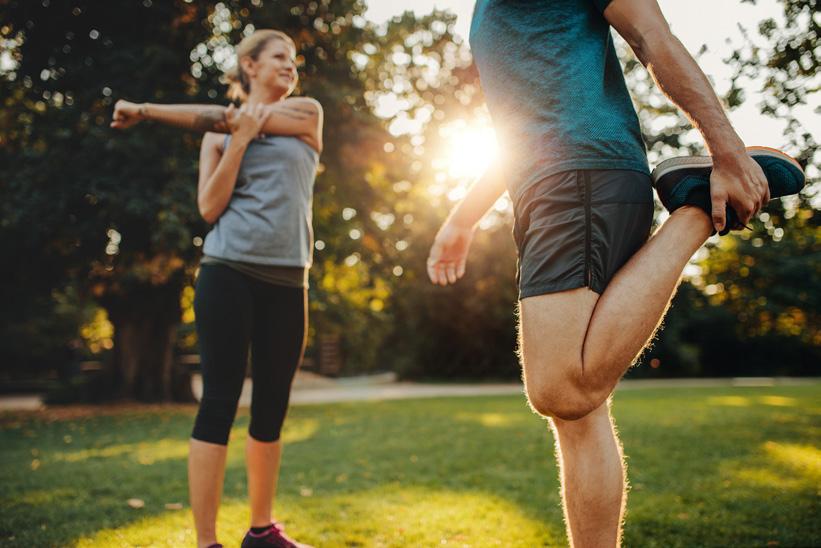
Cool-down activities
Cool-down activities are low- to moderate-intensity activities that help to bring the athlete’s heart rate down steadily while keeping the flow of oxygen moving through the muscles. A cool-down should consist of the following elements:
• at least five minutes of aerobic activity such as a light jog (known as an active recovery)
• a range of dynamic and static stretches.
Space for data collection and reflection
Regular data collection and reflection is important throughout a training program implementation. Leaving space to note this data collection and reflection on the training session document will allow you to determine the effectiveness of the training session, make any necessary modifications to activities and load for future sessions.
Data to be collected for each activity during a training session includes:
• rating of perceived exertion (RPE)
• heart rate (HR)
• respiratory rate (RR)
• level of motivation.
Data to be collected after a training session has been completed includes:
• rating of fatigue (ROF)
• rating of session effectiveness (RSE)
• overall reflections in a training journal.
While athletes commonly have a number of training sessions ready for implementation, it is important that they don’t follow the plan without considering their body’s preparedness to safely train again. Failing to do so can lead to exhaustion, illness and injury.
The preparedness flowchart (Source 7) can help athletes to make decisions about when they can safely train again. At the completion of every individual training session, an athlete should determine whether they have a zero, low–moderate or high level of preparedness to retrain.
• Zero preparedness (injury or exhaustion) – stop, recuperate and seek advice before training again.
• Low–moderate preparedness (high–moderate fatigue) – proceed with caution. If you wish to train again within the next 24 to 48 hours, you will need to significantly alter your activities so that different physiological capacities are stressed.
• High preparedness (low fatigue) – training again within the next 24 to 48 hours is possible but you may need to slightly alter your activities based on your evaluations.
SOURCE 7 This preparedness flowchart can help athletes to make decisions about when they can safely train again. It is important for an athlete to take stock of their level of fatigue after each training session to determine if they can continue with their initial plan for training session frequency within the microcycle or if they need to make adjustments.
The following Theory in action Determining initial training values expands on the idea of initial training values, showing how one student has gathered this information to determine an appropriate starting point for the activities within her training strategy.
SOURCE 6 Stretching after training helps reduce muscle fatigue and support muscle recovery.
need
altered
A quick return to training is possible.
Theory in action Determining initial training values
Mickey is a 17-year-old Senior Physical Education student who has decided to develop a microcycle consisting of three training sessions. She is rapidly learning the specialised movement sequences needed for her position of passer-hitter in volleyball, and she has identified that she needs to improve her muscular power to optimise her performance in the movement strategy of using different attack, serve or hit options. Her game analysis reveals that she is on the court for approximately 20 minutes each set, with the occasional time out. This shows that she mostly uses the aerobic system, regularly interspersed with the ATP–PC system each time she explosively spikes, blocks or serves. Rallies seldom last long enough to tax the lactic acid system. Mickey knows what phase she is working within; she knows that her training load must consist of highintensity, low-volume work and she has identified that the mesocycle wherein her microcycle lies uses a 3:1 loading pattern. She establishes that she will train for three days and devises a list of the activities that would meet her training objectives for the week, taking into account the movement strategies, specialised movement sequences, energy systems and fitness components to be developed.
It is now time for her to decide the repetitions, volume, intensity and W:R ratio for each activity; however, she is struggling to know what these exact values should be. In other words, how many repetitions, what volume, what intensity and what W:R ratio should she use? To help find a starting point, she completes the power initial values test in the Skill drill in Lesson 4.25 Skill drill: Determine your initial
training values (page 311). At the completion of the Skill drill, she uses the 5-point session evaluation scale, rating the session as a 4 (i.e. "too difficult –struggled to complete"). This result implies that she should reduce these values when starting her own training. Thus, she now has a starting point.
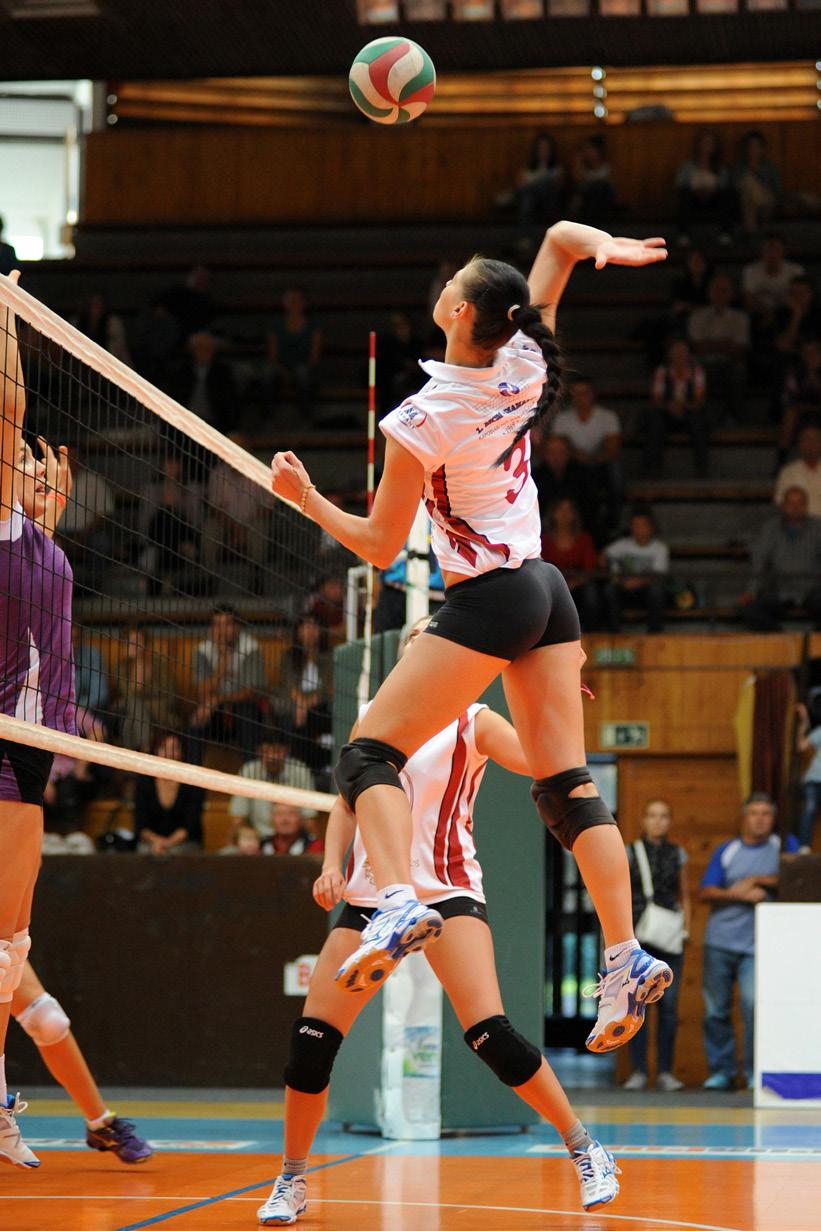
therefore incorporate relevant training methods with suitable training loads to reflect this.
will need to determine their initial values to establish an appropriate starting point.
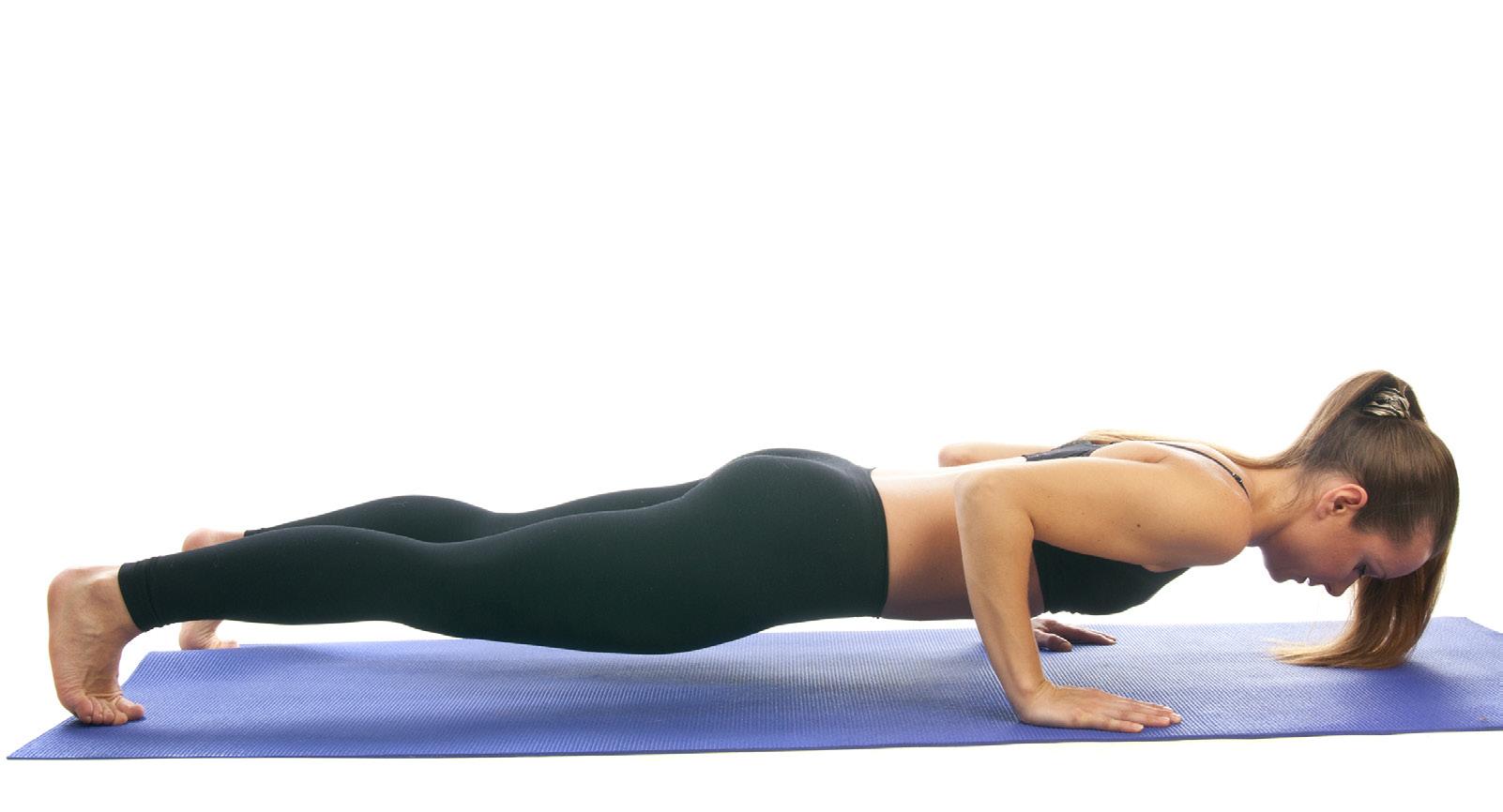
SOURCE 8 A volleyball player requires muscular power and must
The player
Date: 29 August
Time: During a PE lesson
General Information
Location: Field
Equipment: Balls, cones, measuring tape, stopwatch, bibs
Position within annual plan: Microcycle 1 of Mesocycle 1 in the pre-competition phase
Training session objectives
Movement strategy (if applicable): Maintaining possession of the ball
Specialised movement sequences (if applicable): Forwards and backwards movement based on ball movement, defensive and offensive play, and passing
Energy system: Aerobic
Fitness component: Aerobic capacity and agility
Warm up (applying RAMP approach): The official FFA 11+ warm up (visit the FFA website for details)
Conditioning phase (3 activities)
Specific training objective
Movement strategy (if applicable):
Maintaining possession of the ball
Specialised movement sequences (if applicable):
Forwards and backwards movement based on ball movement, defensive and offensive play, and passing
Energy system:
Aerobic
Fitness component:
Aerobic capacity
Activity details (including training method, load and equipment)
Activity (including training method):
Shuttle runs with ball
Training method:
Aerobic interval training (AIT)
Load (sets, reps, volume and intensity, W:R):
4 × shuttle running/dribbling at 80% intensity over 20 m, 40 m and 60 m (i.e. when you finish the 60 m shuttle, start again at 20 m); W:R 1:1
Equipment:
A football per person, cones, measuring tape, stopwatch
Data collection (RPE, RR, HR, level of motivation)
Rate of perceived exertion: 5/10
Respiratory rate: 45 breaths per minute
Heart rate at end: 140 bpm
Motivation level: Moderate
Reflection
The first 3 repetitions of the shuttle runs were relatively easy; however, during the fourth repetition, I began to lose control of the ball. I also found the last 2 repetitions more difficult, and I found my legs became heavier.
Movement strategy (if applicable):
Maintaining possession of the ball
Specialised movement sequences (if applicable):
Forwards and backwards movement based on ball movement, defensive and offensive play, and passing Energy system:
Aerobic
Fitness component: Agility
Movement strategy (if applicable):
Maintaining possession of the ball
Specialised movement sequences (if applicable):
Forwards and backwards movement based on ball movement, defensive and offensive play, and passing
Energy system:
Aerobic
Fitness component:
Aerobic capacity
General Information
Activity:
Keep possession in small grids
Training method:
High-intensity interval training (HIIT)
Load (sets, reps, volume and intensity, W:R):
8 × “4 v 2” 1 minute games at 80% intensity W:R ratio 1:1 (e.g. 1 minutes of work = 1 minutes of rest)
Equipment:
10 m × 10 m grid, a ball per grid, 2 bibs per grid, stopwatch
Activity:
Keep possession in large grids
Training method: Aerobic interval training (AIT)
Load (sets, reps, volume and intensity, W:R):
4 × “12 v 6” 4 minute games at 80% intensity W:R ratio 1:1 (e.g. 3 minutes of work = 3 minutes of rest)
Equipment:
A football, bibs, stopwatch, 60 m × 60 m grid
Other:
Similar to working in a 10 m × 10 m grid, but with 12 attackers and 6 defenders 10 successful passes for attackers = 1 goal 4 successful passes for defenders = 1 goal
Rate of perceived exertion: 6/10
Respiratory rate: 61 breaths per minute
Heart rate at end: 160 bpm
Motivation level: High
When working as a defender, the intensity was much closer to 100% than it was when working as an attacker. It was much more difficult to intercept the ball as fatigue began to set in. As an attacker, it was important to keep my mind on my skills, especially as the conditions were imposed. The small area meant that even though my heart rate was increased, my cardiovascular endurance was note tested as much as it could be.
Rate of perceived exertion: 7/10
Respiratory rate: 70 breaths per minute
Heart rate at end: 185 bpm
Motivation level: Moderate
This activity was very different to the small sided grid training, as it meant shorter bursts of high intensity, but they needed to be sustained for a longer period of time. This was relatively easy to maintain in the first 5 minute rotation, but by the fourth rotation, I had lost much of the power needed to pass the ball to my teammates. I was also losing accuracy of the passes. The transition periods within the activity (from high-intensity attacker to low-intensity attacker) were used as a way to recover from the high intensity bursts.
Cool down:
Light jog around field and 5 minutes of static stretching
Journal reflection after training session:
Overall rating of fatigue (ROF): 7/10
Rating of session effectiveness: 3/5
SOURCE 9 A sample soccer training session plan for a Senior Physical Education student in the pre-competition phase is available for download. The student has stated their objectives, applied the RAMP approach to their warm-up, provided very clear details in the conditioning phase and shown how they will cool down. The student has recorded data about their performance in the "Reflection" column.
Download a copy of the sample soccer training session plan in Source 9.
Additional resource:: Sample soccer training session plan
Check your learning 4.24
Check your learning 4.24
Retrieval and comprehension
1 Choose the correct answer.
Identify what a training session’s objectives should take into consideration.
A the athlete’s preparedness and fatigue levels, equipment and time available
B energy systems, fitness components, specialised movement sequences, movement strategies
C phase of training within the annual plan, W:R ratios, availability of specialist coaches
D phase of training within the annual plan, fitness components, specialised movement sequences
2 Choose the correct answer.
Recognise the training methods used to specifically improve aerobic capacity.
A continuous training, fartlek training, SIT
B LSD training, SIT, HIIT
C fartlek training, resistance training, continuous training
D continuous training, LSD training, fartlek training
3 Refer to Theory in action Determining initial training values. Identify one type of qualitative primary data and one type of quantitative primary data that Mickey could use to evaluate her performance.
4 List the factors you should take into account when deciding on the frequency of training sessions within a microcycle.
Analytical processes
5 You look at a training session plan written by a basketball player who has not learnt the theory behind designing training sessions. When you ask him about his training, you find out that he is trying to improve his speed when transitioning from defence to attack and he wants to incorporate skill work into this objective. For the conditioning phase of this particular session, he writes: "Lots of short-distance sprinting while dribbling". Apply your knowledge of training session design to rewrite this description, clearly outlining the activity and load.
6 A 400-metre runner trains on the first day of a microcycle using the following activity: Sprinting: Power training using the sprint interval method focusing on drive, recovery and breaking phase of leg action. She then evaluates her level of fatigue to find out when she can train again. She rates the training load as "high" and her level of fatigue as "high". Consider what you know about fatigue and recovery to judge when she should train again.
Knowledge utilisation
7 Select one specialised movement sequence that you have set personal training objectives around. Determine an activity that might target the energy, fitness and skill elements required.
8 Analyse the secondary data in the microcycle below for the sport of triathlon. It has been suggested as a training starting point for individuals who have a moderate degree of fitness. Imagine you are about to commence training for triathlon and decide whether the microcycle would be suitable for you. Discuss your decision, using data where possible.
Week 1
Mon
Swim 30 min
Tue Bike 30 min Wed Run 40–45 min Thu Swim 30 min Fri Sat Bike/Run 30 min/5 min Sun Swim 30 min
Lesson 4.25
Determine your initial training values
Aim
To determine your initial training values (i.e. your training load for your first training session) in order to design a training session plan.
Time
1 lesson (i.e. 60 minutes) with additional time (if required) to complete analysis and discussion tasks.
Equipment
• Heart rate monitor (Note: If your HR monitor does not show training zones, you will need to determine your heart rate range for the aerobic training zone (i.e. your heart rate between 60% and 75% maximum)
• Stopwatch
• Game Performance Assessment Instrument 12 (GPAI 12)
• Game Performance Assessment Instrument 13 (GPAI 13)
• Game Performance Assessment Instrument 14 (GPAI 14)
• Clipboard
• Pen
Game Performance Assessment Instrument 12 (GPAI 12)
Game Performance Assessment Instrument 13 (GPAI 13)
Game Performance Assessment Instrument 14 (GPAI 14)
Method
Note to teachers and students
This Skill drill focuses on the training method of interval training (i.e. aerobic interval training, or AIT). The same principles can be used to determine your initial training values for components of fitness in other training methods (i.e. continuous training, fartlek training, resistance training, flexibility training, and circuit training).
Step 1
Before beginning the activity, make sure you have read through the steps below and are familiar with the following GPAIs:
• GPAI 12 – Rating of perceived exertion (RPE)
• GPAI 13 – Rating of fatigue (ROF)
• GPAI 14 – Rating of session effectiveness (RSE)
Step 2
Form pairs and participate in a teacher-led warm-up.
Step 3
One student (Student A) in each pair should now attach a heart rate monitor and test that it is working. The other student (Student B) will keep time and record data for Student A.
Step 4
Student A now takes part in the following aerobic interval training (AIT) session:
• 1 interval = a 2-minute run at 60–75% of maximum heart rate (i.e. aerobic training zone) followed immediately by a 1-minute run at 85–90% of maximum heart rate (i.e. anaerobic training zone) followed by a 2-minute rest period.
• Repeat interval five times.
Step 5
Student A should communicate their heart rate to Student B to record in GPAI 12 three times:
• immediately after the run component of each interval
• 30 seconds after the run component of each interval
• 2 minutes after the run component of each interval.
Rating of perceived exertion (RPE)
Step 6
At the completion of the five intervals, Student A should use GPAI 13 to determine and record their rate of fatigue (ROF) for the session.
Step 7
Student A and Student B should now swap roles and complete the training session again.
Rate of perceived exertion (RPE) immediately after run (1–10) Heart rate (HR) immediately after run Heart rate (HR) 30 seconds after run Heart rate (HR) 2 minutes after run
Interval 1
Interval 2
Interval 3
Interval 4
Interval 5
SOURCE 1 GPAI 12
Rating of fatigue (ROF)
(i.e. tick the relevant box)
SOURCE 2 GPAI 13
Analysis and discussion tasks
1 An understanding of volume and intensity will help you to design training sessions that are best suited to your needs.
a Calculate the volume of training in this session.
b Describe the intensity of training in this session.
c Identify some ways in which you could manipulate either volume or intensity to change the objective of this training session or to suit the needs of a particular individual or sport.
2 Analysing primary data can enable you to determine trends and relationships which will help you to make decisions about your training strategy and training sessions.
a Synthesise the primary data you gathered during this training session with secondary data (e.g. data from this textbook) to assess whether the volume and intensity of this training session applied stress effectively to bring about physiological adaptation.
b Reflect on your session and give it a rating of session effectiveness (RSE) based on the following scale:
i It offered no chance for adaptation.
ii It may have caused a slight adaptation.
iii It provided an optimal opportunity for adaptation.
iv It had a detrimental effect.
v It had a catastrophic effect.
c Based on your rating, justify whether this training session should be maintained or modified for future use.
d If necessary, modify this training session adjusting volume and intensity levels to suit your individual aerobic capacity. Note: If you decided to maintain your training session in Question 2b, identify the training values for your next training session.
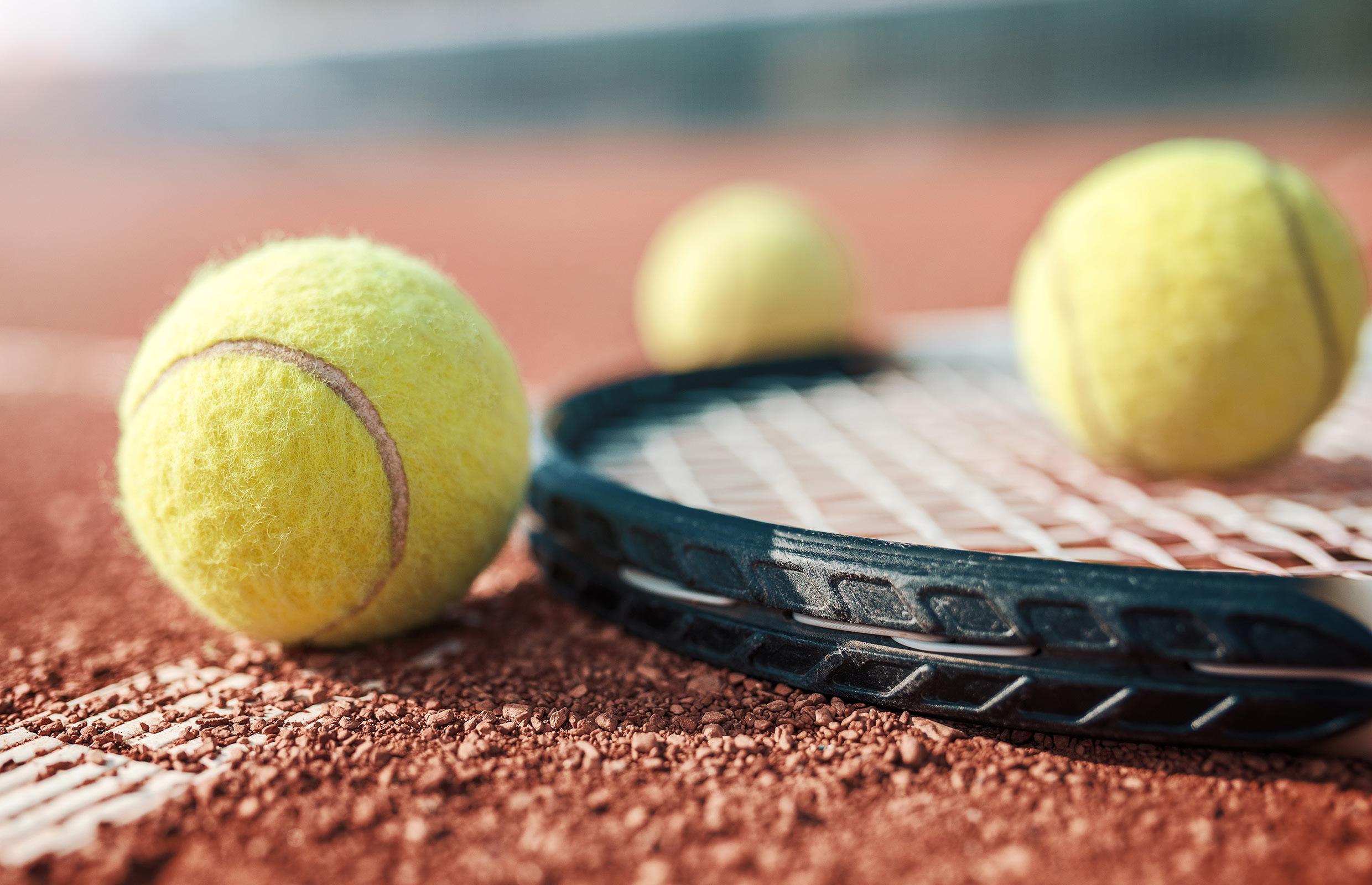
OXFORD
Learning intentions and success criteria
Lesson 4.26 Assessment support – Internal assessment 3: Project – folio
Overview of Internal assessment 3: Project – folio
As part of your assessment for Unit 4 of the QCE Physical Education syllabus, you will be required to complete a Project – folio. The Project – folio is a complex task with many different parts.
This lesson is designed to support you as you complete your own Project – folio (see Practice assessment task in Lesson 4.27 Review: Energy, fitness and training (page 326)). It includes practical tips and advice to ensure that what you produce meets the criteria set in the instrument-speciifc marking guide (ISMG). Detailed information on how to structure, create and present your Project – folio is provided in Lesson 1.3 Tips for success on the Project –folio (page 8). In addition to this, Lesson 1.4 Skill drill: Planning, creating and presenting a Project – folio (page 13) provides a number of useful tips and instructions.
The Project – folio is made up of two sections:
• Section 1 – Presentation
Create a multimodal presentation through which you will need to:
– devise, analyse, evaluate and justify your personal training strategy
– evaluate and justify the effectiveness of your personal performance using body and movement concepts.
• Section 2 – Demonstrating and applying
Produce a video that includes:
– the information needed to confirm your ability to demonstrate and apply specialised movements sequences for two movement strategies from two principles of play.
Each of these sections will be assessed and marked against the assessment objectives contained in the instrument-specific marking guide (ISMG). This means that all parts must be completed to maximise your chances of success.
In this lesson, we will model one approach to completing the task.
Note: the category selected for the physical activity must be different from the category selected for Internal Assessment 1.

Section 1 – Presentation
Section 1 of this task requires you to prepare and present a multimodal presentation of up to 11 minutes. Multimodal means using at least two modes of communication (written, visual or spoken) delivered at the same time and integrated so that each mode contributes significantly to the overall response. Examples of multimodal presentations include:
• a pre-recorded slideshow presentation with voiceover submitted as an MP4
• a presentation conducted in front of an audience (class or teacher) with text and images etc. projected
• a digital portfolio of video, images and diagrams with annotations or commentary
• a multimedia movie or slideshow that may include a combination of images, video, sound, text, narrative voice etc.
First, you are required to devise, evaluate and justify a personal training strategy. This is the largest and most significant part of the Project – folio. It requires you to apply the theory that you have learnt in this unit.
Task 1 – Devise your personal training strategy
A training strategy is any approach for a non-specified timeframe that helps you to optimise your performance of specialised movement sequences, for one movement strategy, through the application of training methods, principles of training and periodisation. Because of this non-specified timeframe, and the fact that individuals have vastly different energy, fitness and skill needs, the concept of a training strategy is open to interpretation. For example, while one person might choose to devise a training strategy for three training sessions (i.e. one microcycle), another person’s training strategy might involve the development of a four-week training program (i.e. one mesocycle). Both examples are legitimate training strategies, as long as they effectively apply training methods, principles of training and periodisation.
Source 1 outlines the steps you need to work through to devise your personal training strategy. The time needed to work through these steps will depend on how much time you are permitted to spend implementing your strategy. We will now explore each of these steps in more detail.
Study tip
Detailed information on the format and requirements of the Project – folio is provided in Lesson 1.3 Tips for success on the Project – folio (page 8).
This information includes:
• a description of the task
• assessment objectives
• a summary of the ISMG.
Be sure to read this information carefully before you work through the information provided in this section.
Step 1 – Conduct a game analysis
The first step in devising your personal training strategy is to conduct a game analysis for the selected physical activity. You do this to identify and gather data on which specialised movement sequences for your specific movement strategy require improvement.
A game analysis has to involve the systematic, organised gathering of primary and secondary data to ensure the information you collect is substantial and relevant. This is important for two reasons:
1 When you synthesise this data, you will have a more valid and reliable picture of the game and yourself as the performer.
2 The data you gather will inform your decisions around training strategy design.
Accurate and reliable data equals a justifiable strategy. It is advisable that you use a GPAI to gather your data, and that you include the GPAI or elements of the GPAI within your final multimodal presentation.
To help you with this process, an example GPAI for "Performance" physical activities has been provided for you in Source 2. The downloadable version of GPAI also includes two GPAIs designed for "Invasion" and "Net and court" physical activities. You can customise these GPAIs to suit your individual needs.
Example
George is a Year 12 Physical Education student who has selected long jump as his physical activity in Unit 4. George is already quite proficient at long jump, representing his school each year at the secondary schools’ sport athletics carnival.
George conducts a game analysis to gather a range of quantitative and qualitative primary data on his performance. Among other things, he collects information on his heart rate, rating of perceived exertion, total time at work, speed of approach, accuracy (distance short of, or over, the board on each attempt) and consistency (maintaining speed over each jump and maintaining accuracy).
A comparison of this data to a model of effective technique leads George to believe that his approach is optimal. Video footage taken from behind, side on and in front of George shows that his preparatory step for take-off is perfectly flat-footed and his angle during the take-off phase is ideal. However, an error is spotted during his rise and fall in the flight phase; his body is rotating too far forward. He now has a clearly identified problem that he can devise a strategy to improve, using energy, fitness and training concepts. George conducts some independent research and synthesises his primary data with secondary data to gain valuable insight. He learns that forward rotation is a common problem for long jumpers and that a range of mid-air techniques exist to combat this unwanted rotation. Specifically, the hitch kick technique is recommended, but only when the athlete’s take-off has been mastered.
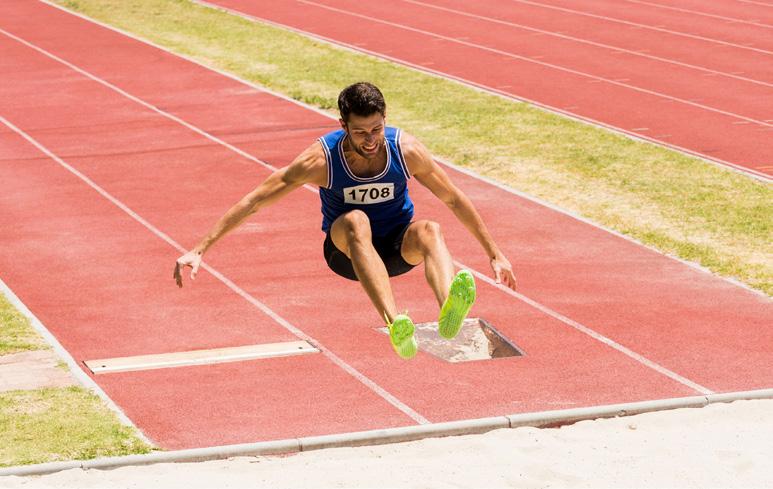
Game Performance Assessment Instrument 8 (GPAI 8)
Name:
Physical activity:
Phase and cycle information
Performance
Game analysis summary GPAI: "Performance" physical activities
Date:
Position/event:
Macrocycle number: Phase of training:
Mesocycle number: Microcycle number:
(i.e. any match, authentic scenario, event, or performance during the competition phase)
Effort/leg (e.g. the bike leg of a triathlon): ____________________________________
1 Heart rate data
Result Current vs. previous game/event
Reflection and notes
2 Intensity data
(Refer to GPAI 9 – Intensity of movement: "Net and court")
Resting heart rate (i.e. prior to performance)
Working heart rate range (use HR monitor data to determine this)
Heart rate (HR) 1 (immediately after)
Heart rate (HR) 2 (30 seconds after work)
Heart rate recovery (subtract HR 1 from HR 2)
Rating of perceived exertion (PRE) at end of effort/leg (provide rating between 1 and 10)
Average time spent at high intensity
Average time spent at moderate intensity
Average time spent at low intensity
3 Movement data (Refer to GPAI 10 – Frequency, direction and duration)
4 Skills data (Refer to GPAI 11 – Specialised movement sequence analysis)
Main types of movement (e.g. running, sidestepping, jumping) Main directions of movement (e.g. forwards, backwards)
Specialised movement sequence 1 % ineffective % effective
Specialised movement sequence 2 % ineffective % effective
*Key: B = better; W = worse; S = same; H = higher; L = lower; NA = not applicable
SOURCE 2 A game analysis should collect information that includes the athlete’s physiological responses to a particular performance.
Step 2 – Establish the amount of time available for implementation of your training strategy
The time available to implement your training strategy will depend on the task that has been set by your teacher. For example, you could be asked to devise a training strategy for a microcycle, consisting of three training sessions, or to devise a training strategy for a fourweek mesocycle. If timeframe has not been specified, it is recommended that you negotiate a plan with your teacher, taking into account the amount of class time you will be given for implementation. The duration of your strategy is an important detail as it will determine how much you can realistically achieve.
Example
George’s task sheet does not stipulate the duration of his training strategy so he queries this with his teacher. She explains that she will allocate three weeks of class time for students to devise and implement their training strategies. Students can choose to implement three microcycles (i.e. take up the whole time), or they may implement a shorter training strategy and use the remaining lessons to work on participating in their selected event to optimise their technique and gather more video footage for their Project – folio.
Step 3 – Identify specific training objectives to be achieved
You must now determine what improvements you can realistically aim to achieve. The personal training strategy you devise has to clearly show an intent to optimise performance of the specialised movement sequences for one movement strategy, through the application of energy, fitness and training concepts. Therefore, it is suggested that you break your major objective down into the following four categories:
• the movement strategy you will be aiming to develop
• the specialised movement sequences you will be focusing on for that movement strategy
• the energy systems you will be developing
• the fitness components you will be targeting.
Example
George sets himself the major objective of learning and optimising the one-and-a-half stride hitch kick technique, which requires significant power and control. In working on this specialised movement sequence, he is developing the movement strategy of "building effort and distance or height throughout the competition". In his journal, George clearly communicates this information and turns this major training objective into more specific objectives:
• Movement strategy: to vary intensities of jumps depending on the order of the jump within the competition. The first and third jumps are to be executed at maximal effort and the second jump at a conservative effort, with the aim to build effort and distance or height throughout the competition
• Specialised movement sequence: transition, flight and landing
• Energy system/s: ATP–PC
• Fitness component/s: speed, power
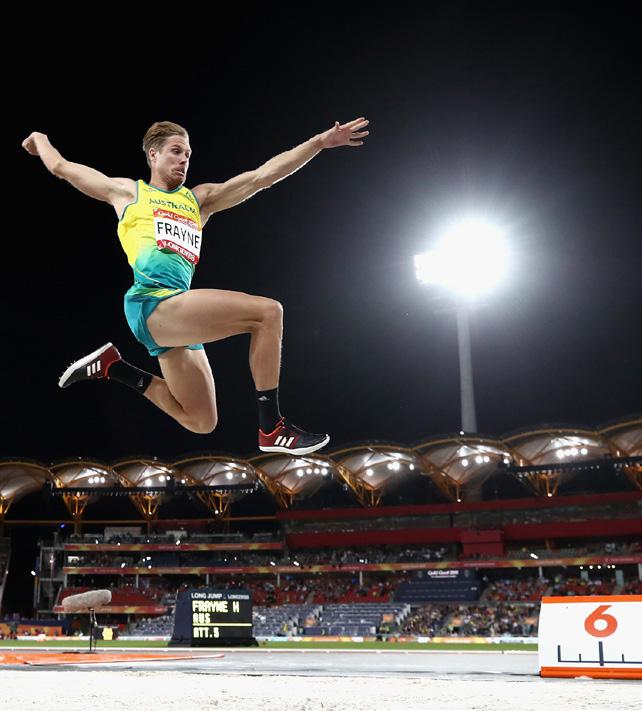
SOURCE 3 The hitch kick technique (shown here) is used to combat forward rotation during the flight phase.
A relatively proficient long jumper like George might set this skill as an objective for his training strategy.
Step 4 – Develop the training program
This step requires you to clearly communicate your strategy in writing. In other words, you will need to construct the training program and/or individual training sessions that you plan to implement. It is advisable to use the templates that are available to download as they will prompt you to include all the relevant information. It is recommended that you follow the guidelines on training program and training session design in Lesson 4.22 Developing a training program (page 288) and Lesson 4.25 Skill drill: Determine your initial training values (page 311).
Additional resource: Training program template
Additional resource: Training session plan (simple)
Additional resource: Training session plan (detailed)
Example
George decides to devise a training strategy for three individual training sessions (i.e. one microcycle). He begins by mapping where these three sessions fit in terms of the mesocycle and training phase that they sit in. Taking this top-down approach to his planning will allow him to fully understand and justify the objectives for his three sessions, showing how he is applying periodisation.
Step 5 – Implement the training program and make adjustments where required
You can now participate in the training sessions, paying careful attention to how your body responds and continually analysing your primary data. As you have learnt in this module, physiological adaptations only occur when the conditions are right. Training that is too easy or too hard will not elicit positive change. As outlined in Lesson 4.24 Developing a training session plan (page 300), it is advisable that you evaluate every training session using two tools:
• rating of session effectiveness (RSE)
• the preparedness flowchart (Source 7 in Lesson 4.24 Developing a training session plan, page 306).
These tools will allow you to make decisions about whether the training session was effective or not, and whether participating in the next scheduled training session is advisable.
Example
Once George has written the training sessions in minute-by-minute detail, he is ready for implementation. As he performs each session, he will collect primary data using a GPAI. In the 24 hours following each session, he will complete a journal entry and use the rating of session effectiveness and preparedness flowchart (Source 7 in Lesson 4.24 Developing a training session plan, page 306) as tools to determine whether his session worked and if the timing of his next scheduled session is appropriate. If not, he will reduce the work volume and intensity of the planned session, modify it completely or postpone the planned session until his body is ready.
Study tip
Remember that your training strategy for the Project – folio needs to be coherent. Whatever the combination of modes of presentation you choose (e.g. a mix of written paragraphs, photographs, videos and drawings), your Project – folio must have a clear purpose and direction. In other words, it needs to tell a logical story from beginning to end.
Example
Task 2 – Evaluate your personal training strategy
Once you have devised your training strategy, you need to evaluate whether it has been effective or not. This requires you to use the principles of training to appraise the outcomes and limitations of the selected training methods, energy systems and fitness components. To break this down, it is helpful to understand the terms "appraising outcomes" and "appraising limitations" in relation to training. We can consider these terms by answering the following questions.
Appraising outcomes
Using the principles of training, what conclusions can be drawn about the effectiveness of your training strategy?
Example considerations for specificity include:
• Did the training strategy effectively target the energy, fitness and skill needs of the specialised movement sequences for an identified movement strategy?
• Is there evidence that the training strategy has optimised your performance of specialised movement sequences for one movement strategy?
Example considerations for frequency and duration (work volume) and intensity include:
• Was the relationship between work volume (frequency and duration) and intensity appropriate for the competition phase?
Example considerations for individuality include:
• Did the training strategy effectively address the problems identified by your game analysis?
George writes: "To develop explosive power for take-off height, which provides sufficient time for refining an effective one-and-a-half stride hitch kick, I used the training method of plyometrics. Plyometrics training is consistent with the ATP–PC energy system requirements (95–100% intensity), with a short duration (in these sessions, 1–5 seconds) and the training principle of specificity."
Appraising limitations
Using the principles of training, what conclusions can be drawn about the aspects of the training strategy that were not effective?
Example considerations for specificity include:
• Did the selected training methods fail to target the appropriate fitness components (for the specialised movement sequences for one movement strategy)?
Example considerations for frequency and duration (work volume) and intensity include:
• Was your implementation period not long enough to optimise performance?
• Was the work volume and intensity too difficult or not difficult enough?
• Did you train too often/not often enough?
Example considerations for progressive overload include:
• Was there a lack of progression in session difficulty? (Or, indeed, a lack of appropriate recovery?)
Example considerations for individuality include:
• Was the training strategy too generic? That is, was it not written to suit your needs?
Example considerations for variety include:
• Did the training strategy only target one aspect of your needs?
• Was the training strategy too boring?
Example
George writes: "The two essential fitness components for developing an effective long jump technique are speed for the approach and power for the take-off. The training method of plyometrics can be used to replicate the jumping technique so it was an ideal method to cater for the energy system requirements and the training principle of specificity. One drawback of using this training method is that the intensity levels are high and it requires 2 to 3 days recovery between sessions. Performing three plyometric sessions was very taxing and I found that the proposed number of contacts (jumps) became harder to implement in session 3. Upon reflection, I should have decreased the number of contacts and increased the recovery time between sets and reps in session 1, and conducted only two plyometric sessions in the mesocycle."
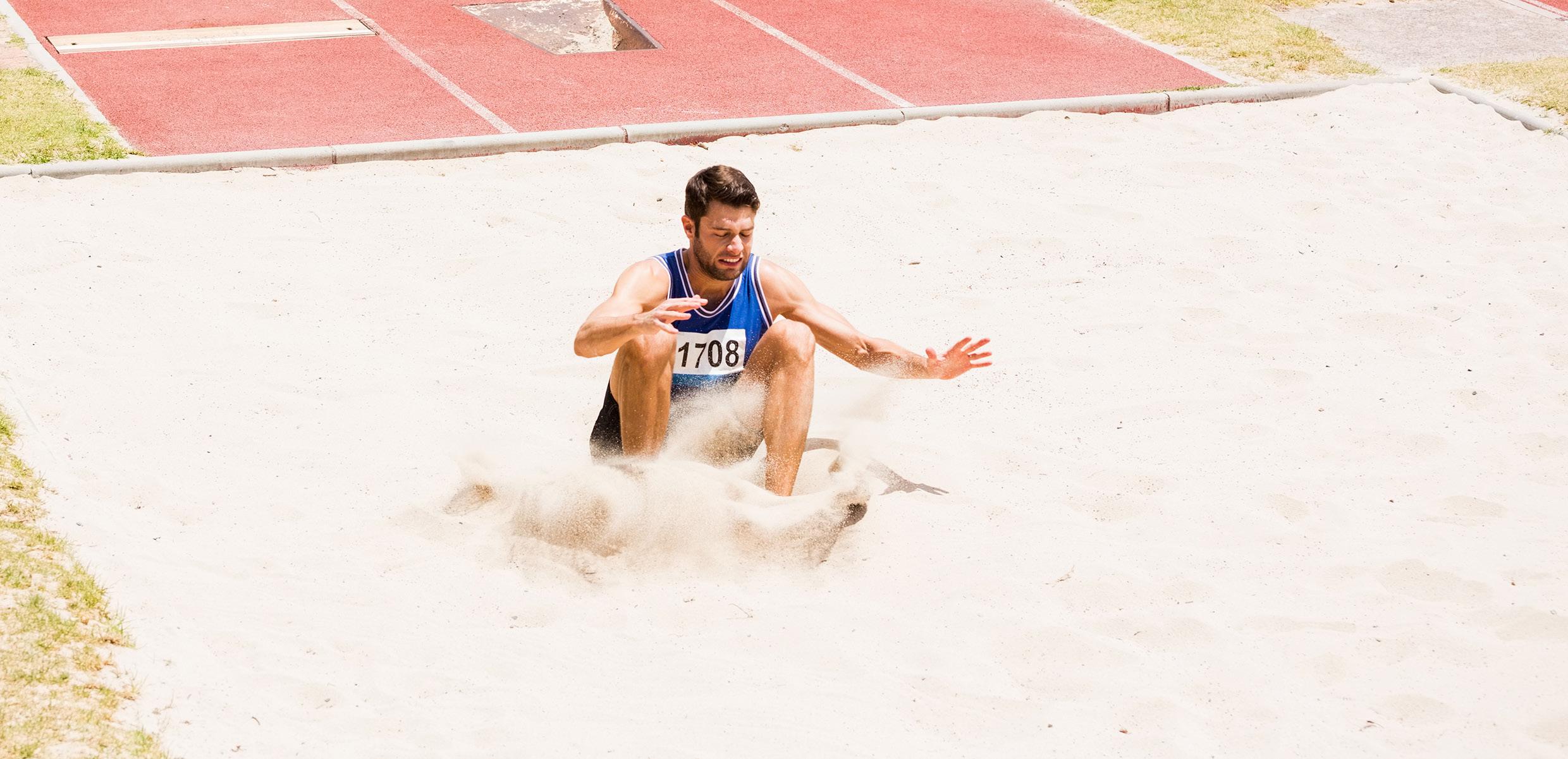
Task 3 – Justify your personal training strategy
Once you have evaluated the outcomes and limitations of your personal training strategy, you will need to justify whether your strategy, on balance, should be maintained or not. To do this you should consider which specific aspects of your training strategy should be maintained (i.e. are working and do not need refinement), which should be further developed (i.e. have potential but need refinement) and which should be completely modified (i.e. are not helping to optimise performance). It is essential that you use evidence from both primary and secondary data when justifying the modification or maintenance of the devised training program.
Example
George writes: "My primary data proves that my personal training strategy has optimised some aspects of my long jump performance, specifically power for the take-off as seen in training session data. However, as outlined in this folio, there are a few elements of the strategy that need to be improved. For this reason, I propose that my personal training strategy be further modified via reduction to the plyometrics training that led to extreme fatigue."
Task 4 – Evaluate and justify the effectiveness of your personal performance using body and movement concepts
Next, you are required to evaluate your overall personal performance of your selected physical activity, with a focus on the specialised movement sequences for two movement strategies from two principles of play (for "Invasion" and "Net and court" categories). To do this you will need to appraise the outcomes and limitations of your personal performance. You may choose two principles of play from the list below:
• setting up attack
• defending against an attack
• creating, defending and exploiting space
• attacking opposition space and scoring.
Your evaluation is required to consider two body and movement concepts in the evaluation of your performance – "quality of movement" and one other. See Source 4 for a breakdown of each body and movement concept. To maximise your chance of success, your evaluation should reference all relevant criteria from each body and movement concept. In addition to your overall judgment of the effectiveness of your personal performance, you will need to justify which specific aspects of your performance should be maintained, which should be further developed and which should be completely modified. Ensure you use primary and secondary date to support your justifications. It is important to note that this evaluation is separate to the evaluation you made of your personal tactical strategy. You can use information gathered from the same GPAIs, but you do not need to include your personal training strategy in this evaluation.
Body and movement concept
Quality of movement
• speed (e.g. fast, slow)
Criteria
• timing (e.g. in time, out of time)
• accuracy (e.g. on target, off target)
• effort (e.g. level of motivation)
• force (e.g. strong, light)
• fluency and flow (e.g. free, bound)
Body awareness
Space awareness
Relationships
• body parts (e.g. arms, legs, elbows, knees, head)
• body shape (e.g. stretched, curled, wide, narrow, twisted, symmetrical, asymmetrical)
• body action (e.g. flexion, extension, rotation, swing, push, pull, transfer of weight, stability)
• space (e.g. personal and general space)
• pathways of movement (e.g. curved, straight, zigzag)
• planes of movement (e.g. sagittal, frontal, horizontal)
• direction (e.g. forwards, backwards, sideways, up, down)
• levels (e.g. high, middle, low)
• people (e.g. alone, with partner, with group)
• equipment (e.g. bats, balls and other pieces of equipment; uniforms and supplies)
SOURCE 4 The four body and movement concepts
Internal assessment 3: Project – folio Planning guide
Category of physical activity:
‘Invasion’
‘Net and court’
Selected physical activity: Australian football
Body and movement concept 1:
Quality of movement
Body and movement concept 2:
Relationships
Criteria:
Speed (e.g. fast, slow)
Timing (e.g. in time, out of time)
Accuracy (e.g. on target, o target)
E ort (e.g. level of motivation)
Force (e.g. strong, light)
Fluency and flow (e.g. free, bound)
Criteria:
People (e.g. alone, with partner, with group)
Equipment (e.g. bats, balls and other pieces of equipment; uniforms and supplies)
Specialised movement sequences:
Leading, marking, handballing and kicking
Movement strategy 1:
Break through the defence by knocking the ball forward, handballing, kicking and running to space
Principle of play 1: Setting up attack
My personal rating:
Accomplished and proficient E ective
Competent
Variable or inaccurate
Evident criteria:
Accuracy, effort, fluency and flow, timing and speed
Supporting visual evidence: Clips that show how I break through the defence by leading into space with an outcome that is beneficial to the team (e.g. knocking a lost ball off the ground to a teammate, breaking away from defence to receive a handball or mark, moving into free space to kick a ball to a teammate).
My personal rating:
Accomplished and proficient
E ective
Competent
Variable or inaccurate
Evident criteria:
People (i.e. interaction with teammates and opponents)
Supporting visual evidence:
Clips that show how I read the opponent’s movement to perceive and act on affordances (e.g. choosing to kick the ball to an open teammate further up the field rather than handballing to a closer one who would be easily challenged, winning a physical contest –i.e. outmanoeuvring opponent –to take a mark).
Specialised movement sequences: Marking, handballing and kicking
Movement strategy 2:
Move the football into opponent’s defensive area to score
Principle of play 2: Attacking opposition goal and scoring
Evident criteria: My personal rating:
Accomplished and proficient E ective
Competent
Variable or inaccurate
Accuracy, force, development, continuity and outcome of movement, efficiency
Supporting visual evidence:
Clips that show that I have a high percentage of marks in front of the uprights and a high degree of goal accuracy (e.g. kicking effectively to a teammate for them to take a mark in reach of the uprights, optimising horizontal and vertical space and using force development by jumping to catch a mark in the scoring zone, fluently handballing on to a teammate who is free to kick for goal).
Evident criteria: My personal rating:
Accomplished and proficient E ective
Competent
Variable or inaccurate
People (i.e. interaction with teammates and opponents), equipment
Supporting visual evidence:
Clips that show that I use the opponent and the movement of the ball up the field to position myself effectively, creating affordances for my teammates so that I can mark their kick (e.g. moving to the left of the uprights and making myself seen, when the ball is travelling up the left hand side, successfully reading the irregular bounce of the ball to take possession).
SOURCE 5 This example shows how a student studying Australian football has demonstrated specialised movement sequences and two movement strategies from two principles of play. It also shows how the student has applied the body and movement concepts to evaluate their performance.
Study tip
Revisit and revise the body and movement concepts that were covered in Unit 1 of the QCE Physical Education syllabus by referring to Lesson 2.10 of Physical Education for Queensland Units 1 & 2.
Source 5 provides an example of how a student studying Australian football has demonstrated specialised movement sequences for two movement strategies from two principles of play. It also shows how the student has applied the body and movement concepts to evaluate their performance.
You will be expected to provide the same level of evaluation for your selected physical activity for your Project – folio. A template for this DCI is available to download.
Additional resource:: DCI template
Section 2 – Demonstrating and applying
The second section of your Project – folio requires you to collect video footage of your practical performance in your selected physical activity as evidence of your demonstrating and applying ability. Specifically, your video will be up to three minutes in length and will need to show evidence of your demonstration of two movement strategies from two principles of play. Do not exceed the three-minute time limit as any content included after three minutes will not be counted in the awarding of your grade.
Demonstration footage must show you applying these strategies in authentic performance environments, that is showing performance within game play or competition. Preferably, this footage will show complete plays, rallies and so on, rather than parts of plays. While it is a highlights reel of your best performances, your footage must show the full picture of your performance rather than repeated little snippets within rallies or game play to be considered effective.
Finally, your video must include demonstration of quality of movement concepts (speed, accuracy, force, flow and so on) and one other body and movement concept – either body awareness, space awareness or relationships.
If you completed the "Evaluating and justifying your personal performance" part of the assessment, you will need to identify the two different movement strategies from two different principles of play you wish to use. For example:
Principle of play
Setting up attack
Attacking opposition goal and scoring
Movement strategy
Break through the defence by knocking the ball forward, handballing, kicking and running to space
Move the football into opponent’s defensive area to score
To demonstrate effective (highly successful and consistent) and proficient (well advanced or expert) specialised movement sequences, you will need to have sufficient, sustained visual proof that shows relevant specialised movement sequences and variations of these skills. For example, a student demonstrating Australian football specialised movement sequences would include a selection of:
Principle of play
Setting up attack
Specialised movement sequences
• Leading (e.g. moving into space)
• Marking (e.g. from handballs and kicks)
• Handballing (e.g. various distances, bounce pass, using leftand right-hand passes)
• Kicking (e.g. drop punts of different heights and distance, torpedo, grubber)
Attacking opposition goal and scoring
• Marking (e.g. from handballs and kicks)
• Handballing (e.g. various distances, bounce pass, using leftand right-hand passes)
• Kicking for goal (e.g. snap shot, banana kick, set shot)
As your supporting evidence can only be up to three minutes long, you will need to choose the footage you include carefully. If applicable, you are permitted to re-use some of the footage you included in the folio; however, it is recommended you only do this if it reflects your typical, sustained performance.
If you need more visual evidence to meet the time requirements of your supporting evidence, select clips that show variations of specialised movement sequences with successful outcomes.

MODULE 4
Summary
Lesson 4.27
Review: Energy, fitness and training
Module summary: Module 4
• Energy is a term used to describe the power derived from fuels (i.e. food) by a range of systems and chemical reactions that take place in the body in order to produce movement.
• Fitness is a term used to describe the body’s ability to function efficiently and effectively.
• Training is a term used to describe the specific tasks and activities an athlete completes to enhance or improve their energy and fitness in their chosen physical activity.
• The study of energy, fitness and training in sport is known as exercise physiology.
• There are three main types of nutrients found in all foods. They are carbohydrates, protein and fats.
• The energy content of different nutrients is measured in kilojoules (kJ). Kilojoules are the unit used to measure the amount of chemical energy provided by various types of foods. This chemical energy is converted into mechanical energy for movement.
• Carbohydrates can be categorised as simple carbohydrates or complex carbohydrates. When carbohydrates are digested, a chemical reaction takes place and they are broken down into glucose.
• When proteins are digested, a chemical reaction takes place and they are broken down into amino acids. Amino acids can be categorised as essential amino acids and non-essential amino acids.
• When fats are digested, a chemical reaction takes place and they are broken down into fatty acids. Fats can be categorised as essential fatty acids and non-essential fatty acids.
• Adenosine triphosphate (ATP) is a complex molecule found in the cells of every living thing. ATP captures chemical energy from the breakdown of food molecules and releases it when needed in order to fuel a range of tasks, including moving the muscles.
• There are three main energy systems in the body that power ATP resynthesis and ensure that our body has the energy it needs to take part in physical activity: the ATP–PC system, the lactic acid system and the aerobic system.
• The ATP–PC system and the lactic acid system are anaerobic, meaning they don’t use oxygen to resynthesise ATP, while the aerobic system does.
• The ATP–PC energy system is used by the body for short, maximum-intensity activities that last between 10 and 15 seconds. The ATP–PC system resynthesises ATP quickly and efficiently due to the readily available stores of phosphocreatine (PC) in the muscles.
• Once PC stores in the muscles have been depleted after about 10 to 15 seconds, the lactic acid system becomes the predominant energy system and is typically used for high-intensity activities lasting approximately 60 to 90 seconds. The lactic acid system provides energy by using supplies of sugar circulating in the blood (as glucose) and stored in the muscles and liver (as glycogen).
• The aerobic system is typically used by the body for low- to moderate-intensity activities lasting longer than 90 seconds. The aerobic system produces the energy required to resynthesise ATP using the same chemical process used in the lactic acid system (i.e. glycolysis), but with the presence of oxygen.
• The term "fitness" refers to the condition of being physically fit and healthy, and a person’s ability to participate effectively in a particular sport or physical activity.
• There are seven components of fitness: aerobic capacity, power, strength, speed, agility, muscular endurance and flexibility.
• Athletes use fitness tests, which measure and test the components of fitness, in order to develop and implement personalised training strategies.
• The body systems involved in oxygen uptake and delivery during physical activity are the respiratory system, the circulatory system and the muscular system.
• The stress put on the body during training causes a number of changes to occur in the body. Some of these changes are immediate, and are known as acute physiological adaptations (e.g. increased heart rate [HR], increased respiratory rate [RR] and increased muscular temperature); others take place over a longer period of time, and are known as chronic physiological adaptations (e.g. increased number of lung capillaries, increased size and strength of heart, increased muscle mass).
• An athlete’s maximal oxygen uptake is commonly referred to as VO2 max. VO2 max is impacted by the efficiency of the cardiovascular and respiratory systems, including factors such as lung capacity, stroke rate and cardiac output.
• The intensity at which lactate begins to accumulate in the blood is known as the lactate threshold. The lactate threshold for an average athlete is reached at around 80 to 85 per cent of their maximum heart rate (MHR). If the intensity of physical activity is not reduced at this point, a more pronounced accumulation in blood lactate occurs, known as the lactate turn point (LTP). When the LTP is reached, muscle fibres can be prevented from contracting properly, causing fatigue.
• Athletes use training programs to plan, implement and evaluate training.
• Before designing a training program, athletes should perform a game analysis and identify training objectives.
• A training program is written on many levels over different time periods with increased detail. The time periods are annual plan, macrocycles, training phases, mesocycles, microcycles and training sessions.
• Training programs should consider game analysis, training objectives, work volume, training load, tapering and recovery.
• A training zone is a range that indicates the upper and lower limits of intensity for training.
• There are four major training zones: the recovery training zone, the aerobic training zone, the lactate threshold training zone and the anaerobic training zone.
• The principles of training are guidelines that help to ensure that athletes get the most value and benefit out of their training and are able to achieve their training objectives.
• The eight principles of training are: progressive overload, frequency, reversibility, intensity, duration, specificity, individuality and variety.
• Training methods are forms of exercise that athletes can use to target different components of fitness and optimise particular aspects of their performance.
• Continuous training is a form of exercise performed at the same intensity for an extended period of time without rest.
• Fartlek training is a form of continuous training that enhances aerobic capacity by athletes varying the intensity of their exercise through increasing their speed and/or increasing their resistance.
• Resistance training is a form of exercise that requires an athlete to work against something (e.g. weights) that resists the movement of their body or specific parts of their body (e.g. arms, legs, particular muscles).
• There are four types of resistance training: isotonic (dynamic) resistance training, isometric (static) resistance training, isokinetic resistance training and plyometric training.
• Interval training is a form of exercise that uses alternating periods of work with periods of rest to enhance specific components of fitness and target particular energy systems.
• There are three main types of interval training: high-intensity interval training (HIIT), sprint interval training (SIT) and aerobic interval training (AIT).
• Flexibility training is a form of exercise that involves stretching the muscles, tendons and ligaments in and around joints.
• There are four main types of flexibility training: dynamic flexibility training, static flexibility training, passive flexibility training and proprioceptive neuromuscular facilitation (PNF) flexibility training.
• Circuit training involves a series of exercises that are performed in a consecutive rotation, with minimal rest periods in between.
• Fatigue is defined as the reduction in the efficiency of a muscle or organ that occurs when the body is placed under physical stress.
• Recovery is defined as the process of an individual returning to their normal physiological state after a period of physical activity. There are two types of recovery: intra-session recovery and inter-session recovery. Recovery can also be active or passive.
• General Adaptation Syndrome (GAS) explains that the human body adapts when the right amount of stress is applied and then removed.
• The fitness–fatigue model explains that there is an optimal window for training after a previous session when the body has recovered from fatigue and made physiological adaptations and before they begin losing these gains through too much rest.
• The process of breaking down a training program into smaller and smaller blocks so that energy, fitness and skill can be built over time is called periodisation.
• The annual plan is a term used to describe an athlete’s planning over a 12-month period.
• An annual plan can consist of one or more macrocycles. "Macrocycle" is a term used to describe the time from when an athlete starts to train for a season or event, to the completion of their post-season or postevent recovery.
• Each macrocycle is divided into four training phases, each with its own goals for energy and fitness development.
• The preparatory phase is when the athlete focuses on increasing their general level of fitness.
• The pre-competition phase is when the athlete focuses on optimising their energy, fitness and skill levels for their specific sport, position and/or event.
• The competition phase is when the athlete focuses on maintaining their energy, fitness and skill levels for their specific sport, position and/or event and maximising their performance in authentic game or performance environments.
• The transition phase is when the athlete focuses on rest and recovery from the physical and mental stress of training and competition.
• Each training phase is divided into a series of 4- to 6-week blocks known as mesocycles.
• Mesocycles can be divided into shorter blocks, usually 7 to 10 days in length, called microcycles.
• Each microcycle consists of around three training sessions.
• A training session has three phases: the warm-up phase (which should apply the RAMP warm-up), the conditioning phase and the cool-down phase.
• A game analysis allows an athlete to study the demands on movement patterns, energy, fitness and skills, as well as strategy and tactics, and to recognise areas where they should focus their attention in order to improve their overall performance.
• Training objectives are the specific energy, fitness and skill goals that athletes aim to achieve through the implementation of their training program.
• When drawing up a training session plan, athletes should include: general information such as date, time and phase of training; training session objectives such as energy, fitness and skill objectives; warm-up, cool-down and conditioning activities; and data collection and reflection.
Review questions 4.27 Exam-style revision questions and tasks
Section 1
• Ten multiple-choice questions
Question 1
The ATP–PC energy system
A peaks at 30 seconds when athletes work maximally from the outset.
B uses fat to resynthesise ATP.
C is the predominant supplier of energy in high jump.
D is the best energy source because it is in abundant supply.
Question 2
The lactic acid system
A produces a fatiguing by-product.
B is the main source of energy for a triathlete.
C should be avoided by athletes.
D uses protein as a fuel source.
Question 3
Lactate threshold is best described as the level of intensity where
A oxygen consumption meets oxygen demand and onset of blood lactate occurs.
B oxygen consumptions does not meet oxygen demand and onset of blood lactate occurs.
C lactic acid is oxidised and prevented from accumulating.
D respiration decreases to reduce the lactate build-up in the muscles.
Question 4
Work volume is
A a combination of frequency and duration.
B a combination of frequency and intensity.
C a combination of overload and duration.
D a combination of repetitions and sets.
Question 5
The principle of individuality considers
A the energy and fitness requirements of the physical activity.
B the inclusion of a range of movement options in training.
C the need for an increase in training load.
D the fitness levels of the athlete.
Question 6
A netball goal shooter mostly requires
A speed, agility and power and predominantly uses their ATP–PC and aerobic systems.
B speed, agility and power and predominantly uses their lactic acid and aerobic systems.
C speed and muscular endurance and predominantly uses their aerobic system.
D aerobic capacity, strength and power and predominantly uses their ATP–PC system.
Question 7
In resistance training, 3 × 15 × 20RM with a 3-second repetition duration would most likely target which of the following fitness components?
A strength
B muscular endurance
C speed
D power
Question 8
Progressive overload in a circuit training session can be achieved by
A decreasing the intake of carbohydrates.
B increasing the variety of stations.
C increasing the time or repetitions at each station.
D decreasing the number of repetitions and sets.
Question 9
The best example of SIT listed below is
A 2 × 2 × 1000 m runs with a W:R ratio of 1:1 and RPE 6–7.
B 2 × 4 × 600 m runs with W:R ratio of 1:2 and RPE 4–5.
C 2 × 6 × 100 m runs with W:R ratio of 1:4 and RPE 8–9.
D 2 × 8 × 20 m runs with W:R ratio of 1:1 and RPE 4–5.
Question 10
According to the theory of periodisation, if an athlete wanted to create a training program starting with the longest period of time and get progressively more detailed, in which order should she attack the various cycles and phases in her training program?
A Annual plan, training phases, macrocycles, microcycles, mesocylces, training sessions
B Annual plan, macrocycles, mesocycles, microcycles, training phases, training sessions
C Annual plan, mesocycles, macrocycles, training phases, training sessions, microcycles
D Annual plan, macrocycles, training phases, mesocycles, microcycles, training sessions
Section 2
• Three short-response questions
Stimulus 1
An athlete shown during a training session
Question 11 (10 marks)
Use Stimulus 1 to infer the types of acute physiological adaptations that the athlete has experienced in response to his training and explain the reasons for these adaptations.
Stimulus 2
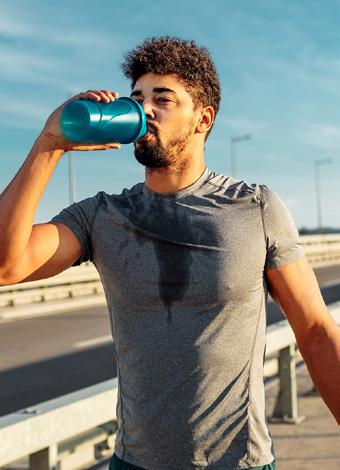
An incomplete training session plan is shown below.
Warm-up
Conditioning phase
10 × 30m (20 m forwards, 10 m backwards) sprints 90% intensity (1:4) (5 min)
3v1 Rucking drill (defender runs backwards continuously at a steady pace; ruck must make 3 touches before defender reaches 30 m mark) high intensity (1:4) (15 min)
3v2 touch game (20 × 20 m grids); team of 3 has 3 touches to score. Rotate attackers and defenders and continue (20 min)
4v4 touch game (50 m × 50 m grids) –continuous game (normal touch rules) (20 min)
Cool-down Jog to collect up all markers then run them around the touch field. Stretches (dynamic and PNF stretches)
Question 12 (12 marks)
Analyse Stimulus 2 and apply the RAMP approach to devise a warm-up that would adequately prepare
the athlete for the training activities proposed in this session. Justify the design of your warm-up.
Stimulus 3
Volleyball is a fast-paced physical activity that requires players to develop specific components of fitness to be successful. An image taken during a game of volleyball is shown here.
Question 13 (14 marks)
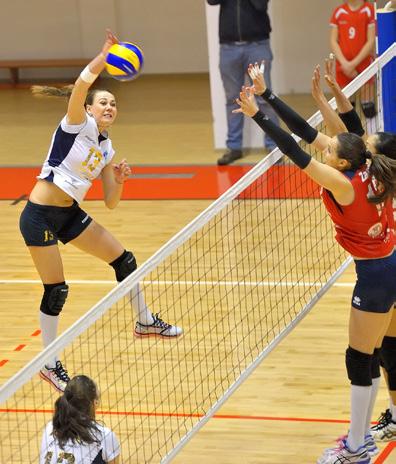
Analyse Stimulus 3 and identify the components of fitness this athlete needs to complete this movement successfully and optimise her chances of scoring a point. Justify your selection, referring to the features of the movement and your understanding of the components of fitness.
Section 3
• One extended-response question
Stimulus 4
The data shown below was collected during a 14-minute game analysis of an "Invasion" physical activity played in the pre-competition phase. It shows the percentage of MHR for two athletes marking each other over time.
Question 14 (25 marks)
Use the data provided in Stimulus 4 to design a training strategy for Player A in an "Invasion" physical activity of your choice. The training strategy must aim to develop Player A’s energy and fitness needs as they approach their competition phase.
Describe your training strategy design, the specialised movement sequences and movement strategies included to target your selected sport.
Practice assessment task
This practice assessment task was prepared according to the specifications in the Physical Education 2025 v1.2 General Senior Syllabus. It has not been endorsed by the QCAA. The category selected for the physical activity must be different from the category selected for IA1.
Subject Physical Education
Instrument number IA3 (i.e. Internal assessment 3)
Technique
Unit
Topic
Duration
Mode
Length
Individual / group
Other
Project – folio
4 Energy, fitness and training in physical activity
1 Energy, fitness and training integrated in physical activity
Conditions
5 hours
Multimodal – at least two modes (visual, written, spoken) delivered at the same time and integrated so that each mode contributes significantly to the response
Section 1 – Folio: up to 11 minutes
Section 2 – Visual evidence: up to 3 minutes
Individual
Examples of multimodal presentations include:
• a pre-recorded presentation submitted digitally
• a presentation conducted in front of an audience
• a digital portfolio of video, images and diagrams
• a multimedia movie or slideshow.
Schools implement authentication strategies that reflect QCAA guidelines for ensuring student authorship.
Context
Throughout this unit, you have engaged in integrated learning experiences about energy, fitness, training and the application of body and movement concepts in a range of physical activity environments. To optimise your personal performance in your selected physical activity, you have explored energy systems, components of fitness, principles of training, training methods and training phases.
Task
Devise a training strategy for optimising performance of the specialised movement sequences and on movement strategy in you selected physical activity. Evaluate and justify the effectiveness of your personal training strategy. To complete this task, you must:
• analyse primary data and secondary data to ascertain the most significant relationships between the
– demands of the specialised movement sequences for the selected movement strategy
– energy systems and fitness components relevant to the specialised movement sequences for the selected movement strategy
– personal performance of the demonstrated specialised movement sequences for the selected movement strategy
• synthesise the most significant relationships to devise a personal training strategy to optimise personal performance of the specialised movement sequences for the selected movement strategy
• justify the development of the personal training strategy for the selected movement strategy to optimise performance, using evidence from primary data and secondary data
• evaluate the effectiveness of the personal training strategy using selected principles of training to appraise the outcome and limitations
• justify the modification and maintenance of the training strategy for one movement strategy to optimise performance, using evidence from primary data and secondary data
• make decisions about and use language, conventions and mode-appropriate features to communicate information about the strategies to a technical audience
• record visual personal performance evidence in an authentic performance environment.
• Visual evidence will illustrate
demonstration of specialised movement sequences and two movement strategies (from two different principles of play for physical activities from the "Invasion" or "Net and court" categories) in authentic performance environments
application of quality of movement and one other body and movement concept to the performance of specialised movement sequences and two movement strategies (from two different principles of play for physical activities from the "Invasion" or "Net and court" categories) in authentic performance environments.
It is recommended that this task is designed so that students can develop a response in approximately 5 hours of class time.
Detailed instructions for this task (including a copy of the ISMG) are available for teachers to download
Revision and exam preparation MODULE 5

Introduction
This module contains a range of information and practical tips to help you thoroughly revise the subject matter in Unit 4: Energy, fitness and training in physical activity, and prepare you for the Examination – Combination response. It is important to prepare well and ensure you have all the information you need to perform at your best under exam conditions.
This module is divided into 14 lessons (including Skill drills). Each lesson is designed to target specific areas from the subject matter dot points included in the syllabus. Lessons include:
• Key concepts – a brief summary of one or more key concepts (or subject matter dot points) covered in Unit 4 – Energy, fitness and training in physical activity
• Find it here! – a handy reference table to help you locate the information you need to revisit and revise in Unit 4 – Energy, fitness and training in physical activity
• Retrieve and apply – a graded activity designed to test your knowledge and understanding of particular concepts (or subject matter dot points)
• Practice exam – a complete practice examination paper (featuring multiple-choice, short-response and extended-response questions) focused on one or more key concepts (or subject matter dot points) covered in Unit 4 – Energy, fitness and training in physical activity
• Skill drill – an integrated physical performance activity designed to help you make clear links between the theory covered in each section and your own physical performance (including opportunities to gather primary data).
This module has been designed and structured so that you can approach it flexibly, depending on how your teacher has structured your lessons over the course of Unit 4. Best of luck with the exam.
Lesson 5.1
Revision: Energy requirements for physical activity and energy systems
Key ideas
→ Review of key concepts in energy requirements for physical activity and energy systems.
Key concepts
Let’s start by reviewing the following key concepts from the syllabus. This lesson focuses on energy requirements for physical activity and energy systems.
Energy requirements for physical activity
The human body requires energy to engage in physical activity. This energy comes from the foods we eat in the form of nutrients. There are three main types of nutrients found in all foods. They are:
• carbohydrates – stored in limited supply as glycogen, carbohydrates are an ideal source of energy because they break down easily. The body can store enough glycogen to last for 60 minutes of vigorous exercise or 90–120 minutes of moderate-intensity activity. Carbohydrates are often the first source of fuel used in moderate- to high-intensity activity due to the speed of breakdown. Carbohydrate food sources include grains (e.g. breakfast cereals), starchy vegetables (e.g. potatoes and peas), sugars, fruits and dairy products
• fats – stored as fatty acids in abundant supply, fats are an ideal source of energy for low- to moderate-intensity activity. They take longer to metabolise for energy than carbohydrates but have the benefit of lasting for longer periods of time. For this reason, fats are usually only used during low-intensity physical activity. Fat food sources include oils, nuts, dairy products (e.g. milk, cheese), avocados, some cuts of meat and oily fish
• protein – stored as amino acids, proteins are generally used for muscle growth and repair rather than as an energy source due to the length of time it takes to metabolise them for energy. For this reason, protein is only used as an energy source during periods of prolonged starvation. Protein food sources include meat, eggs and dairy products, as well as grains, legumes, nuts and seeds.
Nutrients from the food we eat are not directly responsible for providing the energy that facilitates movement in working muscles. For this, a chemical compound called adenosine triphosphate (ATP) is required. ATP is not found abundantly in our bodies and must be repeatedly resynthesised to continue to supply the body’s energy needs. This resynthesis occurs through the body’s energy systems and is fuelled by carbohydrates, protein and fats.

SOURCE 1 Nutrients in food provide the energy that the human body needs to engage in physical activity.
Energy systems
There are three energy systems that work to facilitate ATP resynthesis:
• the ATP–PC system – used when high-intensity physical activity lasts less than 10–15 seconds (e.g. a 100-metre sprint or a fast break in basketball)
• the lactic acid system – used when moderately high-intensity physical activities last longer than 15 seconds and less than 60–90 seconds (e.g. a 200-metre freestyle swim or repeated fast breaks in soccer)
• the aerobic system – used when physical activity is moderately low in intensity and can last for an indefinite amount of time (e.g. a marathon, rest breaks in netball or a winger, without the ball, jogging up the sideline in touch).
ATP–PC system 10–15 seconds at high intensity (e.g. 100 m sprint)
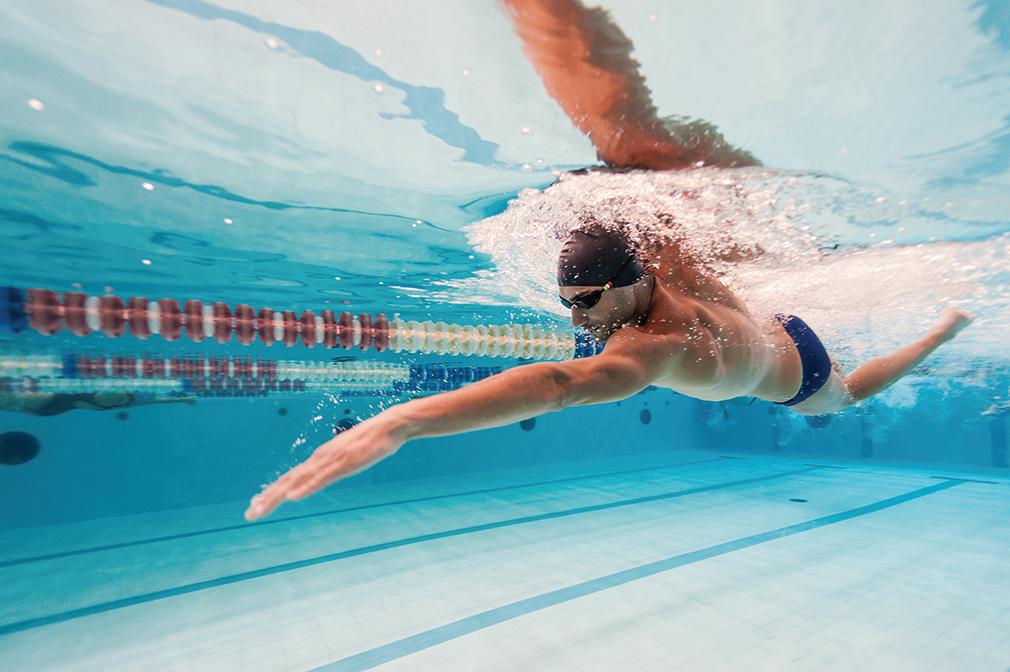
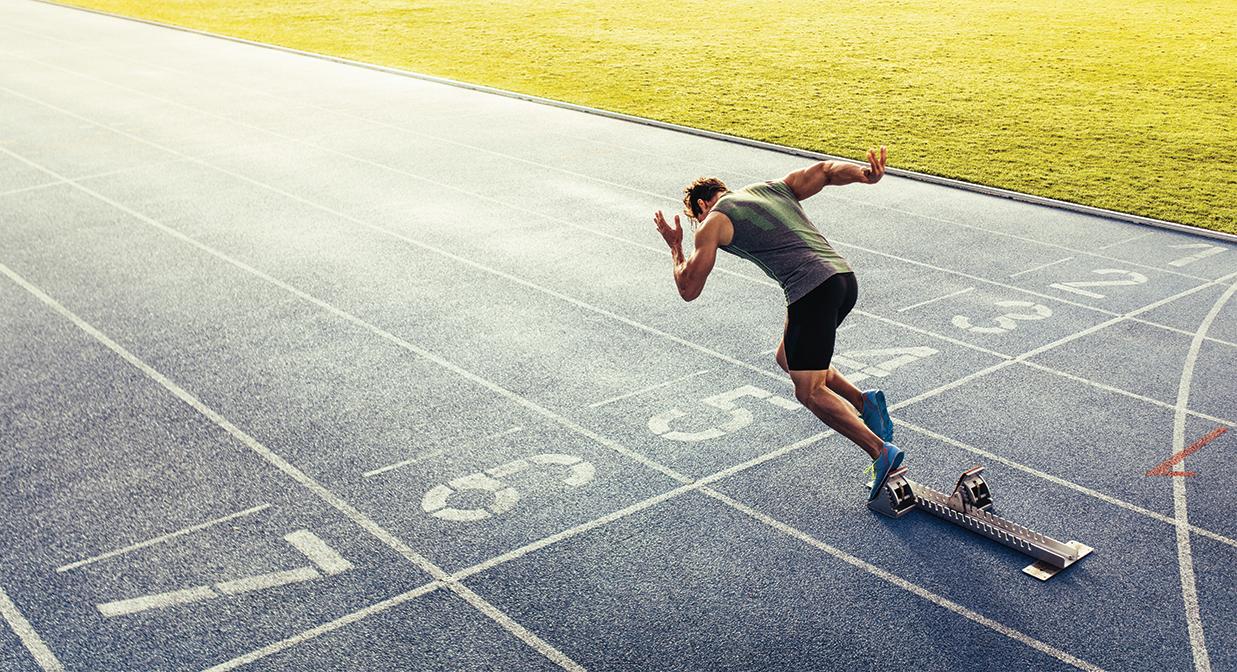
Aerobic system
Indefinite at low-moderate intensity (e.g. marathon)
The intensity and duration of the physical activity, as well as an individual’s fitness, determine which energy system or combination of systems is used at any given time. In many activities, there is interplay between the three energy systems. Each energy system contributes to a share of the energy production over the course of the physical activity, but at different times. Which system is used at any given time is dependent on the needs of the individual and the specific circumstances of their performance.
Lactic acid system 60–90 seconds at moderate–high intensity (e.g. 200 m freestyle)
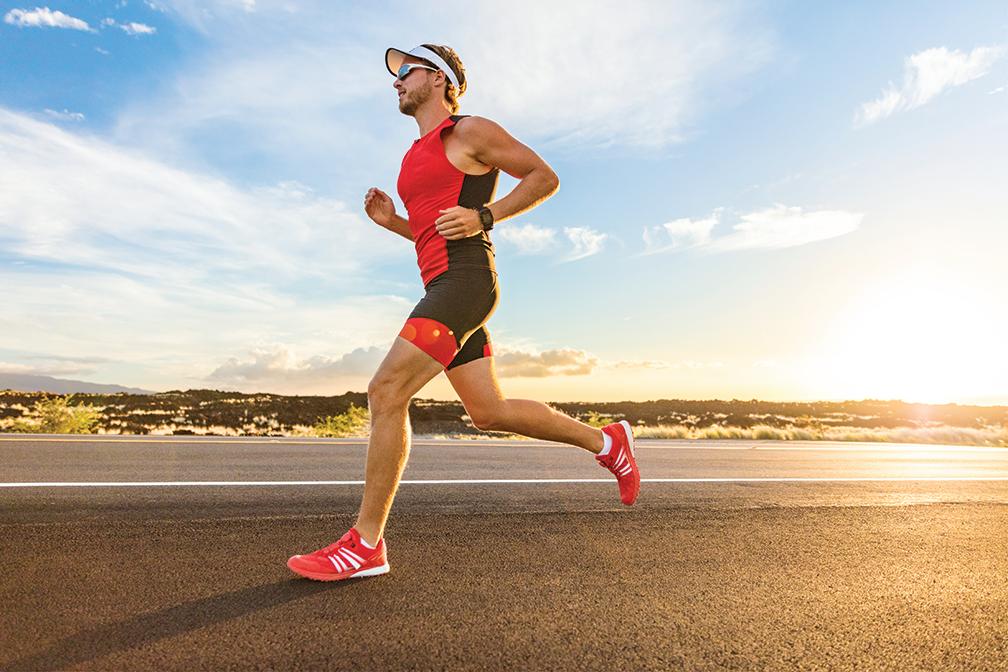
SOURCE 2 Three energy systems work together to facilitate ATP resynthesis: the ATP–PC system, the lactic acid system and the aerobic system.
Find it here!
For exam success, you will need to know about the concepts discussed above in detail. You will also need to be prepared to respond to questions on them. If any of these concepts are unclear or unfamiliar to you, you can revisit and revise them using the table below.
Subject matter
Introduction to energy, fitness and training
Energy requirements for physical activity
Energy systems used in physical activity
Lesson
Lesson 4.1 Introduction to energy, fitness and training (page 178)
Lesson 4.2 Energy requirements for physical activity (page 181)
Lesson 4.3 Energy systems used in physical activity (page 189)
Retrieve and apply!
To perform well on the exam, you will need to be able to retrieve the subject matter content listed in Unit 4 of the QCE Senior Physical Education Syllabus – Energy, fitness and training in physical activity. You will also need to be able to apply higher-order thinking skills to respond to more complex questioning. Remember, success is in the detail!
To see how well you can retrieve and apply key concepts about energy requirements for physical activity and energy systems, complete the following questions in Source 3. Answers for these tasks are available to teachers, so ask your teacher for them if you wish to check your responses.
Question type
Multiple choice question
Retrieve it!
Which of the following statements correctly describes the role of the aerobic energy system during physical activity?
• It relies primarily on creatine phosphate as a fuel source for short bursts of high-intensity exercise.
• It can sustain energy production for hours by using carbohydrates and fats in the presence of oxygen.
• It is the dominant energy system used during maximal efforts lasting less than 10 seconds.
• It produces energy without the need for oxygen, making it ideal for high-intensity activities.
Find it!
Lesson 4.2
Energy requirements for physical activity (page 181) and Lesson 4.3 Energy systems used in physical activity (page 189)
Mark it!
Total: 1 mark
Select the correct option.
Shortresponse question
Compare and contrast the anaerobic and aerobic energy systems in terms of their characteristics, duration of energy production, and fuel sources. Provide specific examples of physical activities that primarily use each system.
Lesson 4.2 Energy requirements for physical activity (page 181) and Lesson 4.3 Energy systems used in physical activity (page 189)
Total: 10 marks
For full marks on this question, you will need to:
• describe the characteristics of the anaerobic energy system: description of key features (1 mark) duration of energy production (1 mark)
• identify the fuel sources for the anaerobic energy system (2 marks)
• describe the characteristics of the aerobic energy system: description of key features (1 mark) duration of energy production (1 mark)
• identify the fuel sources for the aerobic energy system (2 marks)
• provide examples of activities for each system:
specific examples for anaerobic activities (1 mark) specific examples for aerobic activities (1 mark).
Question
Extendedresponse questions
During a 90-minute soccer match, players exhibit varying levels of intensity. In the first half, the team maintains a steady pace, focusing on ball control and strategic positioning. As the match progresses into the second half, the intensity increases with frequent sprints and quick changes in direction. In the final 15 minutes, players show signs of fatigue, and their pace slows down.
• First half (0–45 minutes): Players cover an average of 5 kilometres at a moderate pace.
• Second half (46–75 minutes): Players perform more high-intensity sprints, covering an additional 3 kilometres.
• Final 15 minutes (76–90 minutes): Players cover 2 kilometres at a reduced pace due to fatigue.
Based on the scenario and data provided, analyse the impact of the energy system and fuel source changes on performance throughout the soccer match. Consider the following points in your response:
1. Identify which energy systems are predominantly used during each phase of the match.
2. Discuss how the body's fuel preferences might shift as players transition from moderate to high intensity and then to fatigue.
3. Explain how these changes can impact player performance.
Lesson 4.2 Energy requirements for physical activity (page 181) and Lesson 4.3 Energy systems used in physical activity (page 189)
Total: 20 marks
For full marks on this question, you will need to:
1. Correctly identify the energy systems in the:
– first half (2 marks)
– second half (2 marks) – final 15 minutes (2 marks).
2. Explain the fuel sources used in the: – transition from moderate to high intensity (4 marks)
– transition to fatigue state (4 marks).
3. Explain the impact on player performance:
effects on performance (3 marks) – physiological reasons for these effects (3 marks).
SOURCE 3 Complete these tasks to see how well you can retrieve and apply key concepts in energy requirements for physical activity and energy systems.
Practice exam
Practice exam 5.1
Study tip
Remember to revisit Module 1 when you begin revising for the Examination –combination response.
Lesson 1.7 Tips for success on the Examination –combination response (page 17) contains helpful information about the structure of the exam, as well as tips on:
• the types of questions you will be expected to answer
• how to answer different types of questions
• the importance of cognitive verbs.
Now that you have tested your understanding of the key concepts relating to energy production and energy systems, it’s time to put your learning to the test by completing Practice exam 5.1.
Practice exam 5.1 only includes questions relating to energy requirements for physical activity and energy systems. It is structured and formatted in a similar way to the official QCAA Examination – combination response:
• Section 1 – multiple-choice questions
• Section 2 – short-response questions
• Section 3 – extended-response question.
You can use the practice exam in any way you like. If you feel confident with the subject matter, you might only complete a few questions from each category. If you feel that you need extra practice, you may wish to complete all the questions. Answers are available to teachers, so ask your teacher for them if you wish to check your responses.
Lesson
5.2
Evaluate how effective a training session is in developing a specific energy system
Aim
To evaluate the effectiveness of a training session at targeting the development of a particular energy system.
Time
One lesson (i.e. 60 minutes) with additional time (if required) to complete the analysis and discussion tasks.
Equipment
• Four markers
• Running track or oval
• Stopwatch
• Heart rate monitor
• Game Performance Assessment Instrument 15 (GPAI 15)
• Clipboard
• Pen
Game Performance Assessment Instrument 15 (GPAI 15)
Method
Step 1
Using a heart rate monitor, measure your resting heart rate and record it using GPAI 15.
Step 2
Form pairs and participate in a teacher-led warm-up.
Step 3
• Set markers at intervals of 0, 10, 20 and 40 metres around a running track or oval.
• Student A in each pair performs the following three sets; Student B keeps time and records the results in GPAI 15.
Set 1:
• Student A performs 6 × 10-metre sprints at 100 per cent intensity (back and forth between the first and second markers). Allow 10 seconds rest between each sprint.
• Immediately after Set 1 is complete, Student B records Student A’s heart rate.
• Student A rests for 1 minute before commencing Set 2.
Set 2:
• Student A performs 6 × 20-metre sprints at 100 per cent intensity (back and forth between the first and third markers). Allow 20 seconds rest between each sprint.
• Immediately after Set 2 is complete, Student B records Student A’s heart rate.
• Student A rests for 1 minute before commencing Set 3.
Set 3:
• Student A performs 6 × 40-metre sprints at 100 per cent intensity (back and forth between the first and fourth markers). Allow 30 seconds rest between each sprint.
• Immediately after Set 3 is complete, Student B records Student A’s heart rate.
• After 30 seconds, Student B records Student A’s heart rate again.
Resting
Student name:
immediately after Set 1
Based on your heart rate, state your training zone at the end of:
Set 1 _________________________________________
Set 2
Set 3
SOURCE 2 GPAI 15
Step 4
Students swap positions with their partner; Student B performs Step 3 (Sets 1–3).
Analysis and discussion
1 Identify the training method used in the conditioning phase.
2 Use your heart rate data to determine which training zone you were in during each set. Record this information in GPAI 15.
3 For each training zone, identify and record which energy systems were predominantly used.
4 Synthesise your primary data and secondary data on energy systems to evaluate how effective this conditioning phase was at targeting the intended energy system for you as an athlete.
immediately after Set 2
immediately after Set 3
You may wish to consider factors such as your heart rate range, training intensity, duration of work efforts and the work:rest (W:R) ratio.

SOURCE 1 Many fitness trackers and smart watches include a heart rate monitor.
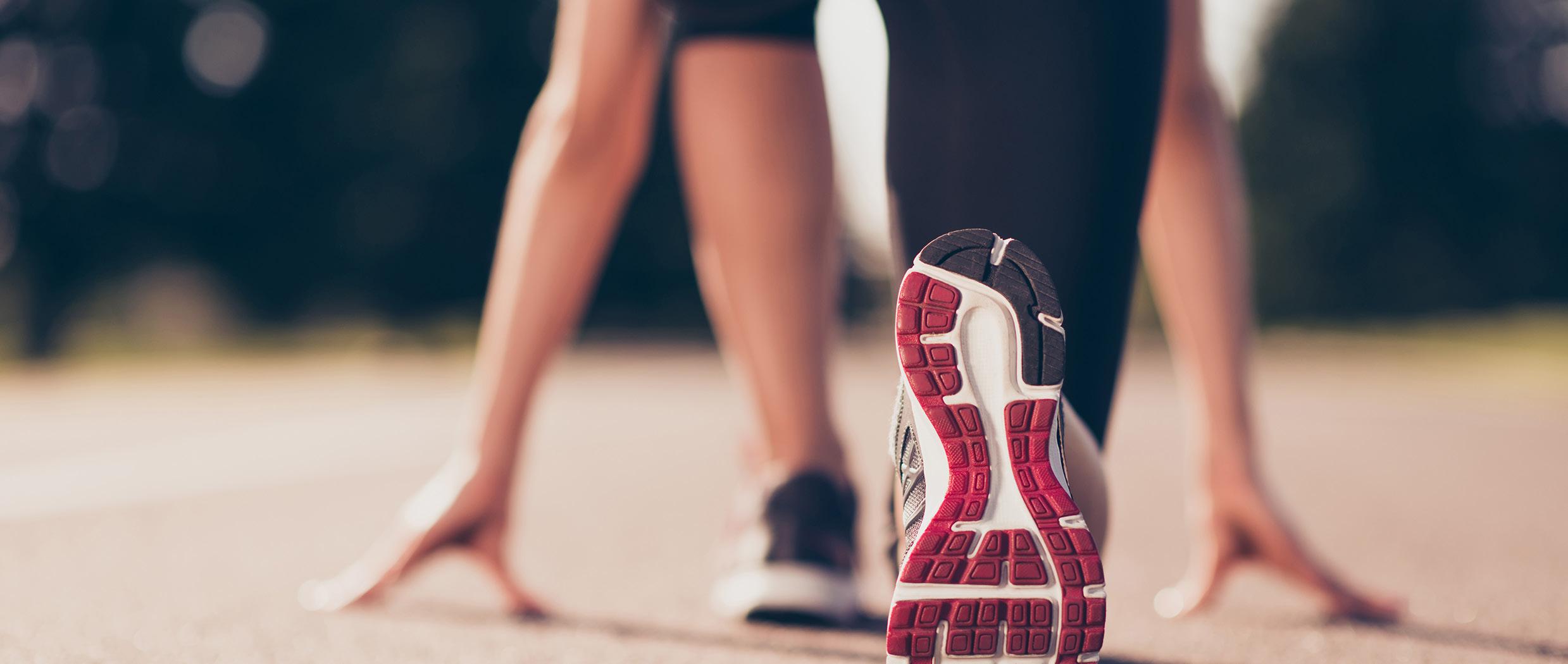
SOURCE 3 Heart rate data can help athletes determine what training zone they are working in and whether the intended energy systems are being targeted.
Lesson 5.3
Revision: Fitness requirements for physical activity
Key ideas
→ Review of key concepts in fitness requirements for physical activity.
Key concepts
Let’s start by reviewing the following key concepts from the syllabus. This lesson focuses on fitness requirements for physical activity.
Components of fitness
Fitness is the ability of an athlete to perform a range of specialised movement sequences for movement strategies:
• at an appropriate intensity
• for an appropriate length of time.
It is important to consider the broad spectrum of fitness requirements relevant to a specific sport, position or event to build a fitness profile. A fitness profile involves the consideration of the seven components of fitness:
• aerobic capacity – the ability of the heart, lungs and circulatory system to supply oxygen and other nutrients to working muscles so that an athlete can exercise continuously for extended periods without tiring
• power – the ability to exert maximum force in the shortest amount of time
• strength – the ability of a muscle (or muscles) to exert force by contracting against a resistance
• speed – the ability to move the entire body (or specific parts of the body) quickly
• agility – the ability to move the entire body (or specific parts of the body) from one position to another, or from one direction to another, quickly and precisely
• muscular endurance – the ability to sustain or repeat a series of muscle contractions without fatigue
• flexibility – the ability of a joint to move through its full range of motion.
For an athlete to build a fitness profile, they must complete a series of traditional and/or specialised fitness tests for each fitness component. Recorded results can then be compared to norms or to previous test results to determine where strengths and weaknesses lie or to monitor improvement over time. An athlete’s fitness objectives can have an impact on the type of training they will need to undertake.
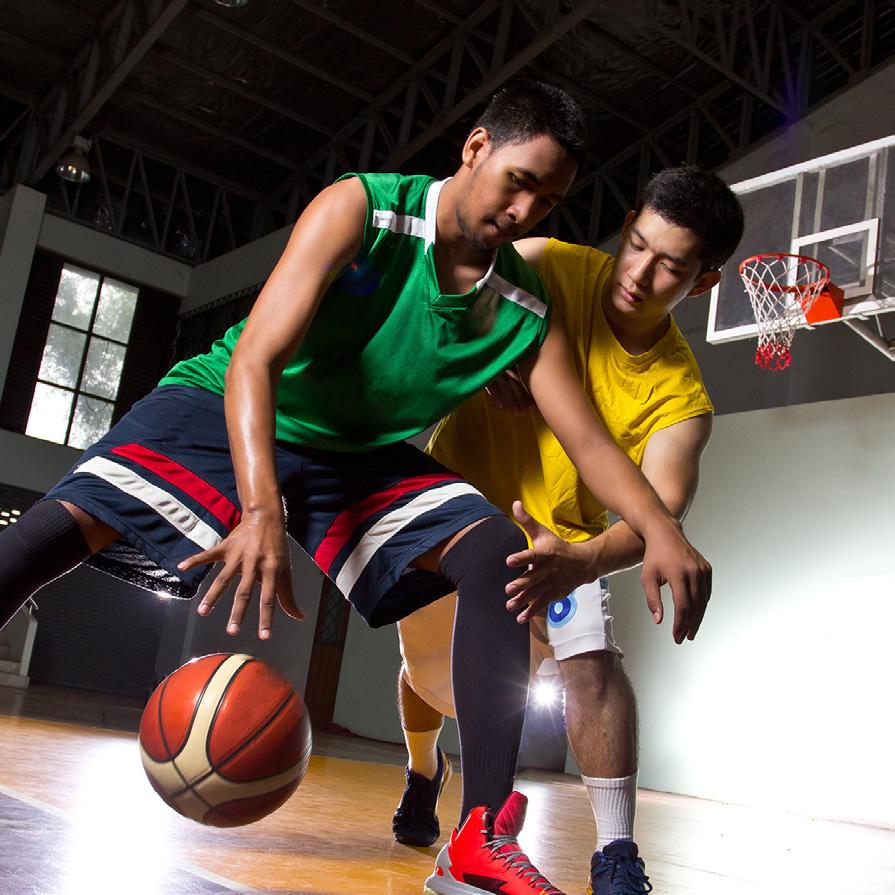
SOURCE 1 Like most athletes, basketball players need to use all seven components of fitness at different times of a training session or match.
Question type
Multiplechoice question
Shortresponse question
Find it here!
For exam success, you will need to know about the concepts discussed above in detail. You will also need to be prepared to respond to questions on them. If any of these concepts are unclear or unfamiliar to you, you can revisit and revise them using the table below.
Subject matter Lesson
Fitness requirements for physical activity
Retrieve and apply!
Lesson 4.4 Fitness requirements for physical activity (page 200)
To perform well on the exam, you will need to be able to retrieve the subject matter content listed in Unit 4 of the QCE Senior Physical Education Syllabus – Energy, fitness and training in physical activity. You will also need to be able to apply higher-order thinking skills to respond to more complex questioning. Remember, success is in the detail!
To see how well you can retrieve and apply key concepts in fitness requirements for physical activity, complete the following questions in Source 2. Answers for these tasks are available to teachers, so ask your teacher for them if you wish to check your responses.
Retrieve it!
Which fitness component is most critical for a tennis player when quickly changing direction to return a shot?
A Muscular strength
B Flexibility
C Agility
D Cardiovascular endurance
The 1500 m race is a middledistance event typically completed in 3 to 6 minutes, depending on the athlete's ability level. Often, athletes fight early on for a good race position before settling into a consistent pace. Finally, they will need to finish strongly to beat opponents at the finish line. Analyse the importance of different fitness components in a 1500 m race. Discuss how cardiovascular endurance, muscular endurance, and speed contribute to an athlete's performance in this event. Provide examples of how each component is utilised during the race.
Find it!
Lesson 4.4 Fitness requirements for physical activity (page 200)
Mark it!
Total: 1 mark
Select the correct option.
Lesson 4.4 Fitness requirements for physical activity (page 200)
Total: 7 marks
For full marks on this question, you will need to:
• explain the role of aerobic capacity in maintaining a steady pace throughout the race (1 mark)
• explain the impact on overall race performance (1 mark)
• explain the importance of muscular endurance in resisting fatigue during the race (1 mark)
• explain how muscular endurance supports continuous muscle contractions over the distance (1 mark)
• explain the effect on maintaining form and technique (1 mark)
• explain the role of speed in the starting and finishing phases of the race (1 mark)
• explain how bursts of speed can be used strategically during the race (1 mark).
Extendedresponse questions
Analyse the fitness test results provided in Source 3 and select one athlete to join your team in a selected phsyical activity. In your response:
• Explain the relevance of the fitness components to your selected physical activity.
• Discuss the limitations of these fitness tests in fully representing the complex requirements of your sport.
• Suggest additional or alternative tests that might provide a more comprehensive assessment of sport-specific fitness for each athlete, explaining your reasoning.
Lesson 4.4 Fitness requirements for physical activity (page 200)
Total: 24 marks
For full marks on this question, you will need to:
• explain each fitness component's importance to the chosen activity (1 mark per component, 5 marks total)
• show a depth of analysis linking components to specific aspects of the activity (3 marks)
• provide logical reasoning for athlete choice based on test results (3 marks)
• use specific examples linking athlete's strengths to activity demands (3 marks)
• identify at least two limitations (2 marks)
• explain how these limitations affect assessment of sport-specific fitness (2 marks)
• discuss potential impact on athlete selection or training decisions (2 marks)
• propose at least two relevant additional or alternative tests (2 marks)
• provide clear reasoning for how these tests would improve assessment (2 marks).
SOURCE 2 Complete these tasks to see how well you can retrieve and apply the the key concepts in fitness requirements for physical activity.
SOURCE 3
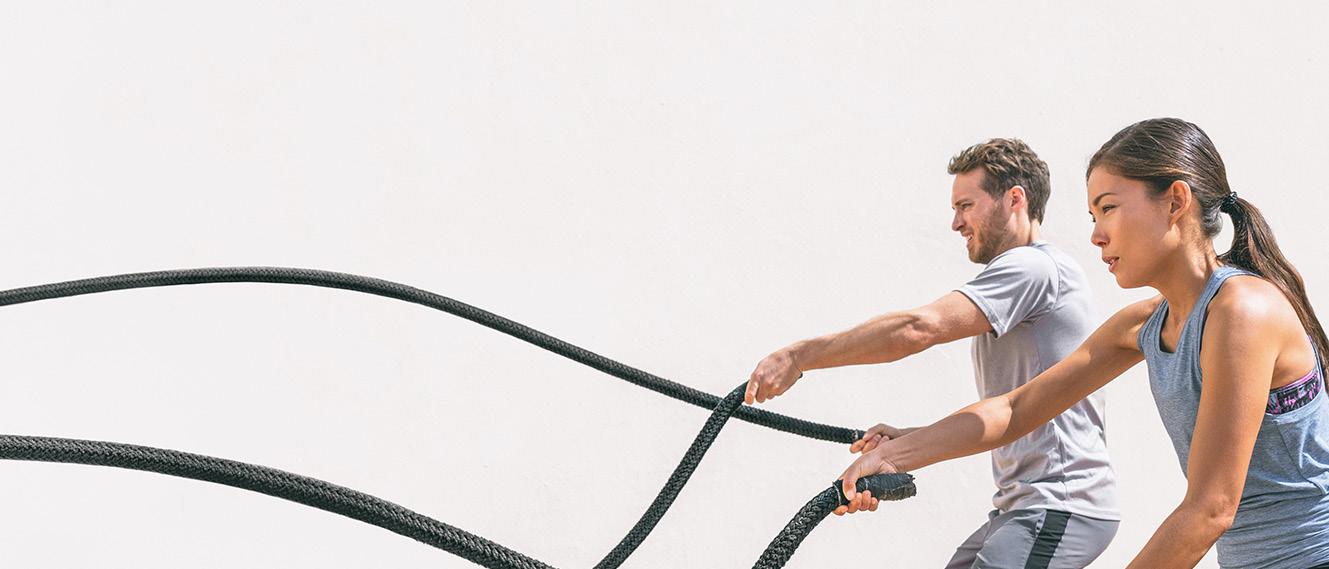
SOURCE 4 Fitness tests are a great indicator of an athlete’s fitness profile.
Practice exam
Now that you have tested your understanding of the key concepts relating to fitness requirements for physical activity, it’s time to put your learning to the test by completing Practice exam 5.3.
You can use the practice exam in any way you like. If you feel confident with the subject matter, you might only complete a few questions from each category. If you feel that you need extra practice, you may wish to complete all the questions. Answers are available to teachers, so ask your teacher for them if you wish to check your responses. Practice exam 5.3
Practice exam 5.3 only includes questions relating to fitness requirements for physical activity. It is structured and formatted in a similar way to the official QCAA Examination –combination response:
• Section 1 – multiple-choice questions
• Section 2 – short-response questions
• Section 3 – extended-response question.
Lesson 5.4
Determine your personal performance capacity for physical activity
Aim
To determine your personal performance capacity using a range of customised fitness tests (designed to incorporate relevant specialised movement sequences and movement strategies).
Time
One lesson (i.e. 60 minutes) with additional time (if required) to complete the analysis and discussion tasks.
Equipment
• Tennis court
• 30 tennis balls
• Containers or baskets
• 12 cones
• Four tennis racquets
• Markers
• Stopwatches
• Game Performance Assessment Instrument 16 (GPAI 16)
• Pen
• Clipboard
Game Performance Assessment Instrument 16 (GPAI 16)
Method
Step 1
Form pairs and participate in a teacher-led warm-up.
Step 2
Prepare to take part in a series of 10 fitness tests. Your teacher will clearly label each of the 10 fitness test stations and set up the equipment needed. Information about how to set up and complete each of the fitness tests is provided in the table below. Make sure you read and understand these instructions before completing this Skill drill.
Station 1 –Four ball pick-up (shuttle run)
Station 2 –Tennis ball push-ups
Station 3 –Shuffle run
Station 4 –Tennis ball squat jumps
Station 5 –Ball-toss drill
Station 6 –Lateral cone clears
Station 7 –Four ball hitting
Station 8 –Ball collector sprints
Station 9 –Sideline runs
Station 10 –Burpees
Note to teachers
If there are more than 20 students in the class, you may need to create two sets of the same station – preferably Stations 2 or 4, as these require less additional space.
Place tennis balls on four points along one sideline: at the net, between the net and the service line, at the service line, and between the service line and baseline. Run from the baseline and stoop to pick up the first ball, run back to the baseline and put the ball down, then immediately run to get the next ball. If time allows, work backwards and return each ball back to its original position.
Assume a push-up position. Place 10 tennis balls around your upper body in an arc, no more than an arm’s reach away. Place a container or basket at arm’s reach directly in front of your head.
Complete push-ups on your knees or feet. After each push-up, reach for a ball and place it in the basket. Once all the balls have been collected, repeat the activity, this time returning the balls to their original position between each push-up.
Place four cones along the baseline at intervals of 2 metres. Start at one sideline, run to the first cone, then shuffle to the next, then run to the final cone. Turn and repeat the pattern in the opposite direction.
Place a container with a tennis ball in it in front of you. Perform squat jumps. As you squat the first time, take the ball from the container and the next time, place the ball back into the container. Repeat until your time is up.
Repeatedly (without breaks) toss a tennis ball in the air to replicate a service action.
Place eight cones along the baseline. Starting at one end, step sideways over each cone from one end to the other. When you reach the other side, repeat in the opposite direction. Repeat again, but this time stop one cone short of the end and return to one cone short of the other end. Repeat this, again pulling up one cone shorter than previously. Repeat in this reducing manner until you are stepping over only one cone. At this point, start working your way to the outside, one cone at a time.
Stand in the centre of the court on the opposite side of the net to your partner. Your partner throws the balls (from a container of balls) and you hit them. First, hit a ball thrown to the left sideline. Quickly return to your start position before running to hit a ball thrown to the right sideline. Return to the centre and then run to a ball thrown short over the net in front of you. The fourth ball will be fed to where you are standing. Repeat.
Work alongside participants of Station 7. Run as fast as you safely can to collect the hit balls and return them to the feeder’s basket.
Run up and down the sideline of the tennis court.
Perform regular burpees.
Step 3
Each pair begins by selecting their first station. Student A performs the fitness test for 1 minute while Student B times their partner. Immediately after the test, Student A records their heart rate (HR) and the rate of perceived exertion (RPE) for the correct station number in GPAI 16. Leave all the other columns blank at this time.
Each pair then switches roles and completes the fitness test again. Each pair spends a total of 3–4 minutes at each station to allow time for HR readings.
Station Heart rate (HR)
Station 1 –Four ball pick-up (shuttle run)
Station 2 –Tennis ball pushups
Station 3 –Shuffle run
Station 4 –Tennis ball squat jumps
Station 5 –Ball-toss drill
Station 6 –Lateral cone clears
Station 7 –Four ball hitting
Station 8 –Ball collector sprints
Station 9 –Sideline runs
Station 10 –Burpees
SOURCE 1 GPAI 16
Rate of perceived exertion (RPE) (1–10)
Once complete, move on to the next station without taking a break. Be sure to work at the highest level of intensity possible at each station, while honouring technique and skill requirements.
Step 4
Repeat this process until you have completed all 10 fitness tests and columns 2 and 3 of GPAI 16 are filled in.
Fitness component being targeted
Energy system being targeted
Specialised movement sequence being targeted
Analysis and discussion
1 Define the seven components of fitness and identify a traditional fitness test for each one.
2 Customised fitness testing is sometimes used instead of (or in conjunction with) traditional fitness tests. Explain the benefits and the limitations of using customised fitness testing that is specifically designed for an individual’s physical activity, event or position.
3 For each of the stations in the circuit, decide which fitness component(s), energy system(s) and specialised movement sequences were being targeted. Note your responses in columns 4 to 6 of GPAI 16. Justify your decisions by referencing primary and secondary data.
4 Discuss how heart rate and rate of perceived exertion can be used to help determine personal performance capacities.
5 Identify which station elicited the highest heart rate. Did this correspond with your highest rate of perceived exertion? Explain why you think the highest heart rate and the rate of perceived exertion did or did not correlate.
6 Assess the effectiveness of this customised fitness testing session in determining your personal performance capacities for tennis. In your response, explain how specialised movement sequences and movement strategies have been incorporated into the session.
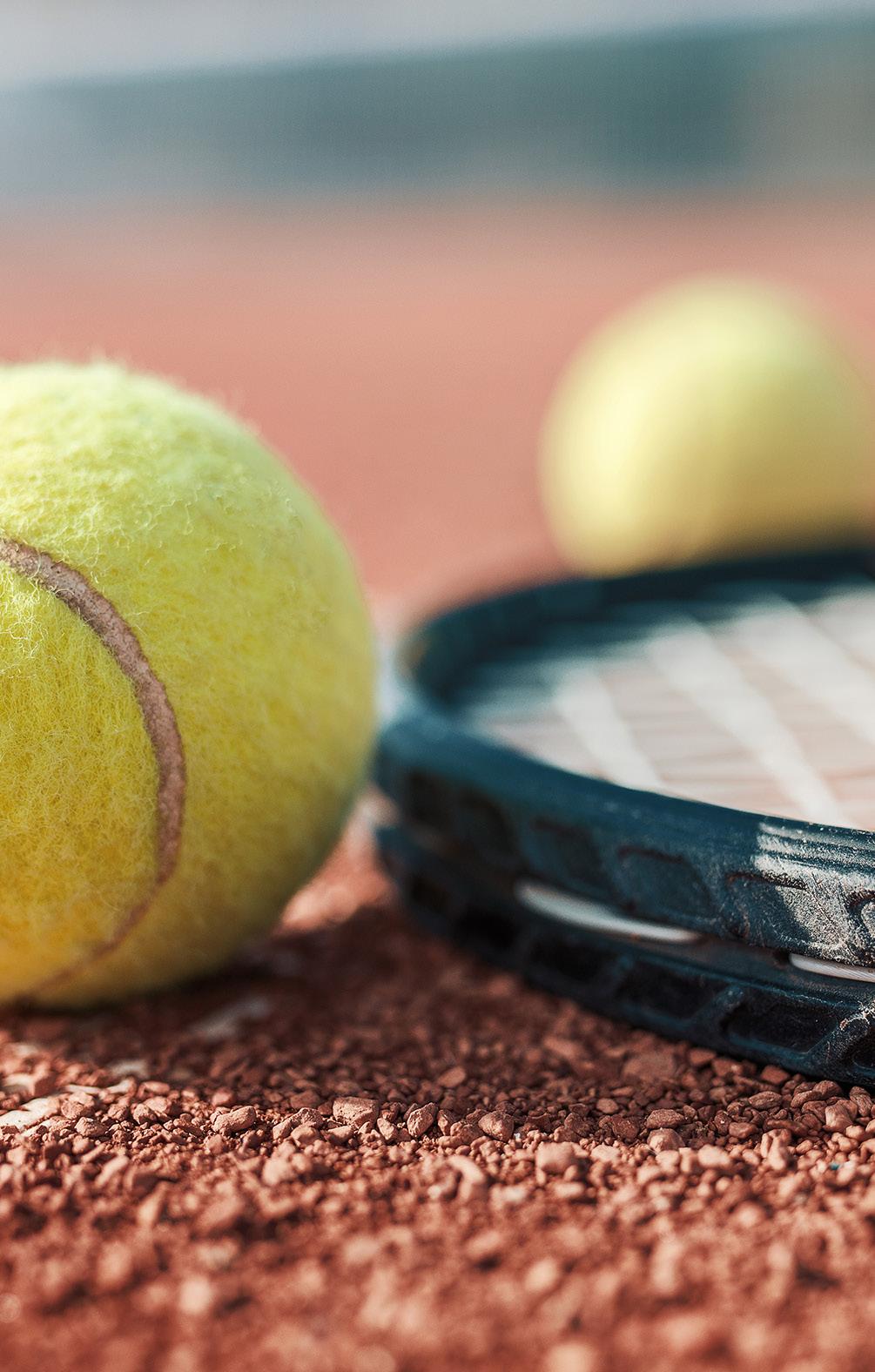
Key ideas
→ Review of key concepts about physiological responses to training and training zones.
SOURCE 2 Customised fitness testing can help determine your personal performance capacities for a particular sport – in this case, tennis.
Key concepts
Let’s start by reviewing the following key concepts from the syllabus. This lesson focuses on physiological responses to training and training zones.
Oxygen in performance
Oxygen plays a crucial role in the performance of an athlete. When the delivery of oxygen to working muscles is optimal, it allows an athlete to work harder for longer and to recover more quickly from bouts of exercise. The uptake and delivery of oxygen is impacted by physiological structures such as the lungs, heart, blood vessels and muscles. The maximum oxygen an athlete can deliver to the working muscles per minute is known as their VO2 max. Training can enhance the structure and function of the body’s respiratory, cardiovascular and muscular systems to improve an athlete’s VO2 max.
In situations where athletes do not have enough oxygen to supply the working muscles (e.g. during high-intensity exercise), the muscles have to operate anaerobically (i.e. without oxygen). After approximately 30–60 seconds, this prolonged oxygen deficit causes an onset of blood lactate. Blood lactate is a by-product of anaerobic glycolysis and can cause debilitating fatigue in athletes. The point at which blood lactate starts to rapidly accumulate is known as onset of blood lactate accumulation. The intensity of training at which this occurs is referred to as an athlete’s lactate threshold.
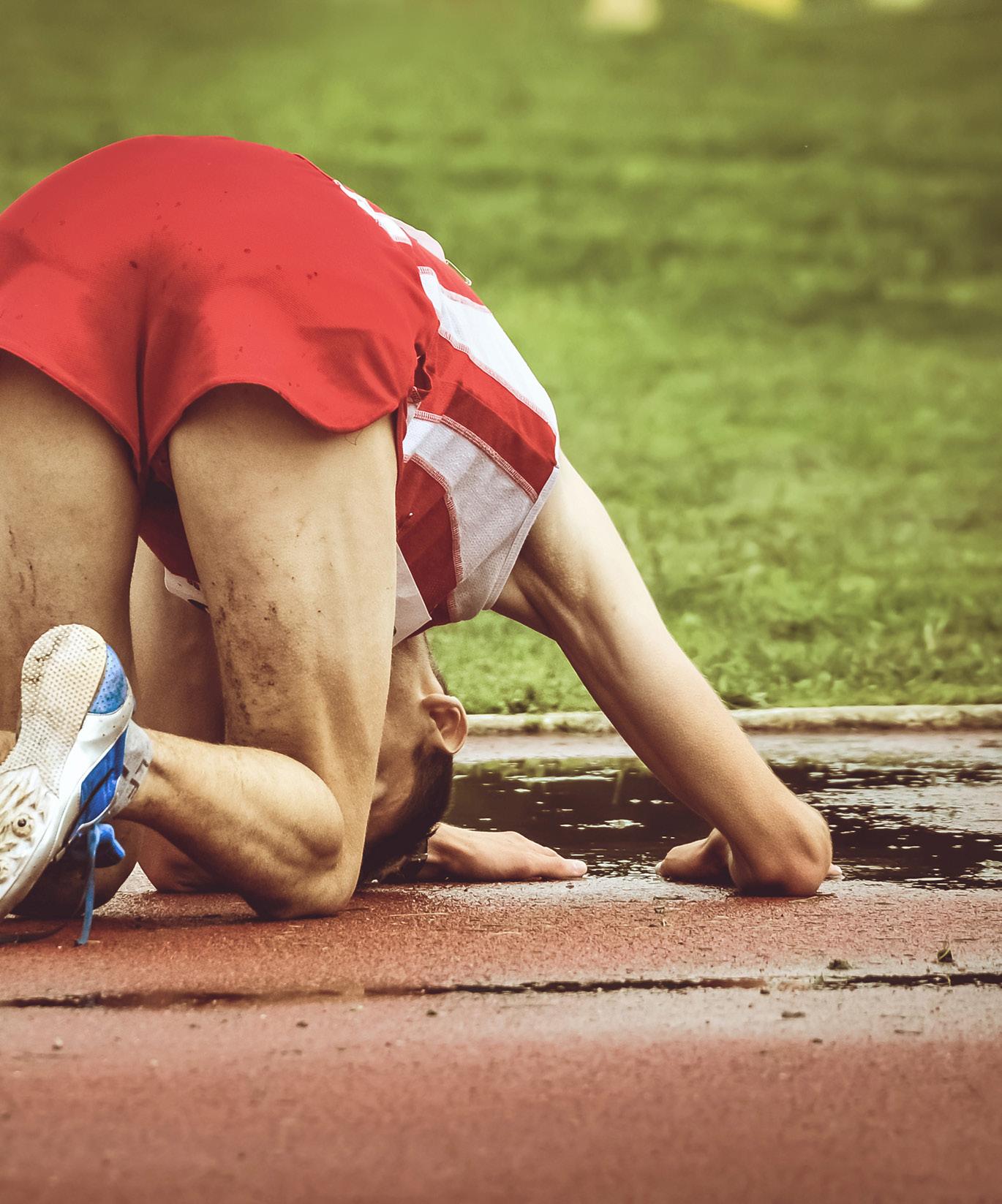
SOURCE 1 When athletes do not have enough oxygen to supply the working muscles (e.g. during high-intensity exercise), muscles are forced to operate anaerobically (i.e. without oxygen). The accumulation of blood lactate that can result from prolonged anaerobic energy supply can cause extreme muscular fatigue.
Training zones
To ensure that appropriate physiological adaptation can occur (i.e. that the athlete’s body changes in the desired way as a result of training), athletes use training zones. Training zones use heart rates to determine the range of intensities, in percentage, within which a target heart rate (THR) can lie for the relevant adaptation to take place. THR is determined as a percentage of maximum heart rate (MHR).
The four major training zones are:
• the recovery training zone – a low-intensity training zone that allows for the recovery and adaptation of the body’s structures after a bout of high-intensity work. The THR in the recovery training zone is less than 65 per cent of MHR
• the aerobic training zone – a moderate-intensity training zone that facilitates development of the body’s circulatory system and encourages the body to use fats as the primary fuel source. The THR in the aerobic training zone is usually 60–80 per cent of MHR
• the lactate threshold training zone – a specific zone in which the athlete trains at or just under their lactate threshold with the aim of increasing the efficiency of the body at clearing blood lactate. The THR in the lactate threshold training zone is usually around 80–85 per cent of MHR
• the anaerobic training zone – a high-intensity training zone in which an athlete works above their lactate threshold in intervals. In this training zone, an athlete engages their ATP–PC and/or lactic acid energy systems. While the THR for this zone is greater than 85 per cent of MHR, heart rate is not the only indicator of training in this zone.
In addition to using heart rate to determine an athlete’s training zone, the speed at which an athlete’s heart rate drops after exercise can provide a measurement of their fitness. A fast heart rate recovery (i.e. return to resting heart rate) is said to be a good indicator of fitness.
Physiological adaptations
Acute physiological adaptations are immediate changes that take place in response to exercise and which result in an increase in oxygen delivery to the working muscles.
Chronic physiological adaptations are longer-term changes in body systems and organs that take place with training over time. These can include increased VO2 max, lactate threshold, lung capacity, muscle mass (hypertrophy), stroke volume and cardiac output, and effects on slow- and fast-twitch muscle fibres.
Find it here!
For exam success, you will need to know about the concepts discussed above in detail. You will also need to be prepared to respond to questions on them. If any of these concepts are unclear or unfamiliar to you, you can revisit and revise them using the table below.
Subject matter
Physiological responses to training
Training zones
Lesson
Lesson 4.6 Physiological responses to training ( page 212)
Lesson 4.11 Training zones ( page 233)
Retrieve and apply!
To perform well on the exam, you will need to be able to retrieve the subject matter content listed in Unit 4 of the QCE Senior Physical Education Syllabus – Energy, fitness and training in physical activity. You will also need to be able to apply higher-order thinking skills to respond to more complex questioning. Remember, success is in the detail!
To see how well you can retrieve and apply key concepts on physiological responses to training and training zones, complete the following questions in Source 2. Answers for these tasks are available to teachers, so ask your teacher for them if you wish to check your responses.
Question type Retrieve it!
Multiplechoice question
Shortresponse question
A power test and speed test reveal that an athlete has increased their explosive power and acceleration. What chronic physiological adaptation is this evidence of?
A Increased cardiac output
B Improved recruitment of fast-twitch muscle fibres
C Increased stroke volume
D Increased VO2 max
In 150 words, explain the concept of VO2 max, including its influence, how it is determined and how it is measured.
Find it!
Lesson 4.6
Physiological responses to training (page 212)
Mark it!
Total: 1 mark
Select the correct option.
Extendedresponse question
Geu is a 16-year-old aspiring middle-distance runner wanting to improve his performance. He needs to determine his lactate threshold and devise a strategy to train in the lactate threshold training zone over the next 4 weeks. In 400 words, devise a strategy for Geu to follow.
Lesson 4.6
Physiological responses to training (page 212)
Lesson 4.6
Physiological responses to training (page 212)
Total: 7 marks
For full marks on this question, you will need to:
• define VO2 max (1 mark)
• accurately explain the factors that determine and influence an athlete’s VO2 max (3 marks)
• explain why a high VO2 max is beneficial (1 mark)
• explain how it is determined (1 mark)
• state how it is measured (1 mark).
Total: 13 marks
For full marks on this question, you will need to:
• explain what the lactate threshold (LT) is and the purpose of training in this zone (2 marks)
• state the formula for calculating LT (1 mark)
• calculate the LT correctly (1 mark)
• appropriately select and justify at least 3 different exercises/activities that will have Geu training in the lactate threshold zone, making links between energy, fitness and training concepts (6 marks)
• use cohesive devices to communicate effectively and coherently (3 marks).
SOURCE 2 Complete these tasks to see how well you can retrieve and apply the key concepts in physiological responses to training and training zones.
Practice exam
Practice exam 5.5
Now that you have tested your understanding of the key concepts relating to physiological responses to training and training zones, it’s time to put your learning to the test by completing Practice exam 5.5.
Practice exam 5.5 only includes questions relating to physiological responses to training and training zones. It is structured and formatted in a similar way to the official QCAA Examination – combination response. It contains:
• Section 1 – multiple-choice questions
• Section 2 – short-response questions
• Section 3 – extended-response question.
You can use the practice exam in any way you like. If you feel confident with the subject matter, you might only complete a few questions from each category. If you feel that you need extra practice, you may wish to complete all the questions. Answers are available to teachers, so ask your teacher for them if you wish to check your responses.
Lesson 5.6
Analyse your heart rate to target the correct training zone
Aim
To analyse heart rate data and to determine whether you are working in the correct training zone.
Time
One lesson (i.e. 60 minutes) with additional time (if required) to complete the analysis and discussion tasks.
Equipment
• Basketball court
• Basketballs
• Bibs
• Heart rate monitors
• Game Performance Assessment Instrument 17 (GPAI 17)
• Pens Game Performance Assessment Instrument 17 (GPAI 17)
Method
Step 1
Form teams of five and participate in a teacher-led warm-up.
Step 2
Take part in Activity 1: 5v5 full-court king-ofthe-court style basketball game (10 minutes)
Instructions for Activity 1
• You can only play one-on-one defence from the halfway line.
• One team changes over each time a goal is scored.
• The new team starts with the ball under the basket scored.
• There can be no more than four teams per court (i.e. two teams playing and a maximum of two teams waiting on the sidelines to come on); if there are more than 20 students, use two courts.
Recording your data for Activity 1
Each time your team is on a break, use columns 1, 3, 5, 7 and 9 of GPAI 17 to record your heart rate. You will need to record your heart rate as quickly as possible, so you are ready to go back on the
court when it’s your turn. If your team stays on the court for consecutive turns, your heart rate must be recorded every 2 minutes.
Step 3
Take part in Activity 2: Star shooting drill (10 minutes)
Instructions for Activity 2
• Place a maximum of five people at each end of the court.
• Refer to Source 1 for positions. The second player may start the activity once the player before them has reached the second point of the star.
• Start by receiving a pass on the wing (just inside the 3-point line) and take a shot from Position 1.
• Sprint to gather your own rebound and immediately dribble to the opposite side of the keyway on the free-throw line extended (just in from the 3-point line). Turn and take a shot from Position 2.
• Sprint to gather your own rebound and immediately dribble to the other side of the keyway at the free throw line extended. Turn and take the shot from Position 3.
• Sprint to gather your own rebound and immediately dribble to the other side of the keyway to the wing (just inside the 3-point line). Turn and take the shot from Position 4.
• Sprint to gather your own rebound and immediately dribble to the top of the keyway (just inside the 3-point line). Turn and take the shot from Position 5.
• Sprint to gather your own rebound and pass it to the next passer on the sideline.
• Line up to repeat the activity.
Recording your data for Activity 2
Keep an eye on the clock throughout the activity. Measure your heart rate as close to the 2, 4, 6, 8 and 10-minute marks as possible and use columns 1, 3, 5, 7 and 9 of GPAI 17 to record the results.
4 1 2 5 3
SOURCE 1 Set-up for Activity 2: Star shooting drill
Activity 1: Aerobicbased training
Activity 2: Anaerobicbased training
Activity 3: Cool-down
SOURCE 2 GPAI 17
Step 4
Take part in Activity 3: Cool-down (10 minutes)
Instructions for Activity 3
• Jog around the court five times.
• Perform light static stretches to your whole body.
Recording your data for Activity 3
Keep an eye on the clock throughout the activity. Measure your heart rate as close to the 2, 4, 6, 8 and 10-minute marks as possible and use columns 1, 3, 5, 7 and 9 of GPAI 17 to record the results.
Analysis and discussion
1 Identify the four training zones.
2 Explain the characteristics of each of the training zones, considering the minimum and maximum heart rate range and other indicative features.
3 Calculate your maximum heart rate using the following formula: 206.9 − (0.67 × age in years).
4 Working across each row for the three activities, calculate the percentage of maximum heart rate by using the following formula: HR ÷ MHR × 100 (e.g. 130 bpm ÷ 196 bpm x 100 = 66%).
5 Analyse your data to determine which training zones you were training in during the three activities.
6 Discuss why it might be difficult for athletes to train in the lactate threshold training zone during a skill-based training session.
7 Evaluate the outcomes and limitations of using heart rate to determine training zones and training intensities.
8 Would you maintain, modify or further develop this training session for achieving optimal conditioning for the sport of basketball? Justify your response.
Lesson 5.7
Revision: Principles of training
Key ideas
→ Review of key concepts in principles of training.
Key concepts
Let’s start by reviewing the following key concepts from the syllabus. This lesson focuses on principles of training.
Principles of training
When an athlete is training to optimise their performance, they must take the principles of training into consideration. These principles are:
• specificity – ensuring training is relevant to the athlete’s targeted energy systems, positionspecific movements and the fitness requirements of a specific sport or performance
• frequency – consideration for how often the athlete should train to meet training objectives
• duration – consideration for how long the athlete should train to meet training objectives
• intensity – consideration for how hard the athlete should train to meet training objectives
• progressiveoverload – the process of increasing training load to encourage physiological adaption in the athlete
• individuality – the consideration of an athlete’s individual circumstances that could impact on meeting training requirements
• variety – ensuring training activities, movement options and training contexts are varied so athletes stay interested and motivated
• reversibility – the understanding that when training load is significantly decreased or stopped, the physiological adaptations are lost or reversed.
Principles of training can be used as a guide when evaluating the effectiveness of a training program or a training session. For example, the principle of frequency can be used to determine whether an athlete is training often enough for improvement. Generally, it is necessary to consider multiple principles of training in an insightful evaluation because, for example, intensity (how hard) and duration (how long) of training can play a role in determining the appropriate frequency (how often) of training.
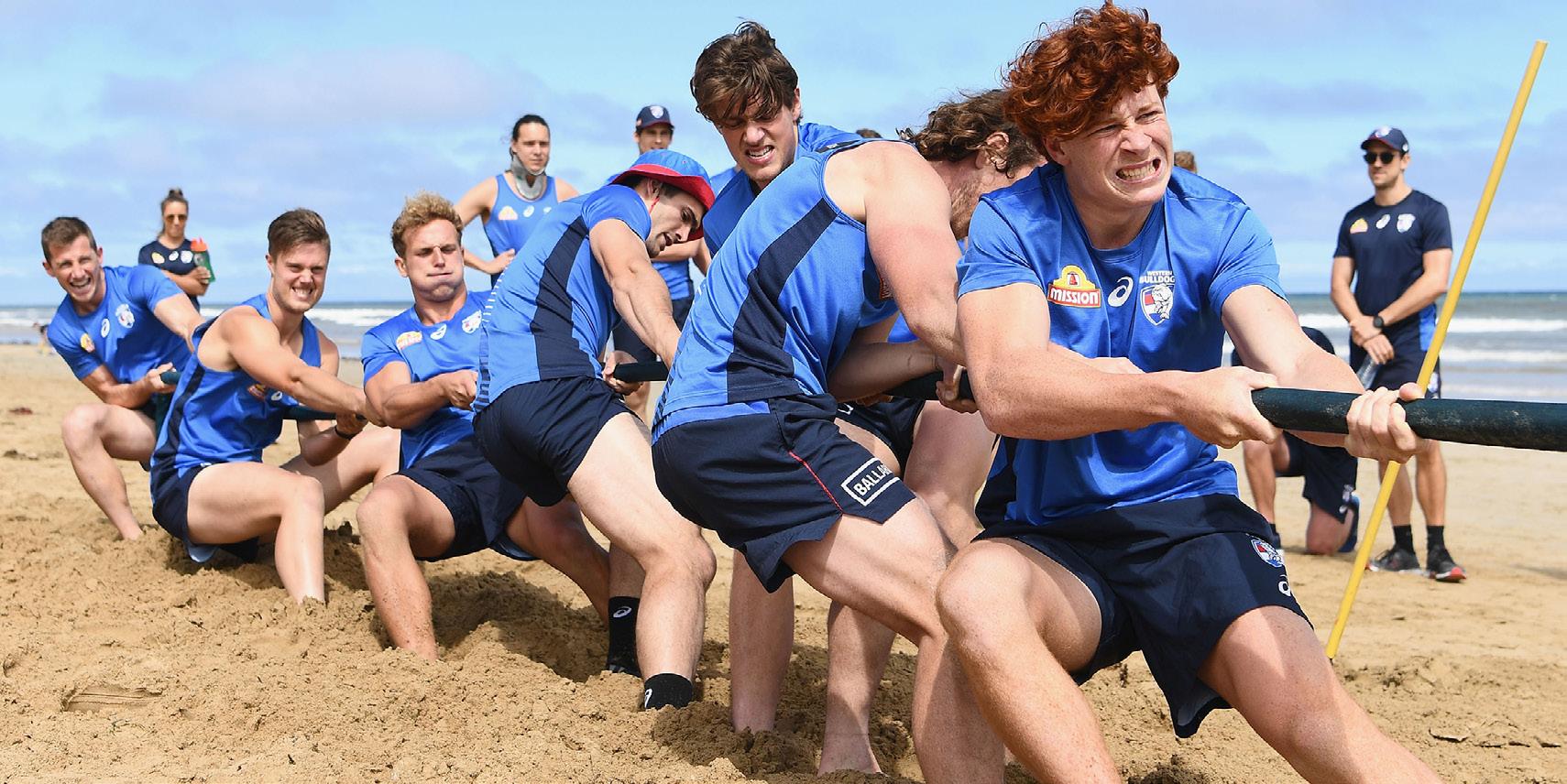
Find it here!
For exam success, you will need to know about the concepts discussed above in detail. You will also need to be prepared to respond to questions on them. If any of these concepts are unclear or unfamiliar to you, you can revisit and revise them using the table below.
Subject matter
Principles of training Lesson 4.12 Principles of training (page 236)
SOURCE 1 The training principle of variety states that training should be varied where possible to maintain an athlete’s motivation. Australian football players often train at the beach to build fitness and team cohesion at the same time.
Lesson
Retrieve and apply!
To perform well on the exam, you will need to be able to retrieve the subject matter content listed in Unit 4 of the QCE Senior Physical Education Syllabus – Energy, fitness and training in physical activity. You will also need to be able to apply higher-order thinking skills to respond to more complex questioning. Remember, success is in the detail!
To see how well you can retrieve and apply key concepts on principles of training, complete the following questions in Source 2. Answers for these tasks are available to teachers, so ask your teacher for them if you wish to check your responses.
Question
Multiplechoice question
Shortresponse question
A competitive swimmer aims to improve their 100 m freestyle time.
To achieve this, they gradually increase the intensity and duration of their training sessions over several weeks. Which training principle does this best exemplify?
A Frequency
B Intensity
C Duration
D Progressive overload
Analyse Source 3 on the next page
Use your knowledge of any two principles of training to explain what is happening to this athlete over time (the x- axis).
Lesson 4.12
Principles of training (page 236)
Extendedresponse question
Design a 30-minute conditioning phase training strategy for a junior soccer player aiming to improve their agility and speed. Justify why your selection of activities adheres to the principles of training, including specificity, overload, progression and reversibility. You will not be assessed on your knowledge of soccer and do not need to address the warm-up or cool-down.
Lesson 4.12
Principles of training (page 236)
Total: 1 mark
Select the correct option.
Lesson 4.12 Principles of training (page 236)
Total: 8 marks
For full marks on this question, you will need to:
• select a relevant principle of training (1 mark)
• accurately explain this principle of training (1 mark)
• make a logical and accurate connection between this principle of training and Source 3, drawing on knowledge of energy, fitness and training (2 marks).
Do this for two different principles of training (total of 8 marks).
Total: 15 marks
For full marks on this question, you will need to:
• devise a strategy (1 mark)
• select activities that appropriately develop speed and agility (2 marks)
• explain where the four principles of training have been applied (4 marks)
• for each of the four specified principles of training, make links between energy, fitness and training concepts to justify the choice (2 per principle; total 8 marks).
SOURCE 2 Complete these tasks to see how well you can retrieve and apply the key concepts in principles of training.
SOURCE 3 Use your knowledge of any two principles of training to explain what is happening to this athlete over time (the x- axis).
Practice exam
Now that you have tested your understanding of the key concepts relating to the principles of training, it’s time to put your learning to the test by completing Practice exam 5.7. Practice exam 5.7 only includes questions relating to the principles of training. It is structured and formatted in a similar way to the official QCAA Examination –combination response:
• Section 1 – multiple-choice questions
• Section 2 – short-response questions
• Section 3 – extended response question. You can use the practice exam in any way you like. If you feel confident with the subject matter, you might only complete a few questions from each section. If you feel that you need extra practice, you may choose to complete all the questions under exam conditions. Answers are available to teachers, so ask your teacher for them if you wish to check your responses.
Practice exam 5.7
Lesson 5.8
Determine the importance of principles of training when developing a training program
Aim
To determine the importance of applying the training principles when developing a training program.
Time
One lesson (i.e. 60 minutes) with additional time (if required) to complete the analysis and discussion tasks.
Equipment
• Touch footballs (one per pair)
• Six agility poles
• Markers
• Whistle
• Stopwatch
• Information and instructions relating to the three activities
• Game Performance Assessment Instrument 18 (GPAI 18)
• Pen
• Clipboard
Additional resource: Instructions for Activities 1–3
Game Performance Assessment Instrument 18 (GPAI 18)
Method
Step 1
• Participate in a teacher-led RAMP warm-up and prepare to take part in three activities.
• Information about how to set up and complete each of the three activities listed below is available for download. Make sure you read and understand these instructions before beginning this Skill drill.
Step 2
Take part in Activity 1: Turn and score drill
– whole-body speed work development using sprint interval training. Immediately after completing Activity 1, complete the corresponding "Quantitative data" and "Qualitative data" columns in GPAI 18.
SOURCE 1 Set-up for Activity 1 – Turn and score drill
Step 3
Take part in Activity 2: Rucking drill – wholebody aerobic capacity development using aerobic interval training. Immediately after completing Activity 2, complete the corresponding "Quantitative data" and "Qualitative data" columns in GPAI 18.
Step 4
Take part in Activity 3: Stagger drill – wholebody muscular endurance work using sprint interval training. Immediately after completing Activity 3, complete the corresponding "Quantitative data" and "Qualitative data" columns in GPAI 18.
Activity Reps or volume or intensity or W:R
Activity 1: Turn and score drill
Activity 2: Rucking drill
• 10 × 20-metre sprints at 100% intensity with 30 seconds active recovery after each interval (the teacher will blow the whistle roughly 30 seconds after one sprint has finished)
• W:R is approximately 1:5
• 4 × 70-metre rucking at 80% intensity with 60 seconds passive recovery (stay at the end of the field when you finish and go the other way for the next rep)
2 Set-up for Activity 2 – Rucking drill
Quantitative data
HR (beats per minute)
RPE (1–10)
Respiratory rate (breaths per minute)
Level of motivation (1–10)
HR (beats per minute)
RPE (1–10)
Respiratory rate (breaths per minute)
Level of motivation (1–10)
Qualitative data (i.e. Describe how you felt during and after the activity)
Activity 3: Stagger drill
• 10 × 15 seconds (approximately) at 100% intensity with approximately 75 seconds passive recovery
SOURCE 3 GPAI 18
Analysis and discussion
1 Identify the eight principles of training.
2 Analyse your primary data. In particular, discuss your motivation for this session.
3 Compare and contrast your motivation in this training session with the training sessions you developed in your training strategy for Internal assessment 3.
HR (beats per minute) RPE (1–10)
Respiratory rate (breaths per minute)
Level of motivation (1–10)
4 Assess how well this training session has applied each of the eight principles of training. Imagine that you could create future training sessions in this training program. Discuss what you would adjust to ensure progressive overload was applied.
5 Predict what could happen to an athlete who does not incorporate enough variety into their training program.
SOURCE
Lesson 5.9
Revision: Training methods and fatigue and recovery in training
Key ideas
→ Review of key concepts in training methods and fatigue and recovery in training.
Key concepts
Let’s start by reviewing the following key concepts from the syllabus. This lesson focuses on training methods and fatigue and recovery in training.
Training methods
Training methods are the forms of exercise an athlete uses to help meet their training objectives. Training methods include:
• continuous training – a type of training performed at the same intensity for an extended period of time without periods of rest. Types of continuous training include long slow distance (LSD) training and tempo training
• fartlek training – a variation of continuous training whereby athletes vary the intensity of their exercise by increasing their speed or increasing the resistance of their work (e.g. adding incline, running on sand, running upstairs)
• resistance training – a type of training that requires an athlete to work against something that resists the movement of the body (or particular body parts). Types of resistance training include isotonic resistance training, isometric resistance training, isokinetic resistance training and plyometric resistance training
• interval training – a type of training that manipulates periods of work and rest to enhance a specific fitness component and target a particular energy system. Types of interval training include high-intensity interval training (HIIT), sprint interval training (SIT) and aerobic interval training (AIT)
• flexibility training – a type of training that involves stretching the muscles, tendons and ligaments in and around joints. Types of flexibility training include dynamic flexibility training, static flexibility training, passive flexibility training and proprioceptive neuromuscular facilitation (PNF) training
• circuit training – a specific training method in which a variety of different activities are performed consecutively in a cycle.
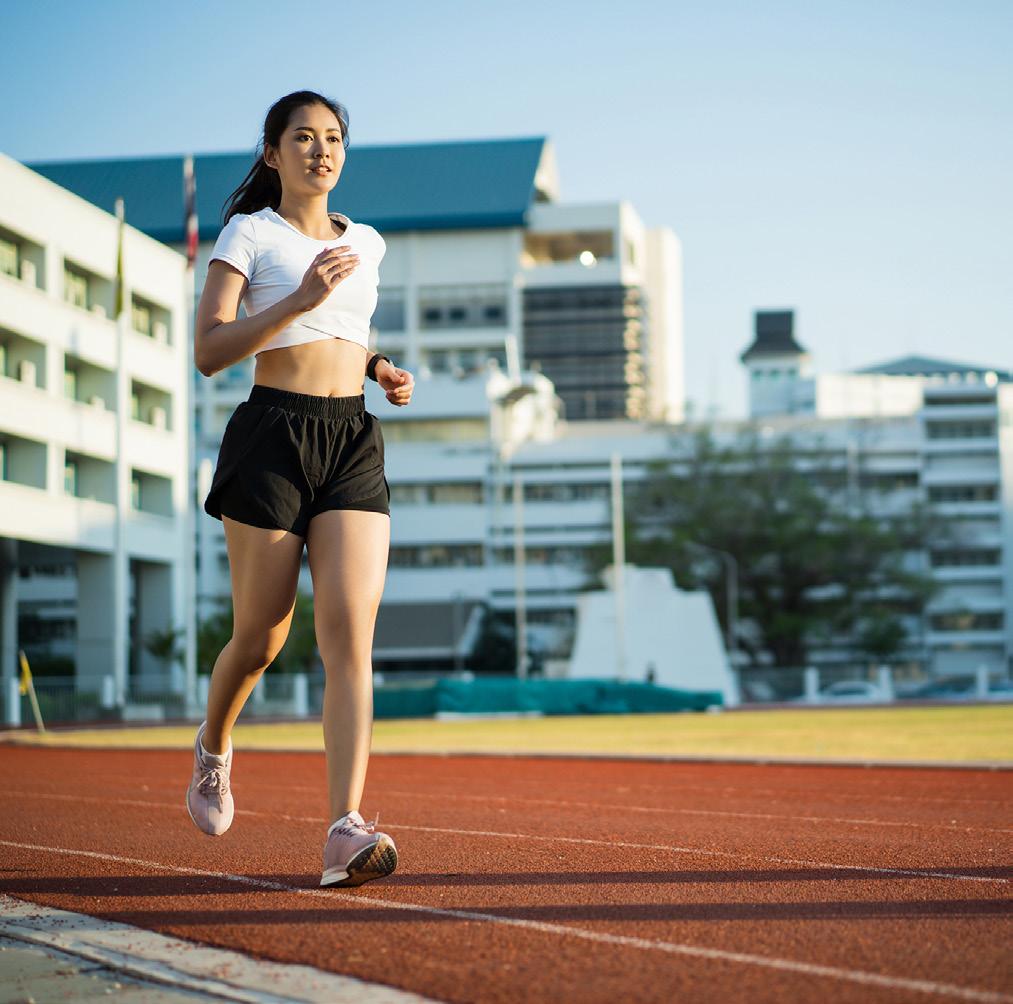
SOURCE 1 Training methods are the forms of exercise an athlete uses to help meet their training objectives.
Fatigue and recovery principles in training
According to the theory of the General Adaptation Syndrome (GAS), it is important for athletes to ensure that training cycles their body through appropriate periods of fatigue and recovery so physiological adaptation can occur. Athletes who train when their body is at the optimal level of preparedness increase their potential of achieving fitness gains. This fitness–fatigue model proposes that after any training session, the fatigue effect wears off faster than the fitness effect (adaptation). The window of time between the fatigue effect wearing off and the fitness effect remaining is when an athlete’s preparedness to benefit from training again is at its highest. Recovery between one session and the next is known as inter-session recovery. Recovery during a training session is called intra-session recovery. Intra-session recovery can be either active or passive depending on a range of factors including the training load and training method.
Find it here!
For exam success, you will need to know about the concepts discussed above in detail. You will also need to be prepared to respond to questions on them. If any of these concepts are unclear or unfamiliar to you, you can revisit and revise them using the table below.
Subject matter Lesson
Training methods
Lesson 4.13 Training methods (page 243)
Continuous training Lesson 4.14 Continuous training (page 245)
Fartlek training
Lesson 4.15 Fartlek training (page 247)
Resistance training Lesson 4.16 Resistance training (page 250)
Interval training Lesson 4.17 Interval training (page 259)
Flexibility training Lesson 4.18 Flexibility training (page 264)
Circuit training Lesson 4.19 Circuit training (page 268)
Fatigue and recovery in training Lesson 4.20 Fatigue and recovery in training (page 271)
Retrieve and apply!
To perform well on the exam, you will need to be able to retrieve the subject matter content listed in Unit 4 of the QCE Senior Physical Education Syllabus – Energy, fitness and training in physical activity. You will also need to be able to apply higher-order thinking skills to respond to more complex questioning. Remember, success is in the detail!
To see how well you can retrieve and apply key concepts on training methods and fatigue and recovery in training, complete the following questions in Source 2 Answers for these tasks are available to teachers, so ask your teacher for them if you wish to check your responses.
Multiplechoice question
Proprioceptive neuromuscular facilitation (PNF) is most relevant to which training method?
A Continuous training
B Flexibility training
C Interval training
D Resistance training
Shortresponse question
Extendedresponse question
In 150 words, devise a one-session fartlek training strategy for a road cyclist (long distance cycling). You can assume that the warm-up and cool-down have already been planned. Your task is to focus purely on the conditioning phase of the training session. You will not be assessed on your knowledge of road cycling but, rather, your application of fartlek training principles.
Arlie is becoming a little bored with her typical training regime, which consists of going for long runs each morning. Respond to the following tasks in a total of 400 words.
Part 1: Devise a strategy to give some variability to Arlie’s training, justifying three alternative conditioning phase activities. Your strategy must feature three training methods other than continuous training.
Part 2: Use your knowledge of the General Adaptation Syndrome (GAS) to argue which days within a one-week microcycle you would advise Arlie completes these sessions.
Lesson 4.13
Training methods (page 243) to Lesson 4.19 Circuit training (page 268)
Lesson 4.15 Fartlek training (page 247)
Total: 1 mark
Select the correct option.
Lesson 4.13 Training methods (page 243) to Lesson 4.19 Circuit training (page 268)
Total: 6 marks
For full marks on this question, you will need to:
• define fartlek training, outlining why it is different to continuous training (2 marks)
• select at least one appropriate fartlek activity (1 mark)
• explain why this is a fartlek activity (1 mark)
• justify the selection by making links between energy, fitness and training (2 marks).
Total: 18 marks
For full marks on this question, you will need to:
• select an alternative activity (1 mark)
• explain which training method this activity uses (1 mark)
• accurately apply the principles that underpin this training method and support this by making links between energy, fitness and training (2 marks)
• identify appropriate days of the week for the training (1 mark)
• apply knowledge of the GAS to justify this decision (1 mark).
Do this three times (total of 18 marks).
SOURCE 2 Complete these tasks to see how well you can retrieve and apply the key concepts in training methods and fatigue and recovery in training.
Practice exam
Now that you have tested your understanding of the key concepts relating to training methods and fatigue and recovery in training, it’s time to put your learning to the test by completing Practice exam 5.9.
Practice exam 5.9 only includes questions relating to training methods and fatigue and recovery in training. It is structured and formatted in a similar way to the official QCAA Examination – combination response:
• Section 1 – multiple-choice questions
• Section 2 – short-response questions
• Section 3 – extended-response question.
You can use the practice exam in any way you like. If you feel confident with the subject matter, you might only complete a few questions from each section. If you feel that you need extra practice, you may choose to complete all the questions under exam conditions. Answers are available to teachers, so ask your teacher for them if you wish to check your responses.
Practice exam 5.9
Lesson 5.10
Determine the impact of volume, intensity and skill work on developing a specialised movement sequence
Aim
To determine the impact of volume, intensity and skill work on the development of a specialised movement sequence (and movement strategy).
Time
One lesson (i.e. 60 minutes) with additional time (if required) to complete the analysis and discussion tasks.
Equipment
• At least five heart rate monitors
• Volleyball court with net
• 20 volleyballs
• Two ball trolleys
• Game Performance Assessment Instrument 19 (GPAI 19)
• Pen
• Timer
Game Performance Assessment Instrument 19 (GPAI 19)
Method
Step 1
Conduct a teacher-led RAMP warm-up before forming groups of five. Ensure that you have GPAI 19 close to the court.
Step 2
Each group takes turns to perform the exercise. The performing group lines up on one side of the court while all the other students go to the opposite side of the net, except for one volunteer who will work as a setter for the performing group. Each member of the performing group puts on a heart rate monitor.
Step 3
The performing group completes the following drill while the other students act as ball collectors on the other side of the net.
Volleyball drill:
• The setter takes the position as indicated in Source 1, with the ball trolley close by.
• The performing group lines up at the starting position.
• At a given signal, the first person in line runs, with high intensity, forwards along the sideline towards the net to Point 1 and completes a pretend spike (i.e. an air swing) before back-pedalling diagonally to perform a second pretend spike at Point 2.
• They continue back-pedalling to perform a real spike at Point 3 where, rather than air swinging, they attempt to hit the ball that the setter sets for them, before running back to the end of the line to await their next turn.
• Remember to maintain speed and momentum, even if you miss the ball at Point 3!
• The next person in line can start the drill when the person in front of them is at Point 2.
• The players repeat the drill for 1.5 minutes. When it’s over, all performing group members record their heart rate (HR) and rate of perceived exertion (RPE) in GPAI 19 – first, directly after the drill, and then at intervals of 30 seconds for a full rest time of 3 minutes. After each round, each group member also rates their performance in GPAI 19.
Step 4
The same group repeats the drill three more times, each time reducing the rest time by 30 seconds. After four rounds, the next group has their turn.
Analysis and discussion
1 Explain the difference between volume and intensity in training.
2 Determine how volume and intensity were manipulated over the four rounds. Did the inclusion of skill work (spiking the ball at Point 3) impact the level of intensity you achieved in the work efforts? In which round did you experience the most fatigue? Use your primary data to justify your answer.
3 Determine the link (if any) between your level of fatigue and your performance of the specialised movement sequence.
4 Assuming that the predetermined outcome of this training session was to "develop technical proficiency of the volleyball spike while improving muscular endurance and aerobic capacity", suggest modifications to this precompetition phase training session to achieve the right balance between volume, intensity and skill.
5 Evaluate the suitability of your recommendation in Question 4 for: e a person with a lower fitness level than you. f a person with a higher fitness level than you.
6 Describe a situation in which it would be recommended to train specialised movement sequences and movement strategies under highvolume, high-intensity conditions.
Lesson 5.11
Revision: The theory of periodisation
Key ideas
→ Review of key concepts in the theory of periodisation.
Key concepts
Let’s start by reviewing the following key concepts from the syllabus. This lesson will focus on the theory of periodisation.
Periodisation
Before athletes can begin the process of devising a training strategy (e.g. a training program or a training session), they must have a good understanding of the theory of periodisation. The process begins with an athlete developing an annual plan (i.e. their plan for all the physical activities that they aim to participate in over a 12-month period). Afterwards, they identify macrocycles – one macrocycle per physical activity (e.g. a five-month macrocycle for their summer sport and a five-month macrocycle for their winter sport). Every macrocycle is then broken down into four training phases:
• preparatory phase – a set period of time during which an athlete focuses on increasing their general level of fitness
• pre-competition phase – a set period of time during which an athlete focuses on optimising their energy, fitness and skill levels for their specific sport, position and/or event
• competition phase – a set period of time during which an athlete focuses on maintaining their energy, fitness and skill levels for their specific sport, position and/or event and maximising their performance in authentic game or performance environments transition phase – a set period of time during which an athlete focuses on rest and recovery from physical and mental stress of training and competition.

Each training phase can be further broken down into several mesocycles of four to six weeks in length, each with different energy and fitness training objectives.
Each mesocycle can then be broken down into even smaller cycles called microcycles, which are typically a week long (but can be as long as 10 days, depending on the timeframe between matches or events).
Finally, each microcycle can be broken down into several training sessions, each of which typically lasts for about an hour. Training sessions are designed to consider all the planning that has been done at the training phase and mesocycle level, and ensure that athletes are in the best physical condition to perform in their physical activity when it matters the most.
SOURCE 1 The preparatory phase is the first of the four training phases. Among other things, the preparatory phase is designed to build an athlete’s general strength.
Periodisation must consider how to cycle the athlete through fatigue (i.e. navigate loading and unloading the athlete through increasing or decreasing work volume and/or intensity) and recovery to maximise physiological adaptation.
Find it here!
For exam success, you will need to know about the concepts discussed above in detail. You will also need to be prepared to respond to questions on them. If any of these concepts are unclear or unfamiliar to you, you can revisit and revise them using the table below.
Subject matter
Retrieve and apply!
Lesson
To perform well on the exam, you will need to be able to retrieve the subject matter content listed in Unit 4 of the QCE Senior Physical Education Syllabus – Energy, fitness and training in physical activity. You will also need to be able to apply higher-order thinking skills to respond to more complex questioning. Remember, success is in the detail!
To see how well you can retrieve and apply key concepts on the theory of periodisation, complete the following questions in Source 2. Answers for these tasks are available to teachers, so ask your teacher for them if you wish to check your responses.
The theory of periodisation Lesson 4.21 The theory of periodisation (page 277) Question
Multiplechoice question ___________ allows the body and mind to have a break from vigorous physical exertion, and provides an opportunity to heal injuries and recharge energy reserves.
A Peaking
B Recuperating
C Recharging
D Tapering
Shortresponse question
In 150 words, discuss the role of the preparatory phase in a periodised training program.
Lesson 4.21
The theory of periodisation (page 277)
Lesson 4.21
The theory of periodisation (page 277)
Total: 1 mark
Select the correct option.
Total: 7 marks
For full marks on this question, you will need to:
• define the preparatory phase (1 mark)
• identify at least three of the six aims outlined in Lesson 4.21, explaining each one (total of 6 marks).
Question type Retrieve it! Find it! Mark it!
Extendedresponse question
Analyse the graph in Source 3 and use it to help devise a 400-word strategy to prepare you for an imaginary competition in a sport of your choice that is due to occur in 10 months' time.
Lesson 4.21
The theory of periodisation (page 277)
Total: 24 marks
For full marks on this question, you will need to:
• select a sport/event and explain its timeframe (1 mark)
• define each training phase (4 marks)
• address at least two features of each phase (8 marks)
• identify the types of activities to be engaged in at each phase, using language of periodisation and knowledge of energy, fitness and training (8 marks)
• use cohesive devices to communicate effectively and coherently (3 marks).
SOURCE 2 Complete these tasks to see how well you can retrieve and apply the key concepts in the theory of periodisation.
exam 5.11
A period of physical and mental rest; the athlete may play another sport socially
SOURCE 3 For an athlete to reach peak fitness by the end of the competition phase, the work volume should progressively decrease and intensity should increase.
Practice exam
Now that you have tested your understanding of the key concepts relating to the theory of periodisation, it’s time to put your learning to the test by completing Practice exam 5.11. Practice exam 5.11 only includes questions relating to the theory of periodisation. It is structured and formatted in a similar way to the official QCAA Examination – combination response. It contains:
• Section 1 – multiple-choice questions
• Section 2 – short-response questions
• Section 3 – extended-response question. You can use the practice exam in any way you like. If you feel confident with the subject matter, you might only complete a few questions from each section. If you feel that you need extra practice, you may choose to complete all the questions under exam conditions. Answers are available to teachers, so ask your teacher for them if you wish to check your responses.
Practice
Lesson 5.12
Assess the importance of periodisation
Aim
To determine the importance of periodisation.
Time
One lesson (i.e. 60 minutes) with additional time (if required) to complete the analysis and discussion tasks.
Equipment
• 1–3 dodgeball courts (depending on class size)
• 6–18 cones (depending on class size)
• 6–18 dodgeballs (depending on class size)
• Game Performance Assessment Instrument 20 (GPAI 20)
• Pens Game Performance Assessment Instrument 20 (GPAI 20)
Method
Step 1
Form two teams of eight players and participate in a teacher-led RAMP warm-up.
Step 2
Take part in a game of dodgeball for 10 minutes (Game 1).
Note to teachers
If you have more than two teams of eight (i.e. more than 16 students in your class), you may need to organise a series of round robin games. In this case, allow a total time of approximately 20 minutes to complete Game 1 and Game 2.
Step 3
At the end of play, complete the column titled "Game 1" of GPAI 20, rating your level of enjoyment, motivation, participation and fatigue.
Rating
Level of enjoyment rating from 1 to 5:
1 = It wasn’t enjoyable at all
5 = It was extremely enjoyable
Level of motivation rating from 1 to 5:
1 = I wasn’t motivated at all
5 = I was extremely motivated
Level of participation rating from 1 to 5:
1 = I didn’t participate at all
5 = I participated fully
Level of fatigue rating from 1 to 5:
1 = I wasn’t fatigued at all
5 = I was extremely fatigued
SOURCE 1 GPAI 20
Step 4
Take part in a second game of dodgeball for 10 minutes (Game 2).
Step 5
At the end of play, complete the column titled "Game 2" of GPAI 20, rating your level of enjoyment, motivation, participation and fatigue.
Analysis and discussion
1 Identify the four training phases of a macrocycle.
2 Imagine that you are in serious training for the sport of athletics (e.g. track).
e Identify the training phase in which the training session you just completed would most likely take place. Justify your response by referring to:
– the features of the four training phases
– the specific features (or lack thereof) of this session (e.g. refer to structure, purpose, volume and intensity).
f Using the training phase you identified in Question 2a, synthesise the primary data you collected in GPAI 20 with secondary data gathered online to evaluate the importance of this phase in a macrocycle.
Lesson 5.13 Revision: Developing training programs and training sessions
Key ideas
→ Review of key concepts in developing training programs and training sessions.
Key concepts
Let’s start by reviewing the following key concepts from the syllabus. This lesson will focus on developing training programs and training sessions.
Developing training programs
As we’ve learnt, creating a training program is a way to plan training events/activities over a specific period of time (e.g. one week, two months, one year) to help an individual or team achieve a range of energy, fitness and skill goals. Training programs need to feature:
• a game analysis – data collected about an athlete to identify personal training needs
• training objectives – the aims or outcomes for each component of a training program
• work volume (frequency and intensity) and duration of activity – indications of the training load an athlete will be expected to complete
• tapering and recovery – intentions to reduce training load in the lead-up to competition and manage fatigue to optimise performance gains.
Training programs use periodisation and are usually presented as a detailed table. Athletes must determine the length of their macrocycle and training phases. Within each phase, they must then determine the length of their mesocycles and set a loading–recovery pattern. Within each mesocycle, they must determine how many microcycles they will run and indicate which days they will train on within each microcycle.
Developing training sessions
Training sessions are generally presented in tabular form and commonly include:
• general information such as date, time and phase of training
• training session objectives including energy, fitness and skill objectives
• warm-up activities applying the RAMP protocol (Raise; Activate and Mobilise; Potentiate)
• a conditioning phase that outlines the activities performed and training load, while following the relevant principles of training
• cool-down activities
• room for data collection and reflection.
Find it here!
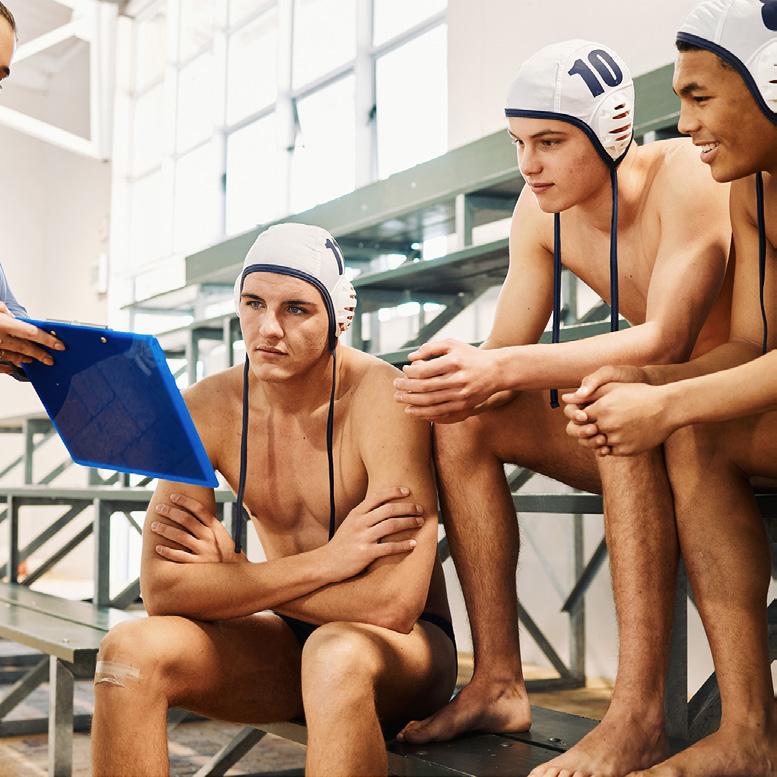
SOURCE 1 A training program helps an athlete or team plan training events/activities over a specific period of time to achieve energy, fitness and training goals.
For exam success, you will need to know about the concepts discussed above in detail. You will also need to be prepared to respond to questions on them. If any of these concepts are unclear or unfamiliar to you, you can revisit and revise them using the table below.
Subject matter
Developing a training program
Developing a training session plan
Retrieve and apply!
Lesson
Lesson 4.22 Developing a training program (page 288)
Lesson 4.24 Developing a training session plan (page 300)
To perform well on the exam, you will need to be able to retrieve the subject matter content listed in Unit 4 of the QCE Senior Physical Education Syllabus – Energy, fitness and training in physical activity. You will also need to be able to apply higher-order thinking skills to respond to more complex questioning. Remember, success is in the detail!
To see how well you can retrieve and apply key concepts on developing training programs and training sessions, complete the following questions in Source 2 (page 368). Answers for these tasks are available to teachers, so ask your teacher for them if you wish to check your responses.
Question type Retrieve it! Find it! Mark it!
Multiplechoice question
During a warm-up, an athlete is performing some dynamic hip opening exercises to put her hip joints through their full range of motion. Which stage of the RAMP protocol is this athlete following?
A Raise
B Activate
C Mobilise
D Potentiate
Shortresponse question
Extendedresponse question
Nadira, a 17-year-old hockey player, needs to conduct a game analysis. As a wing, she wants to specifically determine how much playing the position causes her fatigue; understand the typical distances, speed and direction travelled when playing wing; and know how effectively she is able to perform the specialised movement sequences of the position. Select three tools that Nadira can use to gather the primary data needed to conduct this analysis and use your knowledge of energy, fitness and training to justify your selection.
Leroy is training for javelin. Currently in the pre-competition phase, he wishes to complete a training session focusing on explosive power. Devise a training session, clearly applying your knowledge of energy, fitness and training concepts. Note: the conditioning phase of Leroy’s session will only consist of one activity.
Lesson 4.24
Developing a training session plan (page 300)
Lesson 4.22
Developing a training program (page 288)
Total: 1 mark
Select the correct option.
Lesson 4.24
Developing a training session plan (page 300)
Total: 6 marks
For full marks on this question, you will need to:
• select three accurate tools (3 marks)
• provide plausible justifications for each tool (3 marks).
Total: 12 marks
For full marks on this question, you will need to:
• articulate an objective (1 mark)
• devise a RAMP warm-up, selecting activities that show an understanding of the three stages within RAMP (3 marks)
• devise a conditioning phase activity, making sure to clarify that activity and load (comprising sets, reps, volume, intensity and work rest (W:R) ratio) (6 marks)
• devise an appropriate cool-down (2 marks).
SOURCE 2 Complete these tasks to see how well you can retrieve and apply the key concepts in developing training programs and training sessions.
Practice exam
Practice exam 5.13
Now that you have tested your understanding of the key concepts relating to developing training programs and training sessions, it’s time to put your learning to the test by completing Practice exam 5.13.
Practice exam 5.13 only includes questions relating to developing training programs and training sessions. It is structured and formatted in a similar way to the official QCAA Examination – combination response. It contains:
• Section 1 – multiple-choice questions
• Section 2 – short-response questions
• Section 3 – extended-response question.
You can use the practice exam in any way you like. If you feel confident with the subject matter, you might only complete a few questions from each section. If you feel that you need extra practice, you may choose to complete all the questions under exam conditions. Answers are available to teachers, so ask your teacher for them if you wish to check your responses.
Lesson 5.14
Evaluate the importance of a correctly structured warm-up
Aim
To evaluate the importance of a correctly structured warm-up.
Time
One lesson (i.e. 60 minutes) with additional time (if required) to complete the analysis and discussion tasks.
Equipment
• Netball court
• Netballs
• Stopwatches
• Game Performance Assessment Instrument 21 (GPAI 21)
• Clipboard
• Pen Game Performance Assessment Instrument 21 (GPAI 21)
Method
Step 1
Record your resting heart rate, respiratory rate, perceived body temperature, and perceived flexibility in the "Pre-warm-up" column of GPAI 21.
Step 2
As a class, participate in the following warm-up:
• jog two laps of the netball court
• 3–5 minutes of static stretching.
Step 3
At the completion of the warm-up, record your heart rate, respiratory rate, perceived body temperature and perceived flexibility in the "Post-warm-up" column of GPAI 21.
Step 4
Divide the class into teams of seven and play a round robin netball tournament for 20 minutes. If you don’t feel adequately prepared to start play, complete additional warm-up activities.
Analysis and discussion
1 Describe the features of a RAMP warm-up.
2 Explain the importance of a RAMP warm-up before engaging in physical activity.
3 Analyse your primary data. Comment on your preparedness to play a game of netball following the completion of your prescribed warm-up. Did you feel the need to complete additional warm-up exercises before taking to the court?
(page 300) as well as further research conducted online.
5 Would you maintain or modify this warm-up? Justify your response using primary and secondary data.
4 Evaluate the effectiveness of the warm-up in this Skill drill by comparing your primary data with secondary data about the RAMP warm-up protocol from Lesson 4.24 Developing a training session plan Prewarmup Postwarmup
Heart rate (quantitative data: number of heartbeats in 1 minute)
Respiratory rate (quantitative data: number of breaths in 1 minute)
Perceived body temperature (qualitative data: very cool, cool, warm, very warm, hot)
Perceived flexibility (qualitative data: very tight muscles, tight muscles, relaxed muscles, very relaxed muscles)
SOURCE 1 GPAI 21
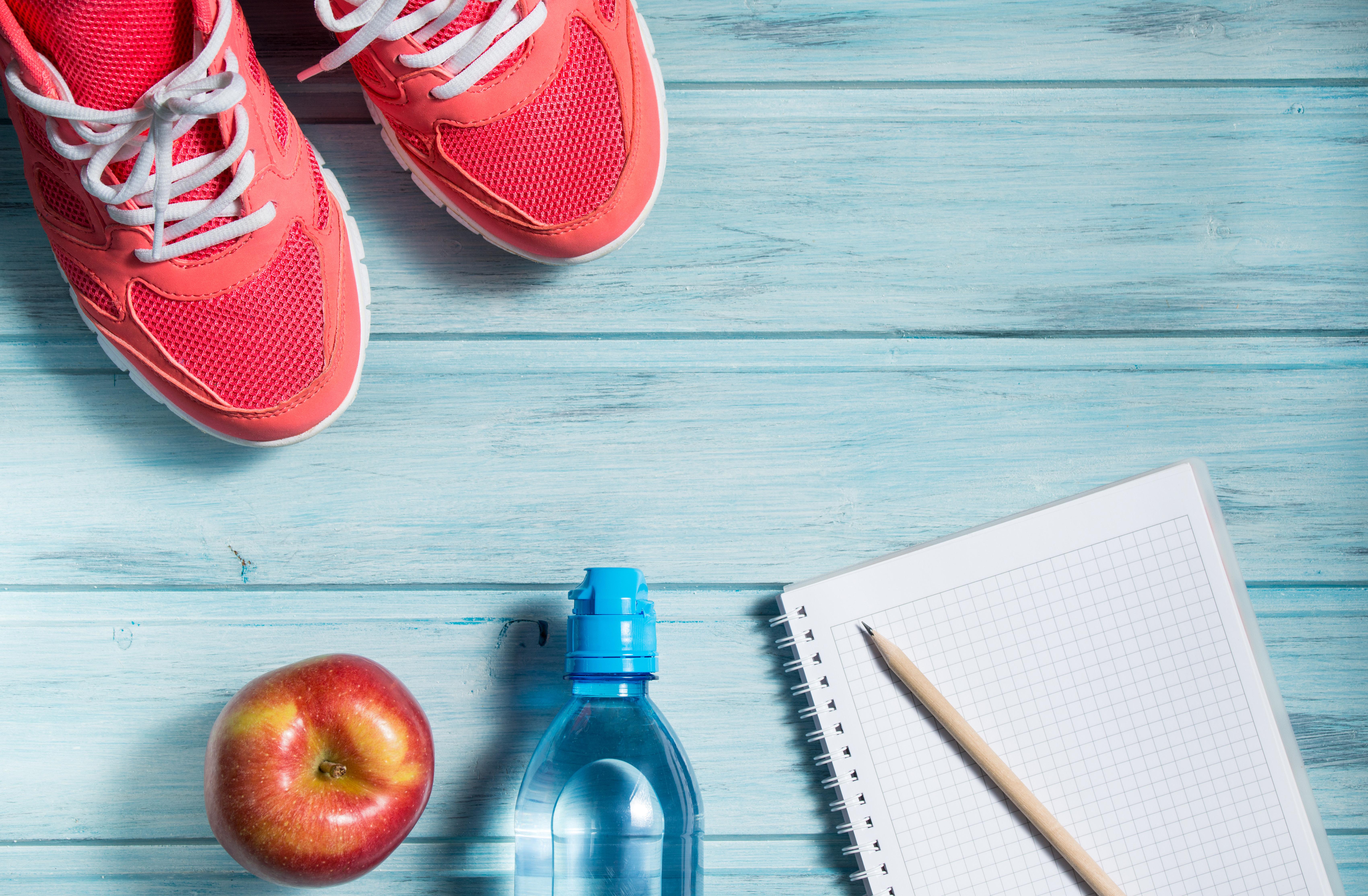
Aability
the degree to which a person possesses the means to do something (i.e. their physical or mental ability) and/or the degree of proficiency or skill a person possesses (i.e. their talent)
active recovery
recovery through low-intensity movement that helps reduce heart rate
acute physiological adaptation
immediate changes in body structures and organs in response to exercise
adenosine triphosphate (ATP)
an energy-rich molecule found in the cells of every living organism that provides the energy required for most bodily functions (especially the muscle contractions that enable physical activity); ATP is made up of adenosine and three phosphate groups
aerobic a term used to describe a chemical reaction that takes place with the presence of oxygen
aerobic capacity
the ability of the heart, lungs and circulatory system to supply oxygen and other nutrients to working muscles so that an athlete can exercise continuously for extended periods without tiring; one of the seven components of fitness
aerobic glycolysis
the process of breaking down glycogen in the presence of oxygen via the aerobic system
aerobic interval training (AIT)
a form of interval training that incorporates longer work periods and rest periods than other forms of interval training (i.e. HIIT and SIT)
aerobic system
an energy system that resynthesises ATP aerobically for use in low- to mediumintensity activities lasting longer than 90 seconds
aerobic training zone
a medium-intensity training zone that allows the development of the body’s circulatory system
affordances
opportunities for action that present themselves to athletes in a performance environment. Affordances are provided by the environment or the task – but the ability to take advantage of them depends on the ability of the athlete or learner
agents of socialisation
the people in our lives from whom we learn the types of behaviours and values that are expected of us in society (e.g. parents and guardians, siblings, friends, teachers and coaches)
agility
the ability to move the entire body (or specific parts of the body) from one position to another, or from one direction to another, quickly and precisely; one of the seven components of fitness
amino acids
the building blocks of protein in our bodies and in food; they come from the food we eat and are also produced by the body
anaerobic
a term used to describe a chemical reaction that takes place without the presence of oxygen
anaerobic glycolysis
the process of breaking down glycogen without oxygen present via the lactic acid system
anaerobic training zone
a high-intensity training zone in which an athlete works above their lactate threshold in intervals
annual plan
an athlete’s overall training plan for the year, which includes an overview of the physical activities that they need to train for and the times at which they must be in peak physical condition for competition. Annual plans can consist of one or more macrocycles
ATP cycle
a process that simultaneously releases the energy captured in ATP (by carrying out a chemical reaction that produces ADP and phosphate) and uses energy to resynthesise (i.e. remake) ATP (from ADP and phosphate)
ATP–PC system
an energy system that resynthesises
ATP anaerobically for use in maximumintensity activities lasting 0 to 15 seconds attunement
the ability to perceive information in a performance environment and use it to identify available affordances
B bias
prejudice for or against a particular person or group (especially in a way that could be considered unfair)
body and movement concepts
a group of four concepts used to guide the development and judge the effectiveness of specialised movement sequences and movement strategies in different sports and physical activities
Ccadence
the pace, timing or rhythm of an exercise (e.g. performing squats with a 1-down, 1-up or a 3-down, 1-up rhythm)
carbohydrates
a type of nutrient found in food and used as a source of energy; foods high in carbohydrates include grains (e.g. breakfast cereals), starchy vegetables (e.g. potatoes and peas), sugars, fruits and dairy products
cells
the basic building blocks of all living things; membrane-bound units that contain the fundamental molecules of life
chemical energy
a type of energy stored in the bonds of chemical compounds (e.g. atoms and molecules) in certain substances, such as food. Chemical energy is released through chemical reactions and transformed into other types of energy (e.g. mechanical energy)
chronic physiological adaptation longer-term changes in body structures and organs in response to training

circuit training
a type of training method in which a variety of different activities are performed consecutively (in a cycle)
circulatory system
a body system responsible for moving blood, oxygen and nutrients around the body (via the heart, veins, arteries and smaller blood vessels)
code of behaviour
a document that sets out the expected standards of behaviour for members of a particular group, team or organisation (with a focus on stakeholders who publicly represent the team during training, competitions or club-sanctioned activities)
code of conduct
a document that outlines the principles, standards and rules of a particular group, team or organisation
cognitive systems approach
a theoretical framework used to help explain the processes involved in motor learning; according to this approach, the brain acts as the central command centre for the body. It creates action plans for movements based on information it receives from the body’s senses and instructs the muscles to perform these actions in a linear order (i.e. step by step)
cognitive verbs
task words that will provide information on what students are expected to provide in an answer to a question
competition phase
a set period of time within a macrocycle dedicated to maintaining and optimising an athlete’s energy, fitness and skill levels to enable them to compete
components of fitness
a series of seven categories used to identify specific aspects of an athlete’s overall fitness (aerobic capacity, power, strength, speed, agility, muscular endurance, flexibility)
compound exercise
an exercise targeting two or more muscle groups over multiple joints
conditioning phase
a section within a training session devoted to targeting specific energy, fitness and skill objectives; the main part of a training session
constraint any internal or external variable that impacts on an athlete’s performance constraints-led approach
an approach to teaching and learning that involves manipulating constraints in authentic game situations so that learners are challenged to find their own movement solutions to the problems they face (or the goals they want to achieve); as opposed to more traditional coaching techniques that favour coach-directed technical drills performed in isolation outside authentic game situations
continuous training
a type of training performed at the same intensity for an extended period of time without periods of rest
cool-down phase
a period of low to moderate physical activity (e.g. walking or jogging) conducted after vigorous exercise in order to reduce the chance of injury
corruption
a term used to describe dishonest or fraudulent conduct carried out by those in power (typically for personal financial gain); in sport, it also includes any unethical or illegal activity that aims to deliberately change or alter the result of a sporting contest
Ddata
information collected for reference, analysis and evaluation
distress
a bad form of stress that leads to injury, illness or exhaustion
doping the use of banned performance-enhancing drugs by athletes and competitors during training or competition
duration
a principle of training that states the length of training time should be appropriate for the selected sport or physical activity
dynamic
a term used to describe a process or system that is constantly changing
dynamic flexibility training
a type of flexibility training that involves
stretching body parts and muscles in a controlled way, gradually increasing reach and/or speed of movement
dynamic systems approach a theoretical framework used to help explain the processes involved in motor learning; according to this approach, the intelligence that coordinates and controls body movements is the result of complex interactions between the individual, the environment and the task
dynamic systems theory
a dynamic model of learning that focuses on how a learner’s motor control system interacts with the environment and produces movements that will maximise the chances of success
Eecological model of learning
one of two main dynamic models of learning used to explain and predict how certain aspects of motor learning and movement take place; the ecological model focuses on how a learner’s motor control system interacts with the environment to simultaneously ‘perceive and act’ and ‘act and perceive’ in order to identify opportunities and produce movements that will maximise the chances of success
enabler
a factor that encourages a person to participate in a sport or physical activity
energy
(in the context of sport and physical activity) power derived from fuels (e.g. foods we eat) and used by the body to perform basic bodily functions and produce movement
energy system
a system used by the body to provide the energy required to resynthesise ATP and ensure that the body has the energy it needs to take part in physical activity. There are three main energy systems used by the body – the ATC–PC system, the lactic acid system and the aerobic system
environmental constraint any characteristic of the environment that an athlete needs to overcome or adapt to; these can include physical environmental constraints (e.g. weather, light, noise) and social environmental constraints (e.g. parents, peers, coaches, cultural norms)

equality
a concept that relates to having the same status, rights or opportunities; it means striving for fairness and justice by treating people the same (regardless of their personal differences)
ethical decision-making framework
a five-stage tool that provides a set of simple, practical tips and recommendations that can be used as a guide when responding to any ethical dilemma
ethical dilemmas
situations in which a difficult choice must be made between two options, when neither option will result in an outcome that is ethically or morally acceptable; in Physical Education, ethical dilemmas are determined by the interactions between your values and principles, and your purpose for engaging in physical activity
ethical values
a term used to describe a specific group of principles, characteristics or standards of behaviour that most people in a community or society would associate with ethical behaviour
ethics
a system of principles and values (i.e. standards of behaviour) that develop within a social group and by which actions are judged to be ‘good’ or ‘bad’; ‘right’ or ‘wrong’
ethics strategies
any plans of action created with the goal of promoting ethical values, ethical behaviours and fair play
eustress
a good form of stress that leads to physiological adaptation
exercise physiology
a specialised field of physiology that studies the short- and long-term effects of exercise on the human body
exploitation the act of treating someone or something unfairly in order to gain an advantage or benefit
Ffair competition
observing the rules of a sport and complying with codes of conduct and
behaviour; it relies on referees and officials acting fairly and without bias fair play
following the written and unwritten rules of competition and showing respect, fairness, friendship and tolerance to others (both on and off the field)
fartlek training
a variation of continuous training in which athletes vary the intensity of their exercise by increasing the speed or resistance of their work (e.g. by adding incline, running on sand, running up stairs)
fats
a type of nutrient found in food and used as a source of energy; foods high in fat include oils, nuts, dairy products (e.g. milk, cheese), avocados, some cuts of meat and oily fish
fatty acids
the building blocks of the fat in our bodies and in food; they come from the food we eat and are also produced by the body
fitness
a term used to describe the condition of being physically fit and healthy, as well as a person’s ability to participate effectively in a particular sport or physical activity
fitness profile
a table of fitness-based values designed to help individual athletes understand their overall fitness level (by providing data on a range of components of fitness) and design an appropriate training strategy
fitness–fatigue model
a theory that explains that the body responds to every training session by experiencing a ‘fitness effect’ and a ‘fatigue effect’ simultaneously, and it is the relationship between the two that determines when an athlete will benefit from training again
flexibility
the ability of a joint to move through its full range of motion; one of the seven components of fitness
flexibility training
a type of training that involves stretching the muscles, tendons and ligaments in and around joints to promote flexibility
frequency
a principle of training that states the number of times training occurs in a
given period should be appropriate for the selected sport or physical activity
Ggame analysis
the process of observing, recording and analysing performance and skill data from a selected game, sport or physical activity so that this information can be used to design relevant and appropriate training activities
gender exclusion
the action or state of restricting or excluding people from a sporting club, association or code based on their gender or sex
gender inclusion
the action or state of welcoming or including people in a sporting club, association or code regardless of their gender or sex
General Adaptation Syndrome (GAS)
a theory that explains that the body responds to stress in three phases – alarm, resistance, exhaustion; it states that positive stress (eustress) results in chronic physiological adaptation and that negative stress (distress) results in exhaustion
globalisation
a term used to describe the increasing interconnection and interdependence of countries around the world (on a range of economic, cultural, political and environmental issues)
glucose
a simple sugar that is commonly found in many carbohydrates and is used as an energy source by the body
glycogen
a substance stored in body tissue that comes from carbohydrates (i.e. a stored form of glucose)
glycolysis
the process of breaking down glycogen in order to resynthesise ATP
Hhaemoglobin
a protein-based molecule in the blood that carries oxygen

heart rate recovery
a measure of the rate at which the heart returns to normal resting levels (in beats per minute) between periods of exercise
high-intensity interval training (HIIT)
a form of interval training that alternates short, intense, unsustainable bursts of anaerobic-zone exercise (lasting less than 20 seconds) with short recovery periods
hypertrophy
an increase and growth in muscle cells as a response to long-term resistance training
Iindividuality
a principle of training that states the personal needs, goals, fitness levels, motivation and skills of individual athletes should be considered when designing a training program
initial training values
the quantitative measurement of training that you can realistically manage at the start of any training program (number of repetitions, work volume, intensity, W:R, duration, sets)
instrument-specific marking guide (ISMG)
a tool for marking that describes the characteristics evident in student responses and aligns with the identified objectives for the assessment
integrity
the quality of having strong morals and personal values (e.g. honesty, loyalty, respect for others, trustworthiness, fairness)
intensity
a principle of training that states the magnitude of exertion (i.e. how hard an athlete trains) should be appropriate for the selected sport or physical activity
inter-session recovery
the recovery that takes place in between one training session and another training session
interval training
a type of training that manipulates periods of work and rest to enhance a specific component of fitness and target a particular energy system
intra-session recovery
the recovery that takes place within a single a training session (e.g. between sets)
isokinetic resistance training
a type of resistance training in which movement against a resistance maintains a constant speed, no matter how much force is applied
isolated exercise
an exercise targeting a single group of muscles over a single joint
isometric (static) resistance training
a type of resistance training in which the muscle contraction is static (i.e. there is tension in the muscle but no movement across the joint)
isotonic (dynamic) resistance training
a type of resistance training in which the muscle contraction is dynamic (i.e. there is tension in the muscle and movement across the joint) against a constant resistance
Kkilojoules (kJ)
a standard unit of measure used to describe the energy content of different types of foods
Llactate
a component of lactic acid that remains after hydrogen ions (i.e. the acidic component of lactic acid) are separated
lactate threshold
the point at which lactic acid (i.e. lactate and hydrogen ions) begins to accumulate in the muscles at a faster rate than it can be removed (in the blood)
lactate threshold training zone
a specific zone in which the athlete trains at or just under their lactate threshold
lactate turn point (LTP)
a term used to describe the point at which the accumulation of lactic acid (i.e. lactate and hydrogen ions) results in negative effects (e.g. prevents the muscle fibres from contracting properly) and fatigue
lactic acid
a by-product of anaerobic glycolysis that is created when glucose is partially broken down to provide energy for ATP resynthesis
lactic acid system
an energy system that resynthesises ATP anaerobically for use in high-intensity activities lasting 15 to 90 seconds
learner constraint
any characteristic of the individual (i.e. personal attribute) that an athlete needs to overcome or adapt to; these can include structural learning constraints (e.g. height, weight, physical strength, fitness level) and functional learner constraints (e.g. confidence, motivation, concentration, anxiety)
loading
an increase in work volume and/or intensity of work, placing the athlete’s body under stress
loading–recovery pattern
the relationship between loading and recovery, expressed as a ratio
long slow distance (LSD) training
a type of continuous training performed at a steady, low to moderate intensity over an extended distance or duration
M
macrocycle
the training period from the beginning of the preparatory training phase to the end of a transition training phase within an annual plan
mass media
a collection of technologies (print, broadcast and digital) that are used to communicate messages to very large numbers of people
match fixing
the action or practice of dishonestly determining the outcome of a match before it is played (usually for financial or personal gain)
maximum heart rate (MHR)
the highest number of times (i.e. beats) your heart is capable of pumping per minute during exercise
mechanical energy
a type of energy that an object has when it is moving

mesocycles
training periods, generally 4 to 6 weeks in duration, with a specific training focus microcycles
training periods, generally 7 to 10 days in duration, with a specific training focus molecule
a group of two or more atoms that are bonded together
morals
ideals or standards of behaviour that a person may try to follow or live up to in order to be considered ‘good’ and ‘right’ by other members of a society (e.g. being honest, showing respect for others, being faithful, showing kindness)
motor learning
a field of science that investigates human movement with the goal of understanding how humans acquire and retain the motor skills required to perform specialised movements (through practice, experience and/or feedback)
motor skill
a voluntary movement that involves the use of specific muscles with the aim of achieving a defined purpose or goal; motor skills can be learnt and improved with practice
multimodal presentation
a presentation comprising more than one type of media or component
multinational
a term used to describe a club, company or organisation that operates in many different countries
muscular endurance
the ability to sustain or repeat a series of muscle contractions without fatigue; one of the seven components of fitness
muscular system
a body system responsible for movement (via the muscles and tendons)
Nnorm
a standard or pattern of behaviour that is acceptable or expected within a particular social group such as a family, club or society
nutrients components of food that are absorbed and used by the body to provide energy for physical activity and support the growth, repair and proper functioning of cells, organs and body systems
Oovertraining
training excessively
Ppara-sport
any sport played by people with a disability or impairment (including physical, vision, hearing, intellectual)
passive flexibility training
a type of flexibility training that involves having another person stretch body parts and muscles through a full range of motion and hold them in that position for you
passive recovery recovery where the body is inactive peak
an optimal state of athletic readiness aimed at the highest possible performance
perception–action coupling
a process that involves interpreting or giving meaning to information from the environment (i.e. perception) and linking this with a specific movement (i.e. action). This concept suggests that perceiving information and producing an action is a simultaneous two-way relationship (i.e. action influences perception at the same time as perception influences action)
periodisation
the process of dividing an annual training plan into a series of smaller, more manageable periods of time (known as macrocycles, training phases, mesocycles, microcycles and training sessions). Each period of time is designed to target specific training objectives
personal values
the principles or standards of behaviour that guide how an individual lives their life; a person’s judgment on what is important in life (e.g. honesty, fairness, trustworthiness)
phosphocreatine (PC)
a substance found in the body that is broken down via the ATP–PC system in order to resynthesise ATP
physiology
a field of science that studies the functions and mechanisms at work within living organisms (e.g. humans, animals and plants)
Play by the Rules
a national organisation that provides support and resources to help all Australians embrace the concept of fair play
plyometric training
a type of resistance training that involves rapid concentric (i.e. shortening) movements of muscle groups followed by rapid eccentric (i.e. lengthening)
movements of the same muscle groups point of failure
the moment when no more muscle fibres can be recruited to engage in an activity
(e.g. the moment an athlete cannot perform any more bicep curls)
positive engagement
participation in sport and physical activity that sets a good example, both for those who play and watch the sport, and for the wider community
power
the ability to exert maximum force in the shortest amount of time; one of the seven components of fitness
pre-competition phase
a set period of time within a macrocycle dedicated to optimising the athlete’s position or event-specific energy, fitness and skill levels
preparatory phase
a set period of time within a macrocycle dedicated to increasing the athlete’s general level of fitness
preparedness
an athlete’s level of readiness to achieve physiological adaptation from training principles of decision-making
a set of guidelines (cognitive processes) that can be used to help individual athletes or teams make the best and most appropriate decisions in performance environments

principles of training
a set of guidelines considered in the development, design and evaluation of a training strategy (specificity, frequency, intensity, duration, progressive overload, individuality, variety)
progressive overload
a principle of training that states that training should be planned to ensure gradual increases in training load so that physiological adaptation is appropriate for the selected sport or physical activity
proprioceptive neuromuscular facilitation (PNF) flexibility
training
a type of flexibility training that involves stretching body parts and muscles through a full range of motion passively (i.e. with the assistance of another person), followed by the athlete pushing against the resistance, and then another round of passive stretching that pushes the stretch a little beyond the previous range of motion
protein
a type of nutrient found in food and used as a source of energy; foods high in protein include meat, eggs and dairy products, as well as grains, legumes, nuts and seeds
RRAMP protocol
a specific warm-up technique aimed at: raising body temperature, heart rate, respiration rate and joint viscosity; activating and mobilising key muscle groups, joints and range of motion; and preparing for exercise by incorporating dynamic stretching rate limiters
types of constraints that have a negative effect on the development of motor skills in an individual and may restrict performance; rate limiters can be related to the task, the learner or the environment
recovery
the process of an athlete’s body returning to its normal state; for example, a fatigued athlete’s muscles beginning to feel normal again, and their breathing rate slowing to a normal rate
recovery training zone
a low-intensity training zone that allows
the recovery and adaptation of the body’s structures following a bout of high-intensity work
repetition duration
the amount of time it takes to perform one repetition of an exercise (e.g. the repetition duration of a bicep curl is commonly around 3 seconds)
repetition maximum (RM)
the most weight an individual can lift for a defined number of repetitions
resistance training
a type of training that requires an athlete to work against something that resists the movement of the body (or particular body parts)
respect
a feeling of admiration towards a person (or thing) based on their abilities, qualities or achievements
respiratory system
a body system responsible for the inhalation and exhalation of air (via the lungs, trachea, mouth and nasal passage) resynthesise
to put different elements back together again after they have been broken apart
reversibility
a principle of training that states that when training is decreased or stops, the physiological adaptations, increased function or fitness gains are lost or reversed
risk management
the identification, assessment and implementation of control measures designed to reduce or remove potential hazards to safety and wellbeing
Sself-organisation
a process in which many different systems and organs in the body interact dynamically with each other (in response to constraints) to achieve a goal or establish a movement pattern that is stable sledging the practice of making taunting or teasing remarks to an opposing player, especially a batsman, in order to disturb their concentration
slippery slope trap
a series of small unethical actions (‘bending the rules’) that can develop into more serious unethical behaviour over time
specialised movement sequences
a combination of fundamental movement skills (and movement elements) that enable the body to move in response to a stimulus
specialising
concentrating on, and becoming good at, one physical activity only
specificity
a principle of training that states the type of exercise used in training should be relevant (i.e. specific) to the energy systems, position-specific movements, and the fitness requirements of the selected sport or physical activity speed the ability to move the entire body (or specific parts of the body) quickly; one of the seven components of fitness sportsmanship
fair, generous and polite behaviour, especially when playing a sport or game
sprint interval training (SIT)
a form of interval training that alternates periods of high-intensity sprints with rest periods
stakeholder
a person (or group of people) who has an interest, connection, concern or investment in something (e.g. stakeholders in a sporting team may include the players, coaching staff, administrative staff, members, spectators, sponsors and investors)
stakeholder
a person (or group of people) who has an interest, connection, concern or investment in something (e.g. stakeholders in a sporting team may include the players, coaching staff, administrative staff, members, spectators, sponsors and investors)
static flexibility training
a type of flexibility training that involves stretching body parts and muscles through a full range of motion and holding them in that position for a period
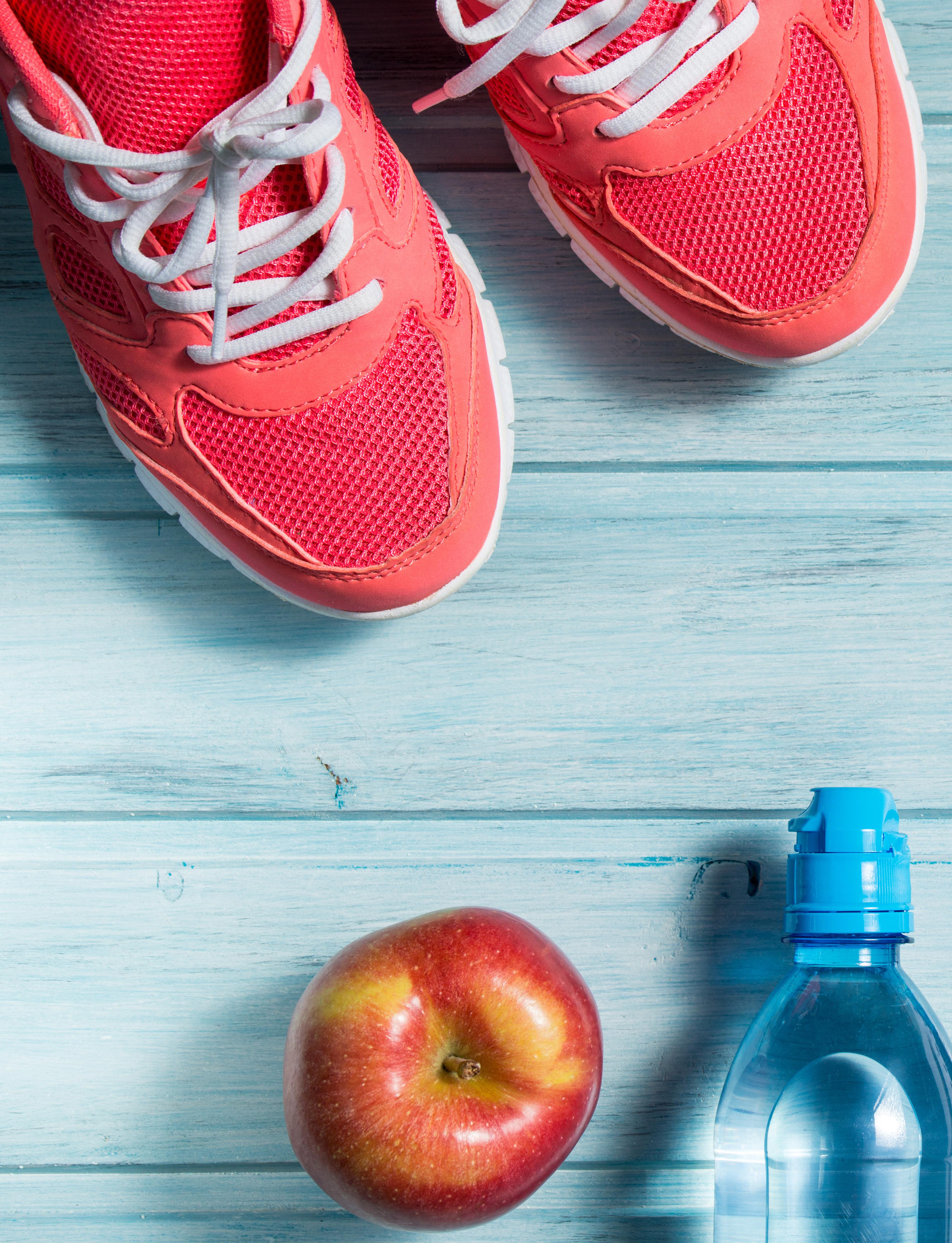
of time with nothing but the use of the agonist muscle (i.e. with no assistance)
strength
the ability of a muscle (or muscles) to exert force by contracting against resistance; one of the seven components of fitness
Ttactical awareness
an athlete’s ability to identify and interpret what is happening within a game situation to help them select, adapt and apply the best physical responses and increase their chances of success
tactical strategy
an approach that assists a player or team to successfully optimise performance through the application of specialised movement sequences and movement strategies
tapering
the gradual reduction of work volume and/or intensity of training, in the lead-up to a major competition, in order for the athlete to peak
target heart rate (THR) the heart rate you aim to train at during exercise
task constraint
any characteristic of a task that an athlete needs to overcome or adapt to (e.g. the rules of a game, the size or shape of the equipment, the size and shape of the playing surface)
team spirit
a term used to describe feelings of pride, loyalty and solidarity shared among the members of a group, enabling them to cooperate and work together as a single unit
tempo training
a type of continuous training performed just under an athlete’s lactate threshold training
(in the context of sport and physical activity) the specific tasks an individual completes to enhance their energy and fitness in preparation for their chosen physical activity
training load the combination of work volume and intensity; a general measure of the overall difficulty of the training training methods forms of exercise that can be selected and used to target particular components of fitness and performance (i.e. continuous training, fartlek training, resistance training, interval training, flexibility training, circuit training)
training objectives
the specific energy, fitness and skill outcomes that athletes aim to achieve through training
training phases
four distinct stages of training that combine to make an annual plan. Each training phase is designed to target a specific training objective over a specific period of time. There are four main training phases: the preparatory phase, the pre-competition phase, the competition phase and the transition phase
training program
a series of training events/activities planned over a specific period of time (e.g. 1 week, 2 months, 1 year), designed to help an individual or team achieve a range of energy, fitness and skill goals. The features of training programs include: specific training objectives; game analysis; work volume (frequency and duration) and intensity; tapering and recovery
training strategies
plans developed to improve the performance of an athlete or to help them achieve a goal; training strategies consider the personal requirements of an athlete (e.g. their individual physical and mental characteristics) as well as the requirements of their chosen physical activity (e.g. the physical demands, skills, strategies and techniques needed)
transition phase
a set period of time within a macrocycle dedicated to giving the athlete a physical and mental rest from energy and fitness training
triglycerides
the main constituents of natural fats and oils, as well as the chemical form of fat stored by the body; they come from the food we eat and are also produced by the body
Uunloading
a decrease in work volume and/or intensity of work, purposefully reducing the stress placed on the athlete’s body
unwritten rules
a set of expectations, qualities or values that are known and understood by a group but have not been formally documented
Vvariety
a principle of training that states a range of different training activities, movement options and training contexts should be included in a training program
VO2 max
a measure of an individual’s maximum oxygen consumption during intense physical activity
Wwarm-up phase
a period, or act, of preparation for a match, performance or exercise session, involving gentle exercise or practice
work volume
a general measure of how much exercise an athlete does; a combination of the frequency and duration of the training activities undertaken
written rules
the formally documented regulations governing a sport
Index
A
ability 141, 144–7, 152
ethical dilemmas 144–7, 152 accurate data 24
activate and mobilise (warm-up) 302 active recovery 193, 274 acute physiological adaptations 218, 347 adenosine triphosphate (ATP) 185–9, 333 ATP cycle 188
ATP–PC system see ATP–PC system resynthesis 188, 192, 193, 234 aerobic capacity 200, 203, 231, 237, 339 aerobic, definition 190 aerobic glycolysis 194
aerobic interval training (AIT) 260, 263, 308
aerobic system 190, 193–7, 326, 334 aerobic training zone 233, 234, 346 affordances 52–4 agents of socialisation 119 agility 201, 207, 237, 339 amino acids 184
anaerobic, definition 190 anaerobic glycolysis 192, 193 anaerobic training zone 233, 235, 248, 347 analogies 79–80
ankle extension test 209 annual plan 228, 230, 278, 285–6 artificial intelligence (AI) 29 assessment 6–21
Astrand-Rhyming cycle ergometer test 203
ATP see adenosine triphosphate
ATP cycle 188
ATP–PC system 190–2, 194, 235, 239, 275, 307, 326, 334 attunement 54
Bball-tampering 110, 157–60 bias 115 blitzing 255 blood lactate tolerance 216 body and movement concepts 4, 66 body awareness 66
Borg Rating of Perceived Exertion (RPE) scale 238 burpee test 207
Ccadence 252 carbohydrates 182, 183, 194, 333 cardiac output 213, 219 care, showing 117 categories of physical activity 5 cells 184, 187 cheating see corruption cheating (training technique) 255 chemical energy 182
chronic physiological adaptations 218, 219, 347
circuit training 244, 268–71, 357 circulatory system 212, 214 citing sources 30 coaches influencing values 119, 120 code of behaviour 107, 108, 126 code of conduct 107, 126 cognitive systems approach 45–6, 63 cognitive verbs 19, 22–3 commercialisation of sport 138 communication devices 108 community influencing values 119, 121 community partnership agreements 108 community sport see school and community sport competition phase 279, 281–3, 290, 291, 362 components of fitness 200–9, 292, 339 compound exercises 255, 258 conditioning activities 303–5, 308 conditioning phase 284, 285, 303–5 constraints 55, 56–9, 76 constraints-led approach 48, 51, 72–81 continuous training 243, 245–7, 357 contracts 107 cool-down activities 306, 309 cool-down phase 284, 285, 306 Cooper’s 12-minute run 203 corruption 127, 134, 141, 148–52 anti-corruption agencies 110 avoiding 108, 109, 110, 114, 115 ethical decision-making 157–60 course overview 2–6 credible data 25
Ddata 23–5 analysis 25, 83, 289 gathering 26–30, 289 quality 24
Data Collection Instrument (DCI) 26 decision-making 63–71 cognitive learning models 63 dynamic systems approach 63–71 ethical decision-making framework 154–62 ethical dilemmas 104, 139–54 evaluating effectiveness 69–71 principles of 66–8, 76–8 disability 144–5 distress 273 doping 110, 115, 127, 148–51 duration (training) 237, 239, 305, 352 dynamic flexibility training 265, 267 dynamic, meaning 47 dynamic systems approach 45–81 dynamic systems theory 51, 54–5
Eearly specialisation 145–6 ecological models of learning 50–62 effective leadership 130 enabler 106
endurance training 214, 217 energy 178–9, 326, 333 food, role of 182–5 how body accesses 185–9 requirements for physical activity 181, 333 energy systems 189–99, 326, 334, 337 aerobic system 190, 193–4, 326, 334 ATP–PC system 190–2, 194, 326, 334 comparison 194–5 interaction 195–8 lactic acid system 190, 192–3, 326, 334 training objectives and 292 Enhanced Games 150 enhancements in technology and equipment ethical dilemmas 147–8, 152 environmental constraints 56–8, 76 environmental effects of globalisation 135 equality 115 ethical decision-making framework 154–62 ethical dilemmas 104, 139–54, 106 ability 144–7, 152 corruption 148–51, 152 enhancements 147–8, 152 gender inclusion/exclusion 141–3, 151 personal responses 153–4 school/community setting 151–2 ethical values 125–31, 168 personal values 118–24, 168 ethics and integrity 102–71, 168 ethics strategies 125–31, 163, 168 ethical decision-making framework 161–2 school and community sport 129–30 eustress 273 evaluating strategy 87–8, 89–91 Examination – combination response 17–21 exercise physiology 178 exploitation, eliminating 115
Ffair competition 115 fair play 112–18 fairness and honesty 109–10 family influencing values 119–20 fartlek training 243, 247–50, 357 fast-twitch muscle fibres 216, 217 fatigue and recovery 230, 271–6, 358 fats 182, 185, 194, 333 fatty acids 185 figure 8 agility run 207 fitness 178–9, 200–9, 326, 339 components of 200–9, 292, 339 measuring and testing 201–9, 339 requirements for physical activity 200–9, 339 fitness–fatigue model 273 fitness profile 201, 210–11 fitness tests 201–9, 339 FITT principle 242 flex-armed hang test 208 flexibility 201, 208, 237, 243, 339 flexibility training 237, 243, 264–7, 357
food and energy production 182–5 forced repetitions 255 frequency (training) 236, 237, 238, 305, 352 futsal 269–70
Ggame analysis 228, 229, 288–90, 296–9, 315, 366 Game Performance Assessment Instrument (GPAI) 26, 85, 289–90 gender inclusion/exclusion 141–3, 151 General Adaptation Syndrome (GAS) 273 globalisation 121, 132–6 glucose 183, 193 glycogen 183, 193 glycolysis 192, 193 goniometer test 208 GPS tracker 289
Hhaemoglobin 212 heart rate 218, 219, 221, 306, 349 maximum (MHR) 217, 233, 245, 246, 346 monitor 215, 223, 239, 289 recovery 218, 221–3 target (THR) 233, 346 high-intensity interval training (HIIT) 260–1, 309 high preparedness 306 Hopper, Dr Tim 66 hypertrophy 216
Iillegal substances see performance-enhancing substances
Illinois agility test 207 individuality (training) 237, 240, 352 initial training values 304, 307, 311–13 instrument-specific marking guide (ISMG) 7 integrity see ethics and integrity intensity (training) 237, 238–9, 305, 352 International Fair Play Committee (CIFP) 112 inter-session recovery 274, 275 interval training 243, 259–64, 357 interview 28 intra-session recovery 274–5 “invasion” activities 5, 41, 64, 193, 195–7, 231, 262, 248, 304 Investigation – report 12–17, 163–7 isokinetic resistance training 251, 252–3 isolated exercises 255, 258 isometric (static) resistance training 251, 252 isotonic (dynamic) resistance training 251–2 J
joy 117
Kkilojoules (kJ) 182
Llactate 192, 193, 216–17
lactate threshold 216, 217, 238 determining 223–4 training zone 233, 235, 346 lactate turn point (LTP) 216 lactic acid 192, 193, 216 lactic acid system 190, 192–3, 195–7, 307, 326, 334
learner constraints 56–9, 76 Leighton flexometer test 209 load 303–4 loading 239 loading-recovery pattern 292, 293, 307 long slow distance (LSD) training 245 low–moderate preparedness 306 lung capacity 214
Mmacrocycles 230, 278, 292, 362 mass media 136–8 match fixing 108, 148, 149 maximal oxygen uptake see VO 2 max maximum heart rate (MHR) 217, 233, 245, 246, 346 mechanical energy 182 membership agreements 108 mesocycles 230, 283–4, 293, 362 microcycles 230, 284, 294, 362 “middle of the week” training theory 234 molecules 185 morals 103 motor learning 42–9 cognitive systems approach 45–6, 63 dynamic systems approach 45–81 motor skills 44 multimodal presentation 11, 82 multinational sporting companies 134 multi-stage fitness test 203 muscle fibre types 216, 217 muscular endurance 201, 208, 231, 237, 254, 305, 339 muscular system 212
N
negative repetitions 255 “net and court” activities 5, 41, 64, 193, 195–7, 304, 231 Newell’s Theory of Constraints 56–8 norms 102 nutrients 182
Oobservation 26 off-the-ball movements 65 on-the-ball movements 65 one-repetition maximum test 205 online sources 28–30 online surveys 28 onset of blood lactate accumulation (OBLA) 216, 217 overtraining 283 oxygen in performance 212, 346 oxygen uptake 212–13, 346 maximal see VO 2 max
Ppara-sport 143 passive flexibility training 265, 266, 267 passive recovery 274, 275 peak/peaking 282 peers influencing values 119, 120 perception–action coupling 50, 51–4 “performance” activities 5, 41, 195–7, 231, 304 performance-enhancing substances 110, 115, 148–51 periodisation 230, 277–9, 362–6 personal journal 27 personal performance capacity 342–5 personal reflection 27 personal values 118–24 phosphocreatine (PC) 191–2 physiological responses to training 212–26, 345–51 physiology 178, 180 Play by the Rules 112 player selection 146–7 plyometric training 251, 253–4 point of failure 251 positive engagement 107 potentiate (warm-up stage) 302 power 200, 204, 231, 237, 254, 305, 339 pre-competition phase 279, 280–1, 290, 291, 362 pre-exhaustion 255 preparatory phase 279–80, 291, 362 preparedness 300 flowchart 306 primary data 24, 83, 289 principles of decision-making 66–8, 76–8 principles of play 64–5 principles of training see training principles progressive overload 237, 239–40, 305, 352 Project – folios 8–12, 82–9, 314–25 proprioceptive neuromuscular facilitation (PNF) flexibility training 265, 266, 267 protein 182, 184, 194, 333 pull-up test 208 push-up test 208 pyramid runs 249
QQCE Physical Education course 2–6 qualitative data 24 quality of movement 66 quantitative data 24
Rrace pace test 215 raise (warm-up stage) 301 RAMP protocol 284, 301, 302, 308 rate limiters 58 rating of fatigue (ROF) 275, 289, 306 rating of perceived exertion (RPE) 289, 306 rating of session effectiveness (RSE) 289, 306 recovery 229, 230, 271–6, 358, 366 fatigue and 230, 271–6, 358 heart rate 218, 221–3 recovery methods 274–6
recovery phase 291 recovery training zone 233–4, 346 relationship between teammates 66 relevant data 25 reliable data 24 repetition duration 255, 257 repetition in skill learning 74, 75 repetition maximum (RM) 255–7 repetition without repetition 74 resistance training 243, 250–9, 357 definition 243, 250, 357 techniques 255, 357 terms and principles 255–8 respect 116 respiratory system 212, 214 reversibility (training) 237, 241, 352 revision and exam preparation 332–69 risk management 126, 128 rules, written and unwritten 106, 112, 127 following 106, 112, 113 respect for 116
Sschool and community sport ethical dilemmas 151–2 ethics strategies 129–30 influences on values 119, 120–1 secondary data 24, 28–30, 83, 289 self-organisation 55–6 shoulder rotation test 209 shuttle run test 207 sit-and-reach test 209 sit-up test 208 sledging 113 slippery slope trap 158 slow-twitch muscle fibres 216, 217 solidarity, showing 117 space awareness 66 specialised movement sequences 4, 42, 290, 291, 360 specialising 283 specificity 326 training 236, 237, 351 warm-up activities 302 speed 200, 206, 237, 339 sportsmanship 106, 117 sprint interval training (SIT) 260, 261–2 stakeholders 106, 131, 140 standing long jump test 204 static flexibility training 265 step test 203 strength 200, 205, 254, 305, 339 strength dynamometer test 205 stress, good and bad 273 striving for excellence 117 stroke volume 213, 219 surveys 28
Ttactical awareness 34–97 tactical strategy 56, 60–2 evaluating 87–91 talent identification 145–6, 217 talk test 215
tapering 229, 282, 366 target heart rate (THR) 233, 346 task constraints 56–9, 76 team spirit 116 tempo training 245, 246 throw test 204 time warps 249 tolerance 117 training 178–9, 327 definition 178, 227–8 fatigue and recovery in 271–6, 358 impact on VO 2 max 218–19 physiological responses 212–26, 345–51 requirements for physical activity 227–32 training goal 231 training load 229, 284 training methods 229, 243–71, 357 circuit training 244, 268–71, 357 continuous training 243, 245–7, 357 definition 229 fartlek training 243, 247–50, 357 flexibility training 243, 264–7, 357 interval training 243, 259–64, 357 resistance training 243, 250–9, 357 training objectives 288, 290, 318, 366 training phases 230, 279–83, 292–3, 362 competition phase 279, 281–3, 290, 291, 362 pre-competition phase 279, 280–1, 290, 291, 362 preparatory phase 279–80, 291, 362 training objectives in 290–1 transition phase 279, 283, 291, 362 training principles 229, 236–42, 351–6 duration 237, 239, 352 FITT principle 242 frequency 236, 237, 238, 352 importance in training program 355 individuality 237, 240, 352 intensity 237, 238–9, 352 progressive overload 237, 239–40, 352 reversibility 237, 241, 352 specificity 236, 237, 351 variety 237, 241, 352 training programs 108, 201, 228–32 annual plan 228, 230, 285–6 developing 229–32, 288–95, 366–8 game analysis 228, 229, 288–90, 296–9, 315, 366 objectives 229, 290 periodisation 230, 277–9, 362–6 principles of training in 355 tapering 229, 282, 366 work volume 229, 366 training session plan 300–10, 367 training sessions 284–5, 294, 362 conditioning phase 284, 285, 303–5, 308 cool-down phase 284, 285, 306 effectiveness in developing energy system 337 planning 300–10, 367 warm-up phase 284, 301–2, 369 training strategies 179, 315–21 training zones 230, 233–6, 346 transgender sportspeople 143 transition phase 279, 283, 362 triglycerides 185, 194
Uunauthorised enhancements or equipment 110 ethical dilemmas 147–8, 152 unloading 272 unwritten rules 106, 112, 113, 116
Vvalid data 24 variety (training) 237, 241 vertical jump test 204 video recording 26, 85 VO 2 max 213–19, 235, 346 determining 215, 221–2 impact of training on 218–19
Wwarm-up activities 301–2, 308, 369 warm-up phase 284, 301–2, 369 work:rest (W:R) ratio 260, 261, 263, 274, 303, 307 work volume 229, 366 written rules 106, 112, 113, 116
Zzero preparedness 306 zone hopping 249 Zuntz, Nathan 180
Acknowledgements
The author and the publisher wish to thank the following copyright holders for reproduction of their material.
Images: Cover Image: Master1305/Shutterstock. Module 1 Opener: Master1305/Shutterstock. Unit 3 Opener: Anton Vierietin/Shutterstock. Lesson 1.1: Source 2 (a), Master1305/Shutterstock; Source 2 (b), Master1305/ Shutterstock; Source 4 (a), ESB Professional/Shutterstock; Source 4 (b), BalanceFormCreative/Shutterstock; Source 4 (c), Fotokostic/Shutterstock; Lesson 1.2: Source 2 (a), ABO PHOTOGRAPHY/Shutterstock; Source 2 (b), Peshkova/Shutterstock; Source 2 (c), Monkey Business Images/Shutterstock; Lesson 1.3: Source 2, Africa Studio/Shutterstock; Source 3, Ground Picture/ Shutterstock; Source 3 (a), MinDof/Shutterstock; Source 3 (b), MinDof/ Shutterstock; Source 3 (c), Peter Bernik/Shutterstock; Lesson 1.5: Source 1, Filipe Frazao/ Shutterstock; Source 3, Sergey Nivens/ Shutterstock; Lesson 1.7: Source 1, ESB Professional/ Shutterstock; Source 3, Connect Images/Alamy Stock Photo; Source 4, Anastasia Kamysheva/ Shutterstock; Lesson 1.10: Source 1, Monster Ztudio/ Shutterstock; Lesson 1.11: Source 3, Ground Picture/ Shutterstock. Module 2 Opener: Anton Vierietin/Shutterstock. Lesson 2.1: Source 1 (a), Emilee Chinn/Getty Images; Source 1 (b), UPI/Alamy Stock Photo; Source 1 (c), PA Images/Alamy Stock Photo; Source 1 (d), Sipa USA/Alamy Stock Photo; Source 3 (a), PabloBenii/Shutterstock; Source 3 (b), DarioZg/ Shutterstock; Source 3 (c), Aflo Co., Ltd./Alamy Stock Photo; Source 5, Walter Arce/ZUMA Press, Inc./Alamy Stock Photo; Lesson 2.2: Source 1, RomarioIen/ Shutterstock; Source 3, Robbi Akbari Kamaruddin/Alamy Stock Photo; Source 6, Tumar/Shutterstock; Source 7, Michele Morrone/Alamy Stock Photo; Lesson 2.3: Source 3 (c), glenda/Shutterstock; Source 4, ESB Professional/Shutterstock; Source 5, luca85/Shutterstock; Source 6, JLBarranco/Getty Images; Source 9, Paul B. Moore/Shutterstock; Source 10, Hilary Morgan/Alamy Stock Photo; Lesson 2.4: Source 1, Mike Flippo/Shutterstock; Lesson 2.5: Source 1, BRG. photography/Shutterstock; Source 2, BUGNUT23/Shutterstock; Source 3, Ververidis Vasilis/Shutterstock; Source 6, lazyllama/Shutterstock; Lesson 2.7: Source 2, Gabe Souza/Portland Press Herald/Getty Images; Source 3, simez78/ Shutterstock; Source 5, PCN Photography/Alamy Stock Photo; Source 8, shulers/ Shutterstock; Source 9, xshot/Shutterstock; Lesson 2.8: Section 1, Pixel-Shot/ Shutterstock; Source 4, Taka Wu/Alamy Stock Photo; Source 7, Action Plus Sports Images/Alamy Stock Photo; Lesson 2.9: Part A, gresei/Shutterstock; Lesson 2.10: Source 1, Gabe Souza/Portland Press Herald/Getty Images. Module 3 Opener: Master1305/Shutterstock. Lesson 3.1: Source 1, matimix/ shutterstock; Source 3, Ian Walton/Getty Images; Lesson 3.2: Source 1, Adam Pretty/Getty Images; Source 3, Action Plus Sports Images/Alamy Stock Photo; , Salih Zeki Sayar/Euroleague Basketball/Getty Images; Source 4, STR/AFP TV/ AFP /Getty Images; Source 5 (a), jax10289/Shutterstock; Source 5 (b), Keystone Press/Alamy Stock Photo; Lesson 3.3: Source 1, Wor Jun/Shutterstock; Source 2, David Madison/Getty Images; Source 4, Andrew Fosker/Shutterstock; Source 5, Clive Brunskill/Getty Images; Source 6, Christian Bertrand/Shutterstock; Source 7, Alex Bogatyrev/Shutterstock; Lesson 3.4: Source 2, Jonathan Larsen/ Diadem Images/Alamy Stock Photo; Source 3, Monkey Business Images/ Shutterstock; Source 4, Monkey Business Images/Shutterstock; Lesson 3.6: Source 1, Monkey Business Images/Shutterstock; Source 3, ANP/Alamy Stock Photo; Source 4 (a), Sport Integrity Australia; Source 4 (b), Australian Sports Commission — www.ausport.gov.au.; Lesson 3.7: Source 1, dencg/Shutterstock; Source 2, Kevin Woods/Alamy Stock Photo; Source 3, UPI/Alamy Stock Photo; Source 4, DAVID AKE/Reuters; Source 5, oliverdelahaye/Shutterstock; Source 7, Emily Barker/Getty Images; Lesson 3.8: Source 2, Jake Nowakowski/Newspix; Source 4, MOHD RASFAN/AFP/Getty Images; Source 5, Ulrik Pedersen/ NurPhoto via Getty Images; Source 6, Sport In Pictures/Alamy Stock Photo; Source 9, PA Images/Alamy Stock Photo; Source 10, Dziurek/Shutterstock; Source 12, Marc Pagani Photography/Shutterstock; Lesson 3.9: Source 1 (a), YimJi WK/Shutterstock; Source 1 (b), Alexander Weickart/Shutterstock; Lesson 3.10: Source 4 (a), Sanit Fuangnakhon/Shutterstock; Source 4 (b), xpixel/
Shutterstock; Source 3, PETER PARKS/AFP/ Getty Images; Source 5, PETER PARKS/AFP/ Getty Images; Lesson 3.11: Source 1, ClimbWhenReady/ Shutterstock; Lesson 3.12: Section 1, Master1305/Shutterstock; Step 2 Example:, Prostock-studio/Shutterstock; Lesson 3.13: Stimulus 2, Yeji Yun/Getty Images. Unit 4 Opener: Master1305/Shutterstock. Module 4 Opener: Master1305/ Shutterstock. Lesson 4.1: Source 1, Mark Kolbe/Getty Images; Source 3, The History Collection/Alamy Stock Photo; Lesson 4.2: Source 1, Elena Schweitzer/ Shutterstock; Source 3, Tatjana Baibakova/Shutterstock; Source 5, Tatjana Baibakova/Shutterstock; Source 6, Alexander Koerner/Getty Images; Source 8, Tatjana Baibakova/Shutterstock; Lesson 4.3: Source 1 (a), MinDof/Shutterstock; Source 1 (b), Maridav/Shutterstock; Source 1 (c), lzf/Shutterstock; Source 4, Master1305/Shutterstock; Source 6, David Rogers/Getty Images; Source 10, Elsa/Getty Images; Source 7, Maridav/Shutterstock; Lesson 4.4: Source 1, Paolo Bona/Shutterstock; Source 2, Pressmaster/Shutterstock; Source 3, Pressmaster/ Shutterstock; Source 4, OLI SCARFF/AFP/ Getty Images; Source 5, George Rudy/Shutterstock; Source 6, PA Images/Alamy Stock Photo; Source 7, Matthew Stockman/Getty Images; Source 8, ANDY BUCHANAN/AFP/Getty Images; Lesson 4.5: Source 1 , Microgen/Shutterstock; Source 2, RomarioIen/ Shutterstock; Source 6, KIRILL KUDRYAVTSEV/AFP/Getty Images; Source 4, Jacob Lund/Shutterstock; Source 5, Andrey_PopovShutterstock; Lesson 4.7: Source 1, Africa Studio/Shutterstock; Lesson 4.8: Source 1, aceshot1/ Shutterstock; Lesson 4.10: Source 2 (a), Pavel Shchegolev/Shutterstock; Source 2 (b), LifetimeStock/Shutterstock; Source 2 (c), wavebreakmedia/Shutterstock; Source 3, Eugene Onischenko/Shutterstock; Lesson 4.11: Source 2, Jochen Tack/ Alamy Stock Photo; Lesson 4.12: Source 1, IOIO IMAGES/Shutterstock; Source 2, Microgen/Shutterstock; Source 3, PopTika/Shutterstock; Source 4, Quinn Martin/Shutterstock; Source 5, Rawpixel.com/Shutterstock; Source 6, NDAB Creativity/Shutterstock; Source 7, David Ramos/Getty Images; Source 8, Boris Riaposov/Shutterstock; Lesson 4.14: Source 1, Kzenon/Alamy Stock Photo; Lesson 4.15: Source 1, feelphoto/Shutterstock; Lesson 4.16: Source 1, F8 studio/ Shutterstock; Source 2, Dmitry Melnikov/ Shutterstock; Source 3, Bohdan Malitskiy/Shutterstock; Source 4, kupicoo/Getty Images; Source 8, lunamarina/ Shutterstock; Source 10, Andrey Burmakin/Shutterstock; Source 11, Tereshchenko Dmitry/Shutterstock; Lesson 4.17: Source 1, Jacob Lund/ Shutterstock; Source 3, Jonathan Ferrey/Getty Images; Source 4, Jacob Lund/ Shutterstock; Source 7, Odua Images/Shutterstock; Lesson 4.18: Source 1, websterjal/Shutterstock; Source 2, PhotoAlto sas/Alamy Stock Photo; Source 3, Drkskmn/Shutterstock; Lesson 4.19: Source 1, LuckyBusiness/Gettty Images; Source 3, matimix/Shutterstock; Source 4, Samuel Borges Photography/ Shutterstock; Lesson 4.20: Source 1, Gorodenkoff/Shutterstock; Source 3, Vadim Martynenko/Shutterstock; Source 5, New Africa/Shutterstock; Lesson 4.21: Source 1, Andrey_Popov/Shutterstock; Source 3, Cameron Spencer/Getty Images; Source 4, stockfour/Shutterstock; Source 10, Clive Rose/Getty Images; Source 11, Rawpixel.com/ Shutterstock; Source 12, Rocksweeper/ Shutterstock; Source 9, Ljupco Smokovski/Shutterstock; Lesson 4.22: Source 3, Neale Cousland/Shutterstock; Source 5, Pressmaster/Shutterstock; Lesson 4.23: Source 1, Boris Riaposov/Shutterstock; Lesson 4.24: Source 1, Gino Santa Maria/Shutterstock; Source 2, Football Australia; References, nanka/ Shutterstock; Source 3, Top Photo Engineer/Shutterstock; Source 6, Jacob Lund/ Shutterstock; Source 7, nanka/Shutterstock; Source 8, muzsy/Shutterstock; Lesson 4.25: Source 1, Bobex-73/Shutterstock; Lesson 4.26: Section 1, Vitaliy Andreev/Shutterstock; Example, wavebreakmedia/Shutterstock; Source 3, Cameron Spencer/Getty Images; Task 3, wavebreakmedia/Shutterstock; Source 6, wavebreakmedia/Shutterstock; Lesson 4.27: Stimulus 1, bbernard/Shuttertock; Stimulus 3, paulinux/Shutterstock. Module 5 Opener: Anton Vierietin/Alamy Stock Photo. Lesson 5.1: Source 1, nehophoto/Shuttestock; Source 2 (a), Jacob Lund/Shutterstock; Source 2 (b), pio3/Shuttestock; Source 2 (c), Maridav/
Shutterstock; Lesson 5.2: Source 1, tarn.901/Shutterstock; Source 3, Roman Samborskyi/Shutterstock; Lesson 5.3: Source 1, ShutterOK/Shutterstock; Source 4, Maridav/Shutterstock; Lesson 5.4: Source 2, Bobex-73/Shutterstock; Lesson 5.5: Source 1, vladgphoto/Shutterstock; Lesson 5.7: Source 1, Quinn Rooney/AFL Media/Getty Images; Lesson 5.9: Source 1, TORWAISTUDIO/ Shutterstock; Lesson 5.11: Source 1, xmee/shutterstock; Lesson 5.13: Source 1, PeopleImages.com - Yuri A/Shutterstock. Text Extracts: Lesson 3.7: Source 3, Pulse Kenya / Amos Robi; Lesson 2.1: Source 5, Source: O’Connor, D. & Larkin. P., 2017, in International Research in Science and Soccer II. Routledge.; Lesson 2.3: Source 1, Duarte Araújo; Henrique Brito; Daniel Carrilho; Lesson 2.7: Source 3, Source: Renshaw, I., Davids, K., O’Sullivan, M., Maloney, M. A., Crowther, R. & McCosker, C. (2022) “An ecological dynamics approach to motor learning in practice: Reframing the learning and performing relationship in high performance sport”, in Asian Journal of Sport and Exercise Psychology Vol 2, Issue 1; Lesson 3.1: Source 1, National Tribune; Lesson 3.2: Bulldogs
player Josh Addo-Carr sacked, © 2025 Guardian News & Media Limited; Lesson 3.2: Australian athletics great John Landy remembered as an “inspiration”, © 2025 ABC; Lesson 3.4: Community:, © Commonwealth of Australia 2020Sport Integrity Australia; Lesson 2.7: Why Bahrain has been banned from poaching athletes from Kenya and other countries, Reproduced with permission from Springer Nature’.; Lesson 3.8: Caitlin Bassett: Enhanced Games will be a “freak show” that James Magnussen should not dive into, The Nightly; Lesson 4.12: Reversibility, Genevieve Gregson; Lesson 3.13: Stimulus 3, Future PLC; Lesson 3.6: Source 4, Sports Integrity; Lesson 3.2: Source 2, Netball Queensland Limited.
Every effort has been made to trace the original source of copyright material contained in this book. The publisher will be pleased to hear from copyright holders to rectify any errors or omissions.
